THREE-DAY AUCTION

11 – 13 October 2023
Flagship Live Auction
Wednesday, 11 October Lots 1-247
中國藝術集珍 Buddhism and Hinduism

www.zacke.at
中文翻譯敘述,請參考

Provenances Museum Deaccessions
Ho Chi Minh City Museum of History, Vietnam
The Zelnik István Southeast Asian Gold Museum, Budapest, Hungary
The Norton Museum of Art, Palm Beach, USA
The Walters Art Museum, Baltimore, USA
Wou Lien-Pai Museum, UK
Idemitsu Museum, Japan
Cranmore Ethnographical Museum, UK
Historic Gallery and Dealership Provenances
Hang Tang Cheng, Dragon House, San Francisco, USA
Shee Lup Jung (1922-2015), Wilmington, Delaware, USA
P.C. Lu Works of Art Ltd, Hong Kong
Brian Page, Brighton, UK
Robert Kleiner (1948-2014)
Galerie Michel Beurdeley, Paris, France
Galerie Asboth, Vienna, Austria, Ute Asboth (1927-2018)
Tomlinson Antique House, Geylang, Singapore
Jacques Barrère, Paris, France
Spink & Son, London, UK
Leonardo Vigorelli, Bergamo, Italy
Ted Adameck (1924-2019), USA
Nicholas Pitcher, London, UK
J. J. Lally, New York, USA
Joseph Rondina (1927-2022), New York, USA
Blitz Oriental Art, Amsterdam
Cohen & Cohen, Antwerp, Belgium
Marsha Vargas, Xanadu Gallery, San Francisco, USA
E & J Frankel, New York, USA
Allen Harold Abramson (1929-2016), Farmington Hills, USA
Arts d’ Autrefois, Paris, France
Clare Chu, Asian Art Studio, Los Angeles, USA
The Jade House, Hong Kong
Hugh Moss Ltd., Hong Kong
Galerie Themis, Brussels, Belgium
Galerie Low, Brussels, Belgium
Gallery Van Stockum, The Hague, Netherlands
Galerie Allain, Paris, France
Bob Hall, London, UK
Rare Art, Inc., New York, USA
S. Bernstein & Co., Jade & Oriental Art, San Francisco, USA
The Bernheimer Collection, Munich, Germany

Galerie Max, Brussels, Belgium
The St. James’s Collection, London, UK
Solveig & Anita Gray, London, UK
Bluett & Sons, London, UK
Guus Röell, Fine Arts & Antiques Maastricht, Netherlands
John Sparks Ltd., London, UK
Robert Kleiner & Co. Ltd., London, UK
Wang & Co., Beijing, China
Raymond and Victoria Tregaskis, Sydney, Australia
Galerie Persépolis, Brussels, Belgium
Michael Goedhuis, London, UK
David Taylor (1876-1958), Northern Ireland
Galerie Beer, Brussels, Belgium
Shore Galleries, Chicago, Illinois
Roger Keverne, London, UK
Galerie Wannieck, Paris, France
Collection Huet, Paris, France
Private Estates and Collection Provenances
Dr. Aurel Gonda (1885-1964), Austria
Alfred Julius Forkel (1873-1934), Germany
Elaine Whewell, North Berwick, Scotland
The Zande Lou Collection, J.M. Hu (1911-1995)
Stuart G. Moldaw (1927-2008)
Peter Leonardus Dircks (1883-1954)
John Marsing (1918-1998), Denmark
André Dubreuil (1951-2022), France
Sara Fredericks (1903-1986), USA
Hildur Hanson (1912-1999), Sweden
Dr. Wou Kiuan (1910-1997)
The VWS Collection
The Neame family collection, Chesham, UK
Captain Walter Herbert Adgey-Edgar
Madame de Rothschild
Mr. and Mrs. S., Ghent, Belgium
The Chasseloupe-Laubat family, France
Provenance list continues on the inside back cover
Buddhism and Hinduism Fine Chinese Art, 中文翻譯敘述,請參考
DAY 1
Fine Chinese Art, Buddhism and Hinduism I Lots 1-247
Wednesday, 11 October 2023, at 11 am CET
DAY 2
Chinese Archaic Jades from Old Collections I Lots 1001-1053
Thursday, 12 October 2023, at 11 am CET
Fine Chinese Art, Buddhism and Hinduism I Lots 248-436 ONLINE CATALOG
Thursday, 12 October 2023, at 1 pm CET
DAY 3
Fine Chinese Art, Buddhism and Hinduism I Lots 437-748 ONLINE CATALOG
Friday, 13 October 2023, at 11 am CET
AUCTION
+43 1 532 04 52 Fax +20 E-mail office@zacke.at www.zacke.at
EXHIBITION
- 10 October, Monday - Friday 10 am - 6 pm as well as by appointment
ZACKE Sterngasse 13 . 1010 VIENNA AUSTRIA
THREE-DAY
11 – 13 October 2023 Tel
CATALOG CA1023
2
GALERIE
中國藝術集珍
www.zacke.at
Chinese Archaic Jades

from Old Collections

舊藏中國古玉
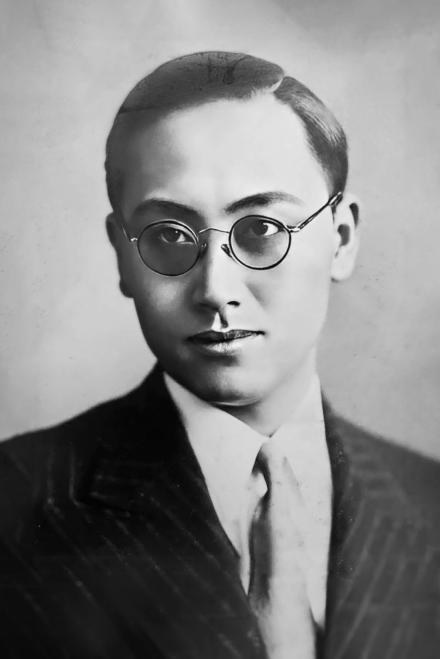

DAY 2 Thursday, 12 October 2023 at 11 am CET (Lots 1001-1053)
Lots 1001-1053
PRINT CATALOG
UPON REQUEST
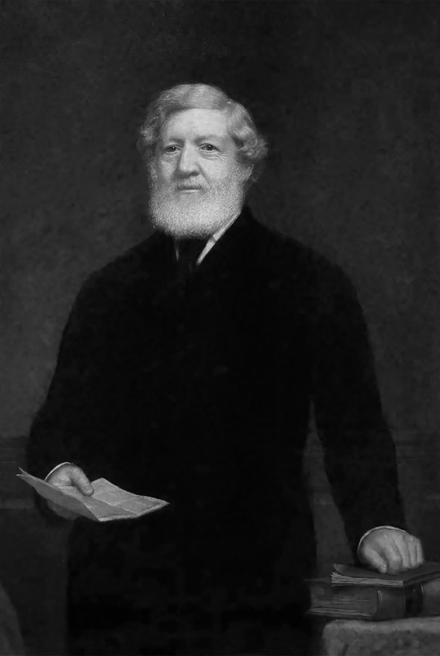
Fine Chinese Art, Buddhism and Hinduism


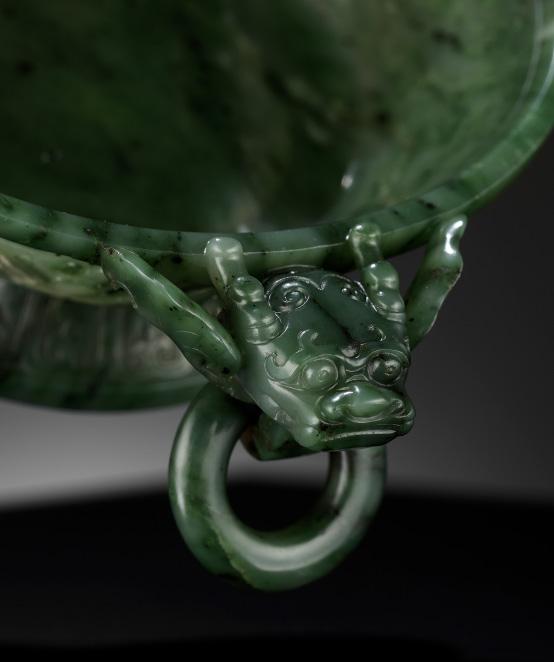


中國藝術集珍
DAY 2 Thursday, 12 October 2023 at 1 pm CET (Lots 248-436)
DAY 3 Friday, 13 October 2023 at 11 am CET (Lots 437-748)
Lots 248-748
ONLINE CATALOG
中文翻譯敘述,請參考
www.zacke.at
ABSENTEE BIDDING FORM
FOR THE THREE-DAY AUCTION Fine Chinese Art, Buddhism and Hinduismns CA1023
ON DATE 11-13 OCTOBER 2023
PLEASE RAISE MY BID BY ONE BIDDING INCREMENT (ca. 10%) IF NECESSARY
IMPORTANT NOTICE:
Bids do not include buyer’s premium and VAT. Margin taxation applies. Items with added VAT are marked in the online catalog.
TELEPHONE BIDS:
PLEASE CALL ME WHEN A HIGHER BID THAN MINE HAS BEEN RECEIVED
MY PHONE NUMBER
If you like to bid by telephone, please state ‘TEL’ in the ‘BID IN EURO’ column instead of a Euro amount. Galerie Zacke will call you on the day of the auction, on the telephone number provided, 5 lots before the lot you are bidding on and the bidding will commence at the starting price, as stated in the catalog. If Galerie Zacke cannot reach you during the auction, Galerie Zacke will bid up to the estimate on your behalf.
TERMS OF PAYMENT, SHIPPING AND COLLECTION:
NAME
ADRESS
CITY, COUNTRY
POSTCODE
PHONE NUMBER
CREDIT CARD PAYMENT
PLEASE CHECK THE DESIRED CARD
COLLECTION BY CLIENT WITH PAYMENT ON THE PREMISES IN CASH, BY CERTIFIED CHEQUE OR CREDIT CARD
INVOICE PAYMENT
VIA BANK WIRE AFTER RECEIPT OF INVOICE SHIPPING AFTER RECEIPT OF PAYMENT
EXPRESS PARCEL SERVICE REQUIRED (ACCORDING TO TERMS AND CONDITIONS OF GALERIE ZACKE)
SHIPPING INSURANCE REQUIRED (ACCORDING TO TERMS AND CONDITIONS OF GALERIE ZACKE)
GALERIE ZACKE
Sterngasse 13, 1010 Vienna, Austria
Email: office@zacke.at
Tel: +43-1-532 04 52
Fax: +43-1-532 04 52 20
With the signature on this form, the client instructs the auctioneer to bid on his behalf. The Euro amount up to which the auctioneer shall bid on behalf of the client is either stated in this form or will be communicated to the auctioneer via telephone during the auction. All absentee bidding shall be governed by the terms and conditions [AGB] of Galerie Zacke. The client agrees with his signature that he has read, understood and fully accepted the AGB of Galerie Zacke. Galerie Zacke, founded 1968, is a registered brand of SZA Versteigerungen & Vertriebs GmbH, Vienna, Austria.
NAME
ADDRESS
CARD NUMBER
EXPIRY DATE
IMPORTANT NOTICE:
Whenever making a bid, whether personally or via an agent, in writing, online, telephone, or in any other way, the bidder fully and unconditionally accepts the Terms of Auction, the ‘Important Information’ section in the auction catalog, the Terms and Conditions (AGB) of Galerie Zacke, §1-48, the Fee Tariff, and the Bidding Increments table, all as published on www.zacke.at on the day of the auction.
EMAIL DATE & SIGNATURE MASTERCARD SECURITY CODE VISA AMEX LOT NR. LOT TITLE BID IN EURO
ABSENTEE BIDDING FORM FOR THE THREE-DAY AUCTION Fine Chinese Art, Buddhism and Hinduismns CA1023
ON DATE 11-13 OCTOBER 2023
Further images of all lots at www.zacke.at
LOT NR. LOT TITLE BID IN EURO
VISIT US IN VIENNA
Our gallery and auction showroom is located in the heart of Vienna’s First District and has been specially designed to provide a seamless auction and exhibition experience.
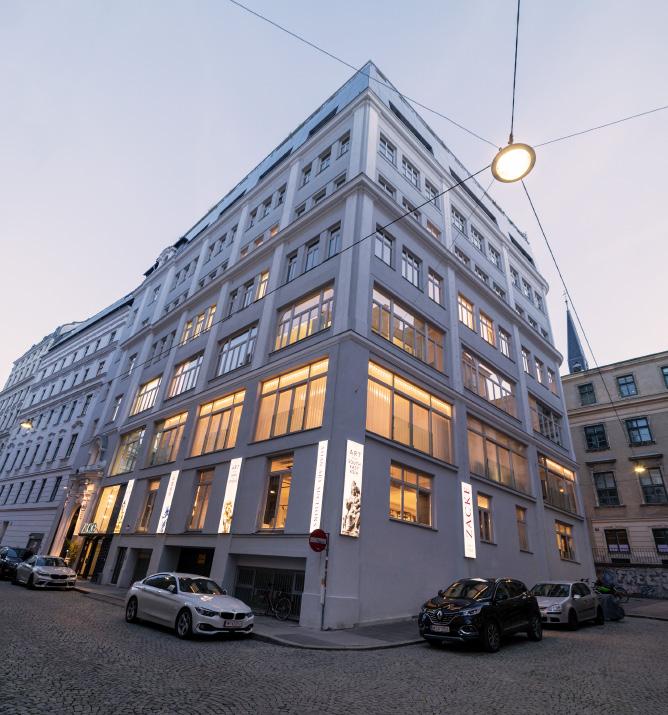
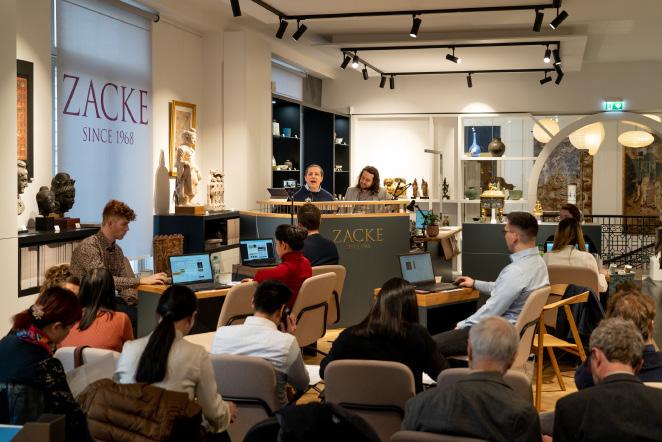
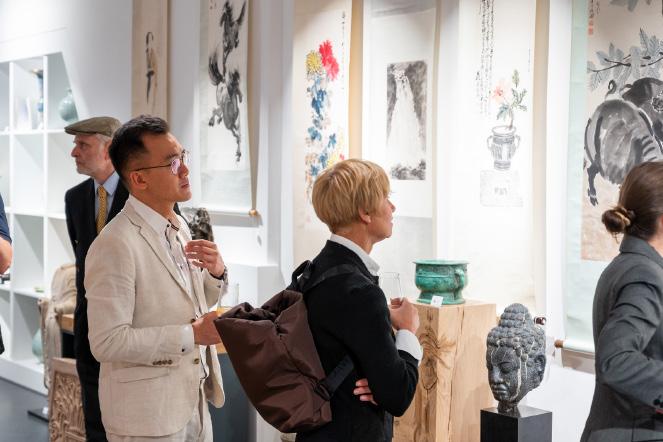
AUCTION EXHIBITION
Open for Viewing 2-10 October 2023
Monday through Friday from 10 AM to 6 PM, as well as by appointment
JOIN US LIVE
on 11 – 13 October 2023, at 11 AM CET in our auction room or bid online at Zacke Live with the advantage of our premium buyer’s terms without any additional online bidding fees. Registration required: www.zacke.at
How to Find Us
Our new address is Sterngasse 13, 1010 Vienna. We’re located in the heart of Vienna’s iconic first district, only a seven-minute walk away from the Stephansdom. Our new gallery is easily reachable by public transport or car.
SalztorgasseSalztorbrücke
Salzgries ObereDonaustr.
Wipplingerstr.Sterngasse
Marc-Aurel-Str.
HoherMarkt
Rotenturmstr.
Bäckerstr.
Wollzeile
Schulerstr.
U3
U1 U4 U1
Schwedenplatz Graben
Stephansplatz
A CLOISONNÉ ENAMEL ‘DA JI’ WALL VASE, CHINA, 18TH CENTURY
Of double gourd shape, the upper and lower bulbs centered by characters reading ‘da’ and ‘ji’ (‘great fortune’) respectively. Tied at the waist with a gilt-bronze flowing ribbon issuing loops and rolling ends along the sides. Finely decorated in bright enamels against a turquoise ground with colorful double-gourds borne on scrolling leafy vines, a bat diligently overlooking with its wings wrapped around the rim. The gilt-bronze back finely chased and incised with intertwining lotus scroll against a ring-punched ground with an aperture for mounting.

Provenance: From the private collection of Sara Fredericks, probably acquired in New York during the 1960s, and thence by descent. The back with an old label, ‘40’, and inscribed with a collector’s number, ‘40’. Sara Fredericks (1903-1986) was a designer and retailer who specialized in women’s luxury fashion for more than 50 years. After her marriage to Frederick Cohen, who was in the shoe business, she began selling dresses out of her home to women who admired her clothes. ‘’She lived the life her customers lived,’’ said Pauline Trigere, who was among the designers who considered Miss Fredericks a friend as well as a client. Others in that category were Geoffrey Beene, James Galanos, Bill Blass, Oscar de la Renta, Bob Mackie, and Hubert de Givenchy. ‘’She had impeccable taste,’’ Miss Trigere said, ‘her customers trusted her.’ Condition: Good condition with minor wear and manufacturing irregularities, including expected pitting. Minor flaking and small losses to enamels, tiny nicks here and there, two small dents with old fills.
Weight: 800 g
Dimensions: Height 23.5 cm
Wall vases were particularly popular during the reign of Qianlong and are known to have adorned the walls of the Sanxitang (The Hall of Three Rarities), a tiny studio next to the Imperial bedchamber in the Yangxindian. They were produced in a variety of materials, including porcelain, cloisonné enamel and lacquer, and occasionally inscribed with poems by the Emperor himself, such as the present lot. Compare several porcelain wall vases in the
collection of the Palace Museum Beijing, illustrated in The Life of Emperor Qianlong, The Macau Museum of Art, Macau, 2002, cat. nos. 63-2 to 63-9. The present wall vase displays the ornate aesthetic and technical mastery that characterizes cloisonné wares of the High Qing period. The doublegourd vase is particularly fine in the vibrant tones achieved in its enamel and the elegant execution of the linework of the cloisons.
LITERATURE COMPARISON
Compare a Yangcai sgraffiato ‘bats and clouds’ double-gourd form wall vase, with a Qianlong gilt six-character mark in horizontal line and of the period, at Christie’s Hong Kong, 30 May 2018, lot 3036. Compare a pair of embellished gilt-repousse copper wall vases, dated to the Qianlong period, at Christie’s New York, 13-14 September 2012, lot 1299.
Compare a pair of cinnabar lacquer ‘daji’ double-gourd wall appliqués, dated to the Qianlong period, at Sotheby’s London, 04 November 2009, lot 122.
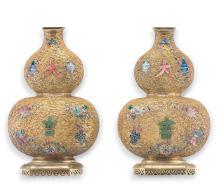
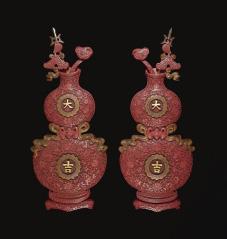
AUCTION RESULT COMPARISON
Type: Closely related
Auction: Christie’s London, 12 November 2010, lot 1427
Price: GBP 30,000 or approx. EUR 57,500 adjusted for inflation at the time of writing

Description: A cloisonné enamel double gourd wall vase, Qianlong period (1736-1795)


Expert remark: Compare the closely related technique, form, and ‘da ji’ characters. Note the smaller size (17.5 cm).
Estimate EUR 10,000
Starting price EUR 5,000
8 1
Sara Fredericks (1903-1986)

AN IMPERIAL PAIR OF QUADRILOBED CLOISONNÉ ENAMEL ‘LOTUS’ VASES, QIANLONG FIVE-CHARACTER MARK AND OF THE PERIOD
China, 1736-1795. Each baluster body is distinctively four-lobed and rises from a splayed foot to a waisted neck surmounted by a trumpet mouth with an everted lip in gilt-copper. Decorated around the exterior with bands of lotus blooms borne on meandering leafy scrolls between bats, ruyi and stylized lappet bands, all reserved on a deep turquoise ground. The recessed gilt copper base neatly incised with a five-character mark Qianlong nianzhi ze and of the period. (2)
Provenance: From the collection of J. J. Lally, New York, USA. To each box, a collector’s label, ‘Lally & Co. New York’ with handwritten inventory number ‘4289. James J. Lally was a connoisseur and dealer of Chinese art in New York city, USA. He is one of the most renowned scholars in the field of the past 40 years. In 1983, he was named president of Sotheby’s in North America and in 1986, he founded his namesake gallery, J. J. Lally & Co. In the spring of 2023, Christie’s and Bonhams conducted single owner sales of Lally’s collection which broke several auction records. Condition: Excellent condition with expected manufacturing irregularities and wear to gilt, minute hairlines, dents and nicks to enamels. Minor losses to enamels with associated old fills. Overall displaying exceptionally well.
Weight: 1494.1 g and 1499.2 g
Dimensions: Height 36.3 cm (each)
Each with a padded silk box and cover. (4)
LITERATURE COMPARISON
Compare a closely related pair of cloisonné enamel vases, 34 cm high, with the same five-character Qianlong marks as the present lot, at Dorotheum, Vienna, 27 September 1994, lot 1041. Compare a closely related pair of cloisonné enamel ‘lotus’ vases, 36 cm high, also with five-character Qianlong marks, the fifth character being ‘ze’, illustrated by Brinker and Lutz, Chinese Cloisonné: The Pierre Uldry Collection, Asia Society, New York, 1989, no. 282, p. 74, where the authors note: ‘During the Qianlong period (1736-1795) an additional character, the significance of which is obscure, is occasionally found below the usual mark.’ The authors go on to suggest the ‘ze’ character may be an indication of the use or category of the object on which it is inscribed.


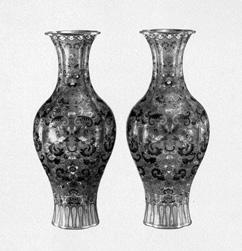
Estimate EUR 20,000
Starting price EUR 10,000

10 2
James J Lally, 1995

AN IMPERIAL CLOISONNÉ ENAMEL ‘LOTUS’ BOTTLE VASE, QIANLONG FIVE-CHARACTER MARK AND OF THE PERIOD
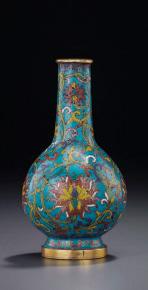
Published: Galerie Zacke, Feines Altes Kunsthandwerk aus China und Japan, Vienna, 1989, pl. 4a-c, nr. 4c.
Based on its size and shape, this vase was made to hold incense instruments. These types of small cloisonné vases, censers, and instruments (luping sanshi) which were made for the burning of incense had an additional character below the reign mark and were made for the Qianlong court. Some scholars have suggested that the fifth character under the Qianlong mark could have been a way to number the large group of objects in the correct order, see H. Brinker and A. Lutz, Chinese Cloisonné: The Pierre Uldry Collection, New York, 1989, pp. 74-79.
China, 1736-1795. The ovoid body supported on a slightly spreading foot, surmounted by a gently waisted slender neck, the shoulder with a gilt-bronze band, the rims also finely gilt. Neatly decorated in bright enamels with stylized lotus blooms borne on leafy scrolling vines between ruyi-head bands, the foot encircled by C-scrolls, all reserved on a turquoise ground. The base incised with a five-character mark Qianlong nianzhi yin and of the period.
Provenance: Anton Exner (Vienna 1882 – 1952 Vienna). By descent to Walter Exner (Vienna 1911 - 2003 Bad Wildungen). Galerie Zacke, Vienna, 1989. An Austrian private collection, acquired from the above. Condition: Presenting very well and in fine condition, commensurate with age, with old wear and expected manufacturing irregularities, including pitting and dark spots. Minor losses to enamels with associated old fills, one dent with an old repair.
Weight: 165.2 g
Dimensions: Height 11.8 cm

Small cloisonné vases such as the present lot were particularly popular during the reign of Qianlong and are known to have adorned the Sanxitang (The Hall of Three Rarities), a tiny studio next to the imperial bedchamber in the Yangxindian, as illustrated for example in The Life of Emperor Qianlong, The Macau Museum of Art, Macau, 2002. The present vase displays the ornate aesthetic and technical mastery that characterizes Imperial cloisonné wares of the High Qing period, with the characteristic vibrant colors of the enamels and the elegant execution of the linework of the cloisons only achieved during this period.
The personal study of Emperor Qianlong at the Forbidden City, Sanxitang, with a near-identical vase, published in The Life of Emperor Qianlong, The Macau Museum of Art, Macau, 2002
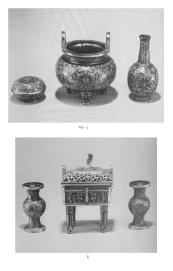

AUCTION RESULT COMPARISON
Type: Closely related
Auction: Christie’s Hong Kong, 29 May 2013, lot 2057
Price: HKD 300,000 or approx. EUR 39,500 adjusted for inflation at the time of writing
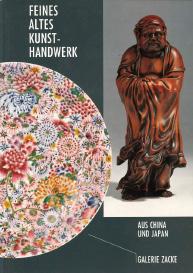
Description: A Small Cloisonné Enamel Bottle Vase, Qianlong Incised Four-Character Mark and of the Period (1736-1795)

Expert remark: Compare the closely related form, decoration, and incised Qianlong reign mark. Note the similar size (12.3 cm).
Estimate EUR 8,000
Starting price EUR 4,000
12 3

AN IMPERIAL CLOISONNÉ ENAMEL JARDINIÈRE, SUPPORTED BY THREE GILT-BRONZE ‘KNEELING BOYS’ FEET, QIANLONG PERIOD

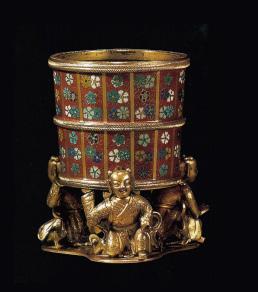
The present vessel’s bucket shape echoes a rustic wooden pail with vertical slats bound by rope and is clearly designed as an amusing variant of this standard artisan vessel, executed in expensive cloisonné enamels. Such conceits were very popular with the early Qing emperors, who took a particular pleasure in instructing their Palace and external craftsmen to recreate familiar objects in entirely different materials: archaic bronzes in jade, eel-trap nets in porcelain, bronze incense burners in lapis lazuli, or rhinoceros horn carvings in silver.
Jardinières of this shape still exist in the Qing Court Collections and have been published. Indeed, some still survive with additional embellishments at the top confirming that they were intended to be displayed in the Forbidden City and other Imperial palaces as pails of flowers, because some were deliberately fitted with simulated flower arrangements comprising miniature flowering trees, created with curling wire branches and suspending green hardstone leaves set with carnelian, crystal and other semi-precious hardstones.

LITERATURE COMPARISON
Published: Cohen & Cohen, Tyger Tyger!, Antwerp, 2016, pages 72-73, no. 32.
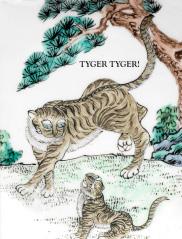
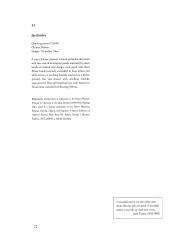
China, 1736-1795. The vessel with gently flared sides and supported by three feet, cast in gilt copper-alloy as kneeling boys dressed in voluminous robes incised with lotus blossoms and leafy vines, draped in billowing scarves, their faces well detailed with smiling expressions. The exterior of the vessel finely decorated with two rows of rectangular panels separated by raised gilt bands of twisted-rope design, each panel with five flowerheads brightly enameled in shades on a of blue, yellow, green, and white, borne on scrolling tendrils reserved on a rich red ground. The rim neatly incised with lotus blossoms and foliate scroll.
Provenance: Cohen & Cohen, Antwerp, 2016. A noted private collection in New York, USA, acquired from the above.
Condition: Excellent condition with some old wear, expected small losses with associated old fills, minor rubbing to gilt, minor nicks to enamels and metals. Shallow surface scratches. Expected manufacturing flaws such as minimal pitting. The interior has a good naturally grown patina with malachite encrustations.
Weight: 1,484 g
Dimensions: Height 18.2 cm, Diameter 15.5 cm

Compare a closely related gilt-bronze and cloisonné jardinière illustrated in Colorful, Elegant, and Exquisite: A Special Exhibition of Imperial Enamel Ware from Mr. Robert Chang’s Collection, Suzhou, 2009, pp. 84-85 (fig. 1). Compare a closely related gilt-bronze and red cloisonné-enamel jardinière supported by three boys, dated to the mid-Qing dynasty, illustrated in the Prime Cultural Relics Collected by Shenyang Imperial Palace Museum: The Enamel Volume, Shenyang, 2007, pp. 204-205. This example shows that the jardinière was used to hold hardstone imitations of auspicious flowers. Compare a closely related cloisonné flowerpot, dated to the mid-Qing dynasty, in the National Palace Museum, Beijing, illustrated in the Compendium of Collections in the Palace Museum: Enamels 4, Cloisonné in the Qing Dynasty, Beijing, 2011, p. 35, no. 6 (fig. 2)
Estimate EUR 20,000
Starting price EUR 10,000
14 4
fig. 2
fig. 1

AN EXCEEDINGLY RARE IMPERIAL ENAMELED COPPER HANDWARMER, QIANLONG MARK AND PERIOD

China, (1736-1795). Each side of the vessel is painted intricately with long tailed birds and butterflies in ornate gardens with rockwork, shrubs and flowers, within pink kuilong-bordered panels surrounded by peony, prunus, and lotus blossoms, all reserved on a pale lilac ground, the neck with a key-fret band.

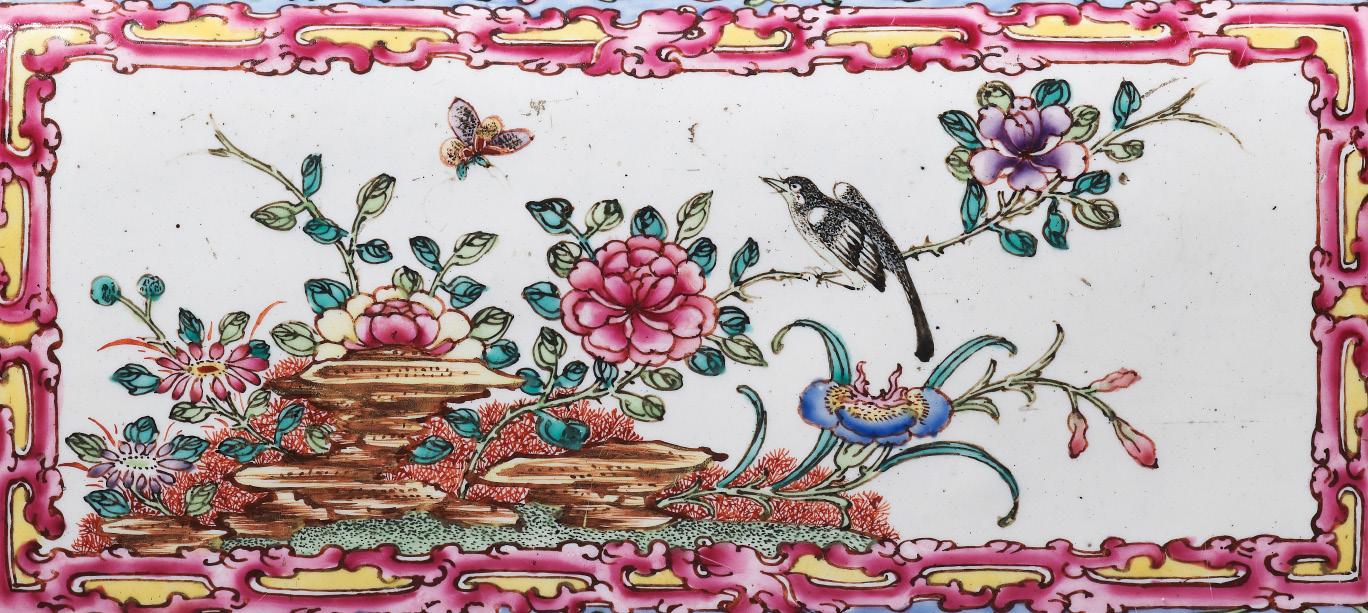
The pierced copper-repoussé lid is finely enameled and gilt with a central shou character in openwork among colorful clouds, the sides with shaped panels enclosing floral splays reserved against a brocade diapered ground. To the short sides, movable and hinged gilt-bronze overhanging handles.
The interior with rich turquoise enamel. The recessed base with a sixcharacter seal mark in blue enamel da Qing Qianlong nianzhi and of the period.
Provenance: From a private estate in Belgium, formerly in the collection of Paul Doumer. The base inscribed with an old collector’s number ‘196.’ Joseph Athanase Doumer (1857-1932), commonly known as Paul Doumer, was the President of France from 13 June 1931 until his assassination on 7 May 1932. He was Governor-General of French Indochina from 1897 to 1902, and successfully lobbied the French government to approve construction of the Indochina-Yunnan railway in 1898. He served as Minister of Finance of France three times and as President of the French Senate from 1927 until the 1931 presidential election, which he won. Condition: Absolutely original and unrestored condition. Only minor old wear and expected manufacturing irregularities. Minor losses to enamels, mostly on the cover. Slight warping, light scratches, and a few fine and hardly visible hairlines. The condition is very well visible on the images, with no hidden damages whatsoever. The bronze fittings with a good natural patina. Overall exceptionally well preserved, especially given its age, fragility and rarity.
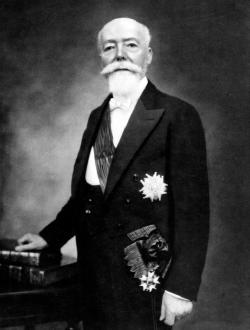
Weight: 526 g
Dimensions: Length 14 cm
Expert’s note:
Without question a masterpiece of Chinese 18th century enameling, this handwarmer exemplifies the softness and elegance achieved on the finest of enameled copper wares produced at the Palace workshops during the first half of the Qianlong reign. The delicacy in the use of the enamels is a key feature of the Palace workshops, allowing for considerable subtlety of expression. The brilliant, more opaque enamels used for the decorative borders in contrast to the softer main subject, demonstrate the range of possibilities available to Court artists. Of the two main Palace painted enamel arts (on glass and on copper), those on copper are more frequent. During the Qianlong reign enameled copper wares, including snuff bottles, ran into the thousands, whereas enameled glass wares were produced only in the low hundreds. Handwarmers, however, were never produced in glass, and therefore must be considered as exceedingly rare, although made from copper.
A rough estimate of the total number of enameled copper handwarmers produced during the Qianlong reign comes to less than one hundred, of which only few remain in private hands to this day. This is mainly due to the greater difficulty of producing them successfully, the need for multiple firings to correctly mature different colors and layers of enamel, and the much higher failure rate during production, due to the complex firing and re-firing process necessary to create the enameled openwork copper-repoussé cover. It was probably for this reason that the Imperial records also show that the Emperor only rarely distributed enameled openwork copper wares as gifts, preferring to keep most of them for Imperial use, while gifts of standard enameled metal wares were apparently quite frequent.
LITERATURE COMPARISON
Compare a closely related enamel handwarmer, also with a Qianlong mark and of the period, 14 cm long, in the Metropolitan Museum of Art, accession number 24.80.473a, b (fig. 1). Compare a related painted enamel handwarmer, dated to the Qianlong period, in the Palace Museum, Beijing, accession number Gu 00116721. Compare a related painted enamel handwarmer, dated to the mid-Qing dynasty, in the Palace Museum, Beijing, accession number Gu 00116718. Compare a related painted enamel handwarmer, dated to the Qianlong period, in the Palace Museum, Taipei, image number K1E000234N000000000PAB.
AUCTION RESULT COMPARISON
Type: Related
Auction: Bonhams New York, 20 November 2006, lot 6241
Price: USD 35,850 or approx. EUR 49,000 converted and adjusted for inflation at the time of writing
Description: A fine canton enamel bronze hand warmer, Qianlong mark and period
Expert remark: Compare the related enameled decoration, form, and Qianlong reign mark. Note the size (16.5 cm)
Estimate EUR 20,000
Starting price EUR 10,000
16 5
fig. 1
Paul Doumer in 1931 at the Élysée Palace

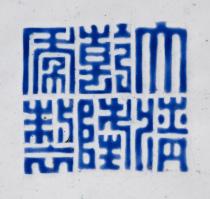

A LARGE CINNABAR LACQUER ‘PHOENIX’ FLOWERPOT, MING DYNASTY
China, 15th to early 16th century. With a heavily cast bronze body, finely modeled with deep rounded sides supported on a short foot and rising to an everted rim. Superbly carved through the layers of lustrous deep crimson lacquer to the ochre ground with a pair of phoenixes flying with outstretched wings amid large peony blossoms borne on leafy stems, with neatly incised details such as the feathers, blossoms, and leaves.
Provenance: From an old private collection in Cotswold, United Kingdom. Acquired in the 1920s or earlier, and kept in the same family ever since, according to the last owner.
Condition: Remarkably well preserved, commensurate with age. Old wear, expected age cracks and splits, small losses, tiny nicks here and there, light scratches. Some sections of the lacquer are slightly loosened.
Weight: 4,675 g
Dimensions: Diameter 34 cm, Height 27.4 cm
The ‘two birds’ design featuring a pair of birds among flowers was a popular motif in Chinese carved lacquer, particularly from the thirteenth to early fifteenth century. In this example, two phoenixes fly amid lush, blossoming peonies. Such decoration also became standard in other media, such as textiles and ceramics, produced by the Imperial workshops of the Ming dynasty.
LITERATURE COMPARISON: Compare a related cinnabar lacquer box and cover, similarly carved on an ochre ground with long-tailed birds and prunus blossoms, 24.2 cm in diameter, dated 15501650, in the Victoria & Albert Museum, accession number FE.50-1974.

AUCTION RESULT COMPARISON
Type: Related
Auction: Christie’s Paris, 12 December 2019, lot 62
Price: EUR 150,000 or approx. EUR 170,000 adjusted for inflation at the time of writing
Description: A rare and finely carved red cinnabar lacquer ‘peony’ box and cover, Xuande six-character mark and of the period (1426-1435)

Expert remark: Compare the closely related manner of carving through layers of cinnabar lacquer to an ochre ground, as well as the related peony motif, albeit without phoenixes. Note the reign mark, different form, and the much smaller size (22 cm).

Estimate EUR 15,000
Starting price EUR 7,500
19 6
A PAIR OF HEAVY CARVED CINNABAR LACQUER PEACH-FORM BOXES AND COVERS DEPICTING IMMORTALS, QIANLONG PERIOD
China. 1736-1795. Each finely carved in the form of a peach, the cover with a central panel enclosed by interlocking bats, surrounded by hexagonal floral diaper. One box depicts Li Tieguai riding a gigantic double gourd while holding his iron crutch, the other with Lu Dongbin standing on a giant leaf and holding his fly-whisk, his sword with ruyi pommel sheathed to his back, each against a neatly incised ground of turbulent waves. Each box and cover with a heavy metal core, the interior and base lacquered black. (2)

Provenance: London trade.
Condition: Very good condition with minor old wear, expected natural age cracks, small losses to the rim, and minor chips to edges.
Weight: 641.1 g and 584.9 g
Dimensions: Width 11.8 cm and 11.7 cm
LITERATURE COMPARISON
Compare a pair of related peachshaped boxes and covers depicting Daoist immortals, with Qianlong marks and of the period, presented by the Qianlong Emperor following Lord Macartney’s Embassy of 17921794, illustrated in John Ayers, Chinese and Japanese Works of Art in the Collection of her Majesty the Queen, Vol. 3, 2016, pp. 865, pls. 1988-1989 (fig. 1). Compare a related peach-shaped box and cover depicting Li Tieguai, 15 cm wide, dated to the Qianlong period, illustrated ibid., pp. 866, pl. 1990.
AUCTION RESULT COMPARISON
Type: Closely related
Auction: Sotheby’s London, 18 May 2018, lot 458
Price: GBP 11,875 or approx. EUR 19,000 converted and adjusted for inflation at the time of writing
Description: A carved cinnabar lacquer peach-form box and cover, Qing dynasty, 18th century Expert remark: Compare the closely related peach form, Daoist immortal subject, and manner of carving with similar hexagonal diaper and central panel, albeit enclosed by a slightly different band of stylized clouds. Note the size (14.5 cm).
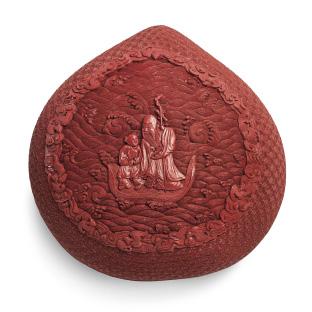
Estimate EUR 6,000
Starting price EUR 3,000
20 7
fig. 1

A SMALL CINNABAR LACQUER BOX AND COVER, YUAN TO MID-MING DYNASTY
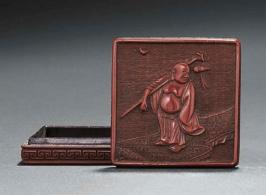
Expert’s note: Recent research into the dating of carved lacquer has put forward the suggestion that boxes of this type with double key-fret decoration on the rim and relatively large figures or landscape scenes with rock formations on the cover can be dated as early as the Yuan dynasty (1279-1368). The strongest argument in favor of this early dating is the relatively recent discovery of a similar, somewhat larger box in a group of tombs near Shanghai that belonged to the Ren family, of which the latest was datable to 1351 and the earliest to 1338.
China, mid-14th to 16th century. The five-sided box and cover is finely carved in relief to the top depicting an elderly scholar and his boy attendant framed by rock formations with vegetation and a protruding pine branch, all below swirling clouds. The ground the two figures are standing on is decorated with neatly incised floral lozenge diaper. The sides of the box and the cover are carved with bands of S-shaped key fret. The interior and base are lacquered in black.
Provenance: From an old Japanese private collection. British trade, acquired from the above.
Condition: Excellent condition with minor old wear, traces of use as expected. Good patina.
Weight: 32.8 g
Dimensions: Width 6.2 cm
With a Japanese wood storage box containing a paper inscribed in Japanese, ‘Tsuishu kogo’ (A carved red lacquer incense box). (2)
The five-sided shape of this box is extremely rare and is imbued with auspicious symbolism. Five is considered a sacred number in China, representing the Five Blessings of old age, wealth, health, virtuous love, and peace in the afterlife.
AUCTION RESULT COMPARISON
Type: Related
Auction: Christie’s Hong Kong, 2 October 2017, lot 215
Price: HKD 125,000 or approx. EUR 16,500 converted and adjusted for inflation at the time of writing
Description: A cinnabar lacquer ‘scholar on horseback’ circular box and cover, Ming dynasty, 16th century Expert remark: Compare the closely related S-shaped key-fret borders, two-tiered diapered ground, and manner of carving. Note the size (7.6 cm).
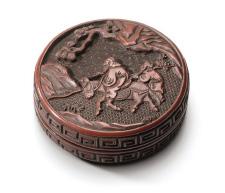
AUCTION RESULT COMPARISON
Type: Related
Auction: Christie’s Hong Kong, 29 May 2007, lot 1559
Price: HKD 96,000 or approx. EUR 17,500 converted and adjusted for inflation at the time of writing
Description: A rare finely carved cinnabar lacquer square incense box and cover, Ming Dynasty, 16th century Expert remark: Compare the related key-fret borders, two-tiered diapered ground, and manner of carving. Note the size (6.6 cm).

Estimate EUR 3,000
Starting price EUR 1,500
22 8
AN IVORY AND GOURD ‘SANYANG’ CRICKET CAGE, QING DYNASTY

China, 18th-19th century. The bulbous base is surmounted by a tall flaring neck with an ivory rim and cover. The cover is carved in openwork with three rams, climbing nimbly up craggy rocks beneath pine trees and a sun disk with delicately scrolling rays. The interior of the cover is meticulously reticulated, and the rim is finely polished.
Provenance: From an old Viennese private collection. Galerie Zacke, Vienna, ca. 1985. Austrian private collection, acquired from the above. An old label on the base inscribed by Irene Zacke, ‘130/9,800/ Grillenkäfig, China 19. Jh.’
Condition: Very good condition with only minor old wear, expected natural imperfections including age wrinkles to the gourd and few microscopic age cracks. Magnificent, naturally grown patina overall.
CITES: European Union Certificate number AT 23-B-0156, dated 12.5.2023.
Weight: 110.1 g
Dimensions: Height 13.5 cm
The ram is a symbol of filial piety, kindness, and patience. The three rams (sanyang) are also an auspicious motif, related both to the sun and to male children, as they provide a rebus for san yang kai tai, the opening up of the new growth in Spring, which in turn symbolizes happiness and good fortune.
LITERATURE COMPARISON
Compare a closely related gourd and ivory cricket cage with floral decoration, 12.5 cm high, in the Minneapolis Institute of Art, accession number 2002.271.22a, b.


AUCTION RESULT COMPARISON
Type: Related
Auction: Christie’s London, 10 May 2016, lot 12
Price: GBP 18,750 or approx. EUR 32,000 converted and adjusted for inflation at the time of writing
Description: An ivory and gourd cricket cage, 18th19th century Expert remark: Compare the gourd and ivory material. Note the slightly different form and additional tortoiseshell cage. Note the size (17.2 cm).
Estimate EUR 3,000
Starting price EUR 1,500
23 9
AN IVORY PENDANT DEPICTING LI TIEGUAI AND KUI XING, MING DYNASTY


China, 1368-1644. Of rectangular form with rounded corners, carved in relief, depicting Li Tieguai on one side with his characteristic iron crutch amid tufts of grass flanked by a craggy rock and towering pine tree amid swirling clouds, and to the other Kui Xing, the God of Examinations, standing atop a cloud in his characteristically vigorous pose holding a writing brush in his raised right hand and an ingot in the left.
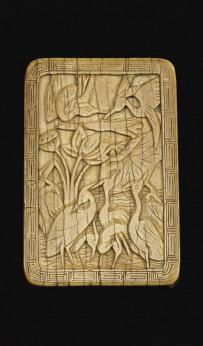
Provenance: Collection of Maria and Johannes Nickl, thence by descent in the same family. Maria (1926-2022) and Johannes Nickl (d. 2020) lived in Vienna, Austria, and were ardent collectors of Asian, Buddhist, and Egyptian works of art. They were highly active in Vienna’s tight-knit Asian art trade and assembled most of their collection during the 1980s and 1990s, frequently buying from Galerie Zacke and later Galerie Asboth. The couple were also noted museum patrons and their names are still found on the Ehrentafel (‘Roll of Honor’) of the Egyptian and Near Eastern Collection at the Kunsthistorisches Museum Wien (Museum of Fine Arts Vienna) today.
Condition: Very good condition with some wear, natural imperfections including expected age cracks, light scratches, few tiny nicks. One minuscule old fill to upper edge. Magnificent ancient and natural patina. CITES: European Union Certificate number AT 23-B-0235, dated 6.7.2023.
Weight: 48.1 g
Dimensions: Height 7 cm
Literature comparison: Compare a related ivory plaque depicting a figure and Buddhist lion, also dated to the Ming dynasty, 6.8 cm high, in the British Museum, registration number 2018,3005.551.
AUCTION RESULT COMPARISON
Type: Related
Auction: Sotheby’s London, 9 November 2011, lot 14
Estimate: GBP 30,000 or approx. EUR 55,000 converted and adjusted for inflation at the time of writing
Description: A carved ivory pendant, Ming dynasty
Expert remark: Note the similar form and the more extensive wear to this ivory pendant as opposed to the present lot which is still in very good condition.
Estimate EUR 3,000
Starting price EUR 1,500
24 10
A ZITAN ‘MOUNTAIN’ BRUSH REST, LATE MING TO MID-QING DYNASTY

China, 17th-18th century. The brush rest is naturalistically carved with elegant curves and four distinctively pointed peaks. The wood is smoothly polished to reveal the crab’s claw marks, characteristic for Zitan, and naturally patinated to an attractive dark brown tone lightly patched with paler undertones to one side, showing a decent luster overall. Note the raised foot rim, as expected from a brush rest dating to the first half of the Qing dynasty.

Provenance: From a Swedish private collection.
Condition: Good condition with old wear, light scratches and tiny nicks here and there. Expected natural age cracks, some with associated old fills.
Weight: 155.2 g
Dimensions: Width 14.1 cm
AUCTION RESULT COMPARISON
Type: Related
Auction: Sotheby’s Hong Kong, 1 April 2018, lot 3004
Price: HKD 562,500 or approx. EUR 73,500 converted and adjusted for inflation at the time of writing
Description: A large zitan ‘mountain’ brush rest Ming
Expert remark: Compare the closely related subject and material. Note the slightly different manner of carving with contorted knots and burls. Also note the larger size (21 cm).
Estimate EUR 3,000
Starting price EUR 1,500
25 11
A MONUMENTAL AND HIGHLY IMPRESSIVE LINGBI SCHOLAR’S ROCK, QING DYNASTY
Expert’s note: Ranked first among the four types of the famous Chinese Scholar’s Rocks, Lingbi are mostly carved from calcite and other ancient types of limestone. They originate from Lingbi county in Anhui Province and are fine-grained and delicately textured, found lying deep in the red mud of the Qingshi mountains. Naturally shaped, they need almost no cutting or carving. Depleted after generations of mining, large high-quality Lingbi such as the present lot are now exceedingly rare. Their mineral composition is such that they produce a metallic, distinct sound when tapped. Hence, they are also called ‘resonant rocks’ (bayinshi). Combining masculine beauty with antique simplicity, Lingbi have been admired by connoisseurs for centuries. In the Northern Song dynasty, Emperor Huizong wrote about a Lingbi in his collection: ‘The mountain is high while the moon looks small, the water ebbs and the rock juts forth.’
China, 1644-1912. The perforated vertical rock is evocative of a sinuous human figure in profile, with protrusions, stalactite-like extensions, deep crevices, and cavities. The porous stone is of a distinctly black tone suffused by distinct gray veins.

Provenance: New York trade. Acquired from a private estate.
Condition: The stone with minor dents, small losses and associated old repairs, few nicks, and natural inclusions and fissures, some of which have developed into small cracks over time. Signs of extensive weathering, erosion and wear, naturally grown patina overall. The wood base with expected minor age cracks and light surface scratches. Overall displaying magnificently!
Weight: 46 kg (excl. stand) and 48 kg (incl. stand)
Dimensions: Height 82 cm (excl. stand) and 96 cm (incl. stand)
With a modern wood stand. (2)
Traditionally, scholars collected two types of rocks for their studies: vertical peaks and horizontal mountain ranges. The present piece has primarily vertical peaks with cavities resembling cave topography. Hence, one can appreciate its inner and outer form. In texture and color, the stone is like black lacquer and is quite lustrous.
Connoisseurs of scholar’s rocks throughout the ages have boiled down their criteria for evaluating stones into twelve terms: thin, wrinkled, porous, permeable, clear, ugly, obtuse, clumsy, teal, powerful, beautiful, deep. Stones that have half of these features are considered rare and superior.
Literature comparison: Compare a related black scholar’s rock, 46.7 cm high, dated to the Qing dynasty, in the Metropolitan Museum of Art, accession number 2009512.1a, b, exhibited in the ‘The World of Scholars’ Rocks: Gardens, Studios, and Paintings,’ February 1–August 20, 2000 and in the ‘Noble Virtues: Nature as Symbol in Chinese Art,’ September 10, 2022–January 29, 2023.
AUCTION RESULT COMPARISON
Type: Closely related
Auction: Christie’s New York, 24 September 2021, lot 1007
Price: USD 62,500 or approx. EUR 66,000 converted and adjusted for inflation at the time of writing
Description: A lingbi scholar’s rock
Expert remark: Compare the closely related form and similar stand. Note the much smaller size (44.5 cm).
Estimate EUR 6,000
Starting price EUR 3,000
26 12

A BAMBOO LIBATION CUP, CHINA, 17TH – EARLY 18TH CENTURY
Naturalistically carved in openwork with undercutting as a section of a pine trunk, detailed with nodules imitating tree bark and carved growing pine firs on extended gnarled branches, the interior of the cup well-hollowed.


Provenance: From an old private collection in Hungary.
Condition: Very good condition with expected old wear, few small nicks, light scratches, signs of natural aging as expected of organic material with an age of 300 years or more. Beautiful, naturally grown patina overall.
Weight: 201.7 g
Dimensions: Width 12.8 cm
AUCTION RESULT COMPARISON
Type: Closely related
Auction: Christie’s London, 10 May 2011, lot 17
Price: GBP 11,250 or approx. EUR 21,000 converted and adjusted for inflation at the time of writing
Description: A carved bamboo libation cup, 17th/18th century
Expert remark: Compare the closely related modeling and manner of carving. Note the related size (14.7 cm).
Estimate EUR 3,000
Starting price EUR 1,500
28 13
A LARGE ZITAN ‘IMMORTALS’ BRUSH POT, BITONG, CHINA, 18TH CENTURY

Expert’s note: This brush pot is finely carved in a manner that closely adheres to the Imperial language of the mid-18th century, including crashing waves, layered rockwork issuing lingzhi, and densely scrolling clouds. Furthermore, it is made from Zitan wood, a material that was highly prized during this period.

Of cylindrical form, the exterior deeply carved in low relief with Li Tieguai balancing on his crutch and holding a calabash gourd, Liu Hai riding his three-legged toad, the He-He twins skimming and rafting over crashing waves, and Shoulao riding a crane, all amid craggy rockwork issuing lingzhi mushrooms and below thick swirling clouds. The Zitan wood of an attractive grain with characteristic crab’s claw marks and a rich, dark burgundy color.
Provenance: From an English private collection. Condition: Very good condition with expected old wear, resulting in a naturally-grown lustrous patina overall. Expected age cracks, tiny nicks and losses, and light scratches. The base with extensive wear and larger age cracks.
Weight: 3,015 g
Dimensions: Height 21.4 cm, Diameter 24.5 cm
AUCTION RESULT COMPARISON
Type: Closely related
Auction: Christie’s London, 10 May 2011, lot 171
Price: GBP 12,500 or approx. EUR 23,500 converted and adjusted for inflation at the time of writing
Description: A large carved zitan brushpot
Expert remark: Compare the related form and manner of carving, albeit depicting the Eighteen Luohan. Note the slightly smaller diameter (19.4 cm).
Estimate EUR 8,000
Starting price EUR 4,000
29 14
A CARVED AND RETICULATED BAMBOO PARFUMIER, CHINA, 18TH CENTURY

Of cylindrical form, intricately carved in openwork with four ladies gathered around a table as one of them practices calligraphy on a scroll, surrounded by numerous playful boys in a palace garden filled with flowering trees and craggy rockwork. Enclosed by a fence decorated with wan symbols, with a two-story pagoda in the background, all framed by neatly incised key-fret bands. The black-striated bamboo shows a nice grain and attractive color overall.
Provenance: Collection of Captain André Le Gac, acquired in China in the 1920s, during which time he was the captain of a Yangtze River gunboat, and thence by descent in the same family. André Jules Gabriel
Le Gac (1895-1960) was born in Brest, France. He joined the French Navy in 1914 and was awarded the Chevalier de la Legion d’ Honneur (Knight of the Legion of Honor). He was present for the German surrender at Saint-Nazaire in 1945. Throughout his travels with the navy, which also included a station in Hong Kong, Le Gac assembled a large collection of fine Chinese art which he brought home to France, thence remaining in the family for almost 100 years.
Condition: Very good condition with some old wear, minor nicks and traces of use. The buffalo-horn fittings with small chips and natural imperfections including small age cracks. Very good, naturally grown patina.
Weight: 203.4 g
Dimensions: Height 22.7 cm
Two buffalo-horn mounts are neatly fitted to bottom and top of the hollow parfumier. The base is additionally fitted with a hongmu wood stand. All four pieces are original to the lot and not later additions. (4)
The carver of this parfumier paid close attention to detail while creating this piece. Not only is the parfumier masterfully carved with extensive openwork, but the many charming scenes show great artistic inspiration, depicting groups of playful boys engaging in different games, all of which are captivating and expressive, and mostly emulate adult behavior. Three boys stand facing each other playing instruments with delighted expressions. Below them, a single boy performs a handstand, lifting his legs straight into the air. To his right, four boys are gathered around a table praying before an altar. In the center, three boys are depicted carting a fourth boy dressed up in imperial costume; one boy pushes the cart, another devotedly lifts a large tree branch over the boy Emperor’s head, and the third walks ahead carrying a banner. Above them, two boys point their bows up at ducks flying overhead amid swirling clouds; one boy has met his mark. Two boys are depicted running near the four scholarly ladies, with one chasing after the other.
AUCTION RESULT COMPARISON
Type: Closely related
Auction: Sotheby’s London, 11 November 2022, lot 66
Price: GBP 18,900 or approx. EUR 26,000 converted and adjusted for inflation at the time of writing
Description: A carved and reticulated bamboo parfumier, Qing dynasty, 18th century

Expert remark: Compare the closely related manner of carving (albeit arguably less elaborate and inspired than the present lot), openwork, and incised key-fret borders. Note the near-identical size (22.3 cm).
Estimate EUR 4,000
Starting price EUR 2,000
15
16
A PAIR OF SILVER-LINED ZITAN ‘MAGNOLIA’ LIBATION CUPS, CHINA, 18TH CENTURY

Each finely carved as a large magnolia flower borne on an openworked gnarled branch bearing neatly incised buds and blossoms. The interiors with meticulously applied silver liners. The base of each cup painted in red lacquer with a single-character mark. The dark-red zitan wood is of an attractive grain and color with characteristic ‘crab’s claw’ markings overall. (2)
Inscriptions: To each base, ‘Qiao’.
Provenance: John Sparks Ltd., London, United Kingdom, 1986. A private collection in West Yorkshire, United Kingdom, acquired from the above and thence by descent. A copy of the original signed invoice from John Sparks, dated 1 May 1986 and confirming the dating above, accompanies this lot. Note that the invoice describes the cups as being of ‘peach-shape’.
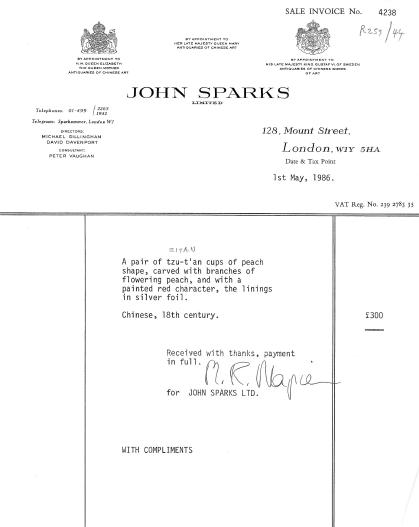
Condition: One cup in excellent condition with only minor old wear, the other in very good condition with a minute natural age crack, possibly with an associated old fill. The silver liner is exceptionally well preserved on both cups. Overall with a magnificent patina and displaying exceptionally well.
Weight: 58.6 g and 62.6 g
Dimensions: Width 9.5 cm and 9.4 cm
AUCTION RESULT COMPARISON
Type: Related
Auction: Christie’s New York, 20 September 2013, lot 1588
Price: USD 8,750 or approx. EUR 11,500
converted and adjusted for inflation at the time of writing
Description: A set of four Zitan cups, 18th-19th century Expert remark: Compare the related form and material. Note the lacking of any liner, the later date, and that the lot comprises four cups. Note the near-identical diameters (10 cm).
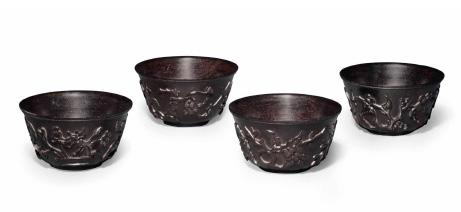
Estimate EUR 3,000
Starting price EUR 1,500
31
AN EXTREMELY RARE AND FINE BAMBOOVENEER RUYI SCEPTRE, QIANLONG PERIOD, IMPERIALLY INSCRIBED WITH A POEM COMPOSED IN THE BINGZI YEAR (1756)
Inscriptions: The poem Zhu ruyi, written by the Qianlong Emperor, is meticulously incised in three columns to the reverse. The inscription’s quality is remarkably high, executed with a precision that only the Imperial workshops in Beijing were capable of achieving.
‘My literary mind is that of the rhapsodies of Deyu, and my sense of Chan is that of the poetry of Jiaoran. Moreover, I possess perfectly natural joints, and am wholly free of protruding branches. The magic arts of Luo Gongyuan are but fantasies after all, but the gift of Sengshao is truly a suitable thing. I only like it where pure conversation occurs, as when I meet with noblemen.’
‘Qianlong yuti’ (Imperial composition of the Qianlong Emperor)
China, 1756-1795. The scepter shows a smooth, golden bambooveneer surface and is carved in two parts with an arched shaft terminating in a large head decorated with a flying bat suspending two cash coins (wu zhu) linked together by a ribbon in its mouth. The shaft is decorated with a stylized Shou character suspended from a chime and tied with a ribbon hanging from the character’s center, the base of the shaft with a central lotus bloom surrounded by ruyi and key-fret designs.
Provenance: From an old private collection in the United Kingdom, acquired by the previous owner’s grandparents and thence by descent in the same family.
Condition: Superb condition with expected minor old wear, minuscule flaking, some natural age cracks barely visible to the naked eye, and occasional light surface scratches. Naturally grown golden-brown patina overall.
Weight: 80.1 g
Dimensions: Length 32.7 cm

The poem inscribed on the present scepter is titled Zhu ruyi (‘The Bamboo Ruyi Sceptre’), recorded in Qianlong yuzhi shiji (‘Collected Poems of the Qianlong Emperor’), vol. 2, 63 juan, and dated between the 10th day of the 4th month and the 28th day of the 4th month of the bingzi year (equivalent to 1756).
In his poem, Qianlong refers to Li Deyu (787-850) from the Tang dynasty who served as prime minister. Li Deyu was a politician but was also a famous writer of prose and poetry. He wrote beautiful rhapsodies known as fu which the emperor praises in the poem as wenxin or ‘literary minded.’ This was likely meant as a pun, playing off the word wenxin which means ‘the core of my grain.’ The pun implies that the bamboo is robust and strong just like Li’s epic poems. Another play on words occurs when the emperor refers to Li’s eminently high moral principles (dajie) by using the expression tianran jie (natural joints), referring to Li’s ‘heavenly endowed moral integrity’.
Jiaoran (730-799), the second reference in Qianlong’s poem, was a poet monk from Changcheng in the Zhejiang province, who was also known by his secular name Xie Zhou. He was deeply influenced by Daoist, Buddhist, and Confucian traditions, and he lived in the Miaoxi temple on Xu Mountain. He became famous for his literary criticism and was a key participator in the Classical Prose Movement of the late Tang dynasty. Jiaoran conveyed the meaning of Chan (Zen) Buddhism in his work, and his poems pontificate on the truth derived from consciousness, contemplation and enlightenment. Qianlong, a devote Buddhist, spent many hours in his study reading the poems of Jiaoran and associated himself with the notion that his ‘sense of Chan’ was on the same level as his.
The third historical figure mentioned by Qianlong in this poem is Luo Gongyuan, a Daoist priest, who according to legends used his magic to help Emperor Xuangzong (712-755) meet the beautiful Consort Yang Guifei in his afterlife. In the poem, Qianlong also mentions the priest Sengshao, who is known for compiling the work Hualin Fodian Zhongjing
Mulu (The Catalogue of the Scriptures Kept in the Buddha Hall of Hualin Palace) in 513 on the orders of the Wu emperor of the Liang dynasty. He was a learned monk who lived in recluse and gave up his hermitage which was reconstructed to be a Buddhist temple. Qianlong refers to this temple constructed on the site of Sengshao’s hermitage when he writes ‘the gift of Sengshao,’ which is the famous Qixia si (Perched among Rosy Clouds Temple).
By comparing himself to famous figures in antiquity, Qianlong was setting an example for himself and for others to follow. He wrote that his preference was ‘pure conversation’, insinuating that Li Deyu and the others were men who were free from the taint of the mundane, political, and personal ambitions and all worldly concerns that he himself had to handle on daily basis.
Bamboo veneer, or zhuhuang, was a technique developed in Jiangxi province in the mid-Qianlong period and taken up by the Palace Workshops, thereafter remaining popular at the Court well into the 19th century. It required tremendous skill, using the inner layer from the cortex of the bamboo, which was resistant to insects, to create the veneer. This was then decoratively applied to a base form, usually also made of bamboo, and subsequently carved.
The bat holding two cash coins creates a visual pun. The word for bat (fu) sounds like the word for happiness, while the word for coin is a homophonous link to the word ‘before’ or ‘in front of.’ These homophones are meant to be interpreted as the blessing ‘happiness before your eyes.’
LITERATURE COMPARISON
Compare a closely related bamboo-veneer scepter donated by Florence and Herbert Irving with the identical Qianlong poem inscribed on the reverse, 34.9 cm long, dated to the mid-18th century, in the Metropolitan Museum of Art, accession number 2015.500.6.40, exhibited in Masters and Masterpieces: Chinese Art from the Florence and Herbert Irving Collection, January 30, 2021-June 5, 2022.
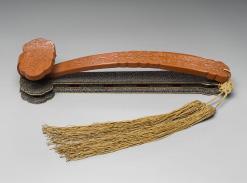
AUCTION RESULT COMPARISON
Type: Closely related
Auction: Christie’s Hong Kong, 30 November 2016, lot 3224
Estimate: HKD 7,000,000 or approx. EUR 926,000 converted and adjusted for inflation at the time of writing
Description: An inscribed bamboo veneer ruyi scepter with a poem by the Qianlong Emperor, Qianlong period
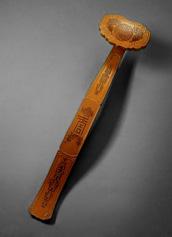
Expert remark: Compare the closely related form, technique, and material, as well as the identical poem inscribed on the reverse. Note the size (45 cm).
AUCTION RESULT COMPARISON
Type: Closely related
Auction: Beijing Poly International Auction, 29 November 2010, lot 4797
Price: RMB 5,600,00 or approx. EUR 982,000 converted and adjusted for inflation at the time of writing
Description: An imperial bamboo-veneer ruyi with an imperial poem by the Qianlong Emperor, Qianlong period
Expert remark: Compare the closely related form, technique, and material, as well as the identical poem inscribed on the reverse. Note the size (35 cm).
Estimate EUR 20,000
Starting price EUR 10,000
32 17

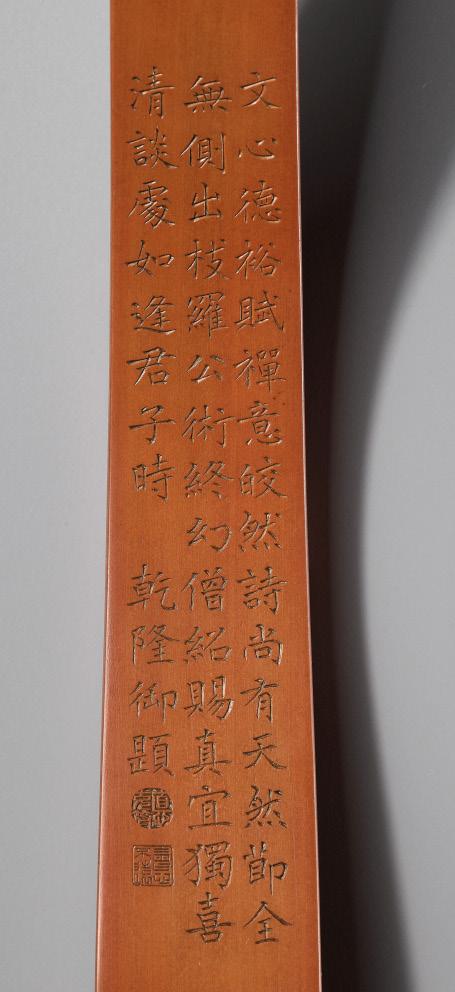
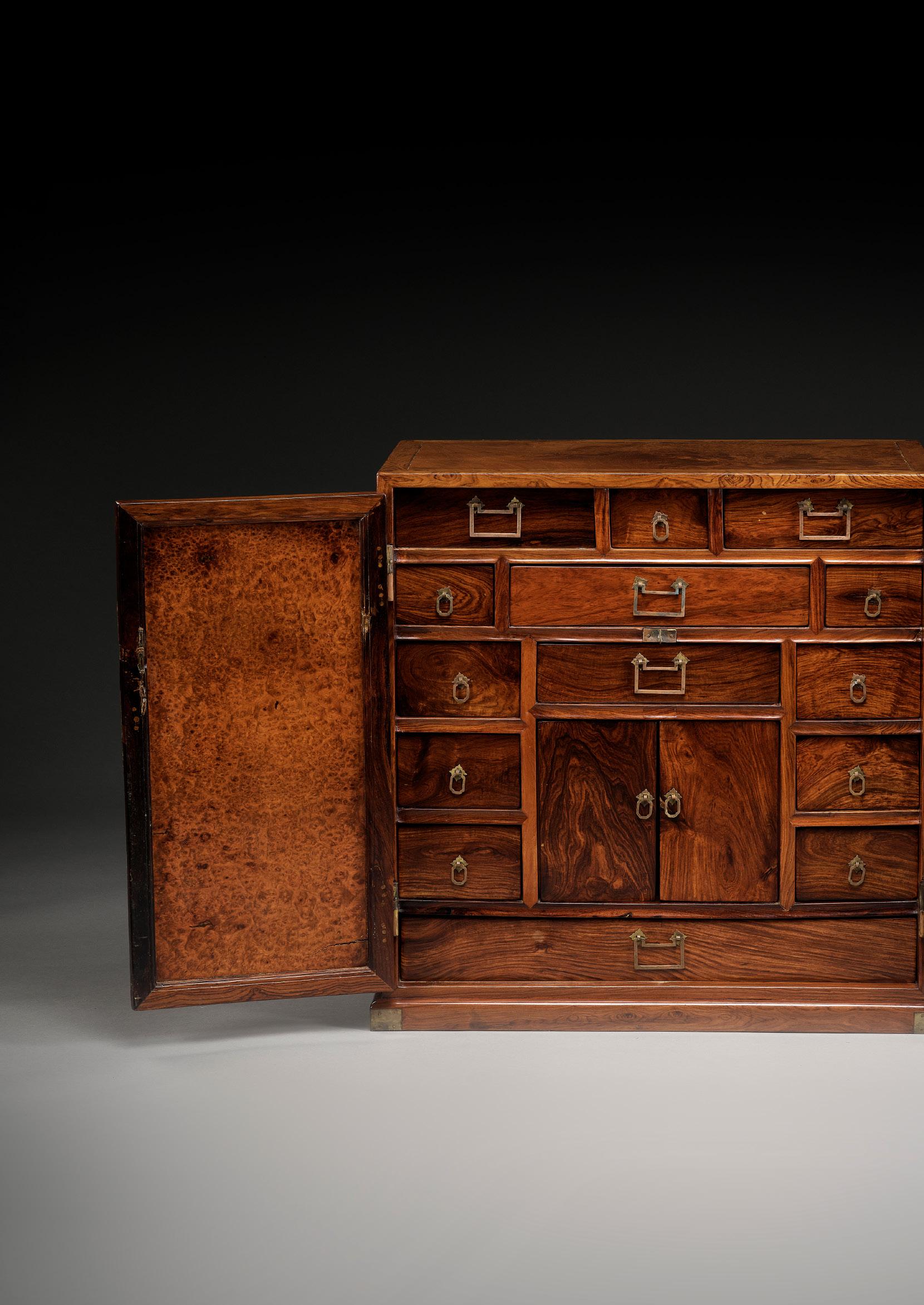
China, 17th-18th century. The rectangular frame set with a pair of finely figured paneled doors fitted flush with the surface and opening to reveal a pair of smaller doors beneath three rows of three sets of drawers, enclosed by two smaller drawers on both sides and a single larger drawer beneath it. These two smaller doors open to an inner cabinet with a carved frame. Each drawer is fitted with elegant baitong pulls, the exterior with foliate door escutcheons with loose rectangular pulls, rectangular hinges, and loose ring handles set to the sides also made of baitong. The wood of an attractive grain and color with impressive ‘ghost eyes’ on the cabinet doors.
Provenance: Tomlinson Antique House, Geylang, Singapore, before 1995. From a French private collection, acquired from the above and thence by descent. A copy of a Certificate of Antiquity from Tomlinson Antique House, with photos of the present lot and dating it to the 18th century, accompanies this lot. Tomlinson Antique House was established 1976 in Singapore and specializes in antique Chinese furniture and Asian antiquities. Condition: Good condition, commensurate with age, showing old wear and traces of use, light surface scratches, natural age cracks and splits, small losses, tarnishing to the baitong fittings. Possibly with minor replacements, as expected from ancient Chinese furniture with an age of 250 years or more. Overall with a magnificent naturally grown patina, thus displaying exceptionally well.

Weight: 52 kg
Dimensions: Height 73 cm, Width 71.7 cm, Depth 39 cm
Cabinets of this size and form are generally described as traveling bookcases if the interior contains shelves, and as apothecary chests if there are numerous drawers, as in the present example. The large size and luxurious hardwood render these forms quite heavy and not easy to move, and thus they are often described as table cabinets. In fact, the drawers could have been used to store a variety of things from treasured scholarly objects to cosmetics and accessories.
Expert’s note: See Wang Shixiang, Connoisseurship of Chinese Furniture: Ming and Early Dynasties, vol. I, Hong Kong, 1990, pp. 94-95, for a discussion on apothecary chests.
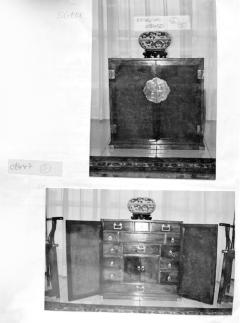

35 18
A LARGE HUANGHUALI APOTHECARY CABINET (YAOGUI) WITH FOURTEEN DRAWERS, EARLY QING DYNASTY
Literature comparison: See a similar example illustrated by Wang Shixiang, Classic Chinese Furniture: Ming and Early Qing Dynasties, Hong Kong, 1986, pl. 159. Another example of smaller size is illustrated in Grace Wu, The Best of the Best, The MQJ Collection of Ming Furniture, vol. 2., Hong Kong, 2017, pp. 334-5. See also a related cabinet, a traveling bookcase with side posts and top rail, in the Minneapolis Museum of Art, illustrated in Robert D. Jacobsen with Nicholas Grindley, Classical Chinese Furniture in the Minneapolis Institute of Art, Minneapolis, 1999, pl. 70.
AUCTION RESULT COMPARISON
Type: Closely related
Auction: Bonhams New York, 20 March 2023, lot 87
Price: USD 120,075 or approx. EUR 109,000 converted at the time of writing
Description: A rare huanghuali apothecary cabinet, yaogui, early Qing dynasty, 17th century
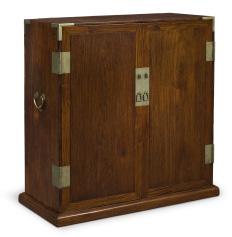
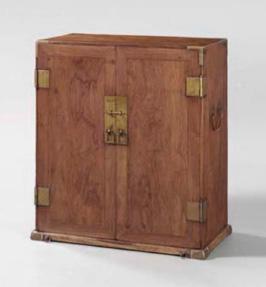
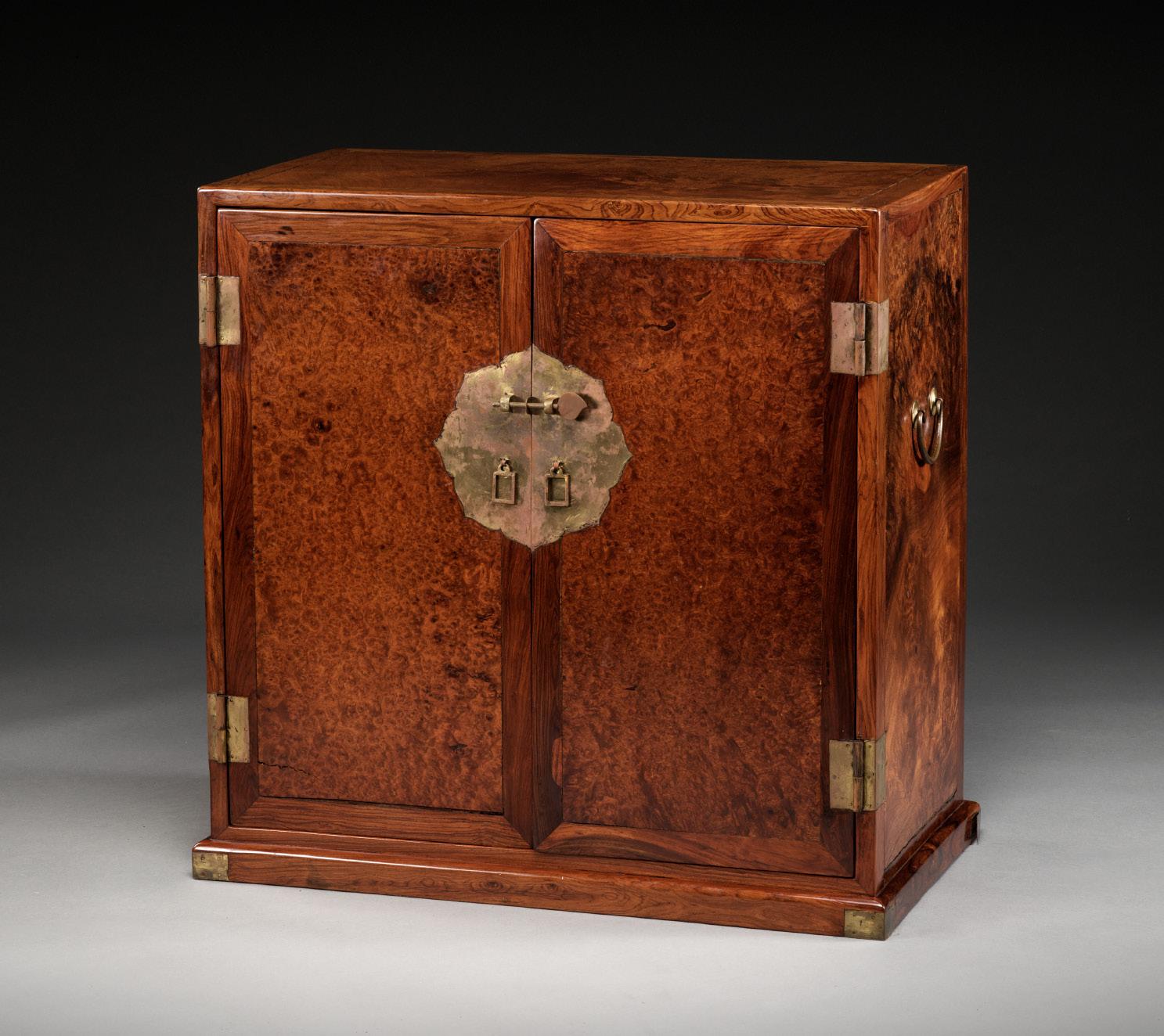
Expert remark: Compare the closely related form, also with fourteen drawers surrounding a central compartment with doors, and baitong mounts with similar pulls and hinges. Note the related size (74.9 x 60.7 x 35.5 cm).
AUCTION RESULT COMPARISON
Type: Related
Auction: Christie’s New York, 21 September 2004, lot 15
Price: USD 77,675 or approx. EUR 116,000 converted and adjusted for inflation at the time of writing
Description: A fine huanghuali apothecary cabinet, yaoxiang, 17th century
Expert remark: Compare the related form, huanghuali wood, and baitong mounts with similar side handles, pulls, and hinges. Note the related size (78.1 x 71.1 x 38.9 cm) and that the interior encloses twenty-eight drawers.
AUCTION RESULT COMPARISON
Type: Related
Auction: Sotheby’s New York, 20 March 2019, lot 702
Price: USD 68,750 or approx. EUR 75,500 converted and adjusted for inflation at the time of writing
Description: A ‘huanghuali’ square-corner apothecary cabinet (yaoxiang), 17th/18th century
Expert remark: Compare the related form, huanghuali wood, and mounts with similar side handles, pulls, and hinges. Note the related size (73.7 x 69.2 x 30.8 cm) and that the interior encloses sixteen drawers.

Estimate EUR 30,000
Starting price EUR 15,000
36
A HUANGHUALI KANG TABLE, CHINA, LAST QUARTER OF THE 18TH CENTURY

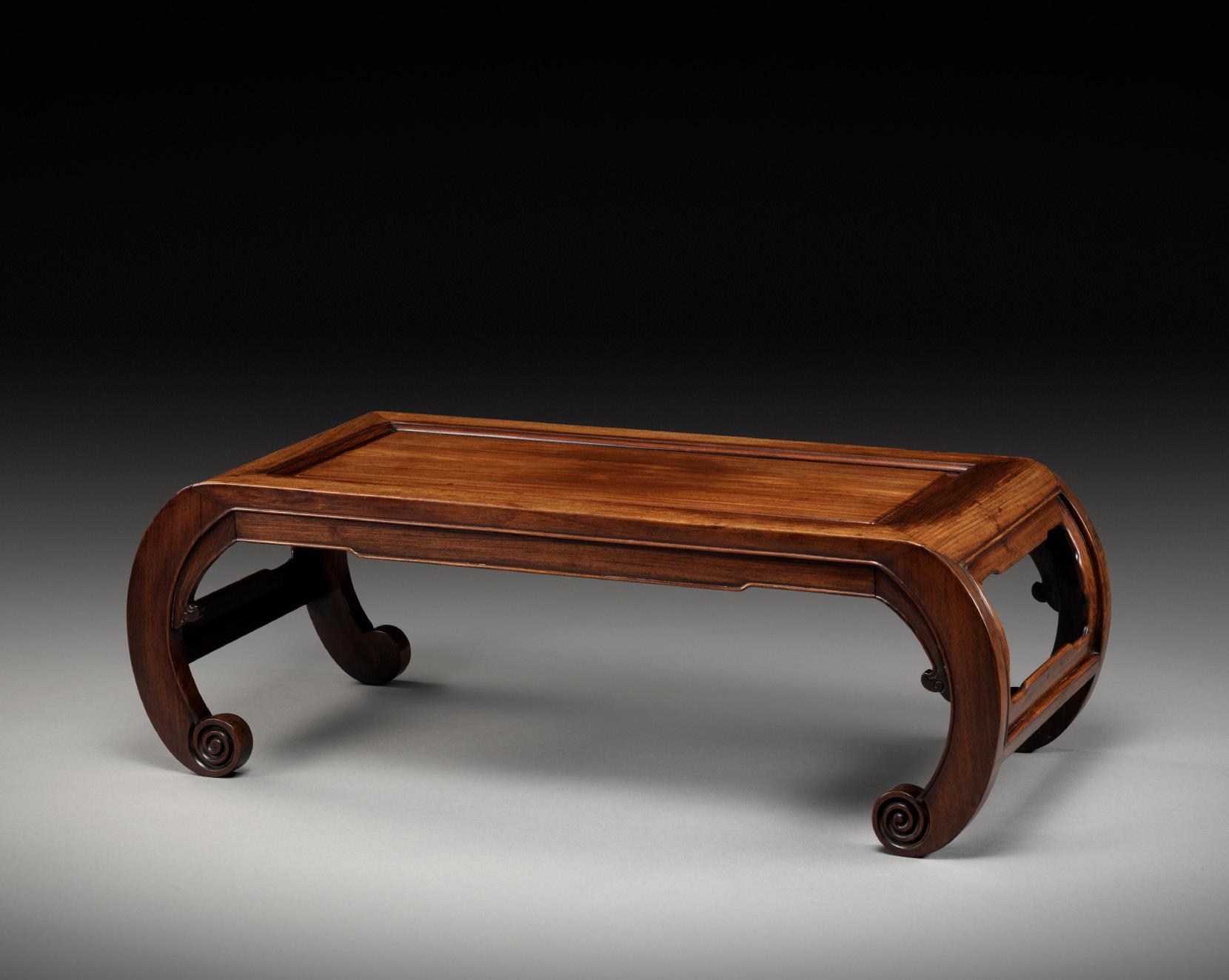
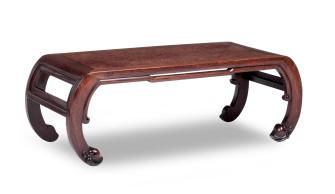
Standing on four convex legs terminating gracefully into boldly carved scroll feet. The central floating panel is slightly recessed and has a stepped frame. The elegant, raised-edge apron terminates on both sides into small ruyi heads. The sides each show a curved openwork board, neatly set within a raised rectangular frame.
Provenance: Charles Lumb & Son, Harrogate, United Kingdom. Collection of Mr. & Mrs. D.L. Clarke, Huddersfield, United Kingdom, acquired from the above. A copy of the original signed and stamped invoice from Charles Lumb & Son, dated 9 September 2000, confirming the dating above, and listing a purchase price of GBP 2,000 or approx. EUR 5,300 (converted and adjusted for inflation at the time of writing), accompanies this lot. Charles Lumb & Son Ltd. was established in 1907 in Harrogate by Charles Lumb (1887-1963), who was originally a cabinetmaker and, with his sons Frank and Reginald, and later his grandson Tony, developed into one of the most important antique furniture dealers of the United Kingdom.
Condition: Good condition, commensurate with age, showing expected old wear, stains, scratches and other traces of use. Some age cracks, splits, losses and old replacements. Fine, entirely natural patina overall. Presenting remarkably well.
Dimensions: Size approx. 33 x 96 x 43 cm
AUCTION RESULT COMPARISON
Type: Related
Auction: Bonhams Edinburgh, 23 March 2016, lot 229
Price: GBP 4,375 or approx. EUR 7,400 converted and adjusted for inflation at the time of writing

Description: A fine huanghuali and burl-wood low table, kang, Qing dynasty Expert remark: Compare the related form with convex legs and panel ends. Note the different feet with peach-form ends. Note the closely related size (33 x 94 x 40.5 cm).
Estimate EUR 4,000
Starting price EUR 2,000
37
19
The showroom at Charles Lumb & Son, 24 Montpellier Parade, 1949
AN AGATE CUP AND MATCHING CUP STAND, YONGZHENG PERIOD
China, 1723-1735. The tall cup with deep rounded sides rising from a recessed base to a lipped rim, neatly mounted in finely gilt-bronze. The stand matching the cup perfectly, with an accurately carved circular recess to the top center, designed for the cup to fit in. Both carved from the same translucent pale gray stone showing characteristic jagged striations of cream, black, and honey tones, all quite typical for this specific material, which was much coveted at the Yongzheng court.
Provenance: From the personal collection of J. J. Lally, New York, USA. With two labels from J. J. Lally, each inscribed with the number ‘4359’. James J. Lally was a connoisseur and dealer of Chinese art in New York city, USA. He is one of the most renowned scholars in the field of the past 40 years. In 1983 he was named president of Sotheby’s in North America and in 1986 he founded his namesake gallery, J. J. Lally & Co. In the spring of 2023, Christie’s and Bonhams conducted single owner sales of Lally’s collection which broke several auction records.
Condition: The cup in fair condition, commensurate with age, showing expected minor wear, the stone with natural fissures, some of which have developed into minor hairlines and a star crack below the rim. The matching saucer is in absolutely perfect condition.
Weight: 39.1 g
Dimensions: Height 4.6 cm
With a padded silk box and cover. (3)
The appreciation of the agate stone saw a revival during the Yongzheng reign. Records in the archives of the Imperial Jade Workshops, yuzuo, dated 1724-1729, noted that the Yongzheng emperor ordered for agate brush washers and bowls to be kept undecorated in order to show the original pattern of the agate stone. Pieces with ‘intricate’ designs or of unsatisfactory quality were rejected and sent back to the Imperial Palace Workshops.
Literature comparison: The Imperial collections in Taipei and Beijing hold a number of extant agate vessels, bearing the Yongzheng mark and of the period; see Feng Mingzhu, Harmony and Integrity: The Yongzheng Emperor and His Times, Taipei, 2009, pp. 235-245. Compare an agate cup and dish in the Palace Museum, Beijing, illustrated by Yang Boda, Zhongguo Yuqi Quanji, Hebei, 2005, pp. 553 and 550, nos. 10 and 62. Also compare an agate bowl from the Yongzheng period in the National Palace Museum in Taipei, image number K1D000405N000000000PAB.

AUCTION RESULT COMPARISON
Type: Closely related
Auction: Sotheby’s Hong Kong, 8 October 2014, lot 3774
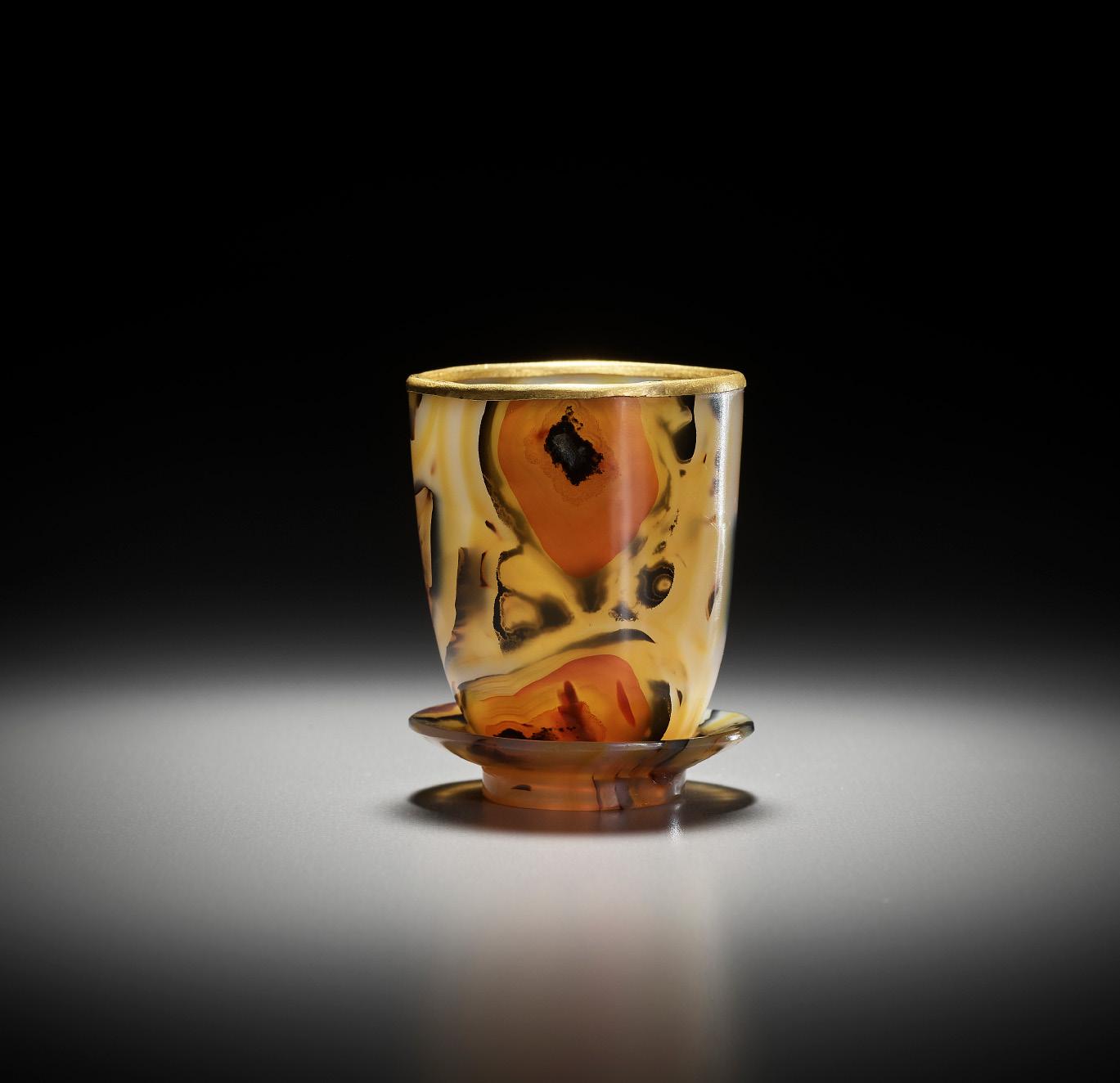
Price: HKD 1,060,000 or approx. EUR 154,000 converted and adjusted for inflation at the time of writing
Description: A rare agate cup incised seal mark and period of Yongzheng
Expert remark: Compare the related form and size. Note the present Yongzheng reign mark and the missing cup-stand.
Estimate EUR 4,000
Starting price EUR 2,000

38
20
James J. Lally, 1995
A SMALL TRANSPARENT AMBER GLASS HEXAGONAL WASHER, JIAQING MARK
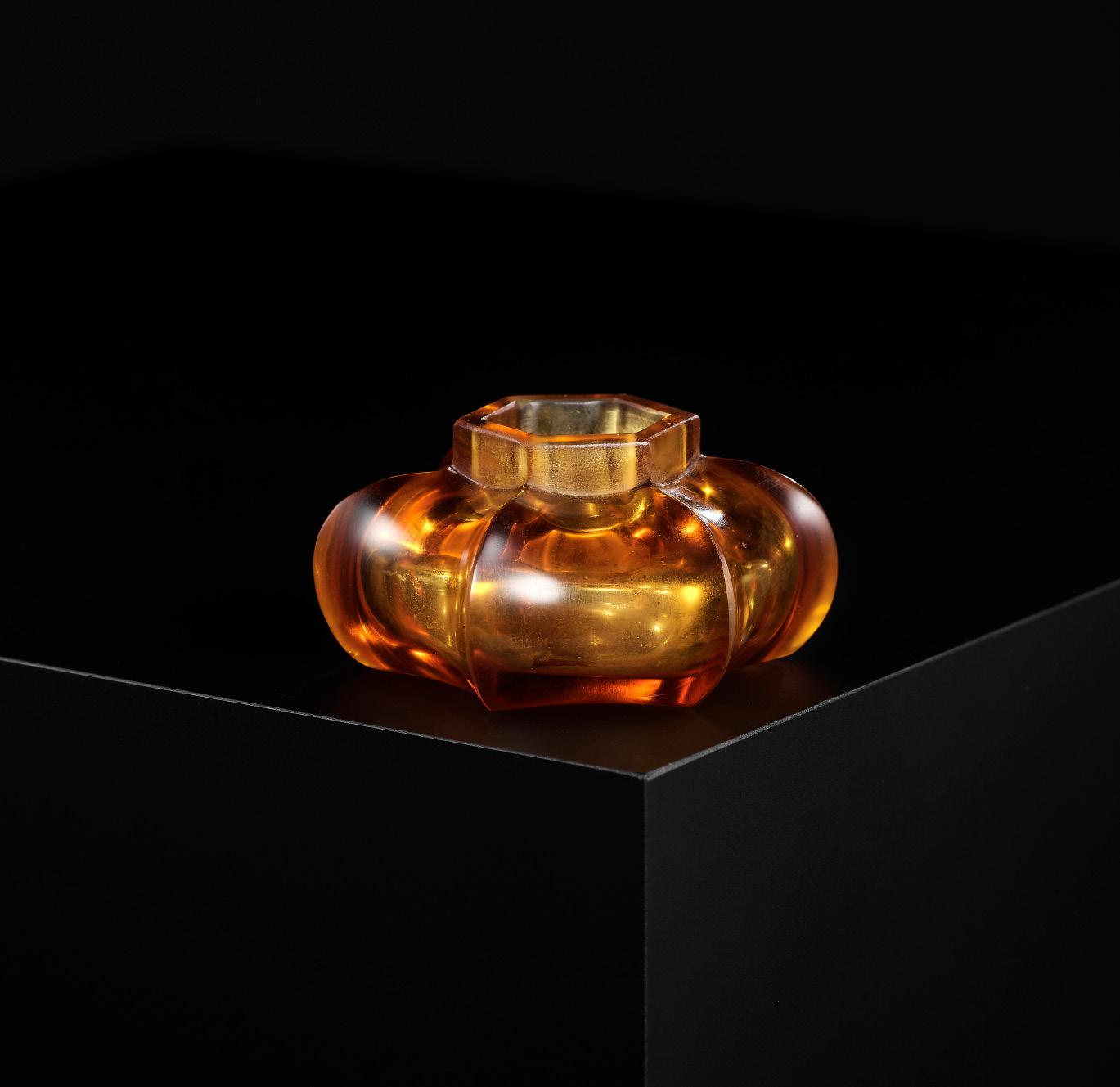
AND PERIOD
Expert’s note: The present lot boasts an elegant and inspired form which allows it to be used as both a brush washer and rest. Glass washers of this type were evidently produced between the Yongzheng and Jiaqing reigns. For Yongzheng and Qianlong-marked examples, see the auction result comparisons below.
China, 1796-1820. The washer is formed with sharply facetted rounded sides rising from a flat base to a short straight hexagonal mouth. The glass is of a vibrant transparent amber tone. The base with a wheel-cut four-character mark Jiaqing nianzhi within a square and of the period.
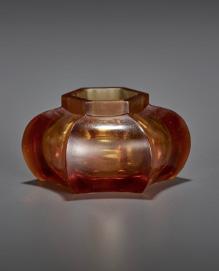

Provenance: Australian trade. By repute acquired from a local collector, who owned this piece for several decades.
Condition: Very good condition with old wear, mostly to base, shallow surface scratches, microscopic nicks, and expected manufacturing flaws such as bubbles and other small flaws to the glass.
Weight: 60.5 g
Dimensions: Width 6 cm
Literature comparison: Compare a closely related Yongzheng-marked hexagonal water pot in the Palace Museum, Beijing, illustrated in Glass of the Qing Imperial Workshop, Beijing, 2005, no. 15.
AUCTION RESULT COMPARISON
Type: Closely related
Auction: Christie’s Hong Kong, 3 June 2015, lot 3259
Price: HKD 625,000 or approx. EUR 87,000 adjusted for inflation at the time of writing
Description: A small transparent amber glass hexagonal washer, Yongzheng four-character mark within a square and of the period (17231735).

Expert remark: Compare the closely related form and color. Note the Yongzheng reign mark.
AUCTION RESULT COMPARISON
Type: Closely related
Auction: Galerie Zacke, Vienna, 11 May 2019, lot 98
Price: EUR 27,808 or approx. EUR 34,000 adjusted for inflation at the time of writing
Description: An amber-glass washer, Qianlong period
Expert remark: Compare the closely related form and color. Note the Qianlong reign mark.
Estimate EUR 4,000
Starting price EUR 2,000
39 21
AN EXCEPTIONAL YELLOW JADE FIGURE OF A BEAR, HUANGXIONG, HAN DYNASTY, CHINA, 202 BC – 220 AD
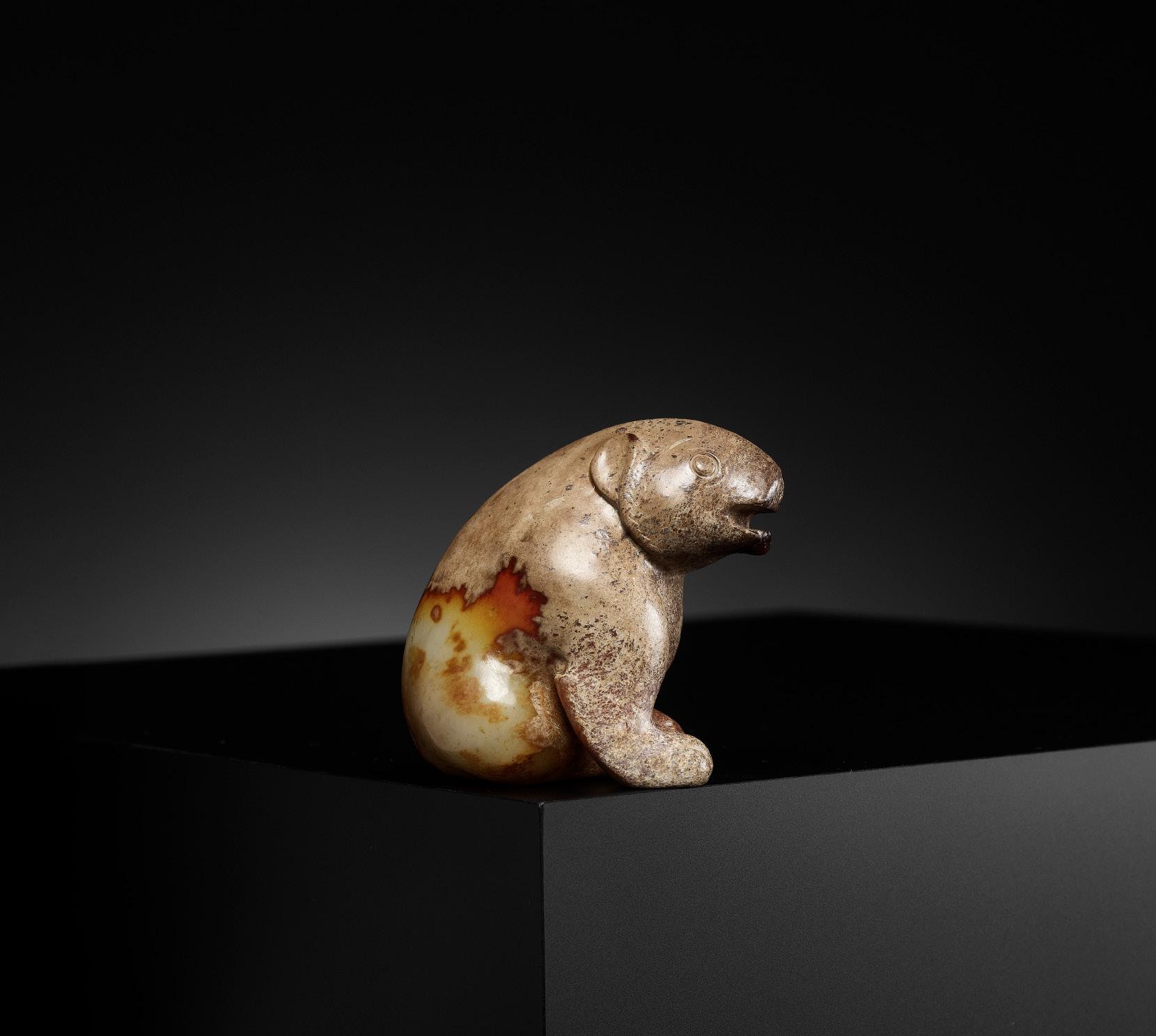
Expert’s note: At peace with itself and the world, the bear appears to be enjoying the moment and is wholly lacking the ferocity that typifies most Han-dynasty representations of bears, tigers, and other wild beasts, marking this as an astonishingly rare and naturalistic sculpture. The stone is calcified throughout, but a single patch of the original jade fades from a fine yellow tone through a deep orange into a remarkable cinnabar red, exemplifying the fact that jade can have almost any color.
Special care seems to have been given to this jade bear after its rediscovery. Not only has the stone been finely polished by a dedicated craftsman after it’s retrieval from the earth - extensive soil encrustations remain visible all over the exterior – but it was also repaired with a neatly lacquered replacement piece meticulously inserted to the lower jaw. This lacquer repair, likely Japanese in origin, interplays nicely with the red shades on the left hind leg of the bear. The conclusion of this author is that the present lot was probably found at some point around the 18th century, where it was treated as described above, and eventually brought to Japan, where the red lacquer repair has been carried out. From there it made its way to Europe, probably at some point in the earlier part of the 20th century. Also note that until 1945, the German Reich and the Japanese Empire were close allies, exchanging on many different levels of culture.
The small yet compelling sculpture represents a plump bear seated on its haunches in a moment of repose. The round eyes gazing forward and flanking the nose, the forehead with a central line below the attentively raised ears, the spine extending to the short, peachform tail with very fine incised lines on either side, the haunches well rounded and extending to the muscular legs and clawed paws, with one tucked underneath. The opaque jade is of a deep yellow hue with orange, red and russet shades, covered almost entirely in ancient calcification.
Provenance: From a German private estate, by repute acquired by an unknown ancestor long time ago and in the family ever since.
Condition: Good condition, commensurate with age, displaying exceptionally well. Signs of wear and weathering, losses, nicks, calcification and encrustation as a result of an extended period of burial. An ancient red lacquer ‘Kintsugi’ style repair to the lower jaw, most likely applied in Japan a long time ago. The stone with natural inclusions and fissures, some of which may have developed into small hairline cracks over time. The calcification also covers most of the incision work, which becomes apparent from looking at the tail which is not completely calcified.
Weight: 212 g
Dimensions: Height 6.6 cm
40 22
The bear has been a popular totemic emblem in China since ancient times. China’s foundation myths hold that the legendary Yellow Emperor, or Huang Di, early on lived with his tribe in the northwest, presumably in modern Shanxi Province, but then later migrated to Zhuolu, in present-day Hebei Province, where he became a farmer and tamed six different types of ferocious beasts, including the bear, or xiong, with which the Yellow Emperor ever since has been linked. According to legend, Gun — said to have been the great-grandson of the Yellow Emperor and the father of Yu the Great, or Da Yu — stole a special soil with which he planned to build dikes in an attempt to control the Yellow River’s constantly recurring and devastating floods. He failed in his mission, however, and as punishment for his theft, he was killed by Zhurong, the God of Fire. Gun’s corpse turned into a yellow bear, or huangxiong, and jumped into a pool. A while later, a golden bear, alternatively said to be a golden dragon, emerged from the corpse’s stomach and ascended into heaven, where the Yellow Emperor instructed it to complete his father’s work in taming the Yellow River’s waters. That bear turned out to be Da Yu, who — according to popular belief — heroically controlled the floods and became the mythological forefather of China’s Xia dynasty. Therefore, the bear has been prominently associated with legendary rulers and Chinese national foundation myths since the earliest times.
Bears are native to China, their presence there known since antiquity. They were kept in Han imperial zoos and parks, where the emperor and his entourage enjoyed watching them in performance or in combat with other animals. On the other hand, they were perceived as enlightened creatures and it was believed that they resided in spiritual mountains and possessed the ability to intermediate between heaven and earth. Bears have also been linked with military prowess, shamanism, and immortality. As a corollary, it might be noted that the words for ‘bear’ and ‘virility’ are exact homonyms, pronounced xiong. According to the ‘Rites of Zhou’, Zhou Li, edited during the Han dynasty, bears were employed in exorcism rituals, their skin worn over the head of the performer who, holding a lance and a shield, led the officials to perform the Seasonal Exorcism by searching through houses and driving away pestilences. See J. Lagerway, Early Chinese Religion. Part One, Shang through Han (1250 BC-220 AD), Boston, 2008, page 287.
In ancient China, immortality was often considered the ultimate pursuit for royalty. The First Emperor who united the country in 221 BC is known to have sent expeditions into the Eastern Sea in search of Penglai, a mountainous island shrouded in a mysterious cloud, which at the time was believed to be the home of immortals, where elixirs of immortality could be retrieved. Once every 99th year, an immortal from this mysterious island would descend to the earthly realm and bestow immortality upon a select few. These immortals were believed to take the form of carved jade animals, for example bears.
Jade was the only material in which these mythological epitomes were believed to exist. This conviction probably stems from the nearindestructible quality of the mineral, which would make such a carving outlive every human being. When inhabited by an immortal, the jade would have looked almost fully translucent, especially when held against strong moonlight. According to ancient creed, the owner of such a magical jade animal was ensured an extended life. By having everyday contact with the object through rubbing its surface, the power of the inhabiting immortal would slowly be transferred to its owner. Highly sought after by the rich and wealthy, a jade animal as such was extremely rare and thus widely copied throughout Chinese history, particularly during the Song and Ming dynasties.
Evidence of this rich tradition of craftsmanship has been transmitted down through a small number of exquisite carvings, of which the present jade bear is a fine example. The craftsman has made good use of the lustrous colored stone in which the contours have been so skillfully and compactly utilized to depict the form of a seated bear. While it is superbly rendered, it lacks some of the ferocity of the earliest Han examples, being of a more benign appearance, thus pointing to a date closer to the end of the dynasty, when ancient archaic styles were slowly but surely replaced by more natural depictions, which today are among some of the most marvelous carvings of these animals.
Literature comparison: Compare an earlier gilt-bronze figure of a bear, seated in a similar manner and sharing several other features, such as the almond-shaped eyes, drooping chest, and rotund belly, 7.6 cm high, dated to the Western Han dynasty, exhibited in Flora and Fauna: Themes and Symbolism in the Decorative Arts of China, The Bruce Museum, Greenwich, Connecticut, 23 June to 9 September 2007, and sold at Christie’s New York, 17 March 2015, lot 1. Compare a related gray stone bear-form stand, dated to the Han dynasty, but of larger size (22.8 cm), at Christie’s Hong Kong, 28 May 2021, lot 3011. Compare a related white and russet jade figure of a seated bear, also carved in the Han style and dated to the Song dynasty, 8.2 cm long, in the British Museum, registration number 1947,0712.487.

AUCTION RESULT COMPARISON
Type: Related
Auction: Bonhams Hong Kong, 27 November 2018, lot 108
Price: HKD 6,700,000 or approx. EUR 859,000 converted and adjusted for inflation at the time of writing
Description: An exceedingly rare and important white and russet jade carving of a bear, Western Han dynasty Expert remark: Note the related facial features of this jade bear. Note the size (5.7 cm).

AUCTION RESULT COMPARISON
Type: Related
Auction: Sotheby’s Paris, 13 May 2014, lot 20
Price: EUR 247,500 or approx. EUR 283,000 adjusted for inflation at the time of writing
Description: A rare celadon-yellow jade bear, Song dynasty or earlier


Expert remark: Compare the closely related subject. Compare also the fine detailing and incision work. Note the slightly smaller size (5.1 cm) and celadon-yellow color.
AUCTION RESULT COMPARISON
Type: Related
Auction: Sotheby’s Paris, 13 May 2014, lot 18
Price: EUR 4,207,500 or approx. EUR 4,818,000 adjusted for inflation at the time of writing
Description: A rare yellow jade mythical animal, Song dynasty or earlier
Expert remark: Compare the closely related pose. Compare also the related carving with similar drooping chest and rotund belly as well as the fine detailing and incision work. The mythical animal has a bear-like appearance with the addition of wings and horns. Note the slightly smaller size (5 cm) and yellow color. Note also that this jade was previously published and exhibited by J. J. Lally & Co., Chinese Archaic Jades and Bronzes from the Estate of Professor Max Loehr and Others, New York, 1993, cat. no. 85.
Estimate EUR 10,000
Starting price EUR 5,000
A SET OF TWELVE JADE AND GILT-BRONZE ‘AUSPICIOUS BEASTS’ BELT PLAQUES, LIAO DYNASTY
China, c. 10th-12th century. Each jade belt plaque is carved in high relief with an animal or mythical beast, depicting a dragon, qilin, phoenixes, lion, tiger, bear, and cranes, and set within a bronze fitting. Each jade plaque and bronze fitting is pierced with a slit. The smoothly polished jades are of a celadon tone with russet inclusions. The bronze fittings are covered in a fine, naturally grown patina with malachite and cuprite encrustations.
Provenance: From an old private collection in Vienna, Austria. Condition: Good condition, commensurate with age. Wear, traces of use, small losses, minor nicks here and there, signs of weathering and erosion, encrustations.
Weight: 747 g (total)
Dimensions: Size 8.5 x 4.2 cm (the largest) and 4 x 3 cm (the smallest)
With a silk storage box. (13)
Khotan in the Tarim basin had rich jade stores during the Tang dynasty. The jade was fashioned into ornaments such as women’s comb tops and decorative plaques for belts worn by senior officials. The use of such plaques had its origin in the Tang dynasty, when the emperor presented jade-decorated belts to the nobility and senior members of the government as part of their official costume. The jade plaques in this set are carved in high relief with images of animals and mythical beasts.
Literature comparison: Compare a related set of ten decorative belt plaques, dated to the Tang dynasty, in the Metropolitan Museum of Art, accession number 1992.165.22a–j. Compare a related group of three gilt-bronze mounted jade belt fittings, two with similar slits as found on the present lot, dated to the Liao dynasty, in the Museum of East Asian Art, Bath, record number BATEA : 451. Compare a related celadon jade plaque carved with a crane, dated to the Western Liao dynasty (of the Qara Khitai based in Central Asia who were originally refugees from the Liao dynasty), circa 12th-13th century, in the British Museum, registration number 1880.3611.
AUCTION RESULT COMPARISON
Type: Related
Auction: Sotheby’s Hong Kong, 1 June 2023, lot 319
Estimate: HKD 600,000 or approx. EUR 69,000 converted at the time of writing
Description: A set of eleven white jade ‘musicians and dancers’ belt plaques, Tang dynasty
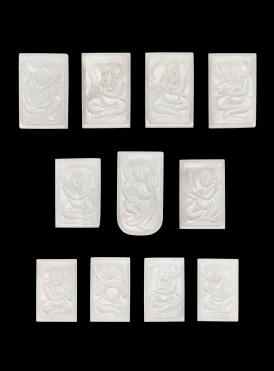
Expert remark: Compare the related forms and manner of carving with similar high relief. Note that the lot comprises eleven white jade belt plaques (the largest 5.2 cm long), dated to the Tang dynasty.
Estimate EUR 20,000
Starting price EUR 10,000
SCIENTIFIC ANALYSIS REPORT
An examination of the bronze components of the present lot was conducted by the Curt-Engelhorn-Zentrum für Archäometrie using energy dispersive X-ray fluorescence analysis, micro energy dispersive X-Ray fluorescence analysis, and lead test analysis. These tests found that the bronze fitting of the largest belt plaque was made from a tin-lead-bronze
alloy in which no modern components of any kind could be detected. Conversely, it was also found that the sample contains trace elements that are typical of ancient metal alloys. The report concludes that the tests found absolutely no evidence of modern manufacture of the present lot. A copy of the examination report, no. 16-024, dated 25 February 2016, accompanies this lot.

42
23

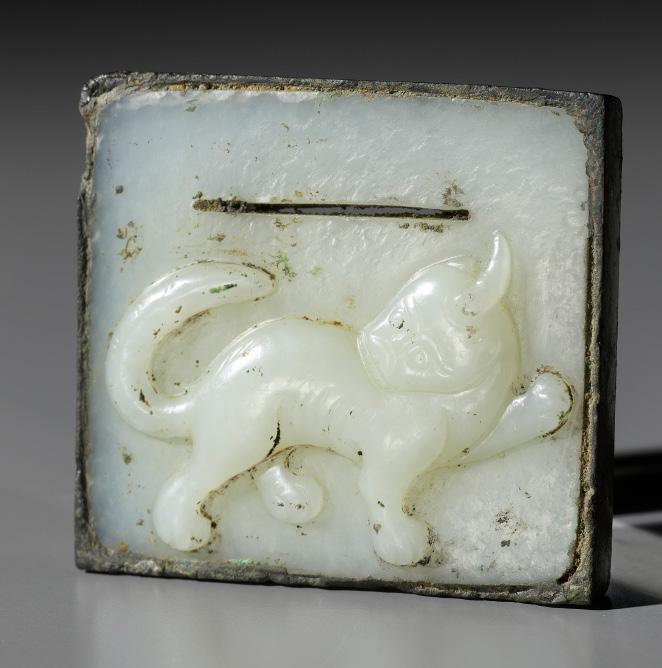
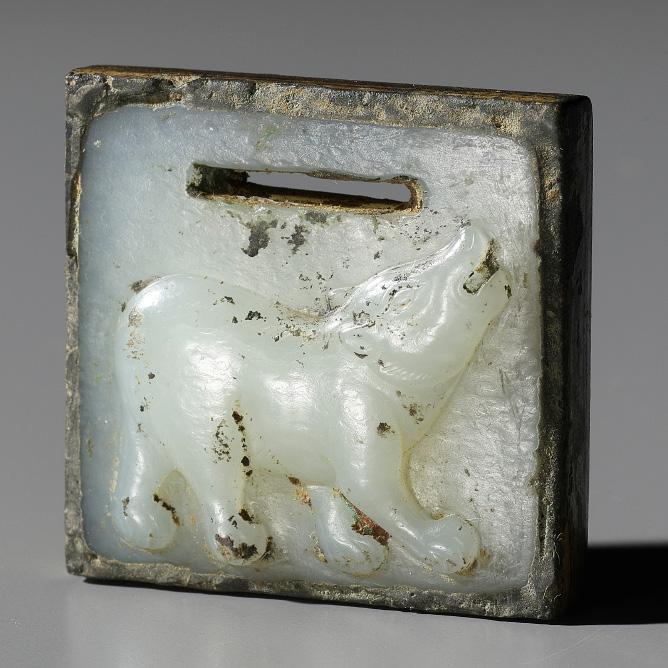

44
Detail image of the qilin
Detail image of the bear
View of the backsides
A GRAY AND BLACK JADE ‘DRAGON’ PENDANT, MING DYNASTY
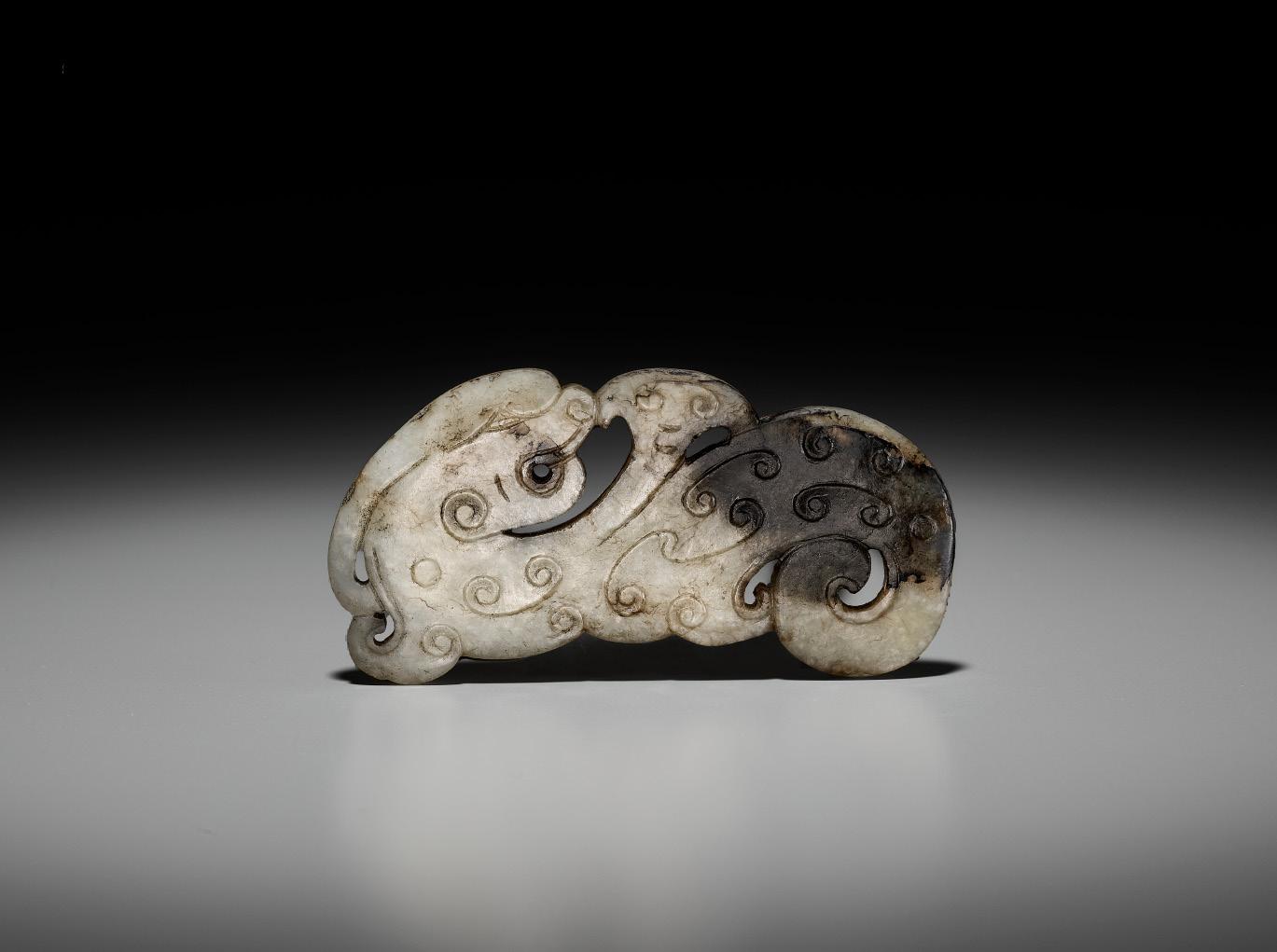
China, 1368-1644. Of flattened form and boldly carved in openwork to depict a sinuous dragon, its body finely decorated with partly interlocking C-scrolls, the long curved horn and curling tail neatly incised, the mouth pierced with a small aperture. The finely polished, translucent jade of a pale gray tone with a black patch, icy inclusions, and russet veins.
Provenance: From the collection of Dr. Wou Kiuan. Wou Lien-Pai Museum, coll. no. T.7.6. Dr. Wou Kiuan (1910-1997) was a Chinese diplomat and noted scholar of Chinese art. His father, Wou Lien-Pai (1873-1944), was one the leading political figures of early 20th century China, remembered for his role as speaker and leader of parliament during the turbulent years of the Republican era. Dr. Wou himself embarked on an illustrious career in diplomacy until his retirement in 1952, when he settled in London and devoted the rest of his life to the study of Chinese art. It was no doubt fortuitous that Dr. Wou’s years of collecting coincided with an abundant availability of exceptional Chinese art on the London market. From the mid-1950s to the late 1960s he was able to form a collection of well over 1,000 works that together represented virtually every category of Chinese art. At the heart of Dr. Wou’s drive to collect was a burning desire to preserve the relics of China’s rich historical past scattered across Europe, and to promote Chinese art and culture. It is unclear when Dr. Wou conceived the idea to create a place to house his collection, but in 1968, he opened the doors to the Wou Lien-Pai Museum, named in honor of his father. Over the years the museum became a ‘must see’ destination for collectors, academics, and visiting dignitaries, and Dr. Wou would delight in leading his visitors through the galleries, recounting stories of China’s glorious history.

Condition: Very good condition with expected old wear, minimal signs of weathering and erosion, minor nibbling to the edges, and few small nicks. The stone with natural fissures, some of which may have developed into small hairline cracks.
Weight: 47.1 g
Dimensions: Length 8.6 cm
AUCTION RESULT COMPARISON
Type: Related
Auction: Sotheby’s London, 2 November 2022, lot 255
Price: GBP 5,040 or approx. EUR 7,000 converted and adjusted for inflation at the time of writing
Description: A gray and black jade ‘dragon’ plaque, Ming dynasty Expert remark: Compare the closely related manner of carving with similar C-scroll and gray and black color. Note the slightly different form with multiple heads, and the size (11.4 cm).

Estimate EUR 3,000
Starting price EUR 1,500
45 24
Dr. Wou Kiuan, Paris, November 1939
A LARGE GRAY AND BLACK JADE FIGURE OF A WATER BUFFALO, LATE MING TO EARLY QING DYNASTY
Expert’s note: The present jade buffalo is one of the most ‘lifelike’ portrayals of this small group, the unusual coloring of the stone in different tones of buff and grey being reminiscent of the actual animals’ skin. The rather eccentric choice of material, distinctly colored and veined, might best fit a late Ming date, while the masculine strength, elegance, and simplicity of the sculpting are in tune with stylistic principles of the Kangxi reign.
China, 17th to early 18th century. Powerfully carved in a recumbent pose, the right foreleg bent with the knee raised, the other legs tucked underneath the stout muscular body, the neatly incised tail flung to the left, the head turned in a position emphasizing the beast’s humped back. Its strong appearance contrasting with the calm, docile expression of its proud face, marked by almond-shaped eyes with incised pupils, and further detailed with an impressive pair of horns curving exactly parallel to the funnel-shaped ears. The smoothly polished, opaque stone is of a fine gray tone with black and russet shadings and veins, smokey and cloudy inclusions, the face and horns with partly calcified areas of ‘chicken bone’. Excellent polish, resulting in an unctuous surface feel overall.
Provenance: Rare Art, Inc., New York, USA, 1973. A private collection in the United States, acquired from the above and thence by descent. A copy of the original invoice from Rare Art, dated 30 May 1973, stating a purchase price for the present lot of USD 6,400 or approx. EUR 40,500 (converted and adjusted for inflation at the time of writing), accompanies this lot.

The base with an old label from Rare Art stating the original listing price for the present lot of USD 8,000 or approx. EUR 50,500 (converted and adjusted for inflation at the time of writing).
Condition: Very good condition with expected ancient wear, few small nicks here and there, the stone with natural inclusions and fissures, some of which have developed into small hairline cracks.
Weight: 4,747 g
Dimensions: Length 23.5 cm
Jade buffalo, like this superbly carved example, have traditionally been greatly prized in China, where the animal is associated with strength, prosperity and tranquility. The ox or buffalo is one of the twelve horary animals representing one of the twelve branches of the Chinese calendrical system. Buffalo are also associated with farming and the production of food. The poetic view of the buffalo resonated with Chan Buddhists and Daoists alike, suggesting retreat into a tranquil rural life away from the cities and the responsibilities of public office.
The popularity of these creatures has an ancient source, since the legendary Emperor Yu of the Xia dynasty (c. 2100-1600 BC) is said to have cast an iron ox or buffalo to subdue the floods. This theme was taken up by the Qianlong Emperor (1736-95), when in 1755 he had a large bronze ox cast and placed looking out over Kunming Lake at the Summer Palace. On the animal’s back was cast an 80-character essay in seal script referring to Yu’s casting of the iron buffalo to control the floods. The mythological and practical auspiciousness of buffalo ensured that they were included among animal figures from early times, and by the period of the late Ming into the early Qing dynasty, a group of large finely carved jade figures was being produced. These buffalo were clearly treasured by the Imperial family since several of the extant examples are known to have come from the Summer Palace in 1860
Literature comparison: Compare a related gray and black jade buffalo from the Somerset de Chair and Mrs. Parsons collections, at Sotheby’s London, 18 July 1952, lot 50, and again, 9 June 2004, lot 151. Compare a related gray and black jade buffalo from the collection of Lord Gladwyn, illustrated by Jessica Rawson, Chinese Jade from the Neolithic to the Qing, British Museum, London, 1995, pl. 26:19, where the author notes that the buffalo is ‘said to have come from the Summer Palace, Beijing during the China War of 1860.’ The provenance for the British Museum buffalo is further detailed in the footnote to lot 11 in Sotheby’s London, 15 December 1987, noting that the British Museum jade buffalo was ... looted from the Summer Palace, Peking in 1860 and rescued on the troop ship from a soldier who was attempting to break it up for easier concealment on coming ashore...’.
AUCTION RESULT COMPARISON
Type: Related
Auction: Christie’s London, 8 November 2016, lot 6
Price: GBP 60,000 or approx. EUR 99,500 converted and adjusted for inflation at the time of writing
Description: A mottled gray jade buffalo, 17th-18th century
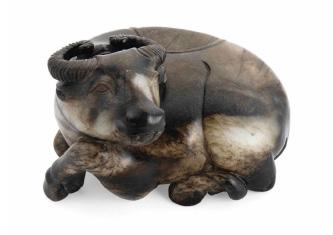
Expert remark: Compare the related modeling, manner of carving, and color of the jade. Note the smaller size (14 cm).
Estimate EUR 8,000
Starting price EUR 4,000
46 25
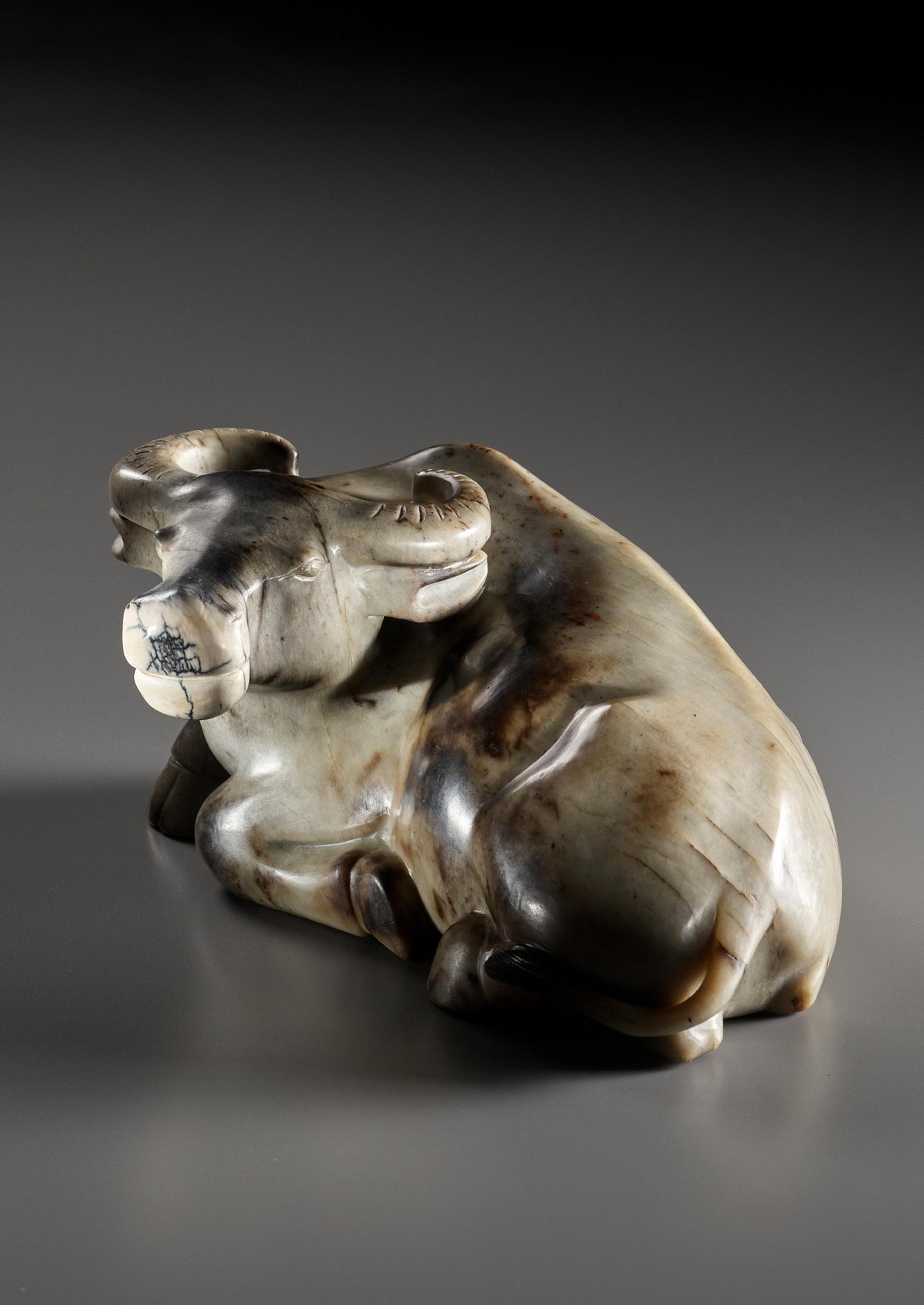
A GRAY AND RUSSET JADE FIGURE OF A RECUMBENT ELEPHANT, LATE MING TO MID-QING DYNASTY
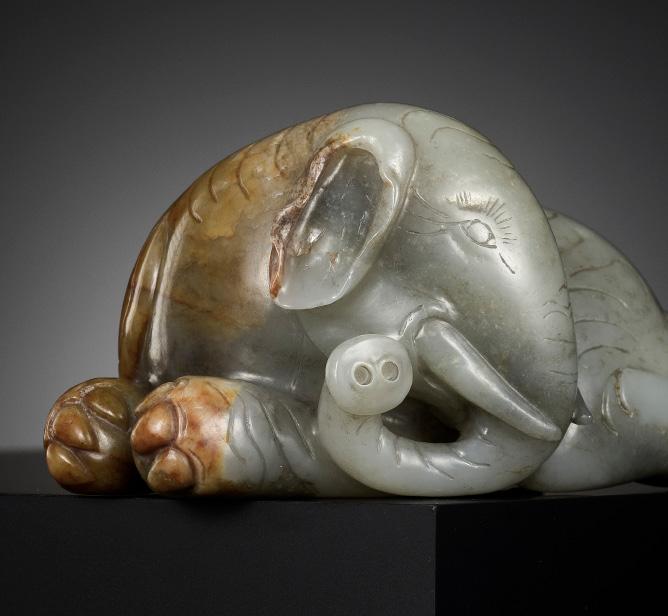

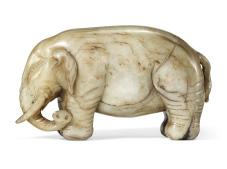
China, 17th-18th century. Carved from a large pebble, the pachyderm lies with its front feet extending outward and its back feet tucked underneath, its tail flicks up towards its head which is turned sharply to the right. Masterfully carved, the elephant’s eyes, lashes, and brows are finely incised with the folds of its ears, its wrinkly skin, and its three-toed feet excellently detailed. The superbly polished and partly translucent stone is of a celadon tone with opaque cream and russet shadings, icy veins, and dark grayish-green clouds.
Provenance: Spink & Son, London (according to the label). Property of an American Collector, acquired from the above. Sotheby’s New York, 24 March 1998, lot 383, offered at a low estimate of USD 10,000 or approx. EUR 17,000 (converted and adjusted for inflation at the time of writing).
Thomas ‘Gene’ Worrell (1919-2006) was a newspaper owner and art collector based in Charlottesville, Virginia. In 1949, he and his wife Irene founded The Virginia Tennessean in Bristol. This marked the beginning of Worrell Newspapers, Inc., which became one of the largest chains of small dailies in the United States. Parts of his jade collection were published by John Ayers in ‘A Jade Menagerie: Creatures Real and Imaginary from the Worrell Collection’, London, 1993..

Condition: Very good condition with minor wear and few minuscule nibbles to edges. The stone with natural fissures, some of which may have developed into small hairline cracks.
Weight: 1,343 g
Dimensions: Length 14.6 cm
The elephant is an auspicious symbol which is used in numerous rebuses to convey peace, prosperity, and good fortune. In Buddhism, elephants are regarded as one of the Seven Treasures and in a broader context are seen as symbols of strength, wisdom, and power.
AUCTION RESULT COMPARISON
Type: Related
Auction: Christie’s London, 14 May 2019, lot
131
Price: GBP 45,000 or approx. EUR 68,500 converted and adjusted for inflation at the time of writing
Description: A large pale grayish-green jade carving of an elephant, 18th century Expert remark: Compare the related motif and style of carving. Note the different pose and color as well as the larger size (22.8 cm).
Estimate EUR 8,000
Starting price EUR 4,000
48 26
Thomas Eugene ‘Gene’ Worrell (1919-2006)
A CARVED CELADON JADE BOX AND COVER IN THE FORM OF A RAM, QING DYNASTY
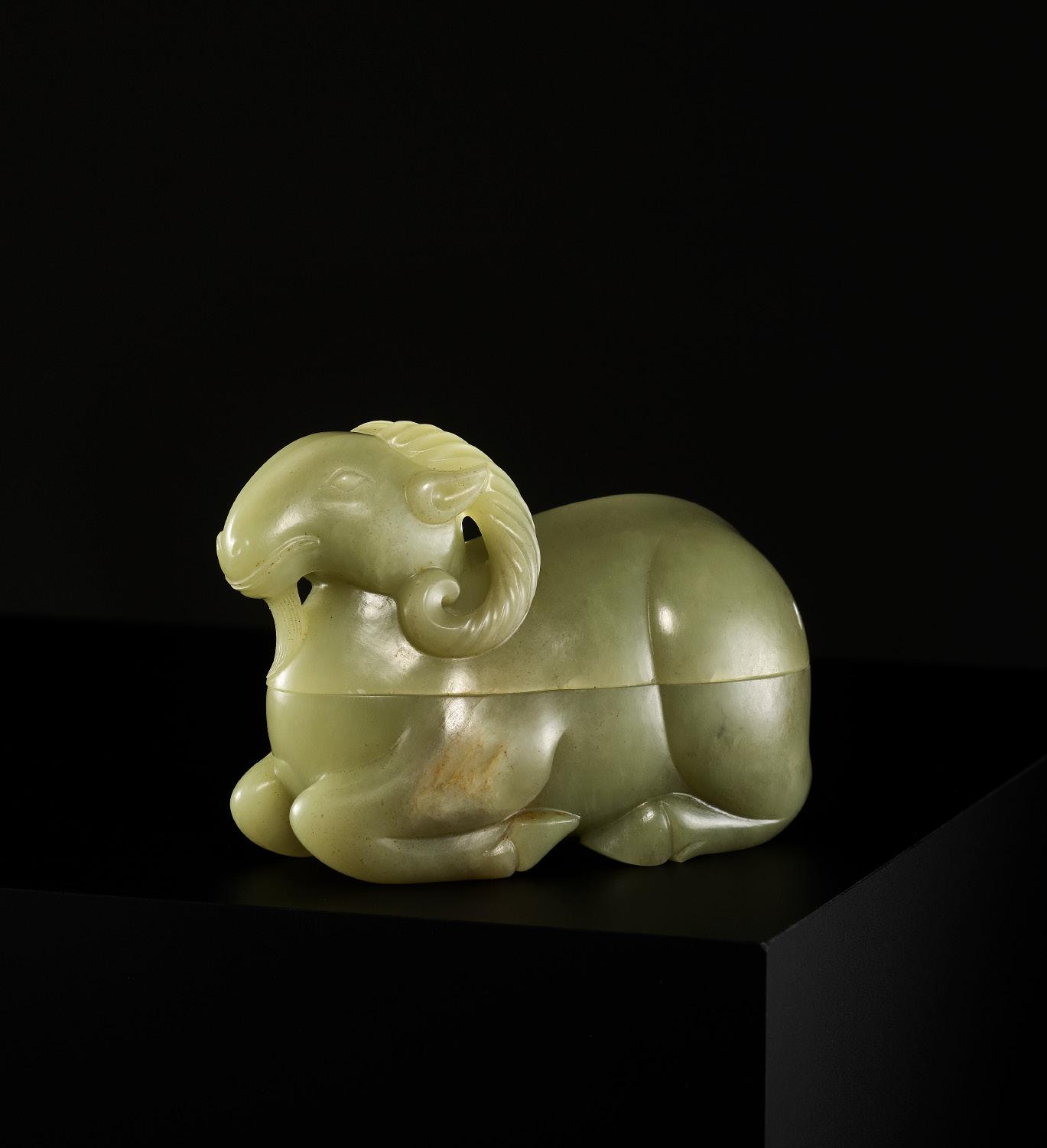
China, 18th – 19th century. Naturalistically carved, the recumbent ram with its legs tucked underneath, looking straight ahead with almondshaped eyes, further detailed with grooved horns curving down the back of its neck towards its jaw, an accentuated back bone finishes at the tail which is slightly twisted to one side. The translucent stone of deep celadon tone with a faint yellow hue and cloudy inclusions as well as icy and russet veins.
Provenance: Boston trade.
Condition: Very good condition with minor wear and few minuscule nicks to the cover’s rim. The stone with natural fissures, some of which have developed into small hairline cracks, particularly around the right eye.
Weight: 348.3 g
Dimensions: Length 10.3 cm
Expert’s note: It is remarkable to see how cleverly the lapidary integrated a circular russet vein running around the proper right eye, which has developed into a natural fissure over the centuries, to simulate a differently colored fur patch which is often found on real rams.
AUCTION RESULT COMPARISON
Type: Closely related
Auction: Christie’s Hong Kong, 30 May 2018, lot 3143
Price: HKD 275,000 or approx. EUR 36,000 converted and adjusted for inflation at the time of writing
Description: A carved yellow jade rabbit-form box and cover
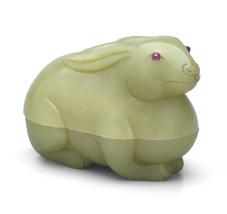
Expert remark: Note the size (8.3 cm).
Estimate EUR 8,000
Starting price EUR 4,000
49 27
A RARE SPINACH-GREEN JADE FIGURE OF A TIGER, SECOND HALF OF THE QIANLONG PERIOD
China, c. 1760-1795. Carved from a large boulder, the tiger rests in a recumbent pose with its legs tucked beneath its body and its tail curling to the side. The body is neatly incised with thin stripes, and its face is well detailed with large round eyes, thick arched brows, and thin whiskers. The tiger bares its sharp teeth in a fierce snarl, wrinkling its face, and laying its ears back. The prominent, menacing claws are another distinct feature, clearly identifying the animal as the biggest and most dangerous of all felines, also known as ‘Man Eater’ in some cultures.
The superbly polished stone of an even and remarkably pure deep spinach-green tone with few minute dark flecks and icy veins. Possibly Khotan jade.
Provenance: French trade.
Condition: Superb condition with minimal wear. The stone with few natural fissures, some of which may have developed into small hairline cracks.
Weight: 1,488.3 g
Dimensions: Length 15.3 cm
Prior to the Qianlong period, jade carvings in China were largely confined to small-sized items such as scholar’s objects, pendants, plaques, and palm-sized vessels, due to the rarity of quality jade. Most jade quarries were a great distance from the capital and were outside the jurisdiction of the early Qing empire until the 1750s. In the middle of Qianlong’s reign in 1759, the emperor expanded his rule into the Xinjiang territory while quelling the Dzungar Khanate and the Altishahr Khojas rebellions, making a large supply of jade material from the region available to the empire.
After 1760, when the Kingdom of Yutian (modern-day Xinjiang province) was brought under Chinese influence, the fine raw jade boulders from that area were readily available to Chinese carvers. The region known as Khotan, now in Xinjiang province, is particularly famous for its fine nephrite jade. With these materials, and the encouragement of the emperor, the jade lapidaries of the second half Qianlong period were able to produce remarkable feats of carving.
Large jade animal carvings represent some of the finest jade products of the early Qing dynasty, leading to the heights of achievement associated with the reign of the Qianlong emperor. Animals including tigers, horses, and elephants were popular, as were mythical beasts such as the qilin or the Buddhist lion.
Tigers have been of great importance in Chinese culture since the earliest surviving records of Chinese history, with the character 虎 appearing on Shang-era oracle bones. In ancient China, the Siberian and Bengal tigers were common in the northeast and southwest respectively, and tigers figure prominently in Chinese myth, astrology, poetry, painting, and other fields. Most prominently, the tiger has long been regarded as a major symbol of masculine yang energy and the king of the animals.
Literature comparison: Compare a related large spinach-green jade Buddhistic lion, 19.8 cm wide, date to the Qianlong period, formerly in the collections of R.C. Bruce, the 3rd Baron Alington of Crichel, and the Hon. Mrs Mary Anna Marten OBE, illustrated by S.C.Nott in Chinese Jade Throughout the Ages, Rutland, Vermont, 1973, pl. LXIII.
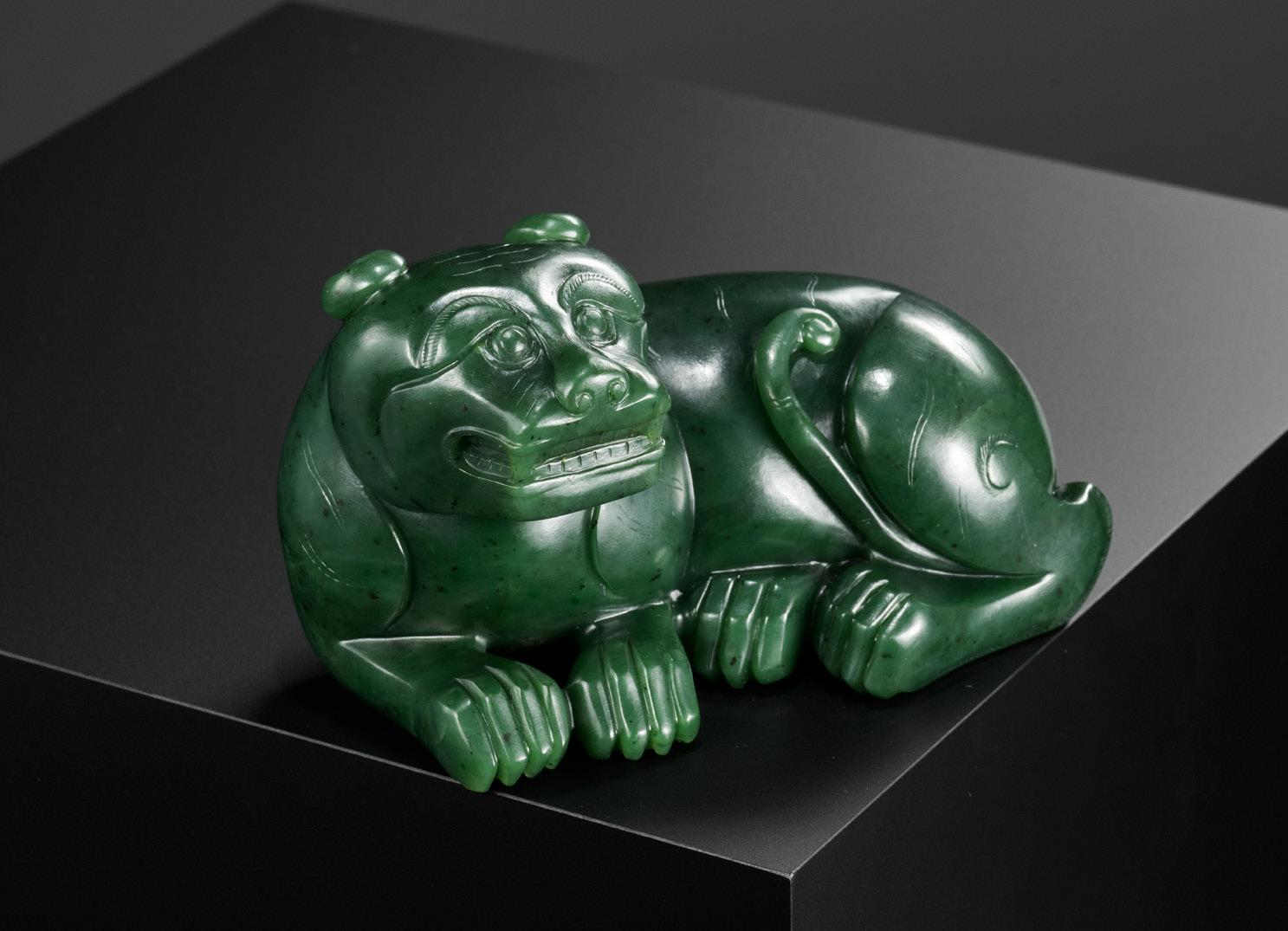
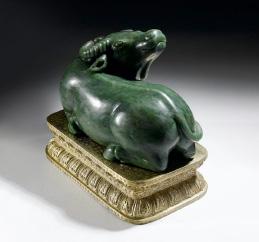
AUCTION RESULT COMPARISON
Type: Related
Auction: Woolley & Wallis, 20 May 2009, lot 388
Price: GBP 3,400,000 or approx. EUR 7,120,000 converted and adjusted for inflation at the time of writing
Description: The Pelham Water Buffalo, Qianlong period
Expert remark: Compare the closely related even tone of spinach green, and the related manner of carving. Note the size (20.8 cm).
Estimate EUR 10,000
Starting price EUR 5,000
50 28
A WHITE AND RUSSET JADE ‘SANYANG AND LINGZHI’ GROUP, QING DYNASTY
China, 18th-19th century. Exquisitely carved with three rams portrayed in recumbent postures, lying on a stepped rocky outcrop with the largest ram in the middle, each naturalistically carved with legs neatly tucked, and the majestic head slightly raised and crowned with long curled horns. The translucent and lustrous creamy-white stone with veining and russet inclusions, one skillfully used by the lapidary for a sprig of lingzhi growing at the base of the rocky outcrop.
Provenance: A private collection in Germany. Bonhams New York, 9 September 2019, lot 817, bought-in at an estimate of USD 10,000 or approx. EUR 11,000 (converted and adjusted for inflation at the time of writing). A private collection in the United Kingdom, acquired from the above.
Condition: Very good condition with minor wear, minuscule nibbling, few microscopic nicks. The stone with natural inclusions and fissures, some of which may have developed into small hairline cracks.
Weight: 672.7 g
Dimensions: Width 11.9 cm
The motif of three rams or sheep (sanyang) is a pun referring to the Yi Jing, where solid lines represent the male or yang principal, while broken lines represent the female or yin principal. The hexagram tai which represents spring and new beginnings is comprised of three broken lines above three solid lines. It is considered to be in perfect balance with the three broken lines symbolizing heaven above and the three solid lines symbolizing the earth below. The three rams or sheep, standing in for the three solid lines, form a rebus for the phrase sanyang kaitai, referencing the period between the winter solstice and the New Year, when the warm yang energy is emerging, and the earth is returning to life.
Expert remark: Compare the related sanyang subject and white color of the stone, as well as the closely related size (12.1 cm). Note the absence of the rockwork base.
AUCTION RESULT COMPARISON
Type: Related
Auction: Christie’s Hong Kong, 11 June 2021, lot 3181
Price: HKD 100,000 or approx. EUR 12,000 converted and adjusted for inflation at the time of writing
Description: A white jade ‘three rams’ group, Qing dynasty, 18th-19th century
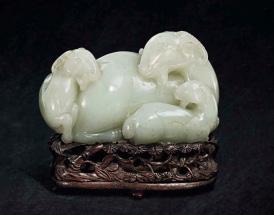

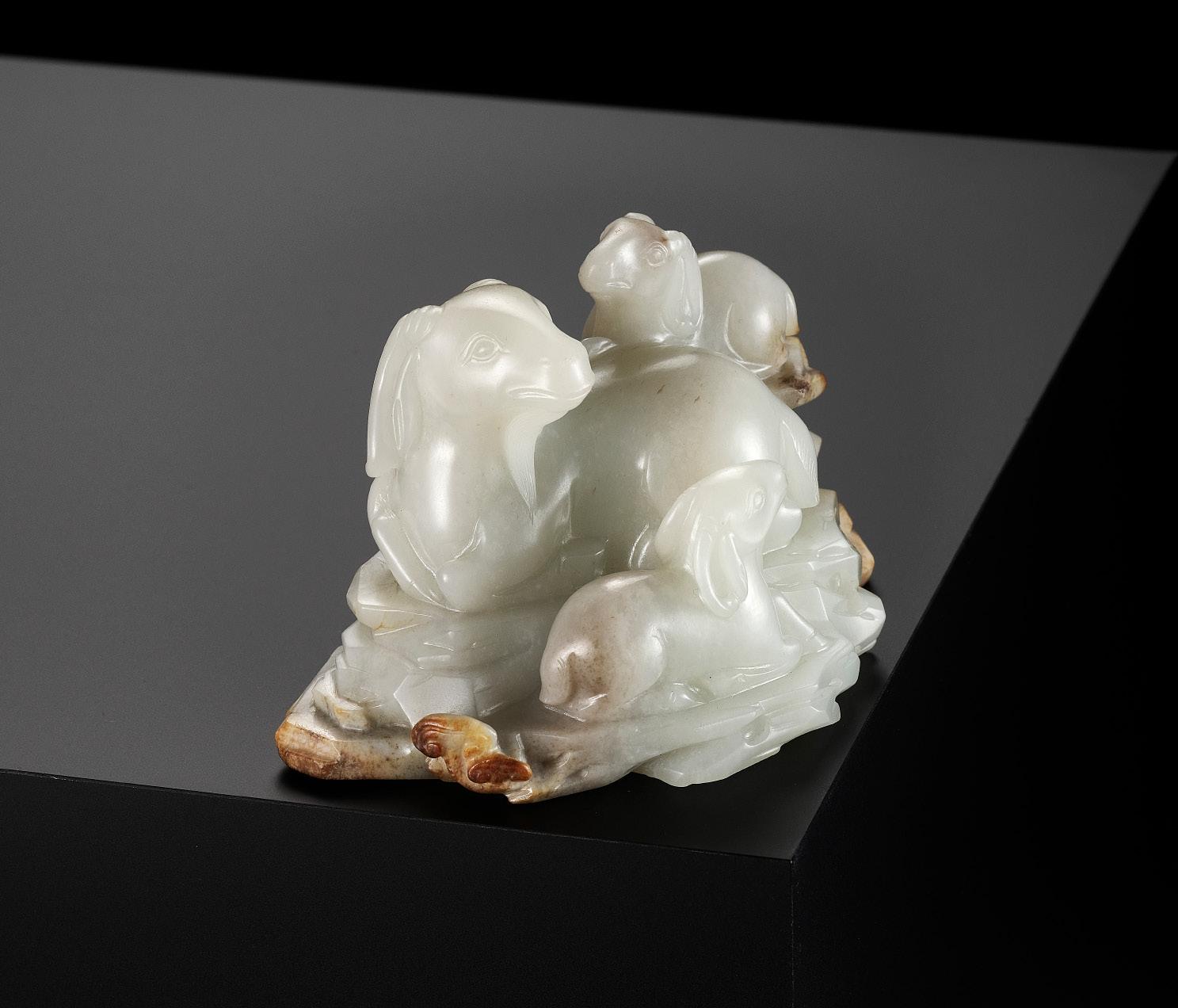
AUCTION RESULT COMPARISON
Type: Related
Auction: Christie’s London, 10 November 2015, lot 98
Price: GBP 98,500 or approx. EUR 169,000 converted and adjusted for inflation at the time of writing
Description: A large white jade ‘three rams’ group, Qianlong period
Expert remark: Compare the related sanyang subject, white color of the stone, and size (12.4 cm). Note the absence of the rockwork base, the group instead supported on a wood stand.
Estimate EUR 6,000
Starting price EUR 3,000
51 29
AN EXCEPTIONAL PAIR OF WHITE JADE ‘QUAIL’ BOXES AND COVERS, QIANLONG PERIOD, 1736-1795
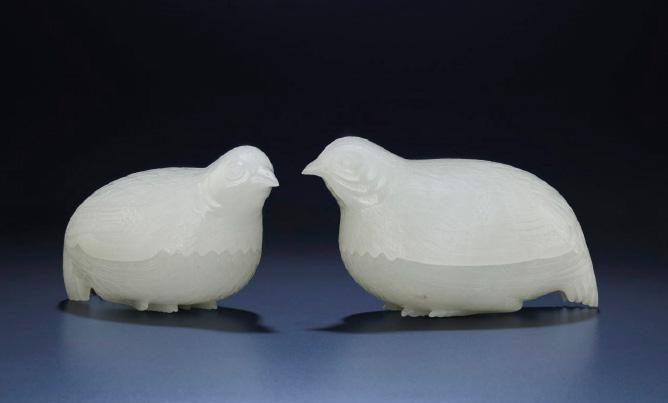
Expert’s note: The artist paid meticulous attention to the differences between male and female quails while creating the original concept for these boxes during the earlier Qianlong period. Notably, the female quail is depicted as larger than the male, their eyes are portrayed differently, and the sizes of their beaks diverge. Although white jade obviously cannot display colors, the design of the present boxes aims to symbolize the great variety found in male and female quail plumage through neatly incised patterns and textures. An almost identical pair from this group, showcasing the same characteristics of sexual dimorphism, was previously sold at Christie’s Hong Kong on November 30, 2011, as lot 3029 (fig. 1). Although other examples within the group do exhibit these characteristics to some degree, they appear to be less intricate overall. Therefore, it is believed that only the earliest group, likely crafted between 1740 and 1750, displays the remarkable level of detail found in the current lot.
An example from the earliest group of white jade quail pairs. Compare the marked difference in the eyes, feathers, and beaks of the male and female. Note the identical length (11.5 cm) of the larger bird. Sold at Christie’s Hong Kong, 30 November 2011, lot 3029, for approx. EUR 435,000.
Both quails are shown with their taloned feet tucked under their bodies. The upper half of each box serves as a perfectly fitting cover, precisely aligning with the scalloped edges. The plumage is incised with remarkable detail, while the head is gently turned to one side and adorned with several layers of feathering. The beak and eyes exhibit finely carved lines, adding to the overall intricacy.
The semi-translucent white jade displays an even tone with subtle hints of pale celadon and tiny russet inclusions. The polish of the stone is of magnificent quality, enhancing the overall aesthetic appeal of the pair. (4)

Provenance: From a private collection in Paris, France, and thence by descent.
Condition: Pristine condition with old wear and few microscopic nicks, inherent to the stone, which have smoothened over time. Expected natural inclusions and fissures.
Weight: 263.8 g and 221.7 g
Dimensions: Length 11.4 cm and 10.6 cm
The quail is an emblem of courage in Chinese art, due to its fierce nature and fighting prowess. Curiously, however, because the Chinese word for quail (an) is a homophone for ‘peace’, it is often recognized as a symbol of harmonious existence. Two quails can be read as shuang an, or ‘double peace’, and thus, these birds appear as a pair on paintings, porcelains and textiles from as early as the Song dynasty.
52 30
fig. 1
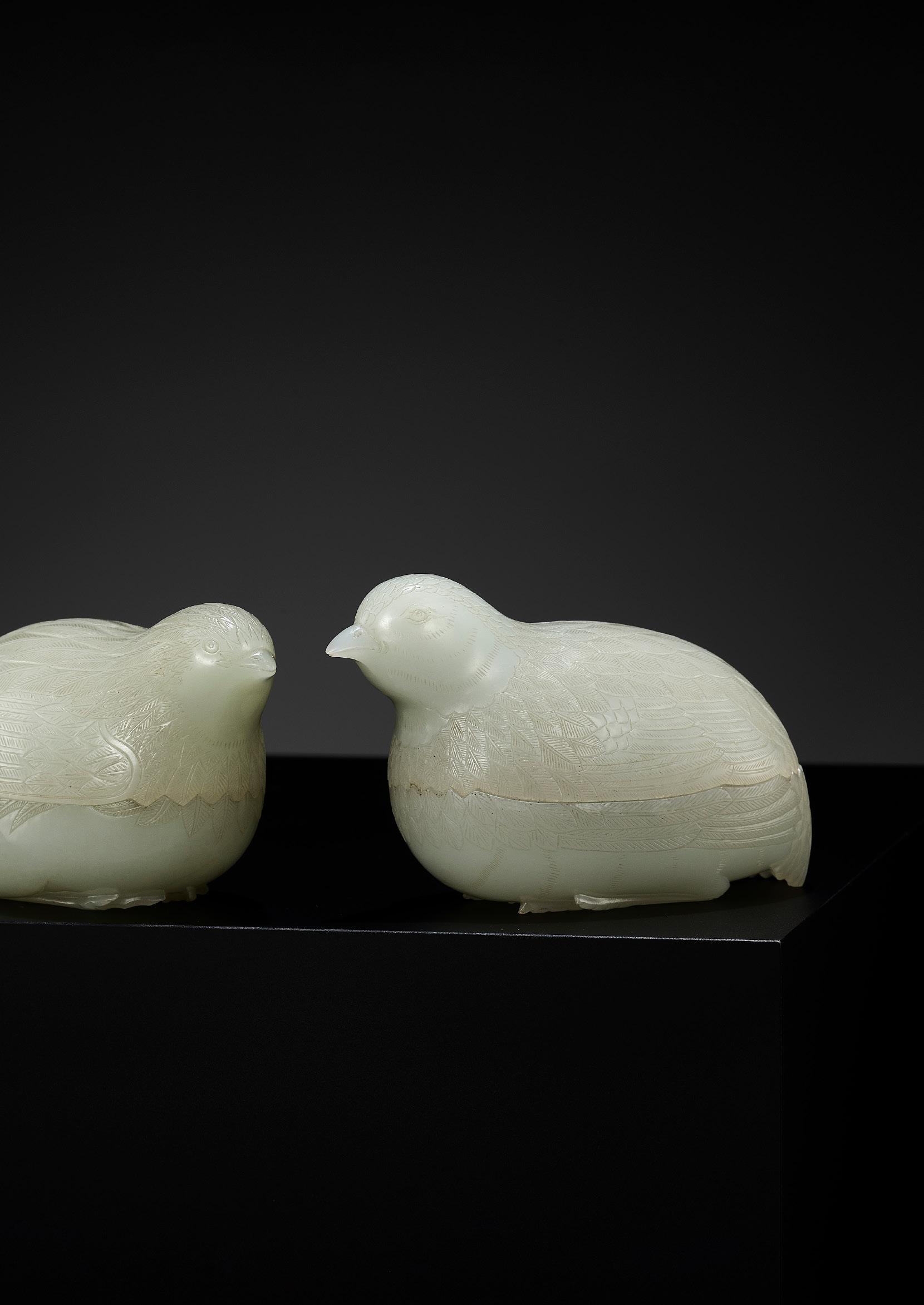
LITERATURE COMPARISON
Compare a closely related pair of quail boxes in the Seattle Art Museum also with their heads turned but carved from a slightly yellowish stone and dated to the Qianlong period, illustrated in James Watt, Chinese Jades from the Collection of the Seattle Art Museum, cat.no.73 (fig. 1). Also compare a similar box in the Palace Museum, Beijing, illustrated in Zhongguo yuqi quanji [Complete collection of Chinese jades], Shijiazhuang, 2005, vol. 6, p. 69, no. 106. Also compare a pair formerly in the collection of T.Y. Chao illustrated by R. Kleiner, Chinese Jades from the Collection of Alan and Simone Hartman, Hong Kong, 1996, no. 196. Compare also a pair illustrated by Ip Yee, Chinese Jade Carving, Hong Kong Museum of Art, 1983, no. 196
AUCTION RESULT COMPARISON
Type: Closely related
Auction: Christie’s Hong Kong, 28 November 2012, lot 2182
Price: HKD 2,540,000 or approx. EUR 395,000 converted and adjusted for inflation at the time of writing
Description: An pair of white jade quail-form boxes and covers, Qianlong period (1736-1795)


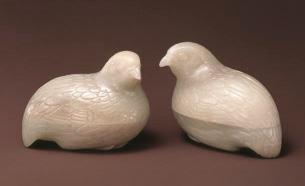

Expert remark: A later example, where the difference in the eyes, beaks, and feathers are less prominent. Note the slightly larger size (11.8 cm).
AUCTION RESULT COMPARISON
Type: Closely related
Auction: Christie’s Hong Kong, 30 May 2012, lot 4110
Price: HKD 2,180,000 or approx. EUR 339,000 converted and adjusted for inflation at the time of writing
Description: A fine pair of white jade quail-form boxes and covers, Qianlong period (1736-1795)
Expert remark: A later example, where the difference in the eyes, beaks, and feathers are less prominent. Note the slightly smaller size (10.5 cm).
Estimate EUR 60,000
Starting price EUR 30,000
54
fig. 1
A WHITE JADE ‘RABBIT’ ZODIAC PENDANT, CHINA, 18TH CENTURY
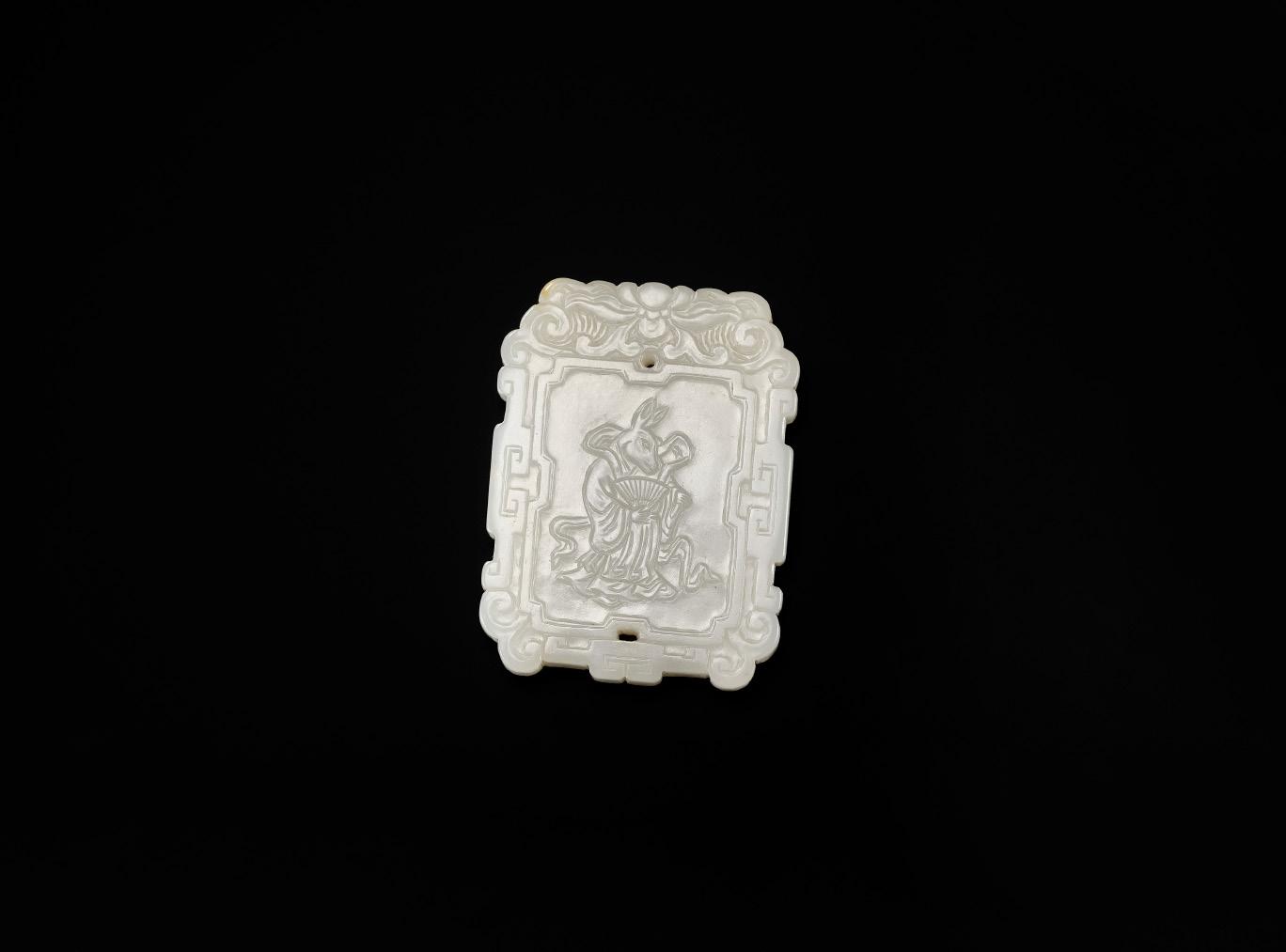
Expert’s note: The quality of the stone and the workmanship on this plaque is outstanding, pointing to it being an Imperial commission, one of a group of Imperial white jade ornaments decorated with twelve Chinese zodiac figures in anthropomorphic forms and their associated Earthly Branches represented by archaic Chinese characters.
Finely carved in low relief to one side with the figure of a rabbit wearing celestial robes and billowing scarves while holding a fan, well detailed with almond-shaped eyes and tall pointed ears, framed by scrolling and angular designs below a central stylized lotus blossom, the reverse carved with an archaic character, pierced above and below the central panel for suspension. The translucent, smoothly polished stone is of a white tone with few minute russet and icy inclusions.
Inscriptions: To the back, ‘mao’ (referring to the Earthly Branch associated with the Rabbit in the Chinese Zodiac).
Provenance: British trade.
Condition: Very good condition with expected minor wear and tiny nibbles here and there. The stone with natural inclusions and fissures, some of which may have developed into small hairline cracks.
Weight: 40.7 g
Dimensions: Length 5.1 cm
Literature comparison: See a complete set of twelve jade carvings depicting all the zodiac figures from the Qing Court collection, illustrated in The Complete Collection of Treasures of the Palace Museum - Jadeware (III), vol. 42, Hong Kong, 1995, no. 111, pp. 132-133.
AUCTION RESULT COMPARISON
Type: Closely related
Auction: Christie’s London, 15 May 2012, lot 75
Price: GBP 37,250 or approx. EUR 69,000 converted and adjusted for inflation at the time of writing
Description: A white jade pendant, 18th century
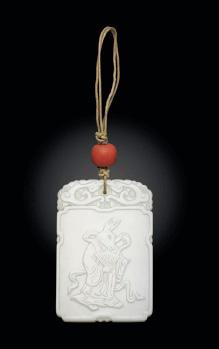

Expert remark: Compare the closely related manner of carving, subject with near identical rabbit to one side and the same character ‘mao’ to the other (albeit also with a trigram roundel), and white color. Note the size (6.3 cm).
Estimate EUR 8,000
Starting price EUR 4,000
55 31
A YELLOW JADE RUYI-LOBED BOX AND COVER, QIANLONG PERIOD

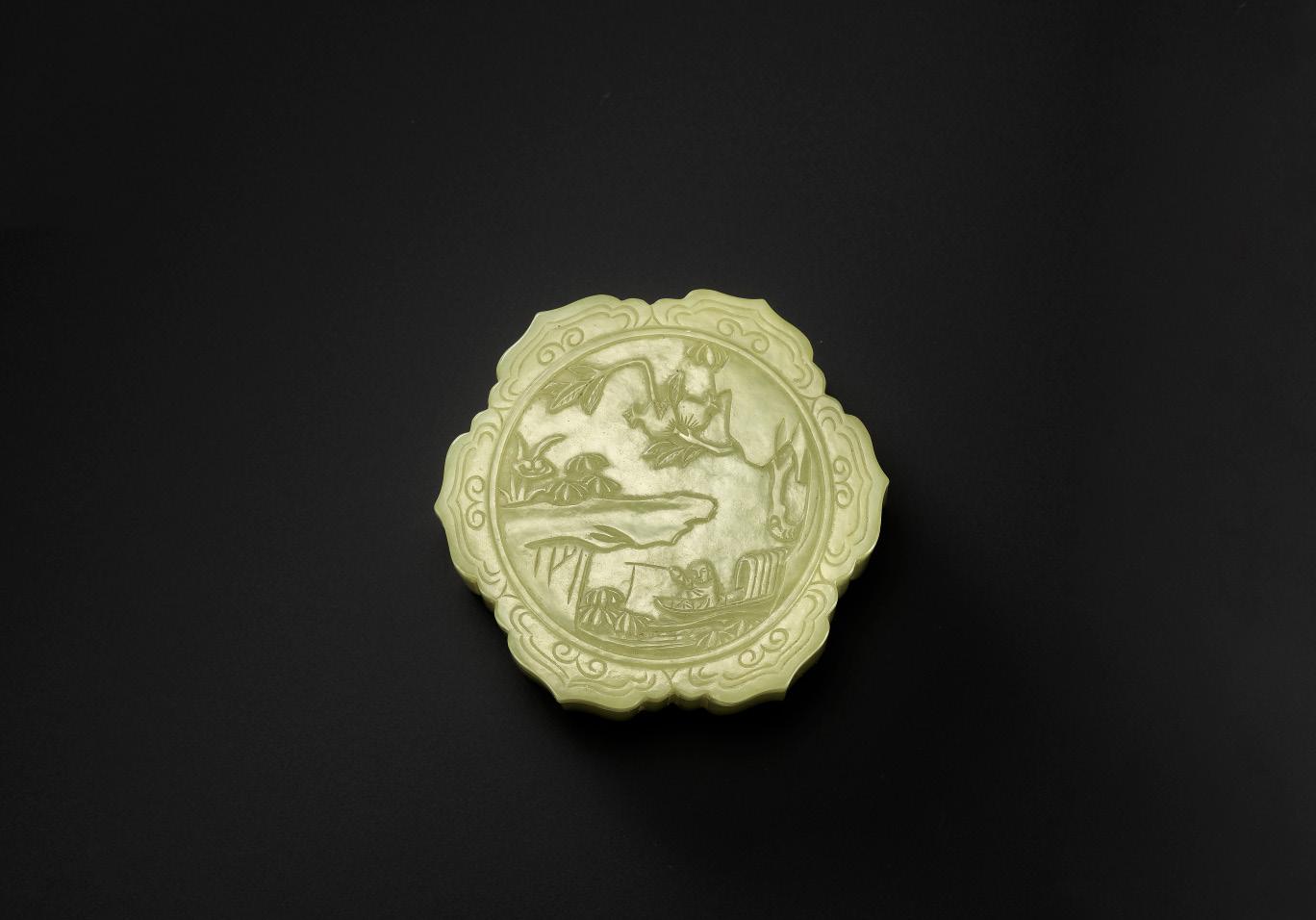
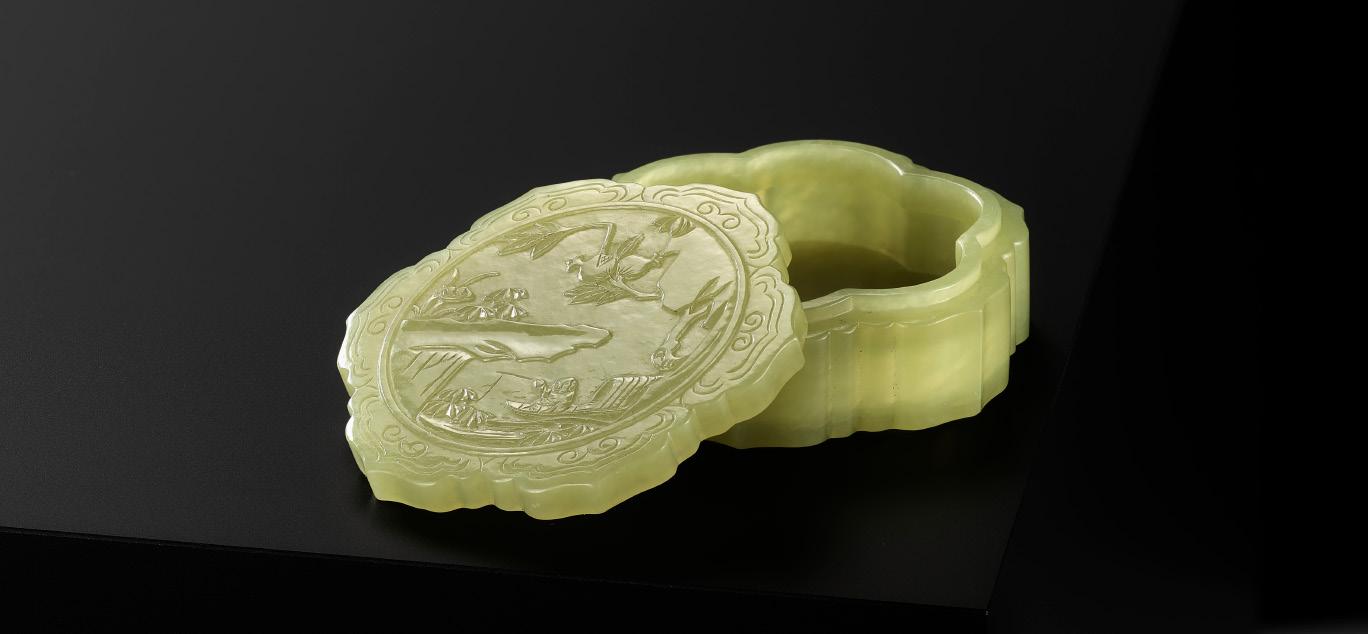
China, 1736-1795. Superbly carved, the cover with a central medallion enclosing a fisherman angling from his sampan beneath rocky outcrops with leafy bamboo and lingzhi springs, as well as a long branch bearing two pomegranates, all encircled by six neatly incised ruyi-heads forming the rim of the box and cover. The translucent, smoothly polished stone is of an even and fine yellow tone with few minor russet inclusions and milky speckling.
Provenance: English trade.
Condition: Excellent condition with some old wear and few microscopic nibbles.
Weight: 50.1 g
Dimensions: Diameter 5.5 cm
Yellow jades were considered as the rarest among nephrite jades of various tones. The innate value of yellow jades in the eyes of connoisseurs throughout time is best exemplified in the book Zun sheng ba jian, written by the late Ming scholar Gao Lian, where he mentions: ‘People now cherish white jade and they set little store by yellow jade, which is nothing but a sign of poor judgement.’ (fifth chapter)
AUCTION RESULT COMPARISON
Type: Related
Auction: Christie’s New York, 24 March 2011, lot 1550
Price: USD 110,500 or approx. EUR 139,000 converted and adjusted for inflation at the time of writing
Description: A fine yellow jade peachform pendant, Qianlong period Expert remark: Compare the closely related even yellow tone. Note the different form and the slightly smaller size (4.4 cm).
Estimate EUR 8,000
Starting price EUR 4,000
32
A YELLOW JADE ‘FINGER CITRON’ PENDANT, INSCRIBED ‘PINGAN FUSHOU’, 18TH CENTURY
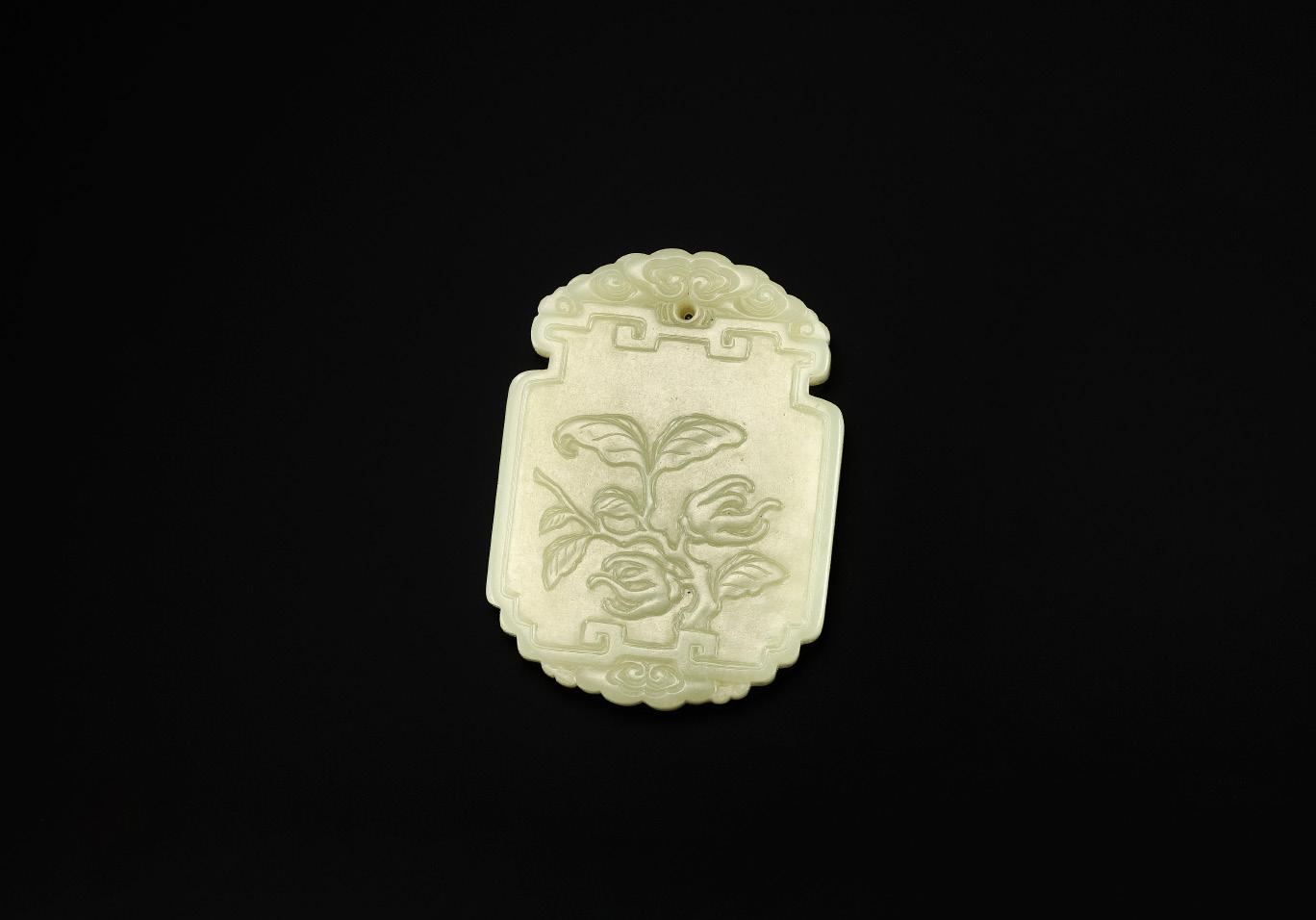

China. Finely carved in low relief with two finger citrons growing from a leafy branch, enclosed by an angular-scroll frame between swirling ruyi clouds, the reverse carved with a four-character seal script inscription, the top pierced for suspension. The translucent stone of an even yellow tone with few minute cloudy inclusions.
Inscriptions: To the back, ‘Pingan Fushou’ (quiet and safe, good fortune and long life).
Provenance: British trade.
Condition: Very good condition with expected old wear and microscopic nibbling. The stone with natural inclusions and fissures, some of which may have developed into small hairline cracks.
Weight: 38.1 g
Dimensions: Length 5.5 cm
AUCTION RESULT COMPARISON
Type: Related
Auction: Sotheby’s Hong Kong, 8 April 2014, lot 3180
Price: HKD 200,000 or approx. EUR 28,500 converted and adjusted for inflation at the time of writing
Description: A yellow jade rectangular pendant, Qing dynasty
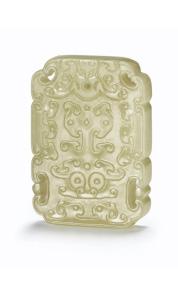
Expert remark: Compare the closely related color and the related form. Note the archaistic decoration.
Estimate EUR 8,000
Starting price EUR 4,000
33
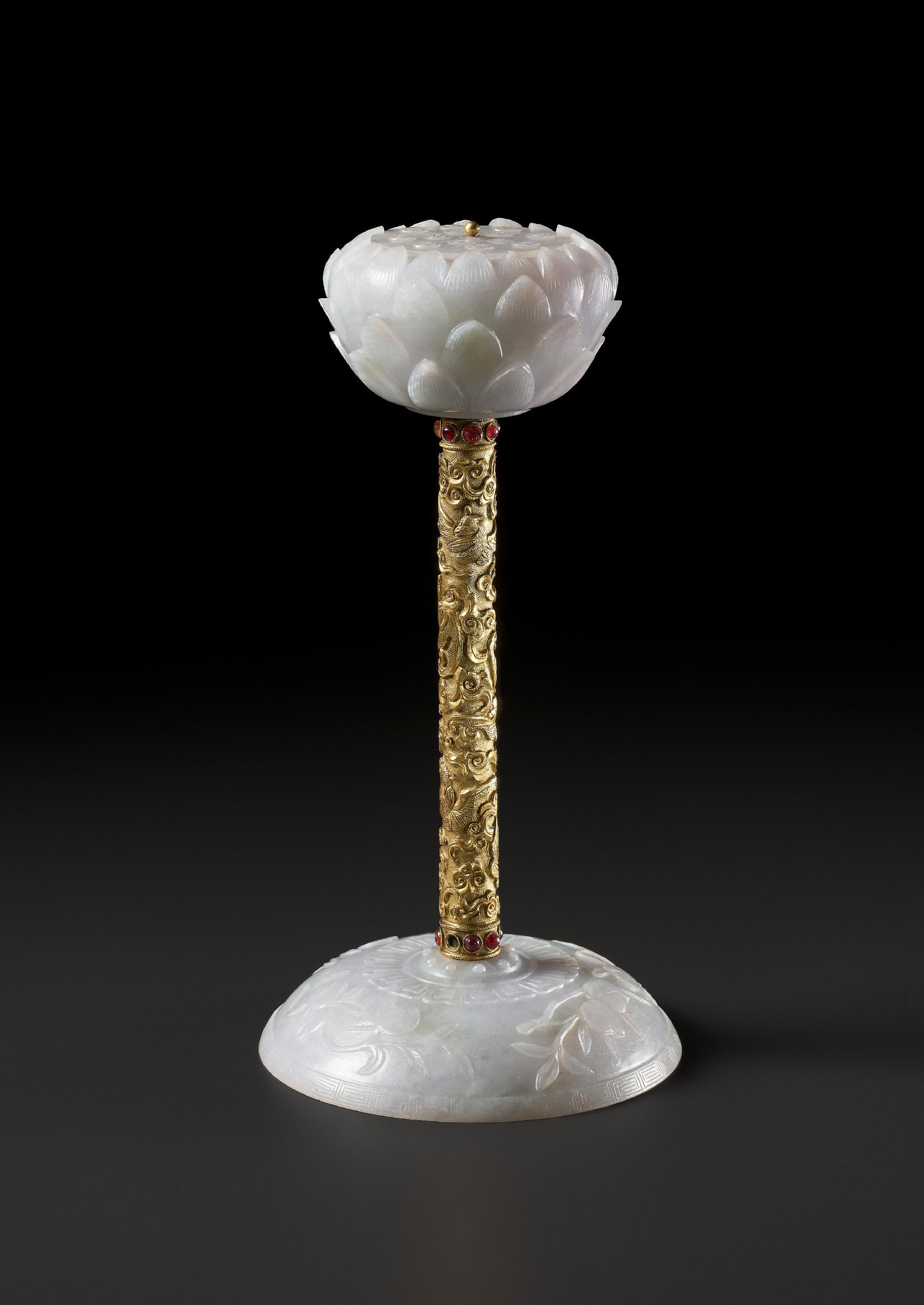
AN IMPERIAL JADE, GILT-BRONZE, AND RUBY-INLAID ‘LOTUS AND BATS’ HAT STAND, QIANLONG PERIOD
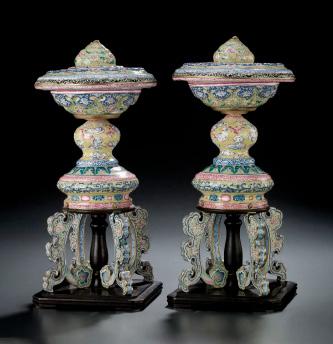
China, 1736-1795. Of slender form, the round and domed base with a key-fret (leiwen) band along the edge below a design of fruiting peaches, all set beneath a ring of lotus leaf lappets which encircle the stem of the hat stand. The gilt-bronze stem decorated with numerous bats amid swirling clouds in high relief, all between two bands of neatly inlaid ruby-matrix (corundum) cabochon inlays. The translucent white jade with beautiful hues of apple green and lavender as well as russet veins and icy inclusions.
Provenance: From an old private collection in Portland, Oregon, USA, and thence by descent in the same family.
Condition: Very good condition with expected old wear, two of the cabochon inlays are missing from the stem, few minuscule nicks to the bronze and the jade. The stone with natural inclusions and fissures, some of which may have developed into hairline cracks. The fitting to the underside of the base, that connects the jade with the bronze, is partially lost but stable.
Weight: 712 g
Dimensions: Height 23.9 cm
Hat stands were used in the private quarters of the Emperor and members of the imperial family. At the Qing Court, the type of hat one wore was very important and, when not in use, these signifiers of rank and status were displayed on suitably decorative stands and perfumed at the same time.
The bulb of the lotus, with its leaves finely curling towards the center, is hollow. This is where the fragrant materials would have been placed. The lid is superbly carved to resemble the lotus pods and pierced multiple times, so that the odors originating from the fragrant materials may evaporate, thus perfuming the hat resting above with rich aromas.
The jade lid is attached to the hat stand by a gilt-bronze chain secured to the inside, so that it cannot be lost.


LITERATURE COMPARISON
Compare a carved red lacquer hat stand, 29.8 cm high, dated to the Qianlong period, at Christie’s New York, 14 September 2018, lot 1233. Compare a pair of canton enamel yellow-ground hat stands, 32.5 cm tall, dated to the 18th century, at Christie’s Hong Kong, 29 May 2013, lot 2166. Compare an imperial yellow-ground famille rose ‘nine dragons’ hat stand, 27.3 cm tall, dated to the Daoguang period, at Christie’s London, 8 November 2016, lot 80. Compare a cloisonné enamel and gilt-bronze hat stand, 28 cm tall, dated to the Qianlong period, at Bonhams London, 13 May 2021, lot 57.
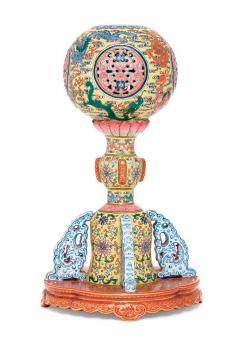
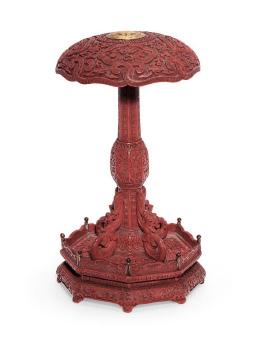
Estimate EUR 15,000
Starting price EUR 7,500
34
A WHITE JADE OPENWORK POMANDER BOX AND COVER, QIANLONG PERIOD

China, 1736-1795. Of square form, finely carved with pierced waves to the sides, the top of the cover with a ferocious front-facing dragon with a scaly sinuous body amid swirling clouds, the details including the flowing mane and bared teeth neatly incised. The translucent jade is of a pure and fine white tone with scattered cloudy inclusions.
Provenance: The St. James’s Collection, London, United Kingdom, 1970s. A private collection in Sydney, Australia, acquired from the above. With an old label from The St. James’s Collection, confirming the dating above and stating a sales price for the present lot of GBP 550 or approx. EUR 11,000 (converted and adjusted for inflation at the time of writing), accompanies this lot. The St. James’s Collection is an international art gallery founded in 1972, currently operating in London, New York, Cannes, and Monte Carlo. They offer a wide range of works of art and objects of vertu as well as art services and consulting.
Condition: Very good condition with minor wear and a tiny chip to the edge of the box. The jade with natural fissures, some of which may have developed into hairline cracks.
Weight: 92.9 g
Dimensions: Width 6.7 cm
AUCTION RESULT COMPARISON
Type: Related
Auction: Christie’s New York, 11 November 2011, lot 1451
Price: USD 31,250 or approx. EUR 37,500 converted and adjusted for inflation at the time of writing
Description: A fine white and spinach-green jade openwork pomander
Expert remark: Compare the related white color, rectangular form, openwork carving, and dragon motif. Note the addition of spinach green jade, the angular scrollwork, and the smaller size (5.6 cm).
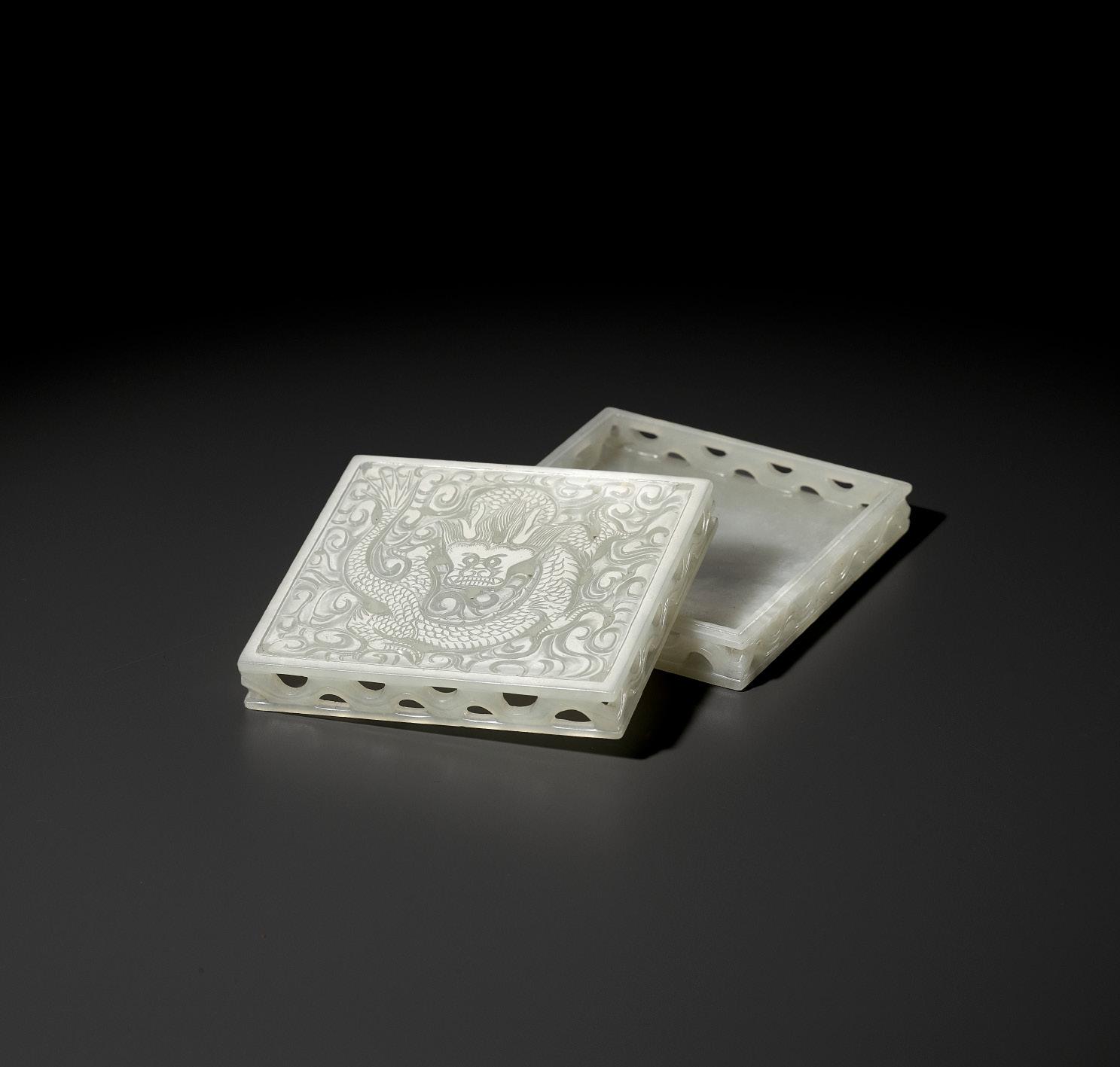

Estimate EUR 6,000
Starting price EUR 3,000
60 35
A MUGHAL GILT AND ‘GEM’-INLAID JADE STEM CUP, INDIA, 18TH CENTURY

The deep flared sides raised on a tall slender foot with a wide flat base, intricately incised with floral motifs. The body with a central bulbous section in gilt bronze with carved decorations and fine enamels, framed by beaded bands inlaid with ruby-red and emerald-green glass beads. The base is further embellished with gilt bronze and turquoise enamel bowstrings.
Provenance: From an old Danish private collection.
Condition: Good condition overall, with a minute nibble on the rim, natural fissures, a natural hairline crack on the foot with traces of adhesive, minor losses to the inlays. The stone with natural inclusions and fissures, some of which have developed into small hairline cracks over time.
Weight: 124 g
Dimensions: Height 10.5 cm
AUCTION RESULT COMPARISON
Type: Related
Auction: Sotheby’s London, 24 October 2007, lot 203
Price: GBP 13,700 or approx. EUR 28,500 adjusted for inflation at the time of writing
Description: A Mughal enameled and gold-wire inlaid jade mirror, India, 19th century Expert remark: Compare the closely related style of inlay.

Estimate EUR 6,000
Starting price EUR 3,000
61 36
A SPINACH-GREEN JADE GUI-FORM CENSER AND COVER, QIANLONG PERIOD
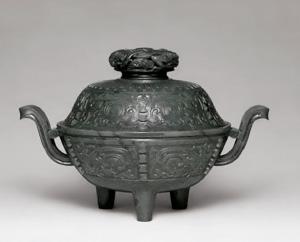
China, 1736-1795. Superbly carved with deep rounded sides raised on a flared foot, flanked by two wide upright S-shaped loop handles, the domed cover surmounted by an intricately carved and pierced finial in the form of a ferocious dragon, above a central aperture to the interior of the cover. Finely carved around the exterior of the bowl and cover with archaistic taotie mask designs interspersed by cross-hatched lozenges, C- and S-scrolls, and an angular scroll, the foot encircled by a band of ruyi heads. The translucent stone is of a deep spinach-green color with dark specks, russet veins, and cloudy inclusions.
Provenance: Robin and Fay Marx, Weybridge, Surrey, United Kingdom, acquired before 1954 and thence by descent in the family. Copies of four old insurance valuations from John Sparks Ltd., each confirming the dating above, accompany this lot. The fourth and last valuation is dated 28 January 1965, signed by Peter Vaughan (Director of John Sparks Ltd.), and states a value for the present lot (no. 29) of GBP 2,000 or approx. EUR 60,500 (converted and adjusted for inflation at the time of writing). Robin Marx (1923-1975) was a merchant banker with an erudite passion for Chinese jades. By the early 1950s, he had built an impressive collection with the help and guidance of celebrated London dealer Peter Sparks of John Sparks Ltd. Robin was a distant relative of the influential economist Karl Marx. He bequeathed a significant part of his library to the British Museum, a fellow employee of his was Ian Fleming, and he regularly shared a box at the races with Princess Margaret. For decades after Robin’s death, his wife Fay kept his collection on loving display in the family home. A part of the collection was sold by Christie’s on 16 December 2022 after Fay’s passing in 2021, including two pieces which were also included in the John Sparks insurance valuations: A spinachgreen jade brushpot, Qianlong period, initially valued at GBP 250 (no. 8) and sold by Christie’s for EUR 56,700, and lot 137, a ‘dragon’ jar and cover, Jiajing mark and period, initially valued at GBP 375 (no. 37) and sold by Christie’s for EUR 94,500, lot 132.
Condition: Good condition with minor wear and minuscule nibbling. The jade with natural fissures, some of which have developed into small hairline cracks.
Weight: 1,134 g
Dimensions: Width 24.3 cm
Expert’s note: This censer is notable for its bold, well-proportioned form as well as its exquisitely carved archaistic taotie mask decorations and magnificent, pierced, coiled dragon-form finial. During the eighteenth century, some of the finest jade carvings found their inspiration in archaic artifacts collected and treasured by the emperors. The decorative motifs on the body of the present censer draw inspiration from archaic bronze vessels. Roger Keverne explains in his 1991 publication, Jade, pp. 164, that spinach-green incense burners of this type were found in the Imperial palace
AUCTION RESULT COMPARISON
Type: Related
Auction: Christie’s New York, 21 March 2019, lot 1110
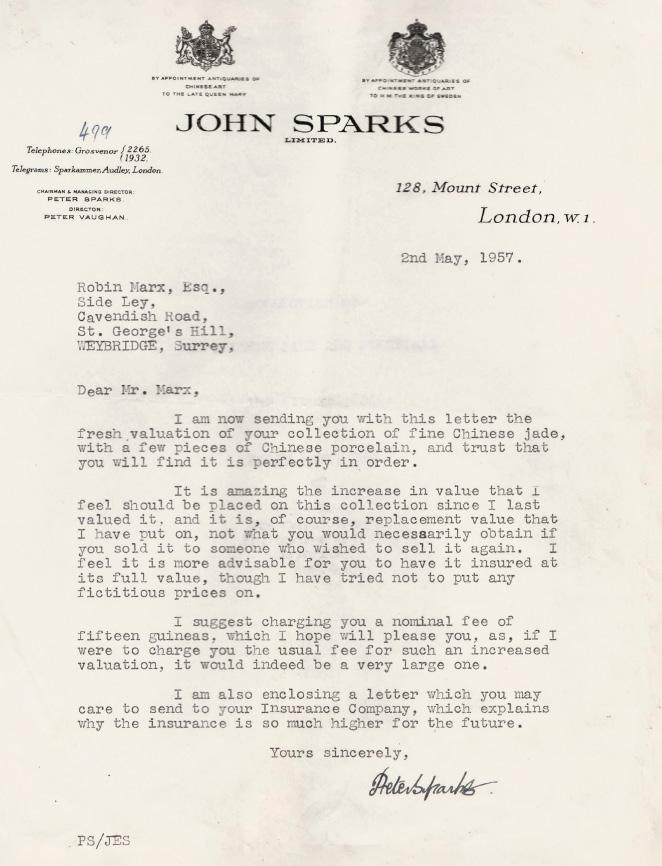
Price: USD 555,000 or approx. EUR 614,000 converted and adjusted for inflation at the time of writing
Description: A large spinach-green jade tripod censer and cover, Qing dynasty, 18th century
Expert remark: Compare the closely related color, manner of carving with similar taotie decoration, and size (24.4 cm), as well as the related gui form with a similar open worked dragon finial, the vessel however raised on three legs.
AUCTION RESULT COMPARISON
Type: Related
Auction: Christie’s Hong Kong, 30 May 2005, lot 1567
Price: HKD 780,000 or approx. EUR 144,000 converted and adjusted for inflation at the time of writing
Description: A large spinach-green jade tripod censer and cover, Qianlong period
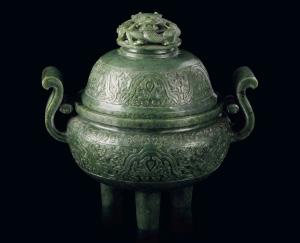
Expert remark: Compare the closely related color, manner of carving with similar taotie decoration, and size (24.8 cm), as well as the related gui form with similar handles and openworked dragon finial, the vessel however raised on three legs and carved with flanges.
Estimate EUR 20,000
Starting price EUR 10,000
62 37
A letter from John Sparks Ltd., dated 2 May 1957

A SPINACH-GREEN
JADE
‘SEVEN SAGES OF THE BAMBOO GROVE’ (ZHULIN QIXIAN) BRUSHPOT, BITONG, QIANLONG PERIOD
Expert’s note: The present brushpot is extraordinary in how the master carver transformed the vessel into a three-dimensional multilayered canvas, with the image continuing and revealing itself through the physical turning of the vessel by the beholder. It is also noteworthy that to produce such a magnificent vessel, a very large jade boulder of remarkable quality would have been used, with the carving process and hollowing of the brushpot creating significant wastage of material, underscoring the lavish expenditure in the process of making this exceptional scholarly vessel.
China, 1736-1795. Of cylindrical form, raised on three short ogeebracket feet. Deftly carved in deep relief with a continuous scene of the Seven Sages of the Bamboo Grove engaged in various pursuits and accompanied by their boy attendants in the eponymous bamboo grove amid craggy rockwork, towering pines, and swirling clouds. The partially translucent stone is of a dark spinach-green hue with expected icy inclusions and dark spots.
Provenance: Collection of Roger Meffreys, and thence by descent in the same family. A private collection in France, acquired from the above.
Roger Meffreys (1899-1976) was a French diplomat who served in China between 1936 and 1946. His first position in Shanghai was General Consul, later being assigned the position of Ambassador for France in Beijing until 1946. Meffreys became enamored with Chinese culture and works of art, frequently visiting Beijing’s antique shops and meeting famous artists including Xu Beihong. He built an exceptional collection, which he then took with him after his appointment as Ambassador ended. Meffreys continued in various diplomatic positions in Singapore, Hong Kong, and Thailand, before retiring in his hometown of Grenoble.

Condition: Very good condition with natural wear, traces of use, two small chips around one foot, possibly with an associated minuscule repair. The stone with natural inclusions and fissures, some of which have developed into small hairline cracks.
Weight: 1,897.7 g
Dimensions: Height 16.1 cm, Diameter 13.4 cm
Two of the sages are playing a game of weiqi (go), with one of them reaching into the container (weiqizhe) by his side for a counter, as a third looks on, while the four other sages are gathered around a table as one of them writes a poem on a scroll. One of the attendants is climbing a bamboo stalk, while another is fanning a kettle, preparing tea for the group.
The ‘Seven Sages of the Bamboo Grove’ were mid-3rd century literati who had renounced their official status and careers, retreating to the countryside in protest against the corrupt politics of the Wei dynasty rulers. They advocated freedom of individual beliefs which were inspired by Daoist philosophy. The design of the ‘Seven Sages of the Bamboo Grove’ (zhulin qixian) especially appealed to the Qianlong Emperor’s wish to depict himself as an upright ruler and his desire to be seen as a man of letters. The seven sages, depicted gathered under a bamboo grove drinking, composing poetry, and enjoying each other’s company, came to represent scholars disenchanted with official policies and are symbols of an incorruptible personality. They reflect the virtues of art and intellectual pursuits.
Literature comparison: Compare a closely related spinach-green jade brushpot, 14 cm high, also dated to the Qianlong period, exhibited by the Oriental Ceramic Society at Bonhams London, Reginald and Lena Palmer, their Collection, and the Oriental Ceramic Society, 1921-1970, 27 October 2021. Compare a related brushpot, inscribed with a Qianlong poem and dated to the period, in the National Palace Museum, Taipei, exhibited in The Refined Taste of the Emperor: Special Exhibition of Archaic and Pictorial Jades of the Ch’ing Court, 1997, Taipei, cat. no. 56.
AUCTION RESULT COMPARISON
Type: Closely related
Auction: Sotheby’s New York, 19 March 2007, lot 50
Price: USD 240,000 or approx. EUR 330,000 converted and adjusted for inflation at the time of writing
Description: A superb imperially inscribed spinach jade brushpot, Mark and period of Qianlong, dated 1776 AD


Expert remark: Compare the closely related form, color, and manner of carving. Note that this brushpot also depicts the Seven Sages of the Bamboo Grove. It is also inscribed with a poem by the Qianlong Emperor and a cyclical date.
Estimate EUR 20,000
Starting price EUR 10,000
64 38
Roger Meffreys (1899-1976)
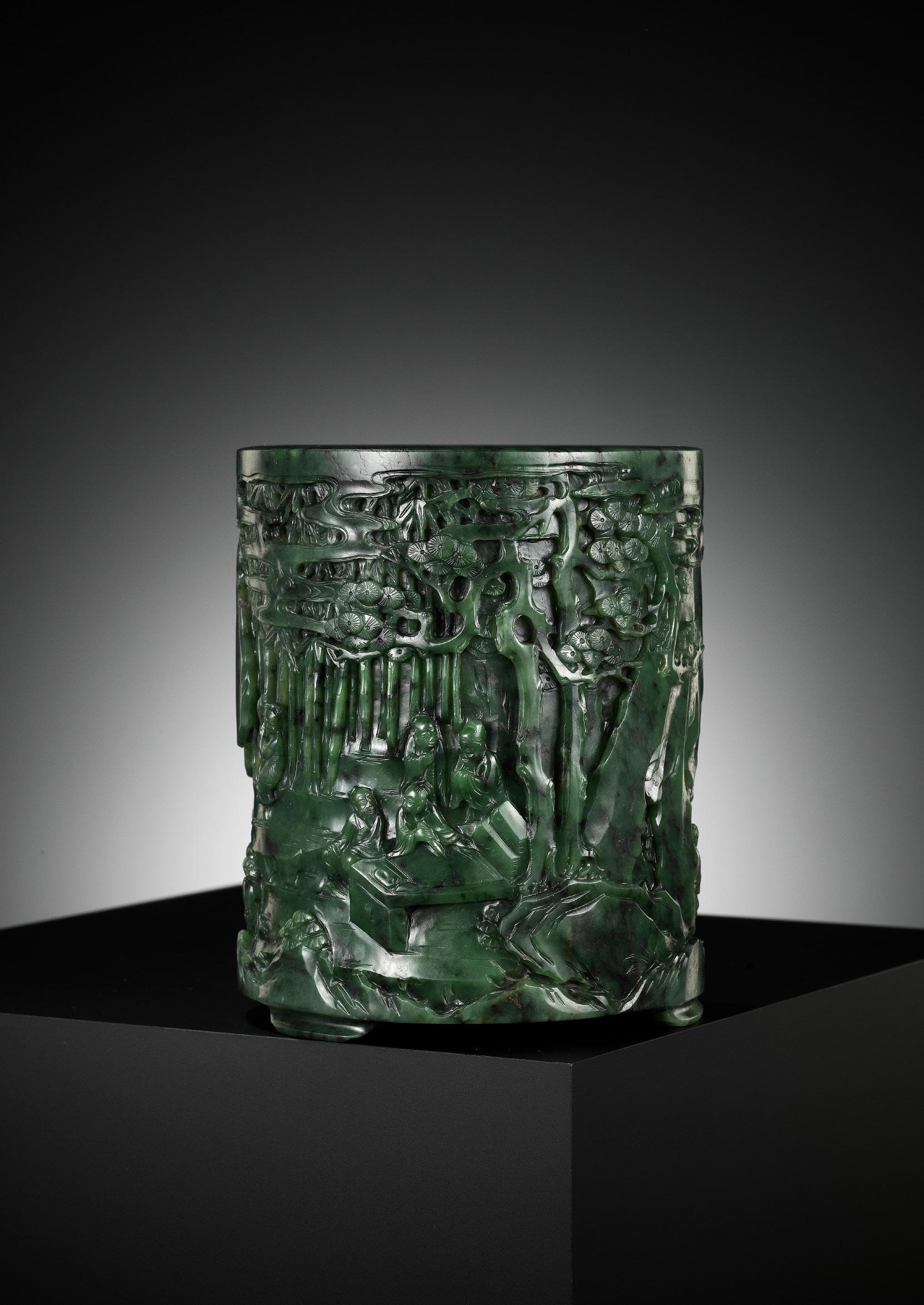
AN INSCRIBED AND TRANSLUCENT JADE ‘ORCHIDS’ BOWL, CHINA, 18TH CENTURY
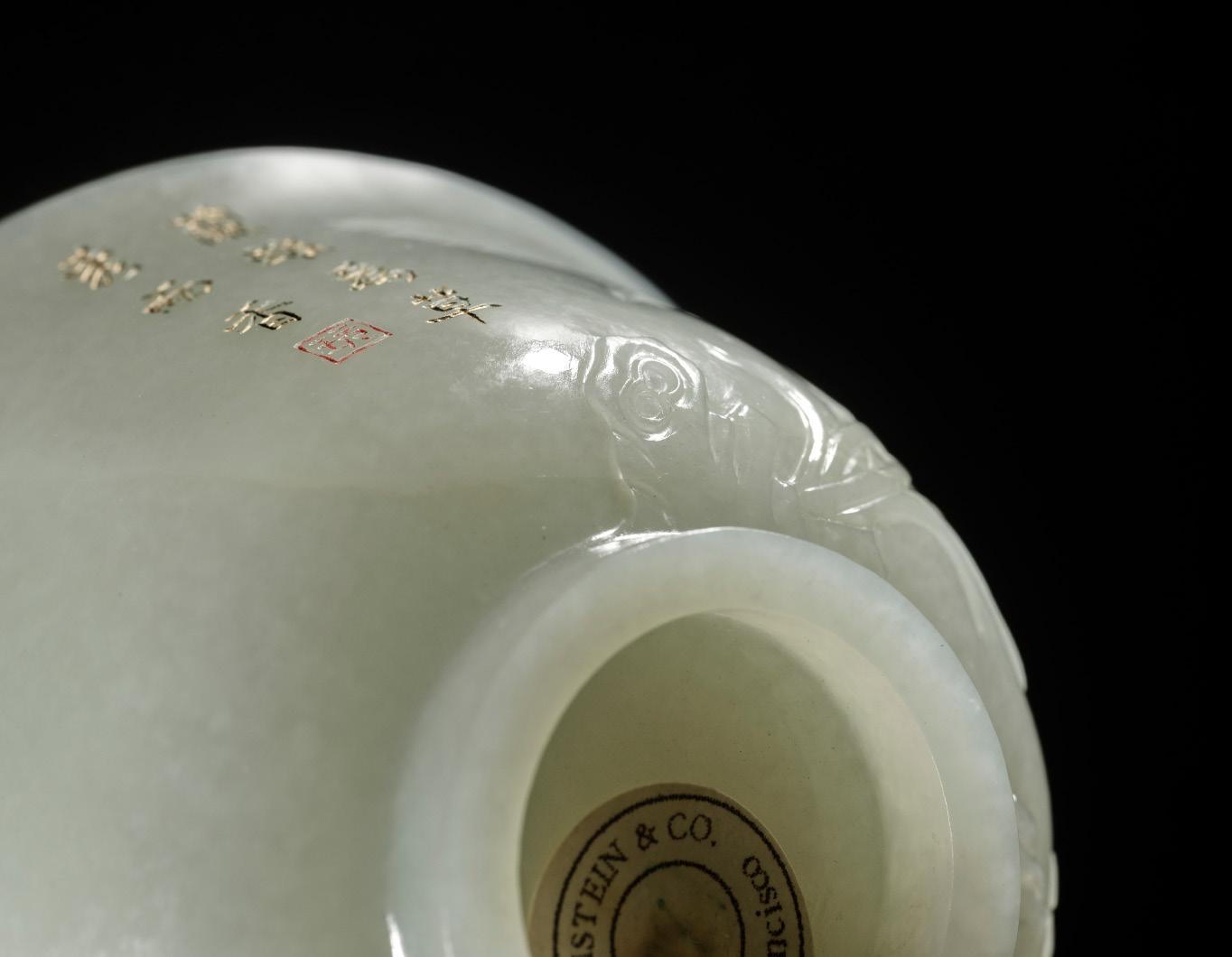
Inscriptions: ‘Although the orchids belong to the grass, they are graceful and fragrant.’
The deep rounded sides rising from a slightly splayed, massive ring foot to a gently everted rim, with a neatly slanted lip, a distinct hallmark of 18th century jade bowls. The remarkably well-polished stone is of a fine white color with hues of pale celadon and some cloudy inclusions. To one side, raised in high relief, we find a single orchid growing from a craggy rock next to a small lingzhi mushroom. The masterfully incised calligraphy is well-defined in gilt and highlighted in red lacquer.
Provenance: S. Bernstein & Co., Jade & Oriental Art, San Francisco. Isidore Cohn, Jr., MD, New Orleans, USA, acquired c. 2002 from the above and thence by descent in the same family. Label to the foot: ‘S. Bernstein & Co, San Francisco 2787.’ Isidore Cohn (1921-2015) was a prominent surgeon in New Orleans. Dr. Cohn served as the first Vice President of the American College of Surgeons (1993). He was a passionate collector of art, with several exhibitions of pieces from his collection conducted by The New Orleans Museum of Art, including ‘Chinese Jades from the Collection of Marianne and Isidore Cohn, Jr.’ in 2013-2014. Sam Bernstein is an internationally recognized specialist dealer in Chinese antiquities. He has authored thirteen volumes on Chinese art including ‘The Emperor’s Jade Suit’ and ‘Chinese Jade: The Immortal Stone’. Over the past twenty-five years, Mr. Bernstein has gained experience in forming some of the greatest collections of Asian art in the world. Both of his parents were passionate collectors of Asian art and traveled extensively throughout the Far East. In 1991, Mr. Bernstein founded S. Bernstein & Co., Jade and Oriental Art, a gallery in San Francisco located in the historic Fairmont Hotel, which specializes in museum quality Chinese jade and related arts. Condition: Superb condition with only minor old wear. The stone with natural inclusions.

Weight: 145.6 g
Dimensions: Diameter 9 cm
AUCTION RESULT COMPARISON
Type: Related
Auction: Christie’s New York, 20 September 2013, lot 1697
Sam Bernstein

Price: USD 32,500 or approx. EUR 39,000 converted and adjusted for inflation at the time of writing
Description: An Inscribed Pale Olive-White Jade Bowl, Late 18th/19th Century
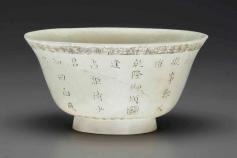
Expert remark: Compare the inscription.
Estimate EUR 8,000
Starting price EUR 4,000
66 39
Isidore Cohn, Jr., M.D.

A PALE CELADON AND RUSSET JADE ‘CICADA AND POMEGRANATE’ WATER POT,
CHINA, 18TH CENTURY
Naturalistically carved in the form of a pomegranate bursting with seeds, a single cicada resting on the vessel’s peach-formed rim, with its wings tightly folded to the sides, posed ready to drink. The waterpot further carved in relief with a gnarled branch issuing finely veined leaves opposite the stem. The smoothly polished translucent stone is of a pale celadon tone with distinct patches of russet skin and veins.
Expert’s note: Fascinatingly, this unusual object was intentionally designed to be displayed like a vase, when not used to hold water. This kind of “double” function was quite popular at the court in Beijing, intriguing viewers with an unexpected and surprising effect.
Provenance: This lot comes from an antique shop owner from the north of England. His store sells all kinds of antiques, and people come in with unusual objects all the time, but he has been keeping and collecting Chinese works of art that he particularly likes for a long time. Condition: Very good condition with minor old wear and few microscopic nicks. The stone with natural inclusions and fissures. The surface shows a magnificent polish, rendering an unctuous feel overall.
Weight: 152.9 g
Dimensions: Width 8.7 cm
Fruits encapsulating auspicious messages were highly favored in the 18th century. The pomegranate was especially popular as it symbolized fertility, and the bursting flesh of the fruit, exposing its many seeds inside, symbolized the wish for a large family. As the Chinese character for ‘seed’ (zi) is the same as that for ‘son,’ the many-seeded pomegranate is viewed as a symbol for having multiple sons who are expected to continue the family line.
The cicada’s role in Chinese culture is a longstanding and fascinating one. Meanings associated with the insect range from simply indicating the onset of summer to more complex themes, such as rebirth and immortality. In general Chinese lore, cicadas are creatures of high status. They are considered pure because of their perch in high treetops. An ancient analogy in China suggests that a high-ranking official should resemble a cicada: residing high, eating a pure diet, and with sharp eyes. Also in antiquity, the headgear of rulers incorporated a golden image of a cicada with prominent eyes. The emblem signaled refinement, modesty, and a full awareness of one’s surroundings.
AUCTION RESULT COMPARISON
Type: Closely related
Auction: Sotheby’s London, 15 May 2013, lot 58
Price: GBP 32,500 or approx. EUR 58,000 converted and adjusted for inflation at the time of writing
Description: A pale celadon jade ‘pomegranate’ waterpot, Qing dynasty, 18th century
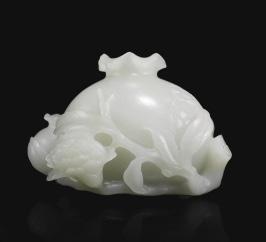
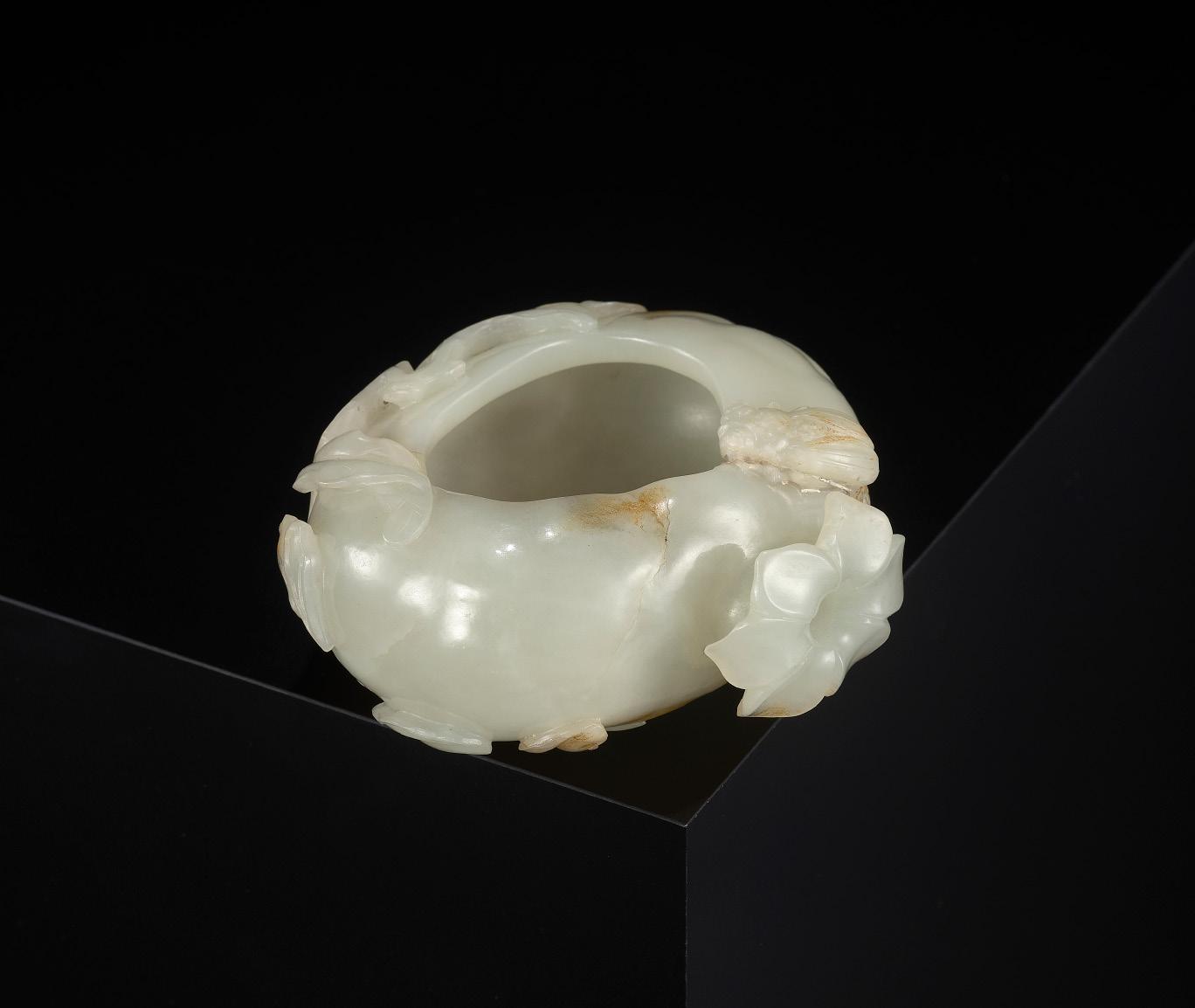
Expert remark: Compare the closely related form, manner of carving, and color.
Estimate EUR 8,000
Starting price EUR 4,000
68 40

A SPINACH-GREEN JADE ‘LINGZHI AND FINGER CITRON’ RUYI SCEPTER, CHINA, 18TH CENTURY
Finely carved, the scepter with a flattened ruyi head in the shape of a lingzhi, carved in openwork with two smaller lingzhi reaching beyond the top. The gently arched handle is also carved in openwork and relief, depicting lingzhi sprouts and a leafing branch in with two finger citrons. The semi-translucent stone of a deep spinach-green tone with dark specks and veining.

Provenance: From the collection of Vice-Admiral Edgar Humann, and thence by descent in the same family.
Edgar Eugène Humann (18381914) was a French naval officer who rose through the ranks to Admiral. In 1892, he was placed in command of the Far East naval division. From 1894 to 1895, he served as Chief of Staff of the French Navy, and in 1898, he was made Inspector General and Grand Officer of the Legion of Honor. He retired from active duty in May 1903.

Condition: Very good condition with only minor old wear, minuscule nibbling, and few tiny nicks. The stone with natural fissures, some of which have developed into small hairline cracks. There are no breaks or repairs of any kind to the handle or the ruyi head, a pristine state of preservation that is exceedingly rare to find, especially when combined with an ancient provenance, such as the present lot.
Weight: 343 g
Dimensions: Length 40.1 cm
Literature comparison: Compare a closely related spinach jade ruyi scepter carved with lingzhi and peaches, also dated to the 18th century, in the Metropolitan Museum of Art, accession number 02.18.491.
AUCTION RESULT COMPARISON
Type: Related
Auction: Christie’s New York, 18 March 2009, lot 412
Price: USD 25,000 or approx. EUR 33,000 converted and adjusted for inflation at the time of writing
Description: A wellcarved spinach-green jade ruyi scepter, 18th/19th century
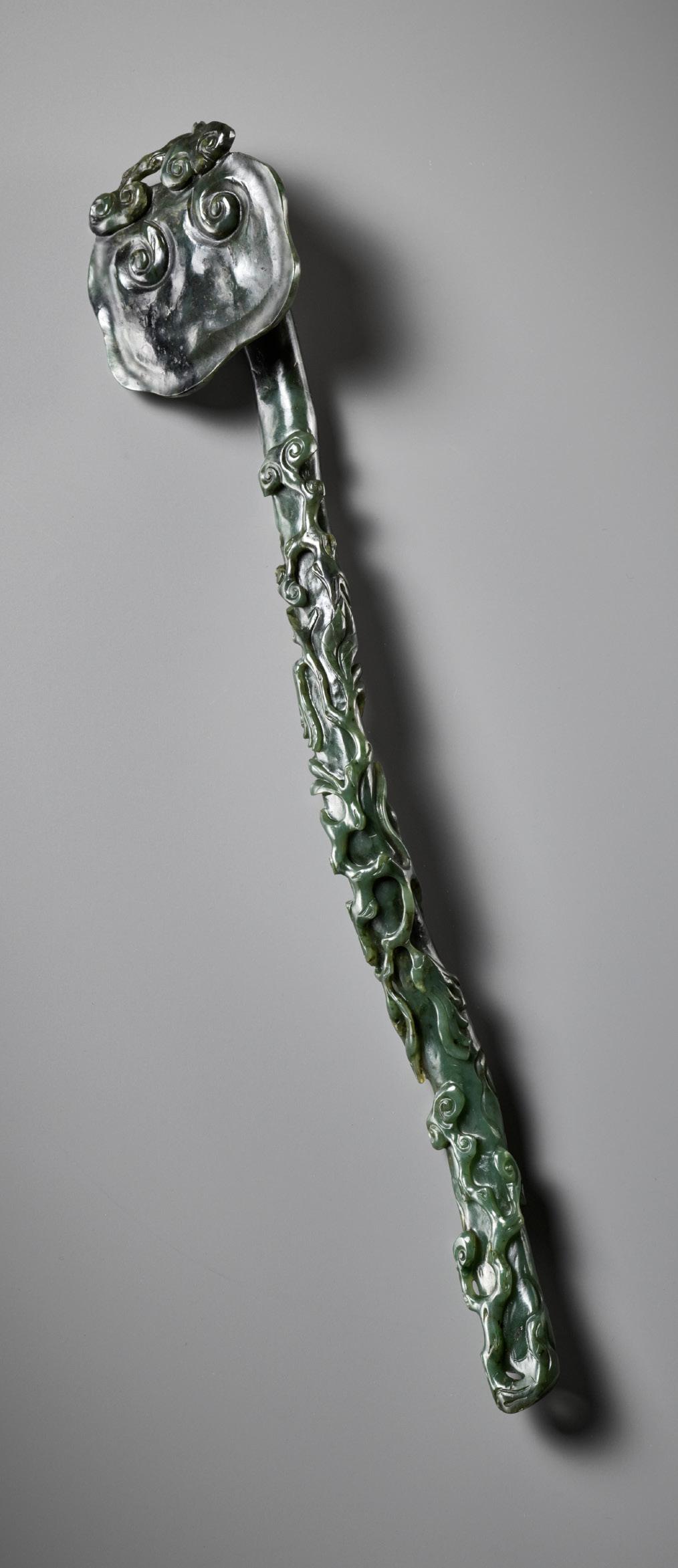
Expert remark: Compare the closely related form, color, and lingzhi decoration, albeit further with chilong. Note the size (31.1 cm).
Estimate EUR 10,000
Starting price EUR 5,000
41
Rear Admiral Edgar Humann (1838-1914) on the cover of Le Petit Journal, 29 July 1893
A CELADON JADE CARVING OF A FINGER CITRON, CHINA, 18TH - 19TH CENTURY
The naturalistically carved ‘Buddha Hand’ attached to an open worked gnarled stem issuing attendant leaves, exquisitely carved with nine ‘fingers’ extending sinuously and mingling at their tips. The delicately polished, translucent stone of a pale celadon hue with russet patches as well as cloudy and icy inclusions.
Provenance: French trade.
Condition: Superb condition with minor wear and microscopic nibbles here and there. The inside of the fruit with a few untreated drilling tracks, not visible from outside. The stone with natural inclusions and fissures, some of which have developed into small hairline cracks over time.
Weight: 436.7 g
Dimensions: Length 14.3 cm
The Chinese name for finger citron, foshou, is also a pun based on fu for ‘blessings’ or ‘riches’ followed by shou for ‘longevity’. In addition, the finger citron fruit was thought to resemble the hand of the Buddha, with its idealized, lotus-shaped ‘fingers’. Although inedible, the fruit has a strong citrus fragrance which is often used for scenting rooms, and for offerings at the Buddhist altar.
Literature comparison: Compare a related jade finger citron, in the Palace Museum, Beijing, illustrated in Compendium of Collections in the Palace Museum: Jade 9. Qing dynasty, Beijing, 2011, no. 159. Compare a related jade carving of a finger citron, illustrated by Roger Keverne, Jade, London, 1995, pp. 165, fig. 94. Compare a related group included in the exhibition, Minor Arts of China, IV, Spink & Sons, London, 1989, illustrated in the catalog, p. 124, no. 174.
AUCTION RESULT COMPARISON
Type: Closely related
Auction: Sotheby’s New York, 22 September 2020, lot 205
Price: USD 80,900 or approx. EUR 87,000 converted and adjusted for inflation at the time of writing
Description: A pale celadon jade carving of a finger citron, Qianlong period
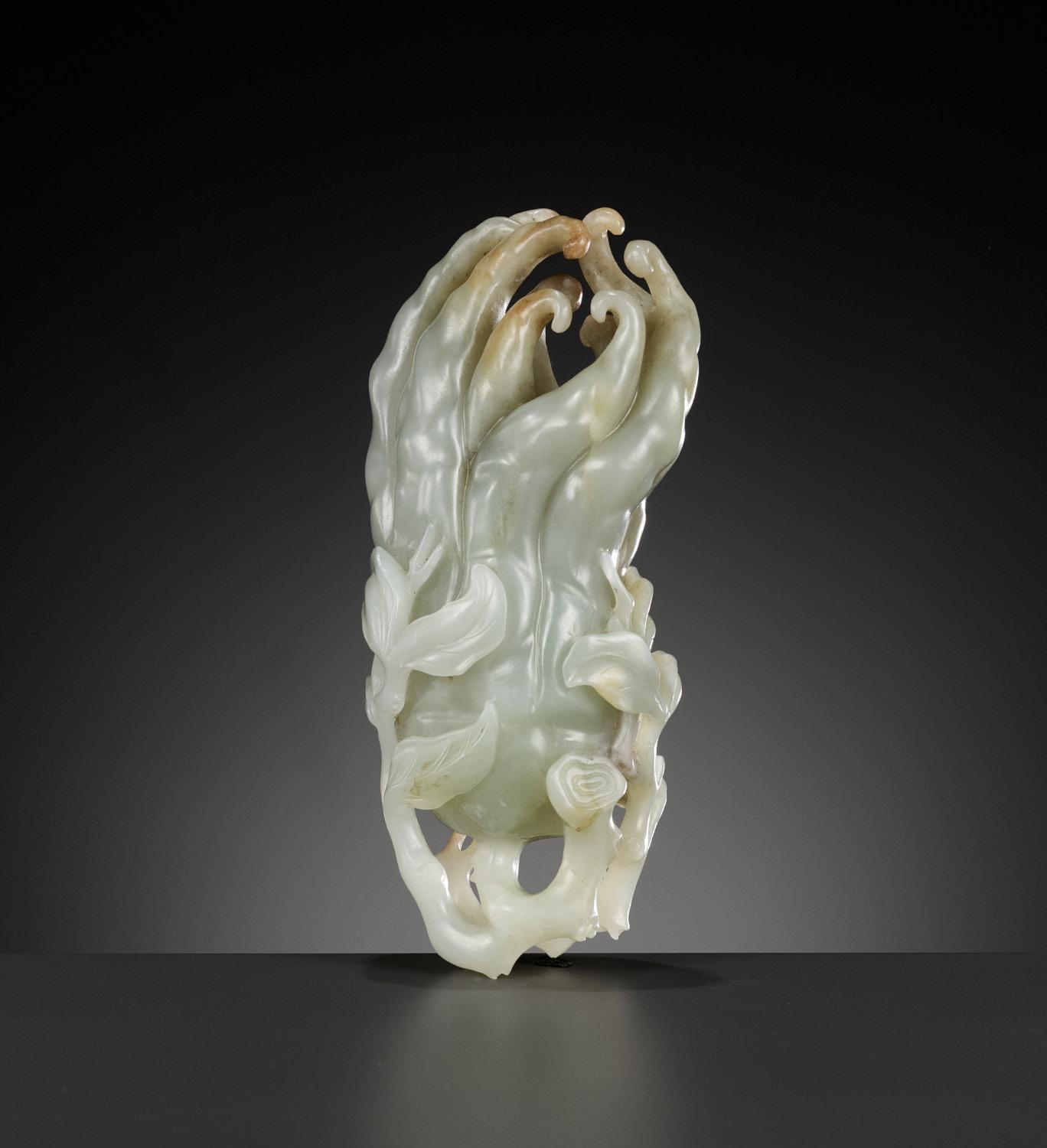

Expert remark: Compare the related hue of the jade and leafy branch carved at the base. Note the size (16.3 cm).
Estimate EUR 8,000
Starting price EUR 4,000
71 42
A CELADON AND RUSSET JADE ‘DOUBLE FISH’ SNUFF BOTTLE, CHINA, 1680-1750
Expert’s note: The grayish color of the jade is typical of that used in carvings of the late 17th to early 18th century. Double snuff bottles, with two separate compartments, are quite rare.
Finely carved in the form of two scaly fish side by side facing away from each other. Each is carved with a lotus stem in its open mouth, gripping the pearl stopper in its jaws. The translucent stone is of a grayish celadon hue with dark brown and russet patches and pale russet veining.
Provenance: Robert Kleiner & Co. Ltd., London, United Kingdom, 2003. A private collection in the United Kingdom, acquired from the above. A copy of the original invoice from Robert Kleiner & Co. Ltd., dated 25 October 2003, confirming the dating above, and stating the purchase price of GBP 4,000 or approx. EUR 10,000 (converted and adjusted for inflation at the time of writing), accompanies this lot. Robert Kleiner (1948-2014) was an important expert of Chinese snuff bottles, beginning his long career at the Sotheby’s Chinese Art department in London. Along with Hugh Moss and Bob Hall, he became a key advisor to the Mary and George Bloch collection, and it was Robert who wrote and produced the very first catalog of their bottles.
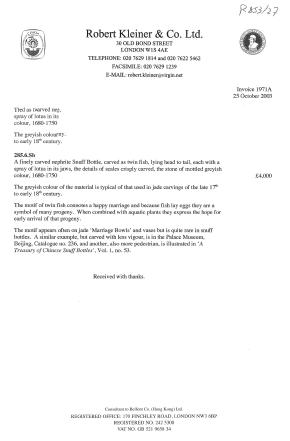
Condition: Very good condition with minor wear and minuscule nibbling. Two of the lotus stems with small repairs. The stone with natural inclusions and fissures, some of which have developed into small hairline cracks. Two of the lotus stems with small repairs.
Stoppers: Pearl
Weight: 55.6 g
Dimensions: Height incl. stoppers 92 mm, Diameter neck 8 and 10 mm and mouth 5.5 and 5.6 mm
The twin-fish subject is common in Chinese art, and it also appears in snuff bottles where the two are combined in a single bottle form. The symbolism is perhaps more intriguingly expressed, however, and certainly the sculptural possibilities greater, if the two fish form separate bottles, as in the present lot. The motif of the twin fish is symbolic for a happy marriage. The connection comes from the thousands of eggs which fish lay, emblematic of fecundity. This same motif appears on marriage bowls as well as marriage vases, but it is extremely rare among snuff bottles. This may have been a bottle for a couple who both took snuff, in which case perhaps the two halves became ‘his and her’ snuff bottles, each containing a different mixture of snuff.
AUCTION RESULT COMPARISON
Type: Closely related
Auction: Sotheby’s Hong Kong, 25 May 2014, lot 1183
Price: HKD 375,000 or approx. EUR 53,500 converted and adjusted for inflation at the time of writing
Description: A white jade ‘double fish’ snuff bottle, Qing dynasty, 18th/19th century

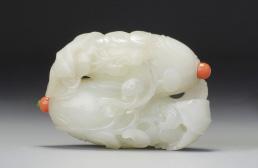
Expert remark: Compare the closely related subject and similar execution with each fish forming a separate bottle.
Estimate EUR 6,000
Starting price EUR 3,000
72 43
A WHITE AND RUSSET JADE ‘GOURD AND BUTTERFLY’ SNUFF BOTTLE, CHINA, 18TH CENTURY
Exquisitely carved from a pebble in the shape of a gourd, decorated in high relief with leafy branches encircling butterflies and melons. The translucent stone is of a fine white hue with distinct russet veining and clouding, and scattered icy inclusions.
Provenance: Spink & Son, London, United Kingdom, 1989. Collection of Joseph (1938-2005) and Bella Shapiro (1941-2011), acquired from the above and thence by descent in the same family. A copy of a signed invoice from Spink & Son Ltd., addressed to J. Shapiro, dated 27 February 1989, and dating the present lot to the 18th century, accompanies this lot.
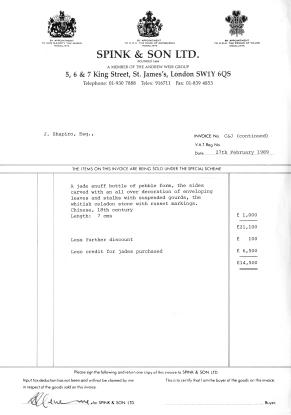
Condition: Very good condition with minor wear, light nibbling, and a microscopic nick to the mouth. The jade has natural inclusions and fissures, some of which may have developed into minuscule hairline cracks.
Stopper: Glass with a bronze collar and metal spoon
Weight: 66.1 g
Dimensions: Height incl. stopper 70 mm, Diameter neck 12 mm and mouth 4.4 mm
The butterfly (die) and gourd (gua) form the pun ‘guadie’, a rebus for ‘ceaseless generations of descendants’. In addition, because the gourd has a long stem bearing fruits of all sizes, each containing many seeds, it is itself an apt symbol for fertility. The subject matter of gourds was popular at the Imperial court and appears on a wide range of imperial enamels on glass, metal, and porcelain.
AUCTION RESULT COMPARISON
Type: Related
Auction: Sotheby’s Hong Kong, 28 November 2019, lot 502
Price: HKD 118,750 or approx. EUR 15,000 converted and adjusted for inflation at the time of writing
Description: A carved white and russet jade ‘gourds’ snuff bottle, Qing dynasty, 18th-19th century
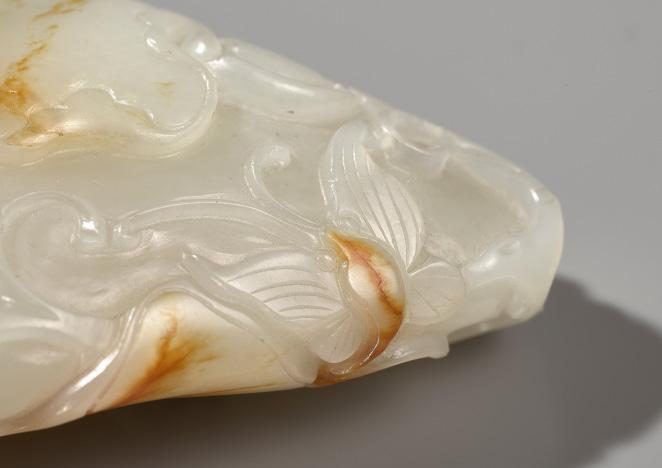
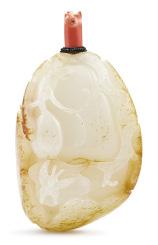
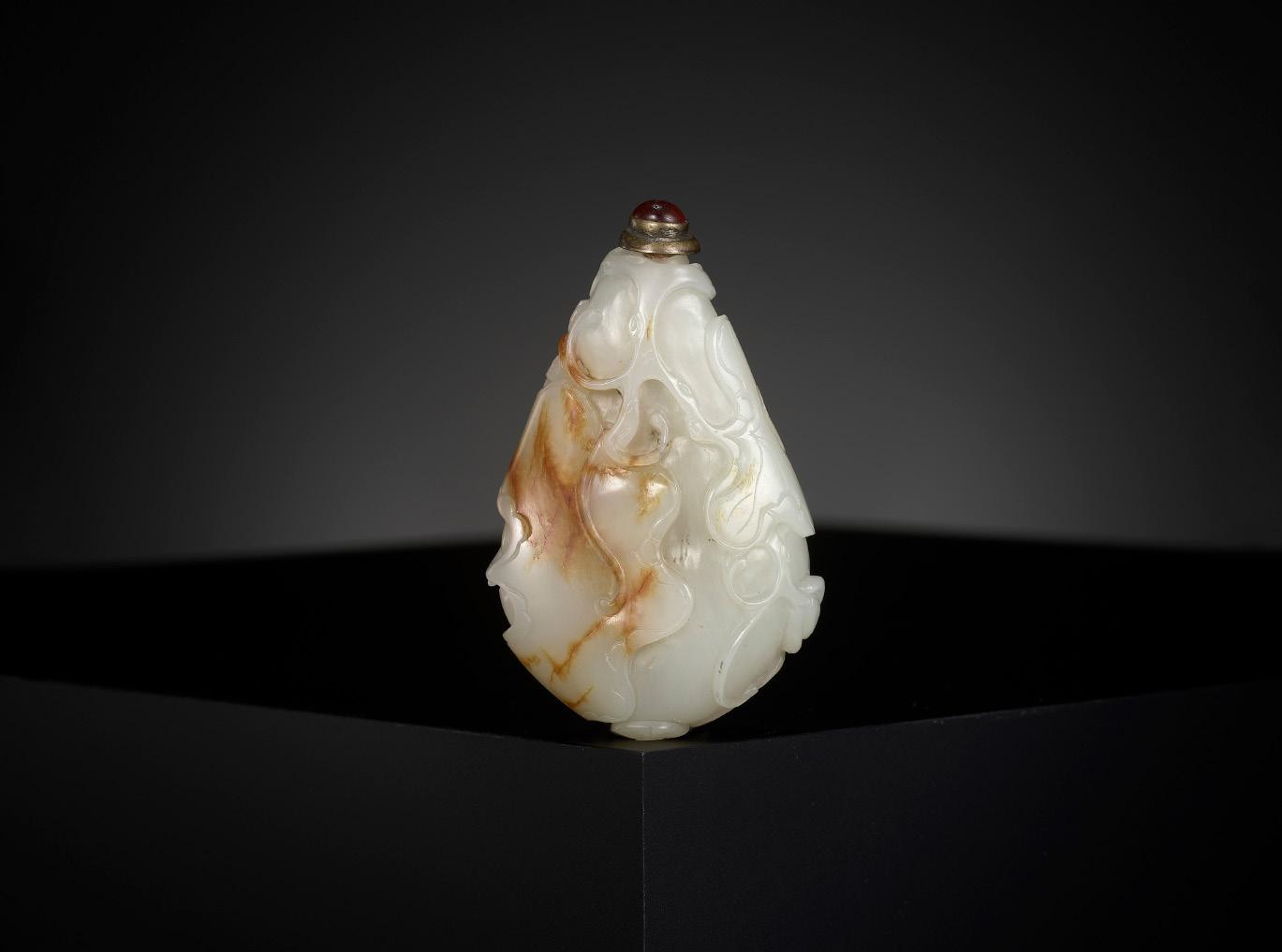
Expert remark: Compare the related form with a butterfly and scrolling vines and the similarly colored pebble. Note the different stopper and the smaller size (63 mm).
Estimate EUR 6,000
Starting price EUR 3,000
73 44
A WHITE JADE WITH RUSSET SKIN ‘MONKEYS’ SNUFF BOTTLE, CHINA, 1750-1850
Exhibited: The Norton Museum of Art, Palm Beach, USA. The Walters Art Museum, Baltimore, USA.
Of rounded rectangular form, supported on a wide oval foot and surmounted by a short cylindrical neck, one side of the bottle with a beveled surface, cleverly revealing a distinct layer of russet skin inside the stone. One narrow side is finely carved in low relief with monkeys climbing on rocks issuing a lingzhi sprig. The translucent stone of a soft white tone with a rich russet skin on one side.
Literature comparison: See three closely related bottles, a pair from the collection of Edith Griswold, illustrated in L.S. Perry, Chinese Snuff Bottles. The Adventures & Studies of a Collector, p. 106, nos. 88-89, and another in The Au Hang Collection of Chinese Snuff Bottles, p. 78, no. 98.
AUCTION RESULT COMPARISON
Type: Closely related
Auction: Christie’s New York, 19 September 2013, lot 1226
Price: USD 23,750 or approx. EUR 28,500 converted and adjusted for inflation at the time of writing
Description: A white and russet jade snuff bottle, 1750-1880
Expert remark: Compare the closely related white and russet color as well as the subtle carving to one shoulder. Note the size (6.3 cm).
Estimate EUR 8,000
Starting price EUR 4,000
Joan and Ted Dorf
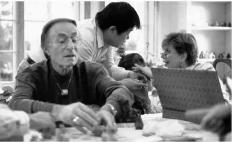
Provenance: The Joan and Ted Dorf Collection, no. 180. Joan and Ted Dorf (19262020) were collectors of snuff bottles for over fifty years, in a lifelong passion that paralleled the deep love they felt for each other during their 67 years of marriage. Their enthusiasm eventually spilled over into collecting scholarly Chinese works of art as well. Ted served as a director on the board of the International Chinese Snuff Bottle Society (ICSBS) between 2006 and 2012, and was also its vice president from 2009 to 2011. Despite a flourishing career in radio broadcasting, he always found time for collecting and co-chaired ICSBS conventions in Washington, D.C., and Palm Beach, Florida. The Joan and Ted Dorf Collection has been exhibited at the Norton Museum of Art in Palm Beach, and most recently at the Walters Art Museum in Baltimore. Condition: Superb condition with minor wear and few microscopic nicks. The stone with natural fissures, some of which may have developed into small hairline cracks.
Stopper: Organic material
Weight: 82.7 g
Dimensions: Height including stopper 73 mm. Diameter neck 22 mm and mouth 7 mm.
This bottle is one of a distinctive group dated to the mid-Qing period that is made of pure white nephrite using the natural russet-brown skin of the pebble as part of the decoration. The raw material used for the present bottle was cut from a fairly large boulder or pebble, indicated by the slight curving of the russet skin which is imposed by the natural shape of the boulder. The powerful abstract design that results from the combination of a pure white pebble with its own russet skin remains popular among connoisseurs.
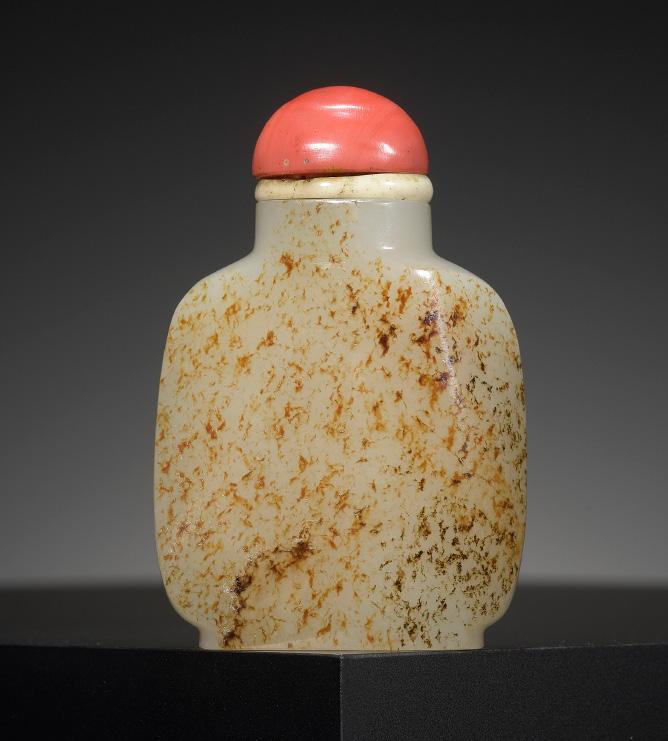

The present bottle, however, is an extremely rare example because one of the narrow sides is delightfully carved with two monkeys clinging to rocks. Often the white part of the jade pebble is left completely uncarved, with only the russet skin building the decoration.

74 45
A JADEITE SNUFF BOTTLE DEPICTING A CARP TRANSFORMING INTO A DRAGON, CHINA, 1770-1850
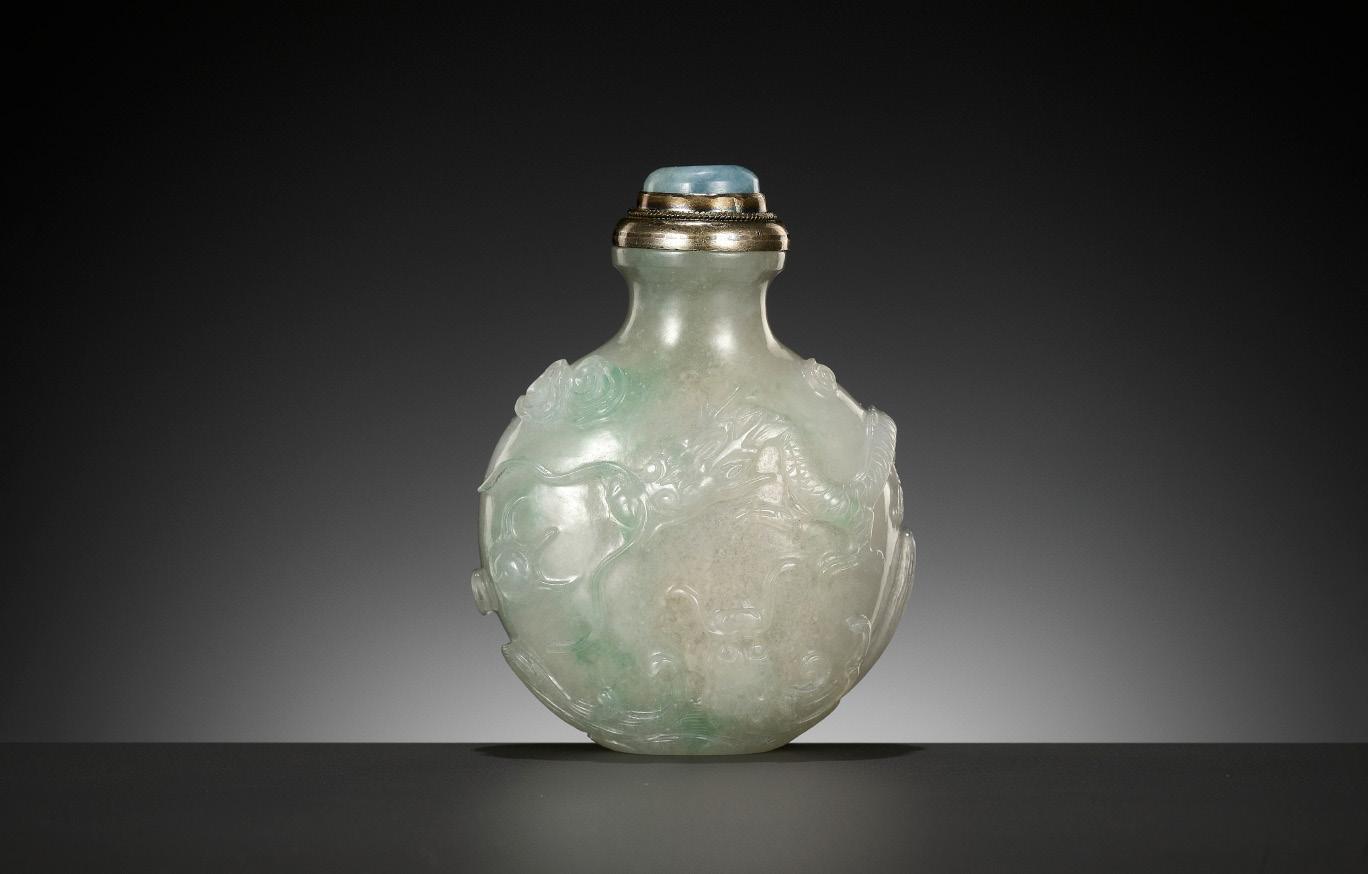
Expert’s note: This bottle is perhaps one of the most exciting of all carved jadeite examples. The shape has a perfect formal integrity which is greatly enhanced by the tall, flared neck with a lipped rim. The carved decoration stands in unusually high relief and in the undulating rhythms of the dragon’s back, shows a confident line of which an accomplished painter with a brush would be proud of. The entire composition, however, is truly brought to life by the exceptionally fine hollowing, which allows the light to be transmitted through the body, revealing the icy texture of the stone. This adds enormously to the energy of the piece, creating the appearance of a raging storm through which the dragons are scything unmoved. The fashion for extreme hollowing was probably inspired by the advent of Mughal jades into China in the 1750s and may have played some part in the conception of this bottle. However, most bottles of this ultra-hollowed group are uncarved and rely solely on their hollowing for their impact, whereas on the present bottle the hollowing actually adds to the impact of the carving.
Of flattened globular form, exceptionally well hollowed, finely carved in high relief with a continuous scene depicting a carp emerging from the waves to transform into a dragon chasing a flaming pearl, with cloud billows on the shoulders. The well-polished translucent stone is of an apple-green hue with emerald-green patches, paler shadings, and icy inclusions.
Provenance: Collection of Gerry P. Mack. Robert Kleiner & Co. Ltd., London, United Kingdom, 2010. Private collection in the United Kingdom, acquired from the above. A copy of the original invoice from Robert Kleiner & Co. Ltd., dated 30 June 2010, confirming the dating above, and stating a purchase price for this present lot of GBP 5,000 or approx. EUR 10,500 (converted and adjusted for inflation at the time of writing), accompanies this lot.

According to Robert Kleiner’s foreword to the catalog of his single owner sale at Christie’s, he “was one of the great snuff bottle collectors of the twentieth century. The bottles for which Gerry had a weakness have stood the test of time and, more remarkably, of our increased knowledge of the subject. Gerry’s achievement was to align on bottles which he liked and which are still highly sought after and in many cases among the finest of their type.”

Condition: Superb condition with minor old wear and occasional light scratches. The stone with natural inclusions and fissures.
Stopper: Agate with bronze collar
Weight: 87 g
Dimensions: Height incl. stopper 74 mm, Diameter neck 22 mm and mouth 7 mm
The depiction of a carp turning into a dragon alludes to the path of the scholar who must leap like a carp across the Longmen Falls in order to transform into a dragon, meaning to pass his examinations.
AUCTION RESULT COMPARISON
Type: Related
Auction: Sotheby’s Hong Kong, 31 May 2015, lot
192
Price: HKD 150,000 or approx. EUR 20,500 converted and adjusted for inflation at the time of writing
Description: A rectangular jadeite ‘dragon and flaming pearl’ snuff bottle, Qing dynasty, 18th/19th century
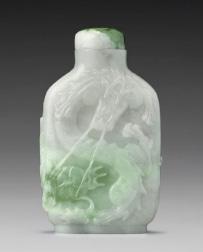
Expert remark: Compare the related color of the jadeite, manner of carving, and subject (albeit depicting only a dragon). Note the different form. Note that this bottle was also previously in the collection of Gerry P. Mack and subsequently with Robert Kleiner.
Estimate EUR 8,000
Starting price EUR 4,000
75 46
Robert Kleiner (1948-2014)
A WHITE JADE ‘DRAGON’ SNUFF BOTTLE, CHINA, 18TH CENTURY
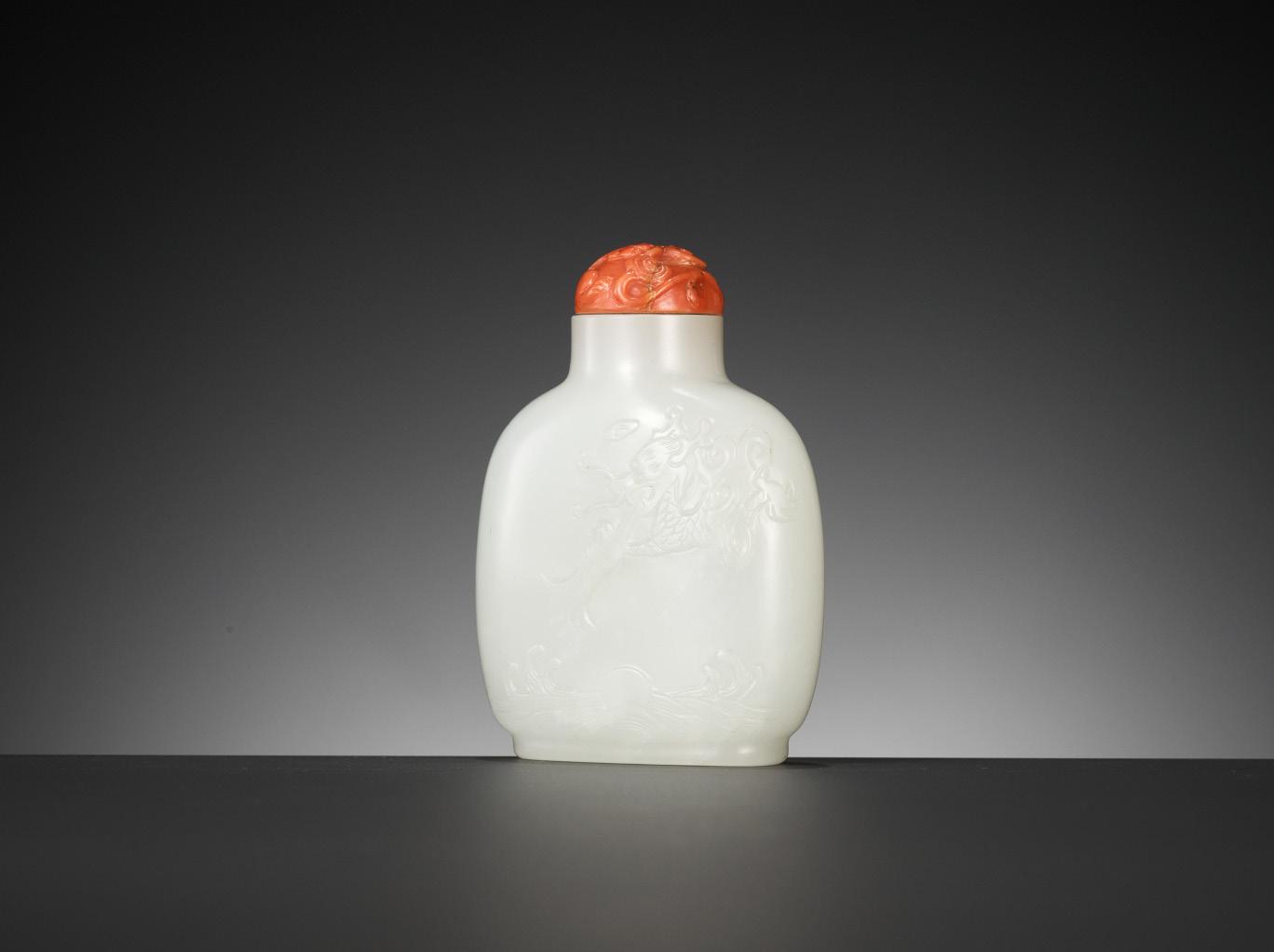

Well hollowed, the rounded rectangular body supported on a wide oval foot and rising to a short cylindrical neck with a flat lip. Neatly incised to one side with a ferocious dragon emerging from swirling clouds and exhaling smoke as it reaches for the sacred pearl in the water below, and to the other side with fishermen in a sampan floating along a river, with a pavilion on the shore under a cliff. The base incised with a fruiting peach branch. The translucent stone is of a superb white color, near-absolutely pure, with very few minute cloudy and pale brown inclusions.
Stopper: Coral cabochon of good color, carved as a coiled chilong
Weight: 66.6 g
Dimensions: Height including stopper 65 mm. Diameter neck 19 mm and mouth 6 mm
Estimate EUR 8,000
Starting price EUR 4,000
The
Provenance: The VWS Collection, acquired by the previous owner’s father (1890-1977) in China during the 1930s and thence by descent within the family. The VWS collection tells the extraordinary story of a family fleeing the Tsarist Empire in Russia. Their journey began in 1903 as the Chinese Eastern Railway, the eastern branch of the Trans-Siberian Railway, was completed. Fleeing, like others, a climate of political persecution and anti-Semitism, the family settled in Harbin, the northernmost city in China and started to develop its businesses from 1906 onwards. Like many others, they were attracted to this cosmopolitan place, then a major economic and cultural center in Manchuria, because of its large Jewish community. In Harbin, the father, a cultured, open-minded and multilingual man, felt at home and his early successes in business earned him respect. By 1932, he and his family were forced to flee again, following the Japanese invasion of Manchuria, and found a new home in Shanghai. From there, his businesses took him to Hong Kong, North America, and other Asian countries, where the family would remain for many years. They began collecting art in China during the 1930s and these artworks have remained with the family heirs ever since.
Condition: Very good condition with only minor wear and minuscule nibbling to the interior of the mouth.

76 47
previous owner (1918-1974) as a young boy in China during the 1930s
A CAMEO AGATE
‘NOBLE
PROFESSIONS’
SNUFF BOTTLE, ZHITING SCHOOL, SUZHOU, CHINA, 1760-1850

Well hollowed, the ovoid body supported on a flat foot rising to a tall neck with a flat lip. Superbly carved, cleverly utilizing the darker brown markings in the stone, to one side with a farmer sitting with his goat under a pine tree and to the other with a scholar and his boy attendant by a pond with two ducks, all amid neatly detailed serrated rockwork, a hallmark of the Suzhou school. The shoulders carved with beast mask handles suspending mock rings.
Stopper: Apple and emerald-green jadeite stopper
Weight: 64.7 g
Dimensions: Height including stopper 74 mm. Diameter neck 11 mm and mouth 7 mm
Expert’s note: The present lot belongs to a group of masterfully carved and rare Suzhou snuff bottles depicting the popular subject of the ‘Four Noble Professions’: scholar, farmer, woodcutter, and fisherman. The present bottle depicts two of these professions, namely the scholar and the farmer.
AUCTION RESULT COMPARISON
Type: Closely related
The previous owner’s father (1880-1977), who acquired the present lot in China during the 1930s

Provenance: The VWS Collection, acquired by the previous owner’s father (1890-1977) in China during the 1930s and thence by descent within the family. The VWS collection tells the extraordinary story of a family fleeing the Tsarist Empire in Russia. Their journey began in 1903 as the Chinese Eastern Railway, the eastern branch of the Trans-Siberian Railway, was completed. Fleeing, like others, a climate of political persecution and anti-Semitism, the family settled in Harbin, the northernmost city in China and started to develop its businesses from 1906 onwards. Like many others, they were attracted to this cosmopolitan place, then a major economic and cultural center in Manchuria, because of its large Jewish community. In Harbin, the father, a cultured, open-minded and multilingual man, felt at home and his early successes in business earned him respect. By 1932, he and his family were forced to flee again, following the Japanese invasion of Manchuria, and found a new home in Shanghai. From there, his businesses took him to Hong Kong, North America, and other Asian countries, where the family would remain for many years. They began collecting art in China during the 1930s and these artworks have remained with the family heirs ever since.
Condition: Very good condition with only minor wear and few tiny nicks.
Auction: Christie’s New York, 21 March 2013, lot 1092
Price: USD 37,500 or approx. EUR 44,500 converted and adjusted for inflation at the time of writing
Description: A finely carved cameo agate snuff bottle, Zhiting School, Suzhou, 1760-1850
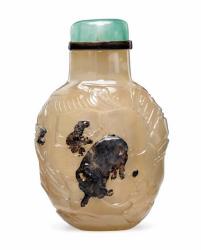
Expert remark: Compare the closely related subject, also depicting the Four Noble Professions, color with similar dark inclusions, and manner of carving with similar serrated rockwork. Note the size (4.8 cm).
Estimate EUR 8,000
Starting price EUR 4,000
77 48
A CAMEO AGATE ‘ZHONG KUI’ SNUFF BOTTLE, OFFICIAL SCHOOL, CHINA, 1770-1840

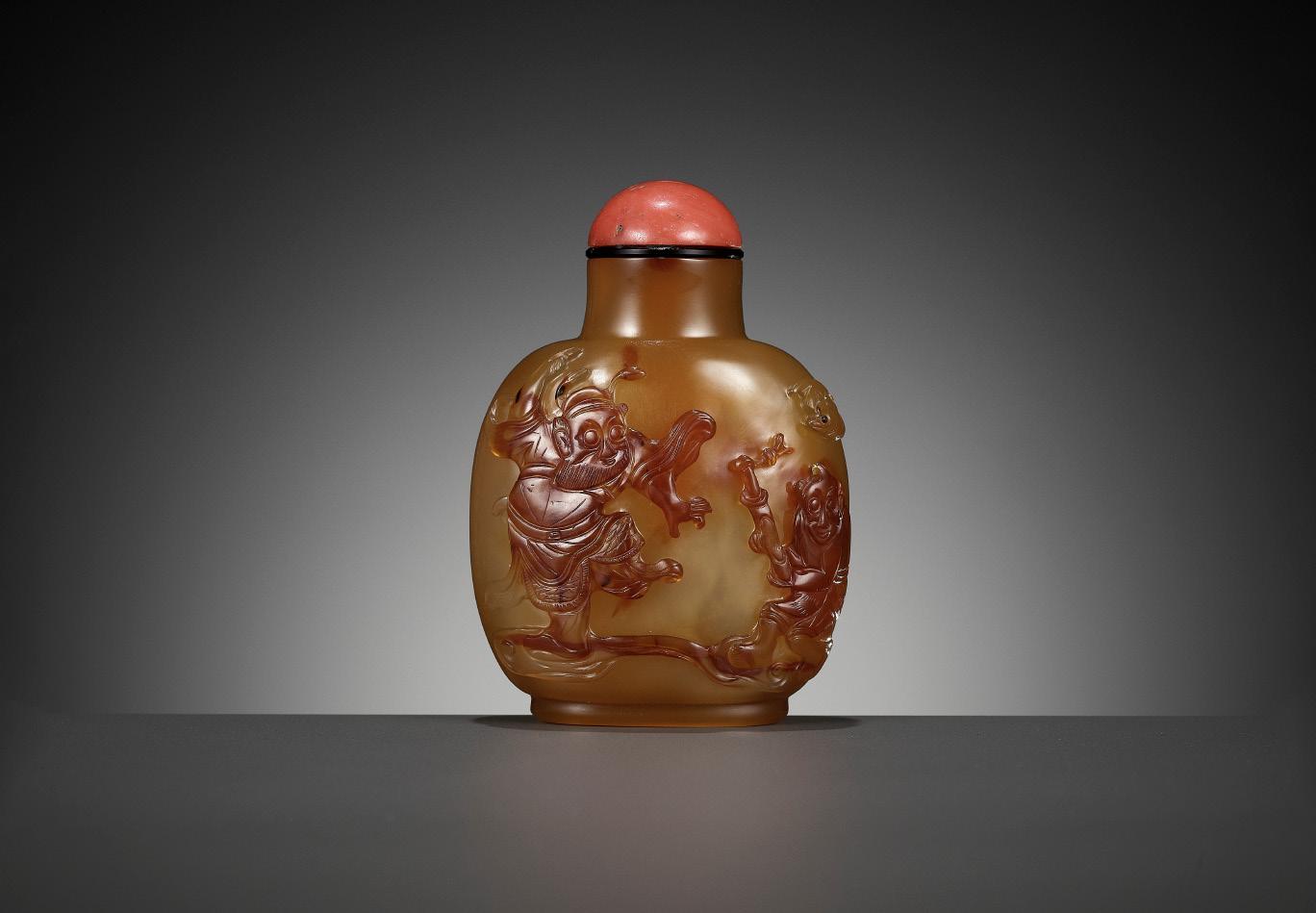
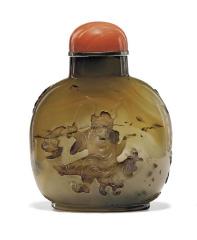
Of rounded square form, well hollowed, the honey-brown stone finely carved in relief utilizing darker markings to depict Zhong Kui dancing on a scrolling cloud with a demon and a bat flying above. The reverse is similarly carved with a fisherman beneath a single cloud, hauling in a carp.
Provenance: Collection of Bernard Wald. Robert Kleiner & Co. Ltd., London, United Kingdom, 2006. A private collection in the United Kingdom, acquired from the above. The base with an old collector’s label, ‘RR 853 29.’ A copy of the invoice from Belfont Company Ltd., dated 7 September 2006, describing the present lot as a chalcedony snuff bottle, confirming the dating above, and stating a purchase price for the present lot of GBP 5,500 or approx. EUR 12,500 (converted and adjusted for inflation at the time of writing), accompanies this lot. Although little is known of the collector Bernie Wald, his collection of Chinese snuff bottles was quite prominent. He was an associate of noted experts such as Robert Kleiner, Robert Hall, and Hugh Moss, and bottles from his extensive collection, which he built together with his wife Francine, continue to appear at auction houses including Christie’s and Sotheby’s. The couple also wrote articles for the International Chinese Snuff Bottle Society. Robert Kleiner (1948-2014) was an important expert of Chinese snuff bottles, beginning his long career at Sotheby’s in London. Along with Hugh Moss and Bob Hall, he became a key advisor to the Mary and George Bloch collection, and it was Robert who wrote and produced the very first catalog of their bottles.
Condition: Excellent condition with only minor old wear and a microscopic nick to the lip.
Stopper: Coral
Weight: 72.9 g
Dimensions: Height 73 mm, Diameter neck 20 mm and mouth 7mm
According to folklore, Zhong Kui took part in the state-wide imperial examinations held in the capital city. Though he attained great academic success and top honors in the state exams, his rightful title of ‘Zhuangyuan’ (top-scorer) was stripped of him by the Emperor because of his disfigured and ugly appearance. In anger and fury, Zhong Kui committed suicide by hurling himself against the palace gates until his head was broken, whereupon Du Ping, his friend, had him laid to rest. During the divine judgment after his death from suicide, Yanluo Wang (the Chinese
Underworld Judge) saw much potential in Zhong Kui, intelligent and smart enough to score top honors in the Imperial examinations but condemned to the capital of hell because of the strong grievance. Yama thus gave him the title of the King of Ghosts and tasked him to hunt, capture, take charge of and maintain discipline and order among demons and ghosts.
AUCTION RESULT COMPARISON
Type: Closely related
Auction: Christie’s New York, 23 March 2012, lot 1600
Price: USD 56,250 or approx. EUR 68,500 converted and adjusted for inflation at the time of writing

Description: A large finely carved cameo agate snuff bottle, official school 1770-1880
Expert remark: Compare the closely related manner of carving, similarly utilizing the shadings of the stone in the depiction, and subject of Zhong Kui on one side and a fisherman on the other. Note the size (79 mm).
Estimate EUR 6,000
Starting price EUR 3,000
78 49
Robert Kleiner (1948-2014)
A CAMEO AGATE ‘HUANG CHENGYAN’ SNUFF BOTTLE, ATTRIBUTED TO THE CAMEO INK-PLAY MASTER, OFFICIAL SCHOOL, POSSIBLY IMPERIAL
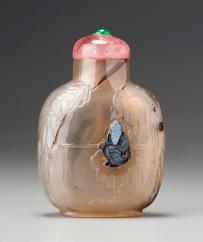
Expert’s note: The work of the artistic genius ‘Cameo Ink-play Master’ is analyzed and discussed in detail by Hugh Moss, Victor Graham, and Ka Bo Tsang in A Treasury of Chinese Snuff Bottles: The Mary and George Bloch Collection, volume 2, numbers 319-325. With the aid of these examples, it becomes quite clear that a single hand is at work, as the group exhibits stylistic motifs which are highly individualistic and do not appear on most cameo agate-style bottles. All these characteristics are apparent on the present bottle. It is remarkably well hollowed and polished on the exterior to a magnificent gloss. There is a whitish inclusion on the front which is skillfully used to depict the face. All areas of colored material have been incorporated into the design. Other areas of the design are carved directly onto the colorless ground. Two signature motifs are present in the current snuff bottle: the single brown prunus blossom (see ibidem, number 319), and the use of a horizontal band of color near the neck to depict part of a branch in the manner of a brushstroke (see ibidem, number 325).
China, Beijing, 1770-1860. Of ovoid shape supported on a well-carved foot rim, finely carved to the front with Huang Chenyen riding a donkey, followed by a boy attendant carrying a spray of prunus. The reverse carved with a bird swooping towards a prunus branch, with a smaller spray on the neck.
Provenance: Robert Kleiner & Co. Ltd., London, United Kingdom, 2002. A private collection in the United Kingdom, acquired from the above. A copy of the original invoice from Robert Kleiner & Co. Ltd., dated 25 November 2002, describing the present lot as a chalcedony snuff bottle, confirming the attribution to the Cameo Ink-play Master and the dating above, and stating a purchase price for the present lot of GBP 6,000 or approx. EUR 15,500 (converted and adjusted for inflation at the time of writing), accompanies this lot. Robert Kleiner (1948-2014) was an important expert of Chinese snuff bottles, beginning his lengthy career at the Sotheby’s Chinese Art department in London. Along with Hugh Moss and Bob Hall, he became a key advisor to the Mary and George Bloch collection, and it was Robert who wrote and produced the very first catalog of their bottles.
Condition: Excellent condition with minor old wear and microscopic nibbling to exposed areas, possibly inherent to carving. The stone with natural fissures and inclusions.
Stopper: Carnelian
Weight: 97.7 g
Dimensions:
Huang Chengyan was a reclusive scholar who lived during the late Eastern Han dynasty. He was known for being carefree and open-minded. He is also a minor character in the 14th century historical novel Romance of the Three Kingdoms, which romanticizes the historical events before and during the Three Kingdoms period. He first appeared in Chapter 37 when Liu Bei, Guan Yu and Zhang Fei were visiting the house of Zhuge Liang, a chancellor and regent of the state of Shu Han who married Huang’s daughter. He appeared then again in Chapter 84 after the Battle of Xiaoting, in which he led Lu Xun out of Zhuge Liang’s Stone Sentinel Maze.
AUCTION RESULT COMPARISON
Type: Closely related
Auction: Bonhams Hong Kong, 28 November 2011, lot 11
Price: HKD 644,000 or approx. EUR 104,000 converted and adjusted for inflation at the time of writing
Description: A dendritic agate ‘Lu Shang’ snuff bottle, the Cameo Ink-play Master, possibly imperial, official school, 1770-1860
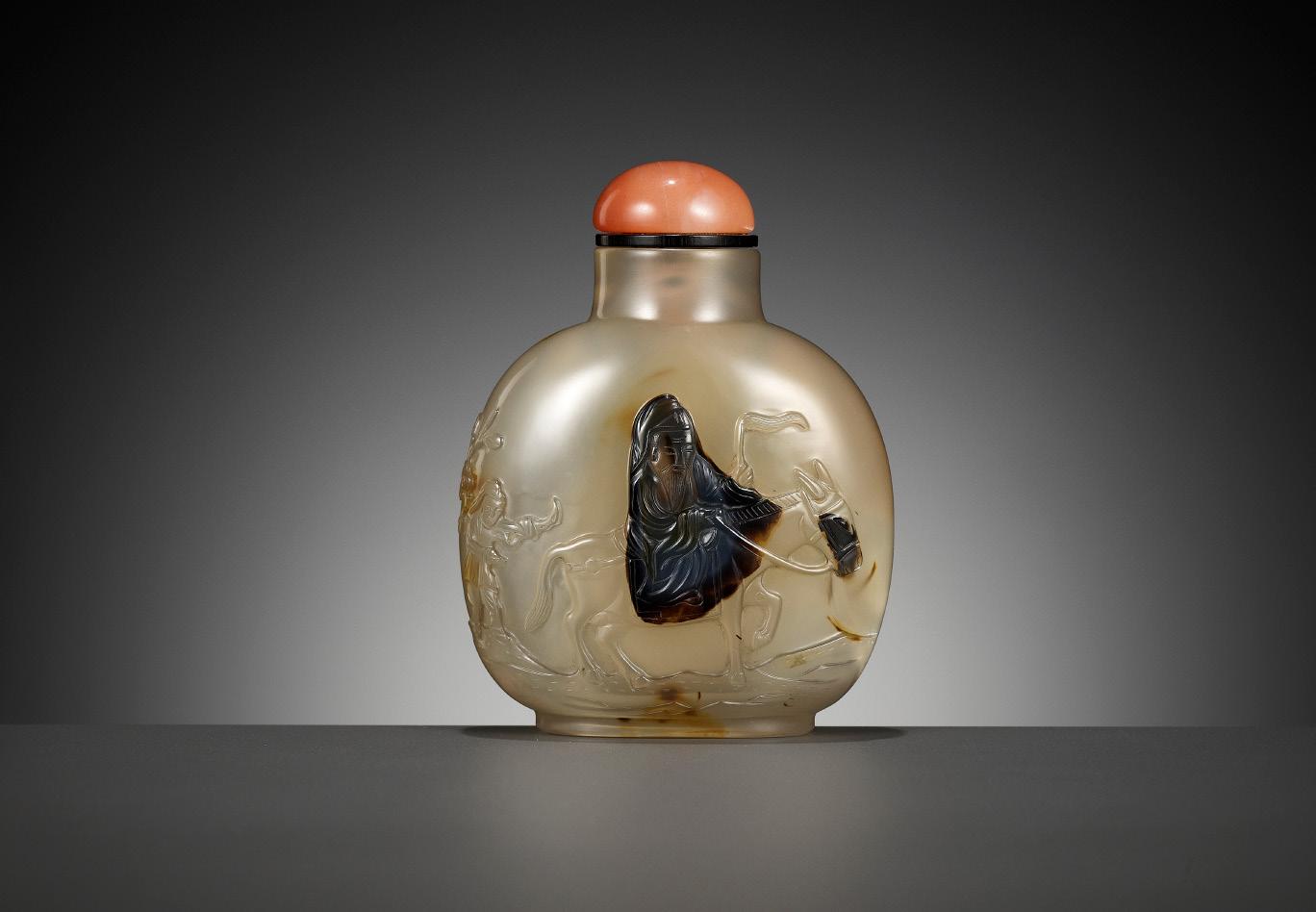
Expert remark: Compare the closely related manner and style of carving, see also expert’s note above for further details. Note that this bottle is also attributed to the Cameo Ink-play Master.
Estimate EUR 8,000
Starting price EUR 4,000

79 50
Height 77 mm, Diameter neck 21 mm and mouth 8.5 mm
A TURQUOISE
MATRIX SNUFF BOTTLE, CHINA, 18TH CENTURY
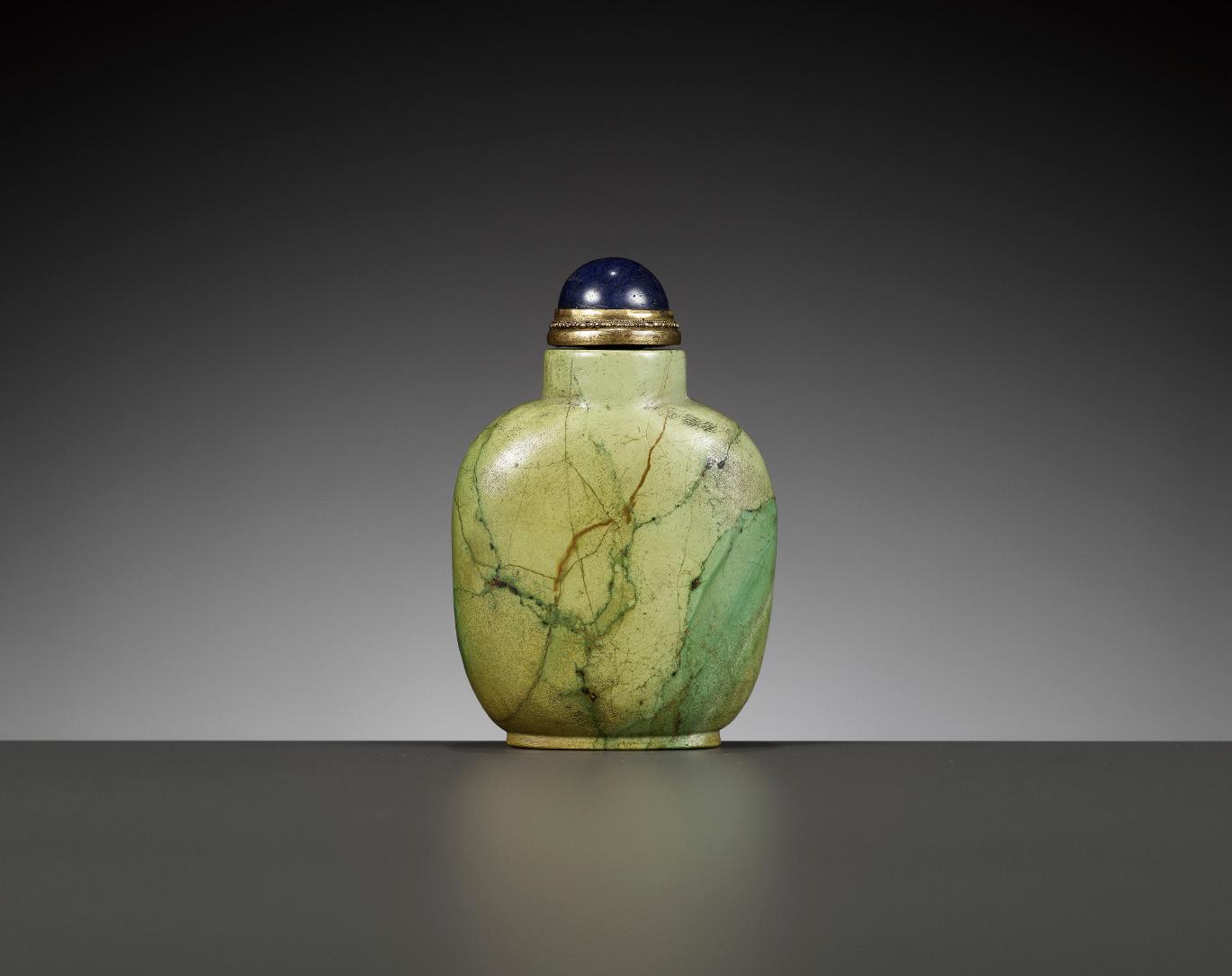
Of flattened form, well hollowed, the rounded rectangular body supported on an oval foot rising to a short cylindrical neck with a narrow mouth. The stone of variegated turquoise and green tones, some areas with a yellowish tinge, and dramatic dark blue veining of the matrix on either side.
Provenance: From a prominent New York snuff bottle collector. Condition: Very good condition with expected old wear and some organic weathering. The stone with natural fissures, some of which may have developed into small hairline cracks over time. Very minor nicks around the rim.
Stopper: Sapphire with a beaded gilt metal collar, probably matching and also dating to the 18th century
Weight: 83.9 g
Dimensions: Height including stopper 68 mm. Diameter neck 19.5 mm and mouth 6 mm.
The universal gem standard for turquoise is that the more brilliant the sky-blue color, the more valuable the stone, but in China, it is clear that both green and blue veined material was equally valued. The evidence lies in snuff bottles made from other materials that evoke turquoise. Of the entire turquoise range of Qing glass snuff bottles, many more are of a green tint than a sky-blue one. Porcelain imitations of the material are even more informative. Both the green and blue varieties were regularly copied during the mid-Qing period. One of the finest imitation turquoise bottles is in the Ault Collection (Kleiner 1990, no. 131). It probably dates from the late eighteenth century and is of a distinctly green color. In the same publication, a magnificent and unique porcelain bottle made for the Master of the Xie Bamboos, whose hall name appears on other known porcelains of the first half of the nineteenth century, simulates a turquoise-matrix bottle with panels of calligraphy in iron-red on white. Not only is the color unambiguously green, it is as riddled with black matrix markings as any of the real material carved into bottles.
Expert’s note: Whatever the color of the material may have meant, this example is intriguingly marked with some well-figured matrix, unusual speckling across both faces of the bottle, and intriguing darker staining, possibly partly due to handling but too well defined to stem purely from patination. This is one of the star turquoise bottles known, of lovely color and material. It is also superbly formed, with matching perfection of finish. Therefore, this bottle can be firmly dated to the 18th century.
Literature comparison: For a related snuff bottle, see Michael Hughes, The Chester Beatty Library, Dublin. Chinese Snuff Bottles, The International Snuff Bottle Society, Baltimore, 2009, page 190, pl. 151.
AUCTION RESULT COMPARISON
Type: Closely related
Auction: Sotheby’s Hong Kong, 25 May 2014, lot 1068
Price: HKD 237,500 or approx. EUR 34,500 converted and adjusted for inflation at the time of writing
Description: A turquoise matrix snuff bottle, Qing dynasty, 18th / 19th century
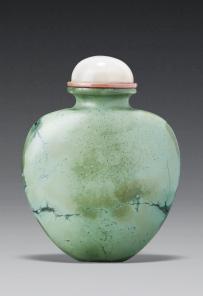
Expert remark: Compare the closely related color. Note the different form.
Estimate EUR 3,000
Starting price EUR 1,500
80 51
52 AN IMPERIAL CINNABAR LACQUER
‘ZHANG
SHENG’S DREAM’ SNUFF BOTTLE, CHINA, 1730-1830
Attributed to the Palace Workshops, Beijing. Of flattened ovoid form, deeply carved through the layers of cinnabar lacquer with a continuous landscape scene divided by rockwork and trees, one side with Zhang Sheng sleeping at his desk on a covered porch, as he sleeps a wispy line representing the dreams of the young scholar swirls above his head, flowing and spreading into the other side of the bottle showing him in a passionate embrace with his forbidden love, Cui Yingying, all on a variety of diaper grounds.
Provenance: Galerie Max in Brussels, Belgium, 19 February 1966 (according to an ancient family ledger inspected by Cabinet Portier, Paris, France, during their appraisal of the complete de Strycker estate; this ledger remains in the possession of the de Strycker family and may not be copied).
Collection of Robert and Isabelle de Strycker, acquired from the above and thence by descent in the same family. Robert de Strycker (1903-1968) and his wife Isabelle (1915-2010) first encountered Chinese art at the British Museum during a stay in London. Enamored with both its style and beauty, they began to study and collect Chinese works of art in 1938, mostly buying from Belgian, Parisian, and English dealers. They kept close contact with the famous English collector Sir Harry Garner (18911977) and noted Czech collector and expert Fritz Low-Beer (1906-1976).
Condition: Good condition with minor wear and expected manufacturing irregularities, small natural age cracks, minuscule nicks, and a few tiny losses and old fills.
Stopper: Matching chrysanthemum-form cinnabar lacquer stopper with a gilt bronze knop and platelet, metal spoon
Weight: 64.6 g
Dimensions: Height including stopper 7.2 cm. Diameter neck 1.9 cm and mouth 0.5 cm
This is a classic imperial lacquer snuff bottle on bronze. The group of bottles represents masterly carving in lacquer that is splendidly sculptural and covers a range of delightful subject matter, usually drawn from popular dramas, operas or novels, or myths and legends. We can be sure that the group as a whole was imperial, even if we cannot be sure that every last example was made for the court. If they were for example made in Suzhou, the same workshops might have made a few pieces for private sale as well.
The snuff bottle depicts a famous scene from the Romance of the Western Chamber, written by Wang Shifu (1250-1300), a story immensely popular with all levels of society. Woodblock illustrations in the many editions helped conventionalize images that were instantly recognizable to the public, thus creating a corpus of motifs that was widely used by jade carvers, painters, silk embroiderers, lacquer workers, and other craftsmen.
Professor Herbert Giles, whose History of Chinese Literature was published in 1924, refers to The Xixiang Ji as the play ‘which will best repay reading’. It is the typical story where a handsome student and a beautiful girl attempt to cross the social divide, aided and incited by the girl’s maid. The dialogue is punctuated with images of wind, snow, moonlight, and flowers, emphasizing both the passion and the romance felt by the struggling couple.

Literature comparison: Four cinnabar lacquer bottles from this group carved with figural scenes are in the Qing Court Collection in the Palace Museum, Beijing, and are illustrated in Masterpieces of Snuff Bottles in the Palace Museum, Beijing, 1995, pp. 187-90, nos. 192-95. Another is illustrated in Moss, Graham, Tsang, A Treasury of Chinese Snuff Bottles, The Mary and George Bloch Collection, Vol. 7, Part 1, Hong Kong, 2009, pp. 175-82, no. 1538.
AUCTION RESULT COMPARISON
Type: Closely related
Auction: Christie’s New York, 22 March 2007, lot 7
Price: USD 20,400 or approx. EUR 28,000 converted and adjusted for inflation at the time of writing
Description: A fine carved lacquer snuff bottle, probably Imperial, attributed to the Palace workshops, Beijing, 1730-1820
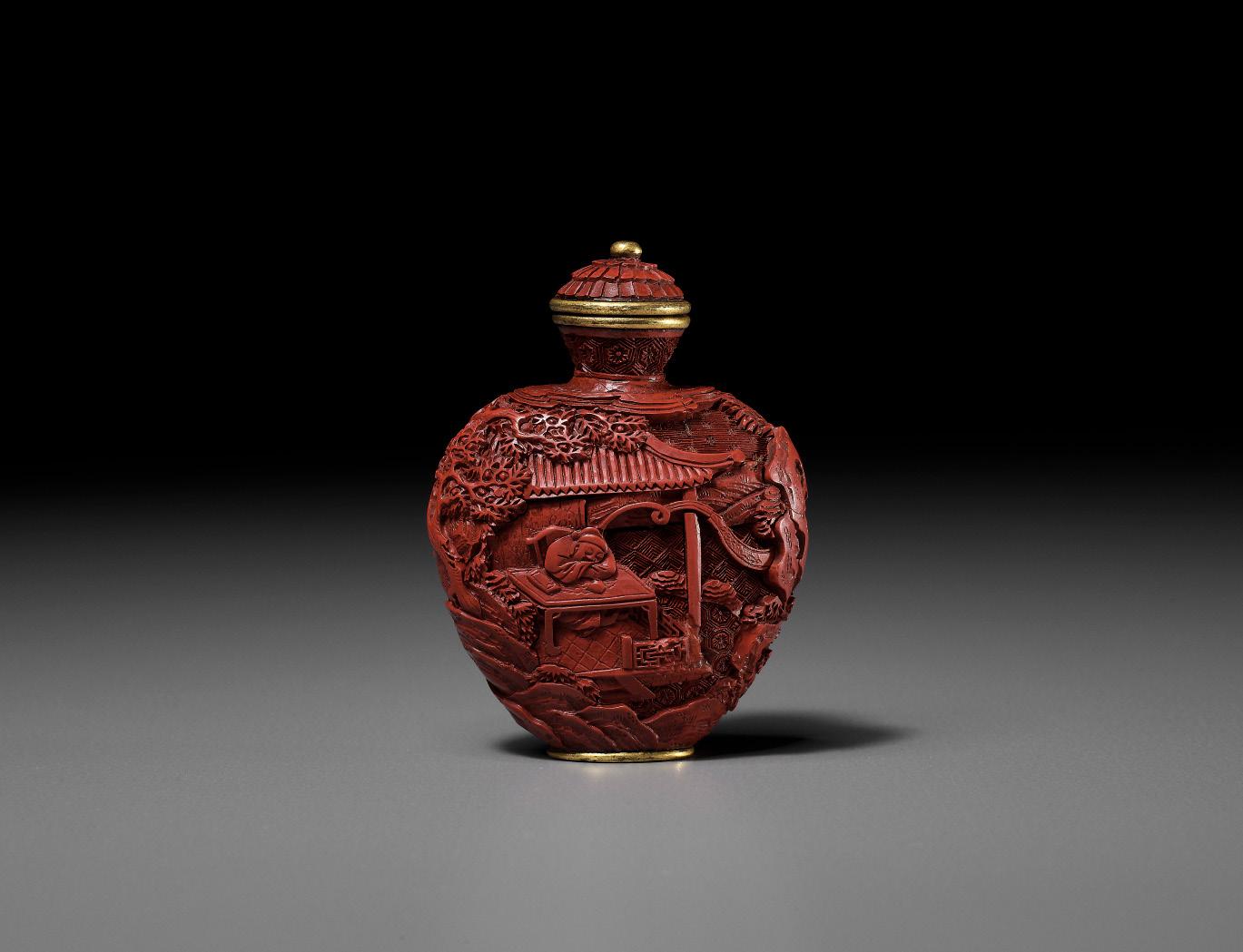
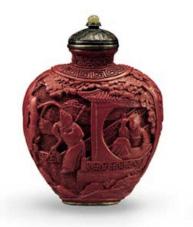
Expert remark: Note the size (6.35 cm)
Estimate EUR 4,000
Starting price EUR 2,000
81
Isabelle and Robert de Strycker, c. 1930-1935
AN INSIDE-PAINTED GLASS ‘FISH AND INSECTS’ SNUFF BOTTLE, BY ZHOU LEYUAN, CHINA, DATED 1890
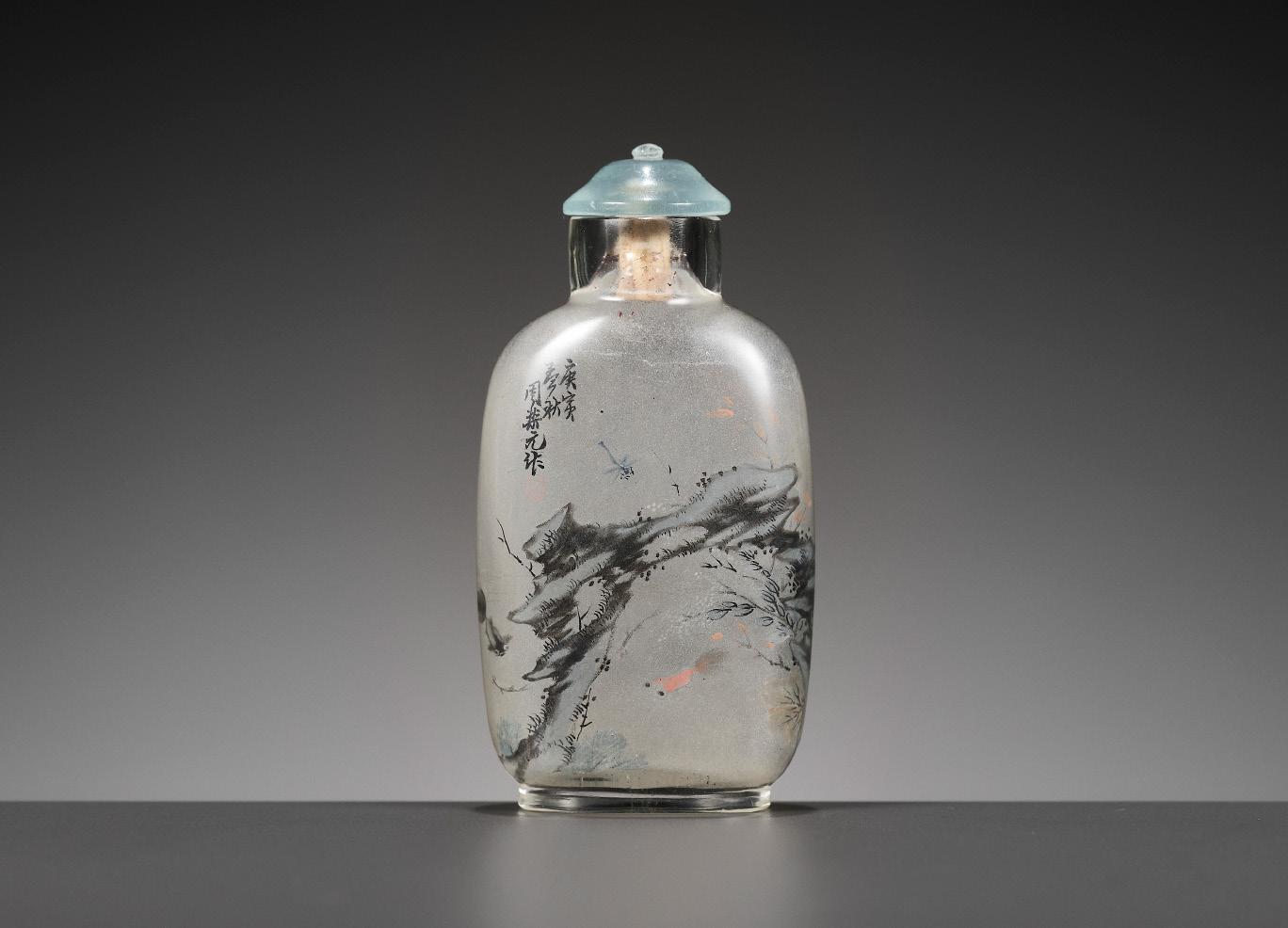
Expert’s note: According to Hugh Moss, ‘Zhou Leyuan began to paint this subject of fish and insects with a grassy rock bank quite early in his career, but most of the subject date from 1891 and 1892, the last two full years of production when it obviously became a popular part of his repertoire. Although Zhou repeated subjects, he never repeated compositions, every single bottle being re-thought as a work of art, unlike most of his contemporary artists who were largely decorative and repeated both subjects and compositions frequently. This is the form the subject generally takes in these later years, with the grassy bank wrapped around the bottle, but this is an early version of the classic subject.’
Of flattened form, the rounded rectangular body supported on a rimmed oval foot, rising to a slightly flared cylindrical neck with a flat lip. Powerfully painted bold rocks next to a meandering stream with some celestial eye goldfish and a catfish, and buzzing dragonflies and beetles above.
Inscriptions: To one side, signed ‘Zhou Leyuan’ and dated ‘In the first Autumn month of 1890’. One red seal, ‘Yuanyin’.
Provenance: Hugh Moss Ltd., Hong Kong, November 1997.
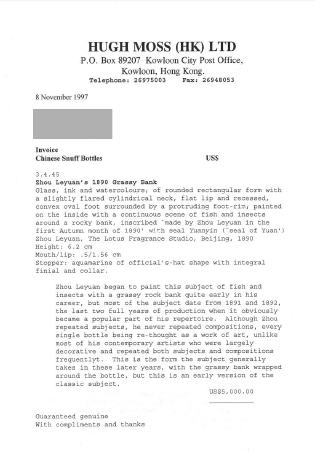
Collection of Dr. Elsa R. Graser, Baltimore, USA, acquired from the above. Collection of Cynthia G. Locke, inherited from the above and thence by descent. The base with an old collector’s label, ‘3445’. A copy of the original invoice from Hugh Moss Ltd., Hong Kong, dated 8 November 1997, stating a purchase price of USD 5,000 or approx. EUR 8,800 (converted and adjusted for inflation at the time of writing), accompanies this lot. Also with a copy of a letter written and signed by Hugh Moss, addressed to Elsa Graser, dated 10 November 1997, noting that Zhou Leyuan is Moss’s favorite inside painting artist and in his opinion incredibly better than most of the others.’ Hugh Moss (b. 1943) is an author, dealer, artist, lifelong collector, and enthusiast of Chinese art, and the foremost authority on Chinese snuff bottles. Elsa R. Graser was a teacher of Latin and English and one of the first women on the faculty of the Baltimore Polytechnic Institute. An avid collector of snuff bottles, she served as editor of the Journal of the International Chinese Snuff Bottle Society. Her daughter Cynthia Graser Locke (19232019) also collected snuff bottles and lived in Duxbury, Massachusetts. Condition: Very good condition with minor wear and slight fading of colors and seal.
Stopper: Aquamarine, neatly carved in ‘Beijing’ style in the shape of an official’s hat, complete with integral finial and collar
Weight: 32.8 g
Dimensions: Height including stopper 68 mm. Diameter neck 15 mm and mouth 6 mm.
Zhou Leyuan is the founder of the popular Beijing school of painting. His career spanned the period from 1881 to 1893. Every single artist of the first phase of the school owed a considerable debt to Zhou, and most began their careers by copying his style and signing his name. Some even devoted most of their careers to producing copies of his work. Hugh Moss has described Zhou Leyuan as ‘the single most important artist in the entire field of inside-painted snuff bottles’.
AUCTION RESULT COMPARISON
Type: Closely related
Auction: Bonhams Hong Kong, 28 November 2011, lot 4
Price: HKD 84,000 or approx. EUR 14,000 adjusted for inflation at the time of writing
Description: An inside-painted glass ‘goldfish’ snuff bottle, Zhou Leyuan, dated 1890

Expert remark: Compare the closely related composition, form, and size (6.2 cm).

Estimate EUR 8,000
Starting price EUR 4,000
82 53
Hugh Moss (c. 1970)
AN INSIDE-PAINTED GLASS
‘CAT’ SNUFF BOTTLE, BY WANG XISAN, CHINA, DATED 1959
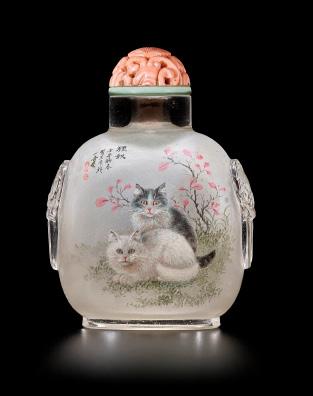
Expert’s note: Between 1958 and 1962, Wang Xisan often used a simplified form of the character ‘Xi’ in his signature. From 1963 onwards, he used the traditional form of this character. The artist’s early works are exceedingly rare. For more snuff bottles painted by Wang Xisan from 1959 to 1962, signed with a simplified ‘Xi’ character, see Wang Ziyong, 60 Years of Wang Xisan’s Art Life, Hebei Fine Arts Publishing House, pages 14-15 and 21-23.
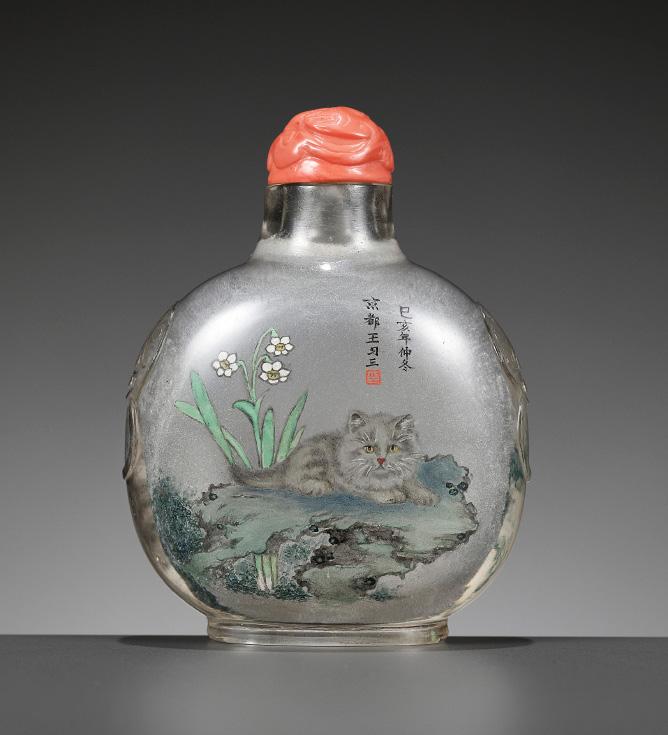
The flattened globular body raised on a short oval foot and surmounted by a cylindrical neck with flat lip, the shoulders well carved with lion masks suspending mock ring handles in high relief. Masterfully painted to one side with a cat in a rocky landscape amid blooming narcissus. The other side with a prancing cat chasing two butterflies.
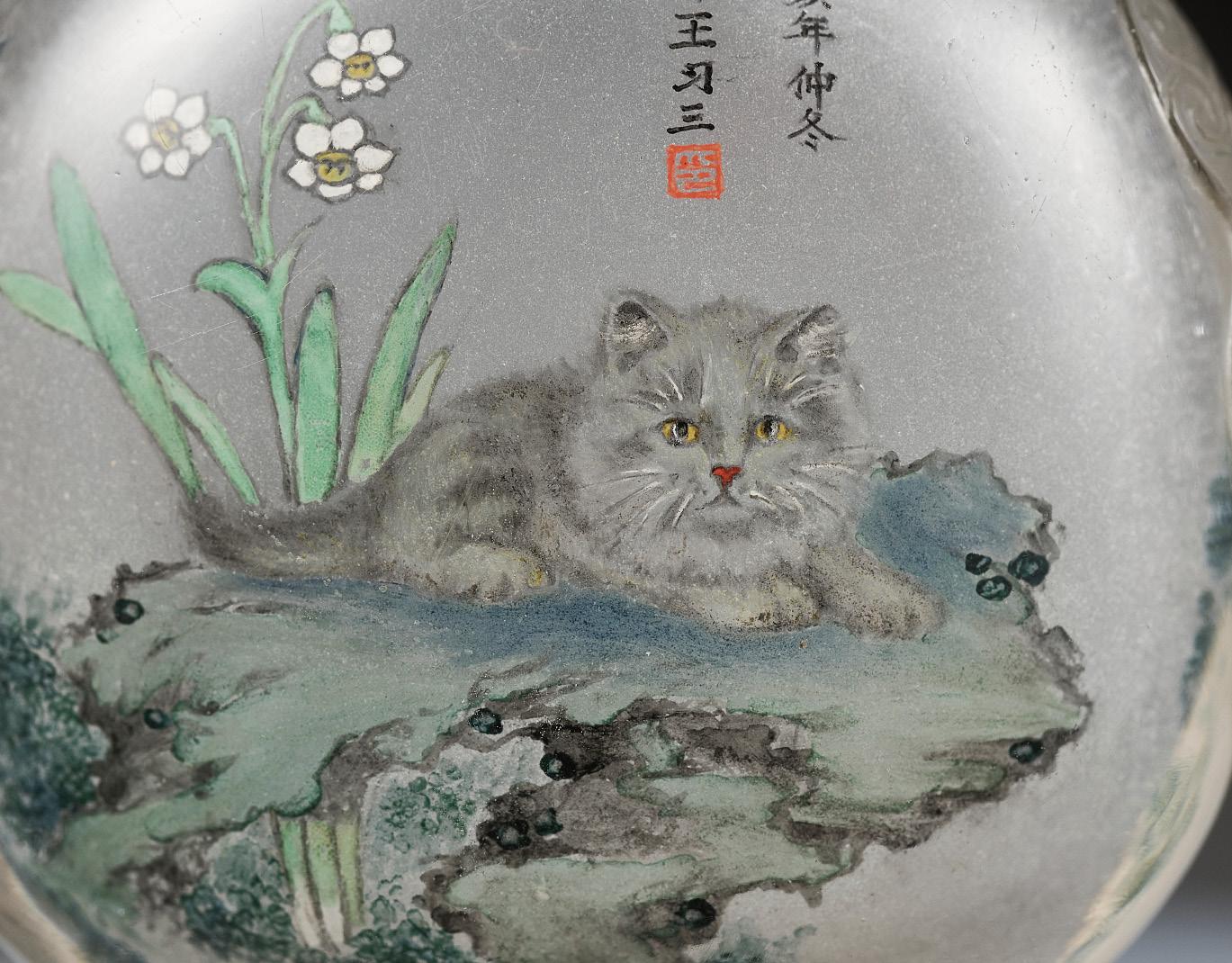
Inscriptions: To one side, signed ‘Wang Xisan’ and dated ‘jihai nian zhongdong’ (mid-winter of 1959). One red seal.
Provenance: From a private collection in San Diego, California, USA. Condition: Very good condition with only minor wear, expected manufacturing irregularities, and few minuscule nicks.
Stopper: Finely carved coral with chilong decoration, most likely matching
Weight: 62.9 g
Dimensions: Height including stopper 66 mm. Diameter neck 15 mm and mouth 8 mm.
Born in 1938, Wang Xisan (Wang Ruicheng) was the star pupil of Ye Bengqi, the son of Ye Zhongsan, the artist who revitalized the Beijing school of painting in the late 1950s. Ye Bengqi took up the art of enameling again in the early 1960s to teach Wang Xisan, and with earlier Wang Xisan bottles, it is sometimes difficult to distinguish them from his teacher’s, or, in some cases, from earlier Qianlong examples. For a discussion on the artist Wang Xisan see H. Moss, V. Graham and K.B. Tsang, A Treasury of Chinese Snuff Bottles, the Mary and George Bloch Collection, Vol. 6, Part 1, Hong Kong, 2008, pp. 273-275. The authors note: ‘As an artistic genius, Wang rapidly became one of the finest of all enamellers, both artistically and technically, that China has ever produced’.
AUCTION RESULT COMPARISON
Type: Closely related
Auction: Bonhams New York, 19 March 2018, lot 8000
Price: USD 25,000 or approx. EUR 28,000 adjusted for inflation at the time of writing
Description: An inside painted crystal snuff bottle, Wang Xisan, 1972 Expert remark: Compare the closely related subject and form. Note that this bottle is a later version of the present lot and that it is made from crystal. Also note the similar stopper.
Estimate EUR 8,000
Starting price EUR 4,000
54
A SAPPHIRE-BLUE GLASS OVERLAY ‘LOTUS POND’ SNUFF BOTTLE, ATTRIBUTED TO THE IMPERIAL GLASSWORKS, BEIJING, 1750-1790
The baluster body supported on a short foot and rising to a rounded shoulder with tapered neck and thick everted rim. The exterior masterfully carved through the transparent sapphire-blue outer layer to the opaque milky-white ground with a single overlay of lotus growing in clumps of leaves, flowers, and buds from waves around the base.
Provenance: Collection of John Gilmore Ford. The Albemarle Collection, acquired from the above. Robert Kleiner & Co. Ltd.. London, United Kingdom, 2004. A private collection in the United Kingdom, acquired from the above. A copy of the original invoice from Robert Kleiner & Co. Ltd., dated 30 September 2004, confirming the Imperial attribution and dating above, and stating a purchase price for the present lot of GBP 5,500 or approx. EUR 13,000 (converted and adjusted for inflation at the time of writing), accompanies this lot. John Gilmore Ford, former president of the International Chinese Snuff Bottle Society, is a widely respected collector of Asian art, beginning his highly important collection already in his early twenties. He was strongly influenced by his godfather, Edward Choate O’Dell, the founder of the Chinese Snuff Bottle Society. Gary Vikan, director of the Walters Art Museum in Baltimore, has said that “Ford, more than anyone, has assumed the mantle of the collector whose scope and ambition has a civic dimension.”
Condition: Pristine condition with minor surface wear, and some manufacturing irregularities.
Stopper: Gilt bronze
Weight: 39.9 g
Dimensions: Height incl. stopper 83 mm, Diameter neck 18mm and mouth 7 mm
Literature comparison: Compare a closely related snuff bottle with green overlay in the Marquess of Exeter’s Collection, illustrated by Robert Kleiner, Chinese Snuff Bottles from the Burghley House Collection, London, 1989, cat. no. 20.
AUCTION RESULT COMPARISON
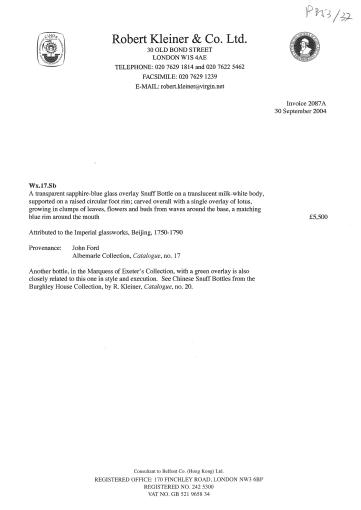
Type: Closely related
Auction: Bonhams Hong Kong, 28 November 2011, lot 152
Price: HKD 300,000 or approx. EUR 48,500 converted and adjusted for inflation at the time of writing
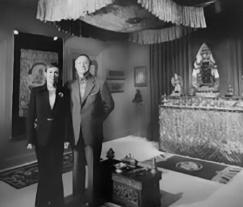
Description: A sapphire-blue glass overlay ‘floral’ snuff bottle, 1740-1780

Expert remark: Compare the closely related form, color, and manner of carving. Note the different floral decoration and the size (61 mm). Note further that this bottle is attributed to the Imperial glassworks in Beijing, exactly like the present lot.
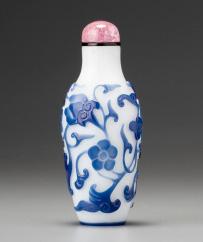
Estimate EUR 6,000
Starting price EUR 3,000
84 55
John and Berthe Ford standing in a Tibetan shrine within their home, 2001
AN INSCRIBED RED-OVERLAY WHITE GLASS SNUFF BOTTLE, ATTRIBUTED TO LI JUNTING, YANGZHOU SCHOOL, CHINA, DATED 1822

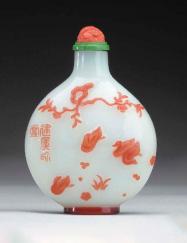
Expert’s note: Although unsigned, this bottle can be confidently attributed to the master glass carver Li Junting, one of the most important and innovative of all Qing glass artists, also one of the very few we can identify by name. Li’s bottles are among the finest of the low-relief works of the school he headed, believed to have been at Yangzhou, and this superb example is no exception. Dated Yangzhou bottles are rather rare, but have been recorded with dates between 1819 and 1822.
Inscriptions: To one side on the shoulder, dated to the Year of Renwu (corresponding to 1822), and to the other side with the seal ‘Zhengye’ (good luck).
Of flattened spherical form, finely carved through the ruby-red outer layer to the milky-white ground to one side with two boys stirring a pot, above scattered sprigs, a tea kettle, and a cup, below an inscription on the shoulder giving the cyclical date, the reverse with a boy holding up a branch and kneeling beside a recumbent water-buffalo pulling a tethered melon, with butterflies hovering above and a seal Zhengye, the shoulders carved with fruiting double-gourd sprays.
Provenance: Collection of Margaret Polak, California, USA. Robert Kleiner & Co. Ltd., London, United Kingdom, 2007. A private collection in the United Kingdom, acquired from the above. A copy of the original invoice from Robert Kleiner & Co. Ltd., dated 2 July 2007, confirming the attribution to Li Junting above, and stating a purchase price for the present lot of GBP 5,500 or approx. EUR 13,000 (converted and adjusted for inflation at the time of writing), accompanies this lot. Margaret Polak was a passionate collector of Chinese snuff bottles. She wrote articles for the Journal of the ICSBS, and part of her collection was exhibited at the Art Gallery of New South Wales in 1991. In 2006, she gifted parts of her extensive snuff bottle collection to the Asian Art Museum of San Francisco. Robert Kleiner (1948-2014) was an important expert of Chinese snuff bottles, beginning his long career at Sotheby’s in London. Along with Hugh Moss and Bob Hall, he became a key advisor to the Mary and George Bloch collection, and it was Robert who wrote and produced the very first catalog of their bottles.
Condition: Pristine condition with only minor wear and minuscule manufacturing irregularities.
Stopper: Jasper
Weight: 23.7 g
Dimensions: Height incl. stopper 62 mm, Diameter neck 13 mm and mouth 7 mm
Literature comparison: Compare a closely related snuff bottle attributed to Li Junting, illustrated in Hugh Moss, Victor Graham, and Ka Bo Tsang, A Treasury of Chinese Snuff Bottles: The Mary and George Bloch Collection, vol. 5, Glass, no. 1035. Compare two snuff bottles attributed to Li Junting from the J & J Collection, nos. 402 and 403, illustrated by Moss, Graham, and Tsang in The Art of the Chinese Snuff Bottle. The J & J Collection, Vol. 2.
AUCTION RESULT COMPARISON
Type: Closely related
Auction: Christie’s New York, 21 March 2002, lot 35
Price: USD 17,625 or approx. EUR 27,500 converted and adjusted for inflation at the time of writing

Description: A rare and finely carved red overlay white glass bottle, Li Junting, attributed to Yangzhou, 1805-1825
Expert remark: Compare the closely related form as well as the near-identical colors, with ruby-red overlay on milky-white ground and similar manner of carving. Note the identical size (56 mm, measured without stopper).
Estimate EUR 6,000
Starting price EUR 3,000
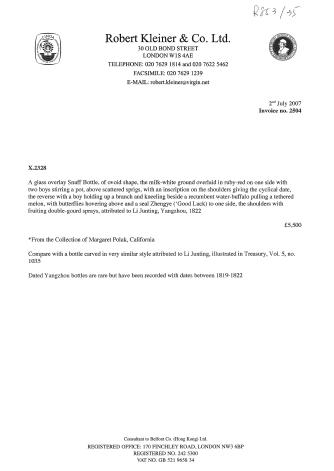
85 56
Robert Kleiner (1948-2014)
AN INSCRIBED OVERLAY GLASS ‘CAT AND BUTTERFLY’ SNUFF BOTTLE, BY WANG SU, YANGZHOU SCHOOL, CHINA, 1820-1840
Inscriptions: To the front, upper right, ‘Xiaomou’ (Little Prunus).
The flattened bottle of rounded rectangular form, superbly carved through the outer olive-brown layer to the translucent milky-white body to one side with a cat seated on a pierced craggy rock beside flowering chrysanthemum, the feline looking up at two butterflies fluttering above. The other side is similarly decorated with sprays of bamboo springing from rockwork. Both sides are separated by sprigs of grass on the shoulders. The front is carved with a three-character inscription.
Provenance: Robert Kleiner & Co. Ltd., London, United Kingdom, 2010. A private collection in the United Kingdom, acquired from the above. A copy of the original invoice from Robert Kleiner & Co. Ltd., dated 30 June 2010, confirming the signature of Wang Su and dating above, and stating the purchase price for the present lot of GBP 5,000 or approx. EUR 10,000 (converted and adjusted for inflation at the time of writing), accompanies this lot. Robert Kleiner (1948-2014) was an important expert of Chinese snuff bottles, beginning his long career at Sotheby’s in London. Along with Hugh Moss and Bob Hall, he became a key advisor to the Mary and George Bloch collection, and it was Robert who wrote and produced the very first catalog of their bottles.
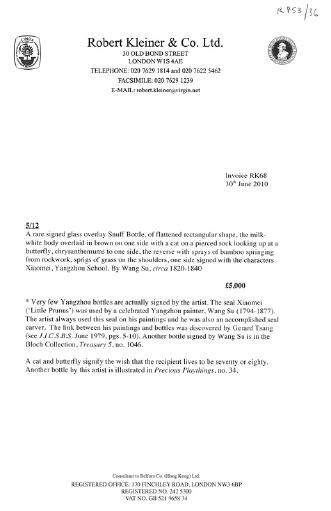
Condition: Superb condition with minimal surface wear, light scratches, and manufacturing irregularities.
Stopper: Glass in imitation of coral
Weight: 39.5 g
Dimensions: Height incl. stopper 75 mm, Diameter neck 14 mm and mouth 6 mm
Wang Su (1794-1877) was a prominent literatus and painter from the Yangzhou area. Very few snuff bottles are actually signed by the artist, who preferred to use the seal ‘Xiaomei’ (‘Little Prunus’), which he always used on his paintings as well. On one documentary bottle in a Hong Kong collection, both names appear together: ‘Xiaomei, Wang Su’ (see JICSBS, Spring 2001, page 23, fig. 26). Wang Su was also an accomplished seal carver. He seems to have lived his life in Yangzhou, was a professional painter who achieved a level of fame early in life, and probably was able to commission snuff bottles with his name on them. The earliest dated Xiaomei-signed bottle was made in 1821 (JICSBS Spring 2011, page 23, fig. 29), when he was in his late twenties and beginning to be known locally. He became more widely known and acknowledged as an artist only later in his career.
Cats and butterflies are symbols of longevity. The cat (mao) is a homonym for ‘seventy’, while the butterfly (die) shares the same sound as ‘eighty’. Together, they form a rebus for maodie. This term implies that one would live to be seventy or eighty — considered high age in ancient China.
Literature comparison: Wang Su’s name appears on a small group of bottles from the Li Junting School, including one in the Bloch Collection, illustrated Hugh Moss, Victor Graham, and Ka Bo Tsang, A Treasury of Chinese Snuff Bottles: The Mary and George Bloch Collection, Vol. 5, Glass, no. 1046. Compare another snuff bottle by Wang Su, illustrated in Robert Kleiner, Previous Playthings: Important Chinese Snuff Bottles From the Mack Collection, 2000, no. 34.

AUCTION RESULT COMPARISON
Type: Closely related
Auction: Bonhams Hong Kong, 25 May 2011, lot 63
Price: HKD 120,000 or approx. EUR 19,500 converted and adjusted for inflation at the time of writing
Description: An inscribed olive-brown glass overlay ‘hunter and fisherman’ snuff bottle, Sun Shihua, probably Yangzhou, 1807-1867
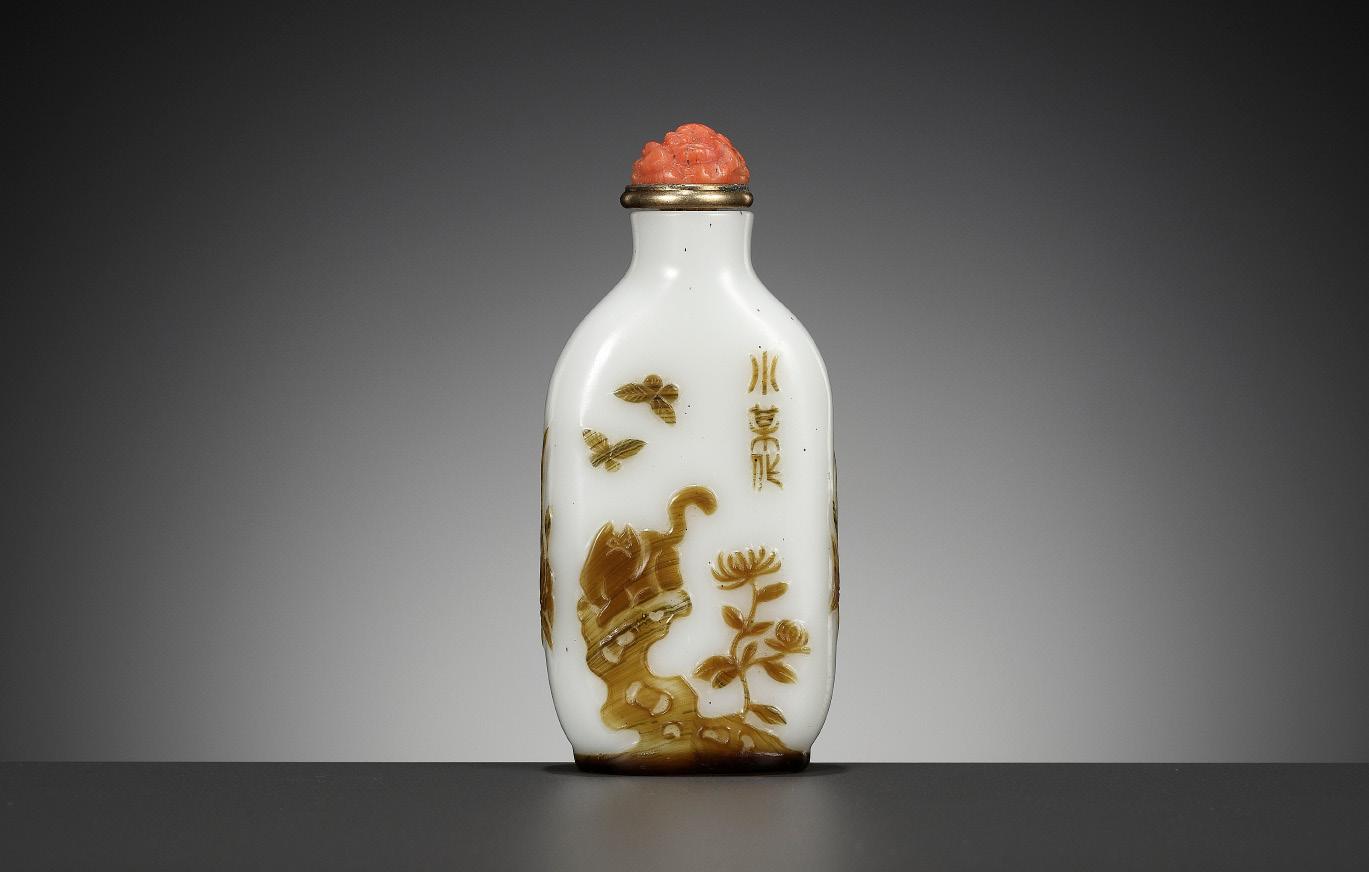

Expert remark: Compare the closely related form, color with similar olive-brown overlay on milky-white ground, and manner of carving. Note the size (68 mm) and the different inscription.
Estimate EUR 6,000
Starting price EUR 3,000
86 57
Robert Kleiner (1948-2014)
AN IMPERIAL ‘REALGAR’ GLASS SNUFF BOTTLE, ATTRIBUTED TO THE PALACE WORKSHOPS, QIANLONG MARK AND PERIOD
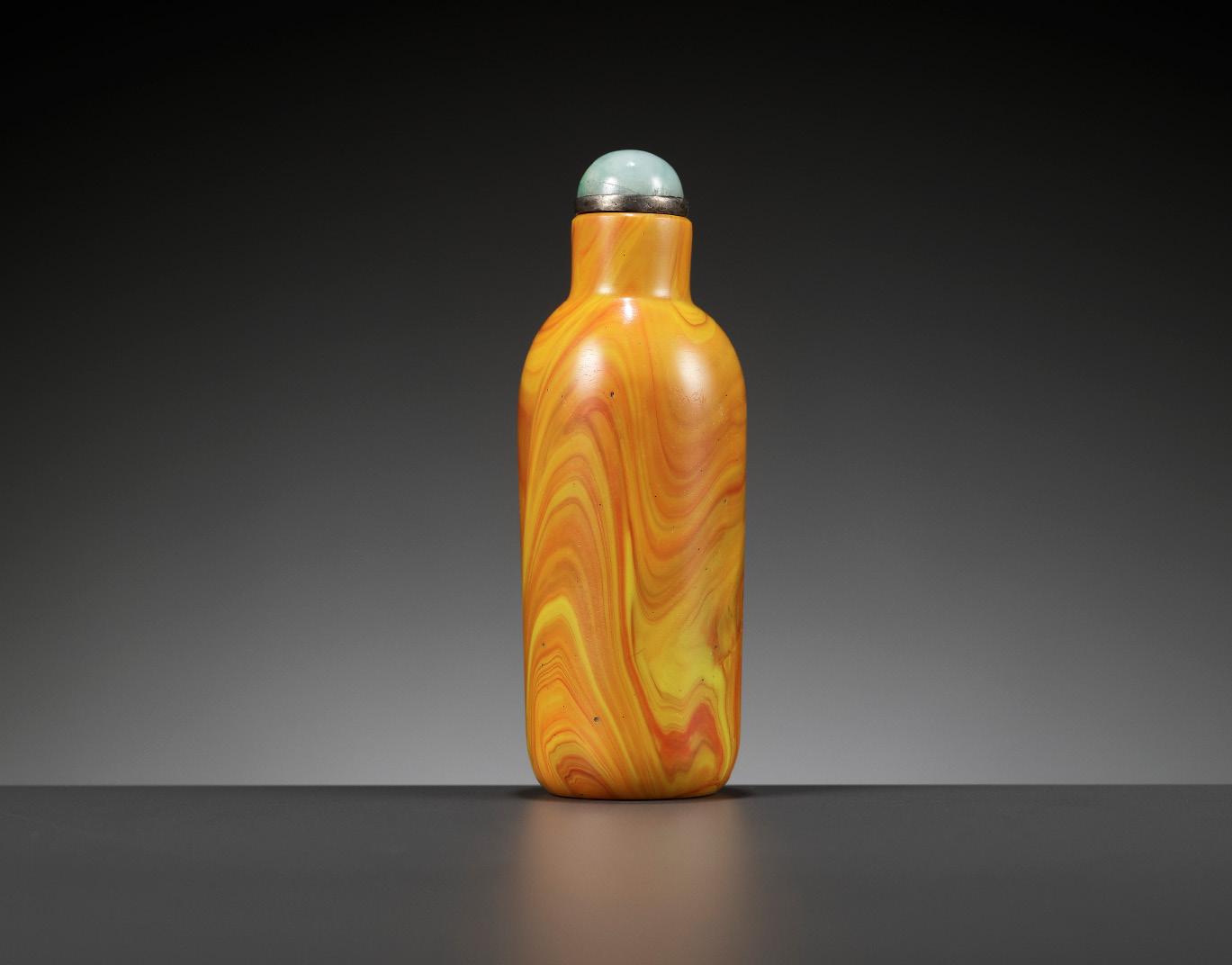
China, Beijing, 1736-1795. Swirled together of brilliant fiery orange and yellow-ochre opaque glass to resemble the realgar mineral, the tall cylindrical body with a tapered foot with flat base and rounded shoulder surmounted by a tall neck with a wide mouth. The base wheel-cut with a four-character mark Qianlong nianzhi and of the period.
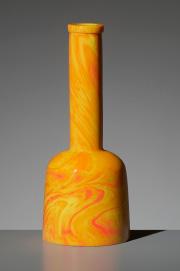
Provenance: From a noted private collection in Bavaria, Germany. Condition: Excellent condition with only minor old wear and expected manufacturing irregularities.
Stopper: Jadeite
Weight: 94.5 g
Dimensions: Height including stopper 91 mm. Diameter neck 16 mm and mouth 9 mm.
The naturalistic pattern achieved on realgar glass makes vessels of this type attractive and unique. Hugh Moss and Gerard Tsang in Arts from the Scholar’s Studio, op. cit., p. 126, note that the “swirling patterns visible at the surface of this vessel are full of possibilities for the imaginative mind. It may read as a landscape, drifting incense smoke or a variety of strange living creatures, but it also represents the endlessly changing patterns of energy from which all phenomena emanate in the Chinese view, particularly expressed by Daoism. To the Daoist scholar it would be a work of art of subtle complexity and endless fascination, to be enjoyed like incense smoke as a meditative aid.”
Realgar (xiong huang), found in the southern provinces of China, was believed to contain the essence of gold and, possibly for this reason, became a source of fascination despite its poisonous qualities. It is believed that it was mixed in drugs used by Daoists in their quest for the elixir of immortality. It is the Daoist alchemy that made realgar popular to the extent that despite the material’s highly toxic nature and its soft crumbly texture, which does not lend itself to the artisans’ tools without great difficulties, realgar was used for the carving of Daoist figures. For example, a realgar sculpture of the Immortal He Xian Gu, in the British Museum, London, is illustrated in R. Soame Jenyns, Chinese Art, The Minor Arts, II, London, 1965, pl. 200.
The attractiveness of realgar inspired copies to be made in glass such as the present snuff bottle. Richard John Lynn in ‘Technical aspects and Connoisseurship of Snuff Bottles: Late Traditional Chinese Sources’, JICSBS, Summer, 1995, p. 8, mentions Zhou Jixu, a late Qing connoisseur, who believed that realgar glass was among the earliest types of glass made at the Qing Imperial Glassworks. For this reason, the dating of the present snuff bottle can probably be narrowed to c. 1740-1750
Literature comparison: For further discussion on ‘realgar’ glass, see Moss, Graham, Tsang, A Treasury of Chinese Snuff Bottles. The Mary and George Bloch Collection, Vol. 5, Glass, where its likely Imperial origins are discussed.
AUCTION RESULT COMPARISON
Type: Related
Auction: Galerie Zacke, Vienna, 5 March 2021, lot 15
Price: EUR 9,480 or approx. EUR 11,000 adjusted for inflation at the time of writing
Description: An Imperial ‘realgar’ glass mallet vase, Qianlong mark and period
Expert remark: Compare the closely related color and wheel-cut reign mark. Note the different form and the size (15.6 cm).
AUCTION RESULT COMPARISON
Type: Related
Auction: Sotheby’s Hong Kong, 7 October 2009, lot 1819
Price: HKD 1,460,000 or approx. EUR 244,000 converted and adjusted for inflation at the time of writing
Description: A realgar glass dish, Palace Workshops, mark and period of Qianlong
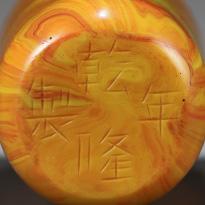

Expert remark: Compare the closely related color and wheel-cut reign mark. Note the different form and the size (17.2 cm).
Estimate EUR 4,000
Starting price EUR 2,000
87 58
AN INSCRIBED SAPPHIRE-BLUE OVERLAY GLASS SNUFF BOTTLE, YANGZHOU SCHOOL, CHINA, 1800-1880


Published: Wang & Co., One Man’s Choice II, Beijing, 2009, page 24-25, number 22. The publication confirms the attribution and dating above.
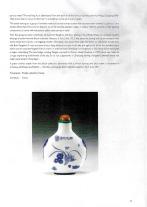
Exhibited: The International Chinese Snuff Bottle Society Convention, Dublin, Ireland, 20-24 October 2009
Inscriptions: To one side, above the boy, ‘chu wu ni er bu ran’ (untainted though having grown from mud) one seal, ‘chen xin ru shui’ (the heart of your humble servant is as pure as water). To the other side, ‘tong xin zhi yan’ (language of the same hearts), one seal, ‘bing hu’ (icy bottle).
Of flattened spherical form with a flat lip and sapphire-blue oval foot rim surrounding a flat recessed base. Exquisitely carved through the outer sapphire-blue layer to the translucent milky-white body with a boy holding up a lotus bud in a sampan floating along a lotus pond. Above the boy is the inscription in Xiao Zhuan (Qin-dynasty seal script). The other side is similarly decorated with a Taihu rock and flowering orchids above a miniature grass planter on its stand as well as a Yixing pottery teapot and a teacup, all below butterflies hovering above and another inscription. The sides are carved with animal masks suspending mock ring handles.
Provenance: A private collection in France. Wang & Co., Beijing, October 2009. A private collection in the United Kingdom, acquired from the above for USD $12,000 or c. EUR 16,000 (converted and adjusted for inflation) according to a short note by the previous owner, of which a copy accompanies this lot. Wang & Co. is a noted gallery for Chinese antiques and works of art based in Beijing, run by Dick Wang, who had previously worked as an expert for Chinese art at Sotheby’s in New York and London. Condition: Magnificent condition with only minor wear and manufacturing irregularities, occasional light scratches.
Stopper: Glass in imitation of coral
Weight: 34.7 g
Dimensions: Height incl. stopper 61 mm, Diameter neck 15 mm and mouth 5 mm
Expert’s note: This bottle belongs to a group of similarly made and carved overlay bottles that may have been ordered by patrons of the scholarofficial class. The composition is painterly as well as scholastic, and the execution is demonstrative of complete mastery of the glass carving skills. The first inscription is a line from Ai Lion Shuo (Ode to the Lotus) by Zhou Dunyi (1017-1073). It compares the beauty of the lotus flower that grows unblemished from mud on the bottom of a pond to virtues men ought to possess. The seal ‘chen xin ru shui’ comes from the Biography of Zheng Chong in the Book of Han. Zheng was head of chancery in the court of Liu Xin who enjoyed the confidence of the Emperor until he began having problems with the Empress Dowager Fu and her court favorite Dong Xian. Zheng was in high demand as an official, but after falling from favor, the Emperor accused Zheng of embezzlement because of his fame. Zheng replied, ‘chen men ru shi, chen xin ru shui’ (It is like a bazaar outside my door, but my heart is as pure as water). The seal ‘bing hu’ is an abbreviation of the last line of the famous four-line poem by Wang Changling (690-756): ‘yi pian bing xin zai yu hu’ (my heart is as bright as crystal ice in a jar of jade).
Literature comparison: Compare a related green overlay glass snuff bottle with a similar scene, illustrated in Hugh Moss, Victor Graham, and Ka Bo Tsang, A Treasury of Chinese Snuff Bottles: The Mary and George Bloch Collection, vol. 5, part 3, no. 1031.
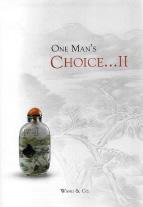
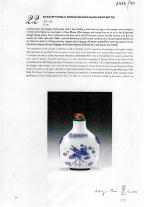
AUCTION RESULT COMPARISON
Type: Closely related
Auction: Bonhams Hong Kong, 28 November 2011, lot 127
Price: HKD 275,000 or approx. EUR 44,500 converted and adjusted for inflation at the time of writing

Description: An inscribed sapphire-blue glass overlay ‘a thousand volume of books’ snuff bottle, Songtai, probably Yangzhou, 1810-1880
Expert remark: Compare the closely related form, sapphire-blue overlay (albeit depicting a different subject), and animal masks with mock handles. Note the size (53 mm).
Estimate EUR 8,000
Starting price EUR 4,000
88 59
A MOLDED AND CARVED ‘DRAGON’ FAMILLE ROSE PORCELAIN SNUFF BOTTLE, SIGNED LIQUAN, CHINA, 1853-1864
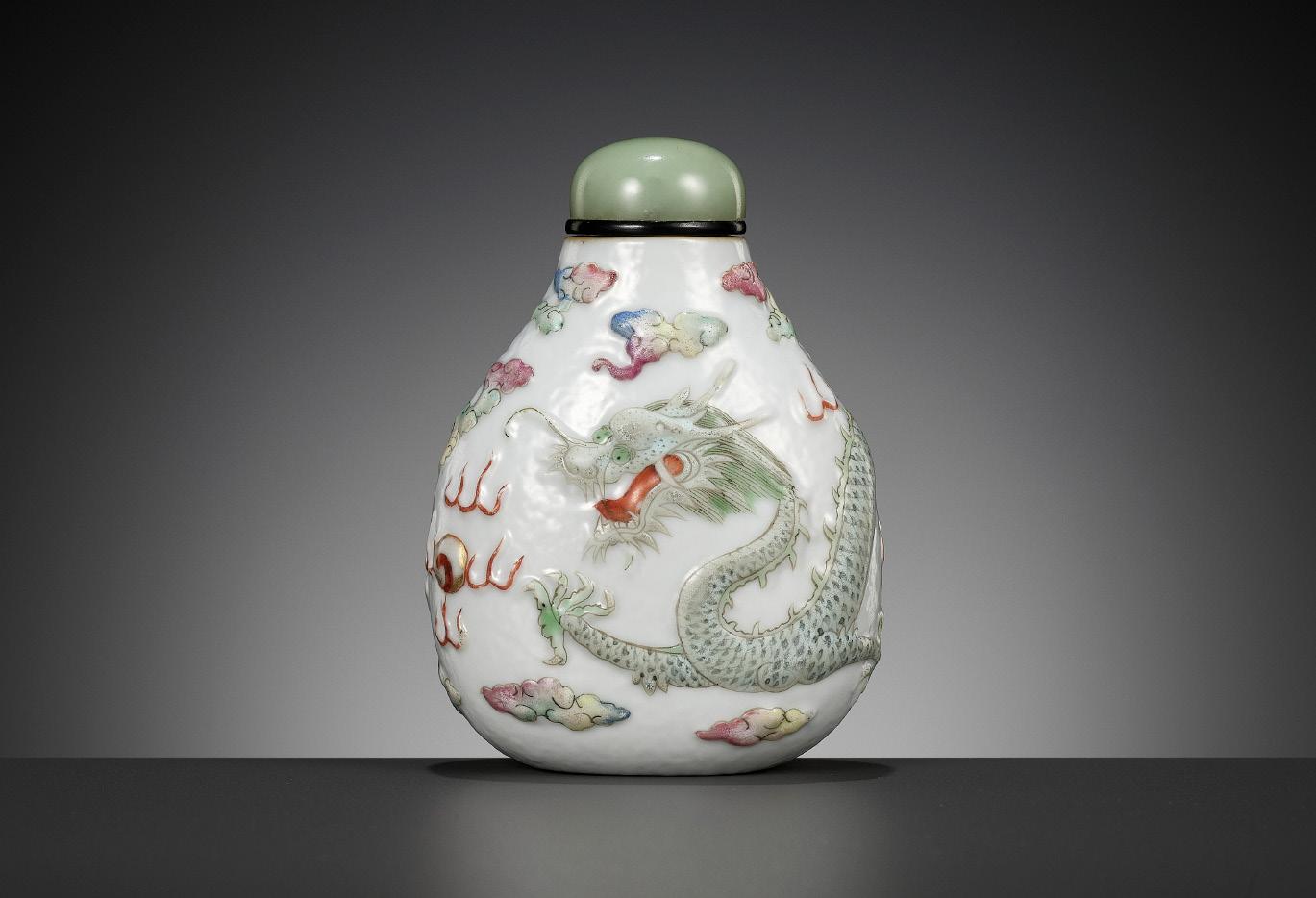
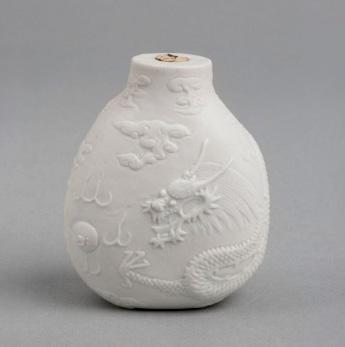
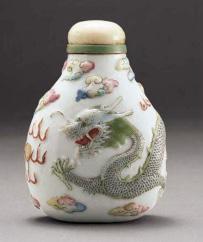
Of pear shape with a wide mouth, finely carved and molded and brightly enameled to depict a fierce five-clawed dragon in high relief with sinuous scaly body chasing a flaming pearl amid colorful swirling clouds. The base with a neatly painted iron-red four-character mark.
Inscriptions: To the base, ‘Liquan zi zhi’ (made by Liquan himself).

Provenance: Collection of John Ault. Robert Kleiner & Co. Ltd., London, United Kingdom, 2005. A private collection in the United Kingdom, acquired from the above. A copy of the original invoice from Robert Kleiner & Co. Ltd., dated 5 July 2005, confirming the dating above, and stating a purchase price for the present lot of GBP 4,250 or approx. EUR 10,000 (converted and adjusted for inflation at the time of writing), accompanies this lot. John Ault (d. 2014) was a British intelligence officer, novelist, and avid collector of Chinese snuff bottles. Robert Kleiner (1948-2014) was an important expert of Chinese snuff bottles, beginning his long career at Sotheby’s in London. Along with Hugh Moss and Bob Hall, he became a key advisor to the Mary and George Bloch collection, and it was Robert who wrote and produced the very first catalog of their bottles.
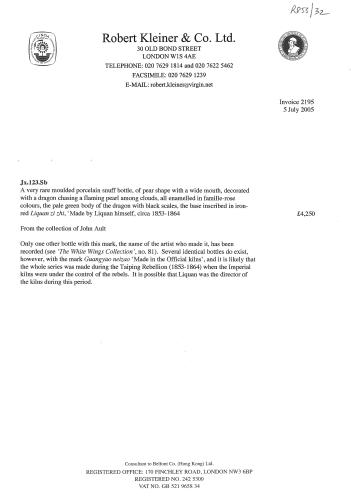
Condition: Very good condition with only minor old wear, few expected manufacturing irregularities, remnants of gilt around the mouth. The jade stopper with natural fissures.
Stopper: Celadon jade
Weight: 72.5 g
Dimensions: Height incl. stopper 74 mm. Diameter neck 21 mm and mouth 11 mm
Expert’s note: Only one other bottle with the mark “made by Liquan himself” has been recorded, see Robert Kleiner, Chinese Snuff Bottles, The White Wings Collection, 1997, number 81. Several near-identical bottles do exist, however, these are all molded only (and not additionally carved) and bear the mark Guangyao neizao “made in the official kilns”. It is likely that the whole series was made during the Taiping Rebellion (1853-1864), when the Imperial kilns and surrounding areas were under the control of the rebels, raising considerable problems of protocol in marking porcelains. As Robert Kleiner explains, it is possible that Liquan was the director of the kilns during this time. There is only one further molded and carved version known, but this one is signed Rongjing zuo (made by Rongjing), lacks the enamels, is in the Victoria and Albert Museum since 1883, and was illustrated by Helen White, Snuff Bottles from China, The Victoria and Albert Museum Collection, page 243, number 1 (fig. 1). The signature on this bottle also lacks the term for “himself” which could mean that Rongjing may not have been as important as Liquan. It also seems likely that only the carved bottles bear the “made by” marks, while the more common molded bottles bear the official kiln mark.

AUCTION RESULT COMPARISON
Type: Closely related
Auction: Christie’s Hong Kong, 25 April 2004, lot
822
Price: HKD 95,600 or approx. EUR 17,500 converted and adjusted for inflation at the time of writing
Description: A molded famille rose porcelain snuff bottle, 1851-1865
Expert remark: Compare the closely related form and decoration. Note the ‘Guanyao neizao’ (made by the official kilns) mark and the size (60 mm). Also note that this is the more common, molded only version.
Estimate EUR 6,000
Starting price EUR 3,000
89 60
Robert Kleiner (1948-2014)
A
PAINTED POTTERY ‘ARCHER AND TIGER’ VASE, HU, HAN DYNASTY
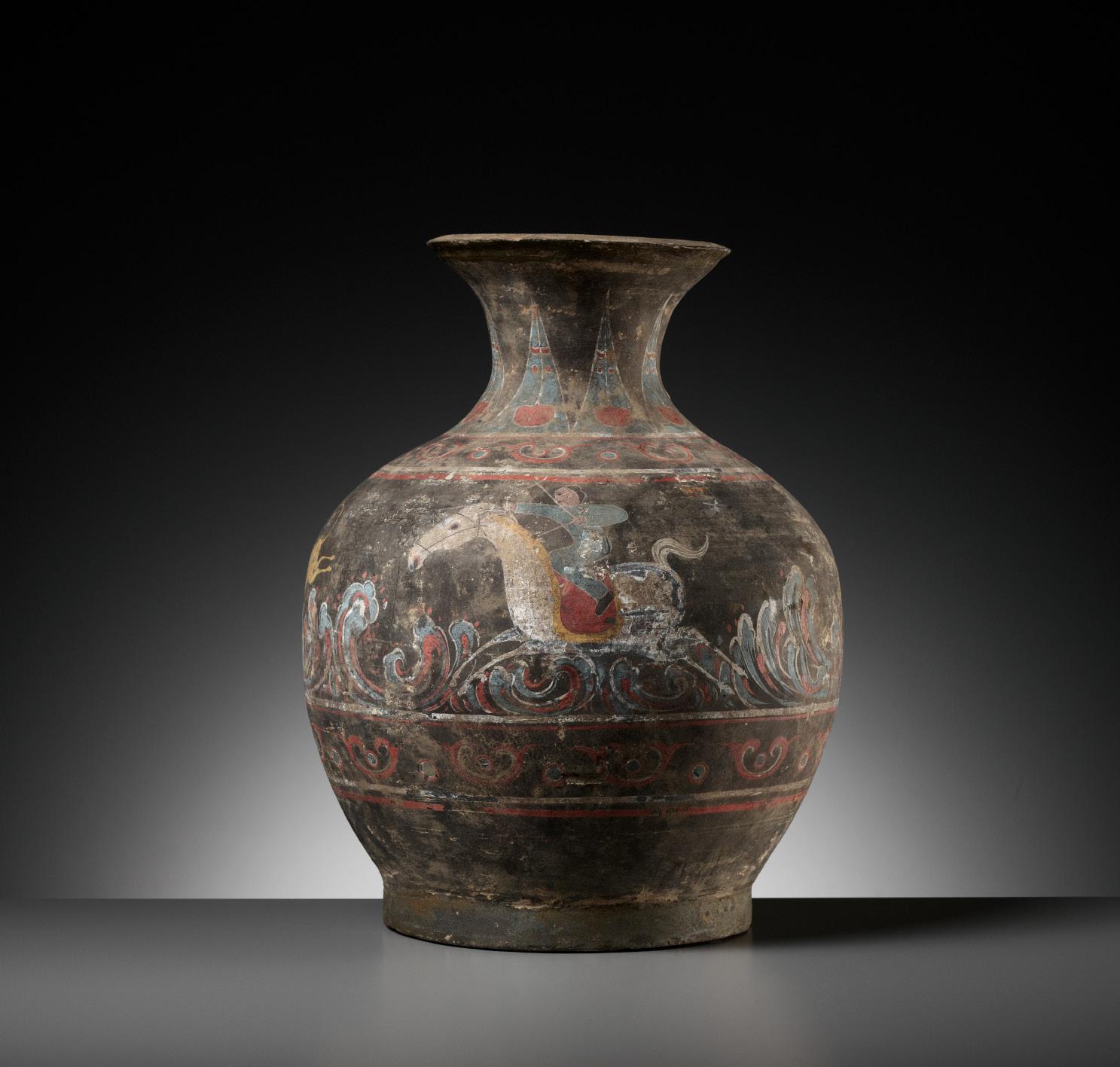

China, 202 BC-220 AD. The ovoid body supported on a short foot and rising to a waisted neck with a flared mouth. The exterior freely painted with confident brushstrokes and brilliant pigments in sky blue, red, amber, white, and black with an archer on horseback hunting a fierce tiger amid wave-like clouds, between borders of C-scroll motifs, all below a band of stiff leaves.
Provenance: French trade. By repute acquired from a private collector in Paris.
Condition: Good condition, commensurate with age. Old repairs and some touchups as generally expected from Han dynasty excavations. Wear, flaking, losses and fading to pigment. Minor chips, light scratches, extensive soil encrustations.
Weight: 5,109 g
Dimensions: 37.8 cm
Expert’s note: Expressive polychrome designs on ancient archaic wares from China, such as those on the present lot, are said to have inspired the Art Deco movement in Europe. A good example for this theory may be the design work of noted architect Henry van der Welde (1863 Antwerp – 1957 Zurich).
LITERATURE COMPARISON
Compare a closely related covered hu, dated to the 2nd–1st century BC, in The Metropolitan Museum of Art, accession number 1992.165.20a, b.

Estimate EUR 6,000
Starting price EUR 3,000
61
A PAINTED POTTERY ‘MYTHICAL BEAST’ STAND, EASTERN HAN DYNASTY
Scientific Analysis Report: A thermoluminescence analysis report issued by Oxford Authentication on 12 July 2018, based on sample number C118j1, sets the firing date of two samples taken between 1400 and 2200 years ago. A copy of the report, signed by Doreen Stoneham for Oxford Authentication, accompanies this lot.
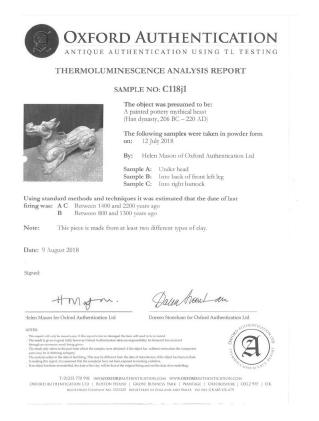
China, 25-220 AD. Crisply modeled as a crouching winged mythical beast, with large eyes, upturned snout, pricked ears, and a short mane extending to the rectangular socket in the back, painted in red, yellow, blue, and black with feather markings and details on a cream-colored ground. The creature, made from two different types of clay, stands on four large three-clawed feet.
Provenance: From a private collection in the Cotswolds, United Kingdom.
Condition: Good condition, commensurate with age. Extensive wear with signs of weathering and erosion, flaking to pigments, surface scratches, minor losses including the lower section of the tail, small chips, a few structural cracks, encrustations, drilled holes from sampletaking, all exactly as expected from ancient Han dynasty excavations of this size. Presenting remarkably well.
Weight: 5.9 kg
Dimensions: Length 42.5 cm
Literature comparison: Compare a similar figure excavated from an Eastern Han tomb at Xianyang, Shaanxi, illustrated in Zhongguo Meishu
Quanji, Diaosu Bian 2, Qin Han Diaosu (The Great Treasury of Chinese Fine Arts, Sculpture, Qin and Han), Beijing, 1985, volume 2, page 48, pl. 129. Compare a similar pair included in the exhibition, Visions of Man in Chinese Art, Kaikodo, 17 March - 19 April 1997, no. 32.
AUCTION RESULT COMPARISON
Type: Closely related
Auction: Christie’s New York, 16 September 1999, lot 265
Price: USD 25,300 or approx. EUR 43,000 converted and adjusted for inflation at the time of writing
Description: An unusual painted gray pottery mythical beast stand, Eastern Han dynasty
Expert remark: Compare the closely related modeling and manner of painting. Note the related size (43.2 cm).
AUCTION RESULT COMPARISON
Type: Closely related
Auction: Christie’s New York, 24 March 2011, lot 1304
Price: USD 25,000 or approx. EUR 31,500 converted and adjusted for inflation at the time of writing
Description: An unusual painted gray pottery mythical beast-form stand, Eastern Han dynasty

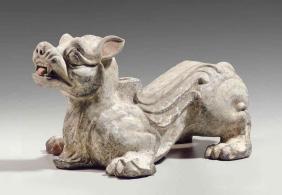

Expert remark: Compare the closely related modeling and manner of painting. Note the related size (40.7 cm).
Estimate EUR 8,000
Starting price EUR 4,000
91 62
A LARGE GREY POTTERY FIGURE OF A TORTOISE, HAN DYNASTY
Scientific Analysis Report: A thermoluminescence analysis report issued by Oxford Authentication on 24 April 2006, based on sample number C106j27, sets the firing date of three samples taken between 1500 and 2400 years ago. A copy of the report, signed by Doreen Stoneham for Oxford Authentication, accompanies this lot.
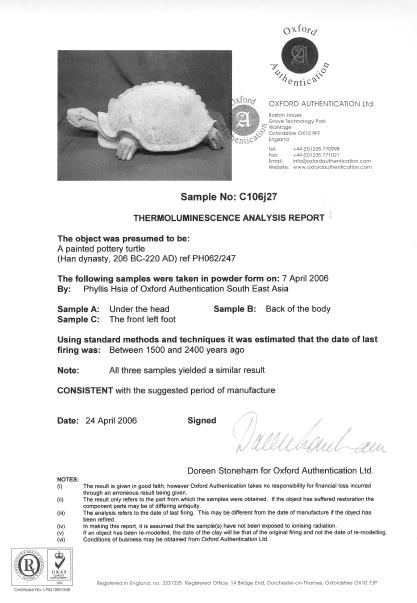
China, 206 BC-220 AD. Heavily potted, the large tortoise stands with its head slightly raised. The boldly modeled face with round bulging eyes and thick lips, the carapace lined with an elegantly curved outer ridge and applied at the top with a row of bosses.
Provenance: Guus Röell, Fine Arts & Antiques Maastricht, Netherlands, c. 2006. A European private collection, acquired from the above. Guus Röell is an expert in the field of colonial antiques and rare artefacts from across the world, including Chinese works of art. An impressive art connoisseur, Röell curates his gallery with an exquisite taste for unique craftsmanship and historical contexts. Condition: Very good condition, commensurate with age. Extensive wear, signs of weathering and erosion, minor losses, encrustations, firing cracks, drilled holes from sample-taking. Possibly with old fills and repairs, as expected from ancient Han dynasty excavations.
Weight: 11.9 kg
Dimensions: Length 61.2 cm
Literature comparison: Compare a related pottery tortoise, 11.7 cm long, dated to the Han dynasty, in the Metropolitan Museum of Art, accession number 68.149.2.
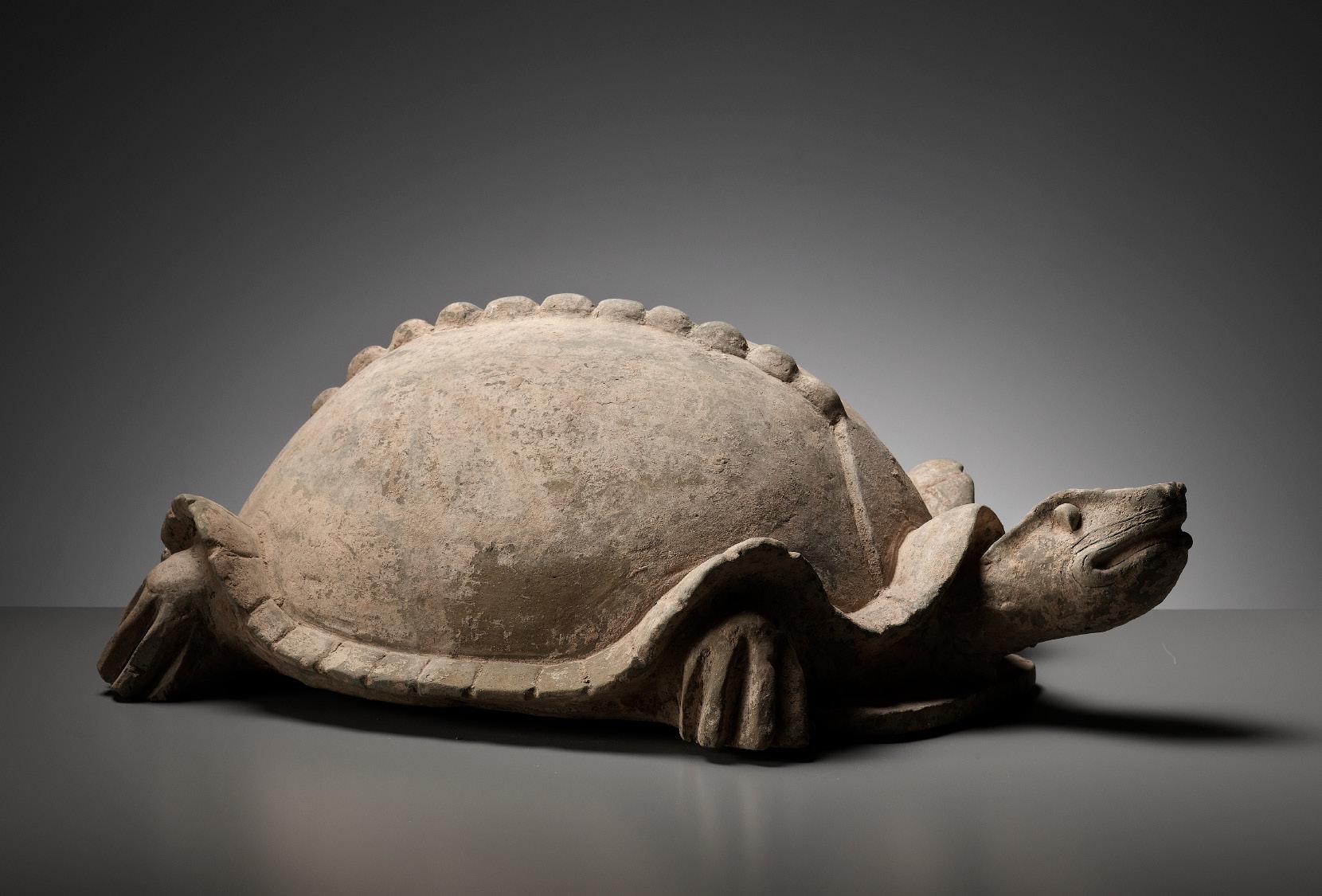

AUCTION RESULT COMPARISON
Type: Closely related
Auction: Sotheby’s New York, 19 March 2019, lot 143

Price: USD 20,000 or approx. EUR 22,000 converted and adjusted for inflation at the time of writing
Description: A pottery tortoiseform ink stone and cover, Eastern Han dynasty
Expert remark: Compare the related subject, pottery, and modeling with similar pose. Note the much smaller size (20.3 cm).
Estimate EUR 6,000
Starting price EUR 3,000
92 63
Guus Röell
A RARE IRON-SPLASHED ‘YUE’ FIGURE OF A RECUMBENT RAM, WESTERN JIN DYNASTY
China, 3rd century. The well-modelled ram with its front and rear legs folded beneath the body, with a curvaceous spine and robust rump, its head raised and with a pierced aperture on top, detailed with a pair of bulging eyes and curved striated horns encircling long ears, all highlighted with dark iron splashes and painted overall with a finely crackled olive-green glaze, the body neatly incised beneath the glaze with a pair of wings.

Provenance: From the estate of a prominent Chinese musician in New York, USA.
Condition: Excellent condition with some wear, encrustations, and firing flaws including kiln grit and glaze recesses.
Weight: 299.1 g
Dimensions: Length 11.5 cm
Expert’s note: Stoneware figures of recumbent rams kneeling with their forelegs and their hind legs tucked in and covered in the same olive-green glaze, belong to a group of playful objects for the scholar’s desk made in kilns in northern Zhejiang and southern Jinagsu province. Numerous vessels of this type, in the form of various animals, have been recovered from tombs of the Three Kingdoms (220-265) and the Western Jin dynasty (265316), suggesting they were treasured items.
Literature comparison: A closely related figure was included in the exhibition Treasures from the Shanghai Museum, 6000 years of Chinese Art, Asian Art Museum of San Francisco, San Francisco, 1983, cat. no. 57. A closely related figure from the Barlow collection was included in the Oriental Ceramic Society exhibition The Ceramic Art of China, Victoria and Albert Museum, London, 1971, cat. no. 26. See also the ram with brown wash details excavated in 1980 at the Jianbi Brick and Tile Factory, Dantu County, Zhenjiang City, published in Zhongguo chutu ciqi quanji, vol. 7: Jiangsu Shanghai, 2008, no. 64, p. 53 (as early Yue ware, Eastern Jin dynasty, 16 cm long).
AUCTION RESULT COMPARISON
Type: Related
Auction: Sotheby’s London, 6 November 2019, lot 127
Price: GBP 40,000 or approx. EUR 60,500 converted and adjusted for inflation at the time of writing
Description: A rare ‘yue’ figure of a recumbent ram, Western Jin dynasty, 3rd century AD Expert remark: Compare the closely related modeling, glaze, and iron splashes. Note the larger size (16.3 cm).

Estimate EUR 4,000
Starting price EUR 2,000
93 64
A COMPLETE SET OF ANTHROPOMORPHIC ZODIAC FIGURES, PAINTED POTTERY, TANG DYNASTY

Expert’s note: It is rare to find a complete set of twelve zodiac animals. The present set is also unusual for the crispness of its modeling, especially the inspired sculpturing of the heads, with each face showing a unique expression and character. Special care was given to the ox, tiger, and monkey sculptures who are the only figures robed in red, black, and yellow, possibly suggesting a personal connection between the original owners and these years.
China, 618-907. Each modeled as a human figure standing ramrod straight with hands clasped beneath the long sleeves of court robes belted below the waist, falling in crisp folds and fanning out in a circle over the tips of their shoes. The robes in shades of red, yellow, cream, and brown. The heads finely modeled comprising the complete group of twelve animals of the Zodiac: the rat, ox, tiger, rabbit, dragon, snake, horse, ram, monkey, rooster, dog, and pig. (12)
Provenance: From a private collection in Sussex, United Kingdom, assembled during the 1990s, and thence by descent.
Condition: Excellent condition overall, commensurate with age. Wear, weathering and erosion, the original pigments partially faded. Minor chips, cracks, and losses. Soil encrustations. Possibly with small old repairs here and there, as expected from ancient potteries aged more than a millennia.
Scientific Analysis Report: A thermoluminescence analysis report issued by Oxford Authentication on 19 April 2021, based on sample number C121c56, sets the firing date of two samples taken between 900 and 1500 years ago. A copy of the report, signed by Doreen Stoneham for Oxford Authentication, accompanies this lot.

Weight: 14.9 kg
Dimensions: Height 31 cm (the tallest)
Zodiac figures first appeared during the Han dynasty as artisans began casting representations of the animals in bronze as offerings. Form the Northern Wei dynasty (386-534 AD) onwards, the zodiacal animals
94 65
began to be anthropomorphized, such as in the present lot, and often functioned as grave goods. The heads of each of these figures were molded separately from the bodies and were attached before firing. The hollow interior can be seen from the base, which was necessary to access when attaching the heads to the bodies. Remnants of the sculptors fingerprints are preserved in the interior of many of these figures.
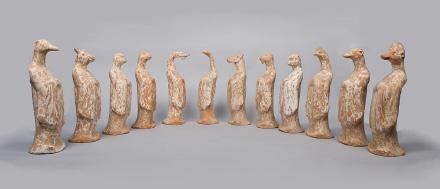
LITERATURE COMPARISON
AUCTION RESULT COMPARISON
Type: Closely related
Auction: Christie’s New York, 16 January 2019, lot 69
Price: USD 35,000 or approx. EUR 38,000 converted and adjusted for inflation at the time of writing
Description: A set of six Chinese large painted red pottery zodiac figures, Tang dynasty
fig. 1
Compare a closely related complete set of twelve zodiac animals, each 30.5 cm high, dated to the 8th century, in the Metropolitan Museum of Art, accession number 2000.662.7a-l (fig. 1). A related complete set of twelve pottery Zodiac figures, Tang dynasty, unearthed in the suburbs of Xi’an, Shaanxi Province in 1955 and currently in the Museum of Chinese History, Beijing, was included in the exhibition China. 5000 Years: Innovation and Transformation in the Arts, The Guggenheim Museum, New York, 1998, cat. no. 108. A related complete set of twelve zodiac animals, excavated in 1950 at Ba Qiao, Shaanxi Province, and currently in the Shaanxi Beiling Museum, was included in the exhibition Gilded Dragons, The British Museum, London, 1999, no. 63. Compare a related set of five zodiac animals, 25.4 cm high, dated to the Tang dynasty, in the Minneapolis Institute of Art, accession numbers 50.46.197-50.46.201.
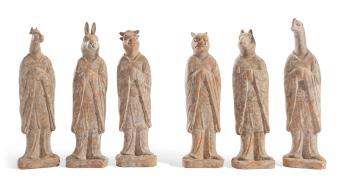
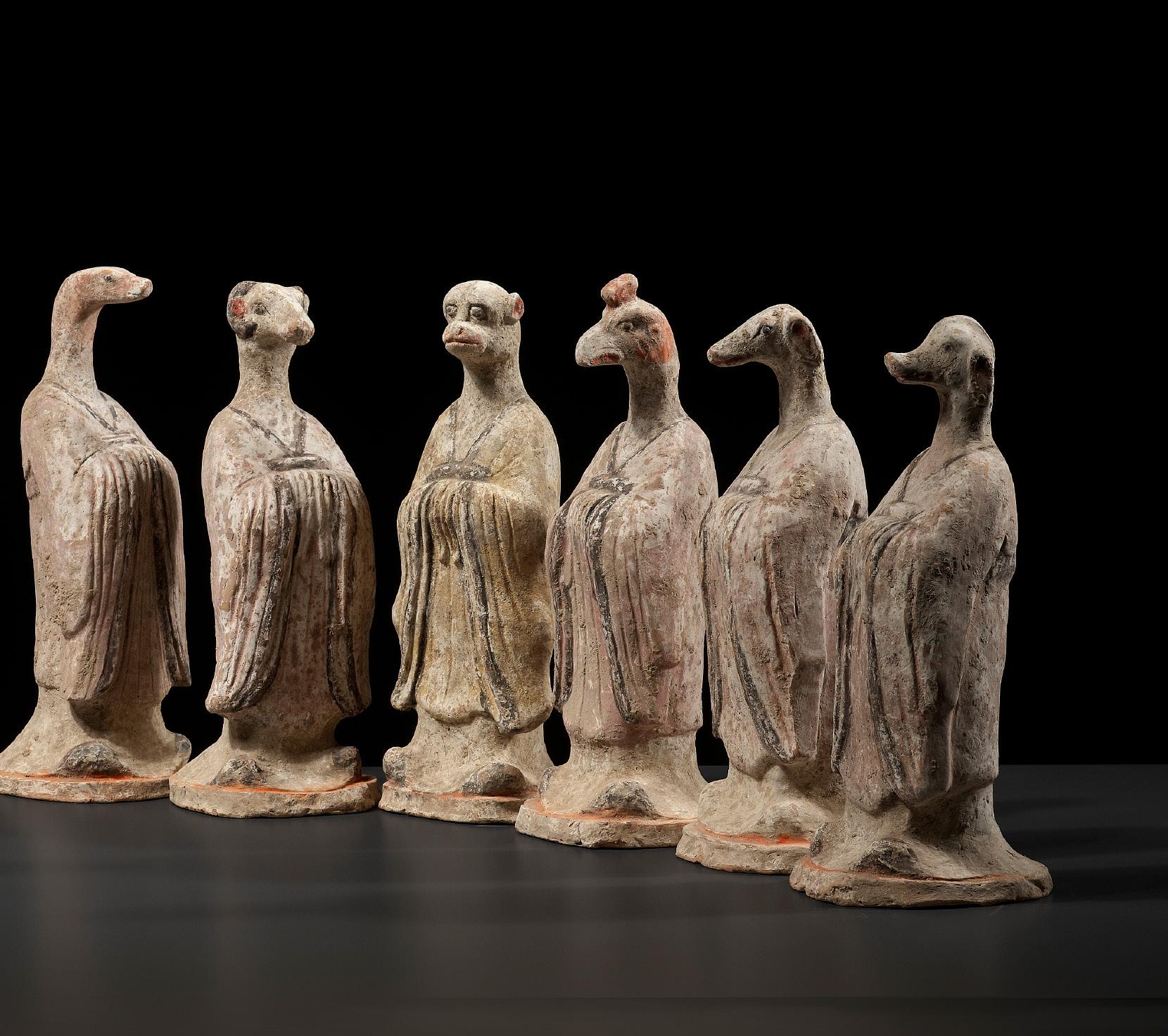
Expert remark: Compare the closely related modeling and manner of painting. Note the size (54.2 cm) and that this lot is an incomplete set of only six figures, as opposed to the present lot which is a complete set of twelve.
Estimate EUR 15,000
Starting price EUR 7,500
95
AN EXCEPTIONALLY LARGE PAINTED POTTERY FIGURE OF A BACTRIAN CAMEL AND A SOGDIAN RIDER, TANG DYNASTY
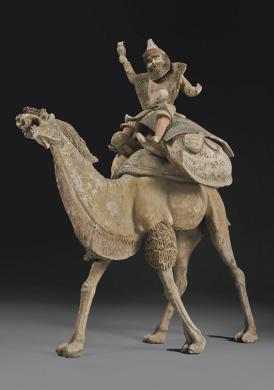
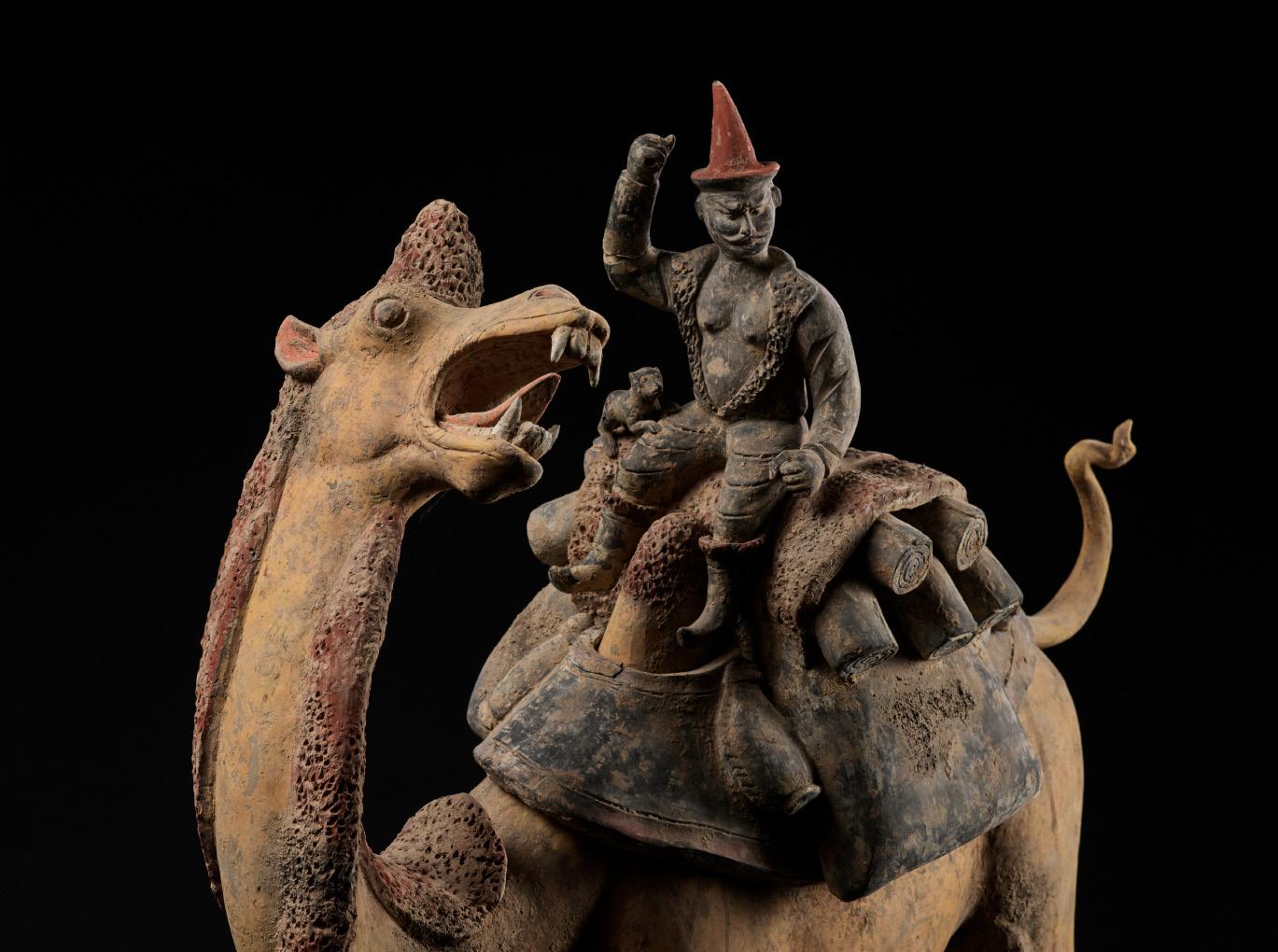
Expert’s note: The present lot is extremely rare for its exceptional size of 104 cm, with exceedingly few other examples of comparable height recorded in private or public collections.
China, 618-907. Powerfully modeled, the large camel with its head turned to the left, the animal with a wild expression marked by protruding eyes, flaring nostrils, and the wide-open mouth with the tongue extended. The Sogdian rider wearing a fur coat and tall cap, his right arm raised to goad the camel, his mustachioed face with a stern expression as he sits on several rolled mats beneath the red saddle blanket with a dog propping himself up on his leg. The camel further ladened with a saddle bag and two flasks, as well as the yield of a hunt, a slain wild goat, tied to the saddle.
Provenance: From a noted private collection in Aix-en-Provence, France. Condition: Some restorations and touch-ups as generally expected from Tang dynasty excavations. Losses, fissures, and encrustations. Drilled holes from sample-taking. Overall, very good condition and displaying magnificently. Scientific Analysis Report: A thermoluminescence analysis report issued by QED Laboratoire, Reference QED1346/FC-0101, dated 20 November 2013, sets the firing date of two samples as consistent with the suggested period of manufacture in Tang dynasty. A copy of the report accompanies this lot.
Weight: 35.2 kg
Dimensions: Height 104 cm
The rider with fur coat and peaked hat represents a Sogdian merchant. A similar hat is worn by a small Tang bronze figure of a Sogdian dancer, included in the exhibition Monks and Merchants: Silk Road Treasures from the Northwest China, Asia Society Museum, New York, 2001-2, and at present on view in the Norton Museum of Art, Palm Beach,
Florida, which is discussed and illustrated in the catalog, no. 82. Compare also a standing pottery figure of a similarly attired foreigner, excavated from a tomb of AD 724, illustrated in Treasures of a Nation, Beijing, 1999, pp. 216f, and a camel drover with a pointed hat, depicted together with his animal on a brick from one of the Dunhuang caves in Gansu province, included in The Exhibition of Ancient Art Treasures of the People’s Republic of China, Tokyo National Museum, 1979, cat. no. 75.
The highly animated depiction of the camel is reminiscent of the running camels from the hunting scenes painted on the walls of Crown Prince Zhuang Huai’s tomb in Qianxian near Xi’an, Shaanxi province. The two-humped Bactrian camel was an exotic beast known in China from the Han dynasty, when it was first introduced as a form of tribute offered by the tribes of Turkestan and Central Asia. Prized for their ability to survive extreme hardships of heat, cold, and lack of water when travelling across the desert, camels came to symbolize the freely-flowing trade established along the Silk Road and thus the wealth and cosmopolitan nature of the Tang Court.
Literature comparison: A related large painted pottery group of a camel and foreign rider, dressed in a fur coat and wearing a large pointed hat, excavated from the tomb of Wang Chen (buried 679), Chengzhi, Shaanxi province in 1954 and now in the Museum of Chinese History, Beijing, is illustrated by Li Jian (ed.), The Glory of the Silk Road, Art from Ancient China, The Dayton Art Institute, 2003, p. 170, pl. 85.
AUCTION RESULT COMPARISON
Type: Closely related
Auction: Sotheby’s New York, 15 September 2015, lot 258
Estimate: USD 180,000 or approx. EUR 210,000 converted and adjusted for inflation at the time of writing
Description: A magnificent painted pottery camel with Sogdian rider and hunting owl, early Tang dynasty
Expert remark: Compare the closely related modeling with a similarly animated camel and Sogdian rider, who however is holding a hunting owl in his hand. Note the related size (99.1 cm).
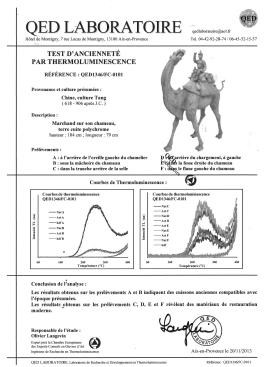
Estimate EUR 20,000
Starting price EUR 10,000
96 66

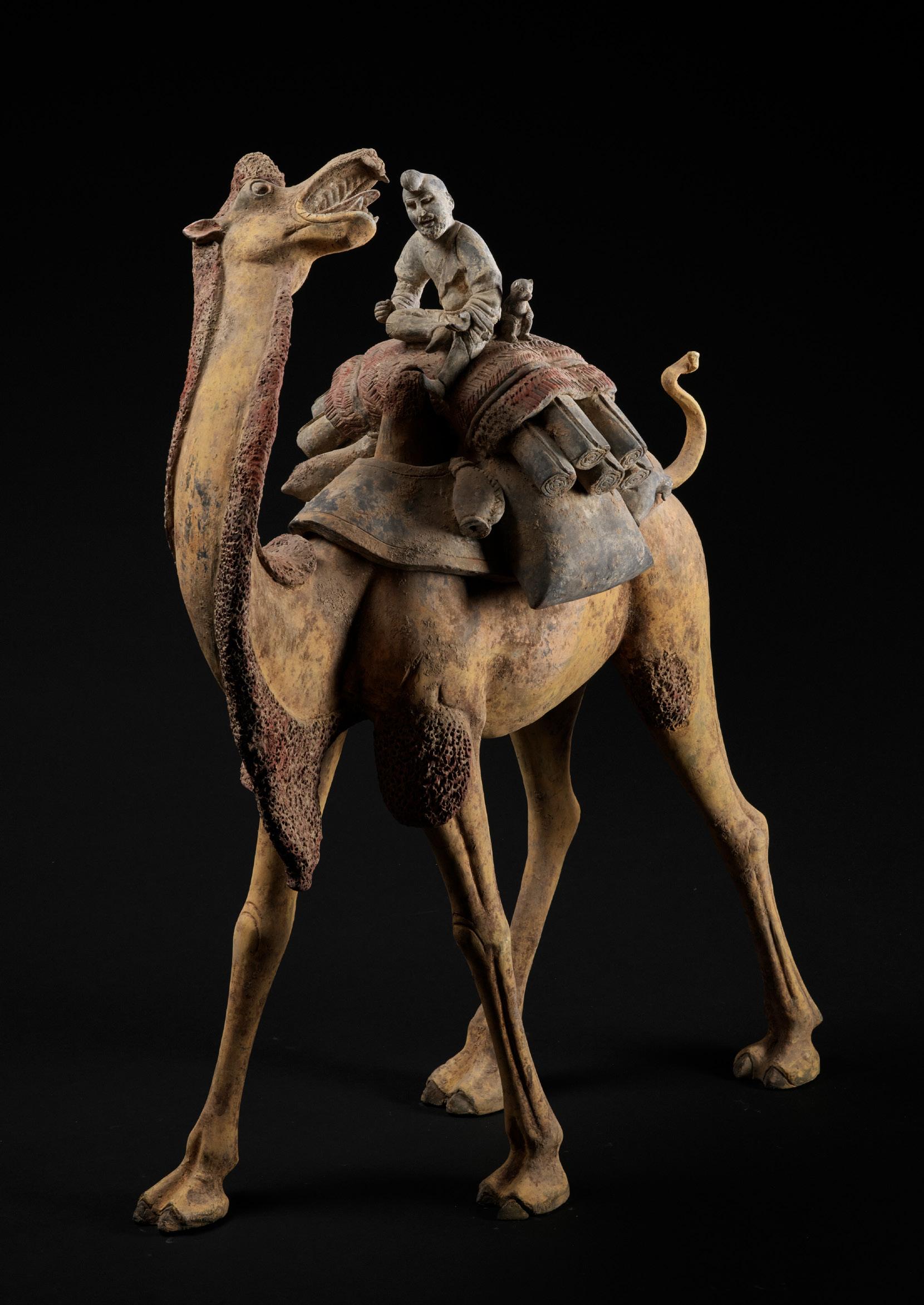
Expert’s note: The present lot is extremely rare for its exceptional size of 105 cm, with exceedingly few other examples of comparable height recorded in private or public collections.
China, 618-907. Realistically modeled, the camel with its raised head turned slightly to the left, its mouth exposing the animal’s sharp teeth and protruding tongue as if bellowing, the powerful expression marked by wide bulging eyes and flared nostrils, further detailed with laid-back ears and finely sculpted curling hair. The rider sits on several rolled mats beneath a red saddle blanket with a small monkey sitting beside him. The camel is further ladened with two flasks as well as two wild goats, the yield from the hunt.
Provenance: From a noted private collection in Aix-en-Provence, France.
Condition: Some restorations and touch-ups as generally expected from Tang dynasty excavations. Losses, fissures, and encrustations. Drilled holes from sample-taking. Overall, very good condition and displaying magnificently.
Scientific Analysis Report: A thermoluminescence analysis report issued by QED Laboratoire, Reference QED1340/FC-0301, dated 10 October 2013, sets the firing date of two samples as consistent with the suggested period of manufacture in Tang dynasty. A copy of the report accompanies this lot.

Weight: 43.3 kg
Dimensions: Height 105 cm
The Tang dynasty is undoubtedly one of the most artistically exciting periods in China’s long history. The works of art are characterized by their diversity, the cosmopolitan nature of their design and the high technical skill employed in their manufacture as this pottery example amply demonstrates. In the first half of this dynasty, up to the An Lushan rebellion of 756, the level of luxury enjoyed by the court and the Tang elite ensured the production of a wide range of goods of the highest quality. As China prospered as a result of trade with the West along the famous Silk Road, camels became increasingly important for the transport of wares, since these impressive animals could carry heavy loads over long distances,
surviving several days without water. As their large and broad feet did not sink easily into the sand, they became known as ‘the ships of the desert’. Many camels were imported from the states of the Tarim basin, Eastern Turkmenistan and Mongolia and are known as Bactrian camels. The Tang civil servants created a special office to supervise their breeding and services. It seems that no pottery examples showing Chinese riders have been excavated. Perhaps only the Central Asian foreigners were able to tame and guide the camels.
Literature comparison: Compare a related figure of a camel with a foreign rider in Hao Qian, et al., Out of China’s Earth: Archaeological Discoveries in the People’s Republic of China, Beijing, 1981, fig. 241. Compare a related camel and rider excavated from the tomb of Dugu Sijing, dated 709 AD, in Tang Chang’an Chengjiao Sui Tang mu, Beijing, 1980, pls. 65, 70-71.
AUCTION RESULT COMPARISON
Type: Closely related
Auction: Christie’s London, 5 November 2019, lot 4
Price: GBP 75,000 or approx. EUR 99,000 converted and adjusted for inflation at the time of writing
Description: A massive painted pottery figure of a camel and rider, Tang dynasty
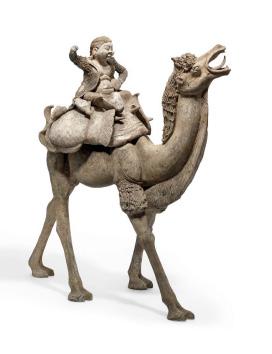
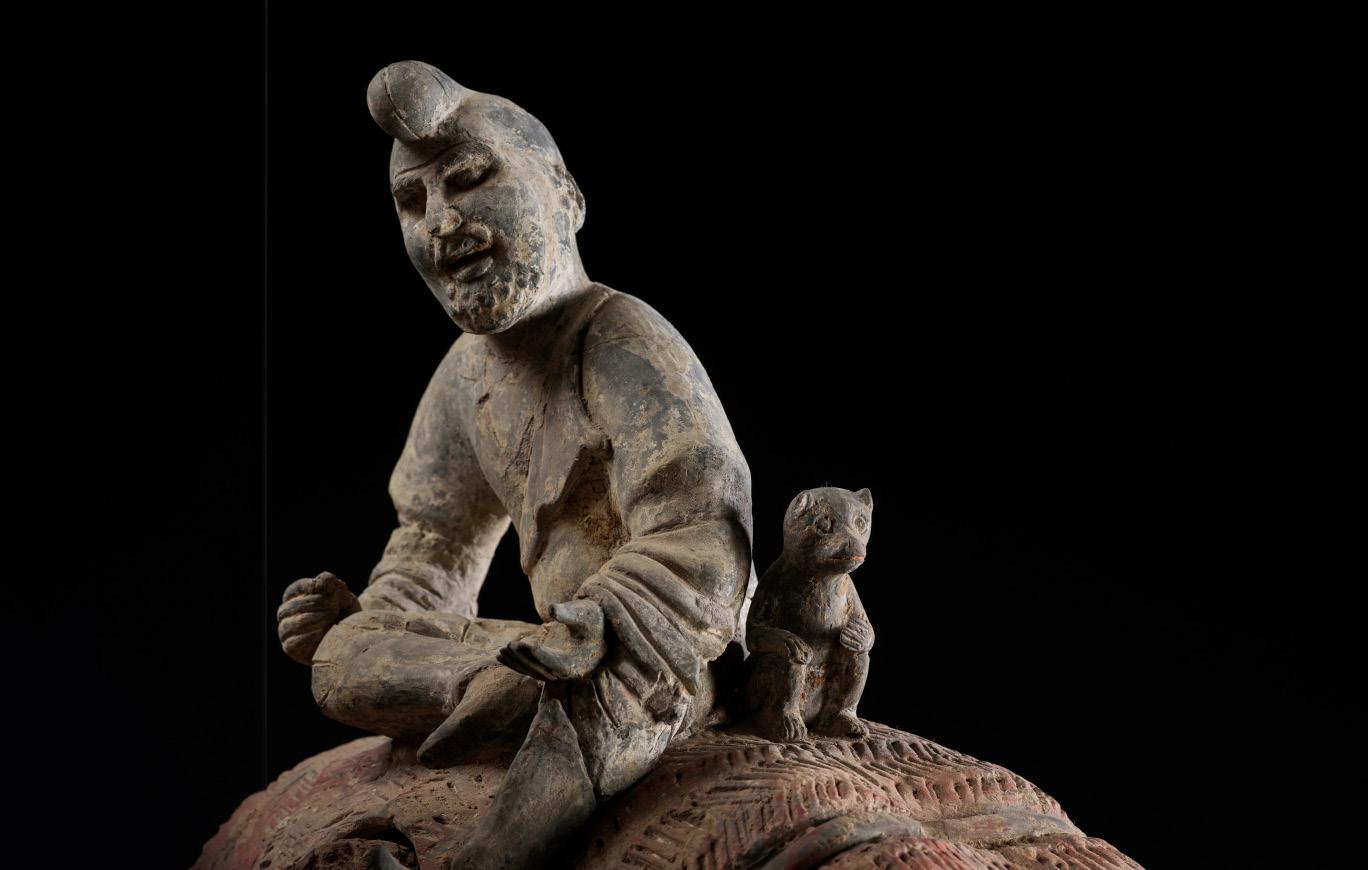
Expert remark: Compare the closely related modeling with similar pose, detachable saddle bag (albeit with a different rider), and painted details. Note the much smaller size (78 cm).
AUCTION RESULT COMPARISON
Type: Closely related
Auction: Christie’s Hong Kong, 29 November 2017, lot 2919
Price: HKD 6,100,000 or approx. EUR 772,000 converted and adjusted for inflation at the time of writing
Description: A finely painted pottery figure of a Bactrian camel and rider, Tang dynasty
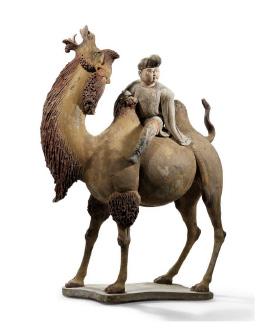
Expert remark: Compare the closely related modeling with a near-identical hat of the rider and a similar expression and curly mane of the camel. Note the much smaller size (60 cm).
Estimate EUR 20,000
Starting price EUR 10,000
99 67
AN EXCEPTIONALLY LARGE PAINTED POTTERY FIGURE OF A BACTRIAN CAMEL WITH RIDER, MONKEY AND SLAIN GOATS, TANG DYNASTY

A LARGE SANCAI-GLAZED ‘ARCHER’ GUARDIAN FIGURE (LOKAPALA), TANG DYNASTY
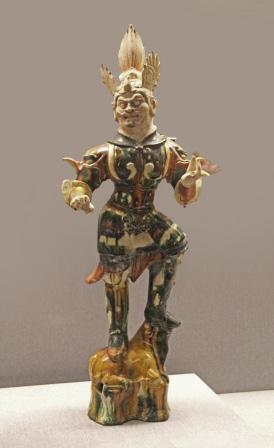
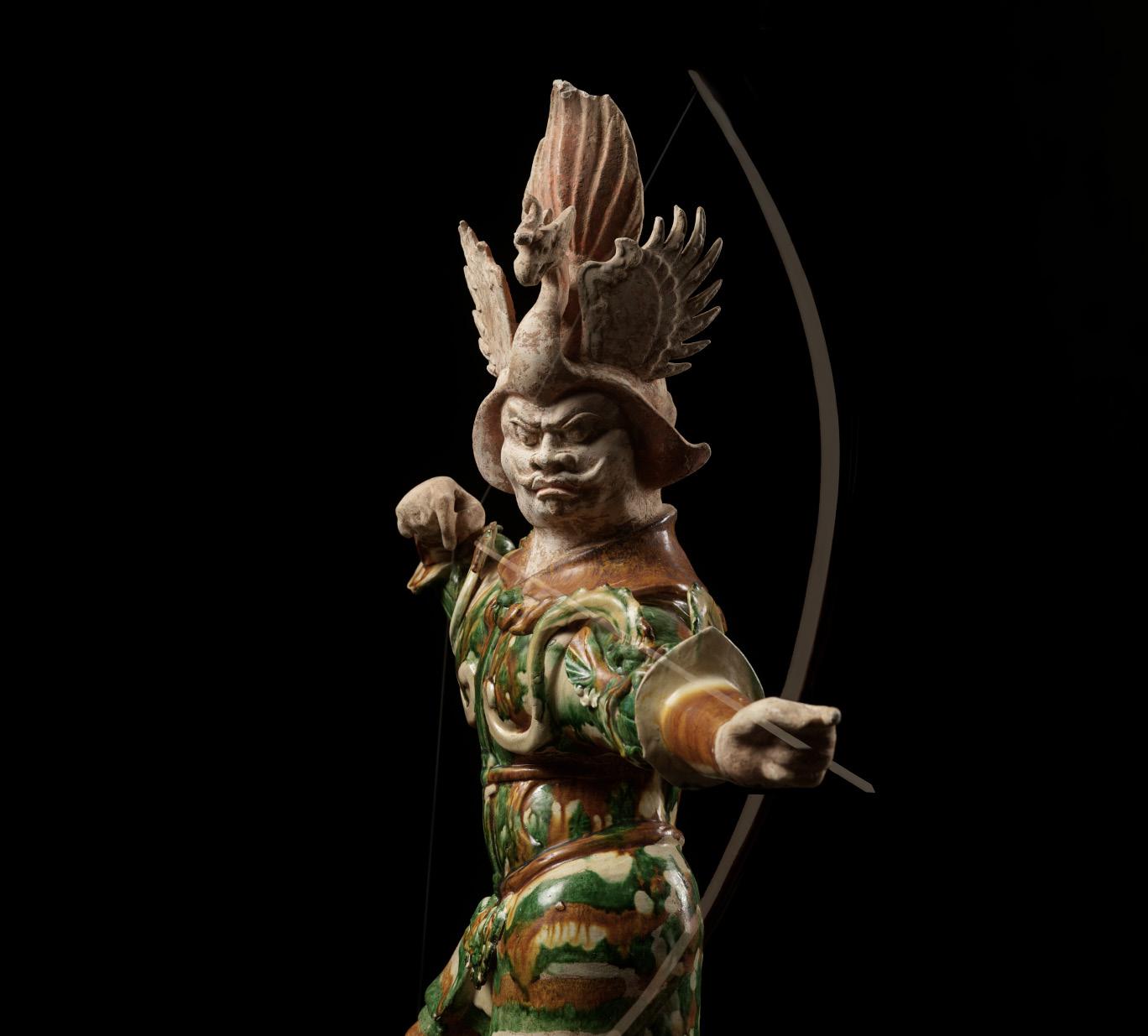
China, 7th-8th century. Exquisitely modeled, standing on a recumbent bull over a pierced rockwork base, his right arm bent and left arm extended, poised to shoot an arrow from his now lost bow. The lokapala is dressed in elaborate armor with dragon epaulets and divided breast plate, over a knee-length tunic. His unglazed face is well modeled with a fierce, somewhat hypnotic expression. The head is surmounted by a tall phoenix-form headdress. The figure is splashglazed in amber, green, and straw.
Provenance: From the collection of Joseph Rondina, acquired before 1996, and thence by descent to the last owner. Joseph Rondina (19272022) was born into a first-generation Florentine-American family in Auburn, upstate New York. Returning to the U.S. after being stationed in Berlin at the end of the Second World War, he studied at the Whitman School of Design before opening Joseph Rondina Antiques on Madison Avenue in Manhattan’s Upper East Side in 1957. In the beginning, his interests focused primarily on European 18th-century decorative arts and furniture, over time developing to include Chinese, Korean, Indian, Thai, Cambodian, Persian and Japanese art, bringing a more esoteric and exotic style to the market. His clientele included stars of the stage and screen, royalty, notables, dignitaries, and denizens of the social register from the United States and abroad.

Condition: Excellent condition, commensurate with age. Old repairs and minor touch-ups as generally expected from authentic Tangdynasty excavations. Old wear, glaze flaking and crackling, small nicks and losses, light scratches, soil encrustations overall.
Weight: 11.5 kg
Dimensions: Height 97.4 cm
Large, imposing guardian figures like the present lot were made to stand guard in the tombs of Tang dynasty elite. Those with vibrant sancai (three color) glazes, like the current example, flourished from the late 7th to mid-8th century. One of the earliest tombs to contain sancai pieces was that of Li Feng, Prince of Guo (622-675), fifteenth son of Emperor Gaozu, founder of the Tang dynasty. By the first decade of the 8th century, large sancai figures were included in the tombs of royalty and nobility both at the capital Chang’an (modern day Xian) and at Luoyang, which served as the Eastern Capital in the Tang period. The inclusion of large sancai figures declined significantly following the An Lushan rebellion of 755763, which had a devastating effect on the empire, seriously weakening the dynasty, and leading to the loss of the Western Regions.
See the collection of the New Luoyang City Museum for a closely related sancai figure of a ‘Heavenly King’ with a nearly identical phoenix headdress and similar facial features.
Expert’s note: Based on the size and quality of the modeling of the present lot, and considering the known examples of Lokapala in public collections, both in China and around the world, it is obvious that the current figure hails from the tomb of an elite individual.
Estimate EUR 8,000
Starting price EUR 4,000
101 68
Joseph Rondina standing at the entrance of his store on Madison Avenue, ca. 1960
A LARGE SANCAI-GLAZED POTTERY TRIPOD CENSER, TANG DYNASTY
China, 618-907. The globular body is supported on three animal-claw feet and has a waisted neck with a flared rim. The sides are decorated with molded four-leaf and tasseled appliqués, and are covered with streaked green, amber, and ochre glazes that fall towards the lower body revealing the buff ware. The base and interior are left unglazed.
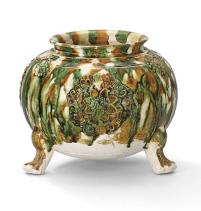
Provenance: From a private collection in New York, USA. The base with a collector’s label, ‘4395’.
Condition: Very good condition, commensurate with age and as expected for authentic Sancai wares from the Tang dynasty. Old wear and firing irregularities including pitting, glaze crackling and flaking. Cracks and old repairs to two feet. Minor losses, nicks and scratches. Soil encrustations. Displaying exceptionally well.
Weight: 1,900 g
Dimensions: Height 17.5 cm
Literature comparison: Compare a sancai-glazed pottery tripod censer with similar appliqué decorations, dated to the Tang dynasty, in the Royal Ontario Museum, accession number 918.17.98.
AUCTION RESULT COMPARISON
Type: Closely related
Auction: Christie’s Hong Kong, 4 October 2016, lot 3
Estimate: HKD 275,000 or approx. EUR 37,000 converted and adjusted for inflation at the time of writing
Description: A sancai-glazed applique-decorated tripod jar, Tang dynasty (AD 618-907)

Expert remark: Compare the closely related form, appliqué decoration, and sancai glaze. Note the size (13.3 cm).
Estimate EUR 6,000
Starting price EUR 3,000
69
A WHITE-GLAZED
XING ZHADOU, LATE TANG DYNASTY TO FIVE DYNASTIES PERIOD
China, 9th-10th century. The compressed globular body rising from a short foot to a waisted trumpet neck with a small cylindrical mouth. Covered overall in a smooth, creamy white glaze of eggshell tone, spare the foot and the base, revealing the pale ivory colored ware.
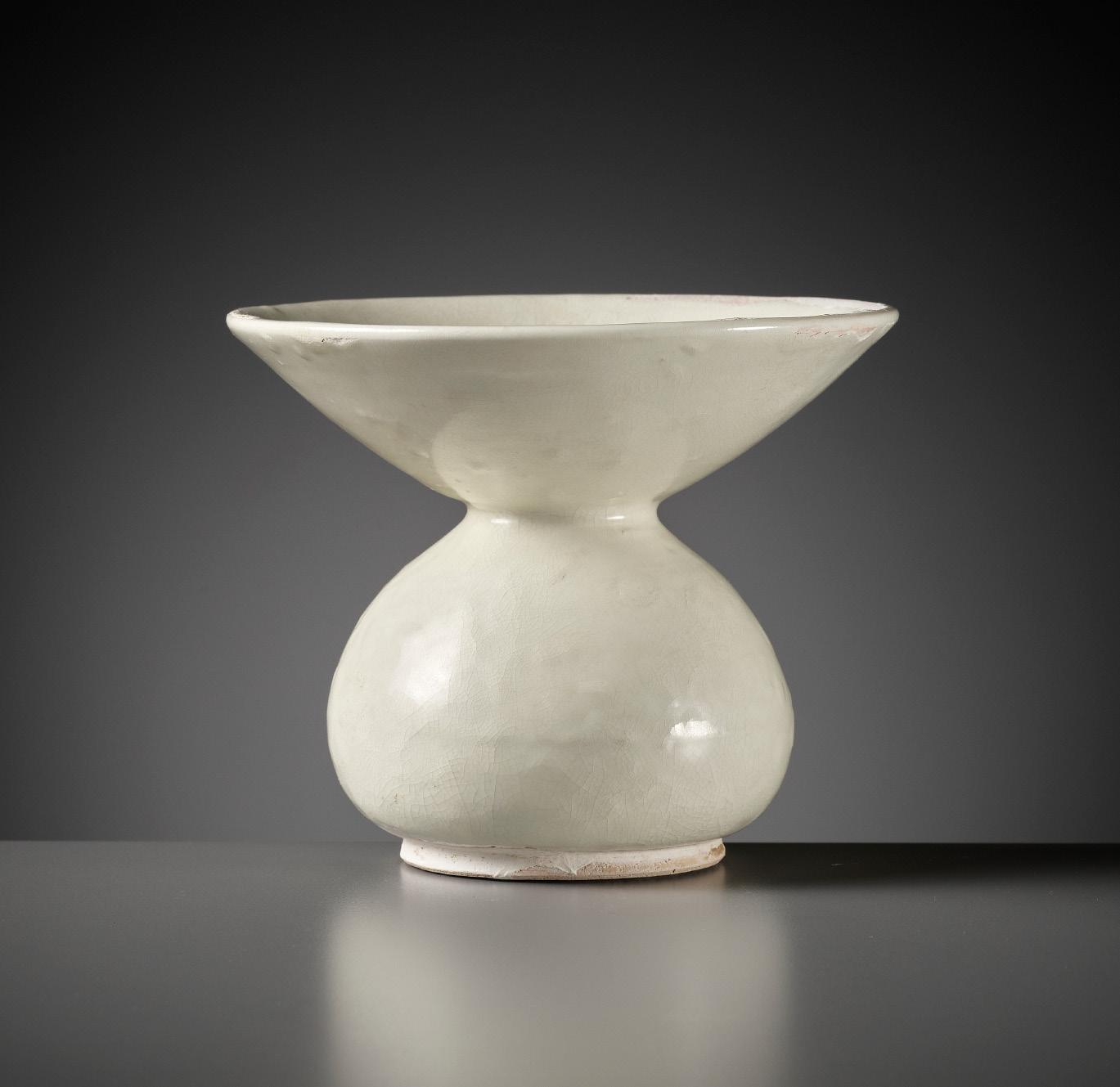
Provenance: American trade.
Condition: Good condition with old wear and expected manufacturing flaws including minor pitting, scattered dark spots and glaze crackling. Shallow surface scratches. Some flaking to glaze around the neck and rim.
Weight: 363.9 g
Dimensions: Diameter 13 cm, Height 10.6 cm
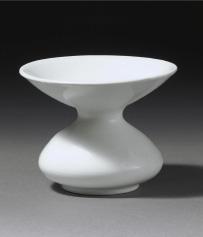
The unusual shape of this zhadou, with its broad sloping mouth rim, was inspired by early metalwork prototypes dating back to the Han dynasty. For an example see Zacke, 16th October, 2021, lot 333. It has been suggested that vessels of this specific shape may have functioned as waste recepticle for wine dregs or tea leaves.
Xing wares from Hebei province were the best quality white-glazed ceramic of the Tang dynasty. The kilns are best known for their tea bowls, dishes and bowl stands, and vessels like the present zhadou are very rare.
Literature comparison: Compare a closely related zhadou with a slightly smaller flared mouth, more compressed body and covered with a white-crackle glaze, dated to the Tang dynasty in the Palace Museum, Beijing, illustrated in Porcelain of the Jin and Tang Dynasties, The Complete Collection of Treasures of the Palace Museum, Hong Kong, 1996, no. 144, and another zhadou in the same monograph, no. 143. Also compare a zhadou of similar shape but covered with a celadon glaze that was included in the Nezu Institute of Fine Arts exhibition, Toji hakuji, seiji, sancai (Tang pottery and porcelain), Tokyo, 1988, no. 49. Compare two related Tang dynasty silver zhadou illustrated in Tangdai Jinyin Qi, Beijing, 1985, nos. 255 and 278, the first excavated at Xi’an, and the second with a slightly concave mouth rim found in a tomb in Linan Xian Shiu Qiushi, Zhejiang province. Also compare with a prototype from the Han Dynasty at Zacke, 16th October, 2021, lot 333.
AUCTION RESULT COMPARISON
Type: Closely related
Auction: Sotheby’s New York, 19 March 2007, lot 386
Estimate: USD 15,000 or approx. EUR 20,500 converted and adjusted for inflation at the time of writing
Description: A rare small ‘Xing’ spittoon (zhadou)
Tang Dynasty
Estimate EUR 6,000
Starting price EUR 3,000
103 70
A XINGYAO WHITE-GLAZED BOTTLE VASE, FIVE DYNASTIES TO NORTHERN SONG DYNASTY

China, 10th-11th century. The rare and early Xing ware ceramic vessel is of globular form, following a leather canteen shape, the tall, gently rounded sides gathered into pairs of shallow rounded lobes and applied with twin squared lug handles with riveted ends at the shoulder and base, straddling the lobes, lightly engraved with a double-line border around the outer edge of the broad rounded shoulders, surmounted by a waisted cylindrical neck, applied overall with a smooth cream-white glaze, save for the foot, rim, and base which were left partly unglazed revealing a smooth white ware.
Provenance: Hang Tang Cheng, Dragon House, San Francisco, USA, 1990s. A private collection in North America, acquired from the above. One side of the vase with an old collector’s label, ‘Northern Song [...] 10-11C, Early Ding Stoneware [...] Flask Two Vertical Indentations + 4 Stray Handles 00-409 SL50029.’
A copy of a Certificate of Appraisal written and signed by Hang Tang Cheng, dating the present lot to the Northern Song to Liao dynasty, 10th-11th century, accompanies this lot. Hang Tang (Hank) Cheng is a well-respected dealer and appraiser of Asian art who ran the famous Dragon House antiques shop in San Francisco, established in 1979. Hank Cheng worked closely with museums, institutions, and auction houses including the Asian Art Museum, Bonhams, and Christie’s.
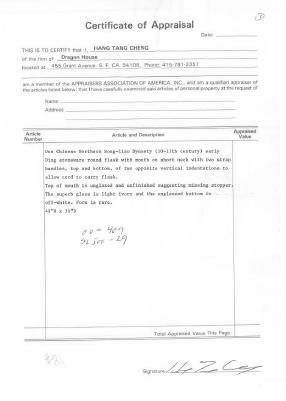
Condition: Very good condition with only minor old wear and few tiny nicks to the foot rim.
Weight: 280 g
Dimensions: Height 12 cm
With a padded silk box and cover. (2)
Literature comparison: Compare the white porcelain vase of this form in the collection of the National Palace Museum, Taipei, published in Illustrated Catalogue of Sung Dynasty Porcelain in the National Palace Museum: Ting Ware and Ting-Type ware, Taipei, 1973, no. 1. Compare a closely related white-glazed handled vase, dated late Tang to Five Dynasties, 9th-10th century, from the collection of Carl Kempe (1884-1967), Sweden, illustrated and exhibited by J. J. Lally & Co. in Chinese Ceramics in Black and White, New York, 20 March-10 April 2010, no. 14. Another white porcelain vase of this distinctive form from the Avery Brundage Collection, in the Asian Art Museum of San Francisco, is illustrated by He Li in Chinese Ceramics: The New Standard Guide, London, 1996, p. 90, no. 136, with description on p. 120; and the same vase was previously published by Watson in Tang and Liao Ceramics, London, 1984, p. 145, no. 124. A Xingyao white porcelain vase of this same form in the collection of the Shanghai Museum is illustrated in Qiannian Xingyao (Xing Kiln in its Millennium), Beijing, 2007, p. 168, together with another example, ibid, on p. 169; and the same vase from the Shanghai Museum is also illustrated in Zhongguo taoci quanji (6) Tang-Wudai (The Complete Works of Chinese Ceramics, Vol. 6, Tang–Five Dynasties), Shanghai, 2000, p. 200, no. 225 and several other publications, including A Dictionary of Chinese Ceramics, Singapore, 2002, p. 171, where the scholar Wang Qingzhen points out that this type of white porcelain bottle in the Tang dynasty was famously called ‘the Neiqiu bottle,’ referring to the place where it was made, at the Xing kilns located in Neiqiu, Hebei province, which was under the administration of Xingzhou prefecture.
AUCTION RESULT COMPARISON
Type: Near identical
Auction: Sotheby’s Hong Kong, 02 June 2016, lot 674
Price: HKD 750,000 or approx. EUR 101,000 adjusted for inflation at the time of writing
Description: A white-glazed ‘Xing’ bottle vase Five DynastiesNorthern Song Dynasty

Expert remark: Compare the closely related form and glaze. Note that this vase has a restored chip to the rim.
Estimate EUR 15,000
Starting price EUR 7,500
104 71
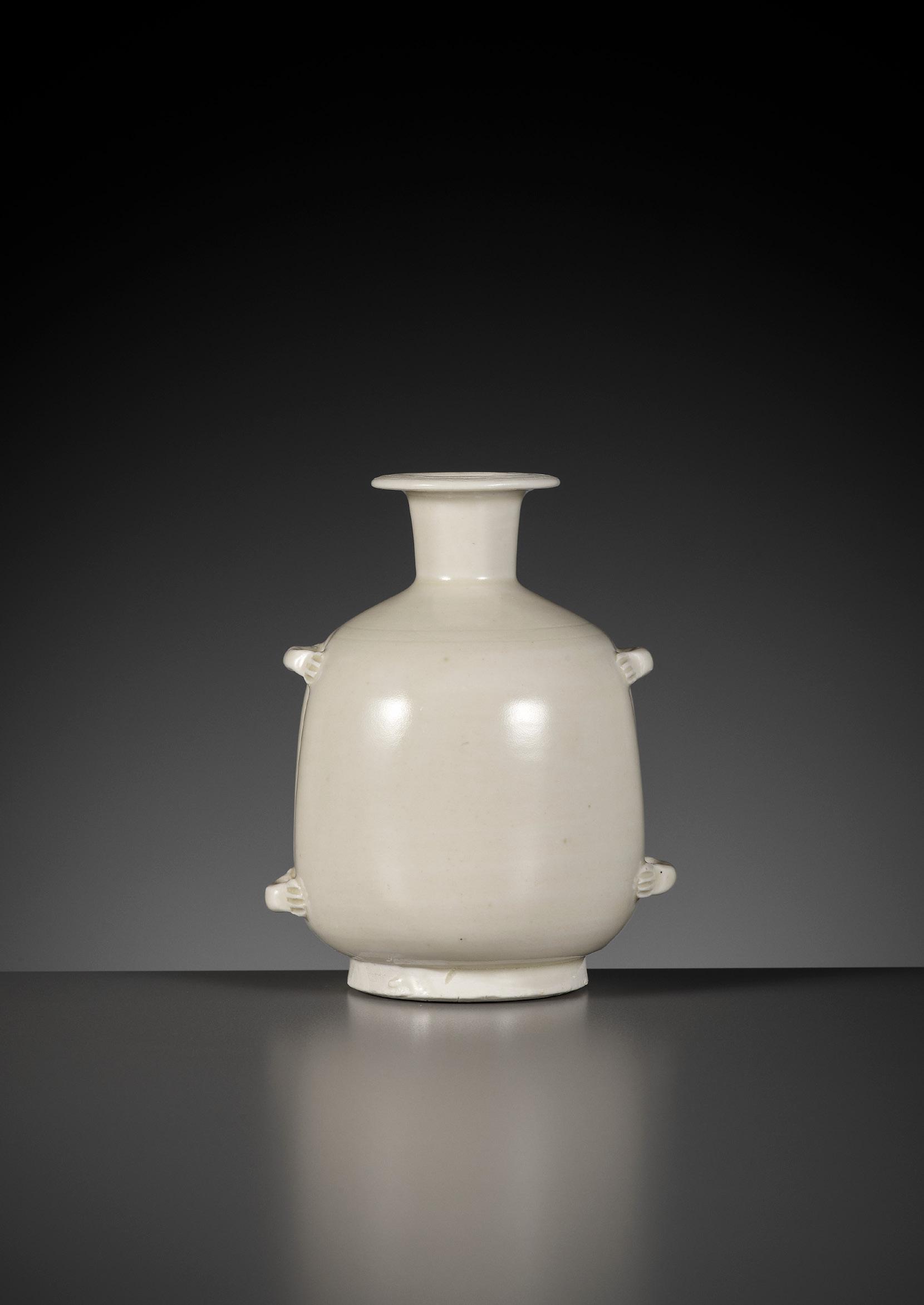
A
RARE
CIZHOU SGRAFFIATO TRUNCATED MEIPING, TULUPING, SONG DYNASTY
China, 960-1279. The high-shouldered body surmounted by a short narrow neck and outwardly curved rim, finely decorated in a cut-slip technique through the outer dark-brown layer of the slip to the white layer underneath and covered overall in a clear pale-crackled glaze. The body encircled with four large peony blooms borne on a meandering scroll with trefoil leaves below scrolling bands, all between overlapping petal-lappets. The mouth left in white slip, the unglazed base revealing the smooth pale gray ware.
Provenance: New York trade. Acquired from a private collector, by repute.
Condition: Very good condition with ancient wear, the foot with some smoothened chips, shallow surface scratches, some firing irregularities, glaze flakes, and one vertical hairline.
Weight: 1,125 g
Dimensions: Height 15 cm
Some of the most attractive Cizhou wares are those made by various kilns in northern China with designs reserved in black against a white ground. The complicated technique used to create the striking decoration in contrasting colors seen on the present piece is known by the Italian term sgraffiato, literally ‘scratched’. It first appeared around the late eleventh century, and was created through the application of contrasting layers of slip or glaze. On the present truncated bottle, a layer of dark brown, almost black slip was applied over white slip, which was later carefully incised to create decorative patterns by revealing the pristine white layer beneath, and then finally covered by a layer of clear glaze. This labor-intensive and time-consuming technique adds a sense of opulence and luxury to the stoneware.
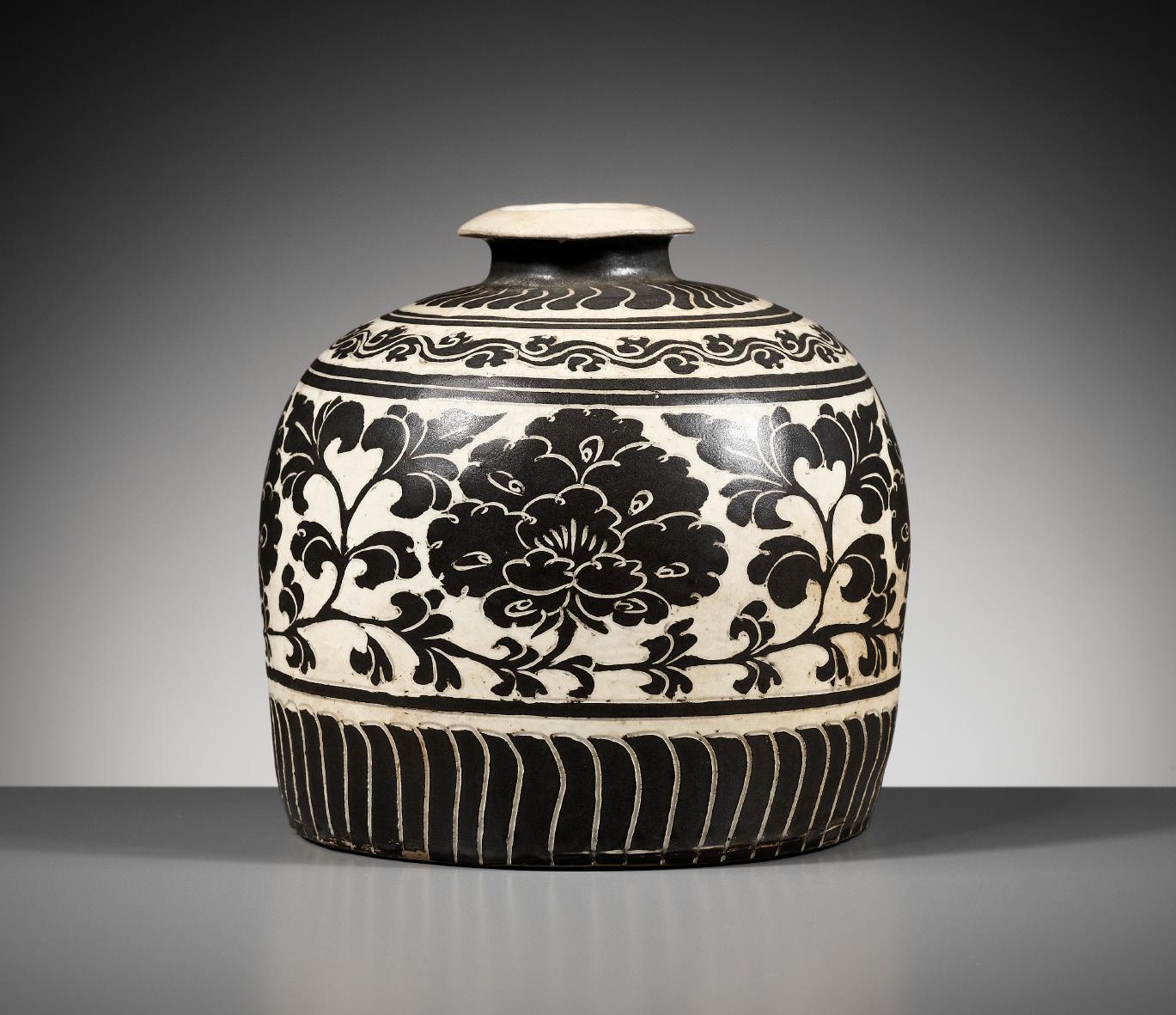
The vase is also notable for its well-proportioned form, with a small mouth, broad shoulders and a wide base, which is known as ‘tuluping’ or ‘truncated meiping’. This form, which was produced at many northern kilns, is closely related to the taller meiping, a quintessential Song shape, but enjoyed a much shorter period of production. It was produced for only about a hundred years during the eleventh and twelfth centuries, leaving behind a relatively small number of extant examples.
AUCTION RESULT COMPARISON
Type: Closely related
Auction: Sotheby’s New York, 17 March 2021, lot 123
Estimate: USD 200,000 or approx. EUR 213,000 converted and adjusted for inflation at the time of writing
Description: A superb black-glazed ‘Cizhou’ sgraffiato ‘peony’ ‘tulu’ vase, Northern Song / Jin dynasty

Expert remark: Compare the related form and sgraffiato decoration. Note the larger size (23 cm).
Estimate EUR 6,000
Starting price EUR 3,000
106 72
A LARGE CIZHOU BLACK-GLAZED RIBBED JAR, SONG DYNASTY
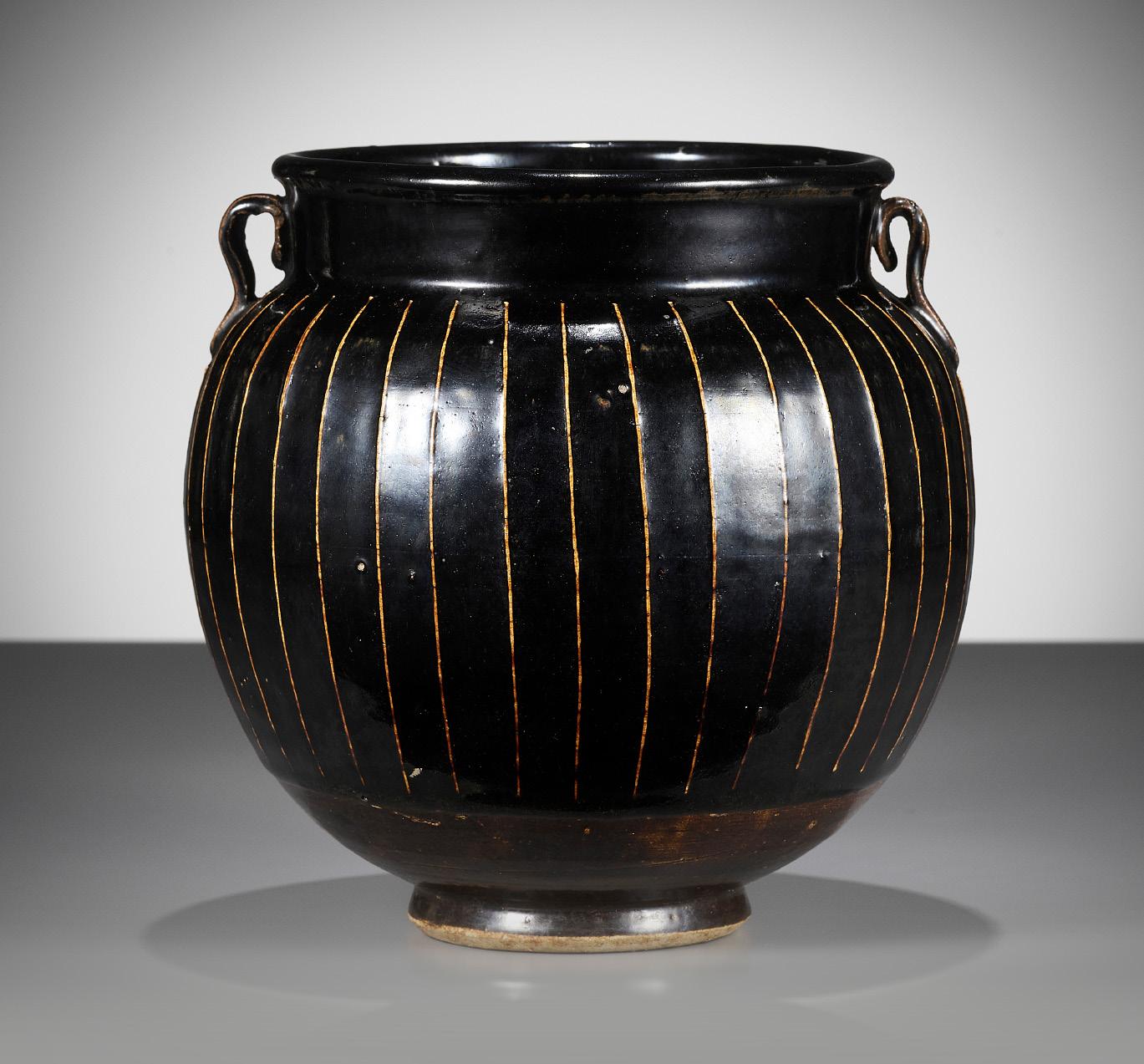
China, 12th century. The ovoid form rising from a short spreading foot to a short straight neck with an everted rim flanked by two scrolling handles. The body decorated with narrowly spaced vertical ribs formed by trails of white slip. Covered by a lustrous black glaze that continues beyond the rounded mouth rim towards the inside and thins to pale russet on the ribs and the slip ribs that decorate the tapering strap handles. The interior is covered with a thin transparent glaze of mottled brown tone, as are the lower body and base. The foot remains unglazed, revealing the buff ware.

Provenance: Hang Tang Cheng, Dragon House, San Francisco, USA, 1990s. A private collection in North America, acquired from the above and thence by descent. With an old collector’s label, manually inscribed ‘N. Song Jin 12 c, Large wide mouth, jar with vertical ribs, 37, two Kaf handle, Northern blackware, Cizhou type, light grey structure, 01157SL501-5.’ Hang Tang (Hank) Cheng is a well-respected dealer and appraiser of Asian art who ran the famous Dragon House antiques shop in San Francisco, established in 1979. Hank Cheng worked closely with museums, institutions, and auction houses including the Asian Art Museum, Bonhams, and Christie’s.
Condition: Very good condition with old wear, expected traces of use, and some firing flaws. Few small chips to foot, minor fritting to rim.
Weight: 2,534.5 g
Dimensions: Height 22 cm
With a padded silk box and cover. (2)
Notable for its large, wide-mouthed globular body and its lustrous dark glaze, the present jar is a remarkable example of Cizhou-type wares produced at numerous kilns in Henan, Hebei and Shandong Provinces in North China during the twelfth century. The attractive ribs
were meticulously applied in slip onto the surface of the vessel before the application of the glaze, creating a striking contrast between the raised ridge and the convex areas with the darker glaze.
Dark-glazed, high-fired ceramic vessels were highly regarded as solid, practical wares. Their production began during the Tang dynasty (618-907) and rapidly spread throughout China. The development of black wares during the Northern Song period (960-1127) appears to have been inspired by contemporaneous plain lacquerware, and different kilns developed their own styles. Ribs made of white slip were first used on ceramics during the Tang dynasty in imitation of lacquer and silver. Later they were added to the exterior body of the vessel during the tenth and eleventh century and ribbing finally emerged as an important tool of decoration in its own right by the twelfth century, also enabling better and safer handling of the vessel itself.
Literature comparison: Compare a closely related slip ribs and black glaze cizhou jar with handles, dated to the late Northern Song (960–1127)–Jin (1115–1234) dynasty, 12th century, 19.7 cm high, in the Metropolitan Museum of Art, accession number 1997.1.7. Also compare a related large cizhou-type black-glazed ribbed jar, dated to the Northern Song/Jin dynasty, 12th century, 20.6 cm high, at Christie’s New York, 30 March 2005, lot 295. Compare a similar black-glazed ribbed jar, Northern Song to Jin period, in the Arthur M.Sackler Museum, Cambridge MA, is illustrated in Hare’s Fur, Tortoiseshell and Partridge Feathers, Cambridge MA, 1995, p. 176, no. 61.
AUCTION RESULT COMPARISON
Type: Closely related
Auction: Bonhams London, 18 May 2023, lot 48
Estimate: GBP 15,000 or approx. EUR 17,500 converted at the time of writing
Description: A black-glazed ‘ribbed’ jar
Expert remark: Note the smaller size (20.3 cm).
Estimate EUR 6,000
Starting price EUR 3,000
73
A CIZHOU POTTERY FIGURE OF A BOY WITH A DUCK, SONG TO YUAN DYNASTY
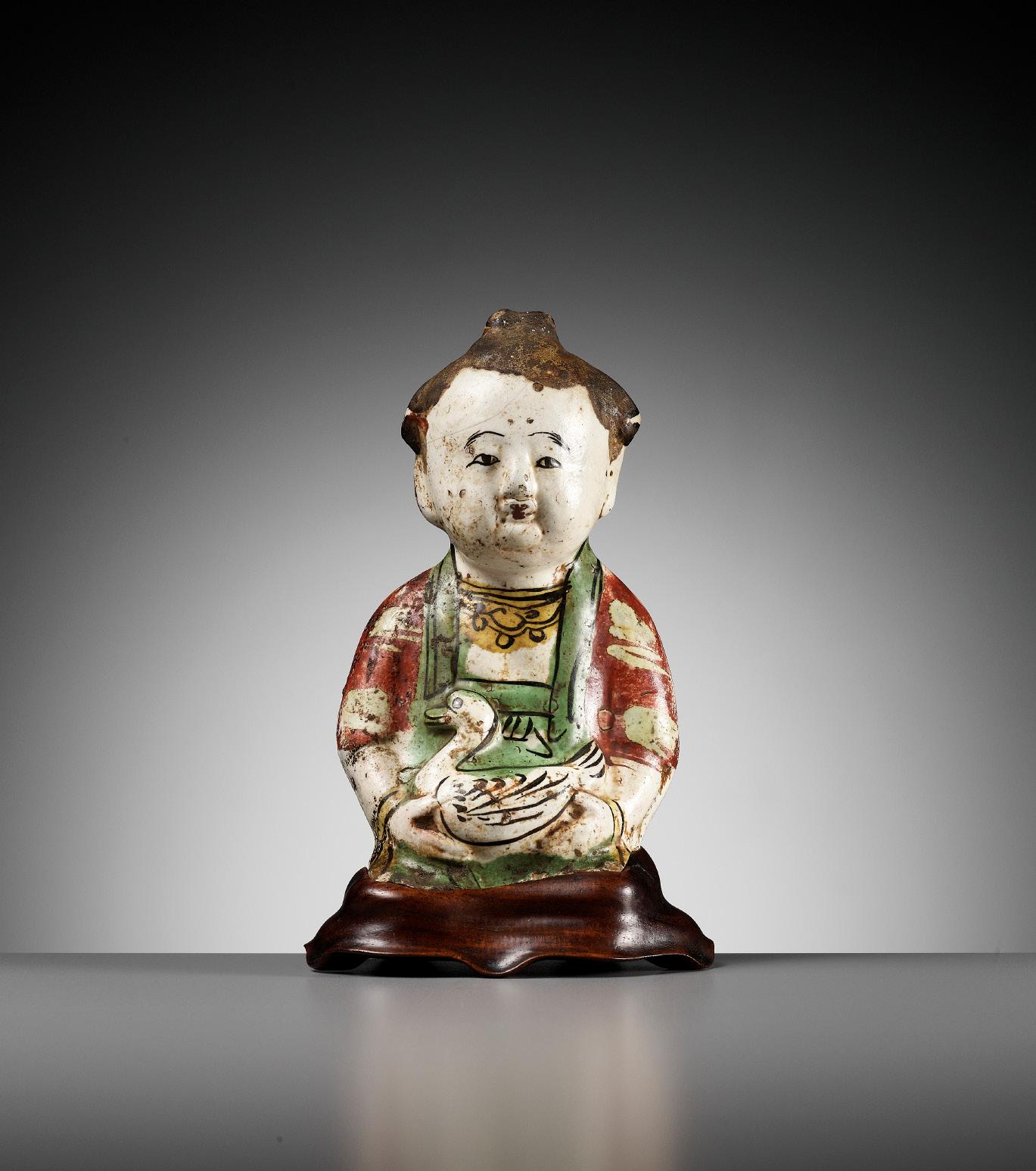
China, 11th-14th century. Well modeled as a young boy wearing a robe enameled in green and red as well as a necklace in golden amber, holding a duck with boldly painted wings in his lap. The boy’s face is neatly detailed with round cheeks and small plump lips, and his hair is tied in three tufted knots.
Provenance: From an old private collection in the United Kingdom, and thence by descent in the same family. The interior with an old collector’s number, ‘c 204’.
Condition: Old wear, soil encrustations, and expected firing flaws such as glaze recesses, pitting and dark spots. Obvious losses, chips, and small cracks. The wood base with natural wear, microscopic age cracks, a minor chip and a fine, naturally grown patina overall.
Weight: 414.1 g (incl. stand), 310.1 (excl. stand)
Dimensions: Height 16.9 cm (incl. stand), 16 cm (excl. stand)
With an old fitted stand, dating from the Qing dynasty, carved from a single piece of hardwood showing a nice grain, probably huali. (2)
Expert’s note: The present figure, of which a significant portion was lost to time, has long ago been furnished with a fitted wood stand, which perfectly follows the boy’s proportions and allows him to once again stand upright. This subtle stand, which is barely noticeable as being separate from the figure, shows that this sublime piece of pottery was already highly appreciated (and maybe even loved) long before it came into the previous owner’s possession.
AUCTION RESULT COMPARISON
Type: Closely related
Auction: Sotheby’s Hong Kong, 26 August 2021, lot 1049
Price: HKD 75,600 or approx. EUR 9,100 converted and adjusted for inflation at the time of writing
Description: A Cizhou painted figure of a lady, Southern Song-Jin dynasty

Expert remark: Compare the related modeling and manner of painting with similar pose and face. Note the size (24.5 cm) and that the figure is accompanied by a straw-glazed figure from the Tang dynasty.
Estimate EUR 3,000
Starting price EUR 1,500
108 74
A SMALL QINGBAI CENSER AND COVER, NORTHERN SONG DYNASTY
China, 960-1127. Standing on a short tapered foot, the deep rounded sides carved with overlapping petals. The domed cover of the incense burner is pierced with three rows of apertures encircling the central bud finial, all above an openworked pattern of radiating petals. The white ware of the censer and cover is glazed with a vitreous, bubblesuffused pale-blue glaze.
Provenance: Brian Page, Brighton, United Kingdom. Grahame Clarke, acquired from the above in 2008, and thence by descent in the family. Grahame Clarke (1940-2014) was a noted ceramic artist, influenced by pioneers of small-scale studio pottery such as Harry Davis, Bernard Leach, and Shoji Hamada. In 1974, he founded Highland Stoneware in Lochinver, Scotland. Driven by the historic and natural environment, his work combined the durable porcelain body, modeled on ancient century Chinese pottery, with a free hand-painted style inspired by Delftware blue-and-white decorations of the 16th and 17th centuries. His passion for ceramics led him to collect artifacts from all over the globe, but especially from China. Inspired by historic porcelain, Clarke’s work itself ended up in museums like the Victoria & Albert, exemplifying the modern movement of micro-kiln ceramic arts.

Condition: Very good condition with minor old wear and expected firing irregularities, few shallow chips, some of which have smoothened over time.
Weight: 158.8 g
Dimensions: Height 8.9 cm
LITERATURE COMPARISON
Compare a related Qingbai censer with an openwork cover, 6 cm high, dated to the Northern Song dynasty, in the Art Institute of Chicago, accession number 2013.190 (fig. 1).


Compare a related tripod censer with pierced cover which was excavated in 1981 from a site near Jingdezhen in Boyang county and is now in the Jiangxi Provincial Museum, illustrated in Zhongguo Taoci Quanji: Song (The Complete Works of Chinese Ceramics: Song Dynasty), Volume 8, Shanghai, 2000, no. 171. Compare a related Qingbai censer, illustrated in Selected Masterpieces of the Manno Collection, Osaka, 1988, no. 84. Compare a related Qingbai openwork censer, illustrated in Chinese Ceramics from the Meiyintang Collection, Volume I, London, 1994, page 329, no. 611.
Estimate EUR 2,000
Starting price EUR 1,000
109 75
fig. 1
Grahame Clarke, c. 2004
A SMALL PURPLE-SPLASHED JUN-GLAZED DISH, JIN TO

YUAN DYNASTY
China, 1115-1368. Thickly potted with shallow rounded sides rising from a short foot to a broad everted rim with a gently raised lip. Covered overall in a rich, finely crackled, sky-blue glaze thinning to mushroom at both raised edges of the rim, finely pooling to the underside around the unglazed foot revealing the brown ware, and decorated to the interior with three distinct purple splashes, one with a small patch of dark-green oxidation.
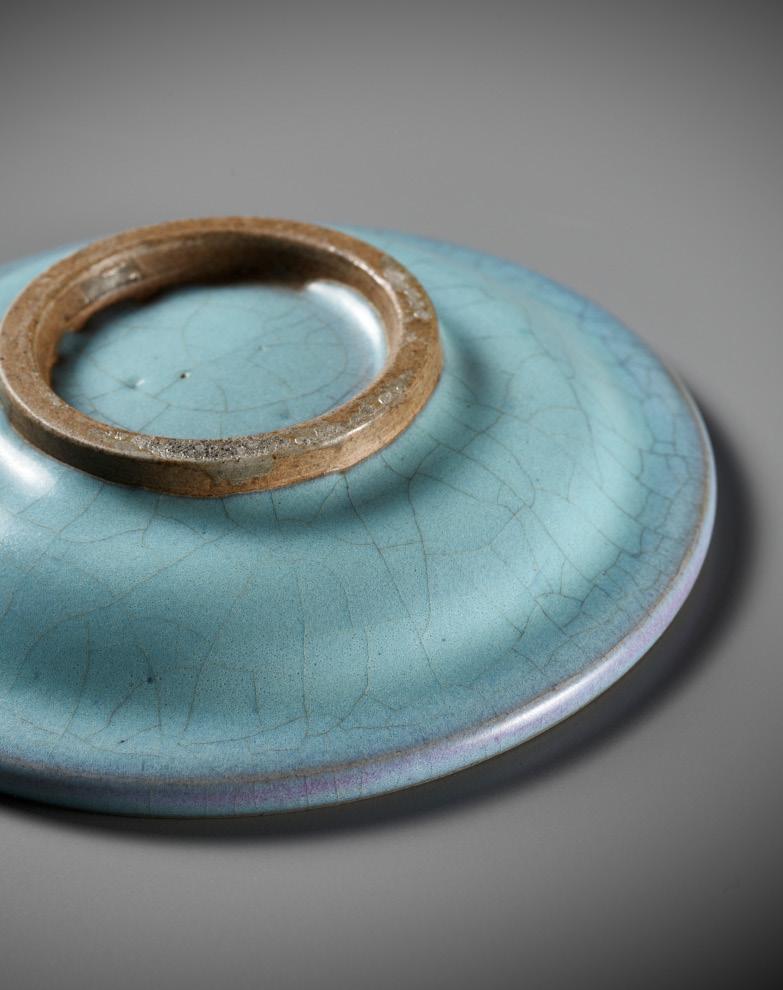
Expert’s note: The present dish shows a small patch of very dark green precipitated among one of the purple clouds, which has been noted to occur due to high concentration of copper oxide. See Rosemary Scott, Imperial Taste: Chinese Ceramics from the Percival David Foundation, London, 1989, page 39. The glaze is of remarkably quality and the dish displays exceptionally.
Provenance: French trade. Acquired from an old estate in northern France, by repute.
Condition: Excellent condition with some ancient wear and expected firing irregularities, such as small glaze recesses to the base, and a single copper oxide spot to the rim.
Weight: 197.9 g
Dimensions: Diameter 12.5 cm
Jun wares were produced at various kiln sites in Henan province and two of the main centers of production were in the modern-day cities of Yuzhou and Ruzhou. Jun has been classified by later connoisseurs as one of the ‘Five Great Wares of the Song Dynasty’ and is celebrated for its bold forms, sophisticated glazes, and innovative usage of color. The dramatic use of purple and red decoration is one of the major innovations of the Jun kilns. Purple splashes, like those seen on the present dish, were produced by the addition of copper oxide to the surface of the unfired glaze. In areas where the concentration of copper is high enough for it to re-oxidize superficially on cooling, the color sometimes turns to a distinct dark green, almost black tone.
AUCTION RESULT COMPARISON
Type: Related
Auction: Bonhams London, 28 July 2020, lot 123
Price: GBP 11,312.50 or approx. EUR 17,000 converted and adjusted for inflation at the time of writing
Description: A Jun ware purplesplashed dish, Yuan dynasty
Expert remark: Compare the related form and glaze, similarly crackled and thinning to mushroom at the outer edge of the rim, albeit not at the inner edge like on the present lot. Note the closely related size (13 cm).
AUCTION RESULT COMPARISON
Type: Related
Auction: Christie’s Hong Kong, 6 April 2015, lot 140
Price: HKD 625,000 or approx. EUR 85,500 converted and adjusted for inflation at the time of writing
Description: A purple-splashed Jun dish, Jin-Yuan dynasty
Expert remark: Compare the related form and glaze, similarly thinning to mushroom at the edges and with similar purple splashes. Note the slightly narrower rim and the size (18 cm).

Estimate EUR 10,000
Starting price EUR 5,000
110 76

77 A SLIP-INLAID CELADON-GLAZED STONEWARE OIL BOTTLE, GORYEO DYNASTY
Korea, 12th-13th century. Flattened globular body supported on a short spreading foot and surmounted by a short waisted neck with an everted lipped rim. The shoulder with a wide band of overlapping petals framed by ring borders, above two similarly framed panels enclosing lotus blossoms as well as foliate designs against a floraldiapered ground, all above a band of overlapping lotus petals and a ring-band above the foot.
Provenance: New York trade.
Condition: Good condition commensurate with age with some old wear and firing flaws, including raised bubbles in the ceramic, pitting, and chips and cracks in the glaze.
Weight: 852.4 g
Dimensions: Height 17 cm
Stoneware oil bottles were used in Korea during the Unified Silla and Goryeo periods to keep perfumed oils for the mixing of pigments used in cosmetics. These oils were generally made from fruit stones, rice bran and castor seeds.
This oil bottle has been decorated with an inlay technique called ‘sanggam’, which was invented by Korean potters in the twelfth century. The design was incised into the clay body of the vessel and then filled with slip (diluted clay). Excess slip would have been removed before the piece was biscuit fired, then the bottle was covered with a translucent celadon glaze and fired again. The development of the sanggam inlay technique signifies the elegance and innovativeness of Goryeo ceramic production; no similar inlay technique was used by Chinese craftsmen at the time.
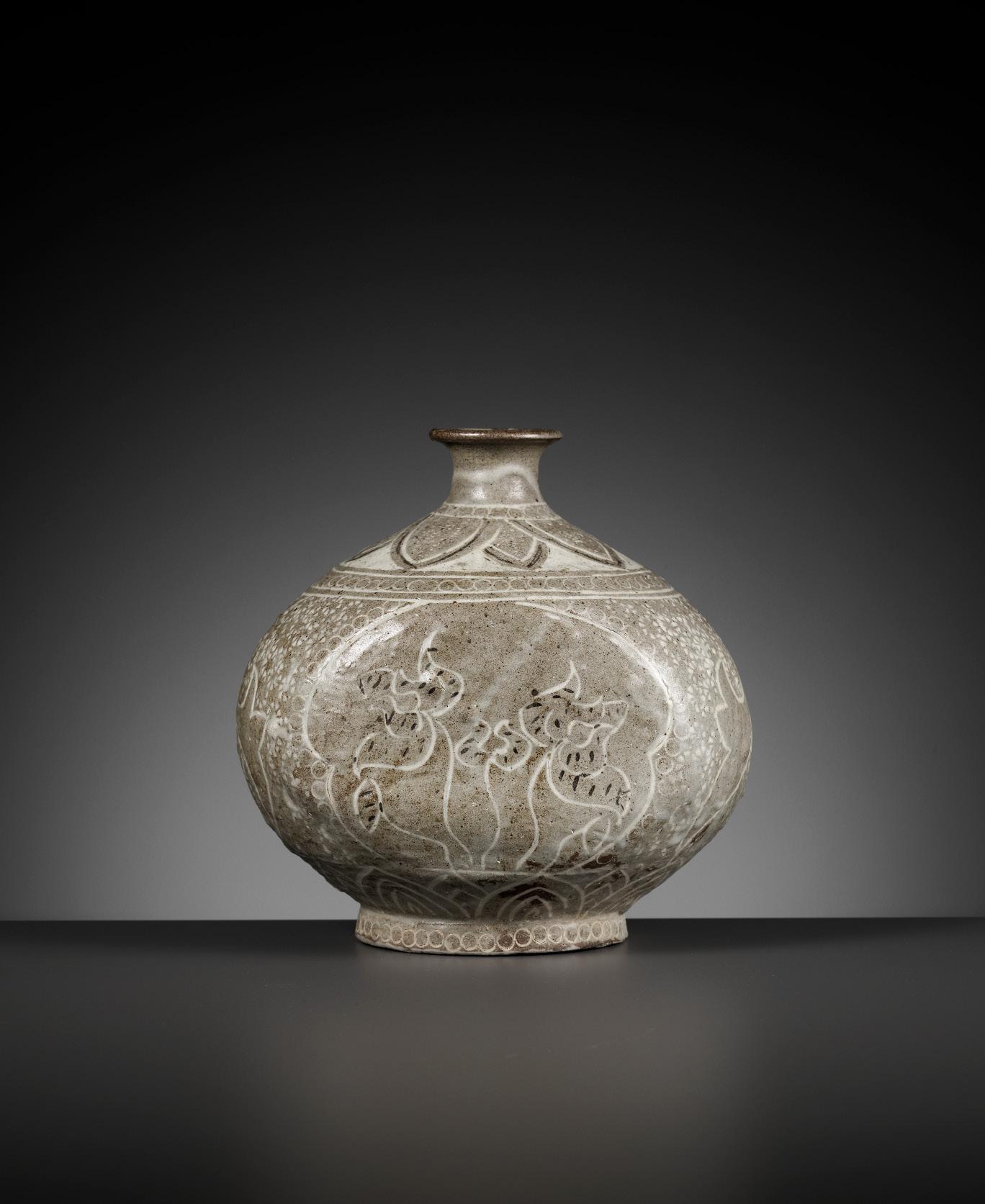
Literature comparison: Compare a related oil bottle dated to the 12th century, 8 cm in diameter, in the Princeton University Art Museum, reference number y1966-54.
Estimate EUR 3,000
Starting price EUR 1,500
112
A SLIP-INLAID ‘CHILDREN AND GRAPEVINES’ CELADON EWER, GORYEO DYNASTY (918-1392)
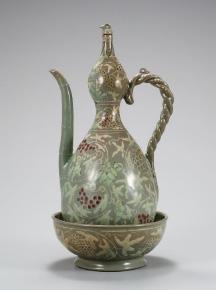
Korea, 13th century. The smooth, curved double gourd form supported on a short foot has a long, slender spout, a narrow mouth atop its smaller bulb, and a finely molded twisted-cord handle with a small ring for suspension. The body of the two bulbs is decorated using black and white slip inlay with a continuous frame of winegrowers alongside children tending to the large vines with grape bunches. The foot is decorated with stylized lotus petals, the mouth with lappets beneath a key-fret band, and the spout and handle with geometric dotted lines.
Provenance: From a private collection in France.
Condition: Condition commensurate with age, showing expected old wear and firing irregularities, such as glaze recesses, pitting, and minuscule chips to the glaze at the mouth and foot. Minute losses and several cracks, some with old repairs. The minuscule lid on top of the ewer is lost. Please request a UV light video for more details.
Weight: 2,034 g
Dimensions: Height 35 cm
The National Museum of Korea suggests that this kind of ewer was produced at a celadon kiln in Yucheon-ri, boan-myeon, or buan-gun in the north Jeolla-do province. They are decorated using the art of sanggam, which involves etching desired patterns onto dry clay and filling the carved spaces with black and/ or white slip. After that, a translucent glaze is applied, and the vessel is fired.

Wine made from grapes reached eastern Asia for the first time during the Hellenistic period (321-32 BC). It became highly popular in China 600 years later during the Tang dynasty (618-907 AD) and historians believe it attracted mainstream interest in Korea only after Jesuit missionaries imported it at the beginning of the 17th century. However, it is known that it was available to elite circles much earlier, which explains the rarity of the design on the present ewer to some extent.
LITERATURE
COMPARISON
Compare a near identical wine ewer with the same decorations and motif, 36 cm high, dated to the Goryeo dynasty, in the National Museum of Korea, accession number Deoksu 19 (fig. 1). Compare a closely related celadon ewer with a landscape design, 36 cm high, dated to the Goryeo dynasty, in the National Museum of Korea, accession number Deoksu 91. Compare a related celadon gourd-shaped ewer, 29.8 cm high, dated to the Goryeo dynasty, in the National Museum of Korea, accession number Deoksu 6236.
Estimate EUR 6,000
Starting price EUR 3,000
78
fig. 1
A BLUE AND WHITE ‘PEONY, PHOENIX AND LONGMA’ VASE, MEIPING, CHINA, 14TH-15TH CENTURY
Finely painted in ample detail and neatly graduated shades of cobalt blue with a continuous undulating stem bearing four large peony blooms, each with furled petals. The stem growing spiky leaves on scrolling vines, all elaborated in stark contrasts of manifold pale and soft blue tones with innumerable minuscule dots of blackish blue, all between narrow bands of classic scroll and double lines. This main frame is beneath a masterfully painted band of phoenix and longma outlined in deep blue, detailing the fine scales, feathers, wings and tails of these mythical creatures, all enclosed by densely flowering lotus blossoms, and beneath a band of scroll design which encircles the short upright neck with its flared mouth rim. The base with a wide border of rectangular lappets. The broad shoulders elegantly tapering to a slightly splayed foot.
Provenance: Belgian trade. Acquired from the estate of a noble family in Belgium, where it has been for quite some time, by repute.
Condition: Old wear and weathering. Expected firing flaws, such as glaze gaps and recesses, glaze crackling, minute firing cracks, extensive pitting, minor kiln grit, and a circumferential luting line below the shoulder. One glaze recess is revealing some of the original blue color below the thick and somewhat opaque layer of transparent glaze above. The lower section with a single crack, which has become black over time. The base and the lip have been excised so that the vase could fit into a mounting. This was probably done in the 18th-19th century, shortly after the vase made its way to Europe. The mounting was then removed again, probably during the 20th century, and the base and lip were restored accordingly. This restoration was carried out a long time ago, for that the fills at the lip have turned yellow, now standing out against the original color of the ware.
Weight: 4,224 g
Dimensions: Height 43.2 cm
This elegant meiping is a classic example of early Chinese blue and white porcelain. The form is well-proportioned and the vessel sturdily yet elegantly potted. It is decorated in rich and well-graduated cobalt blue which had to be imported at great expense during this period. The banded design makes good use of the extensive canvas provided by the vase’s form. The three major decorative bands are in pleasing contrast to one another. They include four of the most successful motifs of the 14th century: longma and phoenix, the bold peony scrolls, and the lappet panels.
The longma is an auspicious creature that, according to legend, is said to represent gratitude. During the Xuande reign it was introduced as a principal decoration and has been a popular subject ever since. While depictions of longma on porcelain from this period are quite common, earlier versions of it are quite rare to find.
LITERATURE COMPARISON
Compare the form of the present lot and the longma and phoenix designs with several examples from the 14th century in Toji Taikei, Vol. 41, Gen no Sometsuke, by Yabe Yoshiaki, Publisher Heibonsha, Tokyo, Japan, 1974.
FOR THE FORM:
Nr. 37, blue and white vase, Meiping, height 34.6 cm


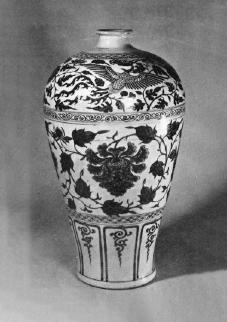

FOR THE PHOENIX:
Nr. 38, blue and white ‘’peony and scroll’’ vase, Meiping, height 43.7 cm
Nr. 66, blue and white ‘’seahorse and phoenix’’ vase, same item as Nr. 59, height 25.4 cm
FOR THE LONGMA:
Nr. 8, blue and white ‘’seahorse’’ plate, diameter 47 cm, Topkapı Palace Museum
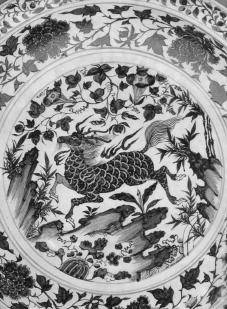

Nr. 59, blue and white ‘’seahorse and phoenix’’ vase, same item as Nr. 66, height 25.4 cm
Estimate EUR 10,000
Starting price EUR 5,000
114 79
Nr. 37 Nr. 38
Nr. 8 Nr. 59
Nr. 66

A RARE ‘THREE-LEGGED TOAD’ CELADON-GLAZED WATER POT, ANNAM, 15TH-16TH CENTURY

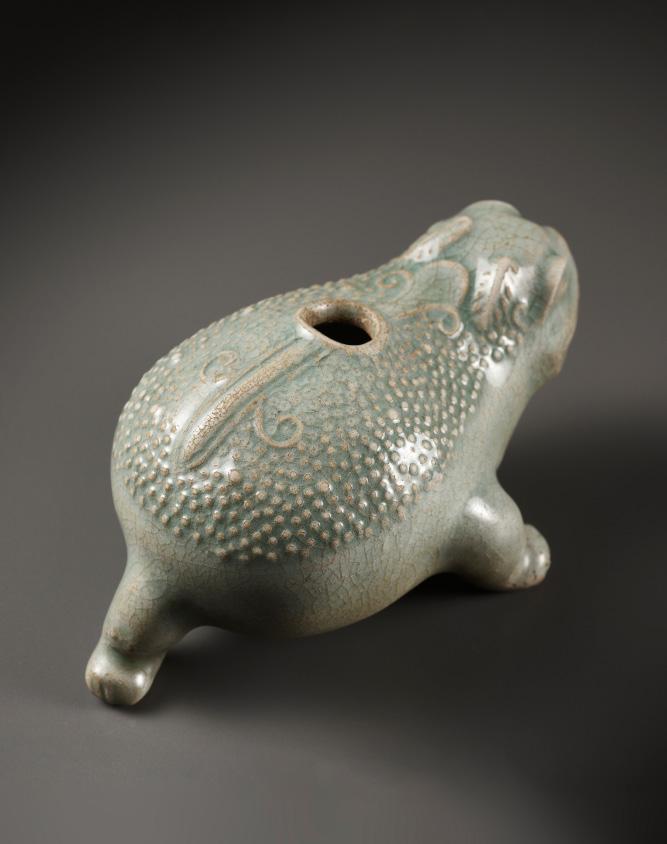
Standing on three legs, the toad gently lifts its head. Its body is decorated with raised warts as well as scroll designs along its spine, its well detailed face has an animated mouth and prominent arched brows. Covered overall with a finely crackled celadon glaze, thinning considerably to the raised sections. The top of the toad’s back with a large circular aperture with raised rim.
Provenance: From a notable private collection in Bavaria, Germany. Condition: Very good condition with expected old wear and some firing irregularities, minor glaze flaking, fritting and few minuscule chips.
Weight: 182.6 g
Dimensions: Length 12.8 cm
The three-legged toad represents a popular feng shui charm for prosperity. It is usually depicted as a bullfrog with bulging eyes, flared nostrils and only one hind leg. According to feng shui beliefs, the toad helps to attract and protect wealth, and guards against bad luck. This three-legged toad, associated with the Chinese immortal Liu Hai, was also a popular motif in Vietnamese and Korean art. See, for example, a related white porcelain toad-shaped water dropper, dated to the Joseon dynasty, in the National Museum of Korea, accession number Namsan 409.
LITERATURE COMPARISON
Compare a closely related Annamese greenglazed toad-form water dropper, dated 15th-16th century, at Christie’s London, 7 December 1984, lot 29, and illustrated in Adrian Joseph, Chinese and Annamese Ceramics, no. 78.
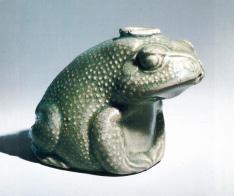
116 80
Estimate EUR 3,000 Starting price EUR 1,500
AN
ANNAMESE POLYCHROME ‘BIRDS AND BUTTERFLY’ DISH, VIETNAM, 15TH-16TH CENTURY
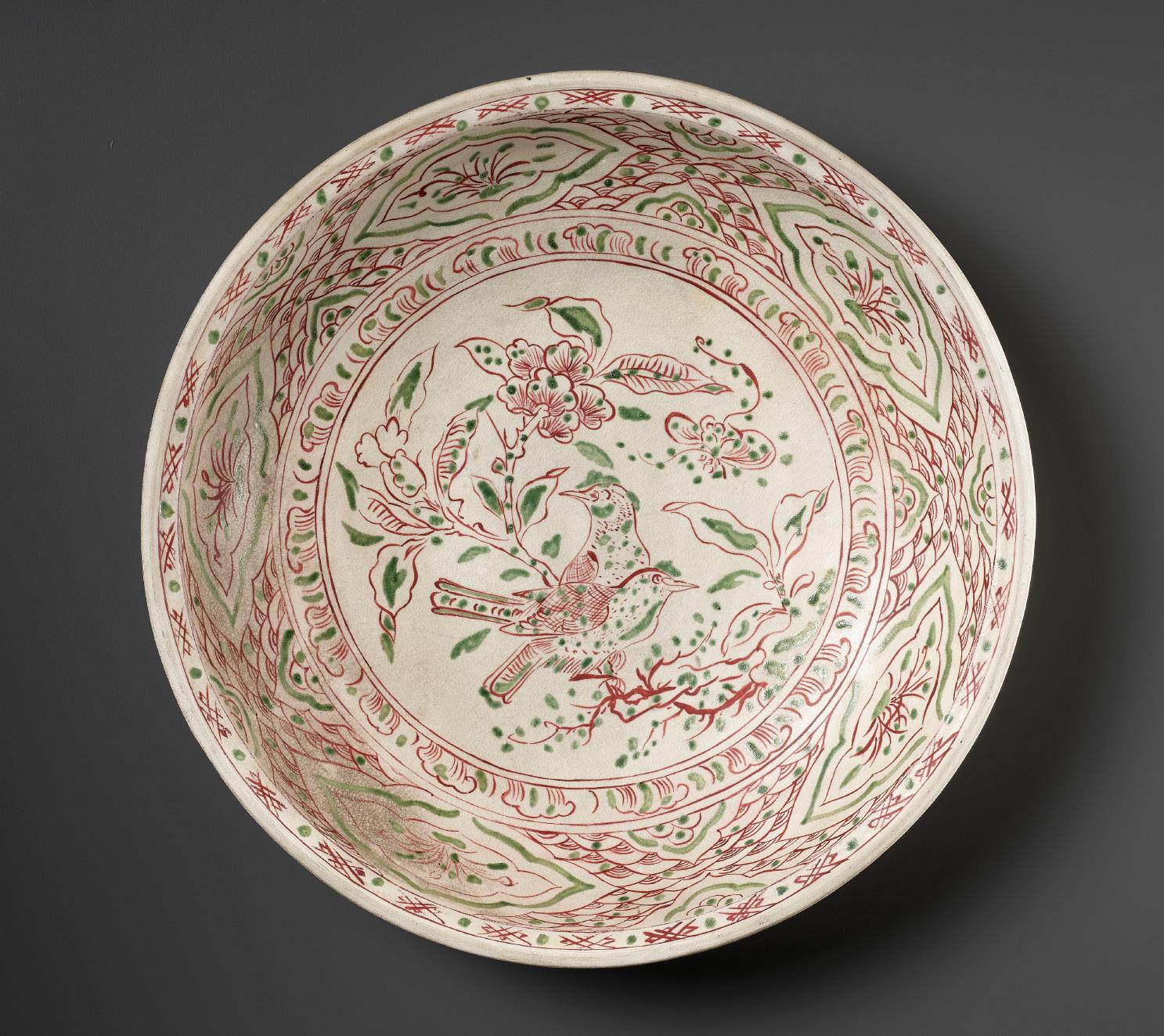
The shallow rounded sides rising from a short foot to an everted lipped rim. Freely and deftly painted, the central panel decorated with two sparrows perched on a flowering peony branch as a butterfly hums nearby, encircled by floral sprays within foliate cartouches against a ruyi and wave ground below a geometric border to the rim, the exterior sides with a lappet border, the unglazed base covered with a reddish-brown wash.
Provenance: Blitz Oriental Art, Amsterdam. A private collection in New York, USA, acquired from the above. The base with an old label, ‘Blitz Oriental Art Amsterdam.’ Blitz Oriental Art was founded in 1978 by Dries and Diana Blitz in Amsterdam, Netherlands. Since its establishment, the business has sold many fine objects to collectors and museums worldwide. They are renowned for their early Chinese ceramics and works of art. Today, pieces bought from Blitz can be found in the British Museum, Metropolitan Museum of Art, National Palace Museum, Taipei, Victoria and Albert Museum, and the Harvard University Art Museums, among others.
Condition: Very good condition with minor wear and firing flaws, few microscopic chips. The glaze with crackling overall, inherent to manufacturing, some of which has expanded into superficial glaze lines.
Weight: 1,764 g
Dimensions: Diameter 34 cm
Literature comparison: Compare a closely related Annamese dish, dated to the 16th century, in the Brooklyn Museum, accession number 2021.17.1. For a related dish in the Metropolitan Museum of Art, see J. Guy, Vietnamese Ceramics: A Separate Tradition, New York, 1997, p. 314-315, nos. 251 and 252. See also another bird dish of the same size with the addition of underglaze blue outlines to some of the decoration that sold at Christie’s London, 7 December 1984, Important Annamese Ceramics: The Mr. and Mrs. Robert P. Piccus Collection, lot 106.
AUCTION RESULT COMPARISON
Type: Closely related
Auction: Christie’s New York, 23 March 2010, lot 277
Price: USD 6,875 or approx. EUR 8,900 converted and adjusted for inflation at the time of writing
Description: An overglazed enameled ceramic dish, Vietnam, Annamese, 15th/16th century Expert remark: Note the size (41.8 cm).
AUCTION RESULT COMPARISON
Type: Closely related
Auction: Christie’s Hong Kong, 23 November7 December 2021, lot 3327

Price: HKD 75,000 or approx. EUR 9,200 converted and adjusted for inflation at the time of writing
Description: A large and rare Annamese polychrome ‘lotus’ dish, 15th-16th century
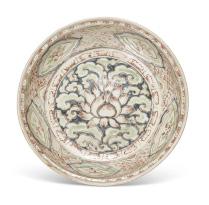
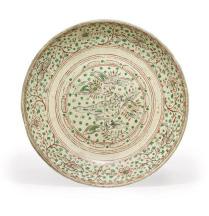
Expert remark: Note the size (34.5 cm).
Estimate EUR 4,000
Starting price EUR 2,000
81
Dries Blitz
A LARGE ANNAMESE BLUE AND WHITE BOWL, VIETNAM, 14TH-15TH CENTURY


Sturdily potted with deep rounded sides supported on a short foot and rising to an everted rim, finely painted in shades of cobalt blue to the interior with a central medallion enclosing two chrysanthemum blossoms borne on leafy scrolling vines, the rim encircled by a scroll band between double-line borders, the exterior similarly decorated with pairs of chrysanthemum blossoms and foliate scroll. Covered overall in a thick transparent glaze, save for the base with only few splashes of glaze and revealing the ware burnt to orange in the firing.
Provenance: London trade.
Condition: Very good condition with some wear and firing flaws including warping, dark spots, kiln grit, firing cracks, pitting, glaze recesses, and the foot slightly smoothened, all inherent to manufacturing.
Weight: 4,033 g
Dimensions: Diameter 44.9 cm
LITERATURE COMPARISON
Compare a related Annamese blue and white bowl with similar warping, 30.5 cm in diameter, dated 15th century, in the Detroit Institute of Arts, accession number 72.716.

AUCTION RESULT COMPARISON
Type: Related
Auction: Christie’s New York, 20 September 2000, lot 173
Price: USD 9,400 or approx. EUR 15,000 converted and adjusted for inflation at the time of writing
Description: A blue and white dish, Annamese, 14th/15th century Expert remark: Compare the related form and decoration with similar central floral roundel and scroll band encircling the rim. Note the size (40 cm).
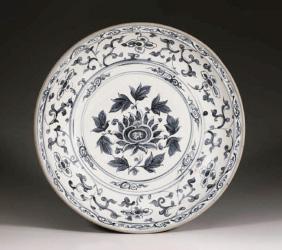
Estimate EUR 6,000
Starting price EUR 3,000
82
A PAIR OF SANCAI FIGURES OF PERSIAN AMBASSADORS, LATE MING DYNASTY

China, 16th - 17th century. Well modeled in mirror image, each standing on a shaped base holding a tributary vase in both hands, wearing elaborate robes secured with a belt and carved with floral and foliate designs, high boots, and tall caps. Their faces with curling mustaches and bushy eyebrows, their mouths agape. (2)

Provenance: From an Italian private collection. Each with an old label to the base inscribed in Italian, ‘Sancai (three color) pottery. Ming period (1368-1644). Candle holder – Turk with vase (180).’
Condition: Expected old wear and firing flaws, small losses, few cracks, some glaze flaking, as well as minor old repairs and touchups.
Weight: 2,923 g and 2,898 g
Dimensions: Height 44.3 cm and 43.9 cm

Throughout Chinese history, tributary states and tribes were required to periodically send their ambassadors to the Imperial court and pay tribute with valuable gifts. Drawings and paintings with short descriptions were used to record the tribute of these ambassadors and to document cultural aspects of these ethnic groups. Descriptions were written alongside these portrayals, which became later highly valued as historical sources regarding the international relations between China and the rest of the world. The Portraits of Periodical Offering of Liang was painted by the soon to be Emperor Yuan of Liang, Xiao Yi (ruled 552-555 AD) of the Liang dynasty while he was a governor of the Jingzhou province as a young man between 526-539 AD, a post he held again between 547-552 AD. During his time as governor, he had the opportunity to meet many foreigners. One of his paintings depicts a Persian ambassador and likely served as the inspiration for these two figures.
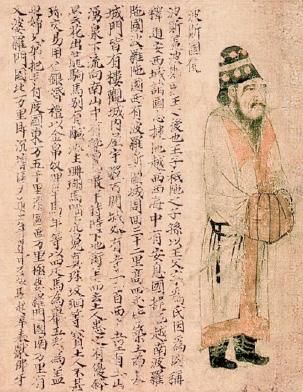
AUCTION RESULT COMPARISON
Type: Closely related
Auction: Galerie Zacke, Vienna, 15 October 2021, lot 194
Price: EUR 15,168 or approx. EUR 17,000 converted and adjusted for inflation at the time of writing

Description:
sancai
Estimate EUR 6,000
Starting price EUR 3,000
119 83
A sancai figure of a foreigner wearing a Persian cap, excavated at Xi’an in 1955, exhibited in Treasures of Ancient China at the Canadian Museum of Civilization, 11 May to 28 October 2007
The Persian ambassador at the Chinese court of Emperor Yuan of Liang in his capital Jingzhou in 526-539 CE, with explanatory text. Portraits of Periodical Offering of Liang, 11th century Song copy
A rare
roof tile depicting a Persian ambassador, late Ming dynasty Expert remark: Compare the similar headdress and curly hair typical of depictions of Persians. Note the size (49 cm).
AN EARLY FAHUA-GLAZED ‘LOTUS’ JAR, GUAN, WITH FOUR LION-MASK HANDLES, MING DYNASTY
Expert’s note: The lion mask-handles in such high relief are extremely rare in fahua-glazed Guan jars of this type. While they did exist with other styles of fahua vessels, like the stools at Sotheby’s referenced in the literature comparison below, no other jars of this type are recorded in public or private collections.
China, late 15th to early 16th century. Heavily potted with a baluster body supported on a short tapered foot and rising to a short waisted neck with a galleried rim. The exterior is slip decorated and brightly glazed in blue, turquoise, aubergine, yellow, and cream with two egrets, one standing and the other flying, in a lotus pond with blossoms, buds, and leaves, in the back a small butterfly, all above crashing waves. The shoulder encircled by a band of lotus scroll and applied with four pierced lion-mask handles that once suspended loose bronze rings, below a band of foliate scroll to the neck.

Provenance: From the Langlois Collection. JeanMarie-Charles Langlois (1896-1949) arrived in Vietnam in 1920, where he served as the principal engineer for the Indochinese railways until 1949. As a sinophile who spoke fluent Mandarin, he built an important collection of Asian works of art. In 1949, he was imprisoned by the Viet Minh during a train attack and executed on the same day. His wife and two sons came back to Burgundy near Dijon, France, bringing Jean Langlois’ collection with them. Once in France, his family continued to buy Asian works of art on the French art market, thus paying tribute to Jean Langlois’s memory.
Condition: The raised slip is remarkably well preserved. The jar remains in its absolutely original condition with no restorations of any kind. Obvious glaze losses as seen on images, some of them smoothened. Old wear, expected firing flaws, shallow surface scratches and tiny nicks. Displaying exceptionally well, despite its age of roughly half a millennia.
Weight: 4,451 g
Dimensions: Height 28.8 cm
The term ‘fahua’ may derive from the Chinese term ‘fenhua’, meaning ‘powdered decoration’ and refers to a group of medium-fired glazes developed in the late 15th century on the basis of the Yuan Dynasty liu li glazes (see Q. Wang, A Dictionary of Chinese Ceramics, Shanghai, 1989, p. 220). Due to the very liquid nature of the glazes, the variously colored areas are isolated from one another by clay walls which tend to vary in thickness.
Variations in the vivacity of the colors applied, as well as different shapes and subjects of decoration, may be attributed to different eras of production (see D. Lion-Goldschmidt, Ming Porcelain, London, 1978, p. 127). On this matter, Lion-Goldschmidt also notes that the early fahua wares tend to feature motifs of lotus rising from water, as well as cranes, birds, and figures. The author further points out that complimentary decoration on fahua, i.e. that found on necks, rims, and feet, also relates to the designs, found on late 15th century blue and white wares.

Egrets or cranes provide a homonym for ‘lu’ (‘a path’), alluding to attainment. When this imagery is combined with flowering lotus (lian) it forms the rebus, ‘Yilu lianke’ (‘May you pass your exams one after another’).
Literature comparison: Compare a related pair of fahua-glazed stools also decorated with egrets in a lotus pond and applied with similar lionmask handles suspending gilt-bronze rings, 44 cm high, dated to the Ming dynasty, at Sotheby’s Paris, 11 April 2018, lot 305.
AUCTION RESULT COMPARISON
Type: Closely related
Auction: Sotheby’s London, 13 May 2015, lot 289
Price: GBP 18,750 or approx. EUR 32,000 converted and adjusted for inflation at the time of writing
Description: A large fahua ‘lotus’ jar, Guan, Ming dynasty
Expert remark: Compare the related guan form, lotus pond decoration, and fahua glaze. Note the associated wood cover and that the jar is restored to the neck unlike the present lot which is in absolutely original condition.
Estimate EUR 8,000
Starting price EUR 4,000
120 84
Madame Langlois in her home in Hanoi, ca. 1930
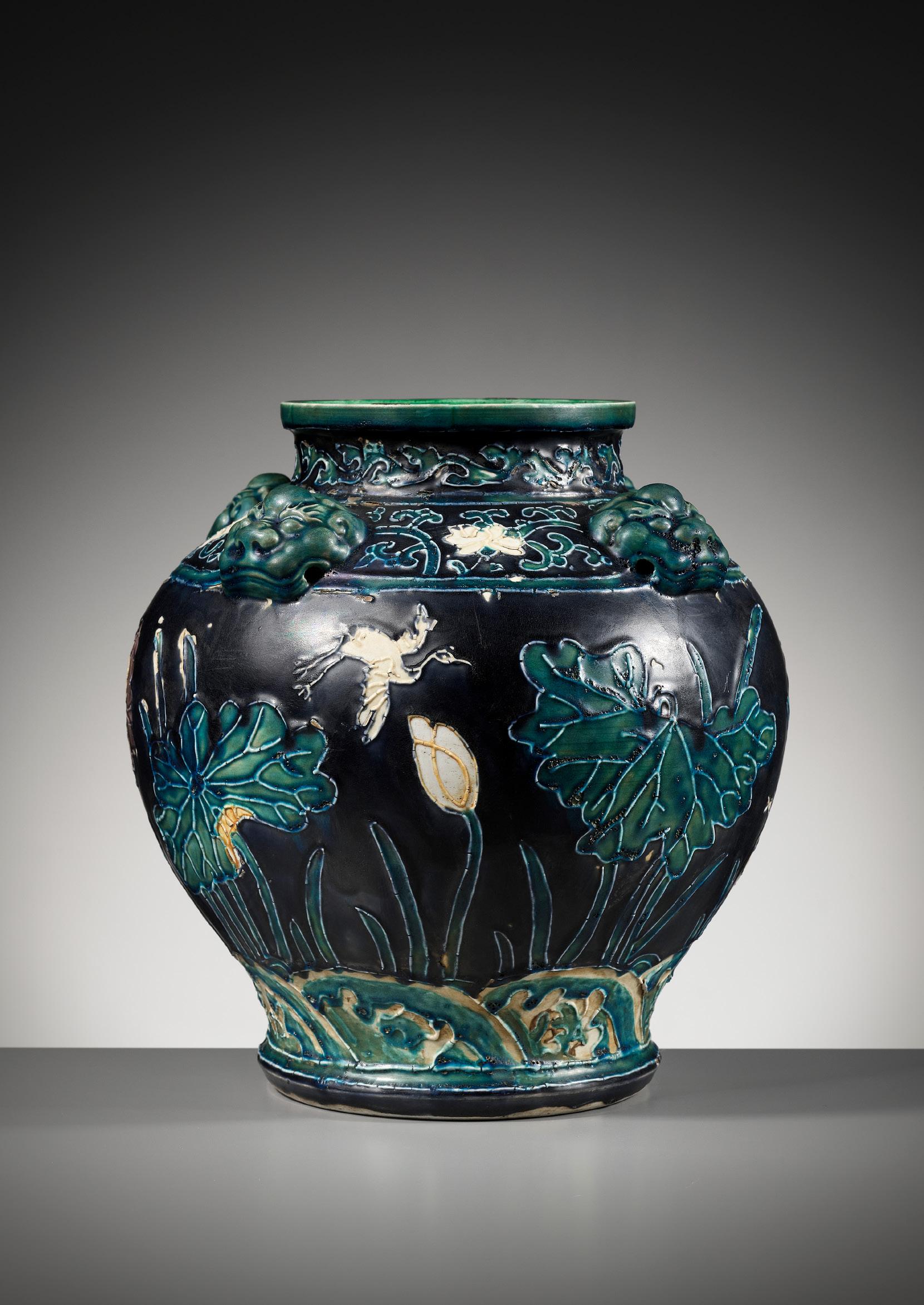
85
A LARGE AND RARE ‘QILIN, MYTHICAL HOUND AND BUDDHIST LION’ JAR, MING DYNASTY, JIAQING PERIOD, 1521-1567
Expert’s note: The combination of iron-red and green glazes was utilized primarily during the Jiajing period (1521-1567). According to Daisy Lion-Goldschmidt in Ming Porcelain, New York, 1978, page 164, in her discussion of the ‘Red-and-Green’ Group, this palette would come to dominate polychrome porcelains, eventually leading to the appearance of famille verte during the second half of the seventeenth century.
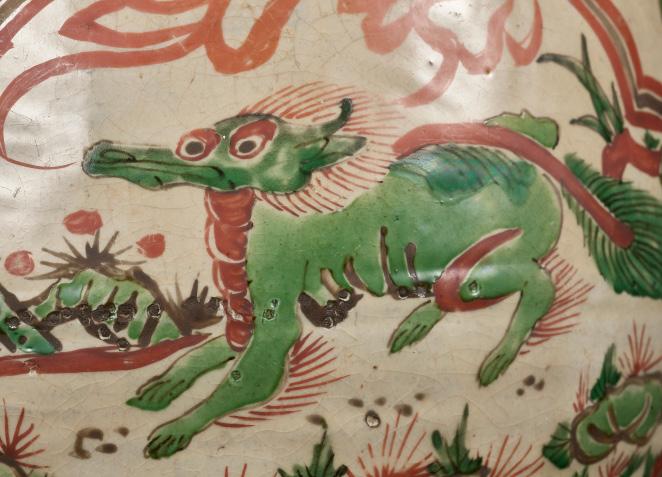
China. The ovoid body is supported on a flat base and rises to a short and slightly flared neck with a lipped rim. Boldly painted in green, red, and aubergine enamels with three lobed panels enclosing a mythical hound, a Buddhist lion and a Qilin, each with a long snout and standing foursquare amid foliage and rockwork depicted in profile and facing the viewer, surrounded by floral sprays, all beneath a band of phoenixes and peony blossoms below the rim decorated with lingzhi sprays. Covered overall with a finely crackled transparent glaze of a pale ivory tone, the interior with a dark brown glaze.
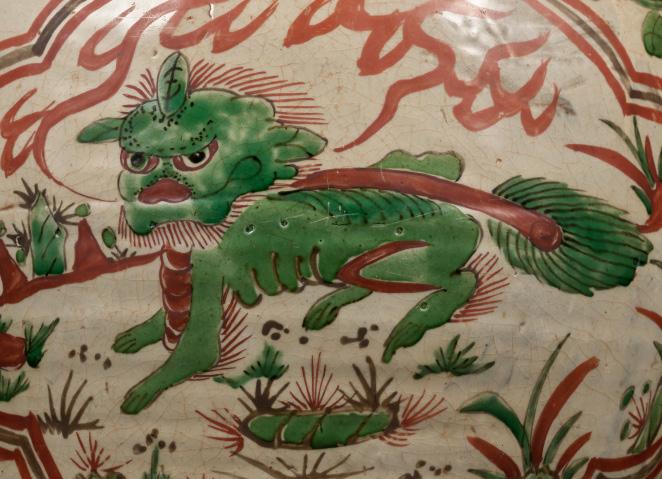
Provenance: The J. M. Hu, Zande Lou Collection. An old, padded silk box fitted to the vase accompanies the lot. Jenmou Hu (1911-1995) was arguably the most important collector of Chinese ceramics in the last century. In both his personal collection and in his bequests to cultural institutions, J. M. Hu stood as a model of the modern scholar-collector. Condition: Remarkably well preserved with expected old wear and firing irregularities, including some burst bubbles particularly to the interior of the mouth rim with an associated linear crack in the glaze and to the center of the body as well as tiny bumps, dark spots, and glaze recesses. Occasional light scratches. Displaying exceptionally, due to its size and near-pristine condition.
Weight: 13.5 kg
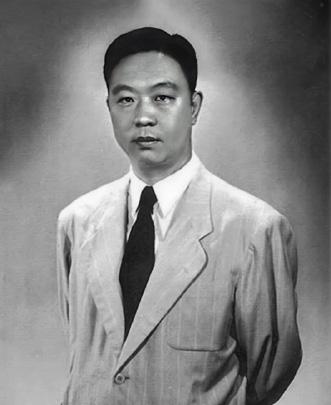
Dimensions: Height 40 cm
Literature comparison: Compare a related red and green enameled porcelain ‘min yao’ dish donated by R. Soame Jenyns, 30.3 cm in diameter, dated to the Ming dynasty, likely Jiajing, in the British Museum, registration number 1951,1010.1. Compare a related polychrome enameled jar decorated with horses, with a Jiajing mark and of the period, 18 cm high, in the Metropolitan Museum of Art, accession number 1991.253.58.
Estimate EUR 8,000
Starting price EUR 4,000
122
Jenmou Hu, The Master of Zande Lou
Mythical hound
Buddhist lion
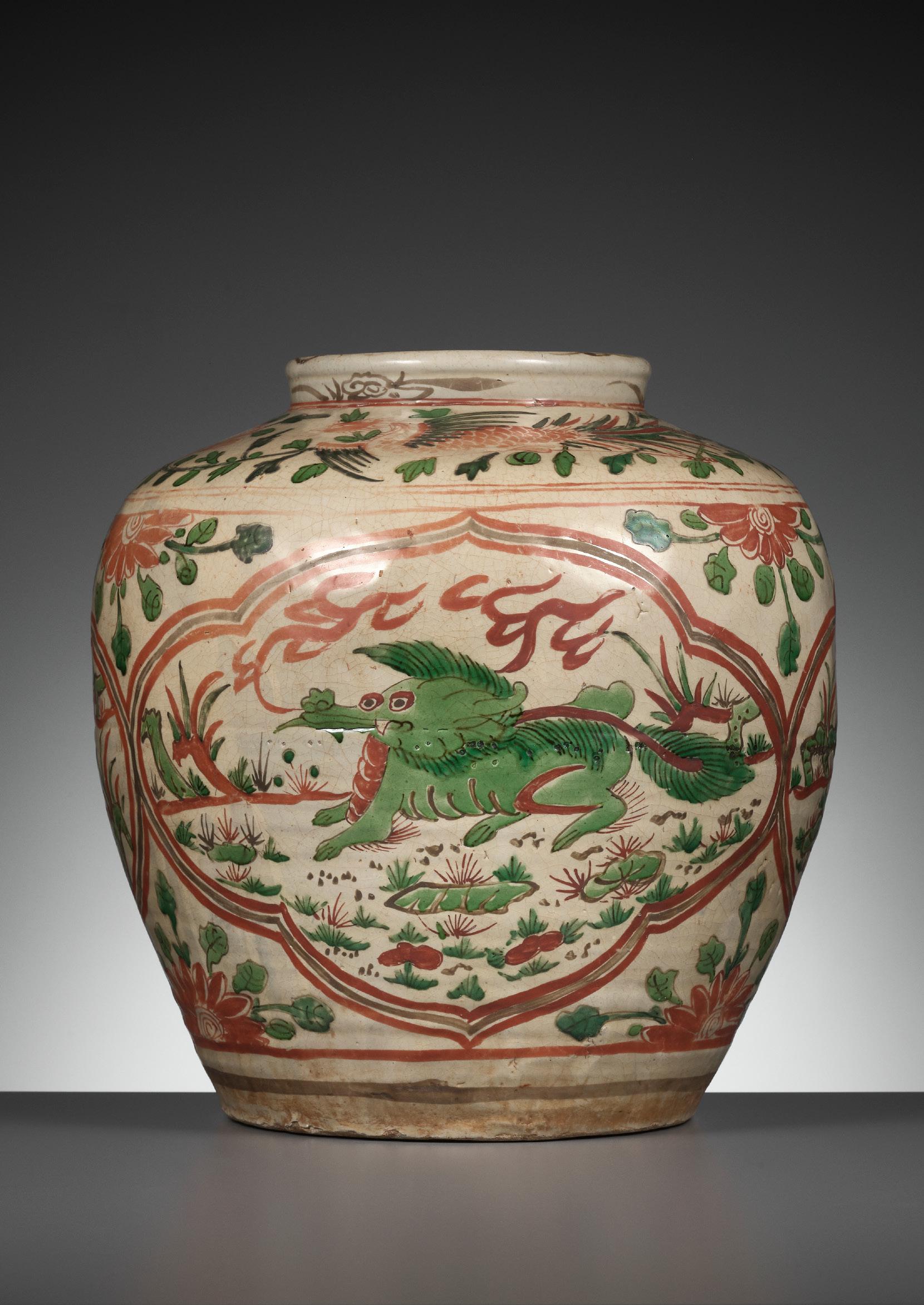
A RARE BLUE AND WHITE ‘FOUR IMMORTALS’ JAR, JIAJING MARK AND PERIOD, CHINA, 1522-1566
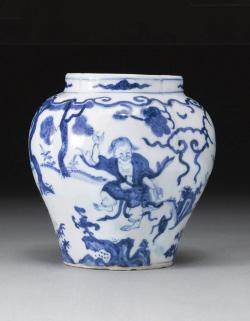

Of quadrilobed form with swelling shoulders and a petite upright neck, painted in deep cobalt blue with four Daoist immortals: Li Tieguai with his iron crutch and gourd vessel, Liu Hai with his three-legged toad, and the Hehe twins Hanshan and Shide, one of whom is holding up a scroll with a smile on his face, all amid pine trees and rockwork, below a scrolling cloud border at the shoulder and ruyi clouds on the neck. The base with an underglaze-blue six-character mark da Ming Jiajing nianzhi and of the period.
Provenance: Solveig & Anita Gray, London, United Kingdom, 1998. The Elaine Whewell collection of Asian ceramics, North Berwick, Scotland, assembled since the 1990s, acquired from the above. Three old labels along the base and interior of the mouth, ‘Solveig & Anita Gray, 58 Davies Street London, W1Y 2L P’ ‘Solveig & Anita Gray, Jiajing 1522-66,’ and ‘Solveig & Anita Gray, 4800.’ Copies of the original invoice, receipt, and declaration of antiquity from Solveig & Anita Gray, all dated 9 December 1998, confirming the dating above and describing the present lot as an “Extremely Rare Jiajing Jar”, accompany this lot. Condition: Very good condition, commensurate with age, with expected old wear and firing irregularities. Two very short hairlines to the rim. A small star-shaped glaze line to the interior, which is not visible on the outside. The rim and foot may have been minimally smoothened.
Weight: 416.1 g
Dimensions: Height 11.9 cm
Li Tieguai aka ‘Iron Crutch Li’ appears as a lame beggar supported by an iron crutch. He carries a gourd which holds medicine that cures the sick and ailing. Traditionally, he has been seen as the protector of physicians. Although he may appear ugly and is generally considered irascible and illtempered, according to Chinese mythology, he was benevolent to the poor, sick, and needy. Li had magical powers and spent much time outside his body, traveling in the celestial regions. Once, when he was absent for some time, his disciple buried his body. On returning to Earth, the immortal’s soul entered the body of a beggar – the first good person he saw.
Liu Hai is usually depicted as a young man with bangs, and his eponym means ‘bangs’ or ‘fringe’ in Modern Standard Chinese. Traditional Chinese and Japanese art frequently represents Liu with a string of square-holed cash coins and a mythical three-legged toad (chanchu), which is said to exist only on the moon, which it swallows during the eclipse. In the present day, this toad is known as the Jin Chan, literally meaning ‘Money Toad’, and Liu Hai is considered an embodiment of Caishen, the God of Wealth.
Literature comparison: Compare a related jar decorated with the Four Immortals, dated Jiajing period, in the Palace Museum, Beijing, illustrated in The Complete Collection of Treasures of the Palace Museum. Blue and White Porcelain and Underglazed Red (i), Shanghai, 2000, pl. 99. Compare a closely related jar depicting the Four Immortals honoring the god of longevity, in the Riesco collection, illustrated in Chinese Blue and White Porcelain, London, 1954, cat. no. 163.
AUCTION RESULT COMPARISON
Type: Near-identical
Auction: Sotheby’s New York, 16 September 2009, lot 189
Price: USD 80,500 or approx. EUR 105,000 converted and adjusted for inflation at the time of writing


Description: A rare small blue and white quadrilobed ‘four immortals’ jar, Ming dynasty, Jiajing mark and period
Expert remark: Compare the closely related form, subject, and decoration.
Estimate EUR 40,000
Starting price EUR 20,000
124 86
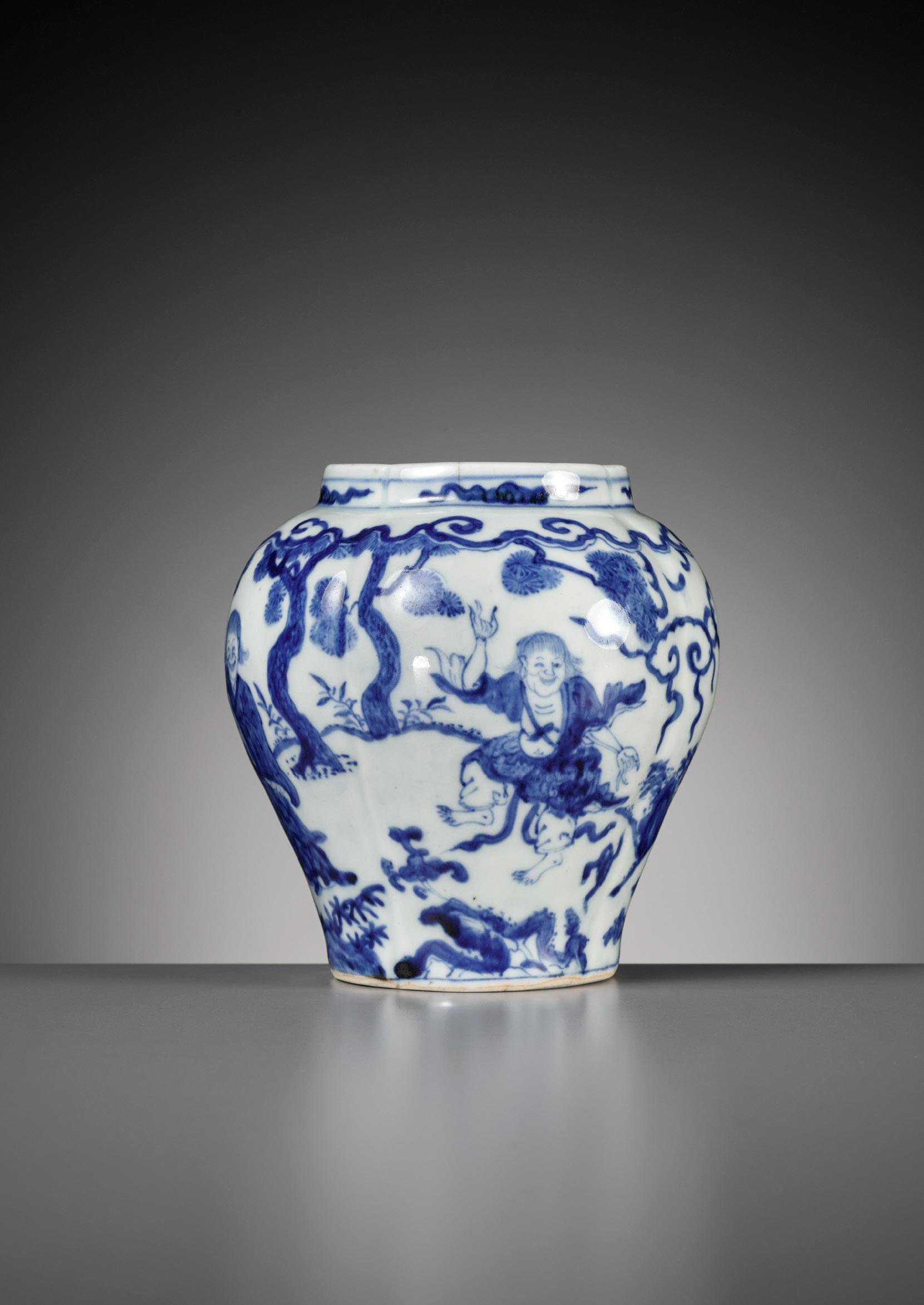
A LARGE BLUE AND WHITE SIX-TUBE ARROW VASE, TOUHU, MING DYNASTY
Expert’s note: The six small and rather unusual lion heads applied on the shoulder of the present vase once suspended bronze rings, which have long been lost to time. It is possible that these rings were used to keep score when playing touhu with this vase, since there is exactly one lion head for each of the six arrow tubes.
China, 16th to early 17th century. The pear-shaped body supported on a waisted foot and rising to a slender neck, the mouth applied with six tubular arrow holes, the shoulder with six pierced lion heads. Finely decorated to the exterior in shades of cobalt blue with scholarly figures and their attendants inside a fenced garden with large willows, below a band of ruyi heads at the shoulder. The neck with three magpies on a prunus branch and a large pine tree, the mouth and arrow lugs with floral designs, the foot with a band of lotus petals.

Provenance: From a private collection in Paris, France.
Condition: Expected old wear and firing irregularities, including burst bubbles, black spots, firing cracks, glaze recesses, and kiln grit. The neck with a horizontal luting line showing an old fill, visible also on the inside, and associated glaze lines. Minor smoothened chips to the foot and occasional light scratches.
Weight: 3,136 g
Dimensions: Height 38.3 cm
Arrow vases were made for a drinking game called ‘touhu’ (lit. ‘pitchpot’), which had been popular among elite men and women from the Spring and Autumn period of the Eastern Zhou dynasty. The Ming-dynasty Emperor Xuande was known to be quite fond of the game, as evidenced by a painting of him playing touhu by Shan Xi (in the Palace Museum, Beijing). Players threw arrows into bronze or ceramic vases with narrow tubular necks at prescribed intervals, each player equidistant from the vase. The winner successfully projected all his arrows into the vase and the loser was forced to drink at each miss. Elaborate rituals and intricate rules, recorded in the Li Ji (Book of Rites), added further complexity to the game. Puzzling pitching techniques were described in the Touhu Yijie (Ceremonial Usages and Rules of Touhu), an illustrated manual written by Wang Ti (1490-1530), and these shots were given fancy names, like ‘A Pair of Dragons Enters the Sea’ when two arrows were thrown from a great height at once into the vase. The touhu game was used to practice archery, one of the essential accomplishments of a gentleman. Later in the Ming era, the game became more widespread, being played by rich merchants as well as the aristocracy and scholarly elite. A scene in the famous late Ming novel Jin Ping Mei (Plum Blossom in the Golden Vase), written in 1619, describes the wealthy merchant Ximen Qing’s seduction of his concubine Panjinlian. She becomes inebriated while playing touhu on a picnic and the game leads to an amorous encounter. For a further discussion of the game see Isabelle Lee, Touhu: Three Millennia of the Chinese Arrow Vase and the Game of Pitch-pot, Transactions of the Oriental Ceramic Society, vol. 56, 1991-2, pp. 13-7.
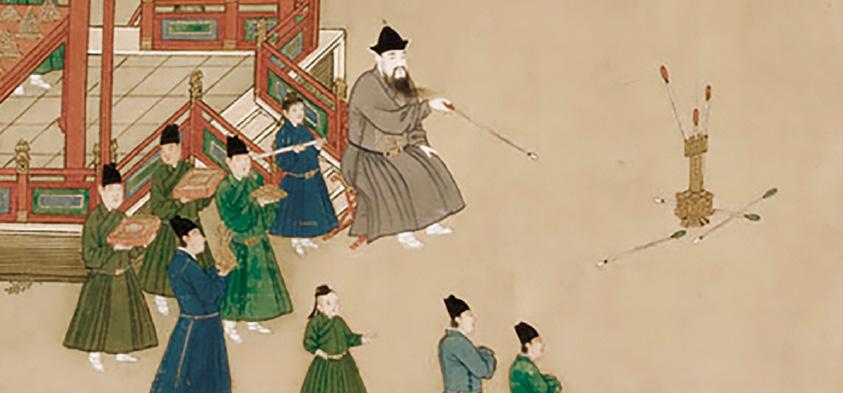
Literature comparison: Compare a related Cizhou painted arrow vase, 40 cm high, dated to the Ming dynasty, circa 1522-1566, in the collection of the British Museum, museum number 1937,0716.74.

AUCTION RESULT COMPARISON
Type: Related
Auction: Galerie Zacke, Vienna, 29 September 2022, lot 106
Price: EUR 26,000 or approx. EUR 27,500 converted and adjusted for inflation at the time of writing
Description: A very large and extremely rare Cizhou painted arrow vase, touhu, Ming dynasty Expert remark: Compare the related form, albeit with fewer and larger arrow holes and lacking the animal masks, and similar size (40 cm).
Estimate EUR 10,000
Starting price EUR 5,000
126 87
Detail of a painting depicting the Xuande Emperor playing touhu by Shan Xi (active c. 1430-1440) in the Palace Museum, Beijing
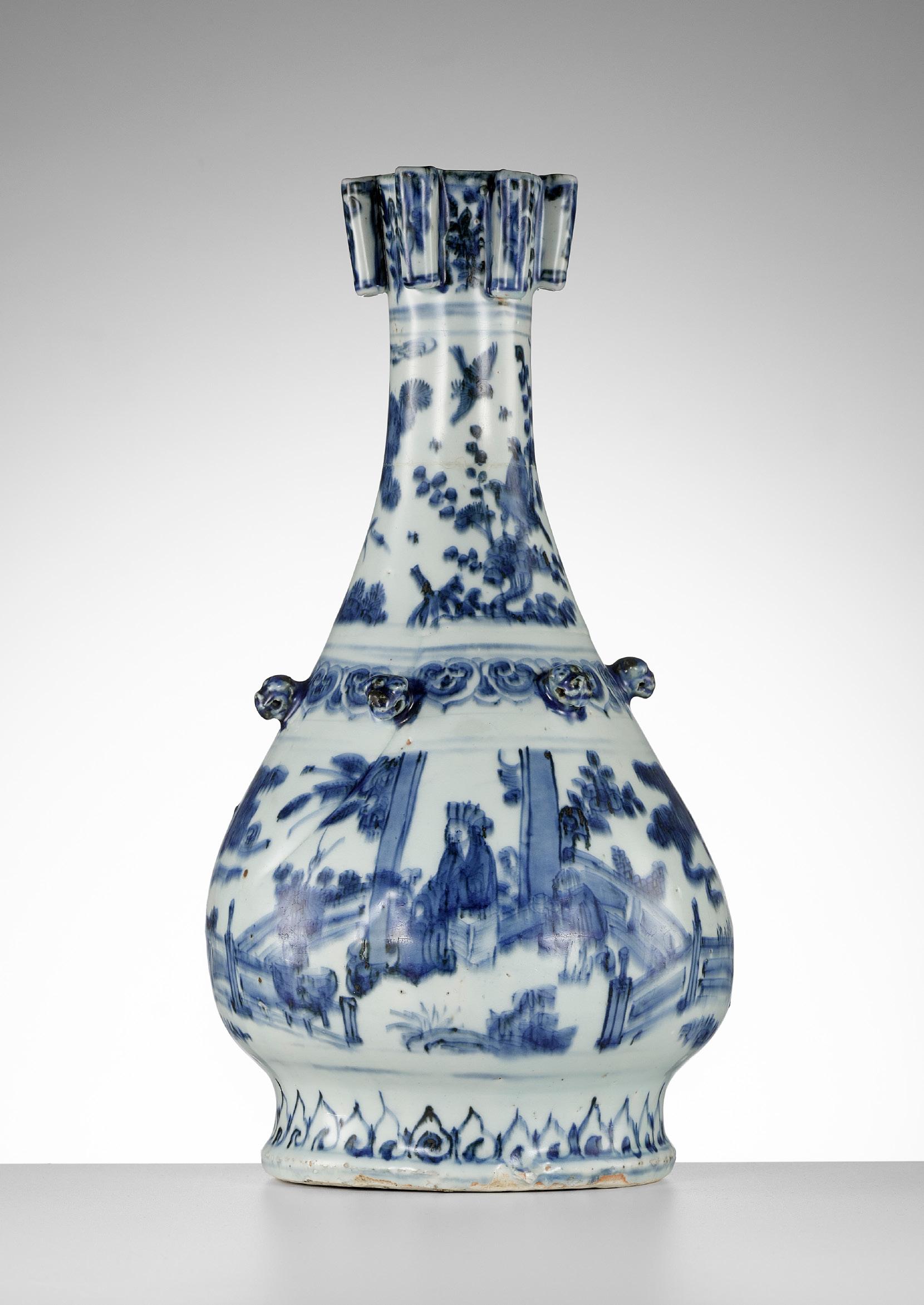
A DEHUA LOTUS-LEAF-FORM BRUSH WASHER, CHINA, 17TH CENTURY
Expert’s note: The present lot has an age of at least 350 years and is preserved in an absolutely superb condition, which must be regarded as extremely rare, given its overall fragility.
Delicately modeled in the form of a furled lotus leaf, set with a stem issuing from one side of the rim, an attendant bud extending across the base while the other sprig elegantly loops over towards the center of the leaf. The washer is applied overall with a distinct ivory-white glaze.

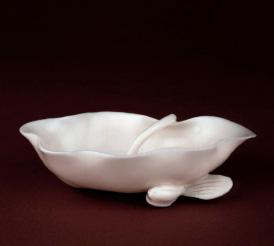
Provenance: Collection of Major Edward C. Radcliffe, and thence by decent in the same family. Listed in the family archive as ‘X3’. Copies of a drawing of the present lot and handwritten notes from the Radcliffe family archive, reading ‘X3. Drawn by nightlight. Far better in every respect but drawn to give you an idea. It’s amazingly delicate.’ and ‘X3. Washer, white porcelain with form of an upturned lotus leaf. Blanc de chine. Mr. Morgan wrote and told me that.’ accompany this lot. Major Edward Copleston Radcliffe (1898-1967) served as a company commander with the British Expeditionary Force in France. He was wounded during the withdrawal at Dunkirk while holding the line at Calais. In 1948, he emigrated to South Africa for retirement as a successful artist. His collection became renowned only after his death, when several Imperial Chinese works of art were found in his house.
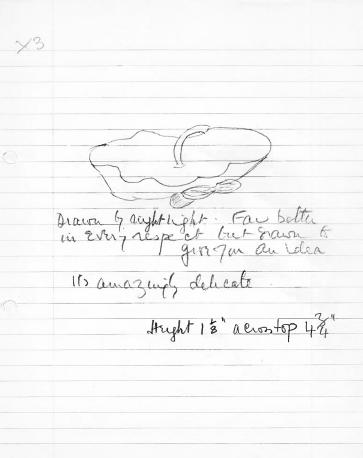
Brian John St. Martin Morgan (1930-2018) joined Bluett & Sons in 1954, where he became a director of the company. He also was president of the British Antiques Dealers’ Association for a time.

Condition: Excellent condition with expected minor old wear and firing irregularities. A microscopic nick to the rim. A small area of the rim has been polished, probably inherent to production.
Weight: 75.4 g
Dimensions: Length 12.2 cm, Height 3.9 cm
LITERATURE COMPARISON
Compare a closely related brush washer, 3 cm high, dated 18th century, in the British Museum, registration number PDF.417 (fig. 1). Compare a related brush washer from the Edward T. Chow collection, sold at Sotheby’s London, 23 June 1981, lot 303, and again at Sotheby’s Hong Kong, 20 November 1985, lot 232.
1
AUCTION RESULT COMPARISON
Type: Near identical
Auction: Christie’s New York, 19 March 2015, lot 409
Price: USD 35,000 or approx. EUR 41,500 converted and adjusted for inflation at the time of writing
Description: A small Dehua lotus-leafform brush washer, late Ming-early Qing dynasty, 17th century

Expert remark: Compare the closely related form and glaze. Note the size (10.5 cm).
Estimate EUR 12,000
Starting price EUR 6,000
128 88
fig.
Edward Copleston Radcliffe wearing his uniform for the 9th Lancers cavalry division, ca. 1916
A drawing of the present lot and handwritten notes from the Radcliffe family archive
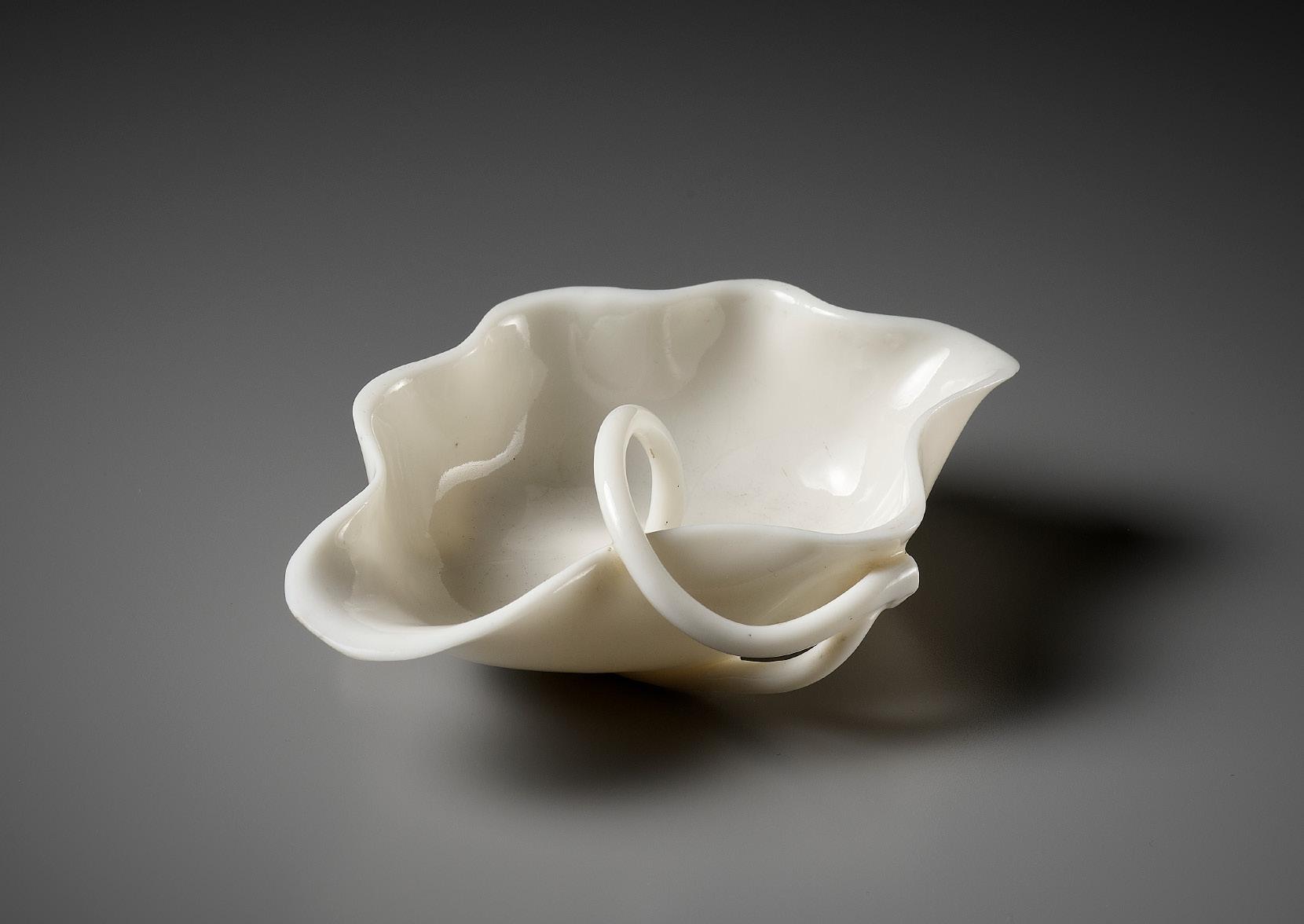
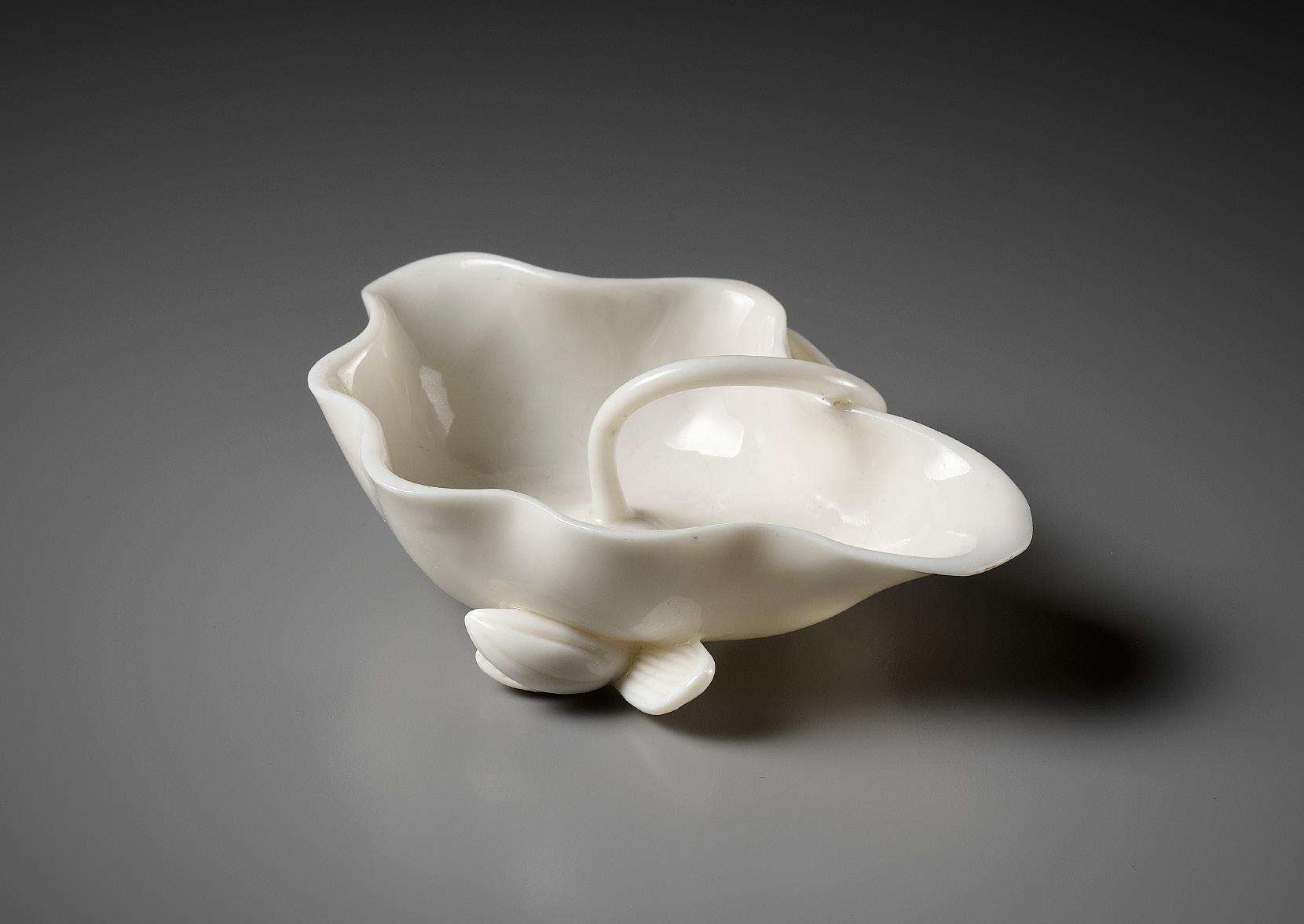
A BLUE AND WHITE ‘GARLIC NECK’ BOTTLE VASE, TRANSITIONAL PERIOD
China, c. 1630-1650. The slightly compressed globular body supported on a short spreading foot and rising to a waisted neck with a garlic bulb and flared mouth. Finely decorated in shades of cobalt blue with small shaped panels enclosing figural scenes, one of a farmer tilling a field, another depicting a farmer carrying a bundle of wheat on a stick with two birds perched on it, the third of a scholar seated in a fenced garden, all surrounded by bands of floral scroll framed by lappet bands. The neck and mouth with long leafy floral stems, the garlic bulb with tulip flowerheads borne on scrolling vines below a lappet band, the foot with another geometric band.
Provenance: New York trade, formerly in an old Japanese private collection. The Japanese wood box is lined with old Japanese newspapers from October 1928.
Condition: Excellent condition with minor wear and firing irregularities, including glaze recesses and kiln grit. The rim with a short hairline.
Weight: 2,424 g
Dimensions: Height 38 cm
With an old Japanese cylindrical wood box. (2)
AUCTION RESULT COMPARISON
Type: Closely related
Auction: Christie’s London, 14 May 2013, lot 202
Price: GBP 22,500 or approx. EUR 39,500 converted and adjusted for inflation at the time of writing
Description: A blue and white bottle vase, Transitional period, circa 1630-1650


Expert remark: Compare the closely related bottle form with similar garlic neck and cobalt-blue decoration with similar floral and figural motifs. Note the similar size (41 cm).
Estimate EUR 8,000
Starting price EUR 4,000
130 89
A
PAIR OF BLUE AND WHITE ‘MAGNOLIA’ BEAKER VASES, TRANSITIONAL PERIOD
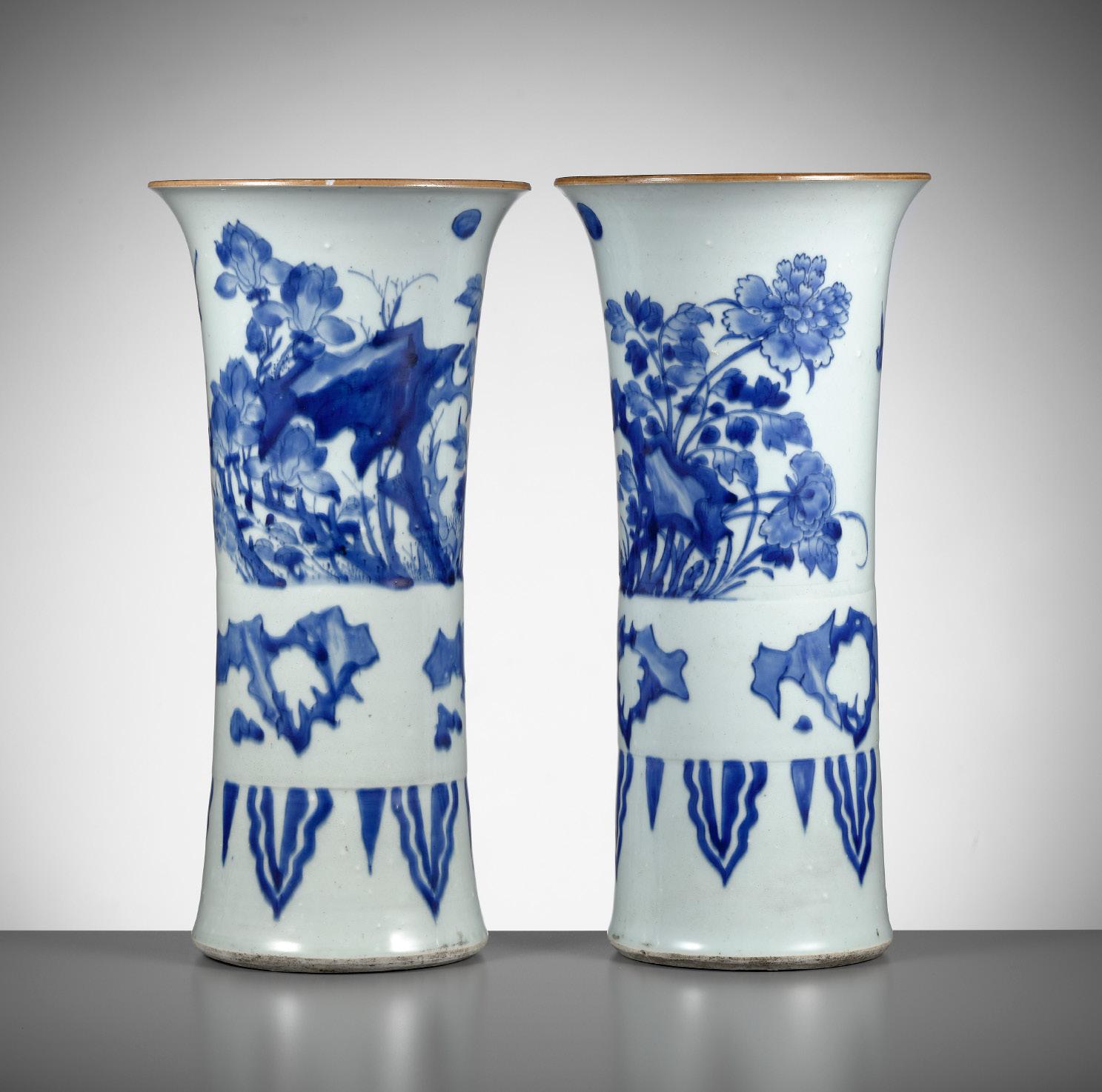
China, c. 1640. Both of slender waisted form, the exteriors finely painted in shades of cobalt blue with birds flying under the moonlight amid leafy magnolia and peonies growing near craggy rocks, above bands of rockwork and pendent leaf blades. The rims each with a neatly applied café-au-lait glaze. (2)
Provenance: Arts d’Autrefois, Paris, France. A private collection in the United States, acquired from the above. Christie’s New York, 28 November 2006, lot 61. A private collection in New York, USA, acquired from the above and thence by descent in the family. Each vase with three old labels to the base, one from Arts d’Autrefois and two from Christie’s. Condition: One vase in excellent condition with only minor wear and expected firing irregularities. The other vase in good condition with minor wear, expected firing irregularities, a hairline to the body and a small glaze flake to the rim.
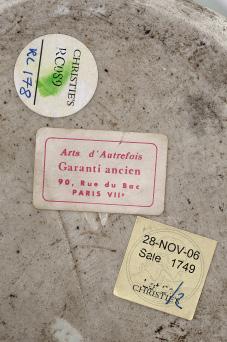
Weight: 2,779 g and 2,938 g
Dimensions: Height 38.3 cm and 38 cm
Expert’s note: This simple and elegant form belongs to a group of new shapes among the Transitional Wares. Its simple concave lines, derived from the earlier Ming prototype, are noted by R. S. Kilburn to ‘serve to emphasize the solid careful potting and good proportion of the pieces’ (see Transitional Wares and Their Forerunners, Hong Kong Museum of Art, 1981, page 30).
Literature comparison: Compare an inscribed blue and white vase dated to 1640, featuring three registers of plants and rocks similar to the present vase, included in the Hong Kong Oriental Ceramics Society exhibition Transitional Wares and Their Forerunners, Hong Kong Museum of Art, 29 January-29 March 1981, p. 89, no. 65.
AUCTION RESULT COMPARISON
Type: Closely related
Auction: Christie’s Hong Kong, 29 May 2013, lot 1935
Price: HKD 187,500 or approx. EUR 27,500 converted and adjusted for inflation at the time of writing
Description: A fine blue and white beaker vase, gu, Transitional period, circa 1620-1645

Expert remark: Compare the closely related form and decoration with similar birds and flowers, rockwork, and leaf blades. Note the similar size (41.5 cm).
Estimate EUR 10,000
Starting price EUR 5,000
131
90
A WUCAI ‘LADY WITH BOYS’ VASE, MEIPING, 17TH CENTURY
China. The baluster body supported on a short foot and rising to a waisted neck with everted lipped rim, finely painted to the exterior in shades of iron-red, green, yellow, aubergine, and underglaze cobaltblue to depict an elegantly robed lady holding up a flower in one hand surrounded by playful boys standing in dynamic poses, one holding up an elaborate headdress all within a fenced garden amid rockwork and grasses, the back with a tall palm tree partly obscured by a pierced lingbi stone, the background with tall mountains emerging from swirling clouds, all below leafy fruit sprays and rockwork to the neck and framed by line borders.

Provenance: London trade.
Condition: Superb condition with only minor old wear, expected manufacturing flaws, and a small chip to the foot.
Weight: 694.9 g
Dimensions: Height 18.2 cm
Covered overall in a transparent glaze save for the unglazed base revealing the ivory-white ware with distinct spiral pottery lines.
AUCTION RESULT COMPARISON
Type: Closely related
Auction: Christie’s London, 7 November 2012, lot
550
Price: GBP 3,750 or approx. EUR 6,700 converted and adjusted for inflation at the time of writing
Description: A Chinese wucai vase, meiping, 17th century
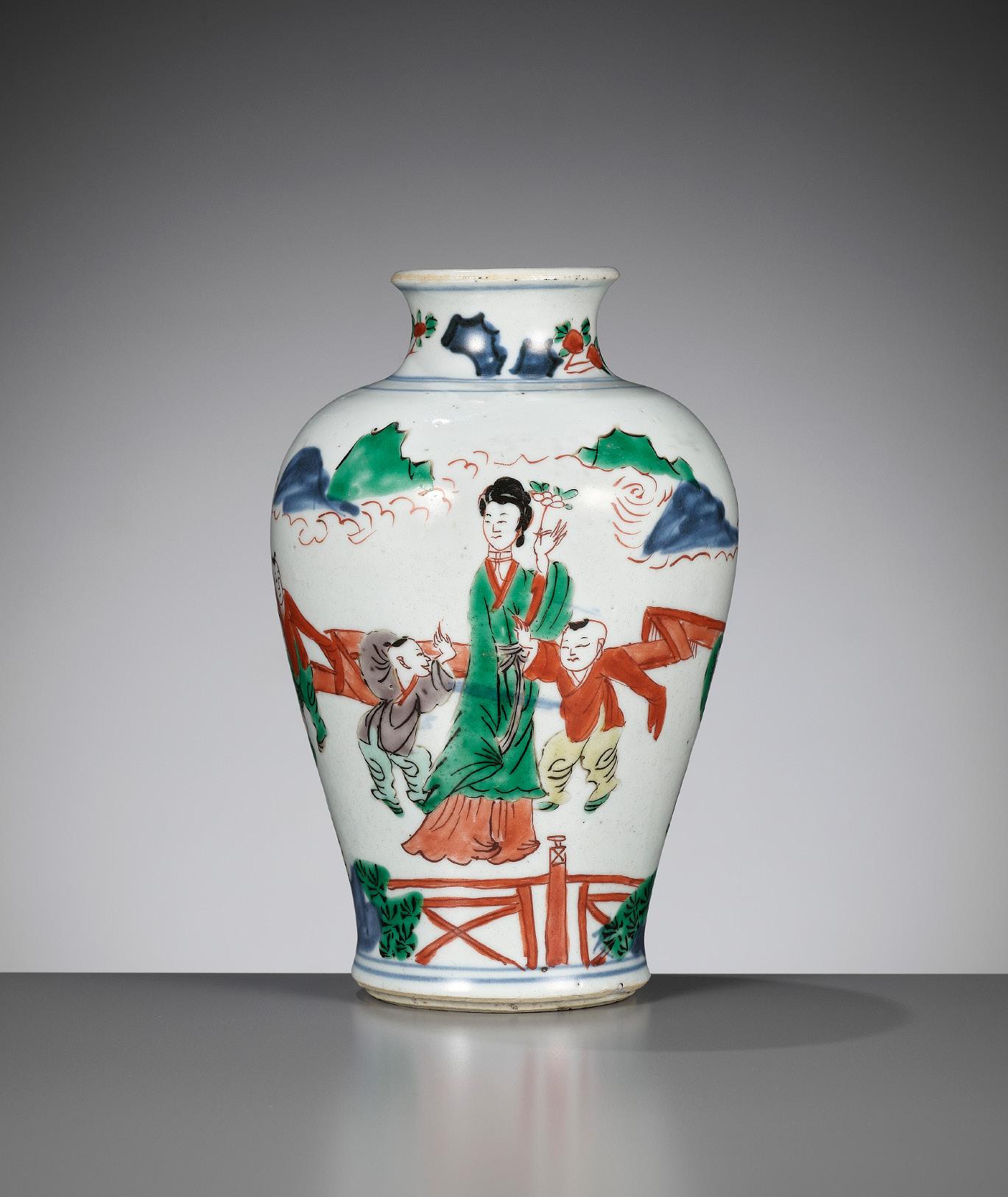
Expert remark: Compare the closely related form, albeit slightly more pronounced than on the present lot, and wucai decoration depicting a similar garden scene with mountain peaks emerging from swirling clouds in the background. Note the size (22.5 cm).
Estimate EUR 4,000
Starting price EUR 2,000
132
91
A LARGE BLUE AND WHITE ‘PHEASANT’ BEAKER VASE, SHUNZHI TO KANGXI PERIOD
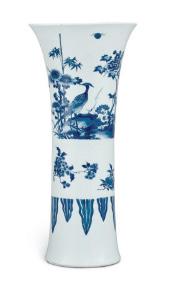
China, mid-17th to early 18th century. Heavily potted, of waisted form, the exterior finely painted in shades of cobalt blue with a long-tailed pheasant perched on a rocky outpost standing tall amid thick shrubbery, peonies, prunus, and pine needles, all below a further pheasant flying above, framed by hatched bands above the foot and below the mouth.

Provenance:
From a private collection in Cotswold, United Kingdom, acquired in the 1920s or earlier, and thence by descent in the same family to the last owner. A copy of an inventory of the family collection, compiled in 1948 by local auctioneer and appraiser Alfred Bower, listing the present lot as no. 312, accompanies this lot. A copy of a private photo taken c. 1982 and showing a part of the collection on display in the family home, including the present vase, accompanies this lot.

Condition: Magnificent condition with minor old wear and manufacturing irregularities, occasional light scratches, the rim with minute fritting, the foot with a shallow chip.
Weight: 3,338 g
Dimensions: Height 43.5 cm
AUCTION RESULT COMPARISON
Type: Closely related
Auction: Sotheby’s Hong Kong, 27 November 2020, lot 432
Price: HKD 119,700 or approx. EUR 19,000 converted and adjusted for inflation at the time of writing
Description: A blue and white beaker vase, Qing dynasty, Shunzhi period
Expert remark: Compare the closely related waisted form and cobalt blue decoration, as well as the related bird motif. Note the size (45.7 cm).
AUCTION RESULT COMPARISON
Type: Related
Auction: Christie’s Amsterdam, 5 October 2011, lot 477
Price: EUR 32,200 or approx. EUR 43,500 adjusted for inflation at the time of writing
Description: A pair of Chinese blue and white large beaker vases, Kangxi (1662-1722)
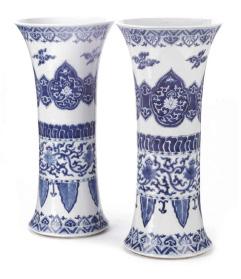
Expert remark: Compare the closely related waisted form and cobalt blue decoration. Note the different motif, the size (44.9 and 55.3 cm), and that this lot comprises a pair.
Estimate EUR 8,000
Starting price EUR 4,000
92
A MASSIVE SANCAI-GLAZED FIGURE OF A MONK, LATE MING DYNASTY TO KANGXI PERIOD
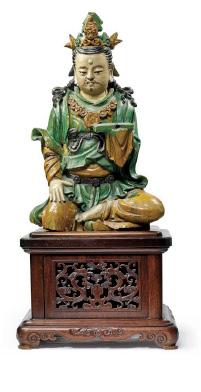
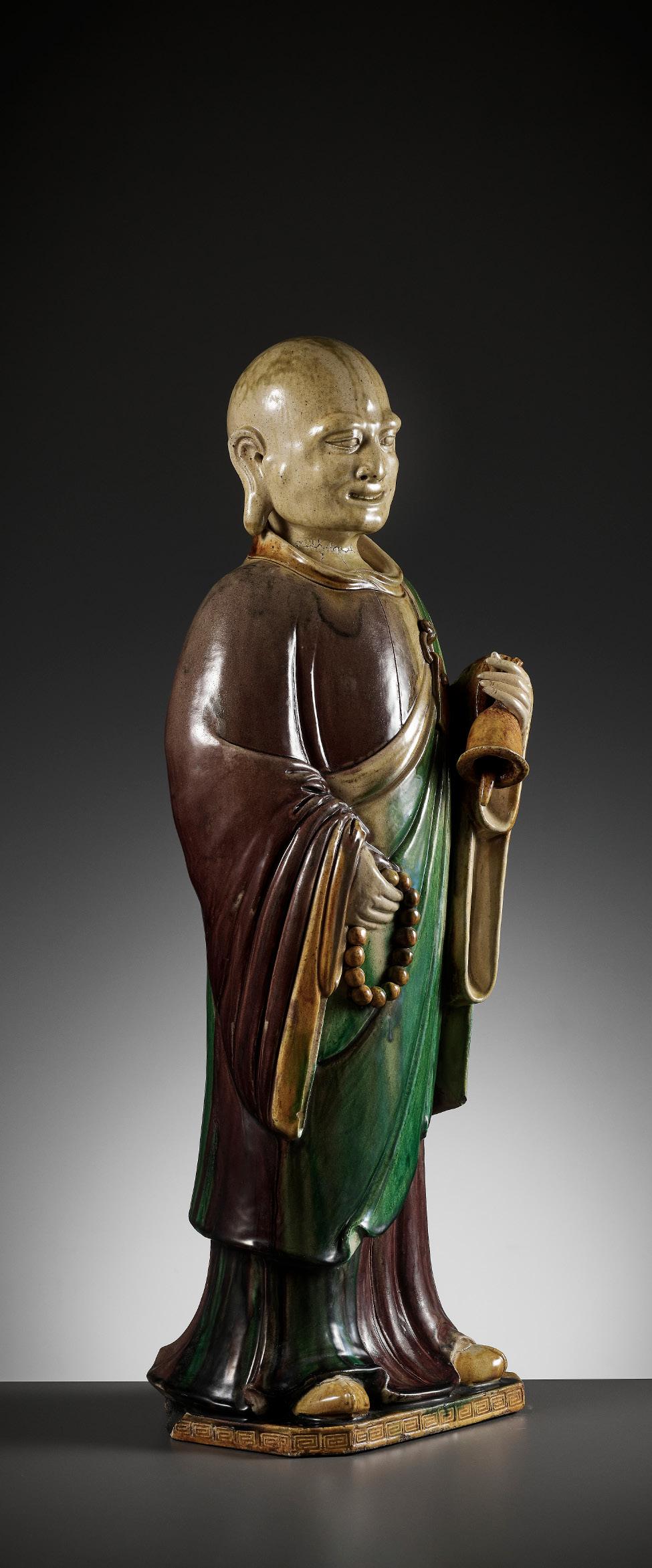
China, 17th to early 18th century. Well modeled standing on a rectangular base with canted corners decorated to the sides with a band of key-fret. The monk is holding prayer beads in his lowered right and a ghanta bell in his raised left hand, and wearing a long flowing robe tied with a sash over his left shoulder, further detailed with finely carved folds. The face with almond-shaped eyes, thick brows, and full lips forming a calm smile showing teeth, flanked by thick pendulous earlobes. The figure is covered in splashed glazes of aubergine, emerald green, amber, and cream.
Provenance: From an old Belgian estate.
Condition: Good condition with minor wear and firing irregularities including firing cracks, dark spots, glaze crackles and recesses. A few minor nicks, the base and the handle of the bell with minor losses. Displaying magnificently.
Weight: 16.5 kg
Dimensions: Height 75.3 cm
AUCTION RESULT COMPARISON
Type: Related
Auction: Christie’s Paris, 12 June 2019, lot 181
Price: EUR 30,000 or approx. EUR 33,500 adjusted for inflation at the time of writing
Description: A large Sancaiglazed stoneware figure of a bodhisattva, China, late Ming dynasty
Expert remark: Compare the related glazes and size (72 cm).
Estimate EUR 10,000
Starting price EUR 5,000
93
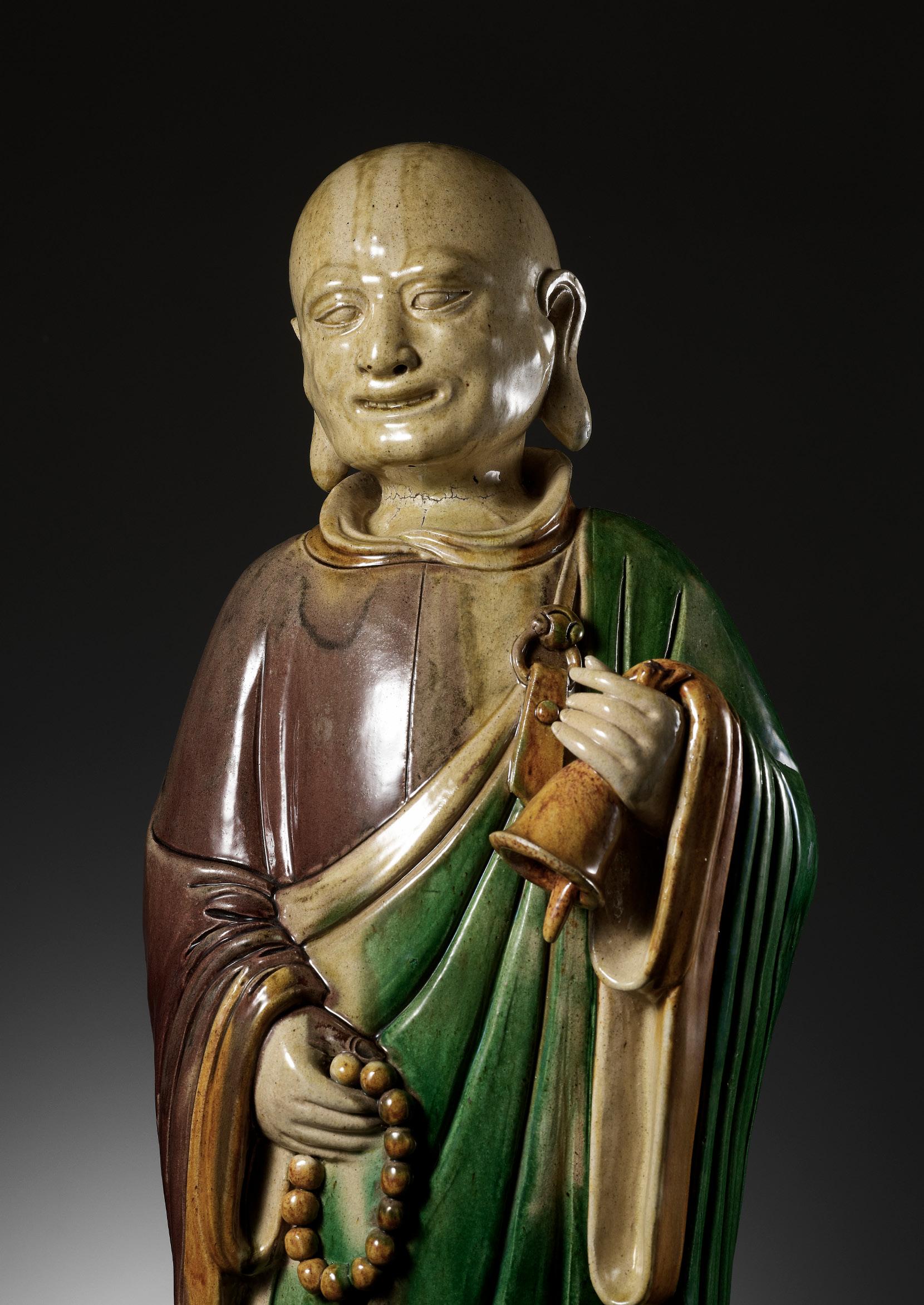
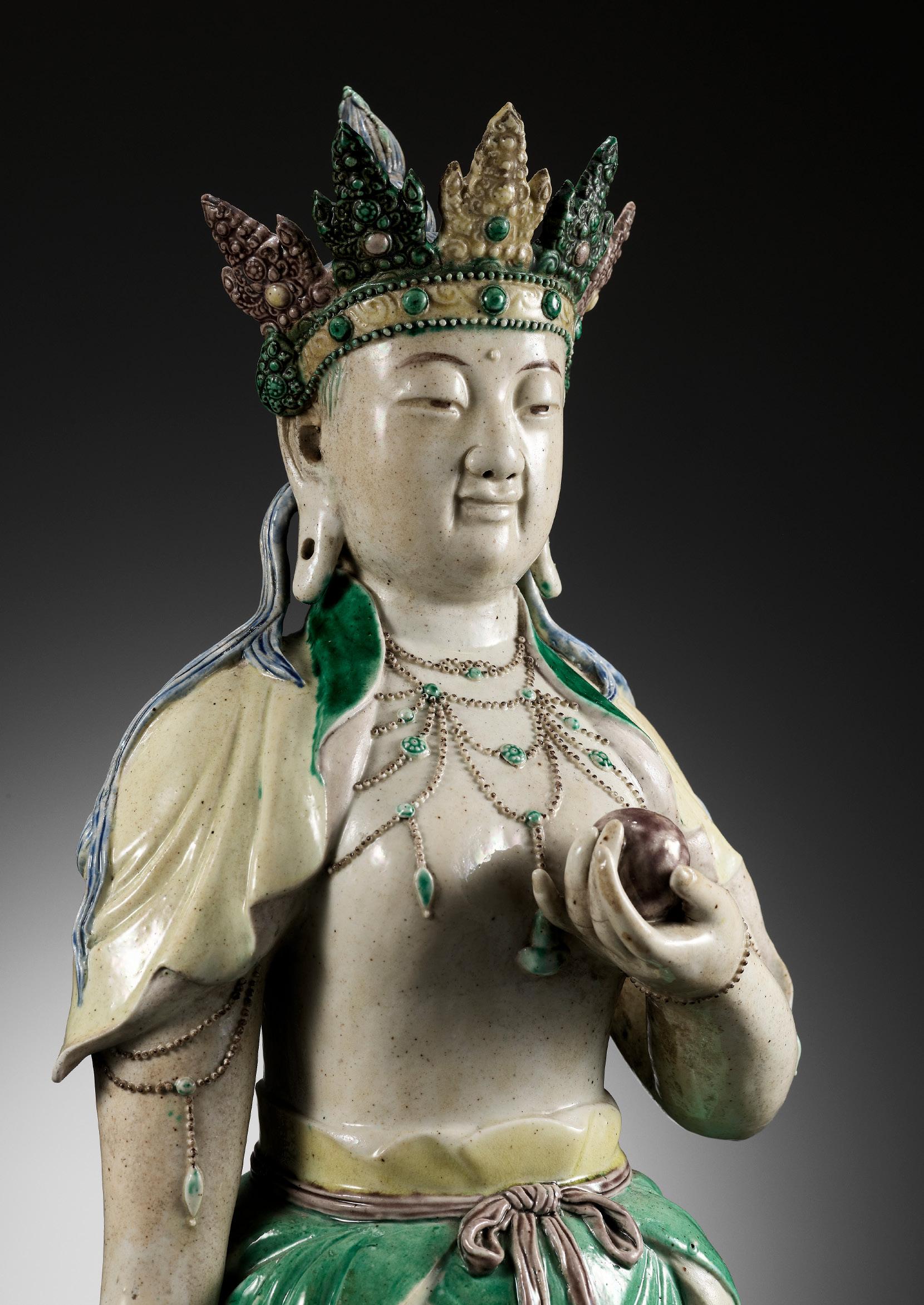
A LARGE FAMILLE VERTE BISCUIT FIGURE OF AMITAYUS, KANGXI PERIOD
China, 1662-1722. Well modeled standing, dressed in pale yellow, emerald-green, and aubergine garments tied at the waist with a simple belt gracefully falling to his feet, holding a sacred jewel in his left hand, his right arm stretched down to the side with the palm facing outward. Jeweled beads cling tightly against the contours of his body, on his arms, wrists, and neck. On his head rests a jeweled crown with five yellow, purple, and dark green three-point panels, the narrow strands of his blue hair fall gently over his shoulders.
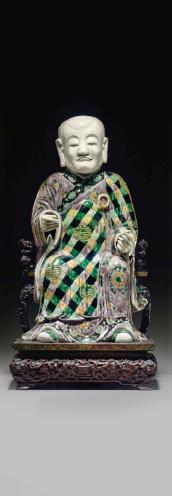

Provenance: US trade. Acquired from a old private estate in Florida. By repute acquired by the grandparents of the previous owner in China, c. 1940.
Condition: Good condition with minor old wear and firing flaws including small cracks and glaze drippings. Few minor losses, the base drilled with a hole probably inherent to the manufacturing process. One small tip of the crown reattached.
Weight: 6.7 kg
Dimensions: Height 56 cm
AUCTION RESULT COMPARISON
Type: Related
Auction: Christie’s New York, 24 March 2011, lot 1720
Price: USD 35,000 or approx. EUR 42,500 converted and adjusted for inflation at the time of writing
Description: A Rare
Glazed Biscuit Figure of a Seated Luohan, Kangxi Period (16621722)
Expert remark: Note the smaller size (48.3 cm)
Estimate EUR 12,000
Starting price EUR 6,000
94
A LARGE AND BARBED FAMILLE VERTE ‘WARRIOR’ DISH, KANGXI PERIOD
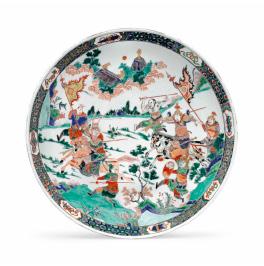
China, 1662-1722. The shallow rounded sides rising from a tapered foot to an everted foliate rim. Finely painted in bright enamels, including a magnificent sapphire-blue, with gilt highlights to depict a dynamic scene of equestrian warriors, foot soldiers, and bannermen engaged in a battle, in a verdant mountain landscape with rockwork, trees, shrubbery, flowers, and swirling clouds. Encircled at the rim by shaped cartouches enclosing landscapes with rockwork and trees against a brocade-patterned ground. The recessed base with an underglaze-blue artemisia leaf mark within a double circle.
Provenance: Collection of Madame de Rothschild. Sotheby’s Monaco, 21-22 May 1978, lot 78. A noted private collection in Geneva, Switzerland, acquired from the above, and thence by descent. An important part of this collection was on permanent loan and exhibited over several decades at the AsiaAfrica Museum in Geneva. The base with two old collector’s labels, ‘O5.SSS’ and ‘A1’. The base with an old collector’s number inscribed, ‘AMA-3537’. A copy of the previous owner’s handwritten notes from 1978, confirming the provenance above, and detailing information regarding the present lot (numbered ‘3537/78’) accompanies this lot.

Condition: Very good condition with some old wear and expected manufacturing irregularities. The rim with some fritting and few shallow chips. Occasional minor scratches. Minute flaking to enamels.
Weight: 1,620 g
Dimensions: Diameter 37 cm
Note the central general’s smiling expression, who is probably being ambushed by some of the fiercer-looking warriors surrounding him.
Expert’s note: During the early Qing dynasty, up until the early 1680s, conditions were unsettled in China and the making of Imperial wares as well as the use of reign marks on porcelain was restricted in various ways. During this period, different types of other marks came into use, including artemisia leaf marks
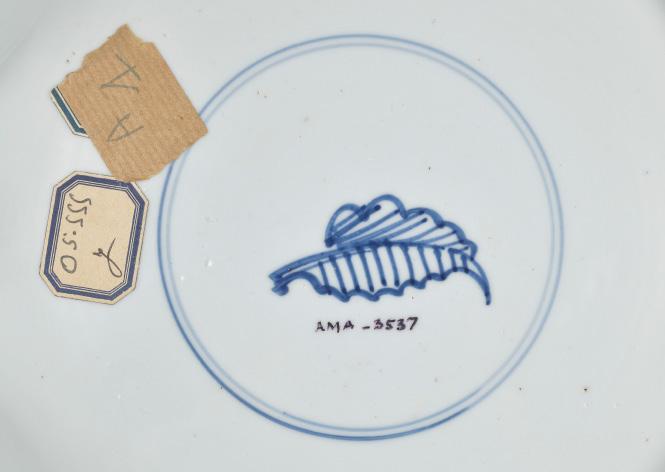
AUCTION RESULT COMPARISON
Type: Closely related
Auction: Christie’s New York, 18 January 2018, lot 16
Price: USD 43,750 or approx. EUR 49,000 converted and adjusted for inflation at the time of writing
Description: A large famille verte dish, Kangxi period
Expert remark: Compare the closely related subject with a similar battle scene, decoration with similarly vibrant sapphire blue, use of gilt, brocade pattern to the rim, and underglaze blue artemisia leaf mark within a double circle. Note the near-identical size (38.7 cm) as well as the straight everted rim (as opposed to the foliate rim on the present lot).
Estimate EUR 15,000
Starting price EUR 7,500
138 95
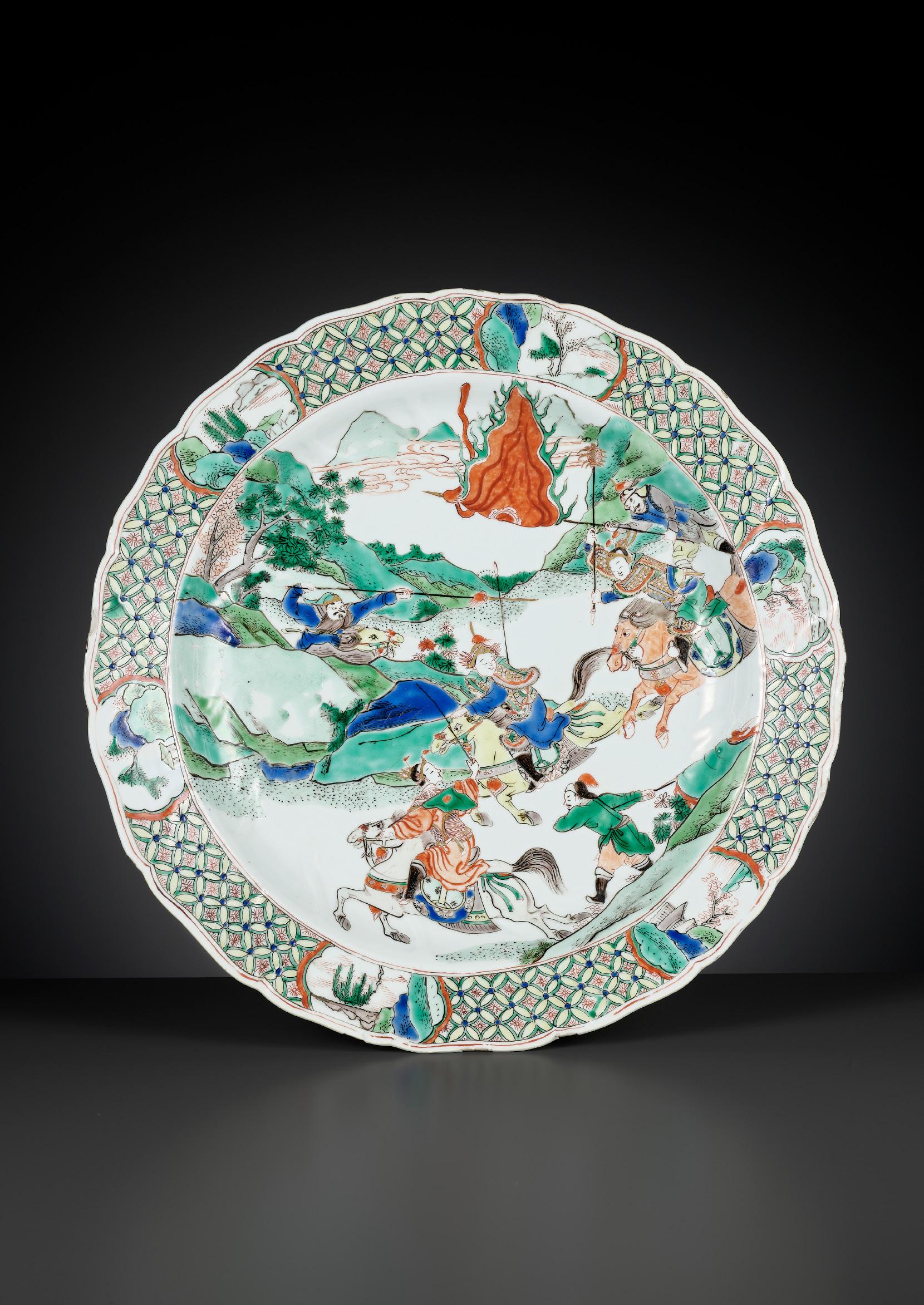
A LANGYAO CONICAL BOWL, KANGXI PERIOD (1662-1722)
China, early in the Kangxi period, circa 1690-1705. Delicately potted, the conical sides supported on a short straight foot, covered to the interior and exterior with a finely crackled copper-red glaze of rich crushed-strawberry color, thinning at the mouth rim and foot to a pale celadon tone, which also covers the slightly convex base.
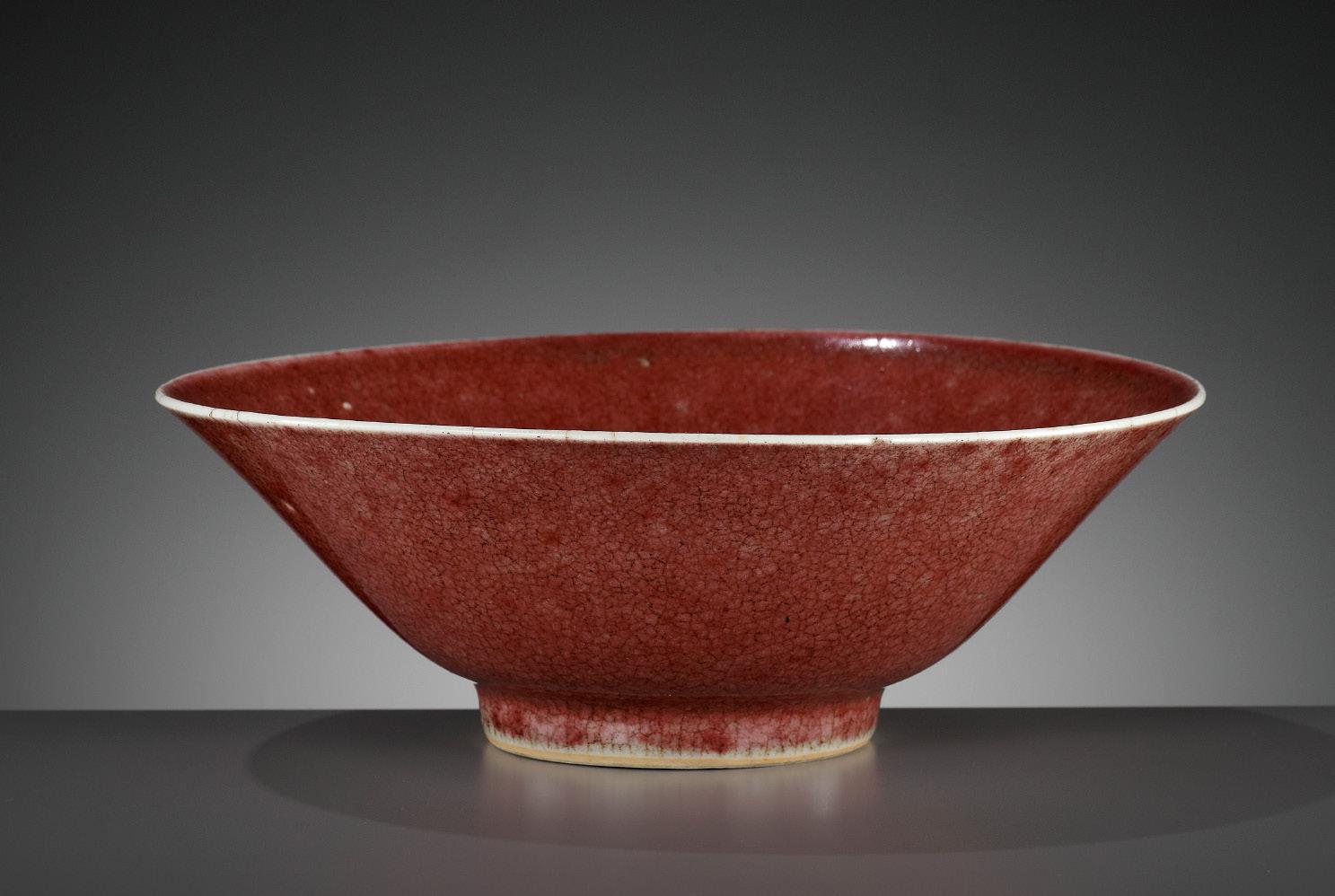
Provenance: Collection of Major William Guy Horne. Sotheby’s 9 July 1942, lot 18 (according to the Bluett archive records). Bluett & Sons, London, United Kingdom. Collection of Major Edward C. Radcliffe, acquired from the above and thence by descent in the same family. Listed in the family archive as ‘G1’. The base with an old collector’s label, ‘Radcliffe Collection, G1’, and an old label ‘The British Antique Dealers Association, Certified for Customs Purpose Only, Over 100 Years Old.’ Copies of an old photograph of the present lot and a handwritten note from the Radcliffe family archive, inscribed in pencil “G1. Bowl Red Ching. (..) Glaze lovely & even, photo seems bad from sun playing tricks. A novice told it is a ‘chicken skin’ glaze. […] says fairly early Ming (13641644)”, and later in ink, “end of 17th C. Kang Xi. 4.500”, accompany this lot. Major Edward Copleston Radcliffe (1898-1967) served as a company commander with the British Expeditionary Force in France. He was wounded during the withdrawal at Dunkirk while holding the line at Calais. In 1948, he emigrated to South Africa for retirement as a successful artist. His collection became renowned only after his death, when several Imperial Chinese works of art were found in his house.
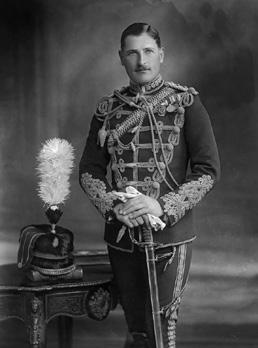
Condition: Excellent condition with expected old wear and firing irregularities, such as dark spots and pitting. Few microscopic nibbles and short hairlines to the rim, and very minor flaking to the glaze.
Weight: 654 g
Dimensions: Diameter 22.8 cm
Langyao is a vitreous red glaze that was developed at the Jingdezhen imperial kilns under the supervision of Lang Tingji (1663-1715), governor of Jiangxi Province between 1705 and 1712. This copper glaze turns red after
being fired in a reducing or oxygen-deprived atmosphere. It sometimes drips down the vessel during firing, creating drops around the foot. It is incredibly hard to achieve, with layers of clear and copper-rich glazes allowing for depths of color, as clearly evidenced by the present lot. The glaze must be of a certain thickness to turn red, so areas where it is thin can be lighter in color, ranging from pinkish hues to pale celadon and sometimes even white.
Expert’s note: The present bowl is rare in its close adherence to its fifteenth century predecessors. This explains also why Major Radcliffe originally thought that it is “fairly early Ming” (see Radcliffe family archive and provenance section). The deep copper-red glaze and strongly everted shape of the bowl relate very closely to examples produced during the Xuande period, when Ming copper-red wares were perfected to an intense brilliant red tone known as xianhong. See for example a copper-red-glazed bowl, with a Xuande mark and of the period, in the British Museum, registration number 1947,0712.321.
Literature comparison: A related bowl, dated to the Kangxi period, was exhibited by the Oriental Ceramics Society, The World in Monochromes, School of Oriental and African Studies, London, 2009 and illustrated in the catalog, p. 76, no. 168.
AUCTION RESULT COMPARISON
Type: Closely related
Auction: Christie’s New York, 20 September 2013, lot 1365
Price: USD 68,750 or approx. EUR 81,000 converted and adjusted for inflation at the time of writing
Description: A Langyao bowl, Kangxi period
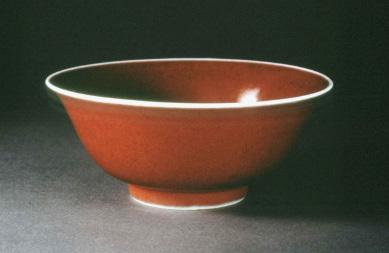
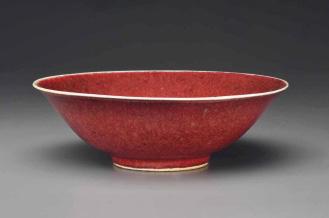
Expert remark: Compare the closely related glaze with similar shades of crushed strawberry and pale celadon. Note the slightly more rounded form and the similar size (21 cm).
Estimate EUR 20,000
Starting price EUR 10,000
140 96
Captain Major William Guy Horne

A GILT-DECORATED POWDER-BLUEGROUND ‘THREE STAR GODS’ ROULEAU VASE, KANGXI PERIOD
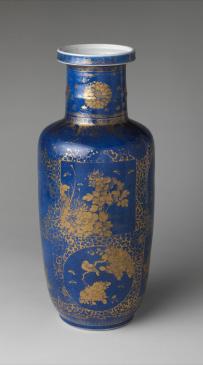
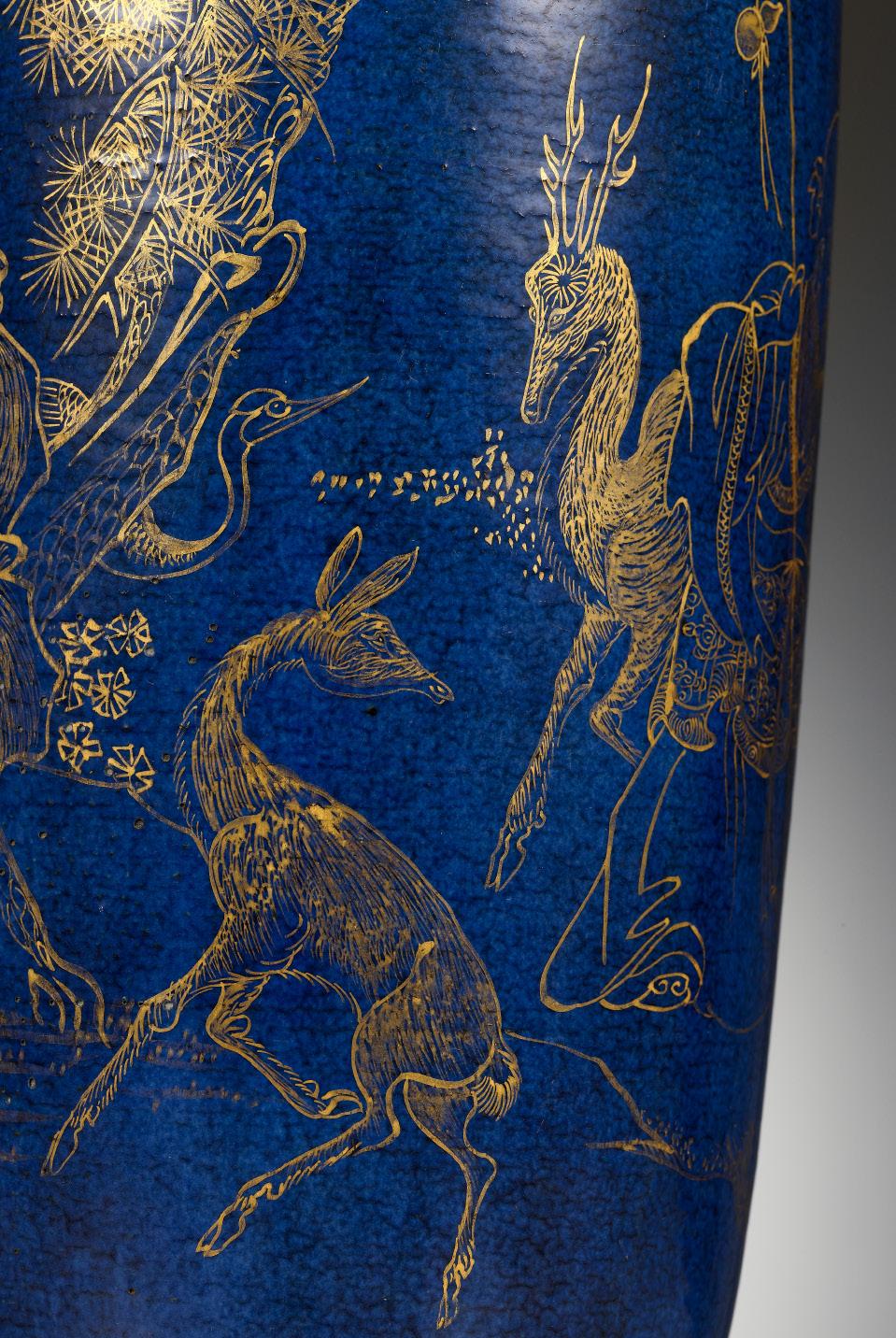
China, 1662-1722. Masterfully painted in fine gilt, depicting the Three Star Gods (sanxing) surrounded by smiling boys in a fenced garden with pine trees and rockwork as the moon shines in the sky above the pine branches where a single bat flies through the night sky. Shoulao is holding a long cane, suspending a double-gourd in one hand and a peach in the other, standing near two graceful deer and a crane, while Fu (Jupiter) stands beside him wearing a scholar-official’s garb and holding a scroll. The entourage of boys carry offerings toward the gods including a ruyi scepter and incense.
Provenance: Collection of Milton Drexel Rutherford (1894-1976), and thence by descent within the family. Two old labels, ’59’ and ‘231,’ below the shoulder. Milton Drexel (Rex) Rutherford was a US veteran and engineer. He lived and worked in the city of Chicago, excavating the tunnels for the city’s subway. His proliferate collection began when a client gifted him an artifact from eastern Asia igniting a passion for collecting Asian art, including Kangxi ceramics as well as Japanese metalwork and lacquers.
Condition: Superb condition with only minor old wear and neglectable firing irregularities. Extremely rare in such a magnificent state of preservation. Especially the gold shows only little rubbing, and over the centuries it has acquired its typical patina, that is so highly desired among discerning collectors.
Weight: 4,184 g
Dimensions: Height 47.6 cm
The shoulder with a key-fret band below a band of ruyi heads, followed by two bands of geometric designs to the base of the neck, and a cash-coin band along the galleried rim. The neck of the vase painted with panels enclosing fish and birds as well as Shou characters against foliate grounds above lotus blooms.
LITERATURE COMPARISON
Compare a related vase decorated with flowers, birds, and a poem, dated 1709 by inscription, 44.5 cm tall, in the Metropolitan Museum of Art, accession number 79.2.153 (fig. 1), illustrated in Oriental Ceramics, The World’s Great Collections, Tokyo, 1977, Vol. 12, fig. 141. Compare a related powder-blue vase in Hugo Munsterberg’s The Art of China, Vermont, 1972, fig. 100. fig. 1
AUCTION RESULT COMPARISON
Type: Closely related
Auction: Christie’s New York, 19 March 2015, lot 457
Price: USD 125,000 or approx. EUR 150,000 converted and adjusted for inflation at the time of writing
Description: A gilt-decorated powder-blue-ground rouleau vase, Qing dynasty, Kangxi period
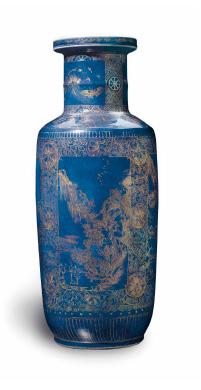
Expert remark: Note the near-identical size (46.5 cm).
Estimate EUR 30,000
Starting price EUR 15,000
142 97
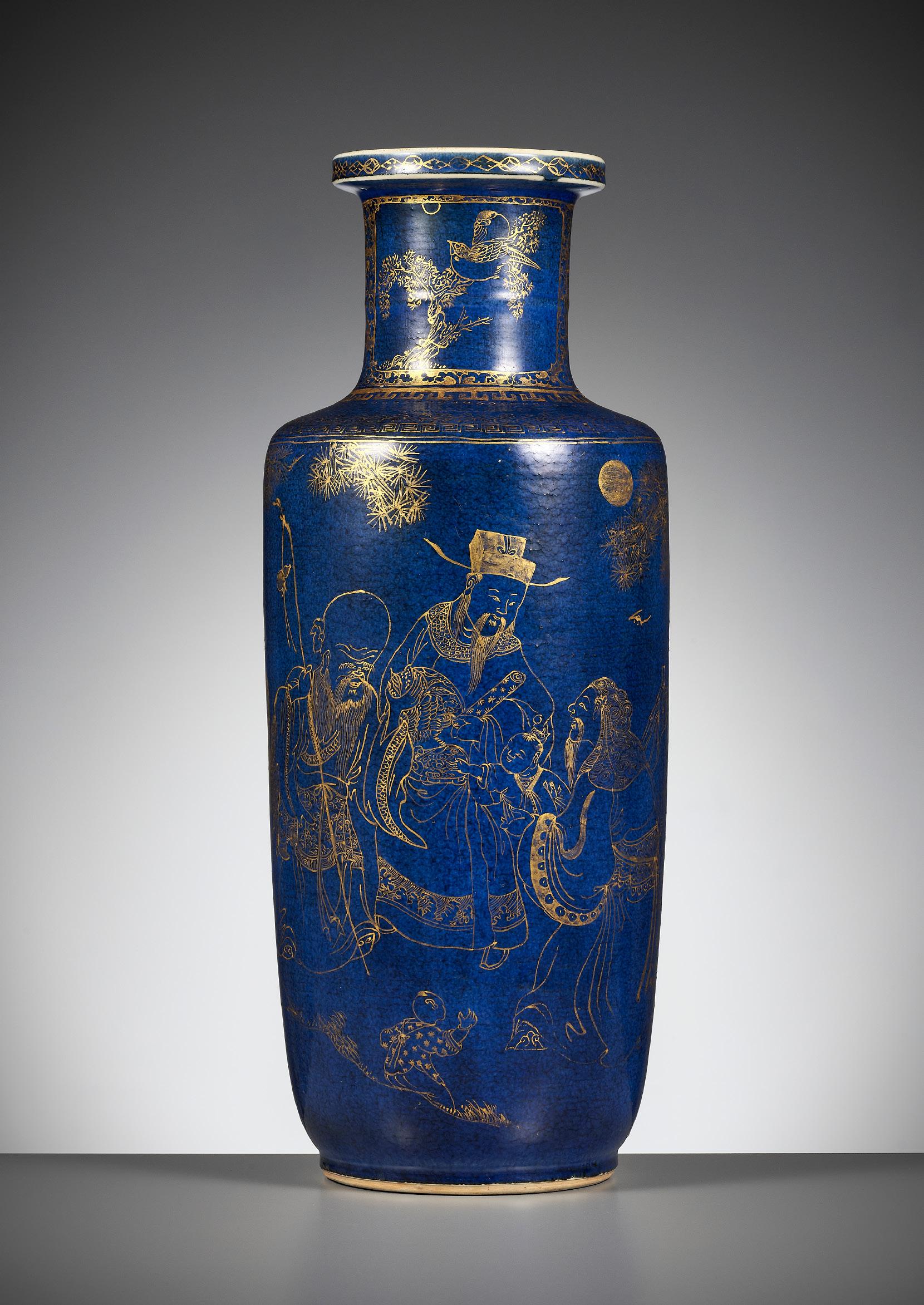
A MIRROR BLACK-GLAZED AND GILT-DECORATED ‘DRAGON’ VASE, GU, KANGXI PERIOD

China, 1622-1722. The exterior is covered with a rich, lustrous glaze with gilt decoration depicting sinuous dragons between stylized plantain leaf bands, all below a ruyi band, the interior and base glazed white.
Provenance: The J. M. Hu, Zande Lou Collection. A padded silk box fitted to the vase is accompanying this lot, and an old label on the box’s exterior reads: ‘124.’
Jenmou Hu (1911-1995) was arguably the most important collector of Chinese ceramics in the last century. In both his personal collection and in his bequests to cultural institutions, J. M. Hu stood as a model of the modern scholar-collector.
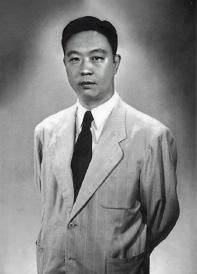
Condition: Good condition with minor wear and firing irregularities including pitting and firing cracks. Some rubbing to gilt, shallow glaze recesses above the foot, a few small polished areas to the foot.
Weight: 566.9 g
Dimensions: Height 19.9 cm
With a fitted padded silk storage box. (2)
AUCTION RESULT
COMPARISON
Type: Related
Auction: Sotheby’s New York, 20 March 2018, lot 455
Price: USD 25,000 or approx. EUR 28,000 converted and adjusted for inflation at the time of writing
Description: A mirror-black glazed giltdecorated vase, Kangxi period
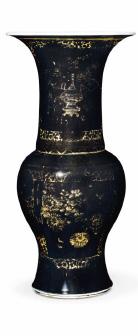
Expert remark: Compare the closely related mirror-black glaze and gilt decoration. Note the different form and larger size (43.2 cm).
Estimate EUR 4,000
Starting price EUR 2,000
98
Jenmou Hu, The Master of Zande Lou
A CARVED CELADON-GLAZED YENYEN VASE, CHINA, 18TH CENTURY
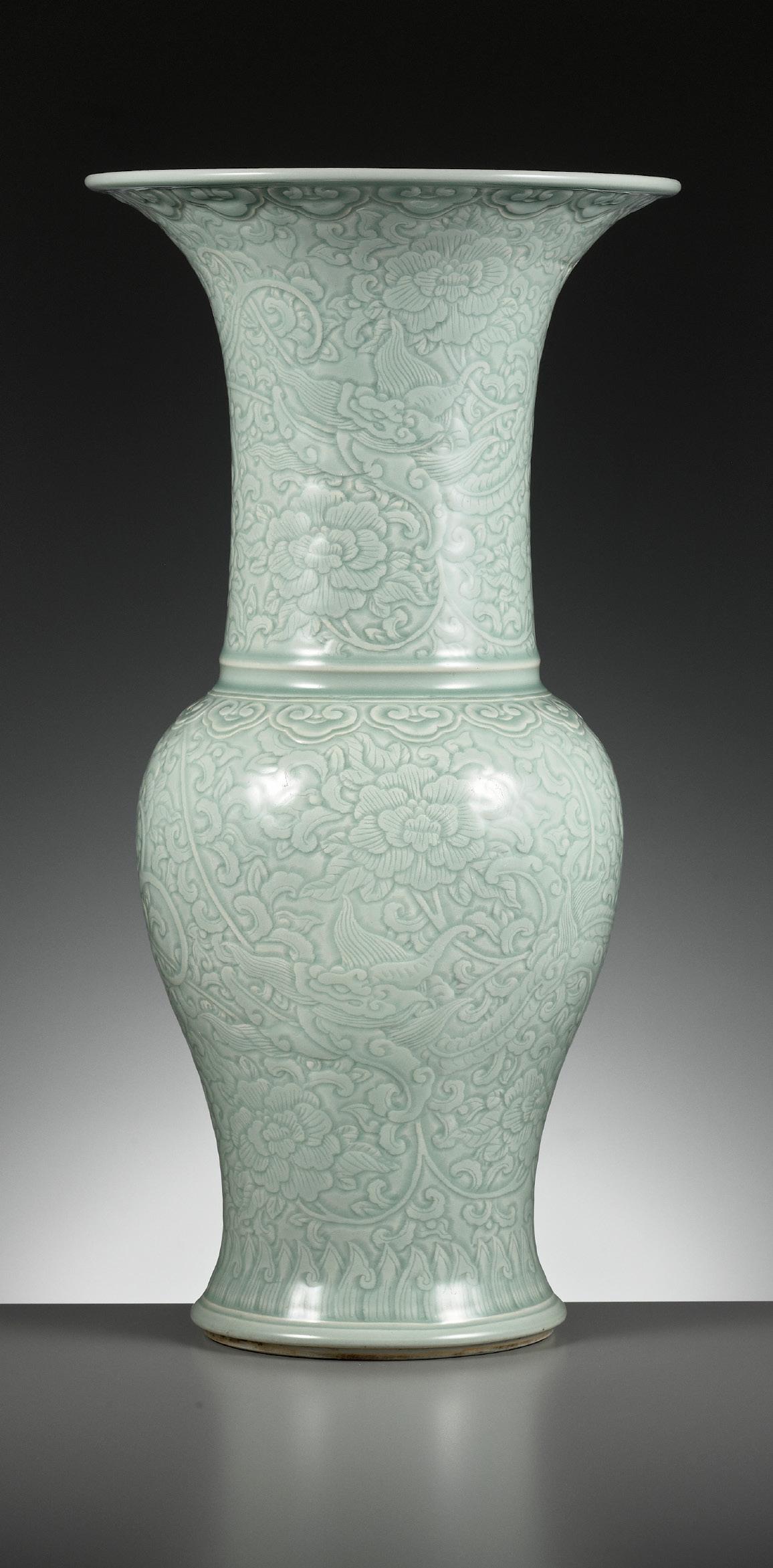

The baluster body rising from a short foot to a cylindrical neck and flaring rim, the body finely carved and incised with large peony blooms and stylized dragons amongst foliage, further with a band of ruyi heads below the bowstring, repeated below the rim, and a band of overlapping flower petals above the foot. The exterior covered with a translucent celadon glaze, which pools nicely in the recesses and thins along the edges, the base and interior with a transparent glaze. The base with a neatly painted underglaze-blue ambrosia leaf mark.

Provenance: From the old private estate of a British officer stationed in China, and thence by descent.
Condition: Excellent condition with only minor old wear and expected minimal firing irregularities, such as scattered brown spots, glaze recesses and a small chip to the foot.
Weight: 3,998 g
Dimensions: Height 45.5 cm
AUCTION RESULT
COMPARISON
Type: Closely related
Auction:
Christie’s Paris, 21 September
2011, lot 308
Price: EUR 18,750 or approx. EUR 23,000 adjusted for inflation at the time of writing
Description: A celadonglazed yenyen vase, Qing dynasty, 18th century
Expert remark: Compare the closely related form, celadon glaze, and carved decoration. Note the size (49.5 cm).
Estimate EUR 8,000
Starting price EUR 4,000
99
100
A BLUE AND WHITE RECTANGULAR FLASK AND COVER, KANGXI PERIOD
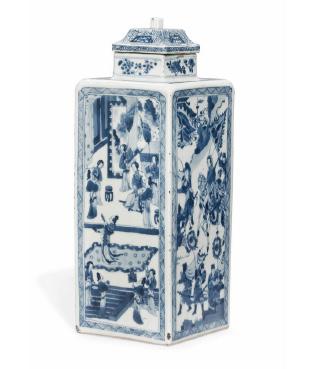
Expert’s note: The present lot is in pristine condition and still retains its original cover, which is rather small in size and therefore can be lost easily. It must therefore be considered as exceedingly rare.
China, 1662-1722. Each side finely painted in nicely graduated shades of deep cobalt blue to depict two court ladies standing on a terrace flanking a jardinière of chrysanthemums, with branches of prunus blossoms in the background. The flat shoulder with a different flower sprig at each corner, depicting peony, lotus, aster, and prunus, all within quadrilobed panels with scroll designs at the corners. The base with an underglaze-blue monogram mark ‘HA’.
Provenance: The Property of a Gentleman. Christie’s New York, 30 May 1991, lot 321. A private collection in New York, USA, acquired from the above, and thence by descent within the family.
Condition: Very good condition with only minor wear and expected firing irregularities, minute glaze flakes, and minuscule nicks to edges. Overall exceptionally well preserved and displaying magnificently.
Weight: 1,750 g
Dimensions: Height 30.2 cm

The molded cover is original to the flask and depicts flower sprigs encircling the knop finial. The neck is decorated with a band of prunus on an ice-cracked ground below a key-fret band, the lipped mouth with a geometric band. (2)
AUCTION RESULT COMPARISON
Type: Related
Auction: Christie’s London, 17 May 2013, lot 1359
Price: GBP 17,500 or approx. EUR 30,500 converted and adjusted for inflation at the time of writing

Description: A Chinese blue and white square-sectioned vase and cover, Kangxi period

Expert remark: Note the similar form and cobalt blue decorations. Note the near-identical size (31.7 cm).
Estimate EUR 10,000
Starting price EUR 5,000
146
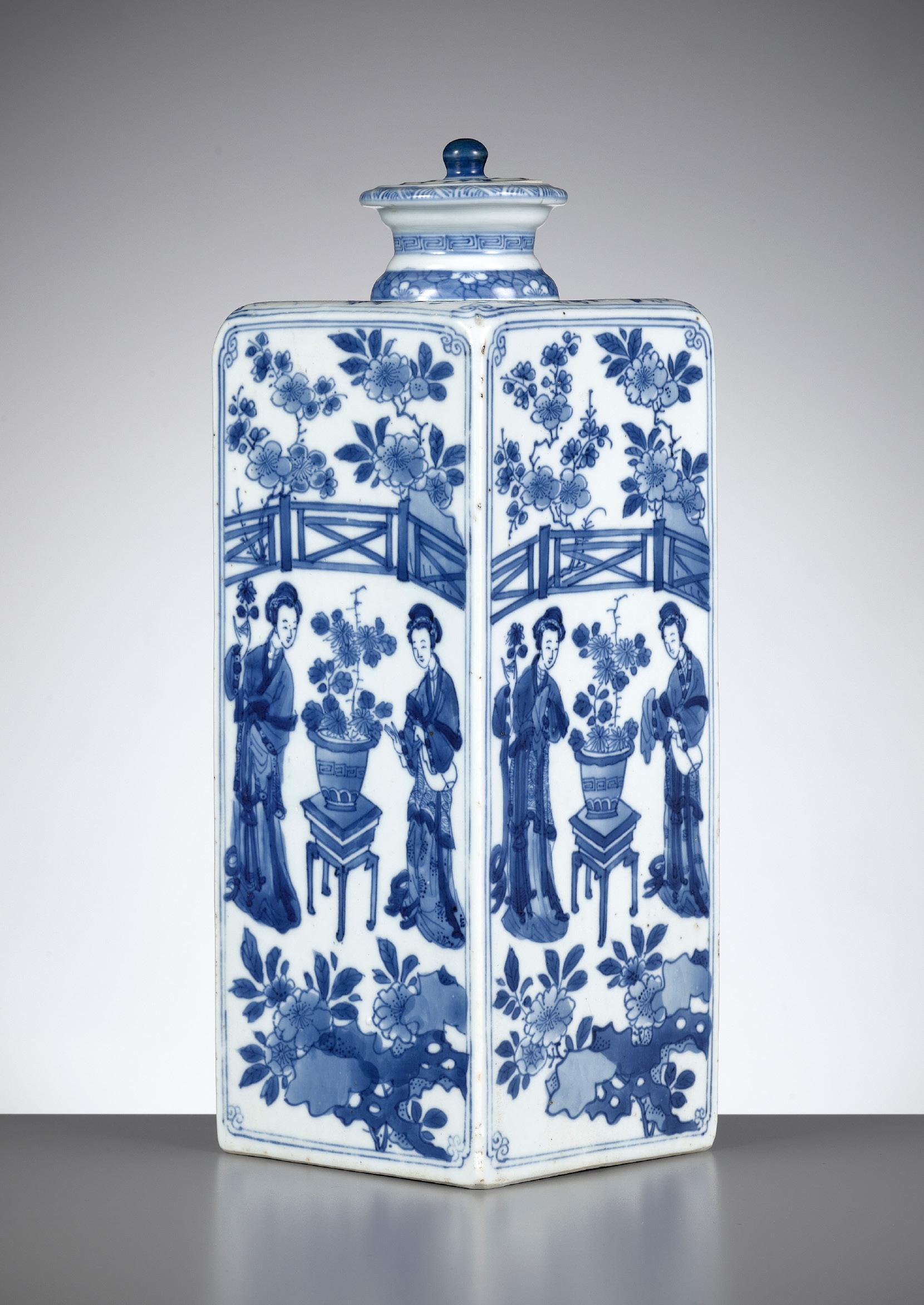
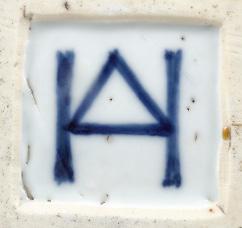
A PAIR OF LARGE BLUE AND WHITE BEAKER VASES, GU, KANGXI PERIOD
China, 1662-1722. Vibrantly painted in shades of cobalt blue with shaped panels enclosing leafy blossoming prunus, peony, aster, and chrysanthemum amid rockwork and grasses. The bulbous midsection framed by hatched designs enclosing prunus blossoms between bowstrings. The interior of the rim with a hatched band. The recessed bases each with an underglaze-blue lingzhi fungus mark within a double circle. (2)
Provenance: From an old private estate in Paris, France. A private collector in the United Kingdom, acquired from the above, via the London trade.
Condition: Condition commensurate with age, and presenting nicely overall. One vase with a firing crack to the rim and another to the base with an associated old fill. The foot with a small chip and associated old repair, the rim with a near-invisible restoration, c. 5x5 cm in size. The other vase with expected firing cracks, minor chips to the foot, and a hairline to the base and rim.
Weight: 3,277 g and 3,608 g
Dimensions: Height 49 cm (each)
Expert’s note: During the early Qing dynasty, up until the 1680s, conditions were unsettled in China and the making of Imperial wares as well as the use of reign marks on porcelain was restricted in various ways. During this period, different types of other marks came into use, including lingzhi fungus and artemisia leaf marks in double circles.
AUCTION RESULT COMPARISON
Type: Closely related
Auction: Christie’s New York, 8 October 2015, lot 261
Price: USD 15,000 or approx. EUR 17,500 converted and adjusted for inflation at the time of writing
Description: A pair of large Chinese blue and white porcelain beaker vases, Kangxi period
Expert remark: Compare the closely related form. Compare the related decoration with similar panels and floral designs as well as the artemisia leaf marks. Note the smaller size (42 cm). Note that one of the vases also has a rim restoration.
AUCTION RESULT COMPARISON
Type: Closely related
Auction: Christie’s London, 29 February 2012, lot 625
Price: GBP 12,500 or approx. EUR 23,000 converted and adjusted for inflation at the time of writing
Description: A pair of Chinese blue and white beaker vases, Gu, Kangxi period

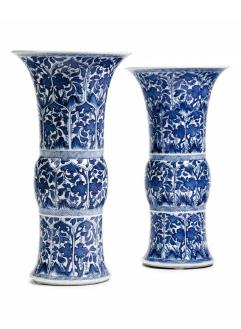
Expert remark: Compare the closely related form. Compare the related decoration with similar panels and floral designs as well as the artemisia leaf marks. Note the considerably smaller size (34.3 cm).
Estimate EUR 8,000
Starting price EUR 4,000
148 101
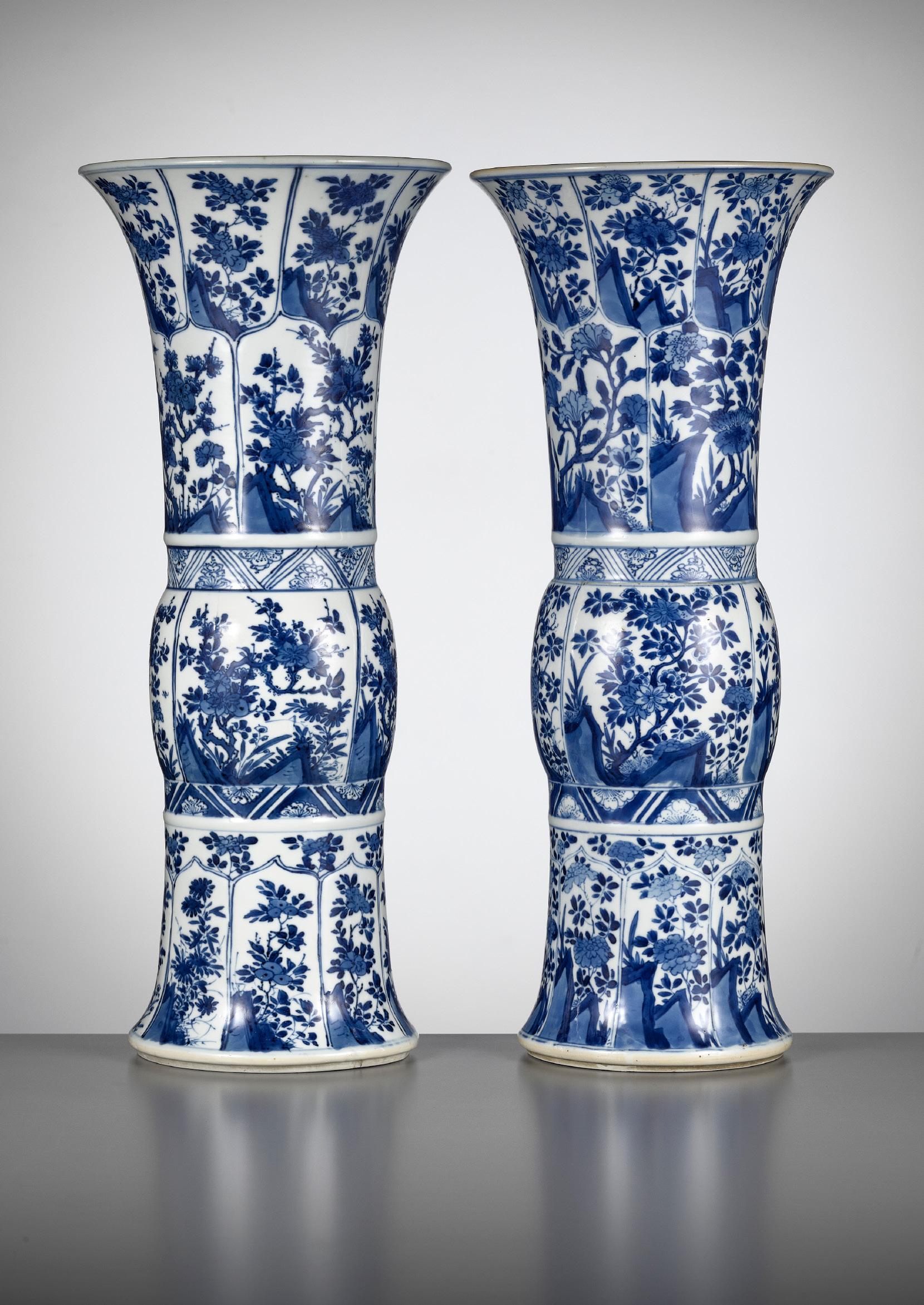
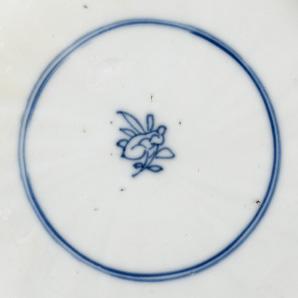
102
A FINELY ENAMELLED FALANGCAI ‘POPPY’ VASE OF MINIATURE SIZE, WITH AN ‘IMPERIAL CURIO’ MARK, YUWAN, CHINA, 18TH CENTURY
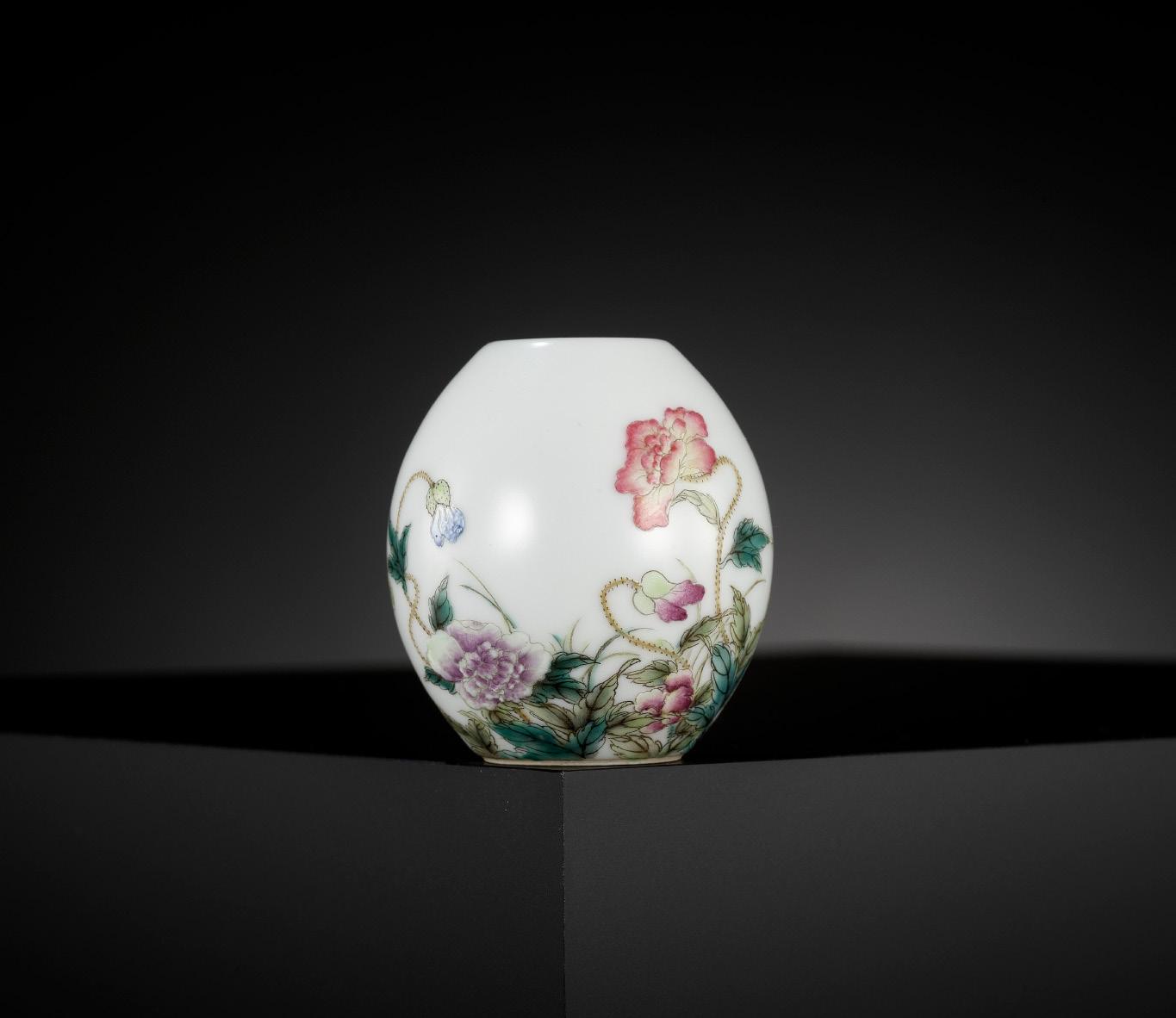
Superbly painted with the most exquisite opaque enamels, the poppies are shown in the various stages of the flower cycle: budding, blooming, and wilting, all rendered in subtly graduated shades of rose, blue, and lavender, borne on undulating stems with precisely painted microscopic hair, issuing finely veined leaves in various shades of lime and fern green, each bloom vibrantly detailed with subtle veining and lemon-yellow speckled stamens, the buds and petals in palpable light relief.
Inscriptions: The reverse inscribed with a poem in elegant calligraphy, ‘When they bloom, they are a brilliant red or purple. The fragrant wind often stays with the poppies.’ Three minuscule iron-red seals, each only 2-3 mm in size. The two-character yuwan mark neatly painted in underglaze cobalt blue to the base.
Provenance: From a private London collection, United Kingdom. Condition: Superb condition with only minor wear and minimal firing irregularities. Faint stains to the white porcelain around the foot. The interior base with a small firing flaw.
Weight: 42.2 g
Dimensions: Height 5.7 cm
LOT ESSAY
The base of the present lot features the Yuwan mark, a two-character inscription that translates to either “Imperial Curio” (as referenced in Gerard Tsang and Hugh Moss, Arts from the Scholar’s Studio, Hong Kong, 1986, page 124, no. 91) or “Imperial Plaything” (as mentioned in Christie’s Hong Kong, 30 May 2018, lot 2930). This mark is significant. In the 18th century, Curio Boxes gained immense popularity within the Imperial courts. Today, the National Palace Museum in Taipei proudly exhibits numerous such boxes, most still preserving their original contents. These contents constitute a painstakingly curated assortment of miniature Imperial wares, encompassing various items like jades, snuff bottles, porcelains, enameled objects, and even Japanese lacquers. Notably, the usual falangcai wares were incompatible with these boxes due to their size constraints. This discrepancy may have led to the creation of significantly smaller falangcai vessels, ensuring that this group of paramount Imperial wares could find representation within the curio collections as well. The present lot, exceptionally compact at a mere 5.7 cm, potentially served this specific purpose.
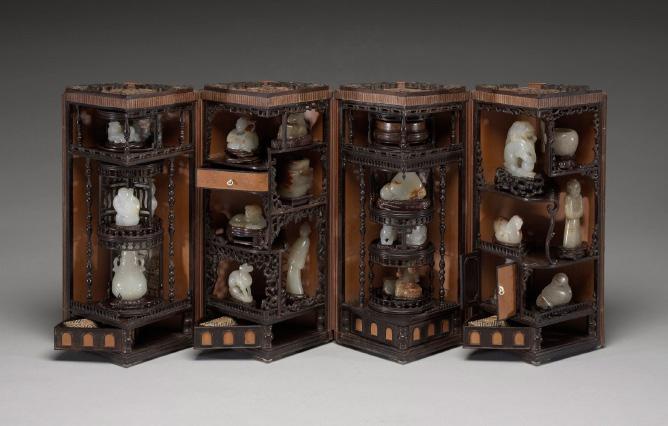
150
The interior of a curio box in the National Palace Museum, Taipei


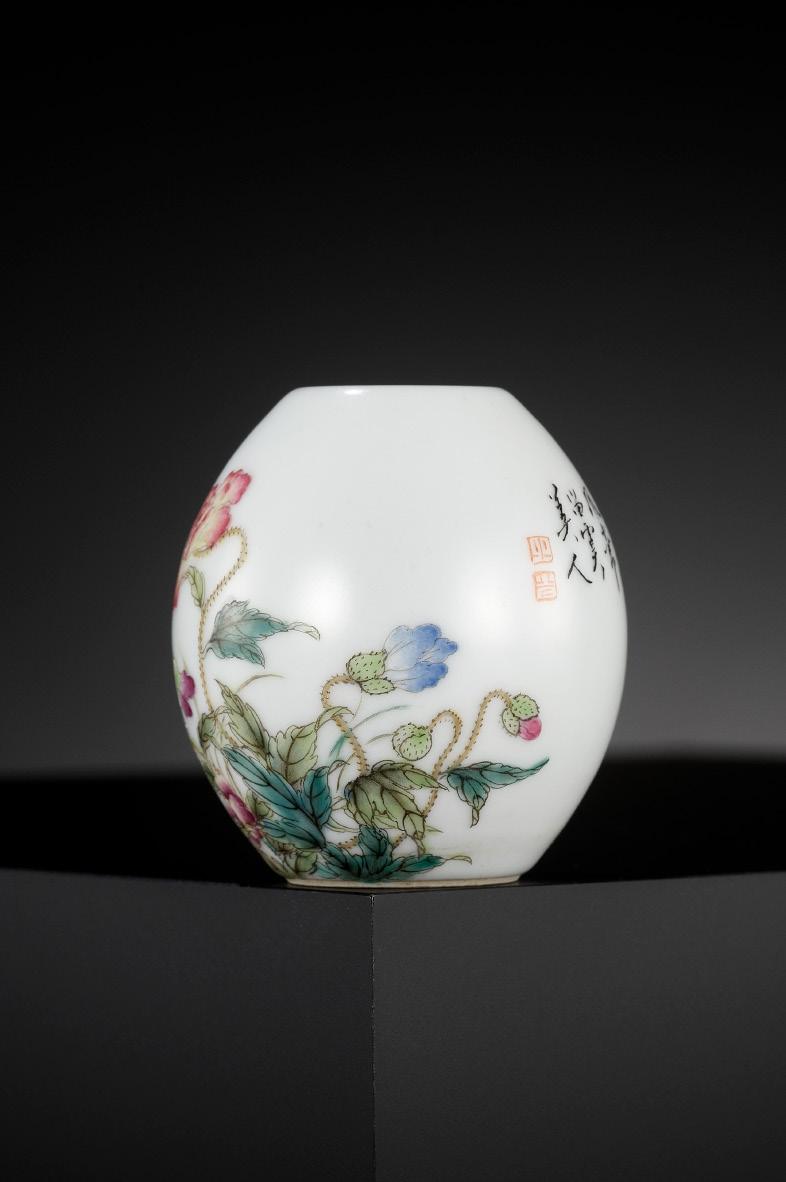
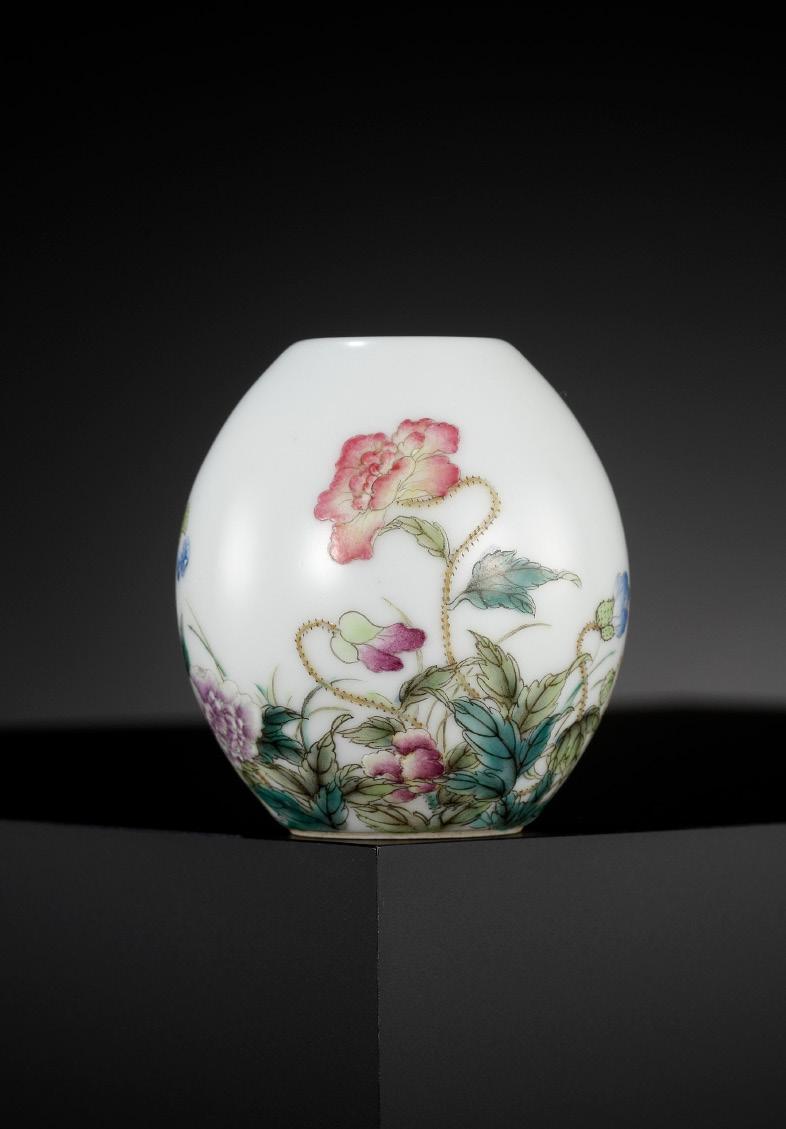
The miniature vessel is potted in the shape of a poppy bud in white porcelain of the purest homogenous structure, applied with an even milkywhite glaze, which is suffused by a myriad of microscopic bubbles, unseen to the naked eye, but well visible under a strong magnifying glass. As a result, the surface feels smooth and silky. The lip is just slightly protruding, unobtrusive yet distinct once perceived. The white glaze stops evenly above a circular recess around the foot, which not only mirrors the lip perfectly, but also leads to an immaculately cut foot rim, unglazed and thus revealing the white ware. This foot rim is a distinguishing mark of miniature falangcai wares, unique like a fingerprint, as the literature comparison below shows.
The poppies are depicted in their three life stages, thereby symbolizing the Three Perfections, known as sanjue, representing poetry, painting, and calligraphy. This artwork seamlessly combines all three into a singular masterpiece: The painting impeccably captures the flowers, showcasing meticulous observation from nature and exceptional control of the enamels. The flowers are portrayed in a wild growth, with wind-blown petals and bent stems, evoking a sense of disorderly beauty. The remarkably expressive calligraphy, skillfully written by a seasoned calligrapher, presents a striking juxtaposition with the untamed flowers while also evoking a timeless sense of balance. This sentiment is deepened by the accompanying poem, which extols the poppy, therewith subtly addressing the unwavering loyalty and devotion between lovers, a common subject in Chinese literature and legend.
Falangcai (foreign colours) designates enameling on copper, porcelain and glass undertaken in specialized workshops in the Yangxindian (Hall of Mental Cultivation), in immediate vicinity of the imperial living quarters in the Forbidden City and under the Emperors’ direct scrutiny. The enameling workshops had been initiated by European artisans working at the court during the Kangxi period, who encouraged the production of new enamel colors to be applied to extremely refined, blank porcelain vessels, supplied only for that particular purpose by the imperial porcelain kilns of Jingdezhen in Jiangxi province, south of the Yangzi River.
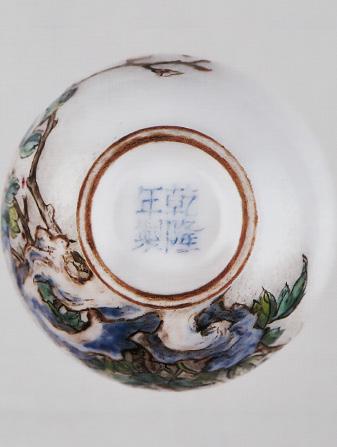
Porcelain enameling was done in close physical proximity to court painting, and artists of the Imperial Painting Academy, both Chinese and Western, were also recruited to paint in the enameling workshops. Painting styles therefore tend to show distinct influences of Western court artists, who introduced a naturalistic painting manner where the impression of volume, depth and perspective is conveyed through highly sophisticated shading, of which the present lot is a remarkable example, also due to its extremely small size. The realistic representation of the leaves and stems as well as the accomplished nuancing of the flowers show the direct influence of Western artists such as the Italian Giuseppe Castiglione (AD 1688 –1766), who served as court painter under the three main Qing emperors: Kangxi, Yongzheng, and Qianlong.
Never before or after, anywhere in the world, were porcelain painters exposed to similar pressure as in these tightly circumscribed workshops, where they were to meet the exact imperial expectations while being subject to immediate scrutiny from the monarch’s eyes. The whole setup was small in scale, not least for the simple reasons of space and inconvenience to ordinary palace life, and here individual artists would create individual works of art, incomparable even to the mass production of fine porcelains for the court undertaken at Jingdezhen. The workshops resembled sophisticated laboratories rather than art ateliers, and court artists, artisans and technicians teamed up there to explore new scientific discoveries, manufacturing methods and substances.
Every piece of porcelain produced in these workshops is unique, quality is unsurpassed and numbers, naturally, are very limited. Many examples, such as the present lot, do exist only once.
The poppy flower is easy to recognize by its frilly, less than paper-thin petals, its buds enveloped by a green hull, which it sheds when they open, and a hairy stem. Flower painting had been practiced in China since at least the Song dynasty (960-1279) but became a specialist genre due to the virtuosity of Yun Shouping (1633-1690), probably China’s most famous flower painter. His depictions of poppies inspired many painters, particularly in the Kangxi and Yongzheng periods, such as Wang Wu (16321690), Yun Bing (1670-1710), Ma Yuanyu (c. 1669-1722), Zou Yigui (16861772) and others, all of whom painted poppies, often in the form of album leaves representing one of the months of the year.
However, this ‘photogenic’ flower was rarely depicted on porcelain
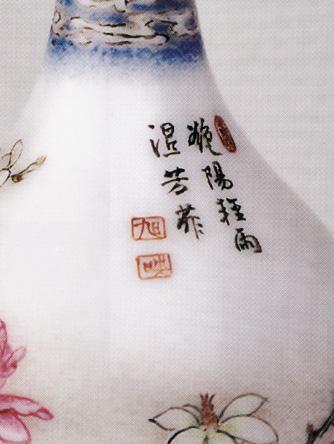
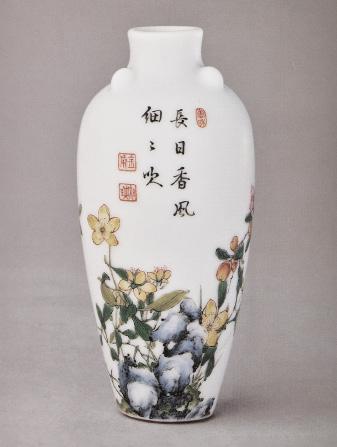
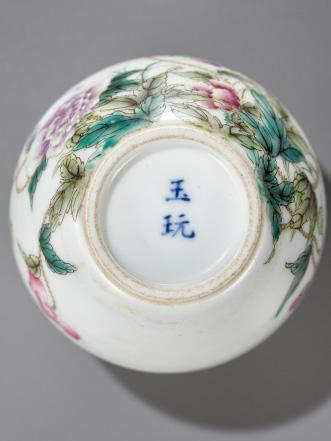
On falangcai wares from the Beijing enameling workshops, it was used already during the Kangxi period, but in a quite different, more lush and imposing form, with the flowers set against a purple ground (see Portrayals from a Brush Divine, A Special Exhibition on the Tricentennial of Giuseppe Castiglione’s Arrival in China, National Palace Museum, Taipei, 2015, cat. no. I-17). In the Yongzheng reign, it appears to have been rarely used in the Beijing workshops, but rendered in a manner much closer to the present lot.
LITERATURE COMPARISON
For a closely related falangcai vase, see Porcelains with Cloisonné Enamel Decoration and Famille Rose Decoration, The Complete Collection of Treasures of the Palace Museum, volume 39, Hong Kong, 1999, page 28, no. 24 (fig. 1). For a related falangcai vase, also with seals painted in iron-read, hardly legible because of their minuscule size, see ibid., page 29, no. 25 (fig. 2). Note that this vase has a height of 7.8 cm, still 2.1 cm larger than the present lot, and that the foot rim of this vase is near-identical to that of the present lot (fig. 3 & 4). For three related examples with non-Imperial marks, one with falangcai, one with famille rose, and one with grisaille decoration, see ibid., page 72, 73, and 89, no. 62, 63, 78. Compare also an Imperial falangcai ‘poppy’ bowl, Qianlong mark and period, with similar undulating stems, sold at Sotheby’s Hong Kong, 2 October 2018, lot 1. For an essay about puce enamels used for falangcai wares, see Porcelain with Painted Enamels of Qing Yongzheng period (1723-1735), The National Palace Museum, pages 308-313. Note that the puce enamels found in the withered poppy on the present lot bear the same sulfuric-yellow oxidation marks described and illustrated in the article.
Estimate EUR 150,000
Starting price EUR 75,000
152
fig. 1 fig. 2
fig. 3 fig. 4
AN ABSOLUTELY PERFECT PAIR OF BLUE AND WHITE ‘THREE FRIENDS OF WINTER’ KLAPMUTS BOWLS, KANGXI PERIOD
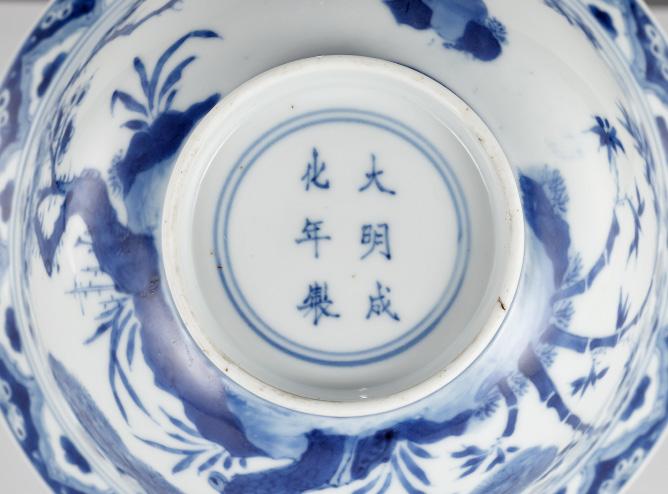
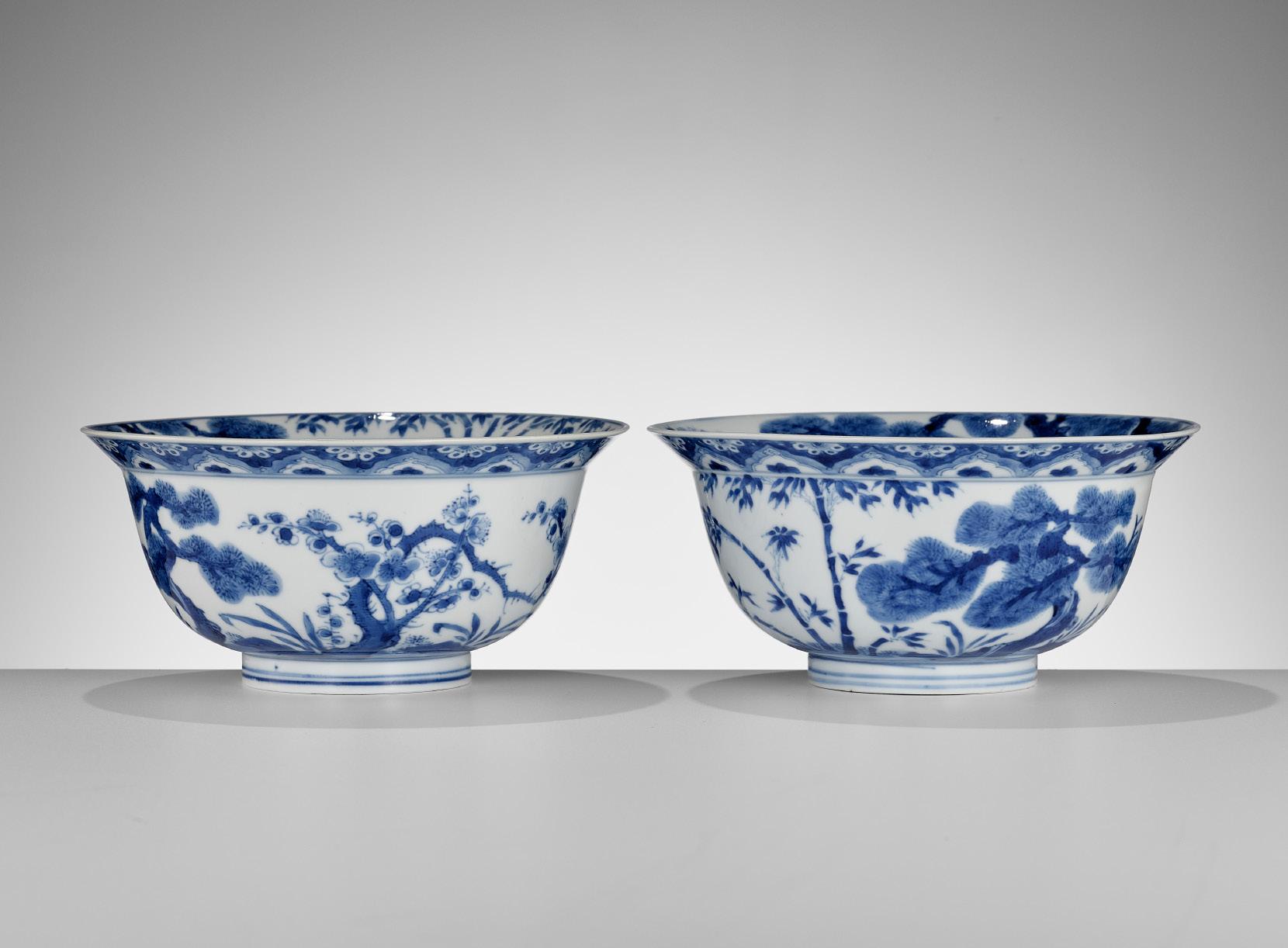
China, 1662-1722. Delicately potted, each with gently rounded sides rising from a straight foot to a broad everted rim, finely painted in shades of cobalt blue to the exterior with leafy bamboo, gnarled pine, and blossoming prunus, below a band of ruyi heads and stylized flowerheads to the rim, the interior with a central flowering prunus tree growing from rockwork, the rim repeating the ‘Three Friends of Winter’ motif.
Provenance: From the collection of Frances L. Dickson, and thence by descent within the family. Frances Louisa Dickson (1876-1967, née Maunsell) was an avid collector of both European and Chinese porcelain. She lived with her husband, Colonel William Dickson, and their four daughters at Kildimo House, county Limerick, Ireland, and in Bournemouth, England, in 1910. While little is known about her life, Frances Dickson’s substantial contribution to The Fitzwilliam Museum, Cambridge University, has been noted for a great variety of porcelain figures and vessels from various ancient periods.
Condition: Superb condition with only minor wear and firing irregularities. It is extremely rare to find authentic klapmuts bowls from the Kangxi period in such a pristine condition as these, let alone a pair!
Weight: 272.1 g and 270.8 g
Dimensions: Diameter 16 cm and 15.9 cm
The bases each with an apocryphal six-character mark da Ming Chenghua nianzhi.
The ‘Three Friends of Winter’ motif is frequently used across all mediums in Chinese art. Comprised of pine, bamboo and prunus, this motif is emblematic of the Confucian virtues of fortitude and resilience. As the pine and bamboo are evergreen plants and the prunus, a plant that has lived for a long time, the three together are also an auspicious symbol of longevity.
AUCTION RESULT COMPARISON
Type: Closely related
Auction: Christie’s Amsterdam, 27 September 2005, lot 238
Price: EUR 6,600 or approx. EUR 10,000 adjusted for inflation at the time of writing
Description: A blue and white ‘klapmuts’ bowl, Chenghua six-character mark, Kangxi period
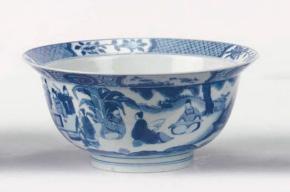
Expert remark: Compare the identical form, similar style and technique of painting, and apocryphal six-character Chenghua mark. Note this lot comprises only a single bowl. Note the slightly larger size (20.1 cm).
Estimate EUR 10,000
Starting price EUR 5,000
153
103
A CORAL-ENAMELED FAMILLE ROSE ‘POPPY’ DISH, JIUWAN SHANFANG SEAL MARK, CHINA, 18TH CENTURY
Expert’s note: The mark on the present lot, ‘Jiuwan Shanfang’ (Mountain lodge of nine Wan) is recorded as a hall mark from the Qianlong era. Wan is an ancient area measurement unit.

Delicately potted with shallow rounded sides supported on a short foot. The interior is brightly enameled with poppy blossoms, whose delicate stems twist and bend, against a white ground while the exterior is covered entirely with a perfectly even coral-red enameling. The base with a transparent glaze and an underglaze blue fourcharacter Jiuwan Shanfang seal mark.
Provenance: Scotland trade.
Condition: Excellent condition with only minimal wear, glaze flaking and firing irregularities.
Weight: 445 g
Dimensions: Diameter 21.6 cm
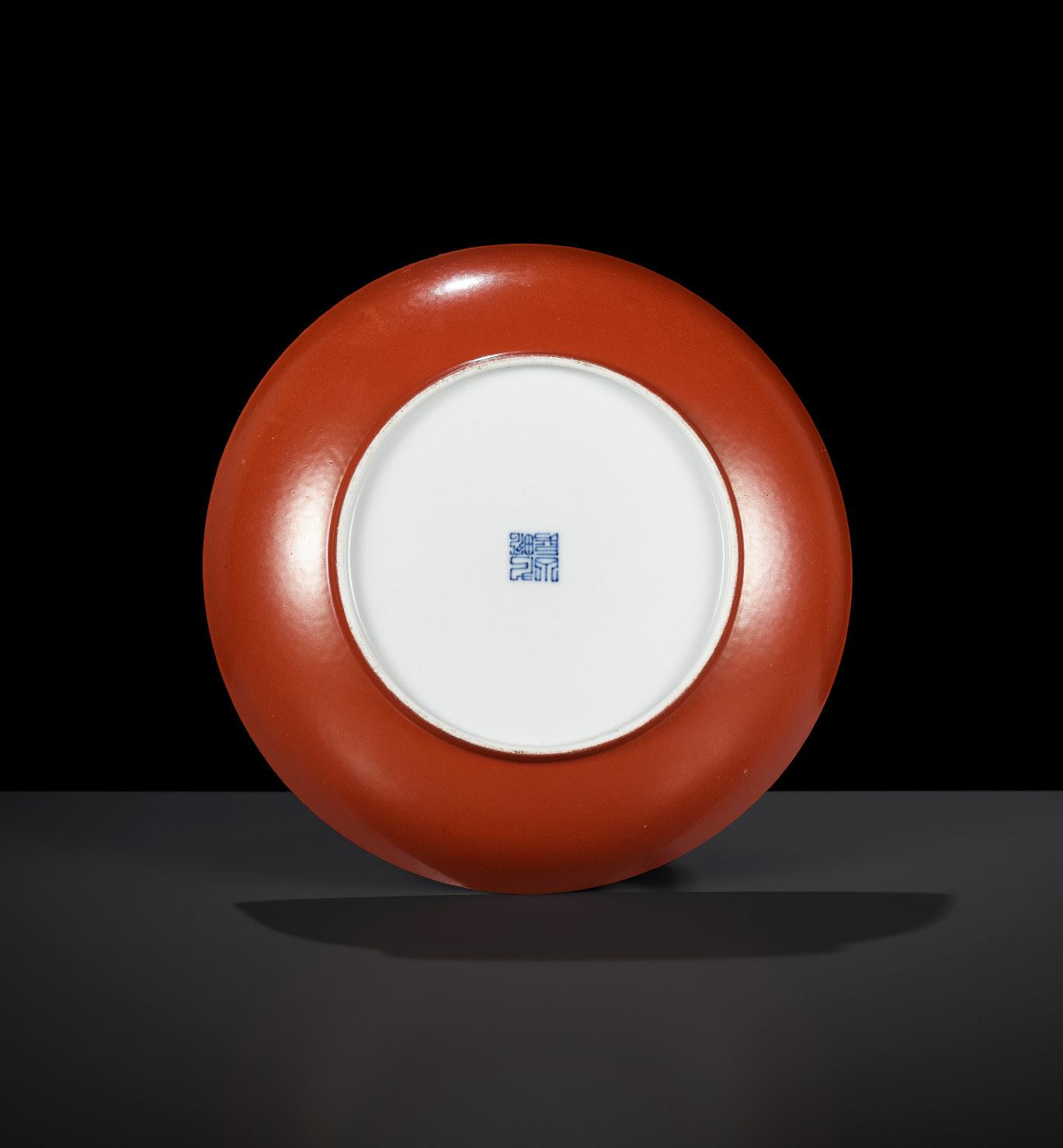
AUCTION RESULT COMPARISON
Type: Closely related
Auction: Sotheby’s London, 7 November 2018, lot 72
Price: GBP 50,000 or approx. EUR 79,500 converted and adjusted for inflation at the time of writing
Description: A rare rubyground famille-rose ‘floral’ bowl, Qing dynasty, Qianlong period
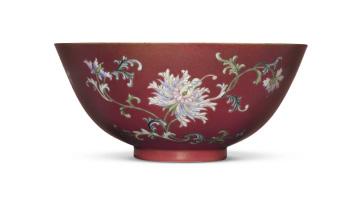
Expert remark: Compare the closely related decoration, ruby-ground enameling, and the identical mark. Note the size (19 cm).
Estimate EUR 10,000
Starting price EUR 5,000
154 104

The ovoid body is supported on a spreading foot and surmounted by a tall cylindrical neck. The foot rim is slightly pronounced. Covered overall with a thick, finely crackled glaze of a rich crushed-strawberry tone, thinning to mushroom at the mouth, and with a faint hue of bluish lavender flambé around the upper section of the neck. The base is left unglazed and covered in a brown wash.
Expert’s note: The dramatic streaks in the langyao glaze along the lower body of the vase are evocative of a monumental mountain range.
Provenance: London trade.
Condition: Very good condition with old wear, some firing irregularities and intentional glaze crackling. The foot smoothened, probably inherent to manufacturing, due to the uneven glaze dripping along the foot rim which is expected from this type of ware.
Weight: 3,322 g
Dimensions: Height 40.9 cm
AUCTION RESULT COMPARISON
Type: Closely related
Auction: Sotheby’s Hong Kong, 8 April 2014, lot 3081
Price: HKD 525,000 or approx. EUR 78,000 converted and adjusted for inflation at the time of writing
Description: A Large Flambé-Glazed Bottle Vase, Changjingping, Qing Dynasty, late 18th century Expert remark: Compare the closely related red glaze with similar flambé streaks at the upper end of the neck. Note also the similar form and foot rim.
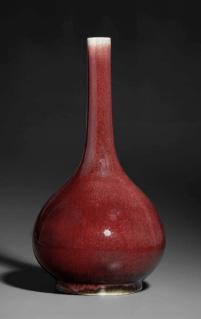
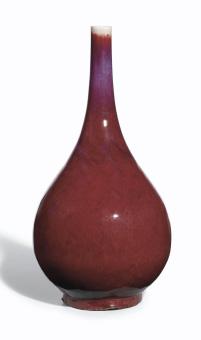
AUCTION RESULT COMPARISON
Type: Related
Auction: Christie’s New York, 23 September 2022, lot 912
Price: USD 94,500 or approx. EUR 88,000 converted and adjusted for inflation at the time of writing
Description: A langyao bottle vase, Kangxi period
Expert remark: Compare the related red glaze with similar dramatic streaking. Note the different form, the precisely formed foot rim, and the similar size (41.3 cm).
Estimate EUR 15,000
Starting price EUR 7,500
156 105
A SUPERB LANGYAO BOTTLE VASE, CHANGJINGPING, CHINA, 18TH CENTURY

A WHITE-GLAZED PORCELAIN WATER DROPPER, JOSEON DYNASTY
Korea, 18th-19th century century. Of compressed globular form descending to a short foot, a round tapered opening in the center and an S-shaped spout with a flush top, and a short, tapered foot. The clear glaze of bluish hue covering all surfaces.
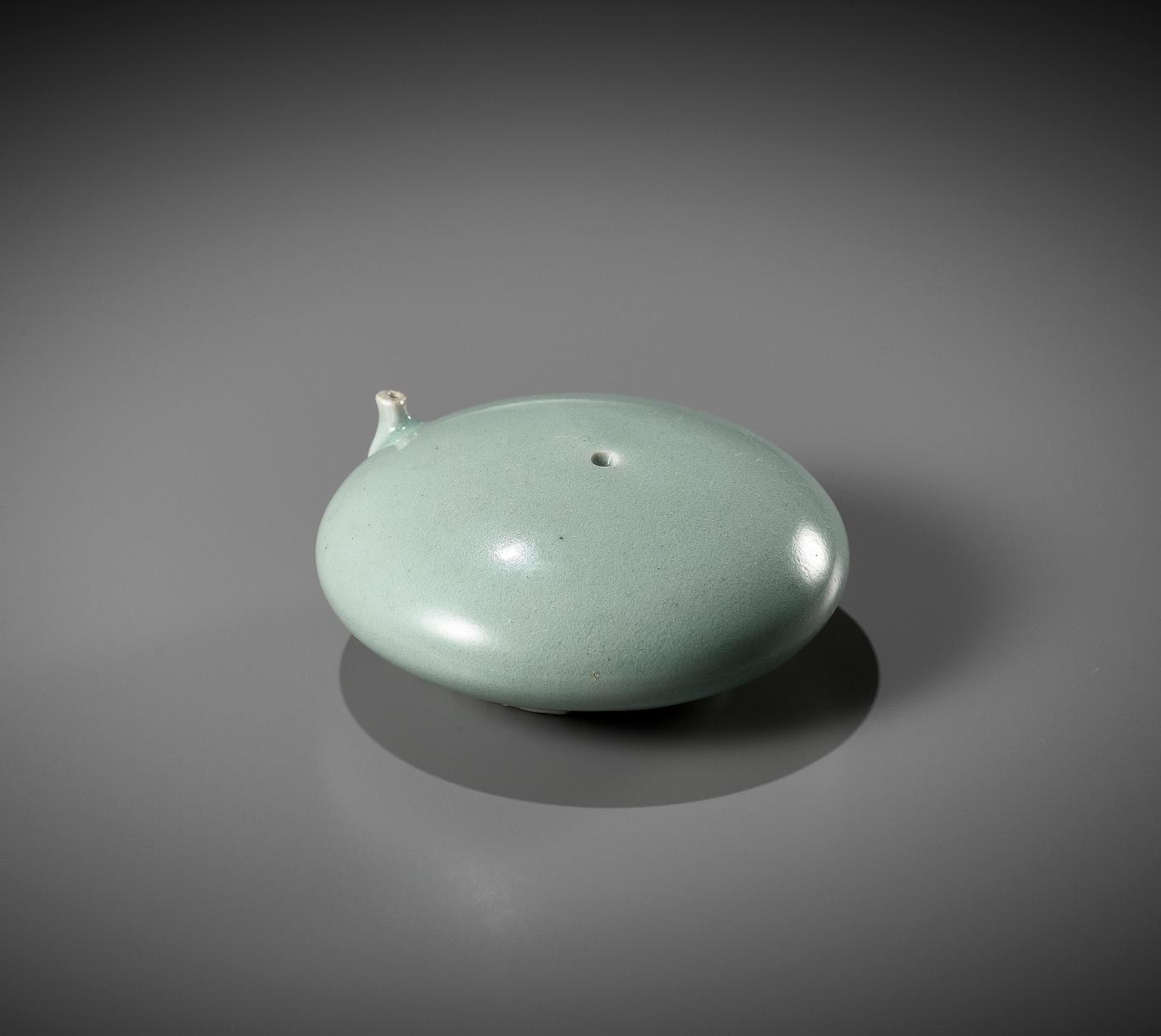
Provenance: Collection of Winslow Ames. Property of the Trustees of Phillips Academy, Andover, Massachusetts, USA, gifted from the above. The Phillips Academy was founded in 1778 during the American Revolution. The highly selective academy has among its alumni U.S. Presidents George H.W. Bush and George W. Bush, along with numerous notable politicians, Nobel laureates, and recipients of the Medal of Honor. Edward Winslow Ames Jr. (1907-1990) was a prominent American art historian, author, and museum director. He attended Phillips Academy as a child, and later studied art history at Harvard. He went on to become the founding director of Lyman Allyn Art Museum in New London, Connecticut, in 1930. After World War II, he was the first director of the Huntington Hartford’s Gallery of Modern Art at Columbus Circle in Manhattan, working with the collection before the museum opened to the public. He started collecting drawings and furniture in the 1930s and eventually branched out into European and Asian works of art. Condition: Very good condition with old wear and firing irregularities, including kiln grit and glaze recesses.
Weight: 223.8 g
Dimensions: Diameter 10.2 cm
Literature comparison: Compare a closely related glazed porcelain water dropper, 8 cm diameter, dated to the Joseon dynasty, 19th century, in the Brooklyn Museum, accession number 84.262.28. Compare a related glazed porcelain water dropper, 8.6 cm diameter, dated to the Joseon dynasty, 19th century, in the Brooklyn Museum, accession number 84.189.1.
AUCTION RESULT COMPARISON
Winslow Ames, 1935.

Type: Related
Auction: Christie’s New York, 20 March 2007, lot 506
Price: USD 12,000 or approx. EUR 16,500 converted and adjusted for inflation at the time of writing
Description: A white porcelain domed water dropper, Joseon dynasty, 19th century Expert remark: Note the size (9.3 cm).
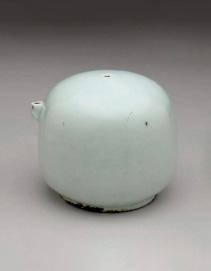
Estimate EUR 3,000
Starting price EUR 1,500
158 106
Photograph by Paul A. Juley. Archives of American Art, Smithsonian Institution
107
A COPPER-RED-DECORATED SOLIFLORE VASE, JOSEON DYNASTY
Expert’s note: This exquisite vase acquired a uniquely graceful form, reminiscent of a flower turning towards the sun, due to its tilting during the firing process. Its beauty makes it a perfect fit for a soliflore. At some point in the early 20th century, after the vase reached Europe, a neatly fitted wood stand was added to ‘correct’ its tilted shape. However, it’s now up to the new owner to decide whether they prefer to display the vase with or without this stand.
Korea, late 17th - 18th century. The pear-shaped vase with a slender neck and flared mouth, well painted in copper-red beneath the soft grayish-white glaze with stylized flowerheads, borne on leafy scrolling vines framed by line borders below scroll and geometric designs.
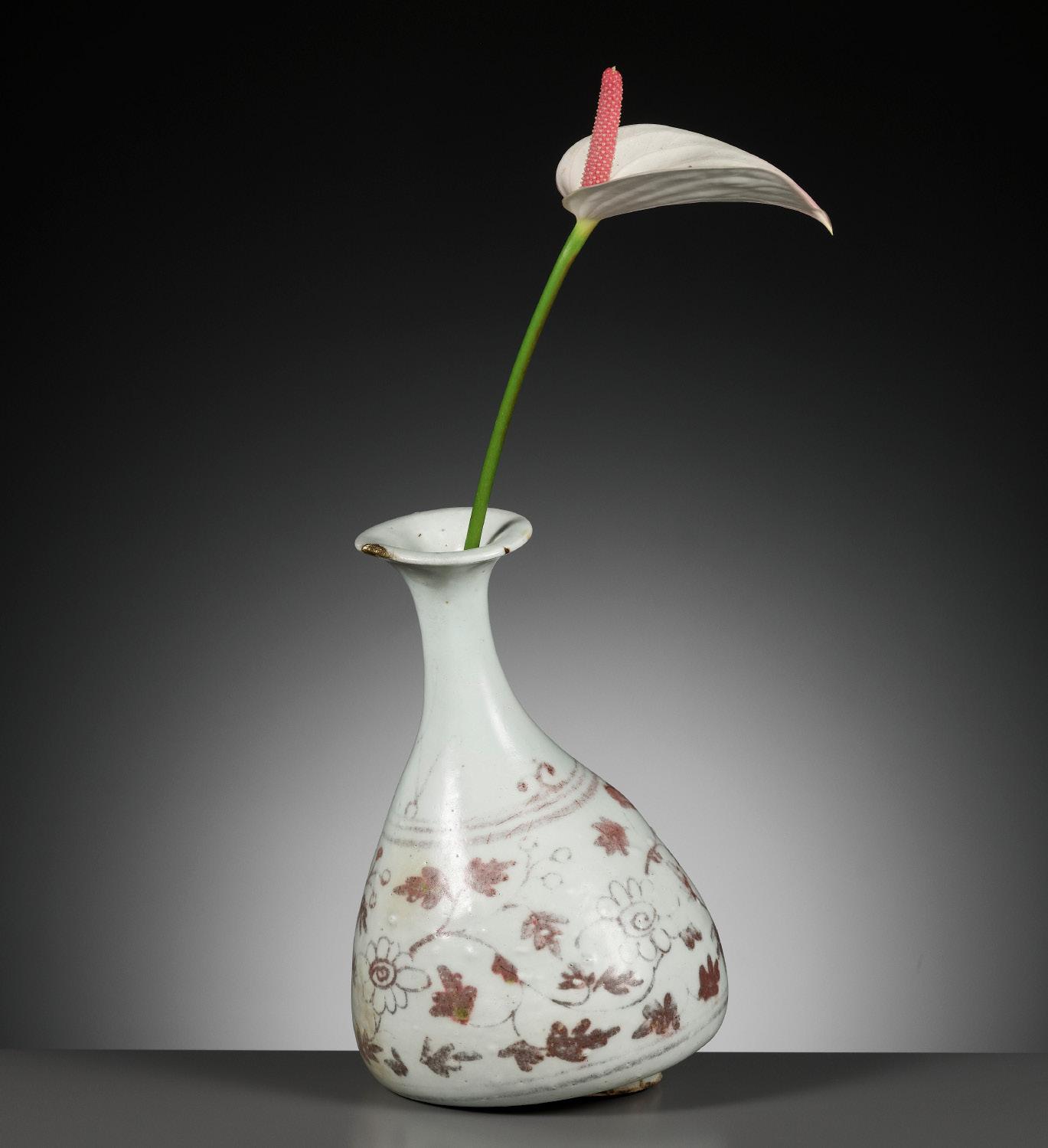
Provenance: French trade. Acquired from an old French private collection of Korean ceramics and works of art.
Condition: Obvious flaws including tilting, pitting, browning, kiln grit, glaze oxidization and minor fading to the copper-red. Some wear and small chips with associated kintsugi repairs. Overall presenting exceptionally well.
Weight: 631.8 g (excl. stand)
Dimensions: Height 21 cm (excl. stand) and 26 cm (incl. stand)
With an associated fitted wood stand. (2)
Literature comparison: Compare a related jar similarly decorated in copper-red with leafy vines, 25.6 cm high, dated to the mid-18th century, in the Metropolitan Museum of Art, accession number 1879.413.2. Compare also a related jar with copper red floral scroll design, 29.8 cm high, dated to the 18th century, in the Los Angeles County Museum of Art, accession number M.2000.15.112.
AUCTION RESULT COMPARISON
Type: Related
Auction: Sotheby’s New York, 22 September 2022, lot 517
Estimate: USD 80,000 or approx. EUR 78,000 converted and adjusted for inflation at the time of writing
Description: An underglaze-red ‘birds’ faceted jar, Joseon dynasty, 18th century Expert remark: Compare the related copper red painting. Note the size of 18.8 cm.

Estimate EUR 6,000
Starting price EUR 3,000
159
A GE-TYPE ‘KINUTA’ VASE, CHINA, 18TH CENTURY

Expert’s note: This remarkable ‘Kinuta’ vase exemplifies the finest Ge wares, which have been revered both in China and Japan for many hundreds of years. At its finest, Ge glazes are thick, completely opaque, and have a rich pattern of black and golden-brown crackles. The glaze on the present vase also displays the ideal soft bluish-grey color, which was so difficult for potters to achieve, but has always been greatly admired by connoisseurs. The name ‘Kinuta’, which in fact is the Japanese term for a mallet, refers to a group of mallet-shaped vases which were imported to Japan in the Song dynasty and thereafter.
Of slightly flared cylindrical form with sloping shoulders, surmounted by a tall cylindrical neck rising to a distinctively lipped rim, the hallmark of this group. The body covered overall in a fine gray glaze suffused by a dense matrix of dark crackles, with scattered paler crackles in between, except the foot rim exposing the dark body beneath.
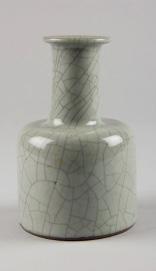
Provenance: Swedish trade, by repute acquired from an old Scandinavian private collection.
Condition: Excellent condition with expected old wear and firing flaws, such as dark spots, pitting and slightly irregular glaze pooling above the foot rim, shallow surface scratches and minor staining to glaze.
Weight: 311 g
Dimensions: Height 12.8 cm
LITERATURE COMPARISON
Compare with two related vases at the Palace Museum, Beijing, illustrated in Song Dynasty (III), The Complete Collection of Treasures of the Palace Museum, Hong Kong, 1996, no. 35 and no. 36. Another related vase in Palace Museum was included in the exhibition catalogue ‘Possessing the Past: Treasures from the National Palace Museum’, New York, 1996, pl. 123. Also compare with a mallet shaped vase in the Metropolitan Museum, accession number 1993.386.26 (fig. 1). fig. 1
Estimate EUR 6,000
Starting price EUR 3,000
160
108
A RARE CELADON-GLAZED TEAPOT, YONGZHENG MARK AND PERIOD
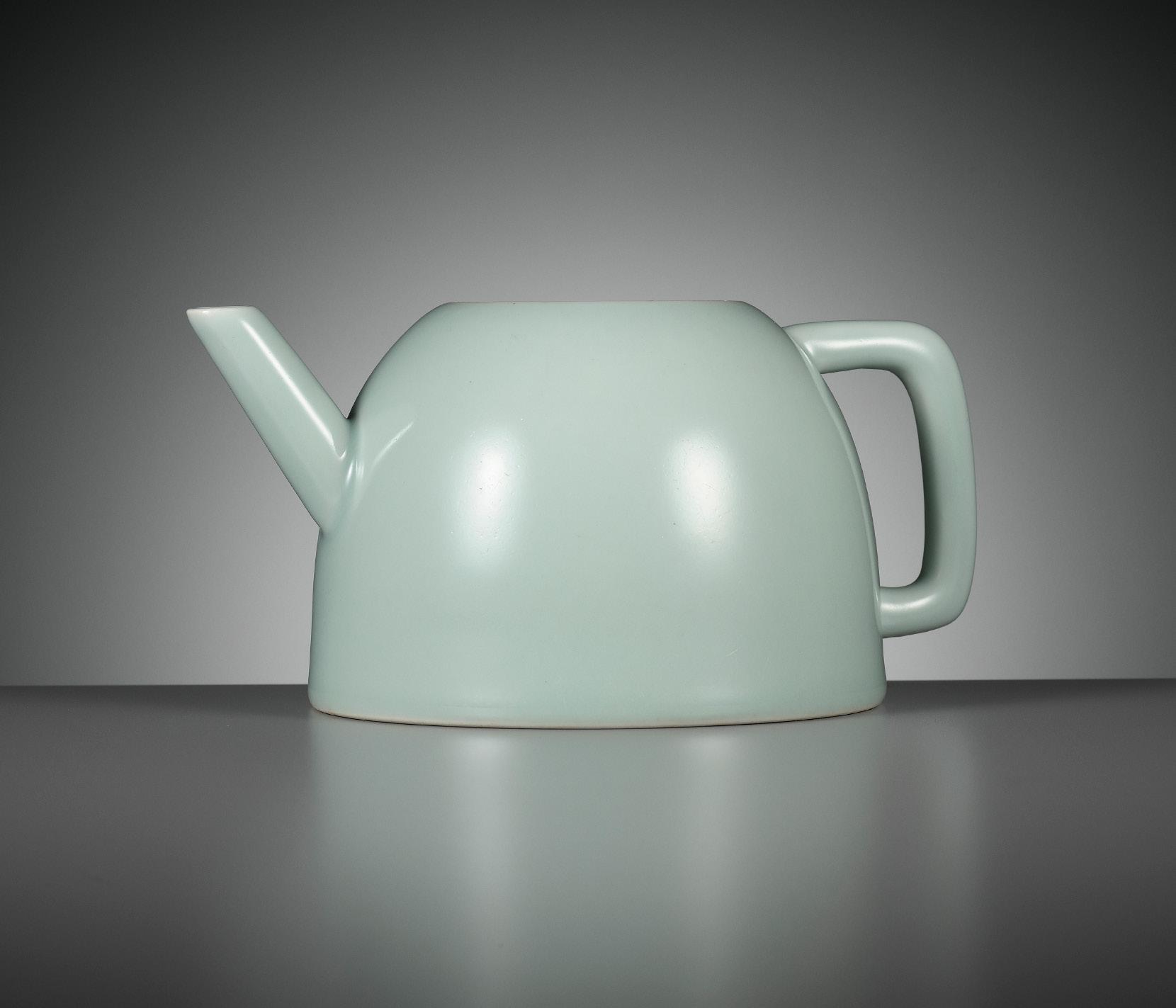
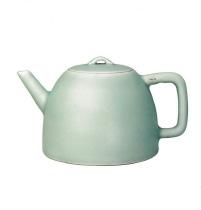
China, 1723-1735. Exquisitely potted, the tapered body flanked by a rounded half-square handle and a slender spout, covered overall in a superb, unctuous glaze of even celadon tone. The recessed base with an underglaze-blue six-character seal mark da Qing Yongzheng nianzhi and of the period.

Provenance: The base with an old collection label, ‘Baerwald Collection.’ Paul Baerwald (1871-1961) was a German-born Jewish-American banker and philanthropist, who served as treasurer and later chairman of the American Jewish Joint Distribution Committee (JDC). His brother Emil Baerwald lived in Europe, and, as an active collector of Chinese ceramics, he became acquainted with leading Chinese art collectors there, including George Eumorfopoulos and Sir Percival David. Paul likely received much of his collection from Emil, a part of which was exhibited by John Sparks in London in 1937 (An Exhibition of the Paul Baerwald Collection of Chinese porcelain, 15 June - 3 July 1937).

Condition: Good condition with minor old wear and small manufacturing irregularities. A minute chip to the rim and few microscopic nicks. The lid is lost.
Weight: 1,002.9 g
Dimensions: Length 21.3 cm
With a fitted silk box. (2)
From the Tang dynasty onwards, tea drinking was an activity celebrated in style, but the infusion of tea leaves in a teapot dates only from the Ming dynasty. Until then, powdered tea was mixed with hot water, as in the Japanese tea ceremony, which required different utensils.
The striking modernity of this teapot, with its harmoniously proportioned, elliptic dome shape and its clear, geometric lines of handle and spout, is probably derived from it being designed on paper rather than developed on the potter’s wheel. The design may be by Tang Ying, later supervisor of the Jingdezhen kilns, who developed styles for Jingdezhen already in the early Yongzheng period, while still working at the Beijing workshops. Simplicity of form and absence of decoration were stylistic trends introduced by him and endorsed by the Emperor, but the radical functionality of this piece, which is not based on earlier models, is remarkable. Its precise shape and even glaze would have made the highest demands on the potters’ skills.
LITERATURE COMPARISON
Compare a closely related Yongzheng teapot with cover, 12.2 cm high, also with a Yongzheng mark and of the period, in The Palace Museum, Beijing, accession number Gu151943, exhibited by the Royal Academy of Arts and published in Evelyn S. Rawski and Jessica Rawson, China: The Three Emperors 1662-1795, 2006, p. 256, no. 170.
Estimate EUR 6,000
Starting price EUR 3,000
109
A RU-TYPE MALLET VASE, YONGZHENG MARK AND PERIOD
China, 1723-1735. Superbly potted, the gently flared cylindrical body encircled below the rounded shoulder by a raised bowstring, surmounted by a tall, slender waisted neck with a cup-shaped mouth, flanked on each side by zoomorphic handles with neatly incised eyes and mouths. Covered overall in a perfectly even and lustrous greenishblue glaze, save for the foot rim which reveals the white ware, partially covered in a brown wash. The base with an underglaze-blue fourcharacter seal mark Yongzheng nianzhi and of the period.
Provenance: From a noted private collection in New York, USA. Condition: Superb condition with only minor wear and minimal firing irregularities.
Weight: 408.5 g
Dimensions: Height 16.8 cm
This rare vase is remarkable for its subtle bluish glaze, the purity of which accentuates the graceful curves of its profile. Created in imitation of the celebrated Ru-wares of the Song period, this vase reflects the Yongzheng Emperor’s penchant for these early wares and the remarkable technical developments achieved at the Imperial kilns made to meet the specific taste of the emperor. While a delicate celadon glaze had already been developed in the Kangxi reign, it was during the Yongzheng period that the production of glazes imitating Song dynasty Ru and Guan wares greatly expanded. According to the 1732 edition of the Jiangxi Tongzhi (Jiangxi provincial gazetteer), compiled by Xie Min, governor of Jiangxi Province between 1729 and 1732, two different types of Ru-type glazes were developed, one displaying a subtle network of crackles and the other of even tone; see S. W. Bushell, Oriental Ceramic Art, London, 1981, page 195.
Literature comparison: Compare two related vases in the Baur Collection, Geneva, illustrated in John Ayers, The Baur Collection, vol. III, Geneva, 1972, pl. A361 for a Yongzheng-marked vase of similar size but lacking handles and pl. A341 for a Qianlong-marked vase with handles. Compare a vase of this form with a flambé glaze in the National Palace Museum, Taipei, illustrated in Monochrome Porcelains of the Ch’ing Dynasty, 1970, no. 20.
AUCTION RESULT COMPARISON
Type: Near-identical
Auction: Christie’s Paris, 23 June 2020, lot 128
Price: EUR 37,500 or approx. EUR 45,000 adjusted for inflation at the time of writing
Description: Petit vase en porcelaine celadon de type Ru, Chine, Dynastie Qing, possiblement epoque Yongzheng (1723-1735)

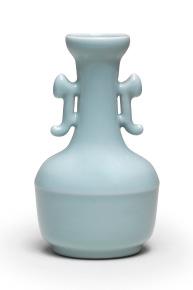
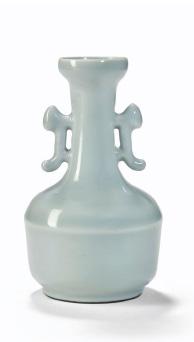
Expert remark: Compare the identical form and reign mark, the similar greenish-blue ‘celadon’ glaze, and the near-identical foot rim, also covered partially in brown wash. Note the smaller size (13 cm).
AUCTION RESULT COMPARISON
Type: Closely related
Auction: Bonhams London, 3 November 2022, lot 8
Price: GBP 53,220 or approx. EUR 64,500 converted and adjusted for inflation at the time of writing
Description: A very rare ru-type vase, yongzheng seal mark and of the period
Expert remark: Compare the closely related form, reign mark, sky-blue glaze, and size (12.8 cm).
AUCTION RESULT COMPARISON
Type: Related
Auction: Christie’s Paris, 22 November 2005, lot 174
Price: EUR 156,000 or approx. EUR 208,000 adjusted for inflation at the time of writing
Description: A fine and rare ru-type vase, Yongzheng four-character seal mark and of the period
Expert remark: Compare the closely related form, sky-blue glaze, and reign mark. Note the much larger size (27.5 cm).
Estimate EUR 20,000
Starting price EUR 10,000
162 110
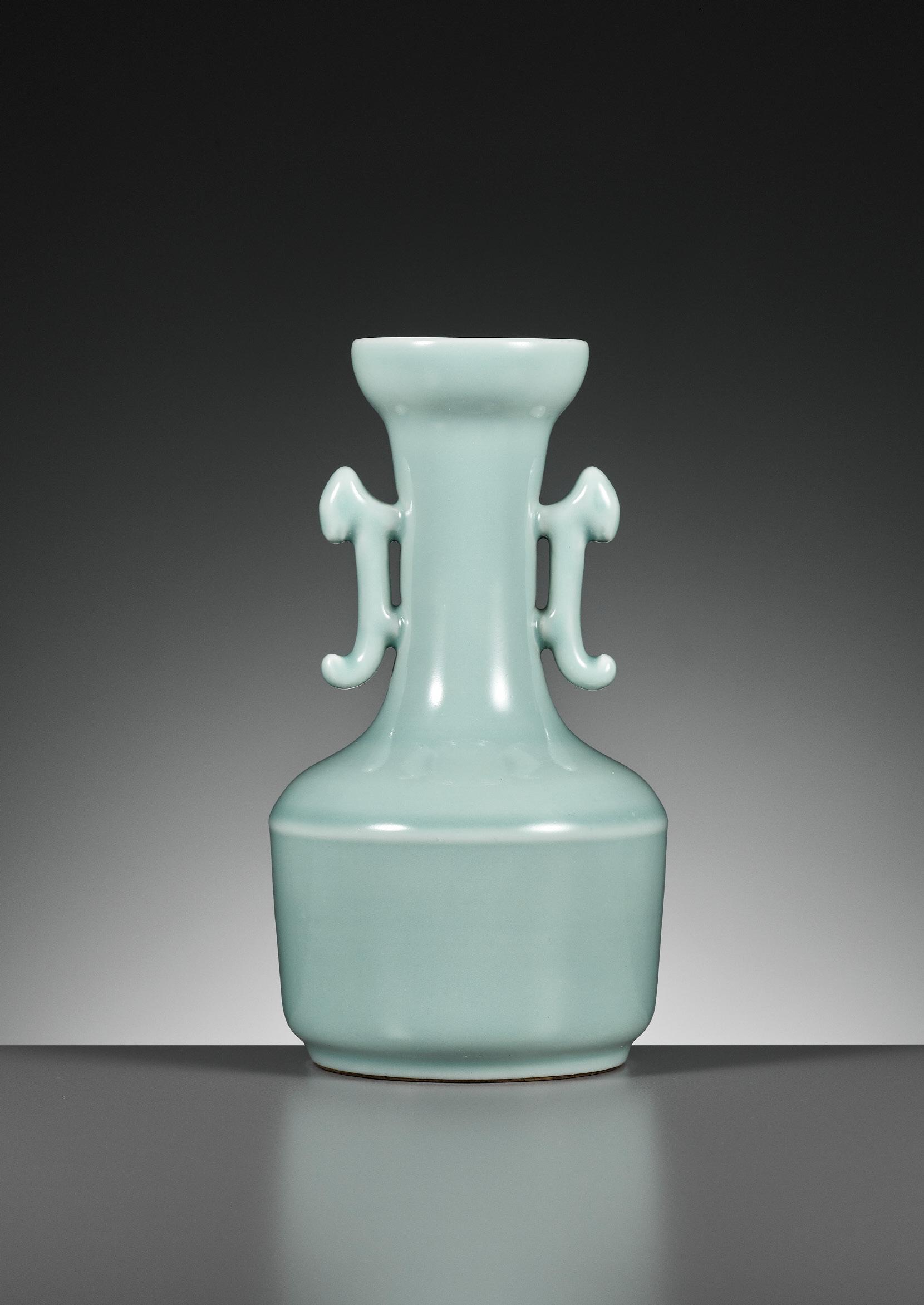
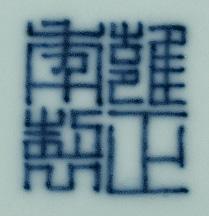
A TEADUST-GLAZED VASE, YONGZHENG
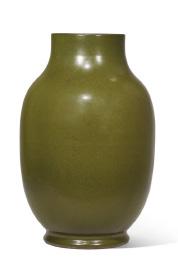
China, 1721-1735. The compressed globular body supported on a short tapered foot and rising to a slender waisted neck with flared mouth, the body encircled by two bowstrings. The magnificent tea dust glaze is applied evenly to the body and the inside of the vase, thinning distinctively to a dark red tone at the rim of the mouth and along the edges of the base.
Provenance: The J. M. Hu, Zande Lou Collection. The padded silk box with an old note inscribed in Chinese, in parts referring to the present lot, described as ‘Yongzheng Teadust-glazed Vase with peony [shape] and lines’, confirming the dating above. Two old labels to the exterior of the box, ‘M132’ and ‘128’. Jenmou Hu (1911-1995) was arguably the most important collector of Chinese ceramics in the last century. In both his personal collection and in his bequests to cultural institutions, J. M. Hu stood as a model of the modern scholar-collector. Condition: Excellent condition with minor old wear and expected firing irregularities, including a small polished glaze flaw near the foot.
Weight: 589.1 g
Dimensions: Height 16.5 cm
With a fitted padded silk storage box. (2)
AUCTION RESULT COMPARISON
Type: Related
Auction: Christie’s Hong Kong, 8 October 2020, lot 357
Price: HKD 250,000 or approx. EUR 30,000 converted and adjusted for inflation at the time of writing
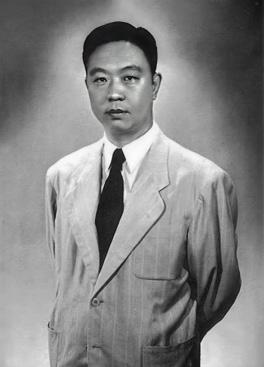
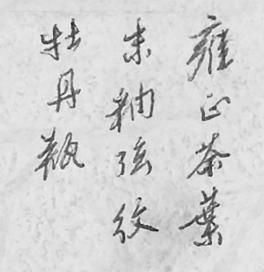
Description: A fine large teadust-glazed latern vase, Qing dynasty, 18th-19th century
Expert remark: Compare the related teadust glaze. Note the different form and larger size (46.5 cm). Also note that this lot is unmarked, exactly as the present lot
Estimate EUR 10,000
Starting price EUR 5,000
164 111
Jenmou Hu, The Master of Zande Lou

A

DOUCAI ‘DRAGON’ BOWL AND COVER, YONGZHENG MARKS AND OF THE PERIOD
Expert’s note: This bowl belongs to a group of porcelain wares discussed by Peter Y.K. Lam in ‘Lang Tinji (1663-1715) and the Porcelain of the Late Kangxi Period’, Transactions of the Oriental Ceramic Society, volume 68, 2002-2003, page 44-45, which he attributes to the early years of the Yongzheng reign on account of their rather unusual marks.
China, 1723-1735. The bowl of conical form with flared sides rising from an elongated straight foot to three notches around the rim, brightly enameled in the doucai palette and enhanced in underglazeblue around the exterior with a yellow and a green five-clawed dragon chasing flaming pearls, leaping amid multi-colored clouds and flames, above a band of foam-specked swirling waves. The domed cover similarly decorated. The bowl and cover each with an underglaze-blue six-character mark da Qing Yongzheng nianzhi and of the period. (2)
Provenance: From the collection of George Hathaway Taber, Jr., and thence by descent in the same family. George Hathaway Taber, Jr. (18591940) was a prolific collector of Chinese ceramics and jades with a discerning eye. He was the son of Captain George H. Taber (1808-1901), who rose from a humble background to serve as the President of the Fairhaven Bank. The younger Taber made his mark as a board member of the Gulf Oil Company. He built up an extraordinary collection of Chinese porcelain, which was loaned and partially gifted to a number of museums, including the Philbrook Museum, to form the core of their Chinese collection. Upon his death in 1940, the collection was split up between his descendants, and part of it was sold at Park Bernet Galleries, New York, 7-8 March 1946.
Condition: Overall good condition, commensurate with age. Minor frits to rims, some with microscopic touch-ups. The bowl with a single hairline. The cover with a minuscule chip (approx. 3 x 5 mm) and an associated fill. Some wear, as expected. Displaying remarkably well.
Weight: 416 g and 295.8 g
Dimensions: Diameter 20.2 cm
LITERATURE COMPARISON
Compare a closely related doucai bowl and cover in the Palace Museum collection, with a Yongzheng mark (to the bowl only) and of the period, 19.3 cm diameter, illustrated in The Complete Collection of Treasures in the Palace Museum, Porcelain in Polychrome in Contrasting Colors, vol. 38, Hong Kong, 1999, p. 251, no. 230.

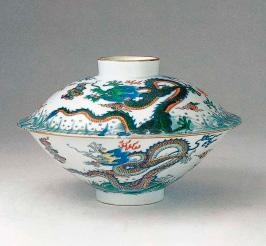
AUCTION RESULT COMPARISON
Type: Closely related
Auction: Sotheby’s London, 9 November 2016, lot 176
Price: GBP 106,250 or approx. EUR 175,000 converted and adjusted for inflation at the time of writing
Description: A doucai ‘dragon’ bowl and cover Yongzheng mark and period
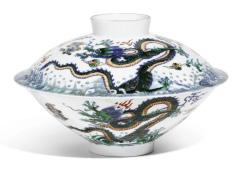
Expert remark: Compare the closely related form, doucai decoration with similar dragons, and Yongzheng reign mark. Note the 9 cm wide area of restoration to the rim of the cover and a circa 1 cm hairline crack next to this. Additionally, overpaint is visible to both the interior and exterior.
Estimate EUR 20,000
Starting price EUR 10,000
166 112
George Hathaway Taber III (1929-2008)

AN IMPERIAL YELLOW-GLAZED AND INCISED ‘DRAGON’ BOWL, QIANLONG MARK AND PERIOD

China, 1736-1795. Remarkably well potted with deep rounded sides supported on a short foot and rising to an everted rim. The exterior neatly incised with a pair of dramatically striding dragons, in pursuit of flaming pearls, amid swirling clouds above crashing waves. Applied overall with a glaze of a rich yellow tone, nicely pooling in the recesses. The base with an underglaze-blue six-character seal mark da Qing Qianlong nianzhi and of the period.
Provenance: From a private collection in Massachusetts, USA. Condition: Superb condition with only minor wear and minimal firing irregularities.
Weight: 186.9 g (excl. stand)
Dimensions: Diameter 14.9 cm
AUCTION RESULT COMPARISON
Type: Closely related
Auction: Christie’s Paris, 12 July 2022, lot 728
Price: EUR 44,100 or approx. EUR 46,000 adjusted for inflation at the time of writing
Description: A yellow-glazed incised ‘dragon’ bowl, Qianlong six-character seal mark in underglaze blue and of the period
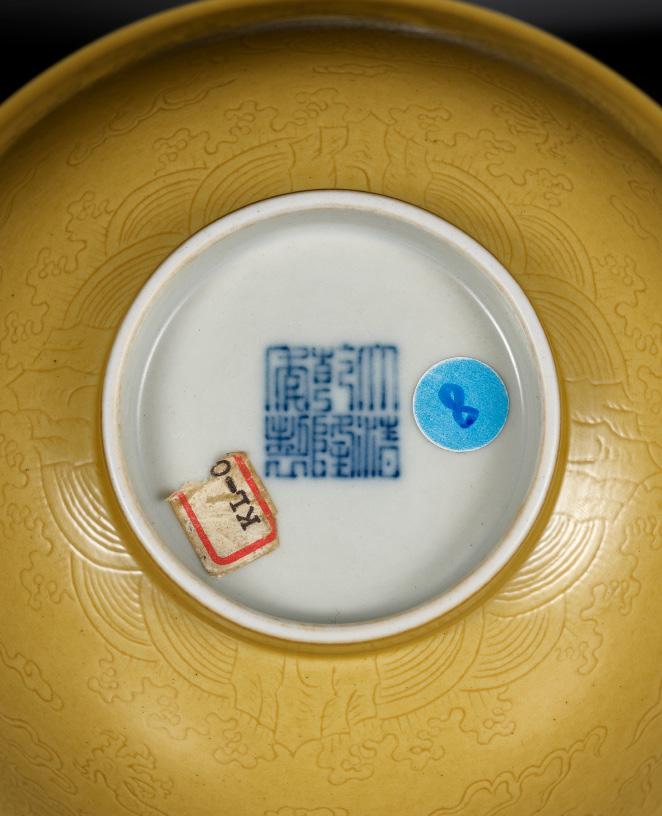
Expert remark: Compare the closely related form, yellow glaze to interior and exterior, incised decoration, dragon motif, and reign mark. Note the smaller size (12 cm).
AUCTION RESULT COMPARISON
Type: Closely related
Auction: Christie’s Hong Kong, 31 May 2010, lot 2019
Price: HKD 325,000 or approx. EUR 54,000 converted and adjusted for inflation at the time of writing
Description: A yellow-glazed incised ‘dragon’ bowl, Qianlong sixcharacter seal mark and of the period

Expert remark: Compare the closely related form, yellow glaze, incised decoration, dragon motif, reign mark, and size (15.3 cm). Note the white rim.
Estimate EUR 20,000
Starting price EUR 10,000
168 113
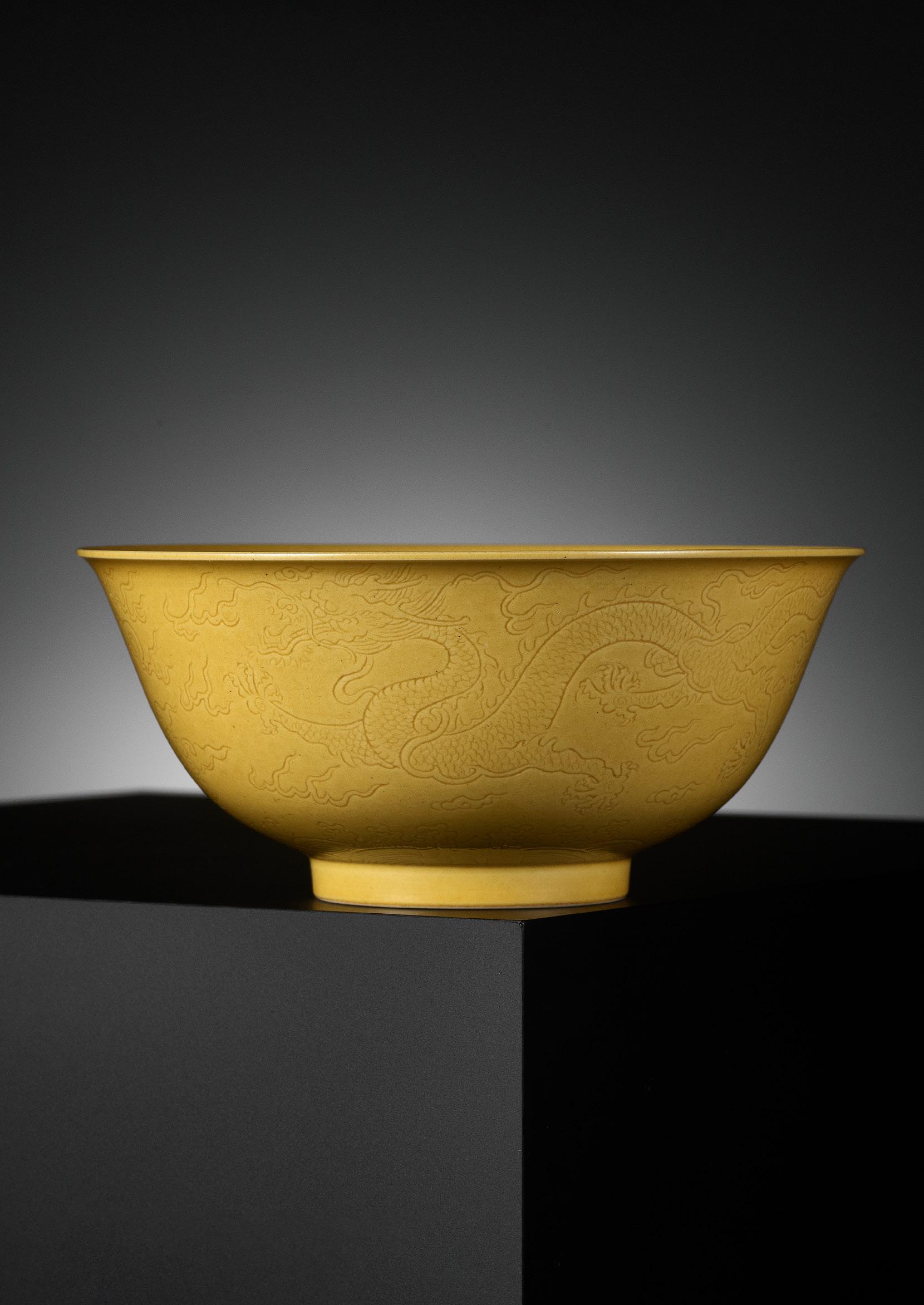
A MOLDED, LOBED AND GILT CELADON-GLAZED JARDINIÈRE, QIANLONG MARK AND PERIOD
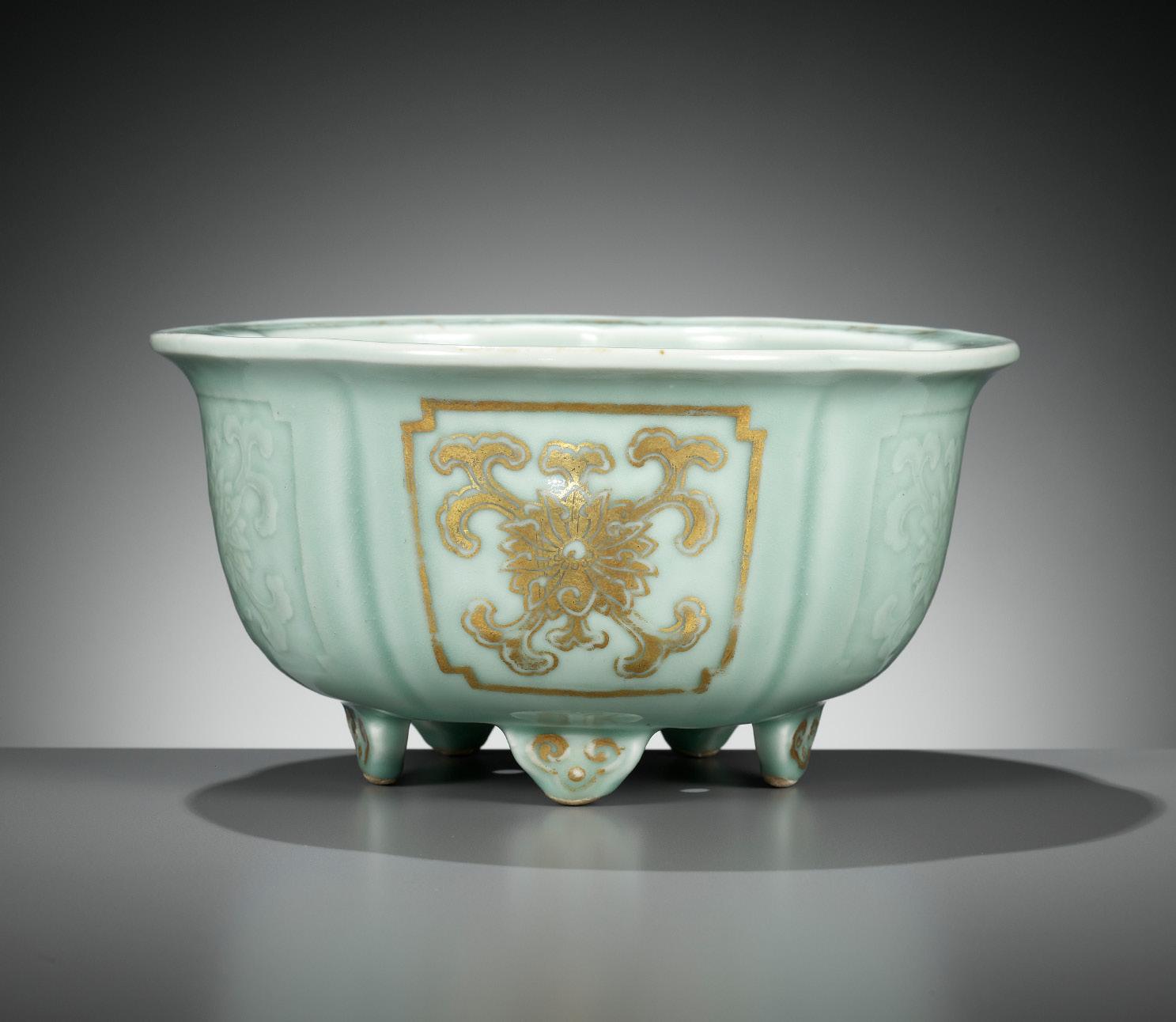

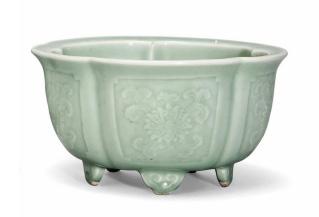
China, 1736-1795. Exquisitely potted with lobed sides supported on five ruyi-head feet and rising to a flattened everted rim, the exterior decorated with five panels enclosing stylized lotus blossoms borne on leafy scrolling vines, the rim with a band of scroll. Covered overall in a superb glaze of pale sea-green color, attractively pooling and darkening in the recesses and thinning to a paler tone in the raised areas. The panels, feet, and rim with gilt decoration. The interior is pierced with two small drainage holes. The base incised with a six-character mark da Qing Qianlong nianzhi and of the period.
Provenance: English trade.
Condition: Good condition with expected minor wear overall, some firing irregularities, extensive rubbing to gilt, light scratches, and a microscopic glaze line to the interior.
Weight: 1,374 g
Dimensions: Diameter 22.6 cm
Expert’s note: This author suspects that many more 18th-century celadonglazed wares once had gilt decoration similar to the present lot, but that after some of the gilt had inevitably worn off and that in most cases the entire decoration was removed. Another example of such a practice would be the Parthenon marbles, which were ‘cleaned’ by 19th and 20th century conservators who removed the flaking gilt decorations.
AUCTION RESULT COMPARISON
Type: Closely related
Auction: Christie’s London, 12 May 2015, lot 425
Price: GBP 10,000 or approx. EUR 17,000 converted and adjusted for inflation at the time of writing
Description: A pair of molded lobed celadon-glazed jardinières, Qianlong incised six-character seal marks and of the period

Expert remark: Compare the closely related form, decoration, glaze, and reign marks. Note this lot comprises a pair and the gilding of both is completely worn away; according to the condition report from Christie’s, one of the jardinières “has been broken into many pieces with associated losses and has been re-stuck with heavy old restoration to large sections of the rim and elsewhere.”
AUCTION RESULT COMPARISON
Type: Related
Auction: Christie’s New York, 20 March 2001, lot 257
Price: USD 49,350 or approx. EUR 78,000 converted and adjusted for inflation at the time of writing
Description: A rare gilt-decorated celadonglazed vase, incised Qianlong seal mark and of the period
Expert remark: Compare the related lotus gilt decoration. Note the different form. Note the size (22.8 cm).
Estimate EUR 6,000
Starting price EUR 3,000
170 114
A GE-TYPE SOFT-PASTE WASHER, QIANLONG MARK AND PERIOD
China, 1736-1795. Finely potted with rounded sides rising from a tapered foot to an incurved mouth encircled by a key-fret decorated rim, the exterior molded with lotus blossoms and foliage bordered by registers of archaistic scroll, covered overall with a thick ivory-white glaze suffused with an irregular network of dark and transparent crackle. The countersunk base impressed with a six-character seal mark da Qing Qianlong nianzhi and of the period.
Provenance: From the estate of Stuart and Phyllis Moldaw. The collection featured a comprehensive range of early Chinese porcelain as well as a noted group of Buccelatti and Puiforcat silver. Stuart G. Moldaw (1927-2008) was a retail pioneer and billionaire who founded Ross Stores.

He was also a generous philanthropist who served on the boards of several nonprofit agencies, including the San Francisco Museum of Modern Art,. President Bill Clinton appointed him as a public delegate to the U.S. Mission at the United Nations in 1993 and chairman of the White House Commission on Presidential Scholars in 1996. Condition: Good condition with minor wear and firing irregularities, including glaze recesses, pitting and firing cracks. Few minor shallow chips to edges, occasional light scratches, few tiny hairlines to rim (probably inherent to firing).

Weight: 982.7 g
Dimensions: Diameter 23 cm
This rare brushwasher with a crackle-type glaze of a faint ivory tone stands as a refined example of Qianlong period archaism. Porcelains of this type, made in imitation of imperial Ding wares from the Song dynasty and clearly influenced by earlier bronze vessels, were prized by the Qianlong Emperor.

Expert’s note: ‘Soft-paste’ porcelain has the addition of a powdered white clay to the porcelain body, which is called hua shi (slippery stone). This results in a lightweight ware that can be crisply molded and incised with intricate designs. It was significantly more expensive to produce than a standard kaolin porcelain body.
AUCTION RESULT COMPARISON
Type: Near-identical
Auction: Sotheby’s, Hong Kong, 7 April 2010, lot 1923
Price: HKD 200,000 or approx. EUR 33,500 converted and adjusted for inflation at the time of writing
Description: A ge-type soft-paste washer, seal mark and period of Qianlong
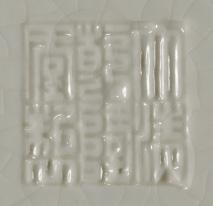
Expert remark: The two washers are nearly identical in form and decoration, and a comparison of the marks also shows a nearly identical seal, with possibly the same mold used for the seal impression. The glaze is slightly more gray than on the present lot and the crackle includes golden threads.
Estimate EUR 8,000
Starting price EUR 4,000
171 115
The Moldaws meeting with Jimmy and Rosalynn Carter, 1979
AN IRON-RED DECORATED SQUARE ‘LANDSCAPE’ BRUSHPOT, BITONG, QIANLONG MARK AND PERIOD

China, 1736-1795. Well potted, the exterior decorated with four rectangular panels, each enclosed by a gilt border, depicting incredibly fine mountainous river landscapes with towering trees, bridges, and thatched-roof huts. The rim is gilt, while the base and interior are glazed in bright turquoise. The base with an iron-red four-character mark Qianlong nianzhi and of the period.
Provenance: Collection of Milton Drexel Rutherford (1894-1976), and thence by descent within the family. Milton Drexel (Rex) Rutherford was a US veteran and engineer. He lived and worked in the city of Chicago, excavating the tunnels for the city’s subway. His proliferate collection began when a client gifted him an artifact from eastern Asia igniting a passion for collecting Asian art, including Kangxi ceramics as well as Japanese metalwork and lacquers.
Condition: Very good condition with expected old wear and minor manufacturing irregularities. Rubbing and minor losses to iron-red and gilt.
Weight: 186 g
Dimensions: Height 8.2 cm
AUCTION RESULT COMPARISON
Type: Closely related
Auction: Christie’s New York, 18 September 2003, lot 375
Price: USD 19,120 or approx. EUR 29,000 converted and adjusted for inflation at the time of writing
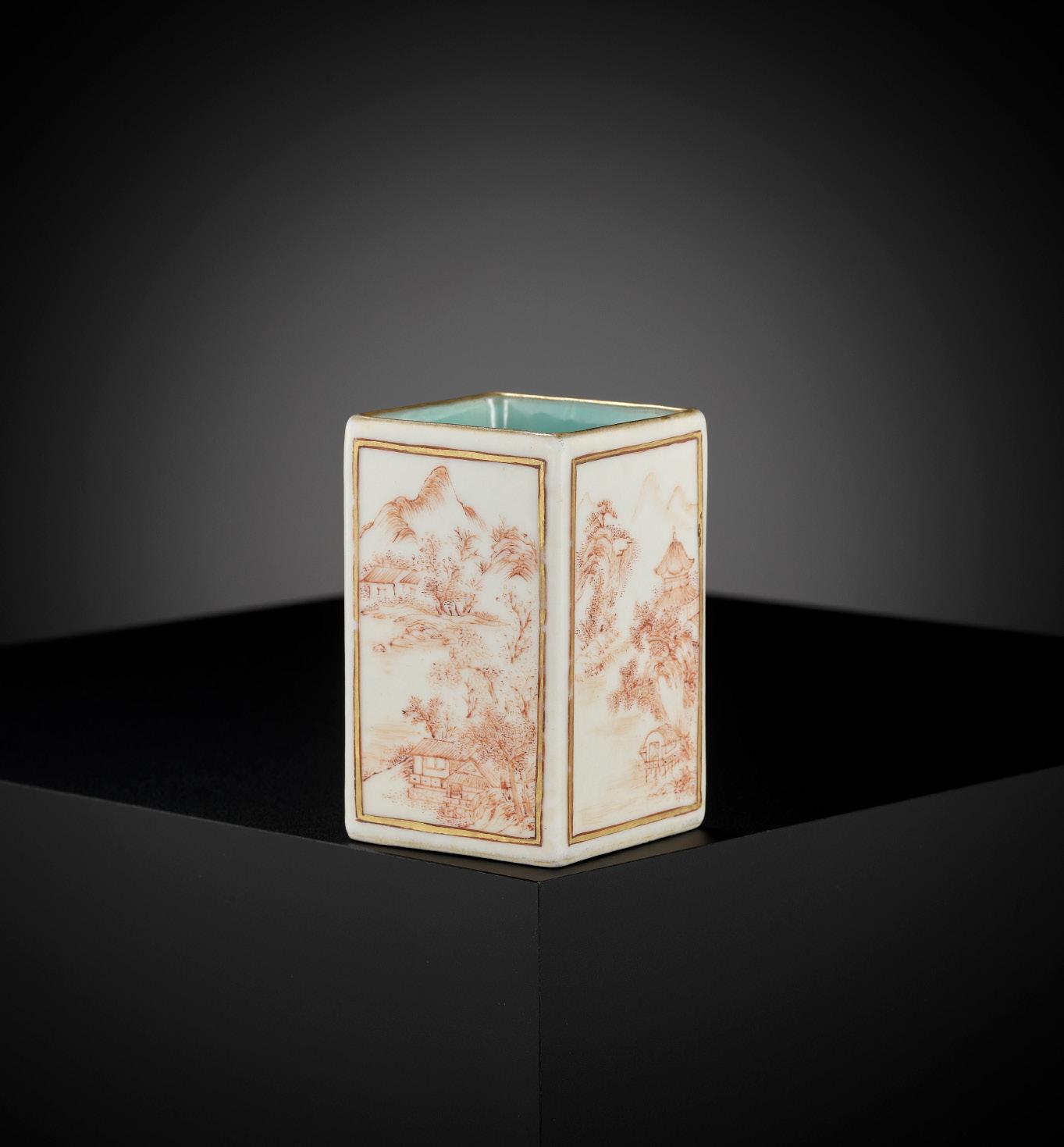
Description: An unusual small iron-reddecorated café-au-lait-ground brushpot, bitong, Qianlong iron-red seal mark and of the period
Expert remark: Compare the closely related iron-red decoration, landscape painting, style, and reign mark, as well as the almost identical size (8.1 cm). Note the cylindrical form and café-au-lait ground.
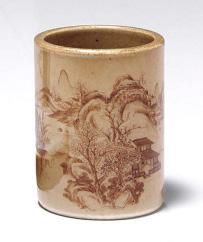
Estimate EUR 10,000
Starting price EUR 5,000
172 116
117
A PAIR OF YELLOW-GROUND AND GREEN-ENAMELLED ‘DRAGON’ DISHES, QIANLONG MARK AND OF THE PERIOD
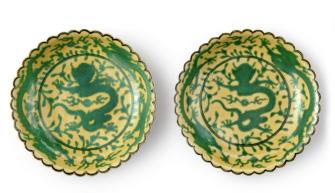

China, 1736-1795. Delicately potted, each with shallow rounded sides supported on a short tapered foot and rising to a scalloped rim dressed in green between black line borders, the interior finely decorated with a central front-facing five-clawed dragon writhing around a flaming pearl, the cavetto similarly decorated to the interior and exterior with sinuously striding dragons in pursuit of flaming pearls, all interspersed by leafy floral scroll. The recessed bases glazed white, each with an underglaze blue six-character seal mark da Qing Qianlong nianzhi and of the period. (2)
Provenance: Spink & Son, London, United Kingdom. From the private estate of Charles H. Royston, Chicago, United States, by repute acquired from the above.
Condition: Excellent condition with expected old wear and minimal firing irregularities. One dish with a light scratch to the underside.
Weight: 108 g and 107.4 g
Dimensions: Diameter 13.6 cm (each)
The color yellow, featured on the present dishes, held immense importance during the Qing Dynasty, representing the emperor’s unparalleled authority as it was known as the ‘Yellow Heaven’ color, signifying the Mandate of Heaven. Exclusively reserved for the imperial family, the color emphasized their elevated status, setting them apart from the rest of society. The presence of a five-clawed dragon on each dish also stood as a symbol of great significance. The five-clawed dragon motif was prominently featured on imperial regalia and its usage was strictly regulated, exclusively designated for the emperor and the imperial household.
Literature comparison: The design of the current dishes is based on an important Kangxi-marked prototype, fancifully incorporating imperial symbolism. For a prototype of the current design, with a Kangxi mark and of the period, see Wang Qingzheng, Kangxi Porcelain Wares from the Shanghai Museum Collection, Shanghai, 1998, pl. 199. Compare a closely related green enameled yellow-ground dragon dish, 13.3 cm diameter, with a Qianlong mark and of the period, in the Victoria & Albert Museum, accession number 1503-1902.

AUCTION RESULT COMPARISON
Type: Closely related
Auction: Sotheby’s, New York, 22 September 2021, lot 162
Estimate: USD 40,000 of approx. EUR 40,500 converted and adjusted for inflation at the time of writing
Description: A pair of yellow-ground green-enameled ‘dragon’ dishes, seal marks and period of Qianlong
Expert remark: Compare the closely related form, decoration, albeit lacking the dragons to the exterior, and reign mark. It is rare to have matched pairs stay together and come to market. The current lot compares well to the examples offered at Sotheby’s, but has a slightly stronger design. The green enamel on the Sotheby’s pair, while brilliant, overshadows the incised dragons and makes the composition difficult to visually read. Note the size (12.7 cm).
Estimate EUR 10,000
Starting price EUR 5,000
173
A BLUE AND WHITE ‘MING-STYLE’ BOTTLE VASE, QIANLONG MARK AND PERIOD
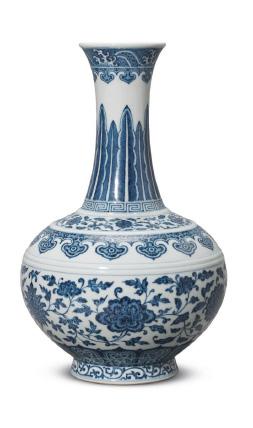
China, 1736-1795. Well potted, the compressed globular body rising from a short splayed foot, sweeping up to a tall waisted neck flaring gently at the rim. The body deftly painted in deep shades of cobalt blue with simulated ‘heaping and piling’ with a wide band of composite floral scroll above stylized lappets, all below a band of ruyi-heads and a further floral band to the shoulder, divided by four raised fillets. The recessed base with an underglaze blue six-character seal mark da Qing Qianlong nianzhi and of the period.
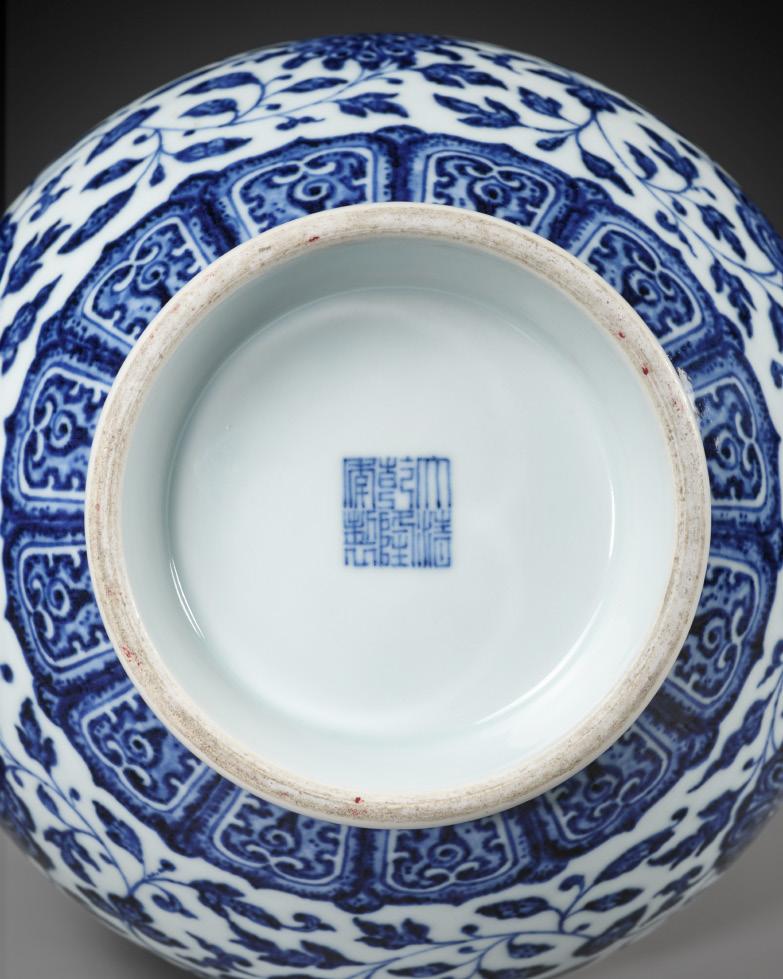
Provenance: Dorothy Joan (née Murphy) (1918-1989) and Roland Milton (1917-1990), United Kingdom, who were gifted the vase on their wedding in May 1945, and thence by descent.
Condition: Excellent condition with only minor surface wear. The interior with a firing flaw in form of a small glaze recess and two short, horizontal hairlines, not visible from outside. A microscopic glaze flake to the rim.
Weight: 3,319 g
Dimensions: Height 37.1 cm
The neck similarly decorated with a band of overlapping plantain leaves above a band of key-fret and below a collar of crashing and swirling waves with a band of pendent trefoils. The foot with a foliate scroll border, finely applied.
Literature comparison: Three vases of this pattern are illustrated by John Ayers and Regina Krahl, in Chinese Ceramics in the Topkapi Saray Museum, Istanbul, volume III, London, 1986, page 1105, no. 2564, where they have been fitted with metal mounts to suit Ottoman use. Compare a further example illustrated in Qingdai Ciqi Shangjian (Appreciation of Qing Dynasty Porcelain), Hong Kong, 1994, pl. 165, and another in the Shanghai Museum, illustrated in Zhongguo Taoci Quanji (The Complete Works of Chinese Ceramics), part 2, volume 15, Shanghai, 2000, pl. 2.
AUCTION RESULT COMPARISON
Type: Near-identical
Auction: Christie’s Hong Kong, 3 December 2021, lot 2019
Price: HKD 2,125,000 or approx. EUR 335,000 converted and adjusted for inflation at the time of writing
Description: A fine blue and white ‘Ming style’ bottle vase, Qianlong six-character seal mark in underglaze blue and of the period
Expert remark: Compare the near-identical form, also showing four characteristic fillets separating the various bands of decoration, the closely related painting, the similar reign mark, and the almost identical size (37.5 cm). Note that this vase is also in excellent condition, but lacks the firing flaws found inside the neck of the present lot.
Estimate EUR 100,000
Starting price EUR 50,000
174 118
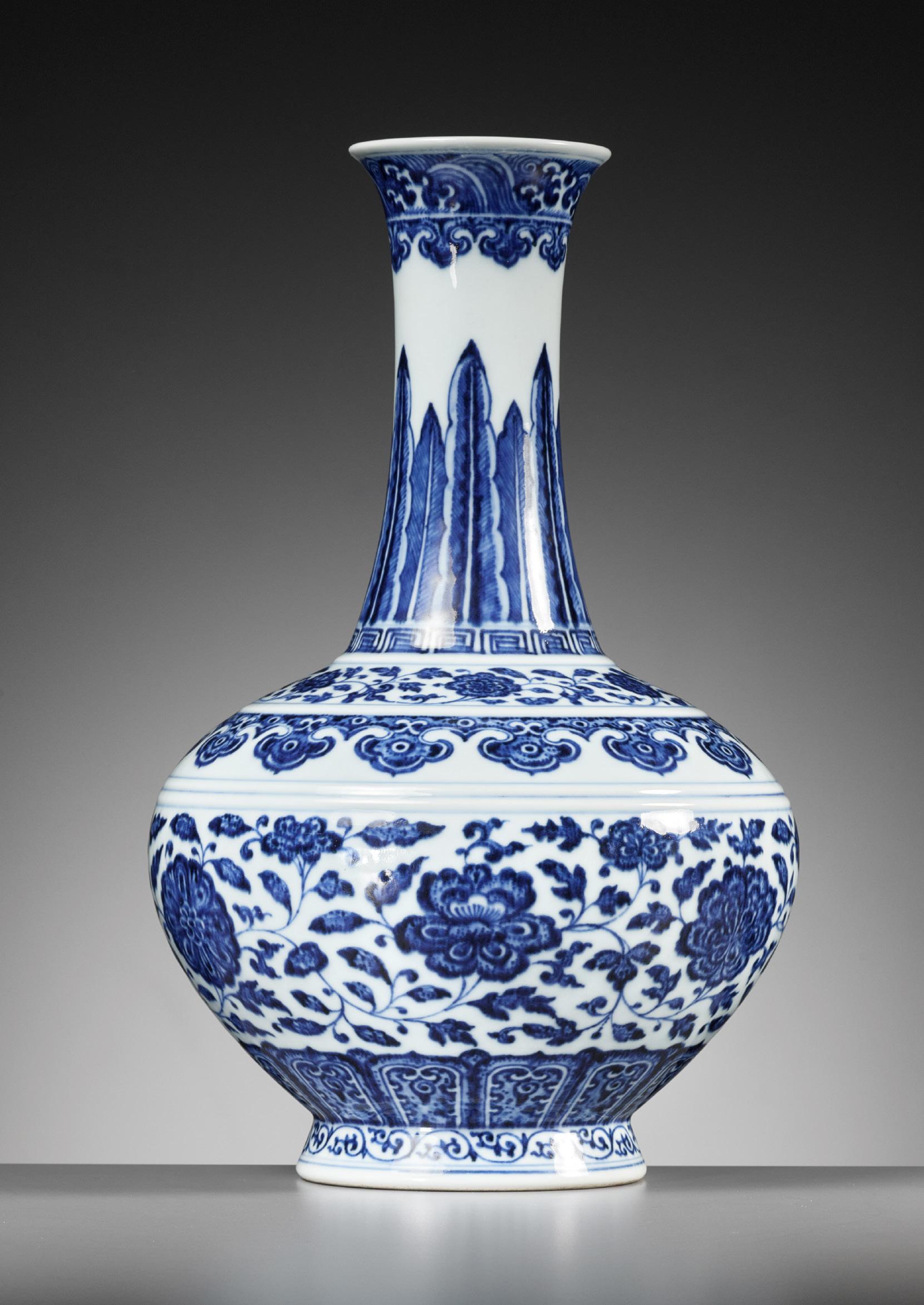
A BLUE AND WHITE MING-STYLE FLOWER-HOLDER, QIANLONG MARK AND PERIOD
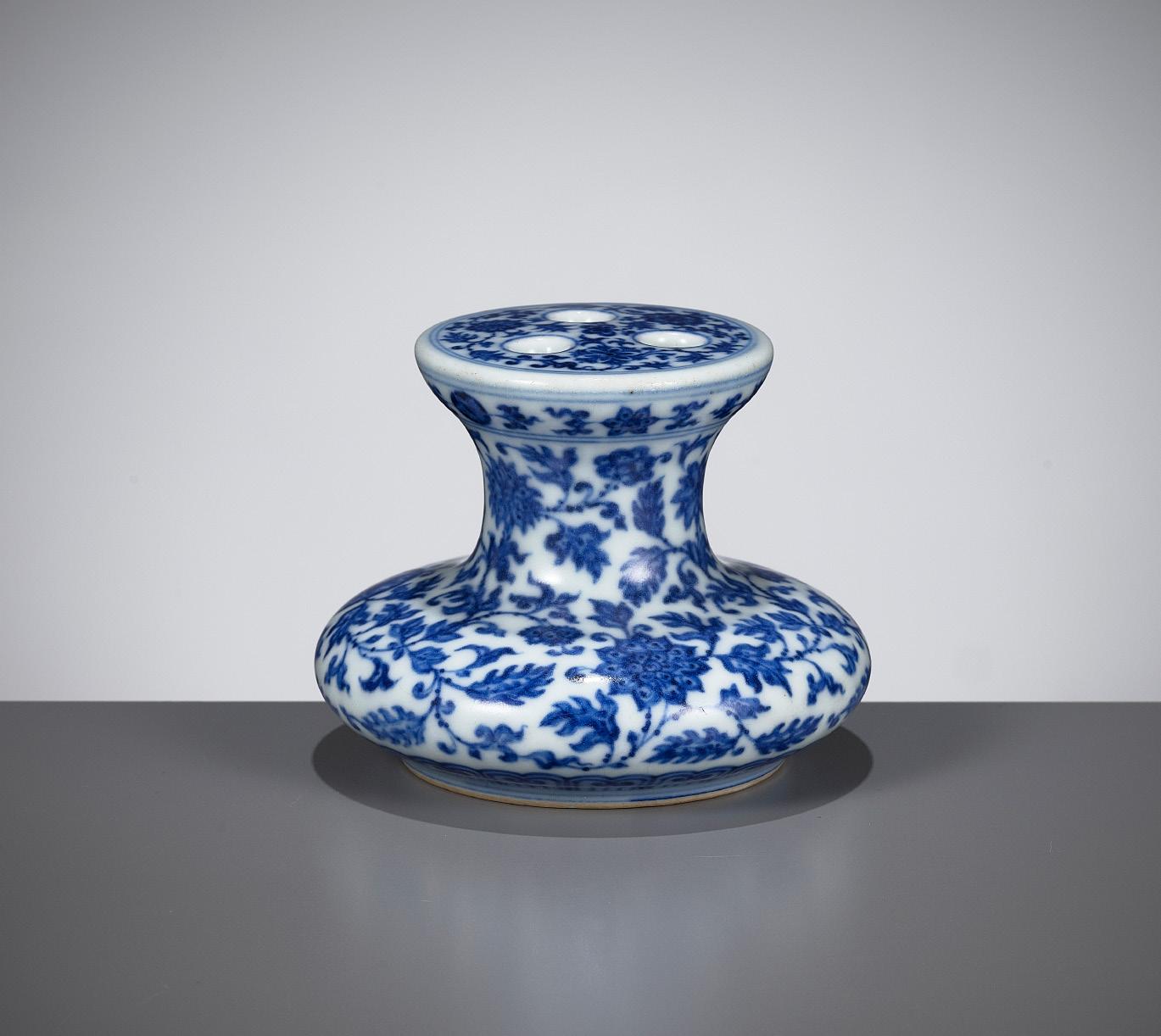

China, 1736-1795. Superbly potted, the compressed pear-shaped body supported on a short foot and rising to a waisted neck surmounted by a slightly domed top in the form of a lotus pod pierced with three circular apertures. The exterior is exquisitely decorated in shades of cobalt blue with lotus blossoms and auspicious blooms borne on leafy scrolling vines, above a lappet band encircling the foot and below a band of floral sprays below the top, which is similarly decorated with lotus scroll, all framed by neatly applied double-line borders.
The recessed base with an underglaze-blue six-character seal mark da Qing Qianlong nianzhi and of the period.
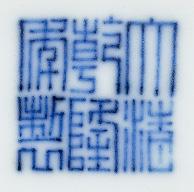
Provenance: From a private family collection in Cheltenham, United Kingdom.
Condition: Superb condition with only minor wear and minimal firing irregularities, the interior with some traces of use.
Weight: 252.9 g
Dimensions: Diameter 8.4 cm, Height 6.5 cm
Vessels of this form, variously described as ‘flower holders’ or ‘incense holders’, have been recorded from both the Yongzheng and Qianlong periods. The shape was likely inspired by a type of jarlet, made in bronze and pottery, which was popular during the Tang dynasty (see a sancaiglazed pottery jar from the Erwin Harris collection at Christie’s New York, 16 March 2017, lot 877). The Qing potters took this design to new heights with variations in glazes from simple, crackled monochromes to brilliant turquoise examples with slip-molded decoration. While the size of the Qing form tended to remain small, usually under 9 cm, this should not allow
them to be overshadowed by larger porcelain works of the period. The compact size would have allowed for easier handling and transport, making them suitable for personal devotion, private altars, and carrying during travel, creating a sense of intimacy and personal connection when using incense to cultivate a relationship with the divine realm. There are few other porcelain works that one could take on a pilgrimage so easily.
Expert’s note: A 1992 article by D.S. Freedman on Qing monochromes, related examples of similar form are referred to as “lotus pod bulb pots,” an understandable but quite unique description. The author further explains that blue and white designs fall under the category of monochromes as they feature a “one-color design on a white ground”. These differing taxonomies from the 1992 article to today are quite notable, leaving ample room for undiscovered pieces that may still be hidden in private and public collections.
AUCTION RESULT COMPARISON
Type: Near identical
Auction: Sotheby’s Paris, 16 June 2022, lot 204
Price: EUR 30,240 or approx. EUR 31,500 adjusted for inflation at the time of writing
Description: A small blue and white ‘floral’ vase, Seal mark and period of Qianlong
Expert remark: Compare the near identical form, decoration, and size (8.3 cm). Note that the present lot boasts an even more accomplished decoration as well as a stronger mark. Also note that this lot has a faint 1.5 cm hairline in the glaze between two of the holes on top of the vase, whereas the present lot is in perfect condition.
Estimate EUR 10,000
Starting price EUR 5,000
176
119
120
A
PAIR OF GILT AND IRON-RED DECORATED ‘BAJIXIANG’ BOWLS, JIAQING MARK AND PERIOD

China, 1796-1820. Each delicately potted with deep rounded sides rising evenly from a short and solid foot to a gently everted gilt rim, all exactly as expected from Imperial wares of the early 1800s. Decorated to the exterior in nicely graduated shades of iron-red with highlights neatly picked out in gilt to depict the Eight Buddhist Emblems (bajixiang) surrounded by lotus blossoms borne on scrolling vines. The recessed base each with an iron-red six-character mark da Qing Jiaqing nianzhi and of the period. (2)
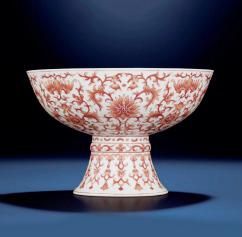
Provenance: English trade.
Condition: Excellent condition with minor wear and manufacturing irregularities. Only little rubbing to gilt and enamel. Extremely rare in this pristine condition.
Weight: 178.9 g and 163.9 g
Dimensions: Diameter 13.2 cm
The Eight Buddhist Emblems (bajixiang) are a set of traditional symbols that represent the offerings made by the gods to Buddha upon his enlightenment. The symbols include the parasol, the golden fish, the conch shell, the endless knot, the lotus flower, the victory banner, the Dharma wheel, and the treasure vase. Each symbol has its own significance and is used in various contexts, such as in religious rituals, on prayer flags, and in artwork. Together, these symbols are believed to bring good fortune, prosperity, and happiness to those who use or encounter them.
AUCTION RESULT COMPARISON
Type: Related
Auction: Christie’s Hong Kong, 30 May 2012, lot 4254

Price: HKD 437,500 or approx. EUR 67,000 converted and adjusted for inflation at the time of writing
Description: A rare iron-red decorated stem bowl, Jiaqing iron-red six-character seal mark and of the period
Expert remark: Compare the related motif and iron-red decoration, especially the lotus blossoms with similarly graduated shadings, as well as the Jiaqing reign mark. Note the different form, lack of gilt, and larger size (18.5 cm).
Estimate EUR 8,000
Starting price EUR 4,000
177
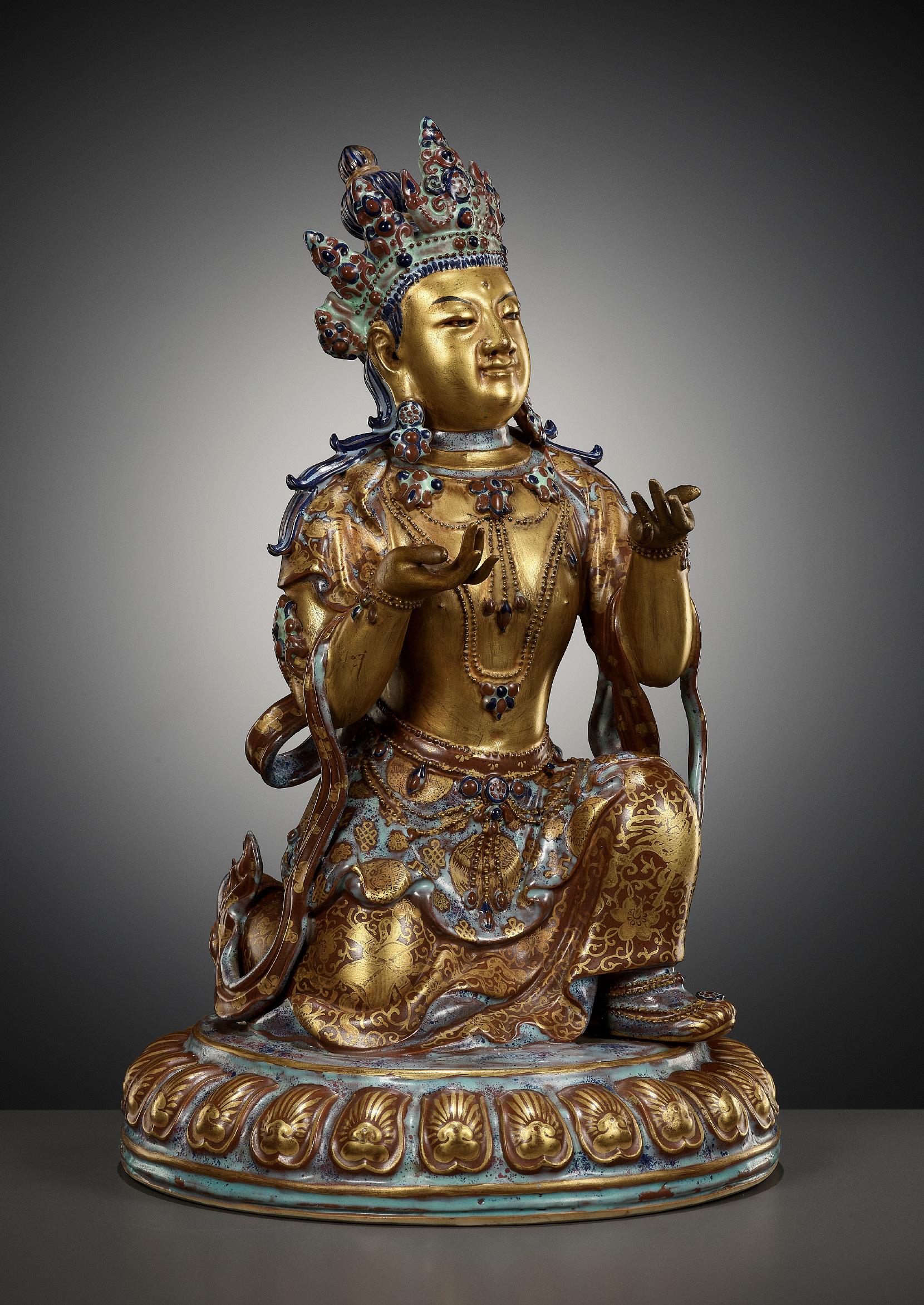
A ROBIN’S-EGG-GLAZED AND GILT PORCELAIN FIGURE OF A BODHISATTVA, QIANLONG TO JIAQING PERIOD
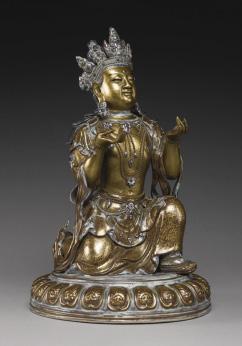
China, 1736-1820. The bodhisattva kneeling on a lotus throne with hands held in veneration as a worshiper in a temple, having an elaborate dhoti with strands of tasseled and beaded jewelry, and wearing a five-pointed crown. The neatly modeled, carved, incised and gilt porcelain finely decorated with blue, turquoise, and chestnutcolored glazes.
Provenance: The Estate of Allen Abramson, Farmington Hills, Michigan, USA. A notable private collector in Chicago, USA, acquired from the above. Allen Harold Abramson (1929-2016) was an American art and antiques dealer, collector, and author. He opened his first art gallery in 1964 and kept the company of celebrities such as Marlene Dietrich and Josephine Baker, throwing lavish parties at his famous apartment on Detroit’s Six Mile Road. He was also an important patron of the controversial Detroit artist William Girard. In his later years, he wrote and published a memoir titled Allen Abramson: The Odyssey (or the Idiocy).

Condition: Good condition with old wear and expected firing irregularities. Minute flaking to enamels. The tip of the tiara and chignon as well both hands show small repairs. The interior with three circular apertures and small firing cracks, all inherent to manufacture. Presenting exceptionally well.
Weight: 1,356 g
Dimensions: Height 28.8 cm
With an old silk storage box. (2)
Expert’s note: The present lot belongs a series of figures based on original prototypes in bronze, which were produced by Imperial command during the Yongle and Xuande periods and given as diplomatic gifts to Tibetan leaders. For an example of a prototype for the present lot, see a Xuande mark and period gilt-bronze bodhisattva in the Rietberg Museum, illustrated by Helmut Uhlig in On the Path to Enlightenment: The Berti Aschmann Foundation of Tibetan Art at the Museum of Rietberg Zurich, Zurich, 1995, pl. 72, page 123 (fig.1), where the author suggests that the figure may represent a member of the Chinese imperial family. An unmarked example, dated to the Xuande period, is in the V&A collection, no. 275&A-1898. This piece shows that the robin’s egg glaze on the present lot is an ingenious imitation of the colorful cloisonné work on the original prototypes.

The present lot inside a cabinet in Allen Abramson’s home, before 2016
Literature comparison: For a related porcelain example from the Malcolm MacDonald collection, no. DUROM.1969.358, and now in the Oriental Museum, University of Durham, United Kingdom, see Ireneus Legeza, A Descriptive and Illustrated Catalogue of the Malcolm MacDonald Collection of Chinese Ceramics, London, 1972, p. 122, no. 72. Another enameled porcelain figure of a bodhisattva is illustrated by Lou Pin-heng, Precious Treasures of My Humble House, Taipei, 1988, page 54, no. 12.
AUCTION RESULT COMPARISON
Type: Closely related
Auction: Bonhams Hong Kong, 29 May 2008, lot 578
Price: HKD 960,000 or approx. EUR 168,000 converted and adjusted for inflation at the time of writing
Description: A rare enameled figure of a kneeling bodhisattva, Qianlong Expert remark: Compare the closely related modeling, with similar pose, face, and base, robin’s egg enamels, and gilt decoration. Note the closely related size (29 cm).
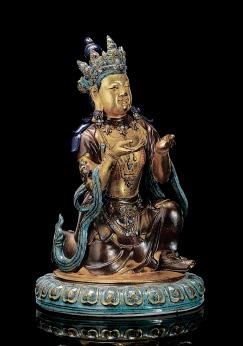
AUCTION RESULT COMPARISON
Type: Closely related
Auction: Sotheby’s, New York, 17 March 2015, lot 362
Price: USD 37,500 or approx. EUR 45,000 converted and adjusted for inflation at the time of writing
Description: A robin’s egg glazed and gilded porcelain figure of a bodhisattva, Qing dynasty, 18th / 19th century Expert remark: Compare the closely related modeling, with similar pose, face, and base, robin’s egg enamels, and gilt decoration. Note the similar condition issues: “The central peak of the tiara has a restored section to the tip, and two fingers on the figure’s left hand, and the thumb on the right have been restored.”
Estimate EUR 20,000
Starting price EUR 10,000
179 121
Allen Abramson (d. 2016)
AN IMPERIAL GILT-DECORATED ‘TROMPE-L’OEIL’ PORCELAIN VAJRA, CHINA, 18TH CENTURY
The four-pronged porcelain vajra is masterfully glazed in imitation of worn gilt-bronze and splashes of green to simulate malachite encrustations. The prongs extend out of dragon mouths and are flanked by lotus petals. The central band shows a robin’s egg glaze with perfect porcelain copies of lapis lazuli and coral cabochon inlays.
Provenance: From a Swedish private collection.
Condition: Expected old wear, three prongs with small old repairs, some firing irregularities and minor glaze flakes, tiny nicks and losses.
Weight: 130.5 g
Dimensions: Length 16.4 cm
The vajra, a symbol of indestructibility and power, is one of the primary ritual symbols in Tibetan Buddhism. Derived from Sanskrit and translating to both thunderbolt and diamond, the vajra consists of two sets of prongs from which lotus petals emanate, flanking a central sphere. Often used in combination with a bell, which represents feminine wisdom, the vajra symbolizes the masculine attribute of skillful means or compassion.
Vajras are considered to be imbued with magic. The famous Manhattan-based Chinese art dealer Robert H. Ellsworth once owned a related bronze vajra and shared an interesting story: It was given to Mr. Ellsworth by a dear friend who, having learned that Mr. Ellsworth was ill, sent the vajra from his personal shrine to Mr. Ellsworth with instructions to sleep with it under his pillow. Two weeks later, Mr. Ellsworth called his friend to report he had made a full recovery. From that point on, the vajra remained on Mr. Ellsworth’s bedroom headboard, resting at the feet of a seated yogi.
Trompe l’oeil porcelain is a highly unique genre of Imperial porcelain objects made during the Qing dynasty. It refers to porcelain made in decorated imitation of other objects. These objects varied from archer’s rings to imitation wood basins, from lacquer boxes to auspicious symbols like this imitation-bronze vajra. During a rare private viewing of Qing trompe l’oeil porcelain at the National Palace Museum, Chih-En Chen delved into the museum archeology behind ten pieces—these include the comparisons given here and more—with the hopes of finding where
AUCTION RESULT COMPARISON
Type: Related
Auction: Sotheby’s Hong Kong, 8 October 2013, lot 3031
Price: HKD 9,640,000 or approx. EUR 1,420,000 converted and adjusted for inflation at the time of writing
Description: A rare trompe-l’oeil celadon reticulated vase, seal mark and period of Qianlong
Expert remark: This trompe-l’oeil porcelain is made in imitation of nuts and dried fruits on a plate with a porcelain vase. Note the similar expert craftsmanship of the imitation nuts and fruits which are masterfully glazed.


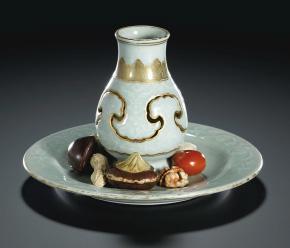
AUCTION RESULT COMPARISON
Type: Related
Auction: Sotheby’s Hong Kong, 8 April 2007, lot 516
Price: HKD 5,360,000 or approx. EUR 950,000 converted and adjusted for inflation at the time of writing
Description: An unusual pair of ‘famillerose’ trompe-l’oeil wall vases, marks and period of Qianlong
Expert remark: These two vases are made in the imitation brocade fabric and wood in form of a pipa instrument tucked inside a brocade bag tied at the neck. Note the similar glazing to imitation wood along the pipa’s neck.
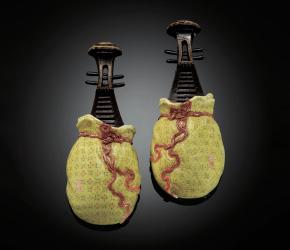
Estimate EUR 6,000
Starting price EUR 3,000
these objects were found in situ and whether this was inside or outside the Forbidden City. He discovered that many of the pieces were in fact in the Forbidden city and that they were assembled in only five places: the Jingrengong, the Yangxindian, the Yongshougong, the Shouangong, and the Ningshougong. Chen managed to discover a link between all these locations, namely that they were all associated with buildings intended for the women of the court living at the Forbidden City. The only exception to this is Nigshougong, the Qianlong emperor’s retirement palace.
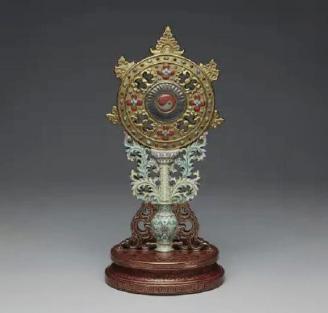
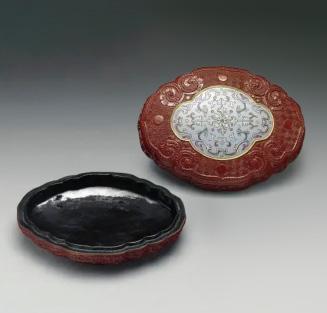
180 122
An imitation puddingstone porcelain archer’s ring, Qianlong period, in the National Palace Museum, accession number 004373
An imitation wood porcelain basin, Yongzheng period, in the National Palace Museum, accession number 006715
An imitation cinnabar lacquer porcelain box, Qianlong period, in the National Palace Museum, accession number 010398
An imitation gilt-bronze porcelain Dharmachakra, Qianlong Period, in the National Palace Museum, accession number 003409
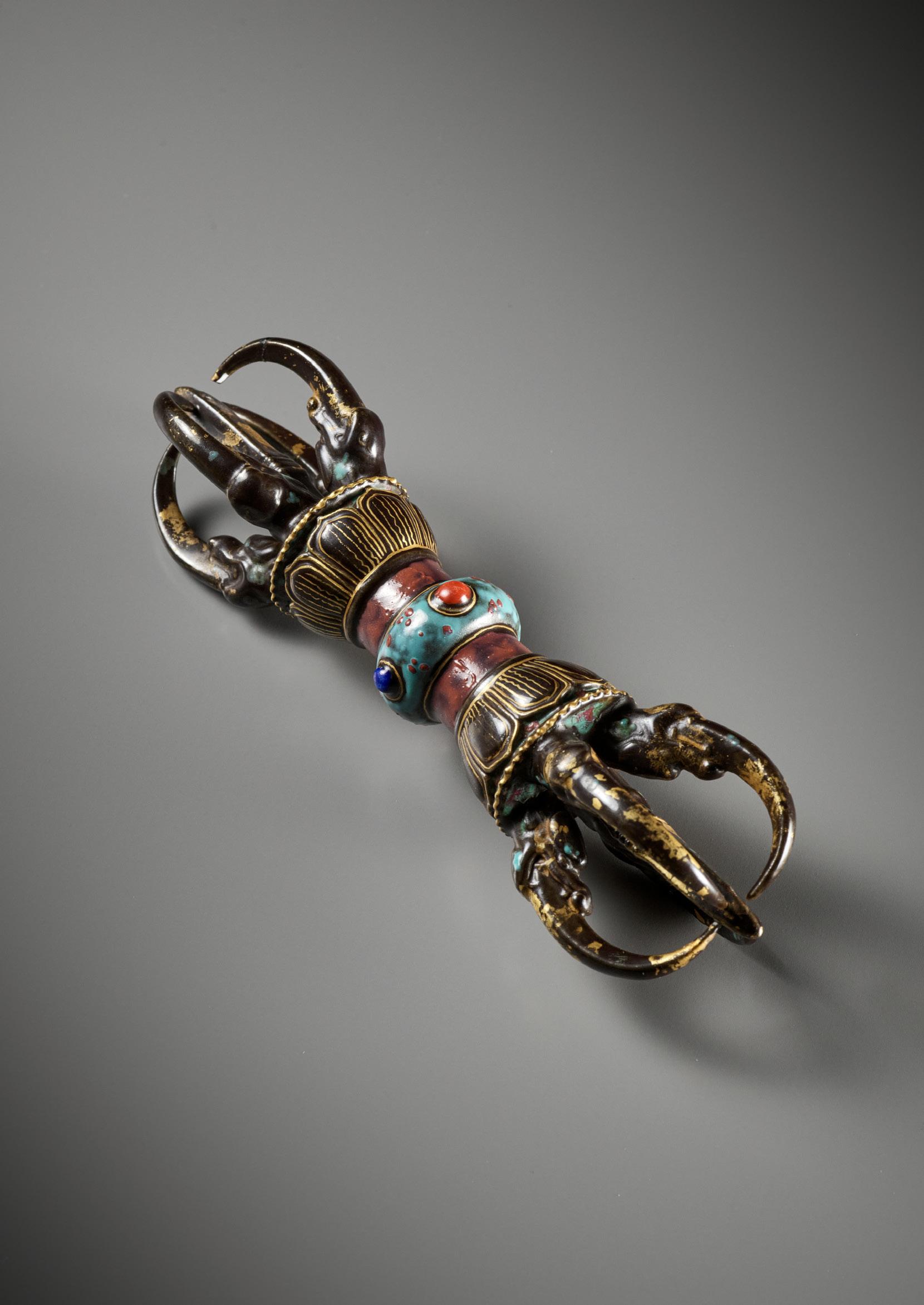
AUCTION RESULT COMPARISON
A
GILT ENAMELED WATER POT, PINGGUOZUN, YONGZHENG MARK AND PERIOD
China, 1723-1735. Delicately potted, the ‘apple jar’ of compressed globular form rising from a flat concave base to a neatly inverted rim, the exterior covered in lustrous gilding. The recessed base with an underglaze blue six-character mark da Qing Yongzheng nianzhi within a double circle and of the period. Note the faint copper tone to the gilt, as expected for this group of wares.
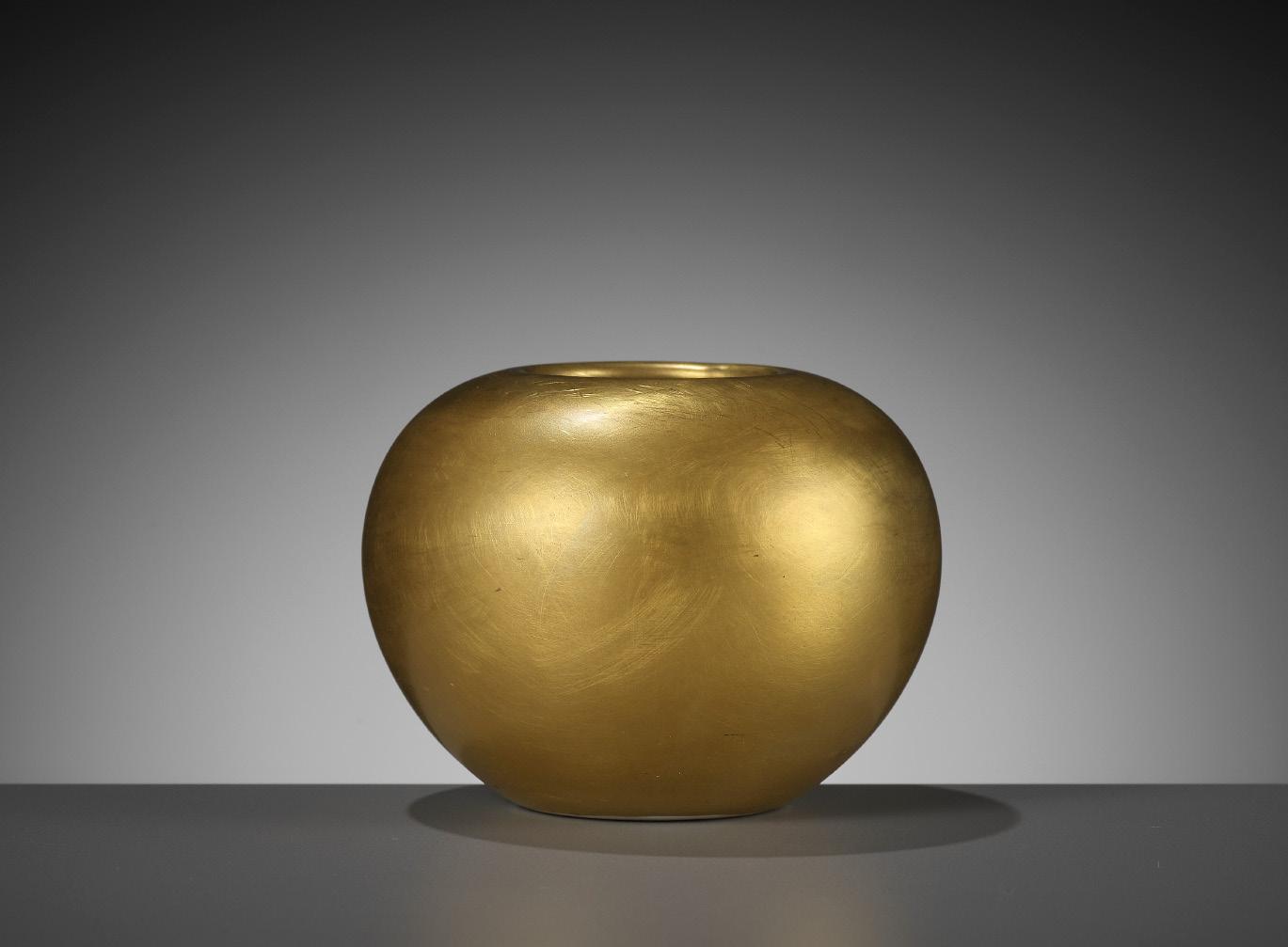

Provenance: Spanish trade. Acquired from an old private estate, by repute, where it was found sitting on its wooden base, serving as a receptacle for paper clips.
Condition: Good condition with some wear to gilt overall, minor firing irregularities, little rubbing and light scratches, the interior with a star-shaped glaze recess as well as traces of use including soiling and calcification. The foot has been slightly smoothened.
Weight: 166.3 g (excl. stand)
Dimensions: Height 6.3 cm (excl. stand), Diameter 9 cm
With a finely carved hardwood stand, dating from c. 1900 or earlier. (2)
Water pots for washing brushes were designed to be placed on a Chinese scholar’s desk. This form is known as pingguo zun (‘apple jar’), of which there are two variations: one with a short waisted neck and lipped rim, such as the present lot, and one with an incurved rounded neck.
AUCTION RESULT COMPARISON
Type: Closely related
Auction: Christie’s New York, 25 September 2020, lot 1840
Price: USD 35,000 or approx. EUR 38,000 converted and adjusted for inflation at the time of writing
Description: A rare gilt bowl, Yongzheng six-character mark in underglaze blue within a double circle and of the period (1723-1735)
Expert remark: Compare the closely related gilding and reign mark. Note the different form and size (9.8 cm).
Type: Closely related
Auction: Sotheby’s New York, 29 September 2021, lot 1094
Price: USD 100,800 or approx. EUR 108,000 converted and adjusted for inflation at the time of writing
Description: A pair of gilt-enameled bowls, 20th century


Expert remark: Compare the closely related gilding and reign mark. Note that this lot comprises two bowls of closely related size (9.1 cm). Note also that the hammer price far exceeded the low estimate of USD 2,000 only, indicating that bidders found an 18th-century date to be considerably more likely for these bowls.
Estimate EUR 10,000
Starting price EUR 5,000
182
123
A LIME-GREEN AND FAMILLE-ROSE ‘BUTTERFLY’ TEA TRAY, JIAQING MARK AND PERIOD
China, 1796-1820. The quadrilobed tray rests on four small incurved feet and is finely decorated in colored enamels against a lime-green ground. The interior with a pair of confronted butterflies surrounded by leafy scrolling vines issuing melons and floral blossoms, encircled on the sides by a band of foliate scroll with lotus blossoms and melons. The exterior sides with further butterflies and foliate scroll. The base with an iron red six-character seal mark da Qing Jiaqing nianzhi and of the period. Note also the fine gilding applied to the edges and feet.
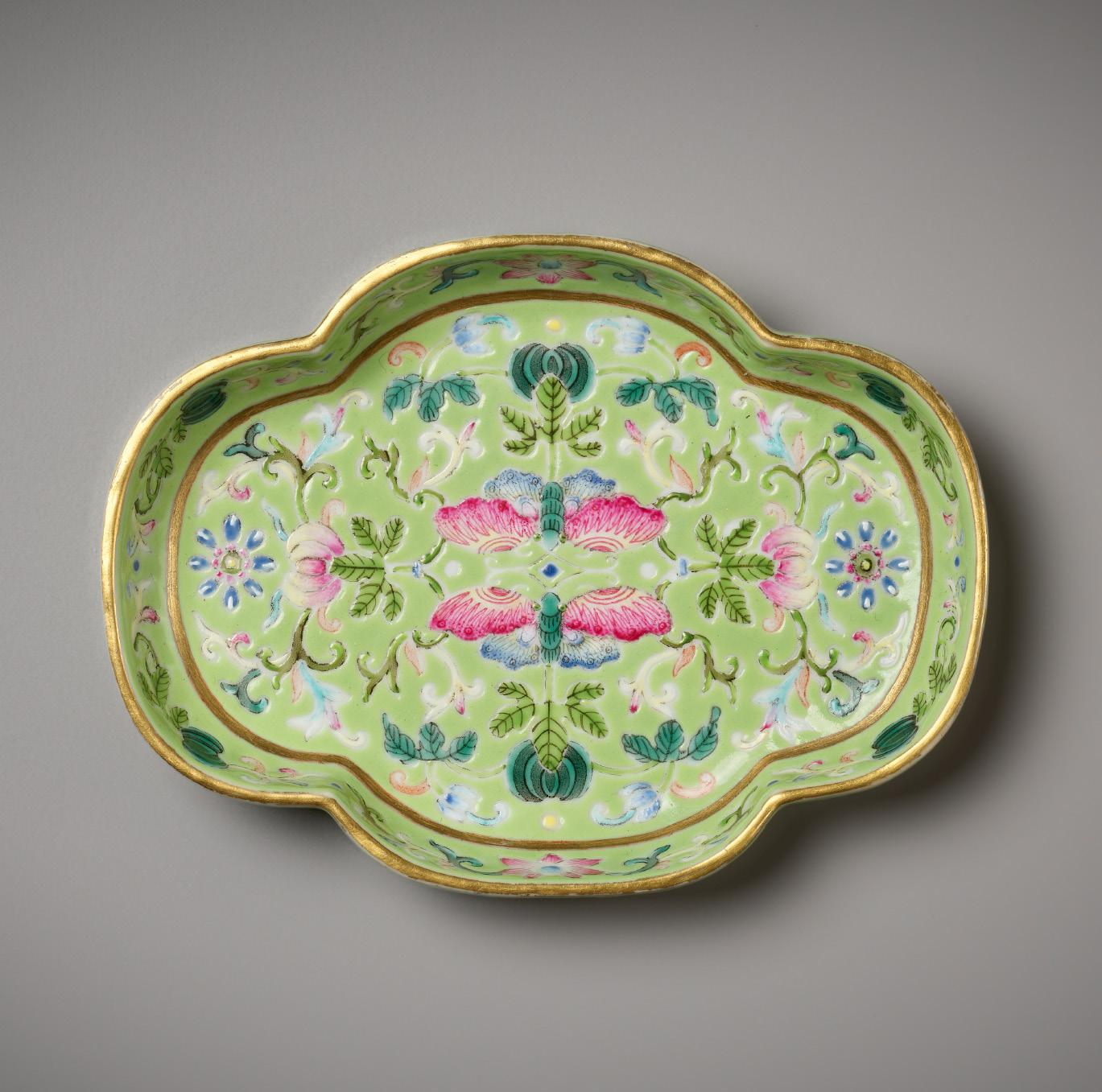

Provenance: New York trade.
Condition: Excellent condition with minor wear and firing irregularities including spur marks to the base. Minor rubbing to gilt and enamels.
Weight: 185.5 g
Dimensions: Width 14 cm
With an old fitted silk storage box. (2)
The quadrilobed form of this tray directly references the crab apple (haitang), which could be combined with other emblems to create auspicious rebuses. Its second character, ‘tang’, is homophonous with the character for ‘hall’ and, by extension, ‘the family home’.
Literature comparison: Compare a related pair from the collection of Dr. Ip Yee, included in the exhibition Ch’ing Polychrome Porcelain, Fung Ping Shan Museum, Hong Kong, 1977, cat. no. 101.
AUCTION RESULT COMPARISON
Type: Closely related
Auction: Sotheby’s Hong Kong, 8 October 2013, lot 3260
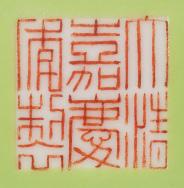
Price: HKD 625,000 or approx. EUR 92,500 converted and adjusted for inflation at the time of writing
Description: A pair of lime-green ground famille-rose tea trays seal marks and period of Jiajing
Expert remark: Compare the closely related quadrilobed form and famille rose decoration on a lime green ground, albeit with a different variation of floral design, lacking the butterflies. Note that this lot comprises a pair.
Estimate EUR 10,000
Starting price EUR 5,000
183 124
A MONUMENTAL GILT FAMILLE ROSE ‘LADIES OF THE HAN PALACE’ VASE, LATE QIANLONG - EARLY JIAQING
China, 1780-1820. The baluster sides rising from a short spreading foot to a waisted neck flanked by a pair of imitation-cloisonné chilongform handles to flared mouth. The body vibrantly painted in bright enamels with gilt highlights to depict a lively scene of elegantly dressed ladies on a palace terrace indulging in leisurely pursuits, set against a monumental landscape with gnarled pines, towering mountains, and swirling clouds. Each side with a central dancer surrounded by musicians playing string, flute, and percussion instruments, with further ladies holding lanterns and jade chimes, carrying scrolls and auspicious fruits, or simply looking on.
Provenance: Mme Safia Sassi, Paris, France. Formerly in a noted French private collection, by repute acquired from the above. A private collector in Austria, acquired from the above via the London trade. Condition: Natural wear, mostly to gilt. Expected manufacturing irregularities, including a circumferential firing crack around the foot. Minuscule chips and shallow surface scratches. One handle with a small section re-attached. Displaying exceptionally well!
Weight: 12,812 kg
Dimensions: Height 64.5 cm
The scenes painted to the body are framed by lime-green and pink-ground bands of ruyi-heads dotted with floral designs. The shoulder with a band of floral scroll below plantain leaves enclosing stylized flowerheads. The neck painted to each side with a bat above a stylized shou character and linked cash-coins suspended from a beaded tassel, surrounded by lotus blossoms borne on leafy scrolling vines, all against a lime-green ground. The mouth with a turquoise-ground band of ruyi-heads below the gilt rim.
The foot with a band of key-fret below lotus scroll. The interior glazed turquoise, while the base is left unglazed, revealing the white ware, which has a remarkably unctuous, silky feel overall.
This fine and meticulously painted depiction of ladies is reminiscent of a scroll painting, with the colorful decorations around the mouth, neck, and foot serving as the mounting. The scene depicts ladies of the Han Palace, a subject that rose in popularity in the mid-Qing dynasty when the Han dynasty became a subject of nostalgia. Elegant and beautifully dressed women occupy a romanticized world, engaged in exemplary behavior such as modesty and encouraging the transmission of culture as seen on this vase where they play music and dance. This theme also reflects the antiquarian interest characteristic of the Qing period.


LITERATURE COMPARISON
Compare a Qianlong-marked lantern vase from the Qing court collection, now in the National Palace Museum, Taipei, similarly painted with ladies playing music surrounding a central dancer in an elaborate robe, no. Gu Ci 007371. It is suggested that the figures are modeled after the ladies in the painting Court Version of ‘Spring Dawn in the Han Palace’, completed by Sun Hu, Zhou Kun, and Ding Guanpeng in the 6th year of the Qianlong period (1741), included in the exhibition The All Complete Qianlong: The Aesthetic Tastes of the Qing Emperor Gaozong, National Palace Museum, Taipei, 2013, cat. no. II-3.54, after the famous and much-copied handscroll Spring Morning in the Han Palace by Qiu Ying (ca. 1494-1552), in the National Palace Museum, Taipei (fig. 1).
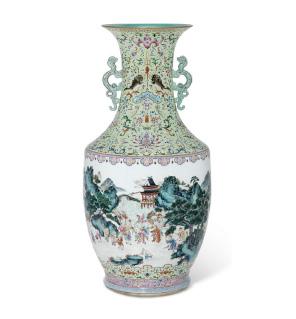
AUCTION RESULT COMPARISON
Type: Near identical
Auction: Christie’s London, 3 November 2020, lot 182
Price: GBP 100,000 or approx. EUR 149,000 converted and adjusted for inflation at the time of writing
Description: A large famille rose lime-green-ground ‘Hundred Boys’ vase
Expert remark: Note the slightly larger size (73 cm).
Estimate EUR 30,000
Starting price EUR 15,000
184 125
Detail of Qiu Ying’s ‘Spring Morning in the Han Palace’ fig. 1


A MAGNIFICENT IMPERIAL-YELLOW GROUND FAMILLE ROSE ‘LADY AND CHILD’ VASE, QING DYNASTY
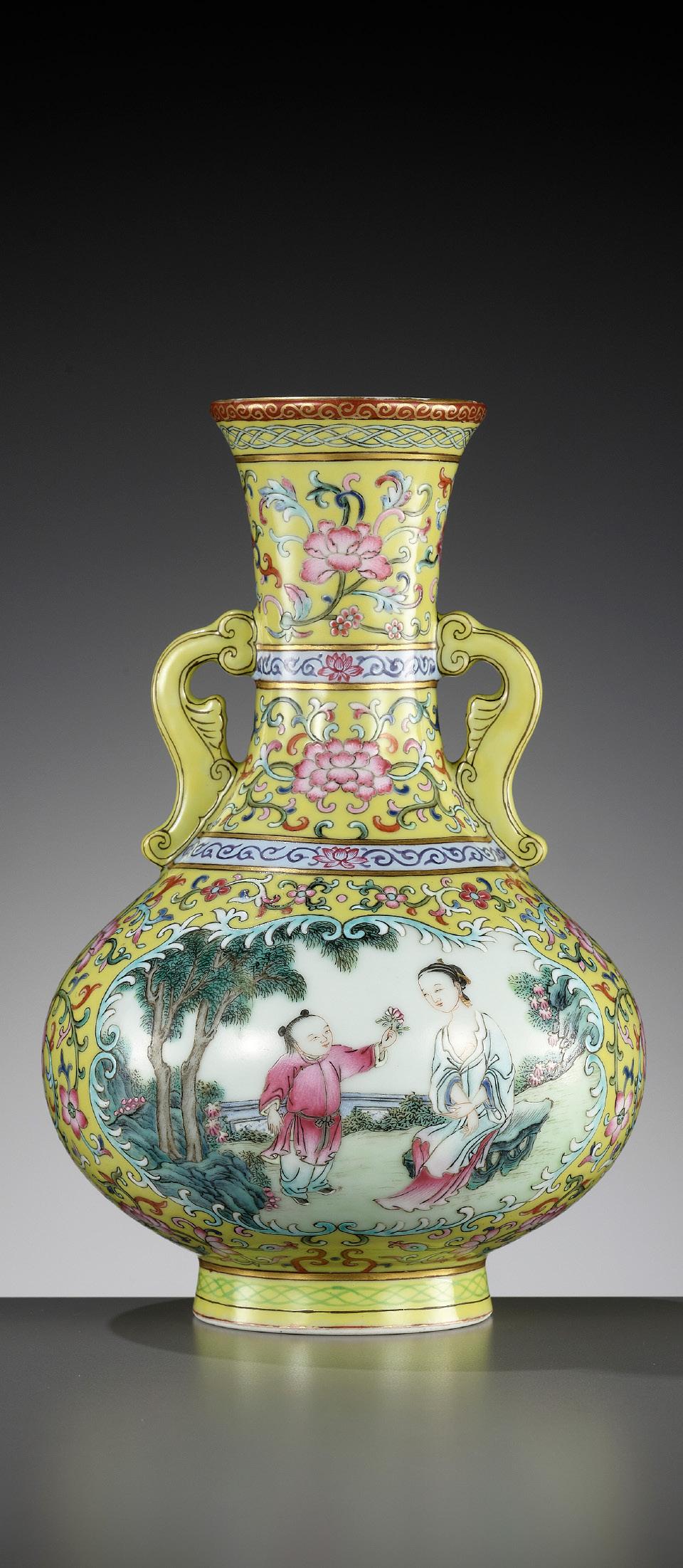

China, 18th - 19th century. Finely potted, the bulbous body supported on a spreading foot and rising to a waisted neck flanked by ruyi-form handles below the flared mouth. Brightly decorated in remarkably fine enameling to the exterior against a flawless imperial-yellow ground to each side with a foliate panel enclosing a charming scene with a boy presenting a flower to his mother, who is seated on a pierced rockwork bench within a fenced garden, all surrounded by floral blossoms borne on scrolling vines. The neck similarly decorated with peony and prunus blossoms borne on scrolling vines separated by bands of lotus scroll against a white ground enclosed by gilt borders, the foot and mouth encircled by geometric bands.
Provenance: From the collection of Captain Charles Oswald Liddell, acquired in China before 1914 and thence by descent. Born in Edinburgh, Scotland, Captain Charles Oswald Liddell (1854-1941) worked in China from 1877 to 1913. Liddell collaborated with A. W. Bahr in an exhibition in Shanghai in 1908, as Chairman of the North China branch of the Royal Asiatic Society and in writing descriptions for it, which were printed by A. W. Bahr in “Old Chinese Porcelain and Works of Art in China” in 1911. Charles Liddell had formed his collection, except for three pieces, while trading in China for nearly forty years. He purchased a number of pieces from two significant sources: Prince Chun, the last Regent of the Qing Dynasty, and the private secretary of Li Hong Zhang. In May 1929, Bluett offered a part of the collection, publishing a catalog of “The Liddell Collection of Old Chinese Porcelain” with 229 entries. A Falangcai bowl from the Lidell collection was acquired by Charles Russell and was subsequently in the collections of Barbara Hutton and Robert Chang, breaking a world record for Chinese art when it was sold in 2006 for HKD 151,320,000, purchased Dr. Alice Cheng, who recently sold the bowl again via Sotheby’s for HKD 198,220,000 in April 2023

Condition: Superb condition with only very minor old wear and firing irregularities, minor rubbing to gilt and enamels.
Weight: 640.6 g
Dimensions: Height 20.8 cm
AUCTION RESULT COMPARISON
Type: Related
Auction: Sotheby’s Paris, 8 November 2022, lot 94,500
Price: EUR 94,500 or approx. EUR 100,000 adjusted for inflation at the time of writing
Description: A yellowground famille-rose ‘floral’ double-gourd vase, Qing dynasty, 18th century Expert remark: Compare the related famille rose decoration on an Imperial yellow ground and the unmarked base. Note the different form and similar size (18.5 cm).
Estimate EUR 10,000
Starting price EUR 5,000
187 126
Captain Charles Oswald Liddell (18541941)
A MASSIVE FAMILLE VERTE ‘DRAGON BOAT FESTIVAL’ DEEP BOWL,
MID-QING DYNASTY
China, 18th to early 19th century. Finely and heavily potted with deep rounded sides supported on a short foot and rising to a gently everted rim. Intricately painted in bright enamels and iron red, the exterior with a continuous scene depicting four noblemen and court ladies in a wheeled dragon boat pulled by six female attendants followed by heralds, soldiers on horseback, and bannermen leading the procession, watched with interest by a general and courtiers from a palace terrace, all framed by a key-fret band to the foot and a lozenge band between two ruyi-head bands.
Provenance: English trade.
Condition: Very good condition with some old wear and expected firing irregularities, small glaze recesses, minor dark spots, and a shallow chip to the rim. Slightly warped overall.
Weight: 13.6 kg
Dimensions: Diameter 60.3 cm
The interior similarly decorated with a central medallion enclosing two soldiers on horseback fighting amid a hilly landscape with two fleeing soldiers on foot and two bannermen with a large pavilion in the background surrounded by scrolling red clouds. The medallion is encircled by a band of foliate scroll, surrounded by four panels enclosed by alternating frames with bats and linked-cash as well as angular scroll with mythical animals, all depicting further battle scenes, all below a wide band with shaped cartouches enclosing auspicious objects reserved against a brocadepatterned ground.
The Dragon Boat festival rarely appears as a subject on enameled porcelain vases and dishes. The festival is held on the fifth day of the fifth month and is celebrated with eating rice dumplings, drinking wine, and — as can be seen in the painting on this bowl — a large dragon boat procession followed by a boat race. This festival is said to commemorate the death of the poet Qu Yuan (ca. 340–278 BC) who, on the day in question, committed suicide in his despair over political corruption.
LITERATURE COMPARISON
Compare a related familleverte rouleau vase decorated with scenes from the dragon boat festival, 22.9 cm in diameter, dated to the Kangxi period, in the Metropolitan Museum of Art, accession number 14.40.85.

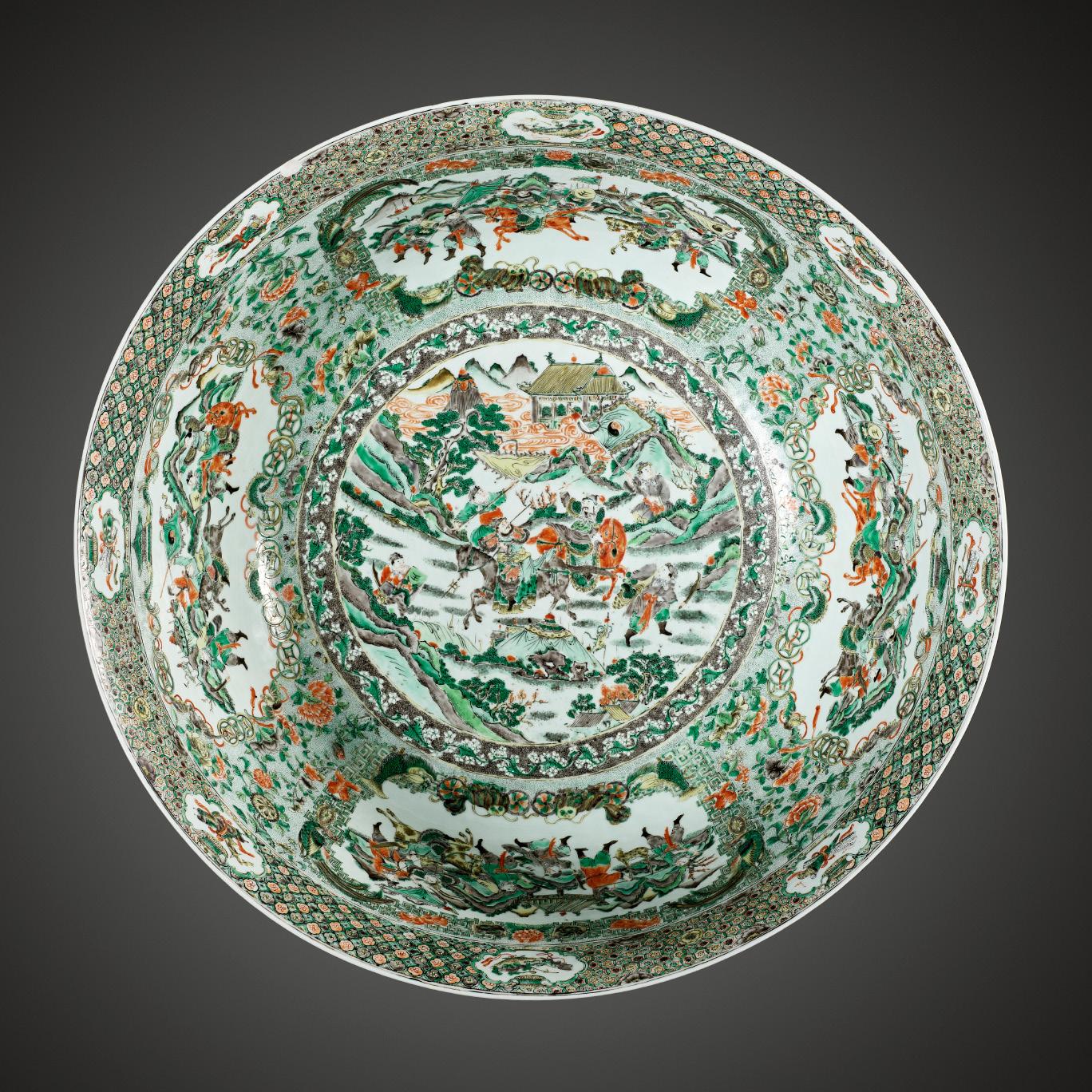
Estimate EUR 20,000
Starting price EUR 10,000
127

128
A CELADON-GLAZED ‘BAMBOO’ DOUBLE VASE, THE GILT-BRONZE MOUNTS
BY L’ESCALIER DE CRISTAL
The ceramics from China, 18th century, the mounts from France, 19th century.
Naturalistically modeled in the form of two adjacent bamboo stalks, each with small sprigs of leaves rising from the base and side, a small bird with neatly incised plumage perched on the smaller bamboo vase, looking down on the intricate rockwork minutely detailed with a porous structure. The base fitted with a gilt-bronze mount decorated with bands of grasses and petals.
Inscriptions: To the base of the ormolu mount, engraved in cursive script ‘Escalier de Cristal Paris’.

Established in 1802 by Madame Marie Désarnaud (1775-1842), the luxury store of the Maison A L’Escalier de Cristal supplied clocks, lamps, and other art objects to ruling families in Europe. The firm exhibited to great acclaim at the 1819 Exposition des produits de l’industrie and was appointed fournisseur breveté du Roi that same year. The business was located in the Palais Royal, a center of excellence for the high-quality jewelers, silversmiths and manufacturers of Objets de Vertu, for which Paris was renowned. Works from L’Escalier de Cristal were commissioned by French aristocrats, finding their way to many royal family collections including the collection of Tsarina Alexander, wife of Nicolas II, who visited Paris in 1896. The company commissioned manufacturers to supply individual components which were then assembled to the firm’s own designs, much in the tradition of the 18th century marchands-merciers from whom they inherited their specialist profession. Famous among the pieces produced by L’Escalier de Cristal is the table de toilette, commissioned by the Duchess of Berry, which is housed in the Louvre Museum today. The atelier continued its success throughout the 19th and early 20th century by collaborating with designers and makers such as Gallé and Christofle, until it dissolved in 1923. Today, objects from L’Escalier de Cristal are housed in important public and private collections around the world.
AUCTION RESULT COMPARISON
Type: Closely related
Auction: Christie’s New York, 28 September 2021, lot 17
Provenance: From a private collection in London, United Kingdom. Condition: Very good condition with old wear and expected manufacturing irregularities, including some minute flaking to the ware around the top rim of the larger vase, and light scratches and wear to the base.
Weight: 372 g
Dimensions: Height 12.9 cm
Price: USD 22,500 or approx. EUR 24,000 converted and adjusted for inflation at the time of writing
Description: A celadon-glazed bamboo-form vase, 18th century
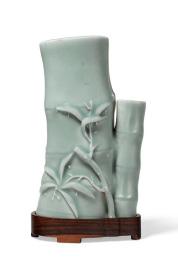
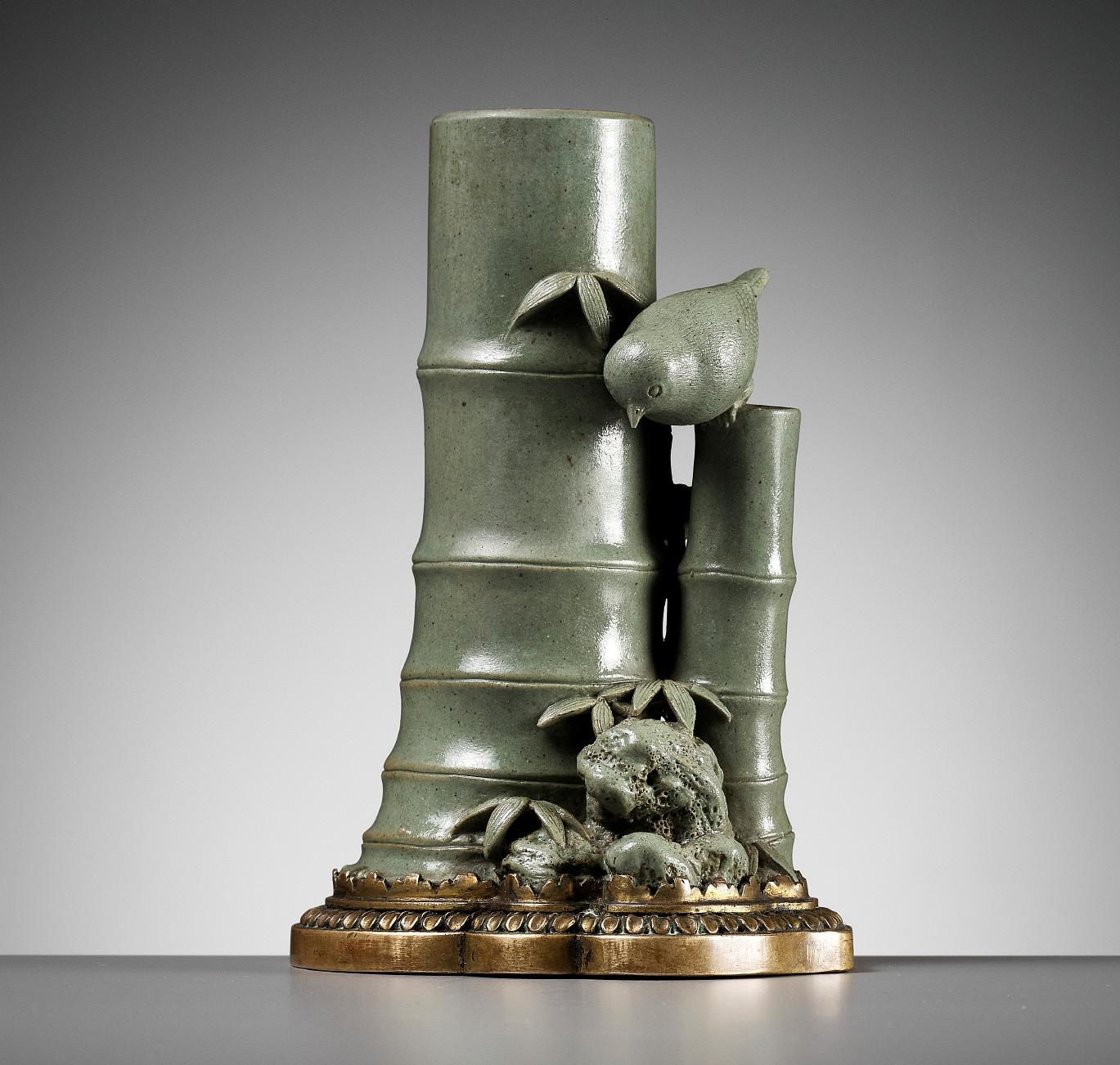
Expert remark: Compare the closely related form and subject. Note the size (15.2 cm).
Estimate EUR 3,000
Starting price EUR 1,500
190
A CELADON-GROUND FAMILLE ROSE
‘DRAGONS AND CARP’ DOUBLE-GOURD VASE, 18TH-19TH CENTURY
China. Of flattened rectangular form covered in a fine celadon glaze overall, nicely pooling in the recesses and thinning along the elegantly curved and raised edges. Brightly enameled to one side with two dragons amid blossoms and leafy floral stems, and to the other with a single four-clawed dragon soaring over a tumultuous sea above a large golden carp, neatly painted in iron-red, emerging from crashing waves.
Provenance: West Berkshire, United Kingdom, local trade. By repute acquired from a private estate. Condition: Old wear and expected manufacturing irregularities, such as small glaze recesses. Rubbing and minute flaking to the enamels, a darkened hairline to one side, small chips, light fritting.
Weight: 964 g
Dimensions: Height 24.4 cm
Each main side is additionally decorated with colorful and swirling lingzhi-shaped clouds, and the two narrow sides are further decorated with bats. The vase stands on a rectangular spreading foot and is surmounted by a flared neck.


According to traditional Chinese belief, carp would swim upstream in the Yellow River in order to leap across the rapids of the Dragon’s Gate. The first to succeed would be transformed into a dragon. This legend is meant as a metaphor for a scholar who passes his examinations, succeeding to the rank of high office. To this day, the dragon-carp motif is a wish for success in achieving high marks for students during their examinations.
AUCTION RESULT
COMPARISON
Type: Related
Auction: Christie’s London, 12
November
2010, lot 1456
Price: GBP 31,250 or approx. EUR 63,000 converted and adjusted for inflation at the time of writing
Description: A celadon melon formed vase with famille rose decorations, 18th/19th century Expert remark: Compare the similar glaze which pools in the recesses and thins along the edges of this melon-form vase. Note the size (30.8 cm).
Estimate EUR 8,000
Starting price EUR 4,000
129
A LARGE MOLDED AND CARVED CELADON-GLAZED ‘DRAGON’ FISHBOWL, QING DYNASTY
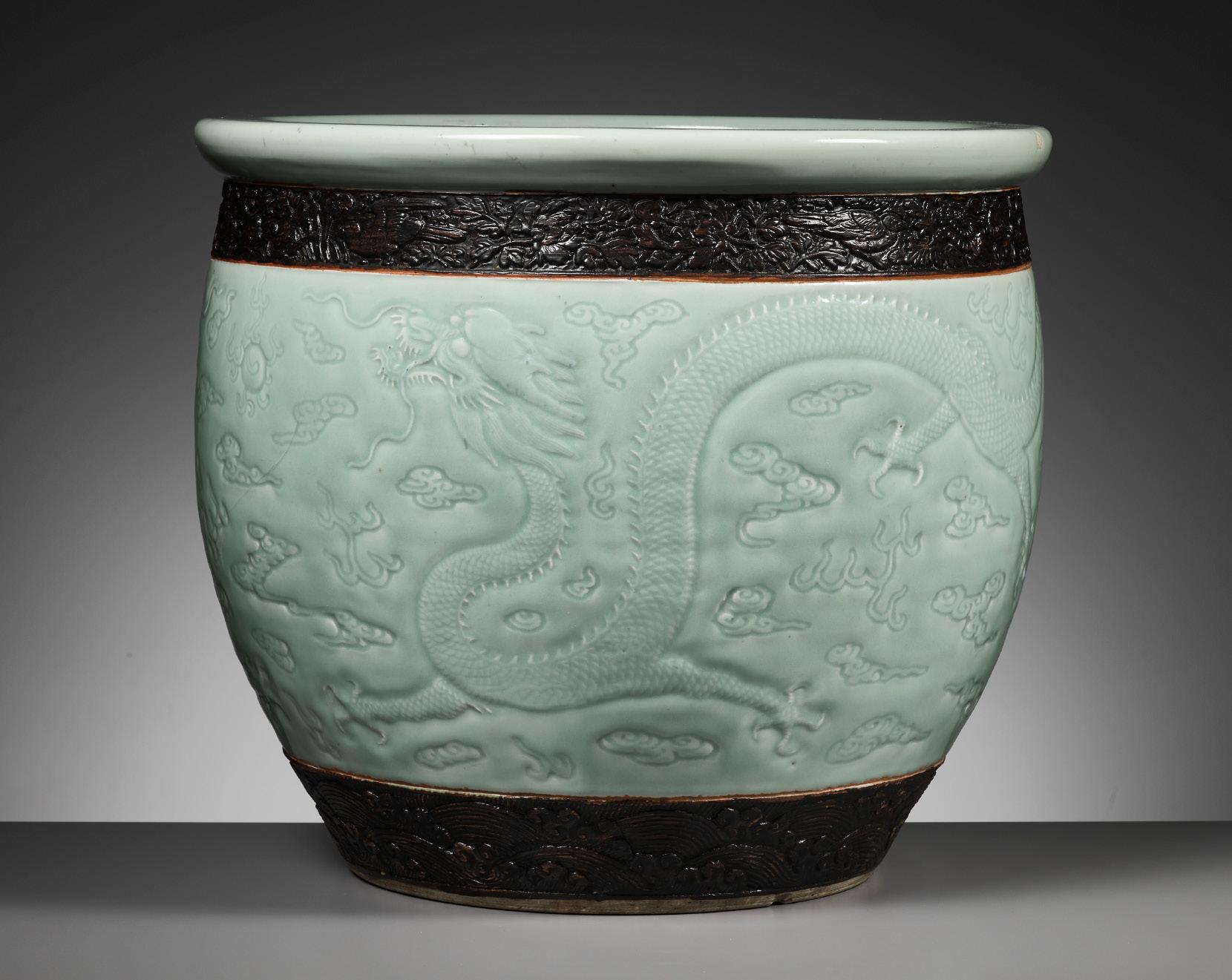
China, 18th - 19th century. Heavily potted, the deep rounded sides rising to a thick everted rim. The exterior is finely molded and carved with two sinuous four-clawed dragons in pursuit of a flaming pearl amid swirling clouds, covered in a pale sea-green glaze darkening in the recesses and thinning at the edges. The dragon design is framed by two brown-washed bands, the upper neatly carved with magpies and chrysanthemums, the lower similarly decorated with crashing waves. The base is unglazed.
Provenance: From a private collection in Hertfordshire, United Kingdom, since the 1950s, and thence by descent in the same family. By family repute, most of this collection was purchased in the Panshanger Estate Sale at the Corn Exchange, Hertford, in 1953. Panshanger was the family home of the Earls Cowper, built by the Fifth Earl in the first decade of the 19th century. The estate was home to a remarkable art collection, including rare and important Chinese works of art. Two rooms – the China Room and the Dairy – were given over to the display of porcelain, but Chinese porcelains were also kept in the Picture Gallery, Library, Drawing Room, and Small Dining Room. A pair of Imperial famille rose hu-form vases decorated with deer, with Qianlong marks and of the period, once kept at Panshanger, was sold by Christie’s London, 13 May 2008, lot 223, for GBP 804,500.

Condition: Old wear and manufacturing flaws, such as glaze recesses, pitting, and dark spots. Some hairlines to glaze, two star cracks, one chip to foot rim, one chip to the inner base (possibly re-stuck). Overall displaying exceptionally well.
Weight: 26.9 kg
Dimensions: Diameter 51.3 cm, Height 45.5 cm
Literature comparison: Celadon-glazed fish bowls with dragon decorations are very rare. A Yongzheng example in the Palace Museum, Beijing, is illustrated in Monochrome Porcelain. The Complete Collection of Treasures of the Palace Museum, vol. 37, Hong Kong, 1999, p. 149, no. 135.
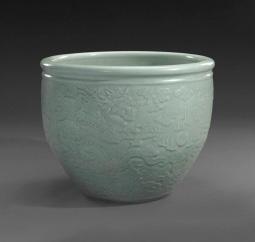
AUCTION RESULT COMPARISON
Type: Related
Auction: Christie’s New York, 18 March 2016, lot 1648
Price: USD 329,000 or approx. EUR 384,000 converted and adjusted for inflation at the time of writing
Description: A massive celadon-glazed ‘dragon’ fish bowl, 18th-19th century Expert remark: Compare the similar form and celadon glaze, molded and carved decoration, and dragon motif. Note the lack of brown-washed bands and the larger size (62.8 cm).
Estimate EUR 8,000
Starting price EUR 4,000
130
A photograph of Panshanger House from its 1953 Estate Sale at the Corn Exchange, Hertford
A CELADON-GLAZED LOTUS POD-FORM BOX AND COVER, QING DYNASTY
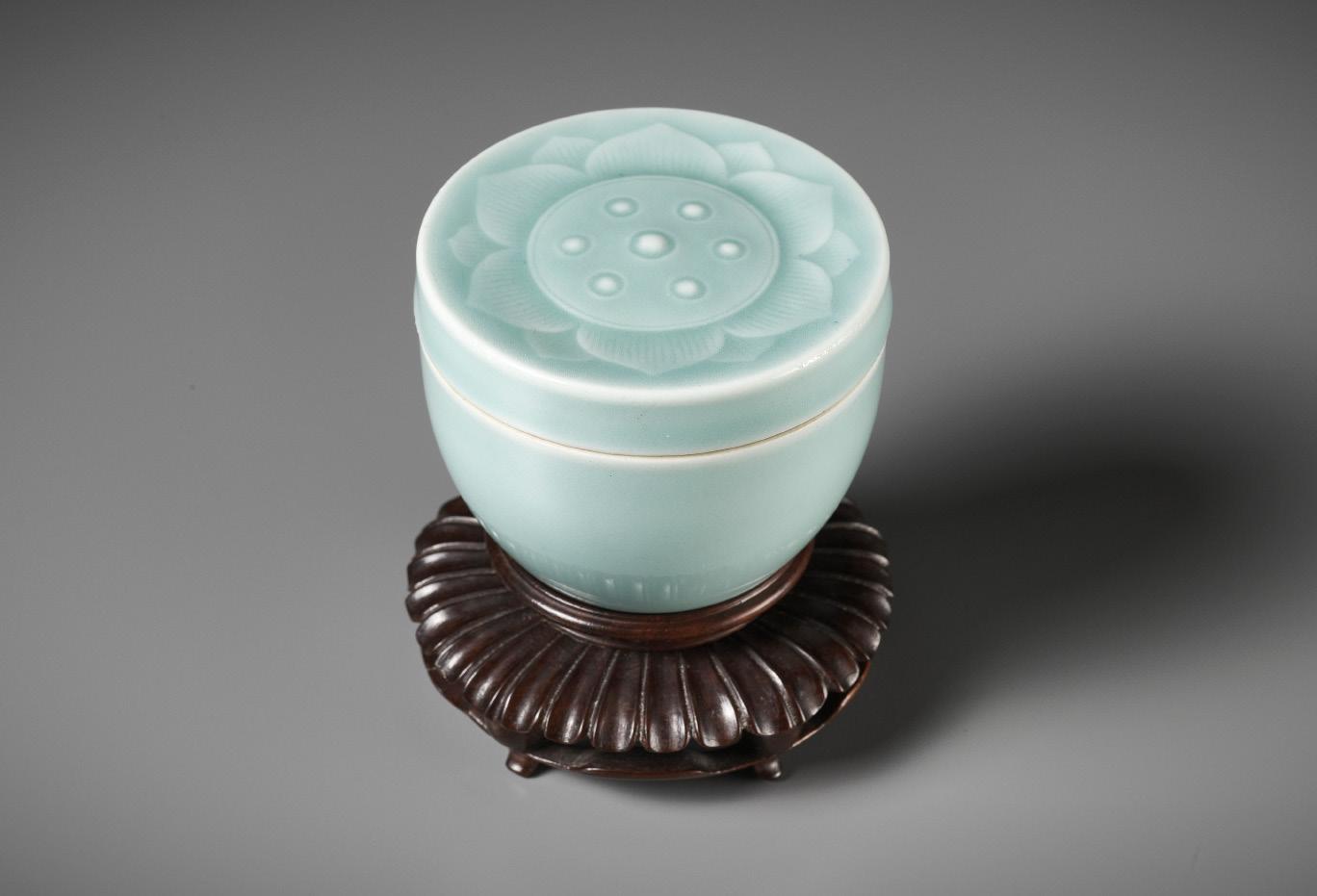
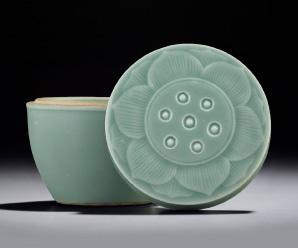
China, 18th-19th century. Delicately potted with deep rounded sides rising from a short foot with recessed base to a broad flat inward rim, surmounted by a cylindrical cover with slightly concave top, exquisitely molded and incised as a lotus flower centered by a mature pod. The box and cover covered overall in a soft sea-green glaze, nicely thinning at the edges and darkening in the recesses. Probably designed after a cricket box, see literature comparisons below for closely related examples made from Hongmu and ivory.
The base with an underglaze-blue six-character mark da Qing Yongzheng nianzhi, but probably dating from the early 19th century, see auction result comparisons below for an closely related example from the Daoguang period.
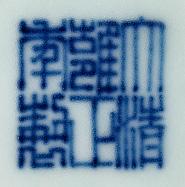
Provenance: From a private collection in northern Germany. The wood stand with an old label, ‘102’. Condition: Excellent condition with only minor old wear and minimal firing irregularities. The wood stand with some natural wear and small age cracks.
Weight: 193.9 g
Dimensions: Diameter 7.1 cm
With a finely carved wood stand decorated with chrysanthemum petals, also dating from the Qing dynasty. (2)

An appreciation of crickets for their chirping songs and cultural symbolism flourished during the Ming and Qing dynasties. Keeping crickets in specially designed containers became a favored pastime among the literati, scholars, and the upper class. Cricket containers during these periods were typically crafted with great attention to detail and featured intricate designs and embellishments. The containers were often adorned with carvings, paintings, calligraphy, and other decorative elements, showcasing the artistic craftsmanship of the period. They were made from various materials, including bamboo, wood, porcelain, and metal.
The present box and cover, designed in the form of a blooming lotus flower, highlights the exceptional creativity exhibited by potters at the Imperial kilns during the Yongzheng era and subsequent periods. These boxes were inspired by earlier containers traditionally made of wood and ivory. Examples of such containers can be found in a range of monochromatic colors, including qingbai and celadon. Despite the presence of preserved examples in prominent collections like the Palace Museum, these boxes remain scarce and are rarely published in literature.
LITERATURE COMPARISON
Compare a hongmu cricket box of related form, dated to the 18th century, in the Minneapolis Institute of Art, accession number 2003.100.2A-C.
Compare an ivory lotus pod-form box and cover, dated to the 17th century, at Christie’s New York, 20 September 2002, lot 131.

AUCTION RESULT COMPARISON
Type: Closely related
Auction: Christie’s Hong Kong, 28 May 2014, lot 3449
Price: HKD 325,000 or approx. EUR 46,500 converted and adjusted for inflation at the time of writing
Description: A small celadon-glazed lotus pod-form box and cover, Daoguang seal mark and of the period
Expert remark: Compare the closely related form, glaze, decoration, and size (7 cm). Note the Daoguang reign mark. While from two different periods, and each with unique qualities, there are noticeable similarities between the finishing work on both examples, where the edge of the glazed body meets the unglazed porcelain. The incision work on the Daoguang-marked example is also of an arguably lesser quality compared to the present lot, which may indicate that the latter is indeed from an earlier date.
Estimate EUR 4,000
Starting price EUR 2,000
193
131
A LARGE BLUE AND WHITE ‘DRAGON’ JARDINIÈRE, QING DYNASTY
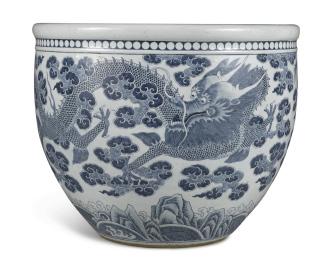
China, c. 1750-1850. The deep rounded sides tapering towards the base and surmounted by a broad everted rim. The exterior is finely painted in shades of cobalt blue depicting two confronted four-clawed dragons pursuing a flaming pearl amid swirling clouds above crashing waves, all between line borders and below a band of key-fret, the base left unglazed.
Provenance: The J. M. Hu, Zande Lou Collection. Jenmou Hu (19111995) was arguably the most important collector of Chinese ceramics in the last century. In both his personal collection and in his bequests to cultural institutions, J. M. Hu stood as a model of the modern scholarcollector. The eldest son of the influential banker Hu Chun, he was raised in an elegant private residence amongst his many stepbrothers and stepsisters. In keeping with tradition, he was given a rigorous background in the Chinese classics, supplemented by a Western-style education. He first encountered Chinese ceramics during his student years, when he purchased a nineteenth-century brush washer for his desk. This initial foray into collecting would become emblematic of J. M. Hu’s poignant relationship with art: even amidst the upheavals of war and the evolution of his collection, the modest brushwasher stayed with him until his death in 1995. Hu’s boyhood studies within the Chinese literati tradition greatly informed his philosophical approach to life and collecting; humble and erudite, he consistently affirmed that it was the visceral connection between a collector and his acquisitions that was of essential importance. True value, in J. M. Hu’s estimation, lay far beyond monetary worth. A noted traditionalist, he went to great lengths designing wooden stands and fitted boxes to preserve and display his Chinese treasures and delighted in sharing the collection with fellow connoisseurs. For J. M. Hu, collecting was a serious, scholarly pursuit not to be taken lightly. The joy of art came with a responsibility to honor both the artist and the object. Hu often spoke of the three necessary criteria in collecting: zhen (authenticity), jing (rarity and quality), and xin (condition). Yet it was an individual’s bond with a work of art, as evidenced in J. M. Hu’s beloved brush washer, that was of fundamental significance. In handling and examining his ceramics, Hu sought that indefinable delight that could come only from the beauty of artistry. In the tradition of Chinese literati who bestowed symbolic monikers upon their studios, libraries, and collections, the name of J. M. Hu’s studio, Zande Lou, referenced the influential Lanting Xu of the famed Jin dynasty calligrapher Wang Xizhi, a text that describes Zande as a person’s inner happiness. Although J. M. Hu intended the meaning of Zande to express this fleeting happiness, which he experienced as a collector when examining an object, the word has also come to be interpreted as the inherently transitory nature of collecting and possessing fine art. J. M. Hu’s collection of Chinese ceramics provided abundant opportunity for personal scholarship and historical investigation. As early as the 1940s, he longed for a welcoming social environment where like-minded collectors could share and discuss art and objects. Two decades later, he established the Min Chiu Society in Hong Kong alongside fellow collectors K.P. Chen and J.S. Lee. A noted cultural philanthropist, J. M. Hu gifted substantial groupings from his collection to the Shanghai Museum in 1950 and again in 1989. Many of these objects remain on view in the museum’s Zande Lou Gallery. To this day, J. M. Hu remains a celebrated figure amongst collectors of Chinese art.
Condition: Good condition with expected old wear, traces of use and firing irregularities, including pitting, dark spots, and firing cracks, one to the base issuing a few fine and short hairlines. One shallow chip to the interior mouth rim, occasional light scratches.
Weight: 12.4 kg
Dimensions: Height 38 cm, Diameter 39.5 cm
Jenmou Hu, The Master of Zande Lou
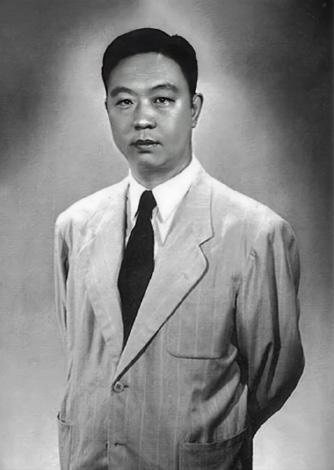
AUCTION RESULT COMPARISON
Type: Related
Auction: Sotheby’s New York 21 March 2018, lot 713
Price: USD 65,000 or approx. EUR 72,000 converted and adjusted for inflation at the time of writing
Description: A large blue and white ‘dragon’ jardiniere, Qing dynasty, 19th century Expert remark: Compare the related form, cobalt blue decoration, and dragon motif. Note the larger size (61 cm).
Estimate EUR 20,000
Starting price EUR 10,000
194 132
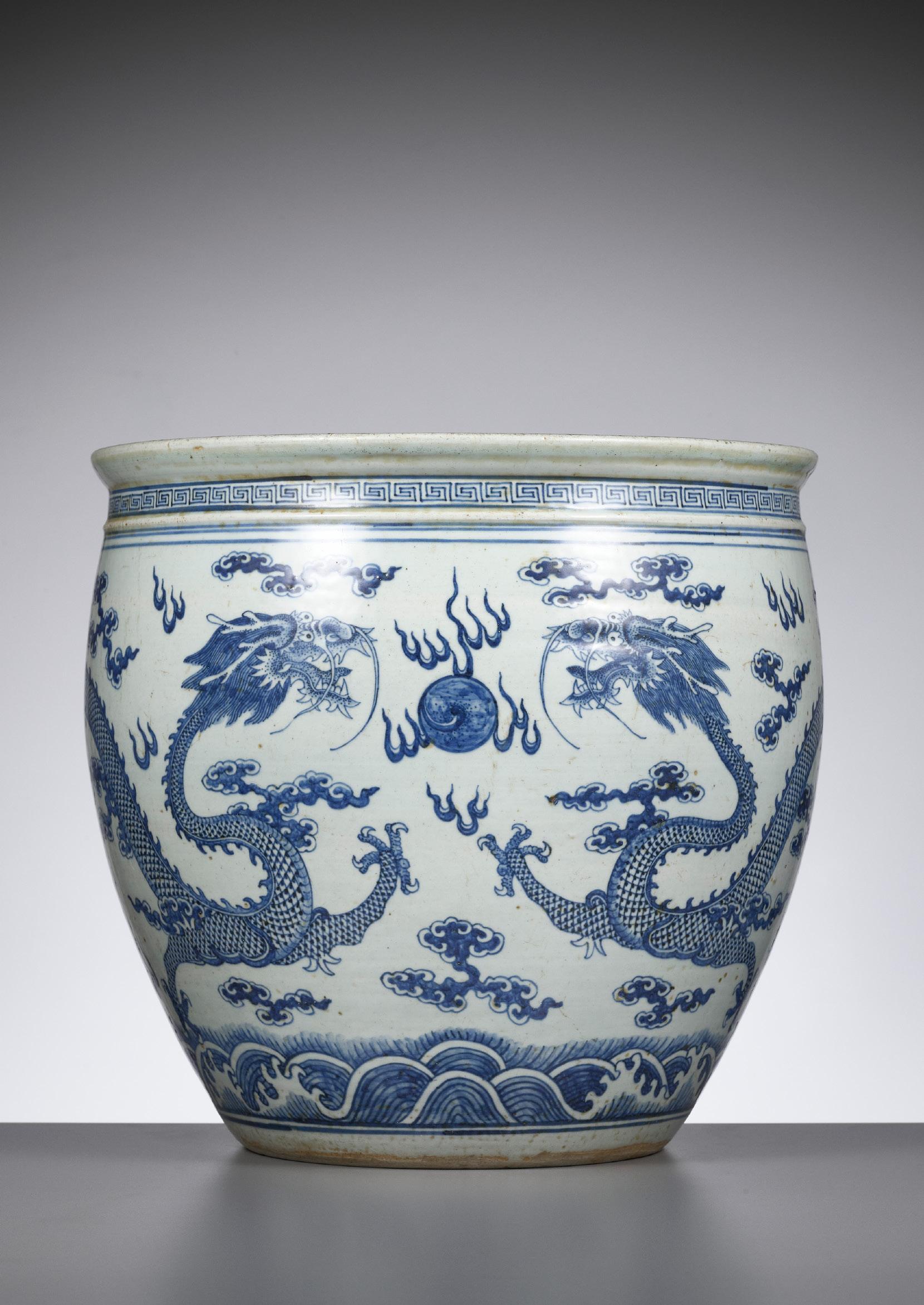
A BLUE AND WHITE ‘AUSPICIOUS FRUITS’ JARDINIÈRE, CHINA, 18TH – 19TH CENTURY
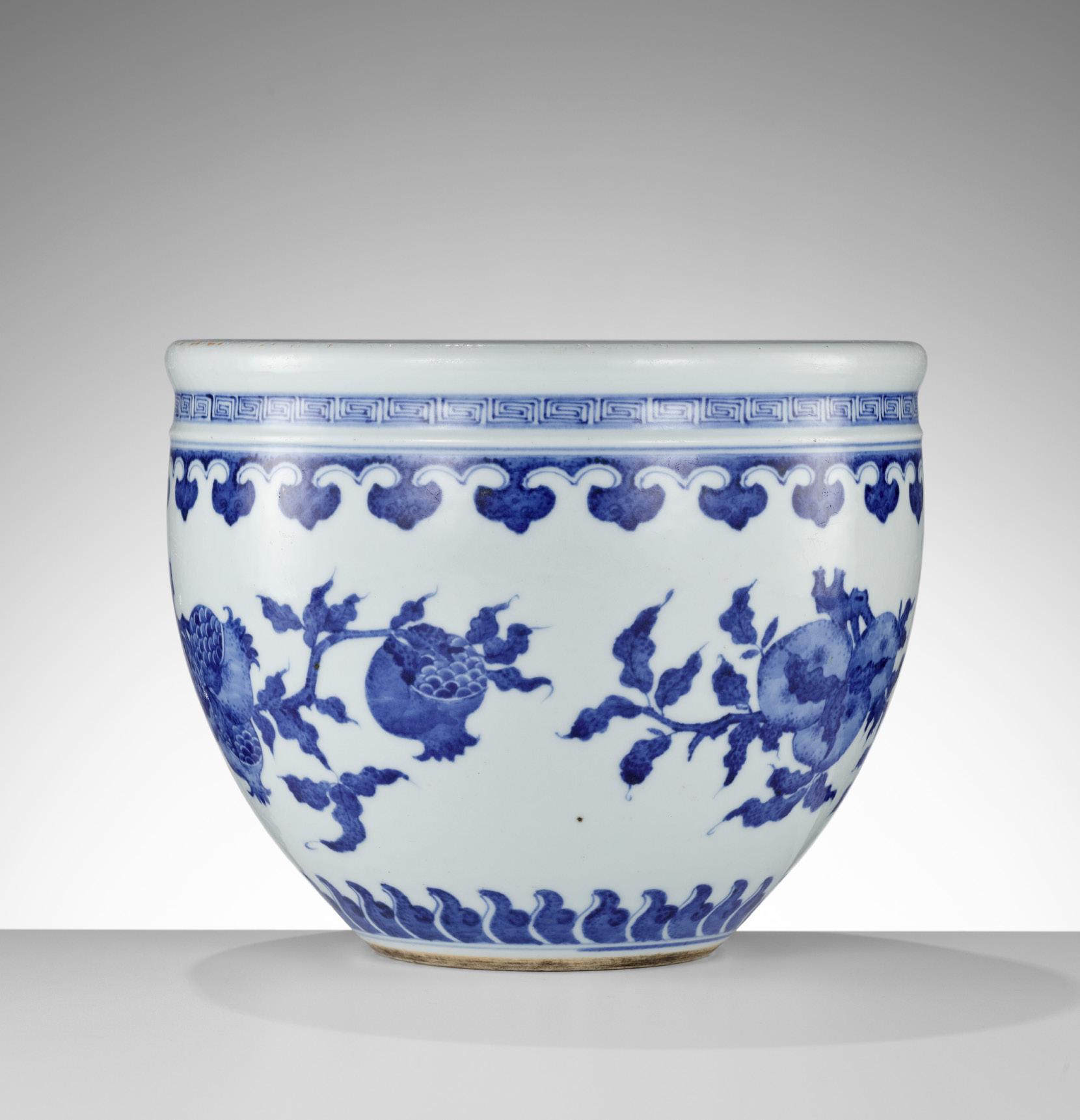

Heavily potted, the steeply rounded sides rising to an everted lipped rim above a single bowstring, the exterior finely painted in neatly graduated shades of cobalt blue with pomegranate and peach borne on leafy branches, below bands of pendent ruyi heads and key-fret, above a band of stylized lotus petals.
Provenance: London trade.
Condition: Very good condition with expected old wear and minor manufacturing irregularities, shallow surface scratches and abrasions mostly to the edges, few scattered glaze recesses, traces of use, the unglazed base covered with old newspaper.
Weight: 2,371 g
Dimensions: Diameter 23 cm, Height 18.5 cm
AUCTION RESULT COMPARISON
Type: Closely related
Auction: Christie’s New York, 16 March 2015, lot 3594
Price: USD 10,000 or approx. EUR 11,500 converted and adjusted for inflation at the time of writing
Description: A blue and white jardinière, 18th-19th century
Expert remark: Compare the closely related form and decoration, albeit with a different motif, and the similar size (24.1 cm).
Estimate EUR 4,000
Starting price EUR 2,000
196 133
A FAMILLE ROSE
‘BATS AND PEACHES’ BOWL, GUANGXU MARK AND PERIOD
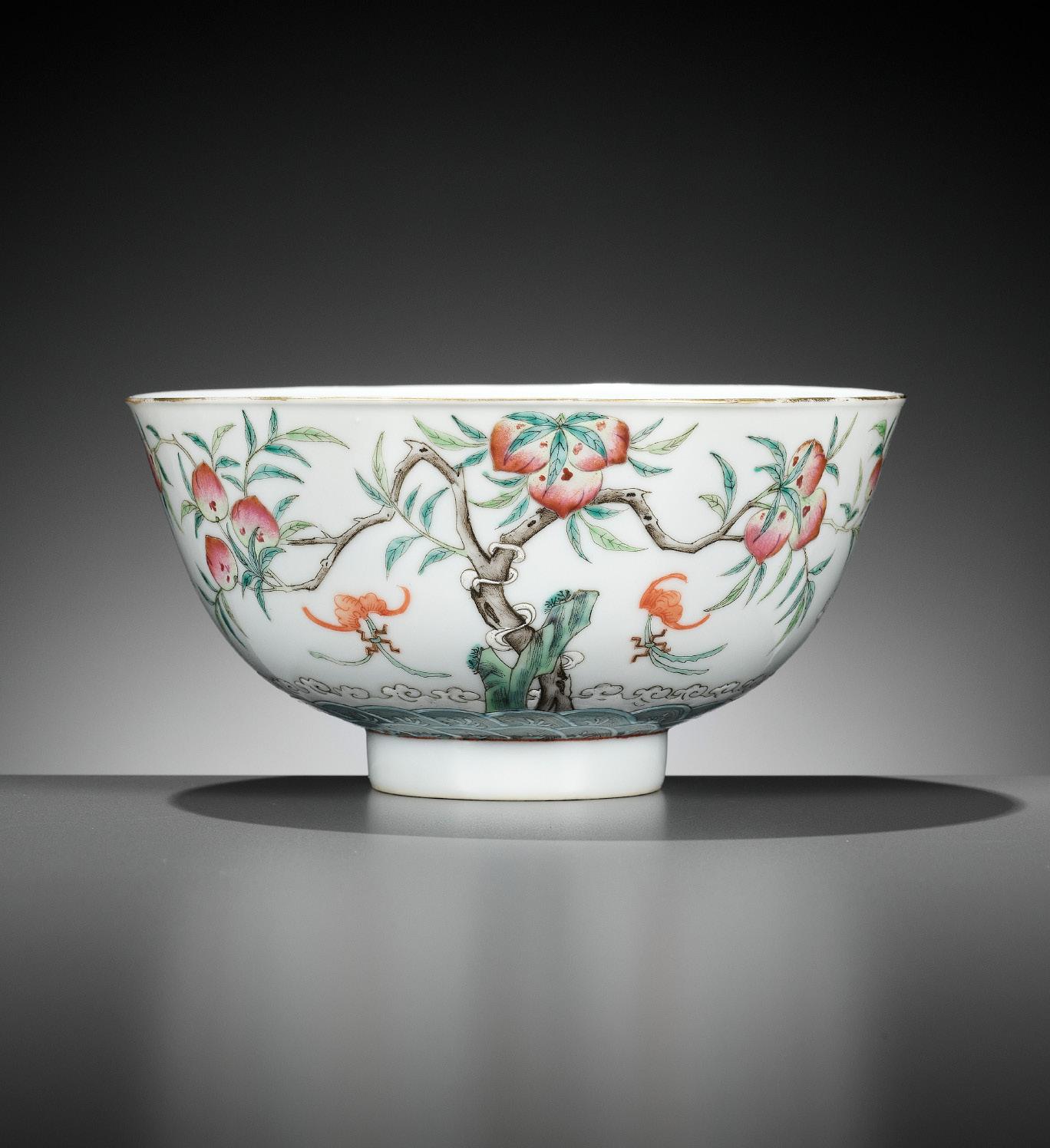
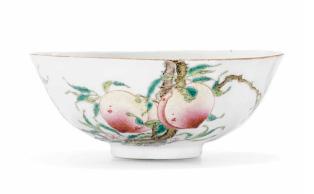
China, 1875-1908. Well potted with deep rounded sides supported on a short foot and rising to a gently everted gilt rim, the exterior finely decorated in bright enamels with numerous large longevity peaches borne on two gnarled trees further issuing finely veined leaves in two shades of green, the trees partly obscured by craggy rocks, both emerging from crashing waves and thick clouds, swirling around each tree like a billowing scarf, each tree flanked by two iron-red bats suspending gilt wan emblems tied to ribbons, the recessed base with a six-character underglaze-blue mark da Qing Guangxu nianzhi and of the period.
Provenance: From the collection of David Stopher, Kent, United Kingdom.
Condition: Very good condition with minor wear and firing irregularities, few microscopic nibbles, tiny surface scratches, minor rubbing to enamels. Two hairlines to rim.
Weight: 378.2 g
Dimensions: Diameter 16.5 cm
AUCTION RESULT COMPARISON
Type: Related
Auction: Christie’s London, 7 November 2017, lot 102
Price: GBP 9,375 or approx. EUR 15,000 adjusted for inflation at the time of writing
Description: A pair of famille rose ‘bats and peaches’ bowls, Guangxu six-character marks in iron-red and of the period
Expert remark: Compare the related form, ‘bats and peaches’ motif, and Guangxu reign mark. Note the size (18.8 cm) and the different depiction of the same subject, yet still with a number of similarities including the gnarled branches, two-colored leaves, large peaches, and iron-red bats.

Estimate EUR 3,000
Starting price EUR 1,500
197 134
135
A PAIR OF YELLOW-GROUND GREEN AND AUBERGINE-ENAMELED ‘DRAGON’ DISHES, GUANGXU MARKS AND PERIOD


China, 1875-1908. Each with shallow rounded sides supported on a short foot and rising to slightly everted rim, the interior finely decorated with two confronted dragons chasing a flaming pearl amid cloud scrolls and flames encircled by evenly spaced alternating peach and prunus sprays, the exterior similarly decorated with sinuous dragons, the recessed base with a black-enameled six-character mark da Qing Guangxu nianzhi and of the period. (2)
Provenance: Christie’s London, 11 November 2011, lot 1086, sold for GBP 7,500 or approx. EUR 14,000 (converted and adjusted for inflation at the time of writing). A private collection in Singapore, acquired from the above. Each dish with a Christie’s auction label from 11 November 2011.
Condition: Superb condition with only minor wear and minimal firing irregularities.
Weight: 64.7 g and 67.5 g
Dimensions: Diameter 10.7 cm and 10.8 cm
AUCTION RESULT
COMPARISON
Type: Closely related
Auction: Christie’s London, 10 May 2011, lot 284
Price: GBP 11,250 or approx. EUR 21,000 converted and adjusted for inflation at the time of writing
Description: A pair of green and aubergine-enameled yellow-ground ‘dragon’ dishes, Guangxu six-character marks and of the period Expert remark: Compare the closely related form, decoration, and reign mark. Note the similar size (11.5 cm).

Estimate EUR 10,000
Starting price EUR 5,000
198
A PAIR OF FAMILLE ROSE ‘DRAGON’ BOWLS, SIX-CHARACTER XUANTONG MARKS AND PERIOD
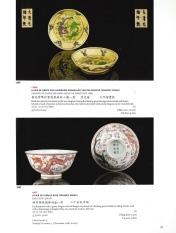

China, 1909-1912. Each with deep rounded sides supported on a short foot and rising to an everted rim, the exterior finely painted with a green and a red dragon in pursuit of a flaming pearl amid colorful scrolling clouds. The recessed bases each with an underglaze-blue six-character mark da Qing Xuantong nianzhi and of the period. (2)
Provenance:

Sotheby’s London, 13 December 1988, lot 265 (dated to the Xuantong period). A private collection in the United Kingdom, acquired from the above. Christie’s London, 11 November 2011, lot 1087 (dated to the early 20th century), sold for GBP 6,875 or approx. EUR 12,500 (converted and adjusted for inflation at the time of writing). A private collection in Singapore, acquired from the above. Each bowl with a Christie’s auction label from 11 November 2011.
Condition: Superb condition with only minor wear and minimal firing irregularities. Few microscopic nibbles to foot.
Weight: 205.7 g and 179.4 g
Dimensions: Diameter 14 cm and 13.9 cm
Literature comparison: Compare a related polychrome bowl with this same pattern, also with a Xuantong mark, of slightly smaller size, exhibited at the Hong Kong Oriental Ceramics Society Exhibition of Ch’ing Polychrome Porcelain, 1977, cat. no. 132.

Estimate EUR 10,000
Starting price EUR 5,000

199 136


A GRISAILLE AND IRON-RED-DECORATED ‘LI TIEGUAI’ VASE, HONGXIAN MARK, EARLY REPUBLIC PERIOD
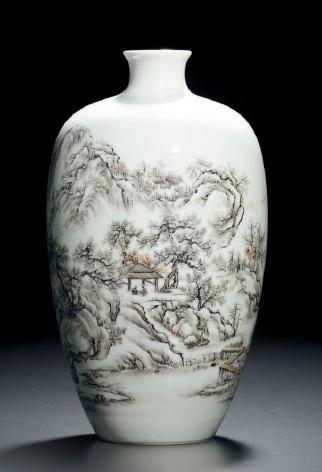
Expert’s note: For an interesting discussion of porcelain produced during the short period from December 1915 to February 1916 when General Yuan Shikai adopted the reign title Hongxian in an attempt to restore the monarchy to China, see the article by Simon Kwan, ‘Hongxian Porcelain and the Role of Wang Xiaotang’, published in Orientations, October, 1991, pp. 65-70. In particular, the author notes that a batch of Hongxian-marked porcelain wares was most likely indeed produced for Yuan Shikai. The painting on the present porcelain vase is of the highest quality. The painter not only executed the meticulous wrinkles and folds of Li Tieguai’s skin with a deft hand, but he also painted the clothes with an intricate pattern and shaded the rocks with remarkable mastery. This vase belongs to a rare group of grisaille-decorated porcelain from the Republic period which were decorated by the most skilled painters in Jingdezhen, of which there were exceedingly few left at that time.
China, c. 1915-1930. Delicately potted, the ovoid body supported on a short foot and rising to a gently rounded shoulder with a waisted neck and flared mouth. Superbly painted to the exterior in predominantly iron-red and grisaille with Li Tieguai leaning on his iron crutch as he sits on a dramatically cragged and pierced rock under a towering tree with gnarled branches, before a flaming brazier with his double gourd placed on top, surrounded by further vessels and implements. The base with an iron-red four-character seal mark Hongxian nianzhi within a double square.
Provenance: From the collection of Dr. Wou Kiuan. Wou Lien-Pai Museum, coll. no. Q.3.16. Dr. Wou Kiuan (1910-1997) was a Chinese diplomat and noted scholar of Chinese art. His father, Wou Lien-Pai (1873-1944), was one the leading political figures of early 20th century China, remembered for his role as speaker and leader of parliament during the turbulent years of the Republican era. Dr. Wou himself embarked on an illustrious career in diplomacy until his retirement in 1952, when he settled in London and devoted the rest of his life to the study of Chinese art. It was no doubt fortuitous that Dr. Wou’s years of collecting coincided with an abundant availability of exceptional Chinese art on the London market. From the mid-1950s to the late 1960s he was able to form a collection of well over 1,000 works that together represented virtually every category of Chinese art. At the heart of Dr. Wou’s drive to collect was a burning desire to preserve the relics of China’s rich historical past scattered across Europe, and to promote Chinese art and culture. It is unclear when Dr. Wou conceived the idea to create a place to house his collection, but in 1968, he opened the doors to the Wou Lien-Pai Museum, named in honor of his father. Over the years the museum became a ‘must see’ destination for collectors, academics, and visiting dignitaries, and Dr. Wou would delight in leading his visitors through the galleries, recounting stories of China’s glorious history.
Condition: Very good condition with minor wear and firing irregularities, the body with a fine and short hairline.
Weight: 553.5 g
Dimensions: Height 20 cm
Yuan Shikai (1859-1916) was the first President of the Republic of China and Emperor of the short-lived Empire of China (1915-1916), taking the era name Hongxian. In 1916, Guo Baochang, an antiques dealer with a good relation to the court, was appointed to oversee Hongxian’s new imperial porcelain production. The intent from the outset was that the items produced were to be of excellent quality. The biscuit used was very thin, the enamels were sent from the Imperial Workshops and the mark used was a red seal reading Juren Tang zhi. The quality of items produced was reputed to be excellent. Unfortunately, during production, because of the very thin biscuit, many objects were damaged. The remaining few perfect pieces were given to the most favored officials and are exceedingly rare today.

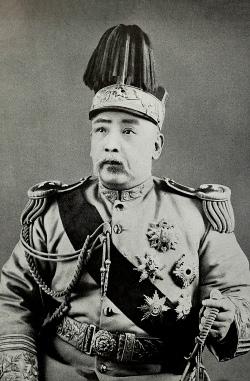
Yuan Shikai stepped down as Emperor on 22 March 1916 and resumed his presidency, dying shortly afterwards in June 1916. After his death, production was halted and the kilns were destroyed, but the enamels were stolen by workers who then proceeded to copy the Juren Tang production, marking their pieces Hongxian nianzhi (also Hongxian Yu Chih or Hongxian Yuan Nian), mostly with Kaishu script. The first copies produced were apparently of extremely high quality, as they were still using the imperial biscuit and enamels, but quality fell as the quantity increased and, presumably, the imperial resources were depleted. One opinion has it that all Hongxian marked pieces are made after the actual period, and that the only possibly genuine mark of the Hongxian period is the Juren Tang if any. Still, from extant pieces it is clear that the porcelain industry was much stimulated at that time and for decades to come, and that pieces of very high quality were made, some of which bear the Hongxian mark while others are marked Juren Tang.
AUCTION RESULT COMPARISON
Type: Closely related
Auction: Christie’s Hong Kong, 29 May 2013, lot 2033
Price: HKD 437,500 or approx. EUR 65,500 converted and adjusted for inflation at the time of writing
Description: A grisaille-decorated ‘landscape’ vase, Hongxiang yuzhi blue enamel mark within doublesquares, Republic period
Expert remark: Compare the closely related-iron red and grisaille decoration and Hongxian mark, as well as the similar size (20.2 cm). Note the different subject and form.
Estimate EUR 8,000
Starting price EUR 4,000
201
137
Yuan Shikai (1859-1916) as President of the Republic of China in 1915
Dr. Wou Kiuan, Paris, November 1939
A COMPLETE SET OF FOUR FAMILLE ROSE ‘EIGHT IMMORTALS’ PLAQUES, BY
WANG QI (1884-1937)
China, Republic period, circa 1930. Exquisitely painted in bright enamels, each plaque depicting two of the Eight Immortals wearing fine robes and holding their attributes, with two seals of the artist. (4)

Expert’s note: The quality of this set is remarkable. The artwork is exquisitely detailed in vivid and confident brushstrokes, very much unlike the countless copies in circulation today. The enamels are exceptionally well fired, with crisp and elegant colors, blended to an overall nearperfect harmony, as found only in a small number of works from the Wang Qi studio. Equally noteworthy is the quality of the hardwood frames, including their fittings and backings, all exhibiting clear signs of age, original to the set and executed to the highest standards, a level of craftsmanship absent in later pieces.
Inscriptions: Each plaque with two seals: the first, lower right, ‘Wang Qi’ and ‘Liandan jishi’; the second, lower right, one reading ‘Wang Qi’; the third, lower left, ‘Xiaoyao’ and ‘Wang Qi huayin’; and the fourth, lower right, one reading ‘Wang Qi’.
Provenance: North American trade. By repute acquired from a local estate. Condition: Excellent condition with some old wear and firing irregularities. Little rubbing and flaking to enamels. One plaque with a phosphorescent firing flaw in the upper left corner. The frames with expected traces of use, minor splits and a natural patina.
Dimensions: Panel size ca. 55 x 17 cm (each), Size incl. frame ca. 59 x 21 cm (each)
The first plaque depicts Li Tieguai leaning on his iron crutch, carrying two gourds on his back, one releasing fumes, standing next to He Xiangu holding a long leafy blossoming lotus stem, under the full moon.
The second plaque with Zhongli Quan holding his fan and Lu Dongbin with his sword sheathed to his back, below a flying crane.
The third plaque shows Han Xiangsi, with his flute suspending a jade pendant, conversing with Cao Guojiu looking up towards his castanets in the air above.
The fourth plaque with the elderly Zhang Guo holding his bamboo rod and standing beside Lan Caihe carrying his basket filled with flowers and lingzhi, below an iron-red bat.
The Baxian (Eight Immortals) are a legendary group of Chinese heroes who fight to vanquish evil. Most of them are said to have been born in the Tang or Song Dynasty. They are revered by the Taoists and are also a popular element in secular Chinese culture. They are said to live on a group of five islands in the Bohai Sea, which includes Mount Penglai. Stories of these immortals were first recorded by the Ming dynasty poet Wu Yuantai. Their status as folk icons makes them well-known in popular culture.
Wang Qi (1884-1937) was the most outstanding porcelain painter of his day. After the fall of the Qing dynasty, imperial orders for porcelain dwindled at Jingdezhen, the main porcelain production center in China. Porcelain artists, released from imperial restraints, developed their own styles based on famous scroll painters of earlier periods. Eight of the leading artists formed a group, which despite calling themselves ‘The Full Moon Society’ came to be known as the ‘Eight Friends of Zushan’. The development of Wang Qi’s mature style can be traced to a trip he made to Shanghai in 1916 to see an exhibition of works by a group of painters called Yangzhou Baguai (the Eight Eccentrics of Yangzhou). Wang was so impressed by the paintings of Huang Shen, one of the Eight Eccentrics, that he started to emulate Huang’s style. But not satisfied with just emulating, over the years, Wang increasingly developed his own distinct style by incrementally incorporating Western painting and enameling techniques in his work.
Article continues online at www.zacke.at
Literature comparison: A set of plaques, also painted with the Eight Immortals but in a different arrangement of pairs, is preserved in the China Ceramic Museum, Jingdezhen, albeit unpublished. The Muwentang Collection has a group of famille-rose plaques of different figural subjects painted in a related style by Wang Qi, attributed to the period between 1912-1925, published in Simon Kwan, Minguo ciqi (Chinese Porcelain of the Republic Period), Hong Kong, 2008, pls. 12-19.
Estimate EUR 15,000
Starting price EUR 7,500
202 138
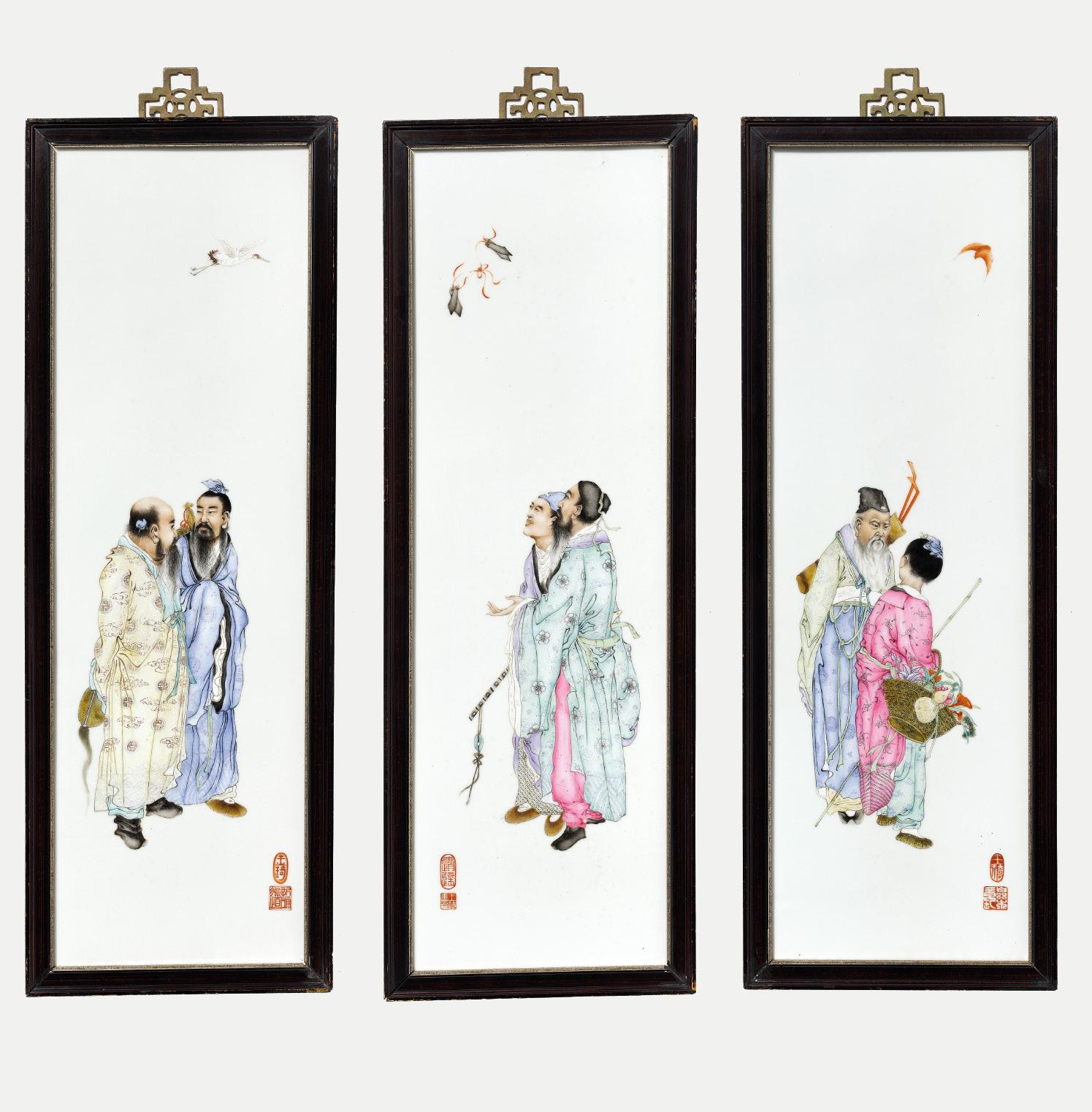
203

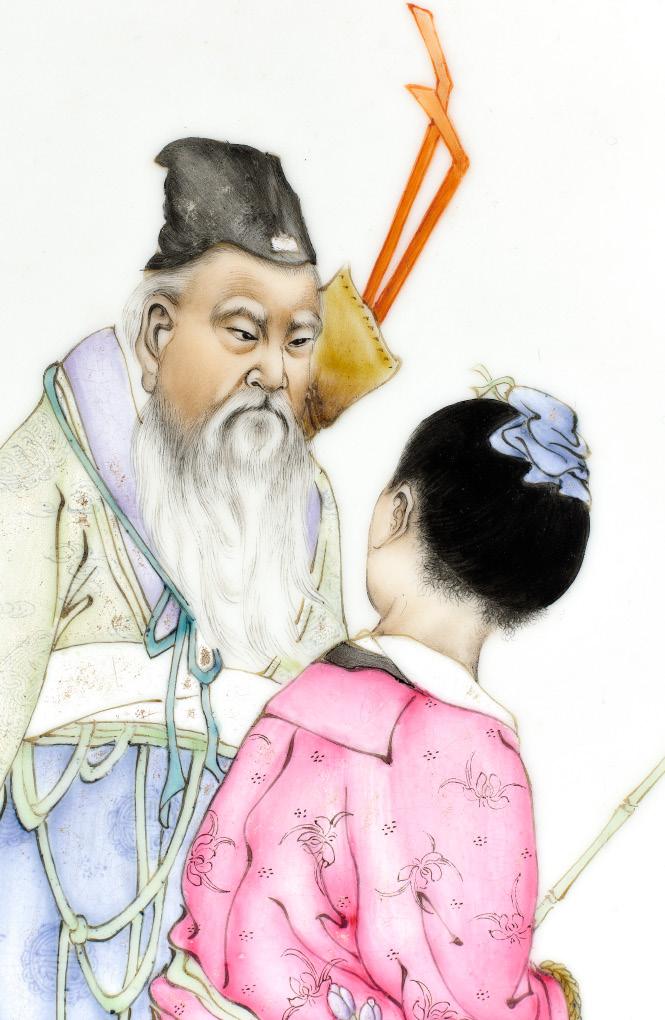


204
139
A PAIR OF GRISAILLE AND IRON-RED VASES DEPICTING ZHANG GUOLAO, REPUBLIC PERIOD
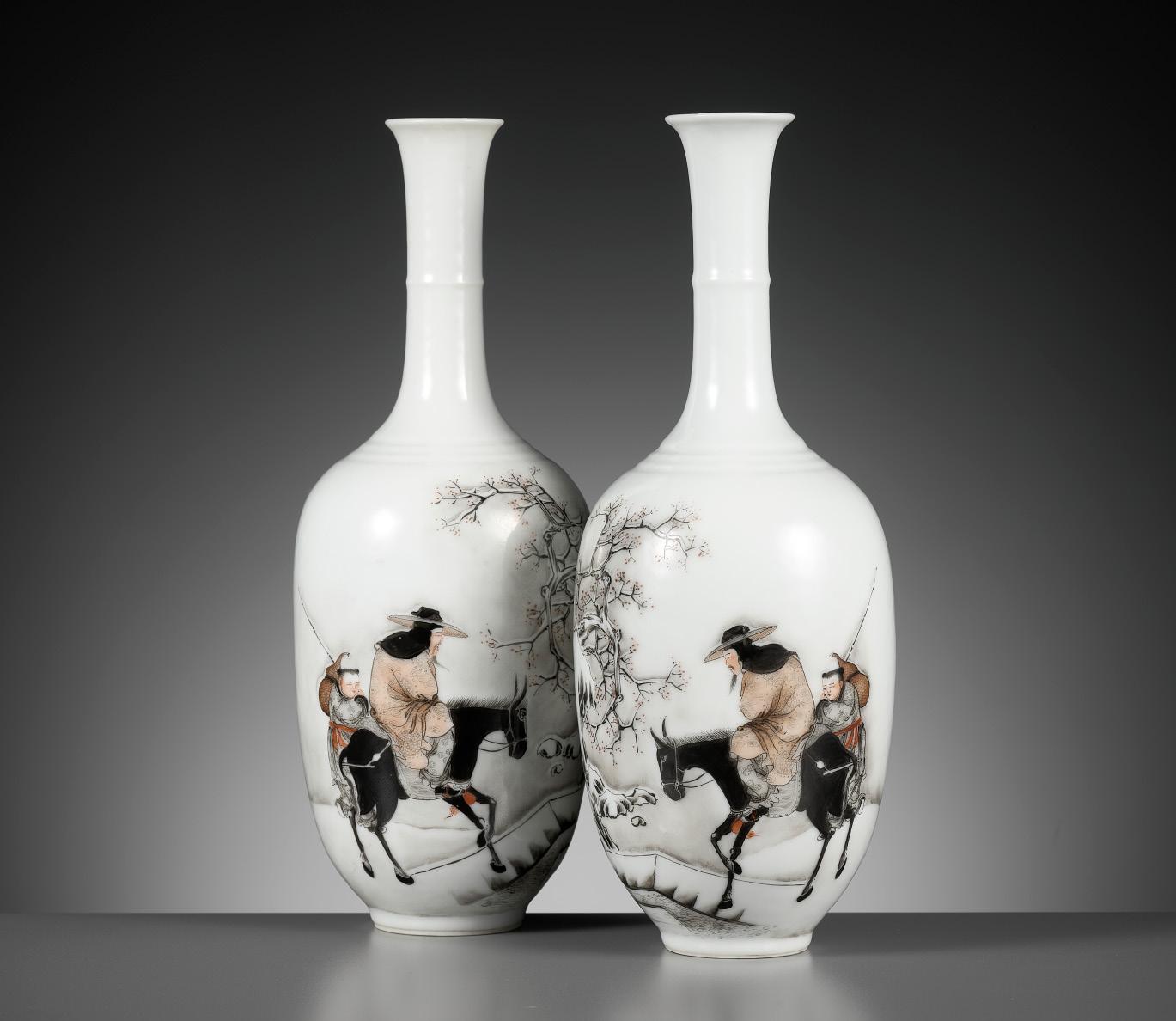
China, 1912-1949. Each made from rather thin biscuit and with a baluster body surmounted by a long slender neck centered by a bowstring and rising to a subtly flared mouth with everted rim. Finely painted to depict Zhang Guolao atop a mule with a young attendant carrying his gourd vessel before a bridge in a snowy landscape with blossoming prunus and craggy rockwork. The base with an iron-red four-character mark Hongxian nianzhi. (2)
Inscriptions: To each vase, ‘Qilu guo xiaoqiao, du tan meihua shou’ ([I] sit on a donkey, cross the bridge, and I marvel at the beauty of the plum blossoms).
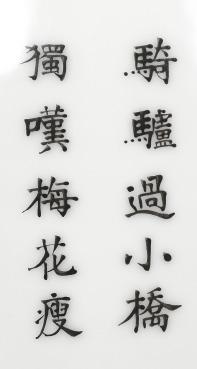

Provenance: From a German private collection. Condition: Excellent condition with minor wear, minimal firing irregularities, and few light scratches.
Weight: 225.4 g and 204.3 g
Dimensions: Height 20.1 cm and 20 cm
Yuan Shikai was the first President of the Republic of China and Emperor of the short-lived Empire of China (1915-1916), taking the era name Hongxian. In 1916, Guo Baochang, an antique dealer with a good relation to the court, was appointed to oversee Hongxian’s new imperial porcelain production. The intent from the outset was that the items produced were to be of excellent quality. The biscuit used was very thin, the enamels were sent from the Imperial Workshops and the mark used was a red seal reading Juren Tang zhi. The quality of items produced was reputed to be excellent. Unfortunately, during production, because of the very thin biscuit, many objects were damaged. The remaining few perfect pieces were given to the most favored officials and are exceedingly rare today.

Yuan Shikai stepped down as Emperor on 22 March 1916 and resumed his presidency, dying shortly afterward in June 1916. After his death, production was halted and the kilns were destroyed, but the enamels were stolen by workers who then proceeded to copy the Juren Tang production, marking their pieces Hongxian nianzhi (also Hongxian Yu Chih or Hongxian Yuan Nian), mostly with Kaishu script. The first copies produced were apparently of extremely high quality, as they were still using the imperial biscuit and enamels, but quality fell as the quantity increased and, presumably, the imperial resources were depleted. One opinion has it that all Hongxian marked pieces are made after the actual period, and that the only possibly genuine mark of the Hongxian period is the Juren Tang if any. Still, from extant pieces it is clear the porcelain industry was much stimulated at this time and for decades to come, and that pieces of very high quality were made, some of which bear the Hongxian mark while others are marked Juren Tang.
AUCTION RESULT COMPARISON
Type: Related
Auction: Christie’s New York, 15 September 2011, lot 1642
Price: USD 12,500 or approx. EUR 15,500 converted and adjusted for inflation at the time of writing
Description: An iron-red and grisaille-decorated baluster vase, 20th century

Comparison: Note the size (32.9 cm).
Estimate EUR 4,000
Starting price EUR 2,000
205
Yuan Shikai (1859-1916) as President of the Republic of China in 1915
140
A YIXING ‘TROMPE L’OEIL’ FIGURE OF A TAPIR, QING DYNASTY
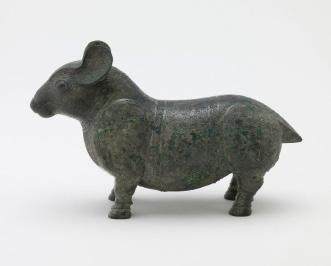
Expert’s note: Tapirs based on archaic bronze prototypes were made in a number of materials during the Qianlong period. Compare a yellow jade tapir dated to the Qianlong period at Bonhams Hong Kong, 29 November 2016, lot 12 (fig. 1). Compare a pair of Imperial cloisonné and gilt-bronze figures of tapirs, with Qianlong marks and of the period, at Sotheby’s Hong Kong, 2 October 2018, lot 3408. Compare a bronze tapir-form vessel, with a Qianlong mark and of the period, at Christie’s London, 3 November 2020, lot 90 (fig. 2). Compare a turquoise-glazed figure of a Tapir, dated to the Qianlong period, at Sotheby’s London, 17 May 2019, lot 428. Also note that the present lot must not be confused with copies made from the Freer-Gallery Tapir by Alva Museum Replicas Inc., New York, in the 1950s. These are made from a different type of earthenware, which is of much brighter color, and of course their décor is printed and not incised.


In the 18th century, the Chinese court developed a keen interest in trompe l’oeil decoration, creating realistic imitations of various natural materials. This fascination was fueled by a desire to showcase the craftsmanship and technical prowess of imperial artisans. Artists and craftsmen excelled in producing works that imitated materials such as wood, stone, metal, and even textiles with remarkable precision. These trompe l’oeil creations adorned palaces, imperial gardens, and the residences of nobility, captivating viewers with their lifelike appearance and attention to detail.
LITERATURE COMPARISON
China, 18th-19th century. Exquisitely potted from Yixing ceramic ware in imitation of an archaic bronze tapir from the Zhou Dynasty and superbly painted to simulate an ancient patina with malachite, cuprite, and azurite ‘encrustations’, as well as ‘wear’ and ‘damage’. The animal standing foursquare with an alert expression marked by wide round eyes and pricked ears, its body finely incised with archaistic scroll motifs.
Provenance: From a private estate in New York City, United States.
Condition: Good condition, with some minor actual wear, and possibly few small genuine chips and losses, occasional light scratches.
Weight: 598.1 g
Dimensions: Length 18 cm
The form and incised decoration of this figure are based on ancient bronze prototypes from the Eastern Zhou dynasty. These early bronzes were sometimes decorated with delicate inlay of precious metals and semi-precious stones. The identity of this particular animal has been much discussed and is variously described as a mythological animal, a rhinoceros, and a tapir. The latter seems the most likely candidate since the form has significant features in common with surviving species of tapir, and archaeology has shown that tapirs were indigenous to China in earlier times. These animals have long been extinct in China, but the Asian tapir has survived in small numbers in areas of Southeast Asia. It is interesting to note that even the bronze tapirs of the Eastern Zhou, as with the present figure, are shown with collars, which suggests that at one time there was a degree of domestication.
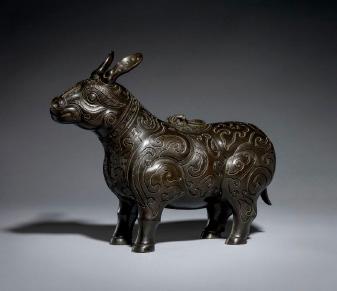
Compare a near identical example in bronze, dated ca. 5th century BC, 18.3 cm long, reportedly excavated at Li-yü, Shanxi province in 1939 and sold by C. T. Loo to Charles Lang Freer in 1940, now in the Freer Gallery of Art in the National Museum of Asian Art, Smithsonian Institution, accession number F1940.23 (fig. 3), illustrated by Jenny So, Eastern Zhou Ritual Bronzes from the Arthur M. Sackler Collections, p. 37, fig. 46, where the author notes that the “function of the Freer animal is uncertain, although four similar quadrupeds supported a square pan excavated from the nearby site of Shanxi Lucheng Luhe”, see ibid., fig. 47. Compare a closely related bronze tapir, dated 6th-5th century BC, 21 cm long, from the collection of Henry J. Oppenheimer and now in the British Museum, registration number 1947,0712.333, included in the exhibition International Exhibition of Chinese Art, Royal Academy of Arts, 1935-1936, London, ill. 136, pp. 11, and illustrated by Jessica Rawson, The British Museum Book of Chinese Art, fig. 88, where the author notes that the tapir “may have been one of the three or four animal-shaped feet for a basin or tray.”
AUCTION RESULT COMPARISON
Type: Related
Auction: Christie’s New York, 22 March 2012, lot 1251
Price: USD 182,500 or approx. EUR 221,000 converted and adjusted for inflation at the time of writing
Description: A rare yixing archaistic animal-form water vessel, signed Chen Zhongmei
Expert remark: Compare the related form and Yixing pottery material, however modeled in an earlier style that does not seek to replicate the bronze material in trompe l’oeil fashion. The artist of this vessel, Chen Zhongmei, is recorded as working from the early 1600s onwards, but died at a young age and probably did not see the end of the Ming dynasty. Note the size (28 cm).
Estimate EUR 6,000
Starting price EUR 3,000
206
fig. 3
fig. 1
fig. 2

AN EXCEPTIONALLY LARGE AND MASSIVE BRONZE RITUAL TRIPOD WINE VESSEL, JIA, WITH A CLAN MARK, SHANG DYNASTY
China, 13th century BC. Raised on three blade-form supports, the sides flat-cast with two bands of taotie masks, each composed of three masks positioned between the supports and with rounded eyes and slender dividing flange, with a simple strap handle and a pair of rectangular posts with large conical caps cast with comma motifs. The interior with a clan sign in the form of a single pictogram.
Provenance: A private collection in Kansai, Japan, acquired before 1960. A Japanese private collection, acquired 2005. Christie’s New York, 19 March 2008, lot 487, sold for USD 97,000 or approx. EUR 127,000 (converted and adjusted for inflation at the time of writing). A prominent North American private collection, acquired from the above.
Condition: Superb condition, commensurate with age. Old wear, signs of weathering and erosion, encrustations, few small nicks to edges. A clean, natural fatigue crack below one post, as shown in the X-ray images, with three small staples. No losses whatsoever. A rich, emeraldgreen patina, with distinct patches of azurite, malachite and pale sea-green. Displaying exceptionally well, and exceedingly rare in this magnificent size and condition.
X-Ray Images: Available online at www.zacke.at.
Weight: 5.9 kg
Dimensions: Height 37 cm
With an old Japanese wood storage box. (2)
Expert’s note: Jia of this type, with the decoration arranged in two registers, appeared shortly before the Anyang period (c. 1300-1030 BC). The main decoration was usually that of taotie masks, either cast in relief or flat cast as on the present jia, and on the very similar jia of slightly smaller size (35.2 cm), illustrated in Shang Ritual Bronzes in the National Palace Museum Collection, Taipei, 1998, pp. 152-7, no. 9, also illustrated on the National Palace Museum’s website, image number C1A000405N000000000PAD.
Literature comparison: Compare a related bronze jia, 45 cm high, dated 13th-12th century BC, illustrated by R.W. Bagley, Shang Ritual Bronzes in the Arthur M. Sackler Collections, Cambridge, Massachusetts, 1987, pp. 164-5, no. 7. Compare two related jia vessels illustrated in Shang Ritual Bronzes in the National Palace Museum Collection Taipei, 1998, p. 156, excavated in 1968 at Xiao chuan, Anyang prefecture, Henan province, the first from Tomb M388 and the second from Tomb 331. Compare a related jia vessel illustrated by Bernhard Karlgren, Some Characteristics of the Yin Art, in the Röhss Museum, no. 34, 1962, pl. 31a. Also compare an example in the Lippens collection of ancient Chinese bronzes, published by Christian Deydier, Paris, France, lot 12.
AUCTION RESULT COMPARISON
Type: Closely related
Auction: Sotheby’s New York, 11 September 2012, lot 97
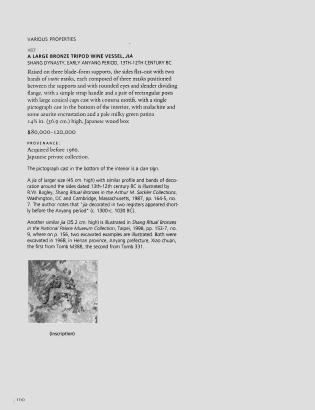
Price: USD 170,500 or approx. EUR 204,000 converted and adjusted for inflation at the time of writing
Description: A rare archaic bronze ritual tripod vessel, jia, late Shang dynasty, 13th-11th century BC

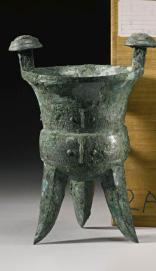
Expert remark: Compare the closely related form, two-register taotie decoration, and patina. Note the inscription ‘Shang’ on this jia.
AUCTION RESULT COMPARISON
Type: Closely related
Auction: Christie’s New York, 21 March 2014, lot 2034
Price: USD 149,000 or approx. EUR 175,000 converted and adjusted for inflation at the time of writing
Description: A rare large bronze ritual tripod wine vessel, jia, late Shang dynasty, 13th-12th century BC
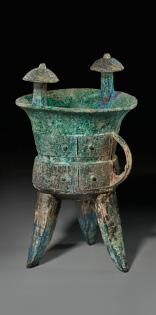
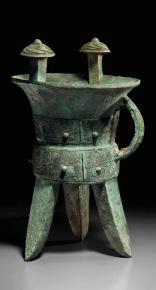
Expert remark: Compare the closely related form, two-register taotie decoration, and patina. Note the much smaller size (29.8 cm) and absence of a clan mark.
AUCTION RESULT COMPARISON
Type: Closely related
Auction: Christie’s New York, 25 September 2020, lot 1502
Price: USD 137,500 or approx. EUR 146,000 converted and adjusted for inflation at the time of writing
Description: A bronze ritual tripod wine vessel, jia, mid-Shang dynasty, 13th century BC
Expert remark: Compare the closely related form, two-register taotie decoration, and patina. Note the much smaller size (30.5 cm) and absence of a clan mark.

Estimate EUR 100,000
Starting price EUR 50,000
208 141


 X-ray image of the present lot, revealing the superb overall condition
X-ray image of the present lot, revealing the superb overall condition
A RARE BRONZE RITUAL WINE VESSEL, ZHI, SHANG DYNASTY, CHINA, 13TH-12TH CENTURY BC

Of oval section, the S-profile body is cast in relief to each side with a powerful taotie mask, flanked by pairs of ascending kui dragons, and divided vertically by four notched flanges, all below a narrow band of confronting birds. The background with a remarkably crisp and wellpreserved leiwen ground. The tall pedestal foot is cast with two pairs of mythical birds.
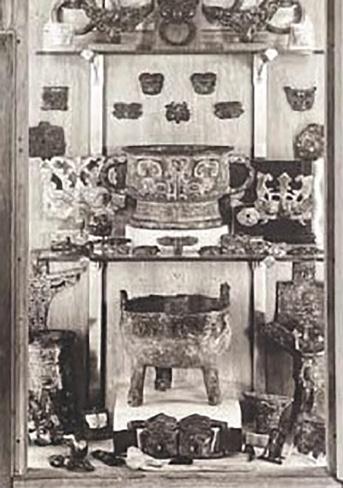
Inscriptions: A clan sign is finely cast to the interior of the base. This sign resembles those on several vessels from Fu Hao’s tomb (see Beijing 1980f., pl. 48), and also several vessels from Anyang, all dating from the 13th century. In more complete forms of this same sign, the yaxing frames a graph recognizable as the name of a diviner from Wu Ding’s reign.
Provenance: The present lot was part of an important collection of archaic Chinese bronzes, built by three generations of the Chasseloupe-Laubat family in France. Prosper de Chasseloup-Laubat (1805-1873), was a prominent aristocrat, politician, and art collector who became Minister of the French Navy and the Colonies under Napoleon III, traveling extensively through all of Asia. His son Louis (1863-1954), an engineer in ship design, significantly expanded the family collection, also during his frequent travels throughout Asia. François (1904-1968), Prosper’s grandson, eventually inherited the family passion and became a renowned explorer and participant in the Hoggar Expedition. He was the first French explorer to reach English Malaysia, bringing back previously unpublished documents on the isolated Sakai tribes. As a collector, François Chasseloupe-Laubat was advised by Jean Claude Moreau-Gobard, an important French collector and dealer specializing in Asian art. Condition: Very good condition, commensurate with age, with ancient wear and expected casting flaws. Some traces of weathering, corrosion, minor dents and losses, shallow surface scratches. The solid, naturally grown patina has distinct malachite and cuprite encrustations.
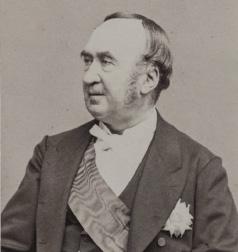
Weight: 983.7 g
Dimensions: Height 14.5 cm
Expert’s note: On this elliptical zhi wine cup, the designing artisans went to great lengths to vary the motifs of the low-relief decoration found in the six horizontal registers on each side, which vary significantly, and yet as a group achieve superb stylistic harmony. The three pairs of mythical beasts differ in the treatment of their wings, horns, eyes and other features, and
LITERATURE COMPARISON
Compare a related bronze zhi with similarly stylized birds, 12.1 cm high, dated 10th century BC, in the National Museum of Asian Art, Smithsonian Institution, accession number F1919.6. Compare a closely related bronze zhi with similar decorations, 14.6 cm high, dated to the late 11th century BC, in the Metropolitan Museum of Art, accession number 24.72.6 (fig. 1). fig. 1
AUCTION RESULT COMPARISON
Type: Closely related
Auction: Christie’s New York, 22 March 2019, lot 1503
Price: USD 300,000 or approx. EUR 332,000 converted and adjusted for inflation at the time of writing
Description: The Peng Zhou Zhi, a rare small bronze ritual wine vessel, late Shang dynasty
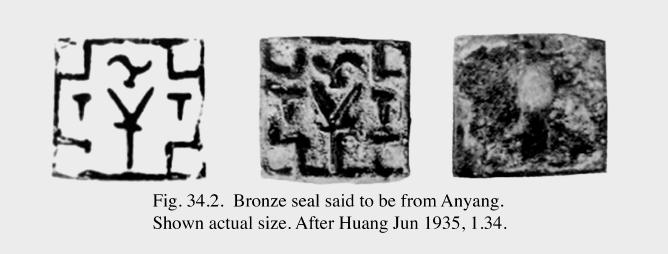
Expert remark: Compare the related form, albeit lacking flanges, as well as the closely related manner of casting, decorations with similar taotie and stylized bird designs, and patina with similar malachite encrustation. Note the related size (13.8 cm).
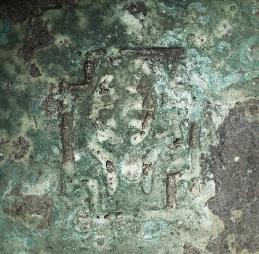
AUCTION RESULT COMPARISON
Type: Related
Auction: Christie’s New York, 23 March 2012, lot 1504
Price: USD 290,500 or approx. EUR 357,000 converted and adjusted for inflation at the time of writing
Description: A rare and finely cast bronze ritual wine vessel, zhi, late Shang dynasty, 12th11th century BC
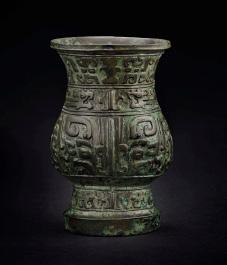
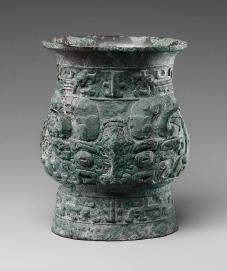
An
Expert remark: Compare the related form with similar flanges, albeit with a slightly broader body, and patina with similar malachite encrustation. Note the size (11.2 cm).
Estimate EUR 60,000
Starting price EUR 30,000
212 142
Three related bronze seals said to be from Anyang, illustrated in Robert W. Bagley’s Shang Ritual Bronzes in the Arthur M. Sackler Collections, 1987, pp. 245, fig. 34.2
Prosper de ChasseloupLaubat (1805-1873)
the varying distance between them, whereas the central taotie mask with its prominently raised eyes beautifully echoes the outline of the vessel, which has its widest part in the lower third.
old photograph of part of the Chasseloup-Laubat family collection, from when it was in the possession of Prosper ChasseloupLaubat’s grandson François (19041968), including the present lot
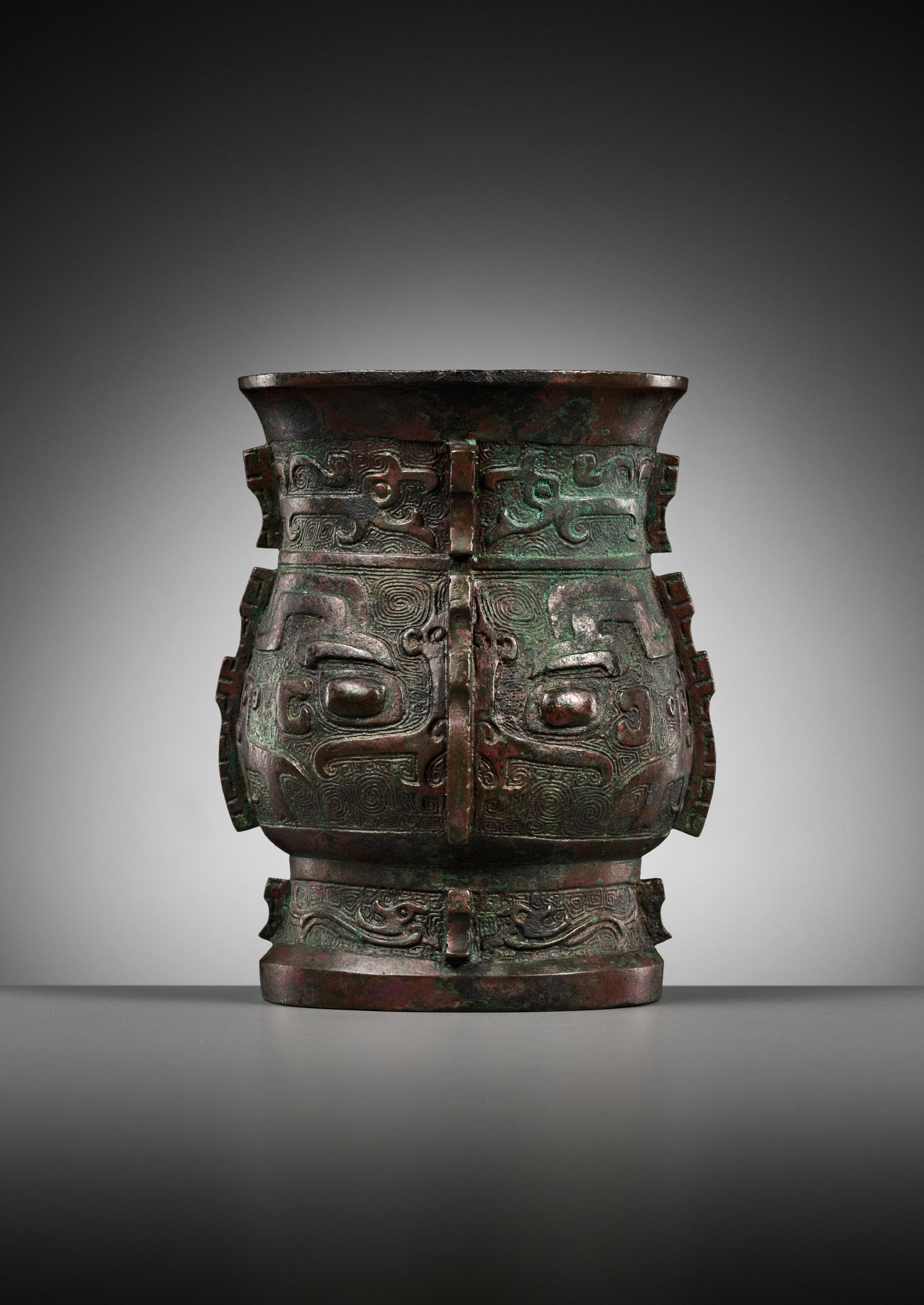
A LARGE INSCRIBED BRONZE RITUAL FOOD VESSEL AND COVER, DING, SPRING AND AUTUMN PERIOD
Inscriptions: A twelve-character inscription in Jinwen is neatly incised into a circumferential band on the cover, divided in three groups of four characters each, separated by one of the three recumbent mythical beasts sitting on top of the cover. The second character is ‘ding’, which means ‘to sacrifice’. It was originally developed from oracle bones and normally depicts a bowl shaped vessel on legs with two upright handles. On the present lot, there is a sacrifice depicted inside the ding. For reference, see Childs-Johnson, Elizabeth, Big Ding and China Power: Divine Authority and Legitimacy, Asian Perspectives, vol. 51, no. 2, 2012, pages 164–220. The third and eleventh characters both contain the symbol for tree or wood. When combined with other symbols, such as in this case, they can have different meanings like ‘season’ or ‘food’. Wood can even be seen as ‘roots’, as in ancestral heritage. The first character is referring to a village area, most likely the original location of this vessel.
China, 6th century BC. Superbly cast, the tripod body supported on three tall cabriole legs, flanked by angular U-shaped, upright handles, below the domed cover surmounted by three horned mythical beasts. The sides of the deep vessel flat-cast with two wide bands of tightly interlaced dragons, repeated on the handles and on the cover, which is further decorated with zoomorphic bands and a central medallion enclosing a feline creature with a sinuous scaly body.
Provenance: From an old private collection in Los Angeles, California, USA, and thence by descent within the same family.
Condition: Remarkably well preserved, commensurate with age. Old wear, expected casting flaws, dents and nicks, signs of weathering and erosion, soil encrustations. Minor fatigue cracks and losses. The bronze with a spectacular, rich, and naturally grown patina with distinct malachite, cuprite, and azurite encrustations.
Weight: 4,728 g
Dimensions: Width 34.3 cm (across handles)
Expert’s note: Ding vessels were first cast by the Shang and were undoubtedly an important Chinese bronze vessel. Used originally as cauldrons to cook food, the tripod vessel could easily be set above an open fire. The earliest examples of Ding were found in Zhengzhou and date from the end of the 15th century BC. During the Spring and Autumn period, ding started being cast with a cover, often equipped with a set of rings for easier removal. The recumbent mythical beasts on the cover of the present lot have the same function, but are much rarer and hence also serve as evidence of the high status of the original owner of this particular ding.
Literature comparison: Compare a related bronze ding, with similar bands of flat-cast decoration and with a similar feline with granulated body occupying the central medallion on the cover, 24.3 cm high, dated to the mid-Spring and Autumn period, illustrated by Jenny So in Eastern Zhou Ritual Bronzes from the Arthur M. Sackler Collections, 1995, pp. 127, no. 12, where the author also illustrates a 6th century BC ding and cover from Shanxi Houma Shanguacun M13, p. 129, Fig. 12.1, which shares a similar shape, legs and decorative bands. Compare a related bronze ding, 17.8 cm high, dated to Eastern Zhou dynasty, 5th-4th century BC, in the Metropolitan Museum of Art, accession number 49.135.1a.b. Compare a related bronze ding, 38.5 cm high, dated ca. late 6th to early 5th century BC, in the National Museum of Asian Art, Smithsonian Institution, accession number F1947.20a-b. Compare two related bronze ding vessels dated to the Spring and Autumn period in the Palace Museum, Beijing, accession numbers Xin00086998 and Xin00074731.
Scientific Analysis Report: A thermoluminescence analysis report issued by Artemis Testing Lab on 23 February 2018, based on sample number 131703, sets the firing date of two samples taken at about 3500 years ago. A copy of the report accompanies this lot.

AUCTION RESULT COMPARISON
Type: Related
Auction: Bonhams Hong Kong, 24 Novermber 2013, lot 468
Price: HKD 812,500 or approx. EUR 120,000 converted and adjusted for inflation at the time of writing
Description: An inscribed archaic bronze tripod incense burner and cover, ding, Eastern Zhou dynasty

Expert remark: Compare the related ding form and flat-cast decoration with similar interlaced dragons. Note mythical beasts and the slightly smaller size (height 26.7 cm).
AUCTION RESULT COMPARISON
Type: Related
Auction: Christie’s New York, 22 March 2013, lot 1232
Price: USD 109,350 or approx. EUR 128,000 converted and adjusted for inflation at the time of writing
Description: A bronze ritual tripod food vessel and cover, ding, Spring and Autumn period, 6th century BC

Expert remark: Compare the related form, flat-cast decoration, and animal-form handles on the cover. Note the much smaller size (18 cm).
Estimate EUR 40,000
Starting price EUR 20,000
214
143
The second character ‚Ding‘

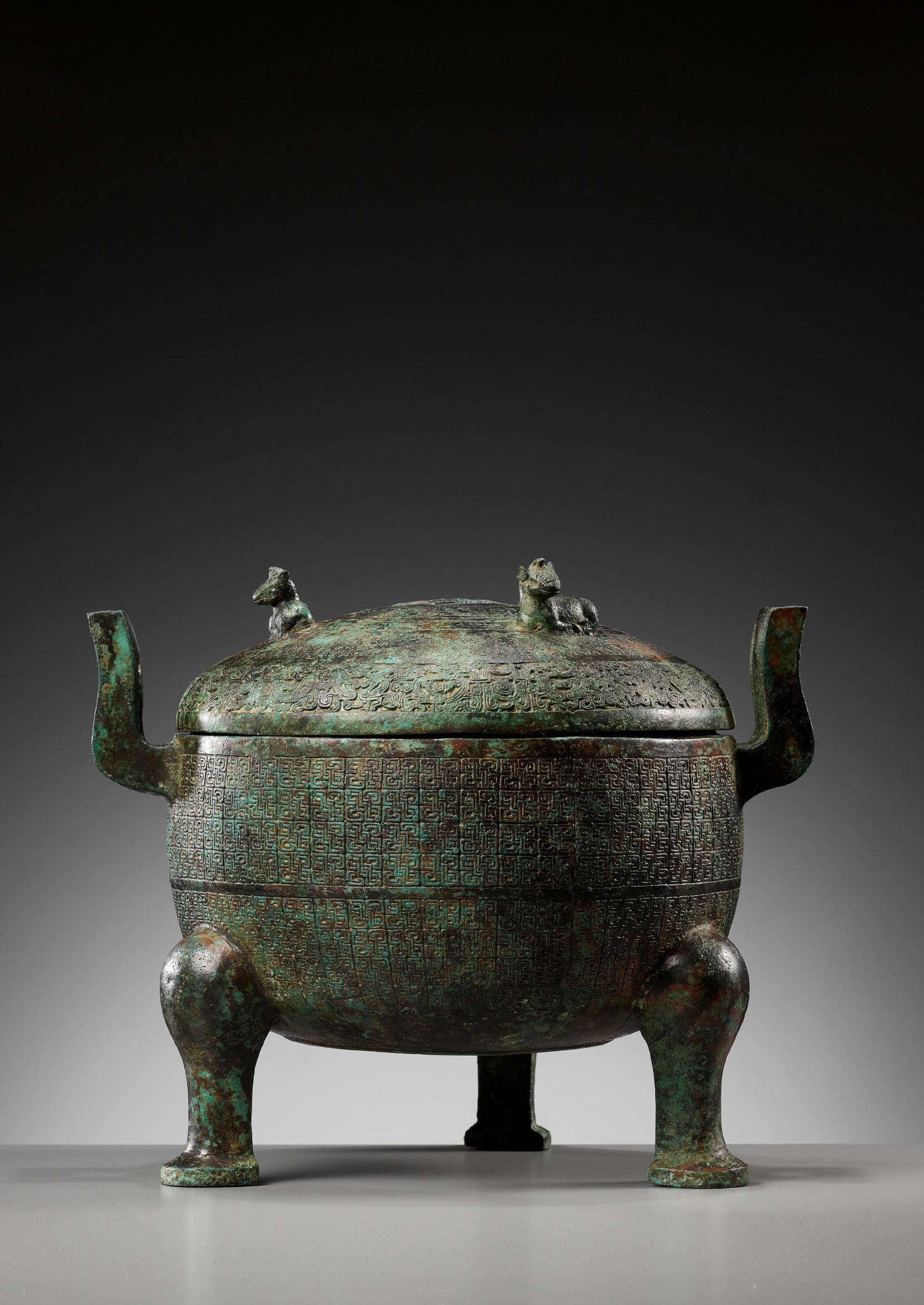
144
A
China, 206 BC-220 AD. Each finely cast and modeled in a recumbent pose with the head raised in a menacing attitude marked by an open mouth showing sharp teeth. The feline’s faces detailed with a broad snout below wide eyes and short ears, their facial features and stripes finely gilt and inlaid with silver. The smoothly finished bronze with a rich, naturally grown patina with malachite and cuprite encrustations.
(2)
Provenance: From the collection of Joseph Rondina, New York, United States, acquired before 2000. Joseph Rondina (1927-2022) was born into a first-generation Florentine-American family in Auburn, upstate New York. Returning to the U.S. after being stationed in Berlin at the end of the Second World War, he studied at the Whitman School of Design before opening Joseph Rondina Antiques on Madison Avenue in Manhattan’s Upper East Side in 1957. In the beginning, his interests focused primarily on European 18th-century decorative arts and furniture, over time developing to include Chinese, Korean, Indian, Thai, Cambodian, Persian and Japanese art, bringing a more esoteric and exotic style to the market. His clientele included stars of the stage and screen, royalty, notables, dignitaries, and denizens of the social register from the United States and abroad. Condition: Very good condition, commensurate with age. Wear, casting flaws, signs of weathering and erosion, corrosion, encrustations, nicks, scratches, losses. The ancient bitumen filling normally found inside such weights is lost.

Weight: 161 g and 140 g
Dimensions: Length 5.8 cm (each)
Weights of this type were used to hold down the corners of woven mats used for seating or for the board game liubo. Inlaid animal-form weights were also discovered in the tomb of Dou Wan, consort of Liu Sheng, Prince Jing of Zhongshan (d. 113 BC), alongside food and wine vessels. They were usually made in the shape of animals, often coiled to form a circle, or in the shape of human figures, and even mountains. Usually made of bronze, and often sumptuously decorated in gilding, or inlaid with gold, silver and gemstones, these weights conveyed the high social status of its owner.
The tiger is one of the oldest and most revered animals in Chinese history. According to Han mythology, the tiger symbolized the Western cardinal point, and in conjunction with the Green Dragon of the West, Vermilion Bird of the South and Black Tortoise of the North, positioned the burial within the spatial-temporal features of the universe. It is possible that tigers were deemed to protect the tomb occupant against the malign influences they may encounter in their afterlife.
Literature comparison: A related coiled feline shape can be seen in a pair of gilt-bronze weights, and in a set of four agate weights, all dated Western Han dynasty, illustrated by M. Wang et al., in the exhibition catalog, A Bronze Menagerie: Mat Weights of Early China, Isabella Stewart Gardner Museum, Boston, 2006, pp. 76-7, nos. 1 and 2. See related excavated examples of bronze recumbent tiger paperweights, in the Shenmu County Museum, illustrated in Bronzes from Northern Shaanxi, Vol. V, Chengdu, 2009, p. 964-966. Two tiger-shaped weights were also exhibited in the Biennale Des Antiquaries, illustrated by C. Deydier, Ancient Chinese Bronzes, Paris, 2014, p. 49.
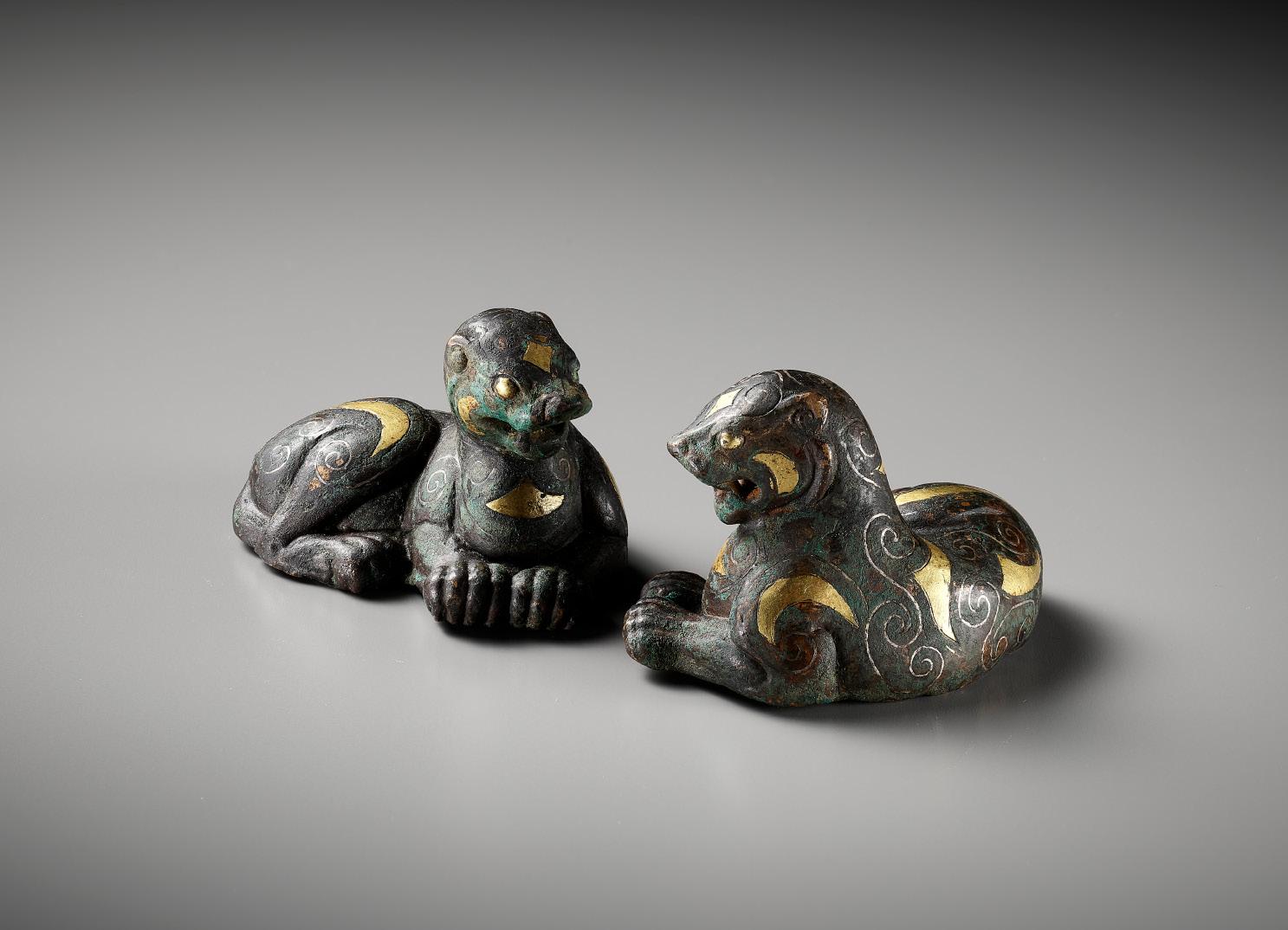
AUCTION RESULT COMPARISON
Type: Related
Auction: Sotheby’s Hong Kong, 9 October 2022, lot 145
Price: HKD 176,400 or approx. EUR 21,000 converted and adjusted for inflation at the time of writing
Description: A silver-inlaid bronze ‘tiger’ weight, Han dynasty
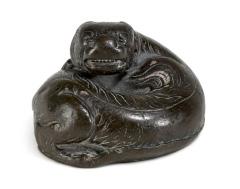
Expert remark: Compare the related pose, manner of casting, and inlaid decoration. Note the size (7 cm) and that this result is for a single weight only.
Estimate EUR 6,000
Starting price EUR 3,000
217
PAIR OF SILVER- AND GOLD-INLAID BRONZE ‘TIGER’ WEIGHTS, HAN DYNASTY
Joseph Rondina standing at the entrance of his store on Madison Avenue, ca. 1960
A COPPER-INLAID BRONZE RITUAL WINE VESSEL AND COVER, HU, EASTERN ZHOU DYNASTY
To properly evaluate the current lot, it is essential to compare it with the related examples found in the Fogg Art Museum and the Metropolitan Museum of Art (see literature comparison). These institutions possess vessels attributed to significant tombs in the vicinity of Huixian. These vessels share several identical pictorial elements with the present lot, as illustrated in the accompanying diagram. These pictorial elements also serve as a basis for dating the current lot, as referenced in fig. 70 of Weber’s work, where the sinuous feline pictograms suggest a manufacture date of 500 B.C.
Furthermore, page 151 of Weber’s work highlights a pertinent observation. During the late Zhou period, pictorial decoration on these types of vessels was arranged irrespective of the placement of handles. Consequently, handles were often affixed over a portion of the pictorial representations, partially covering the design. This alignment further strengthens the connection of the present lot to the published examples, suggesting that it is not only closely related, originating from the same period and region, but also having a strong possibility of it originating from a neighboring site

China, late 6th-early 5th century BC. Superbly cast, the globular body supported on a tall spreading foot and rising to a waisted neck with a flared mouth, the shoulder set with two small lug handles. The body is finely inlaid with copper in five registers depicting geometrically arranged designs of pairs of birds, felines, and deer within lozenge borders which also encircle the foot, the body further interspersed by elaborate ruyi-like designs, the mouth and rim of the cover with line borders. The similarly decorated domed cover surmounted by a loop finial. The vase has retained its original cover for well over two millennia, which makes it exceedingly rare
Provenance: From a noted private collection in Southern California, USA.
Condition: Excellent condition, commensurate with age. Extensive wear, signs of weathering and erosion, expected minor casting flaws, small nicks and losses, light scratches. Magnificent patina overall, the copper inlays naturally patinated to a distinct auburn color, the bronze with malachite encrustations and lustrous hues of cuprite.
Weight: 2,496 g
Dimensions: Height 34 cm
LITERATURE COMPARISON
Compare a related copper-inlaid bronze hu, 43 cm high, dated to the Warring States period, in the Fogg Art Museum, Harvard Art Museums, object number 1943.52.121.A-B. Compare a related related copper-inlaid bronze hu, lacking the cover, 44.5 cm high, dated ca. 5th century BC, in the Metropolitan Museum of Art, accession number 29.100.545 (fig. 1) Compare also a related copper-inlaid bronze hu, lacking the cover, 44.7 cm high, dated to the Warring States period, in the Art Institute of Chicago, reference number 1928.143. A similar hu is illustrated by J. So, Eastern Zhou Ritual Bronzes from the Arthur M. Sackler Collections, 1995, vol. III, no. 44, where the author, p. 257, describes how the motifs ‘were first cast in copper, then inserted into the mold and held in place with spacers’. This technique was more effective in keeping the copper decoration in place than the more conventional method of hammering the copper into cast or incised depressions. Another similarly decorated hu lacking cover is in the museum collection of Fujii Yurinkan Museum, Kyoto, where it is registered as an Important Art Object by the Japanese government. Another hu with a cover was included in the exhibition Chinese Archaic Bronzes, Sculpture and Works of Art, J. J. Lally & Co., New York, June 1992, no. 24.
fig. 1
Expert’s note: For further research and a comparative analysis with published examples in major institutions, see Charles D. Weber, Chinese Pictorial Bronze Vessels of the Late Chou Period. Part III, published in Artibus Asiae, volume 29, number 2/3, 1967, pages 115-192. In this publication, the author provides a comprehensive analysis of pictorial bronze vessels from the late Zhou period and suggests that this type of decoration originated from Huixian, Henan province, from the 6th into the early 5th century BC.
AUCTION RESULT COMPARISON
Type: Closely related
Auction: Christie’s, New York, 21 March 2002, lot 70
Price: USD 23,500 or approx. EUR 36,500 adjusted for inflation at the time of writing
Description: A rare copper-inlaid bronze wine jar, hu, Eastern Zhou dynasty, late 6th-early 5th century BC
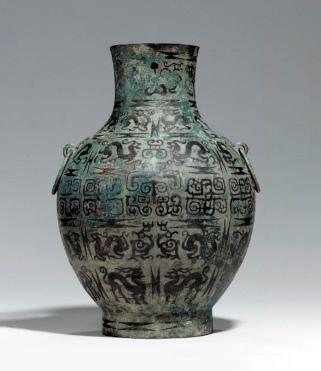
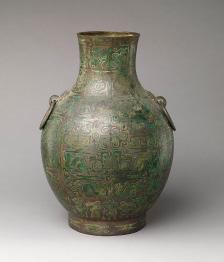
Expert remark: Compare the closely related form and inlays. Note the size (39.7 cm).
Estimate EUR 15,000
Starting price EUR 7,500
218 145
Compare the identical pictorial elements of the present lot and the Fogg Art Museum hu.

A RARE TURQUOISE-INLAID BRONZE MIRROR, WARRING STATES PERIOD
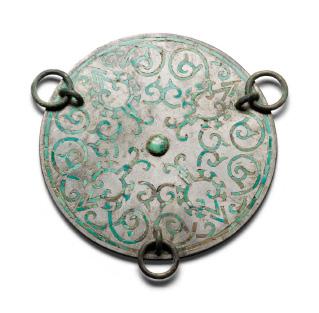
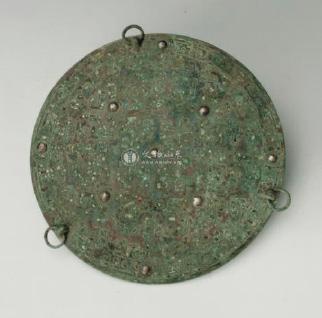
China, 475-221 BC. Finely cast, the back of the circular mirror intricately inlaid in turquoise with intertwined stylized dragons arranged in a grid-like structure interspersed by circular recesses and encircled by a band of similarly stylized beasts. The mirror is cast with three loops suspending loose and massive bronze rings.
Provenance: A private collection in Northern Thailand. Het Magazijn, Ghent, Belgium, September 2006. The private collection of Mr. and Mrs. S., Ghent, Belgium, acquired from the above and thence by descent in the family. A copy of a signed authentication certificate from Het Magazijn, including two photographs of the present lot, and confirming the provenance and dating above, accompanies this lot. Condition: Good condition, commensurate with age. Extensive wear, signs of weathering and erosion, losses, nicks, scratches. The bronze is covered in a rich, naturally grown patina with fine malachite encrustation. Displaying spectacularly well overall.
Weight: 1,926 g
Dimensions: Diameter 29.9 cm
Expert’s note: Unlike most mirrors of Warring States and Tang Dynasty date, which have a central loop or knob for the attachment of a cord, this mirror - and others like it - have loops at the outer edge, which are thought to have been used for suspending it. Fragments of stone left within one of the eight circular recesses suggest this mirror was once additionally inlaid with precious stones which are now lost. This suggests a high degree of importance surrounding this mirror as all other comparisons have simple bronze knobs cast as one piece rather than gemstone inlays.
LITERATURE COMPARISON
Compare a closely related turquoiseinlaid mirror, also with three rings, excavated at Linzi (a city of the Qi state), Shandong province, dated to the Warring States period, in the Shandong Museum, illustrated in Zhongguo Qingtongqi Quanji (‘Complete Collection of Chinese Bronzes’) - 16 - Bronze Mirrors, Beijing, 1998, p. 32, no. 32; and by Thomas Lawton, Chinese Art of the Warring States Period: Change and Continuity, 480-222 BC, Freer Gallery of Art, 1982, p. 81, where it is noted that other mirrors with suspension loops at the rim were excavated from a tomb at Shiertai, Chaoyang county, Liaoning province. A turquoise-inlaid bronze mirror found in 1965 in a Western Han tomb at the Sanlidun site in Lianshui county, Jiangsu province, was unearthed with a bronze figure of a recumbent deer, suggesting that the mirror might have been suspended by two of the rings from the antlers. For illustrations of the deer and mirror see Ancient Bronze Mirrors from the Shanghai Museum, Shanghai, 2005, p. 59, fig. 13.
AUCTION RESULT COMPARISON
Type: Closely related
Auction: Christie’s Hong Kong, 4 Oct 2018, lot 73
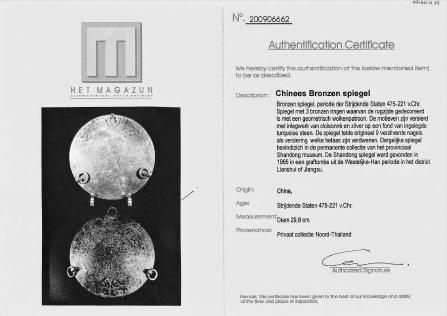
Price: HKD 175,000 or approx. EUR 24,500 converted and adjusted for inflation at the time of writing
Description: A rare small turquoiseinlaid silvery bronze circular mirror with rings, Warring States period (475-221)
Expert remark: Compare the identical form with three loose rings and similar decoration with similar turquoise inlays. Note the much smaller size (9 cm)
Estimate EUR 12,000
Starting price EUR 6,000
220 146


A BRONZE ‘TIGER’ HALBERD BLADE, ZHONGHU GE, EASTERN ZHOU DYNASTY, WARRING STATES PERIOD

Published: Religion and Ritual in Chinese Art, Michael B. Weisbrod, Inc., New York, USA, 8 December 1987, no. 12, page 40.

China, 480-220 BC. Finely worked with an elongated triangular blade (yuan) flaring gently into the flat blade guard. Cast in relief with the profile of the ferocious feline with a gaping mouth, baring fangs and an extended long curling tongue, all in high relief. The ears and forelimbs bent with the body incised on the shank. The end of the yuan pierced with two rectangular chuan (apertures), the tang (nei) with a circular chuan. A rectangular tang with foliate incisions projects from the guard ending in a double curve ‘E’-shaped edge.
Provenance: Michael B. Weisbrod, New York, USA. The private collection of an American north-east collector, acquired from the above, c. 1987-1988. Michael B. Weisbrod is a noted scholar of Chinese art, who has published extensively on the subject over a time span of more than 50 years. In 1972, Michael joined his father Dr. Gerald Weisbrod’s Asian art gallery in Toronto, Canada. The father-and-son team opened their New York location on Madison Avenue in 1977, and during the next 45 years the gallery held a significant number of exhibitions, selling to museums and private collectors across the globe, eventually adding further locations in Shanghai and Hong Kong.
Condition: Very good condition, commensurate with age. Extensive wear, weathering and erosion, nicks and cracks, shallow surface scratches, possibly minor old fills. Fine, solid patina with distinct malachite and cuprite encrustations. Presenting remarkably well overall.
Weight: 396.4 g (excl. stand)
Dimensions: Length 27.4 cm
With a modern stand. (2)
The ge dagger-axe was found in burials from the early Shang through the Warring States period. It came to be a ritual object and a part of the requisite ceremonial paraphernalia of a courtier. According to James Menzies, by the early Western Zhou, ‘its inclusion in the attire of nobles and officials at all formal functions may be presumed’; and in addition to other Shang and Western Zhou rituals, it may have been used in ceremonial war dance, celebrating the Zhou conquest of the Shang (Menzies, the Shang Ko, pp. 314-316). The ge was also frequently pictured on bronze vessels possibly as a clan emblem.
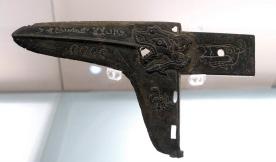
Although the tiger appears on blades of the late Shang and early Western Zhou periods, the feline and the shape of the tang on the present lot indicate a product of a different culture. Manufacture of ge with triangular blades discontinued in the Central Plains area of China by the middle Western Zhou period. The type seems to have persisted in the kingdoms of Ba and Shu in modern Sichuan province through the Warring States period. Many of these excavated ge from this area have E-shaped tang which did not appear among the Shang or Western Zhou blades. Tigers are frequently seen as motifs on the various types of ge and other weapons of the Ba-Shu area. This may be related to the legend that when Lin Jun, first ancestor of the Ba tribe, died, his soul was transformed into a white tiger
LITERATURE COMPARISON
Compare profile tigers similar to this lot which are reproduced in Tong Enzheng’s ‘Investigations of the bronze ge from Southwest China’ (Kaogu Xuebao 1979, no. 4, pp. 442, fig. 1:6, pp. 447, fig. 3; see also Wenwu 1976 no. 3, p. 41 fig.2 and pl. I, no. 6; Wenwu 1976 no. 7, p. 82-85; Kaogu 1986 no. 11, pp. 986, fig. 6). Compare with a Zhonghu Ge with tiger pattern, China, unearthed at Dubaishu, Pixian County, Chengdu City, Warring States period, 475221 BC, bronze Sichuan Provincial Museum Chengdu, China, accession number DSC04243 (fig. 1).
fig. 1
Estimate EUR 6,000
Starting price EUR 3,000
223
147
Michael B. Weisbrod
A LARGE BRONZE RITUAL WINE VESSEL, HU, HAN DYNASTY
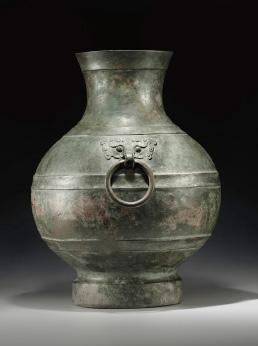
China, 206 BC-220 AD. Finely cast. The broad pear-shaped body raised on a pedestal foot with gently spreading sides below an indented waist, the sides encircled by three slightly raised bands and with a prominent pair of taotie masks suspending massive loose rings on the shoulder, the waisted neck rising to a slightly raised band below the rim. The interior with a distinct casting mark.
Provenance: Michael Goedhuis, May 1993. A private collection in in France, acquired from the above. A copy of the original invoice, dated 10 May 1993, confirming the dating above, and stating a “special price” for the present lot of GBP 8,900 or approx. EUR 28,000 (converted and adjusted for inflation at the time of writing), accompanies this lot. Michael Goedhuis trained as an economist, graduating with an MBA from the Courtauld Institute in Art History. He started a successful career in investment banking in New York and London, only to leave it in 1975 to pursue his passion for art. He joined Jacob Rothschild’s Colnaghi Oriental Gallery specializing in Persian, Mughal, and Islamic art. It was here that he published a catalog focused entirely on the subject of post-archaic East Asian bronzes, a first in the field, authored by Ulrich Hausmann in 1989. Major collections were curated and sold by Mr. Goedhuis to numerous institutions including The Rothschild Collection to the Shahbanu of Iran, and the Vever Collection to the Smithsonian Institution. He subsequently expanded his activities to India, Japan, and China, concentrating on important antiquities. Today, Mr. Goedhuis continues to exhibit around the world, including in New York and Maastricht.

Condition: Very good condition, commensurate with age. Expected old wear, minor casting flaws, scratches, dents, soil encrustations, signs of weathering and corrosion. The bronze with a superb, naturally grown, rich patina with extensive malachite and cuprite encrustation.
Weight: 8,945 g
Dimensions: Height 44 cm
Literature comparison: Compare a closely related hu, of similar shape and also with bands encircling the body, excavated in 1968 from the tomb of Prince Liu Sheng who was the king of Zhongshan from 154 BC and died in 113 BC in Mancheng, Hebei province, illustrated in Zhongguo Wenwu Jinghua Daguan, Qingtongjuan, Hong Kong, 1994, no. 1100, p. 306. Compare a related hu vessel, dated to the Han dynasty, illustrated by Jessica Rawson in The Bella and P.P. Chiu Collection of Ancient Chinese Bronzes, 1998, pl. 38.
AUCTION RESULT COMPARISON
Type: Closely related
Auction: Christie’s New York, 18 March 2009, lot 217
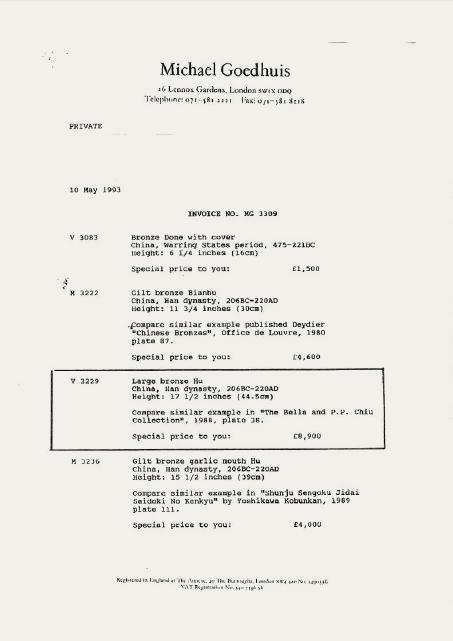
Price: USD 13,750 or approx. EUR 18,000 converted and adjusted for inflation at the time of writing
Description: A large bronze ritual wine vessel, hu, Western Han dynasty Expert remark: Compare closely related form, manner of casting, and decoration with similar bands and mask handles. Note the size (47 cm).
Estimate EUR 12,000
Starting price EUR 6,000
224 148
Michael Goedhuis
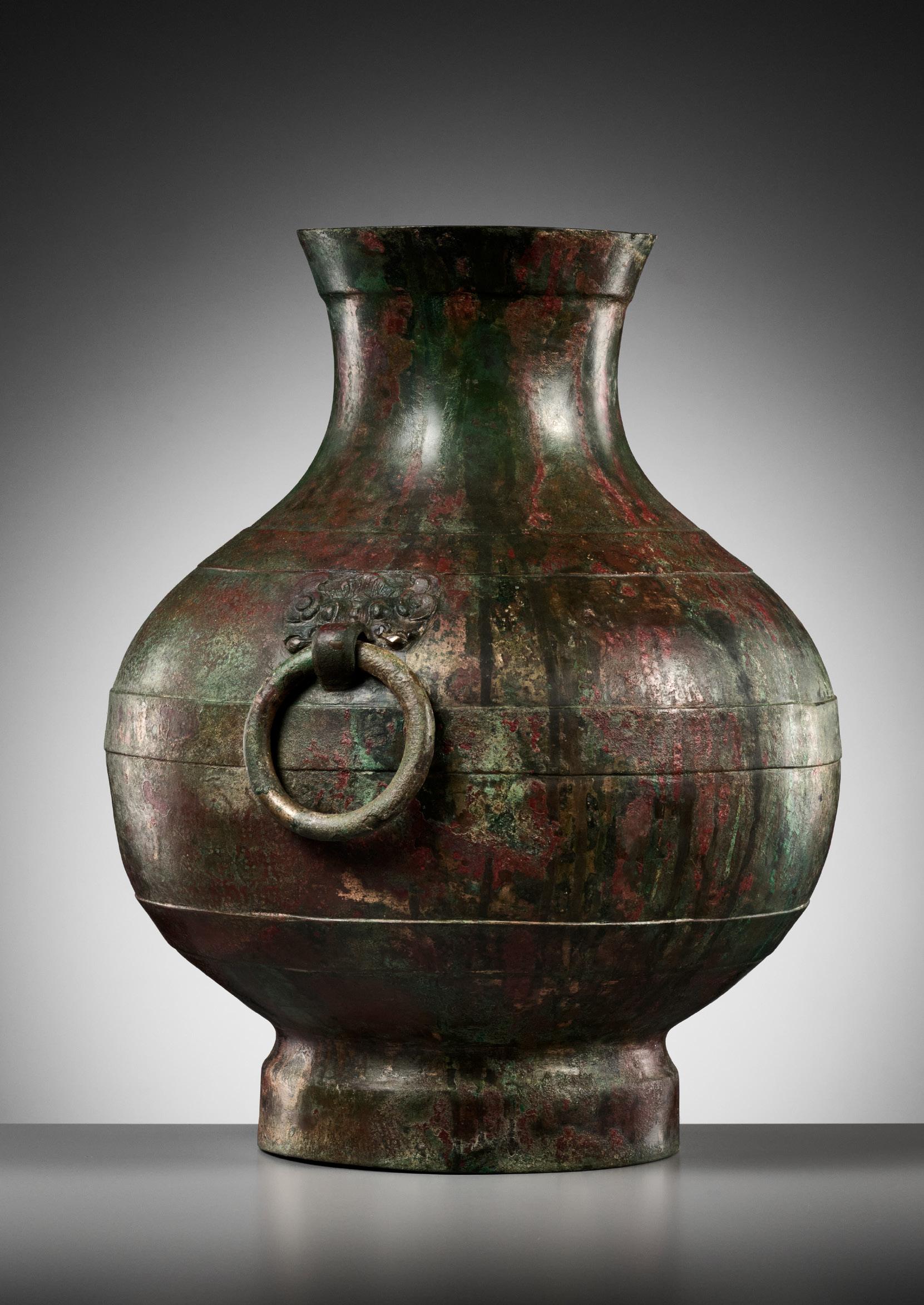
A ‘FOUR AUSPICIOUS BEASTS’ (SI XIANG) BRONZE BRAZIER, HAN DYNASTY, CHINA, 206 BC-220 AD
The upper section is finely cast in openwork relief and depicts the animal-spirits of the four cardinal directions, also called the ‘four auspicious beasts’: the Azure Dragon of the East (qinglong), the White Tiger of the West (bai hu), the Vermilion Bird of the South (zhuque), and the Tortoise entwined with a snake symbolizing the Dark Warrior of the North (xuanwu).
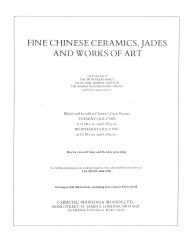
Provenance: An old private collection in the United Kingdom. Christie’s London, 6 July 1983, lot 108, sold for GBP 8,100 or approx. EUR 43,500 (converted and adjusted for inflation at the time of writing). Michael Michaels, acquired from the above, and thence by descent. Christie’s London, 7 November 2017, lot 170. A private collection in the United Kingdom, acquired from the above. A copy of the 1983 Christie’s catalog entry for the present lot with a handwritten note from Michael Michaels, confirming the purchase price listed above, accompanies this lot. Michael Michaels (1907-1986) was born in Magdeburg, Germany, fleeing to the United Kingdom in 1933 when the Nazis came to power in Germany. As a young refugee, Michaels worked at a raincoat factory until founding his own tent and camping equipment company in London with his wife Charlotte. With the success of his company, Michaels began to pursue his passion in antiquities, traveling the globe and visiting museums and archeological sites. During his time in London, Michaels spent countless hours in the British Museum, learning from Jessica Rawson and growing his understanding of the history and technology behind different material cultures. He assembled a very large and important collection of Chinese bronzes during his lifetime.
LITERATURE COMPARISON

Compare a closely related bronze brazier with the corresponding earcup, 24 cm long, dated to the Han dynasty, in the Art Institute of Chicago, accession number 1930.362.
An earcup would be placed atop this brazier, its oval form fitting perfectly on top of the four protrusions on the brazier’s rim. The main rectangular section is stepped and raised on four crouching humanoid supports, each neatly modeled, and has an openwork grate to the base. A flattened handle at one end curves up to a leaf-shaped terminal.
Weight: 725 g
Dimensions: Length 24.2 cm

At the heart of Chinese mythology are the four spiritual creatures, or four celestial emblems, Si Xiang, each of them being most closely associated with a cardinal direction and a color, but also additionally representing other aspects, including a season of the year, an emotion, a virtue, and one of the five Chinese elements. Each has been given its own individual traits, origin story and its reason for being. Depictions of mythological creatures clearly ancestral to the modern set have been found throughout China. Currently, the oldest known depiction was discovered in 1987 in a tomb in Xishuipo, Henan, which has been dated to approximately 5300 BC. In the tomb, labeled M45, mosaics made of clam shells and bones forming images closely resembling the Azure Dragon and White Tiger, respectively, were found.
AUCTION RESULT COMPARISON
Type: Closely related
Auction: Christie’s New York, 14 September 2012, lot 1252
Price: USD 11,875 or approx. EUR 14,500 converted and adjusted for inflation at the time of writing
Description: A small bronze openwork brazier, Eastern Han dynasty
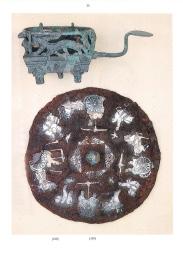
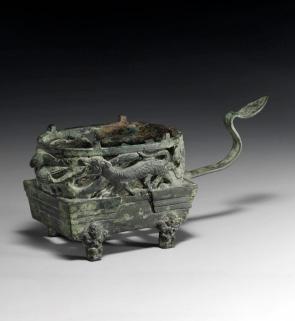
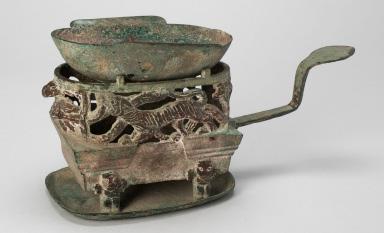
Condition: Superb condition, commensurate with age, with old wear and expected casting irregularities. Signs of weathering and erosion with minor losses, cracks and dents. The rich, naturally grown patina has fine malachite and azurite encrustations overall.
Expert remark: Note the closely related form and decoration. Note the size (23 cm).
Estimate EUR 10,000
Starting price EUR 5,000
226 149
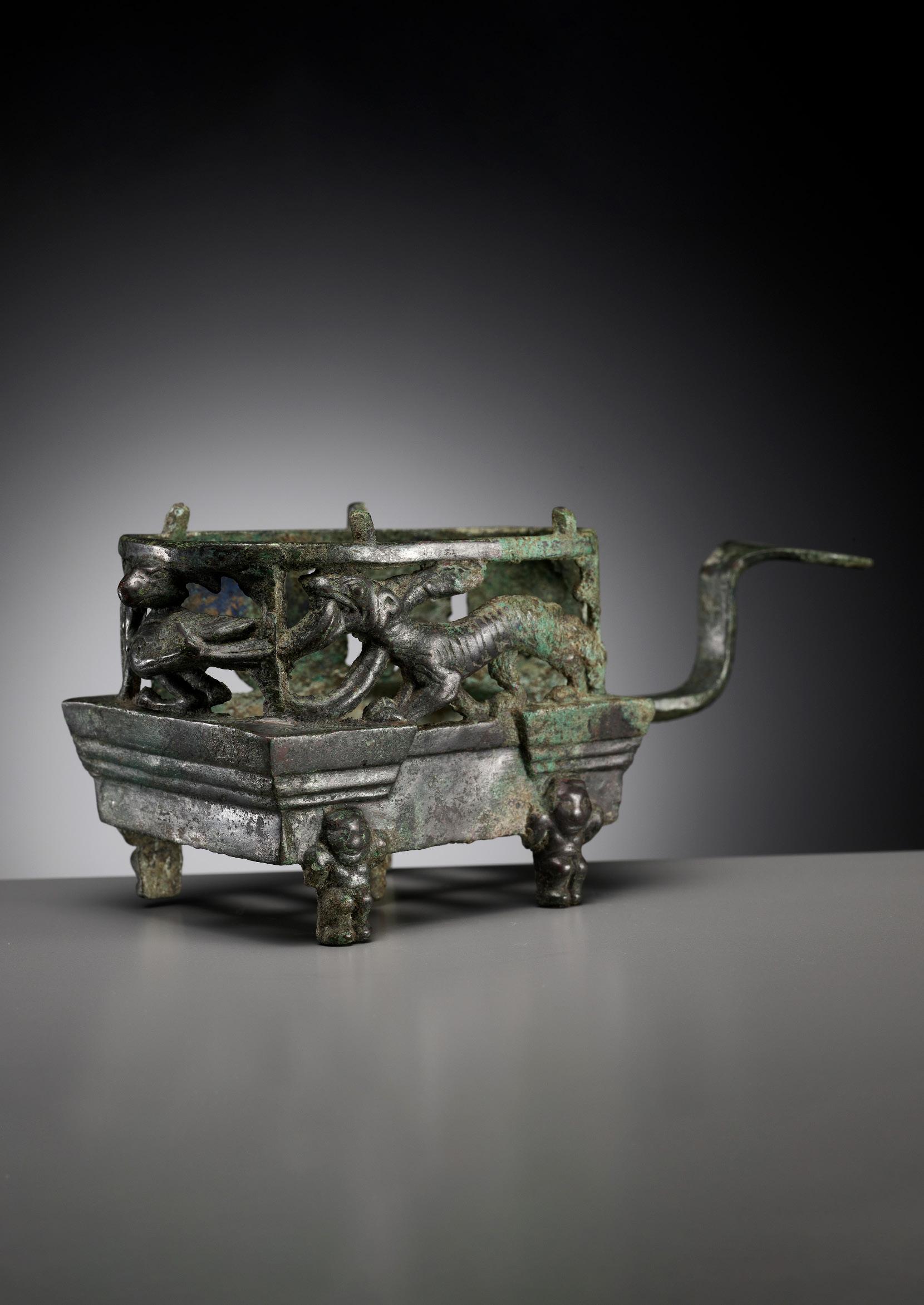

A GILT BRONZE ‘BEAR’ WEIGHT, HAN DYNASTY, EX ADOLPHE STOCLET COLLECTION
China, 206 BC-220 AD. Powerfully cast as a coiled front-facing bear with a menacing expression, its mouth wide open baring its sharp teeth, the round ears pricked up, the fur neatly incised and claws well detailed. The round weight with a small loop to the interior.

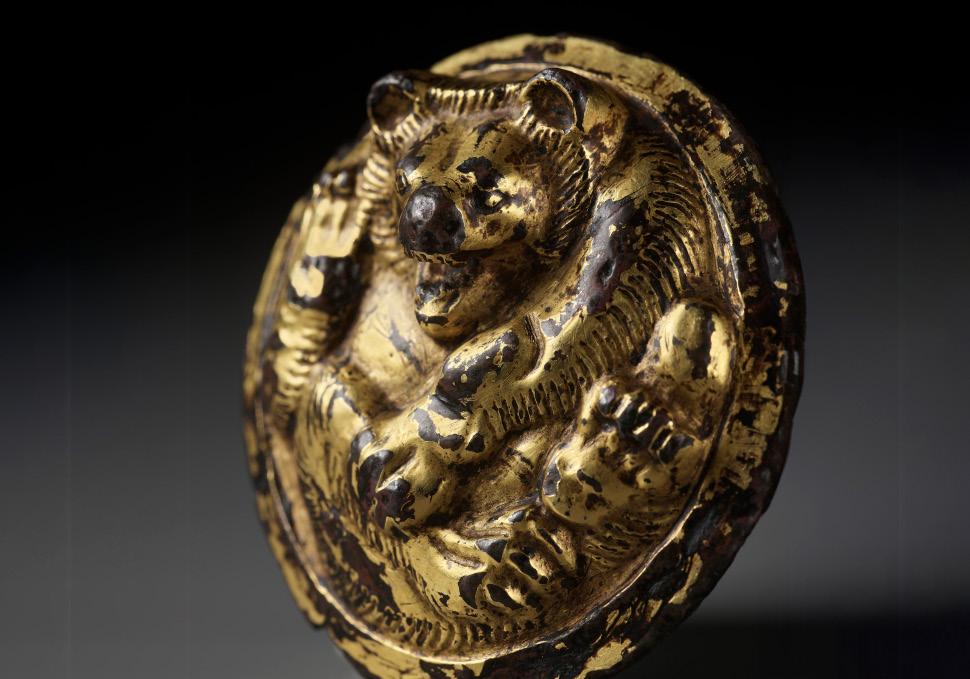
Provenance: From the collection of Adolphe Stoclet, and thence by descent in the Stoclet family. Adolphe Stoclet (1871-1949) was a Belgian engineer, financier, and noted collector. He was born into a family of Belgian bankers and became a director of the Société Générale de Belgique after his father’s death. He married Suzanne Stevens (1874-1960), the daughter of the art critic, historian, collector, and dealer Arthur Stevens (1825-1909) and niece of the painter Alfred Stevens (18231906). The Stoclets were connected with avant-garde art circles in Paris and Vienna, where they met Josef Hoffmann (1870-1956), who designed the Stoclet’s famous Palais in Brussels. Gustav Klimt (1862-1916) painted the murals in its dining room. The Palais Stoclet, today a UNESCO World Heritage site, was the lavish setting to one of the most important eclectic art collections of all times, which included Egyptian and Chinese sculpture, medieval Italian painting and metalwork, enamels and relics, as well as Byzantine and Pre-Columbian art.
Condition: Magnificent condition, commensurate with age. Old wear, minor nicks and scratches, rubbing to gilt. The lead or cement core to the interior has been removed. The bronze with a rich, naturally grown patina overall and scattered soil, malachite and cuprite encrustations.
Weight: 70.5 g
Dimensions: Diameter 5.5 cm

Expert’s note: The present lot once had a lead or cement core, enabling its usage as a weight. A small loop to the interior, designed to secure this core, is still in place. The removal of the core may indicate usage as an ornament at some point in its very long history.
Weights crafted from precious materials such as bronze and jade, often gilded or inlaid with gold, silver or gemstones, were produced in sets of four and served a practical function of anchoring down woven mats for seating. Mats and corner-weights were believed to have been used at banquets, even those laid out in tombs. Inlaid animal-form weights were discovered in the tomb of Dou Wan, consort of Liu Sheng, Prince Jing of Zhongshan (d. 113 BC), alongside food and wine vessels.
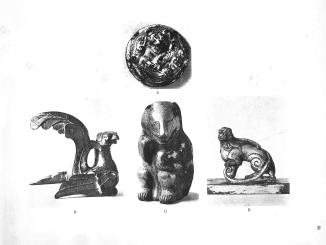
Article continues online at www.zacke.at
Estimate EUR 15,000
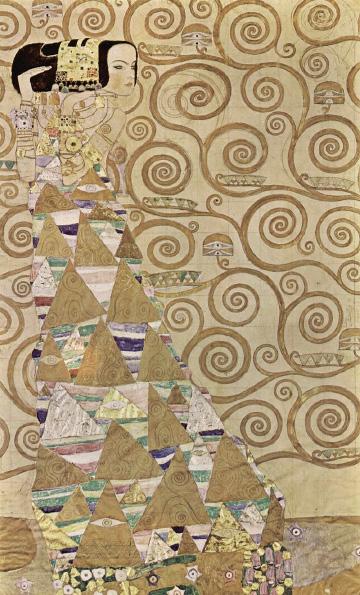
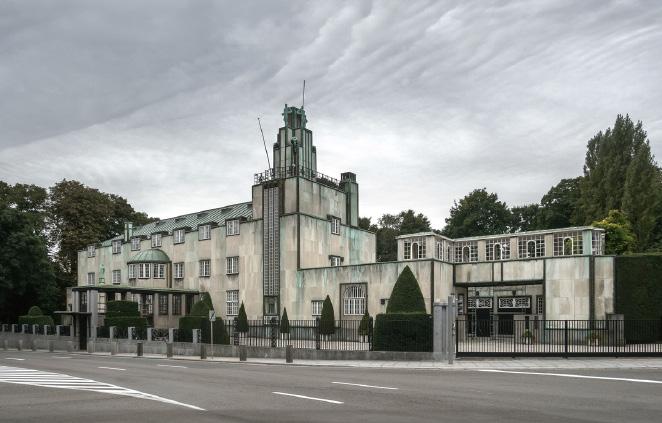
Starting price EUR 7,500
PUBLISHED
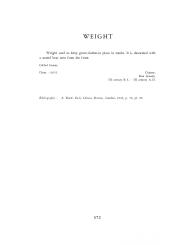
A. Koop, Early Chinese Bronzes, London, 1924, page 70, pl. 92. Georges A. Salles and Daisy Lion-Goldschmidt, Adolphe Stoclet Collection, Part I, Brussels, 1956, pages 372-373.



229 150
Gustav Klimt’s painting, ‘Die Erwartung,’ was commissioned by Stoclet for his palace in Brussels
Adolphe Stoclet commissioned Joseph Hoffmann to build the Palais Stoclet in Brussels, now a UNESCO World Heritage site
Adolphe (1871-1949) and Suzanne Stoclet (1874-1949)
A LARGE BRONZE MIRROR WITH A 37-CHARACTER INSCRIPTION, HAN DYNASTY, CHINA, 206 BC-220 AD
Inscriptions: ‘Yelian tonghua qing er ming, yi zhi weijing, yi wenzhang, changsheng yishou qu buxiang, yutian changjiu er riguang, qianwan sui xi leweiyang’ (The bronze mirror we made is clear and shiny. With such a mirror, you will be blessed with a long life, and it will ward off bad luck. We wish you a long life as long as heaven and earth, and eternal joy and happiness).
Expert’s note: Inscribed bronze mirrors with bullet proof provenance, such and extensive and detailed inscription, and in such excellent condition overall, must be considered as exceedingly rare.
The central knop rising from quatrefoil lotus petals, encircled by an eightpointed star, surrounded by ancient cult symbols and decorated with an outer band holding the 37-character inscription in high relief, all within a sawtooth border on the rim. The circular bronze with a rich, naturally grown patina with malachite and cuprite encrustations.
Provenance: Galerie Themis, Brussels, April 23, 1952 (according to an ancient family ledger inspected by Cabinet Portier, Paris, France, during their appraisal of the complete de Strycker estate; this ledger remains in the possession of the de Strycker family and may not be copied).
Collection of Robert and Isabelle de Strycker, acquired from the above and thence by descent in the same family. The obverse with two old labels, one reading ‘MBR no. 174 Epoque Han. 20630. Chine,’ and the accompanying display stand with two inscriptions on the reverse. Robert de Strycker (1903-1968) was a French engineer who specialized in metallurgy. He was a Stanford graduate, a professor at the University of Leuven, a director of the Institute of Metallurgy at the Université Catholique de Louvain, and one of the most influential members of the faculty of applied sciences. After World War II, he made large contributions to France’s post-war recovery. Robert and his wife Isabelle (1915-2010) first encountered Chinese art at the British Museum during a stay in London in the 1930s. Enamored with the style and beauty, they both decided to study and collect Chinese works of art. In 1938 they eventually began to build their collection, buying from Belgian, Parisian, and English dealers. They kept close contact with the famous English collector Sir Harry Garner (1891-1977) and noted Czech collector and expert Fritz Low-Beer (1906-1976). In 1964, the couple lent 174 objects from their collection to the Belgian city of Leuven’s museum for an exhibition titled Oude kunst in Leuvens Privébezit (‘Old Art in Private Collections in Leuven’), and in 1967, they lent around thirty Japanese objects to the Royal Museums of Art and History in Brussels for their exhibition Kunst van Japan im belgischen Privatverzameingen (‘Japanese Art in Belgian Private Collections’).
Condition: Superb condition with only minor old wear and some weathering, encrustations, scratches to the rim, and nicks, all exactly as expected from an ancient bronze mirror. Magnificent, naturally grown patina with fine cuprite and malachite encrustations.
Weight: 875.2 (excl. stand)
Dimensions: Diameter 18.4 cm
With a fitted wooden display stand wrapped in fabric, dating to around 1952. (2)
Literature comparison: Compare a closely related bronze mirror, 14 cm diameter, dated to 2nd-1st century BC, in the National Museum of Asian Art, Smithsonian Institution, accession number S 2012.9.1756. Compare a related bronze mirror, 13 cm diameter, dated 2nd-1st century BC, in the National Museum of Asian Art, Smithsonian Institution, accession number 2012.9.2103. Compare a closely related bronze mirror, 18.8 cm diameter, dated to the Han dynasty, in the British Museum, registration number 1957,1119.1.
AUCTION RESULT COMPARISON
Type: Closely related

Auction: Christie’s New York, 20 March 2015, lot 718
Price: USD 16,250 or approx. EUR 19,500 converted and adjusted for inflation at the time of writing
Description: A bronze circular mirror with inscription, late Western to early Eastern Han Dynasty
Expert remark: Note the nearidentical size (18.9 cm) and design, showing a different inscription.
AUCTION RESULT COMPARISON
Type: Related
Auction: Christie’s New York, 22 March 2012, lot 1425
Price: USD 122,500 or approx. EUR 152,000 converted and adjusted for inflation at the time of writing
Description: A silvery bronze circular mirror with inscription, Western Han dynasty
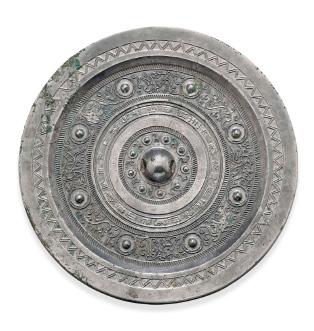
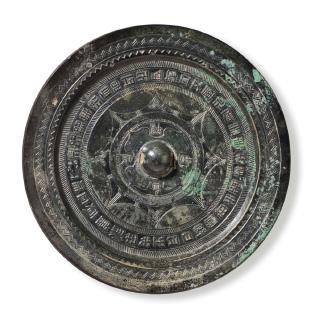
Expert remark: Note the size (19 cm).
Estimate EUR 8,000
Starting price EUR 4,000
230
151
Isabelle and Robert de Strycker, c. 1930-1935

152
A BRONZE DRUM, HAN DYNASTY


China, 202 BC-220 AD. The round instrument supported on a waisted base, the top and sides finely cast in relief with multiple concentric geometric designs including key-fret, triangles, and beads centered by a star design, with pairs of loop handles to either side. The drum produces a clear and distinct sound.
Provenance: From a private collection in Berlin, Germany. The interior of the drum has an old collector’s number written in faint phosphorescent paint, ’60.’
Condition: Good condition commensurate with age showing extensive wear and weathering, some casting flaws, old repairs, small losses, nicks, dents, and scratches. Fine, naturally grown patina with malachite encrustations. All as expected from a bronze drum with an age of roughly two millennia.
Weight: 15.1 kg
Dimensions: Height 29.5 cm, Diameter 53.3 cm
Expert’s note: Bronze drums such as the present lot are a percussion instrument used by various ethnic groups from the southwest of China. They were popular in Yunnan, Guizhou, Sichuan and Hunan Provinces, among which Yunnan and Guangxi have the largest numbers recorded. Both provinces share a border with Vietnam, home to the Dong Son culture, which in turn is well known for its own drums. Applied to sacrifice rituals, the drums were usually used to play music or accompany dance rites.
The Yunnan Provincial Museum in Kunming houses an important collection of early bronze drums (Warring States through Western Han period) that were excavated from royal burials at Shizhai Shan and other locations in the vicinity of Lake Dian. This part of Yunnan, whose people and language were not originally Han Chinese, had been ruled by the independent Dian kingdom from about 500 BC. Bronzes from this period through the middle Western Han Dynasty (about 100 BC) are unique to the region and share many characteristics with bronze artifacts of Southeast Asia. Their decoration was also influenced by artistic styles of the Eurasian steppe.
After surrendering to Han Wudi in 109 BC, the Dian kingdom was administered as a frontier commandery of the Han empire. Dian kings were retained as local rulers. From then on, the distinctive Dian regional bronzes were gradually replaced by Han-style bronzes, by the type of cultural assimilation that is called “Sinification” (literally, “becoming Chinese”) by Chinese historians.
LITERATURE COMPARISON
Compare a closely related but smaller drum in The Complete Collection of Treasures of the Palace Museum, Bronze Articles for Daily Use, Beijing 2007, number 78.
AUCTION RESULT COMPARISON
Type: Closely related
Auction: Galerie Zacke, Vienna, 29 September 2022, lot 265
Price: EUR 7,800 or approx. EUR 8,500 adjusted for inflation at the time of writing
Description: A bronze drum, Han dynasty
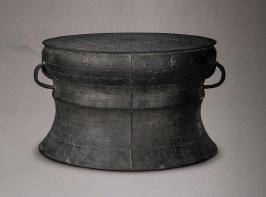
Expert remark: Note the similar central star medallion and the related forms of decoration. Note the size (51.5 cm).
Estimate EUR 4,000
Starting price EUR 2,000
232
A BRONZE FIGURE OF THE WILLOW-BRANCH GUANYIN, BHAISAJYARAJA AVALOKITESHVARA, DALI KINGDOM

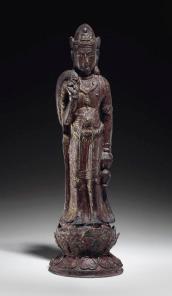
China, Yunnan Province, 11th-12th century. Superbly cast standing on a double-lotus pedestal with beaded lower edge and foliage sprouting from the sides, her right hand raised holding a willow branch. She is richly adorned with an elaborate necklace and further beaded jewelry. Her serene face shows heavy-lidded eyes below gently arched brows, above full lips forming a calm smile. Her hair is pulled up into a high chignon behind the foliate tiara and falling elegantly in braided strands over the shoulders.
Provenance: From the Collection R., Paris, France.
Condition: The figure was broken in two pieces which have been reassembled, the hollow interior was reinforced accordingly, and the inside of the base has been resealed. Expected casting flaws, minor nicks and cracks, obvious losses, remnants of ancient gilt. The bronze is covered in a rich, naturally grown patina with distinct malachite and cuprite encrustations.
Weight: 3,148 g
Dimensions: Height 35.3 cm
Created in the Dali Kingdom (937-1253), this sculpture and its congeners date to the late eleventh or early twelfth century. An independent, devoutly Buddhist kingdom in southwestern China, Dali was coeval with China’s Song dynasty (907–1279) and more or less congruent with present-day Yunnan province. After the 902 fall of Nanzhao, an independent kingdom in southern China, and following the rapid rise and collapse of three successive states in the area, Duan Siping (893–944) seized power in 937 and established the dynastic Dali Kingdom. Unlike Nanzhao, which had had a contentious relationship with the Tang dynasty (618–907), Dali enjoyed cordial relations with the Song, which facilitated artistic and cultural exchange. Duan Siping, his heirs, and the people of Dali claimed to be ethnically Han Chinese, which facilitated relations with Song and which underlies the belief that Dali is a Chinese kingdom.
In Chinese rather than in Indian iconographic conventions, images of Guanyin holding a willow branch and a vase are often termed Yangliu Guanyin, or Willow-Branch Guanyin. Images of the Willow-Branch Guanyin from the Dali Kingdom are sometimes also called Bhaisajyaraja Avalokiteshvara, a Sanskrit name that translates into Chinese as Yaowang, or Medicine King, a reference to the healing powers of the willow branch. Such images first appeared in the late 6th century, during the Sui dynasty (581-618), typically in gilt bronze. Thease early images established a typology that would be followed in later periods, particularly in the Dali Kingdom.
The Sanskrit name Guanshiyin translates to ‘[The One Who] Perceives the Sounds of the World,’ a reference to Guanyin’s ability to hear both the cries of the afflicted and the prayers of supplicants. An earthly manifestation of the Buddha Amitabha, Guanyin guards the world during the interval between the departure of the Historical Buddha Shakyamuni and the appearance of Maitreya, the Buddha of the Future. Chapter 25, Guanshiyin Pusa Pumenpin, of the Lotus Sutra, the best-known of all Buddhist scriptures, describes Guanyin as a compassionate bodhisattva who hears the cries of sentient beings and who works tirelessly to help all those who call upon his name.
Literature comparison: Compare a related gilt-bronze figure of Avalokitesvara from the Dali Kingdom in the Museum für Ostasiatische Kunst, Cologne, Germany, illustrated in Fojiao Diaosu Mingpin Tulu (Images of Famous Buddhist Sculpture), Beijing, 1997, pp. 375, no. 355.
AUCTION RESULT COMPARISON
Type: Related
Auction: Christie’s New York, 22 March 2013, lot
1191
Price: USD 171,750 or approx. EUR 207,000 converted and adjusted for inflation at the time of writing
Description: A rare gilt-lacquered bronze figure of Guanyin, Dali Kingdom, Yunnan, 10th-13th century Expert remark: Compare the related modeling with similar jewelry and lotus base. Note the size (53.3 cm).
Estimate EUR 12,000
Starting price EUR 6,000
153
A GOLD FUNERARY MASK WITH INLAID BEADS, LIAO DYNASTY
China, 907-1125. Worked in fine detail and with a powerful expression from extremely thin gold sheet to depict almond-shaped eyes, arched brows, a broad nose and full lips, neatly inlaid with banded agate and limestone beads. The back with thin gold wire sewn along the rim of the mask for attachment to the deceased’s face.
Provenance: Ex-Collection of The Zelnik István Southeast Asian Gold Museum. Institutional art collection in Belgium, acquired from the above. Dr. István Zelnik, President of the Hungarian South and Southeast Asian Research Institute, is a former high-ranking Hungarian diplomat who spent several decades in Southeast Asia, building the largest known private collection of Asian art in Europe.


Condition: Old wear, the gold sheet extensively creased and warped, with minor tears, dents, losses and pinprick holes. Overall remarkably well-preserved, commensurate with age, and presenting exceptionally.
Weight: 57.3 g
Dimensions: Height 20.4 cm
Funerary masks are associated with the burial culture of the Qidan Liao, and many examples made of bronze, silver sheet, or gold such as the present example have been found in tombs of the Liao elite in Inner Mongolia. Two impressive gold funerary masks were discovered in the royal tomb of the Prince and Princess of Chen, dated circa 1018. Similarly made of thin hammered gold sheet, they are supposed to realistically portray some of their owners’ facial features.
AUCTION RESULT COMPARISON
Type: Closely related
Auction: Christie’s New York, 26 March 2010, lot 1292
Price: USD 146,500 or approx. EUR 187,000 converted and adjusted for inflation at the time of writing
Description: A rare gold funerary mask, Liao dynasty

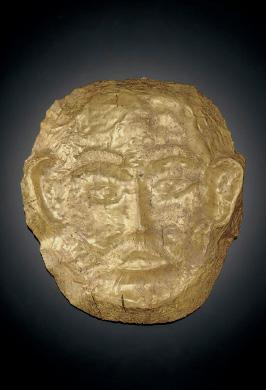
Expert remark: Compare the identical lmaterial and manner of working the thinly hammered gold sheet. Note the ears, mustache, and incision to the brows as well as the medallion and ‘ribbons’ to the back. Note the closely related size (20.3 cm).
Estimate EUR 40,000
Starting price EUR 20,000
234
154
Dr. István Zelnik
The gold mask of the Princess of Chen c. 1018, found in the Princess’ tomb at Qinglongshan, Naiman Qi, Inner Mongolia, China
The Zelnik István Southeast Asian Gold Museum
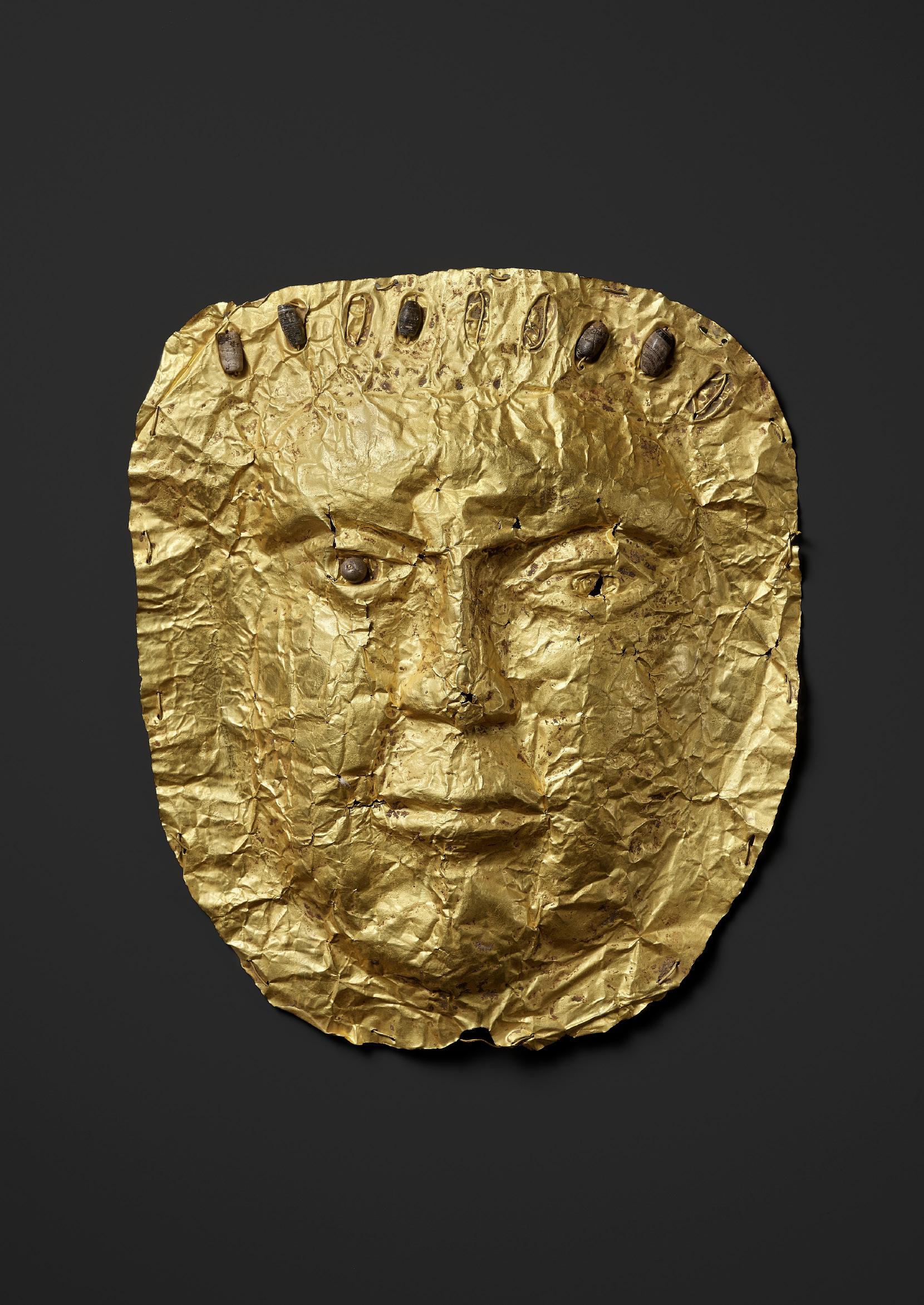
155
A SILVER FUNERARY MASK OF A NOBLEMAN, LIAO DYNASTY
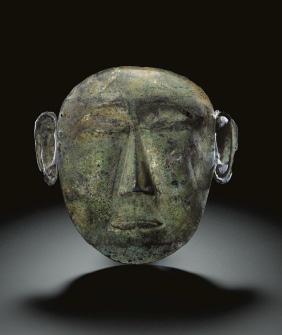
China, inner Mongolia, 907-1125. Formed from a sheet of thinly beaten silver and faithfully modeled to the contours of the deceased’s face, the brows executed by fine striations, the eyes open, the nose long and straight above arched lips, the large ears neatly embossed. The outer rim is pierced to bind the mask to the deceased’s head.

Provenance: From an old private collection in Budapest, Hungary, acquired during the first half of the 20th century.
Condition: Excellent condition, commensurate with age. Wear and traces of use, with light surface corrosion typical of ancient silver, signs of weathering and erosion, minor dents.
Weight: 88.9 g
Dimensions: Height 18 cm, Width 20.5 cm
Funerary masks are associated with the burial culture of the Qidan Liao and many examples made of bronze, silver sheet, or gilt bronze such as the present example have been found in tombs of the Liao elite in Inner Mongolia. Two impressive gold funerary masks were discovered in the royal tomb of the Prince and Princess of Chen, dated 1018. Similarly made of thin hammered gold sheet, they are supposed to realistically portray some of their owners’ facial features.
Literature comparison: Compare with a closely related silver alloy mase in the Philadelphia Museum of Art, accession number 2012-53-1. Compare with Zhu Qixinin, ‘The Liao Dynasty tomb of a Prince and Princess of the Chen Kingdom’, Orientations, October 1991, fig. 11. Compare another example made in gilt bronze sheet and excavated from a Liao tomb at Chifeng, Inner Mongolia, see ‘The Silk Road in Inner Mongolia’, Hong Kong, 2007, cat. no. 18. See also similar examples in the Musée Guimet, Paris, reference number MA2352. Compare with a similarly crafted mask in the Philadelphia Museum of Art, reference number 2012-53-1.
AUCTION RESULT COMPARISON
Type: Related
Auction: Sotheby’s London, 14 May 2008, lot 92
Price: GPB 26,900 or approx. EUR 54,500 converted and adjusted for inflation at the time of writing
Description: A silver funerary mask, Liao dynasty
Expert remark: Compare the material, style and closely related embossing technique.
Estimate EUR 8,000
Starting price EUR 4,000
236
156
A BRONZE FIGURE OF A BUDDHA, CHINA, FIVE DYNASTIES - NORTHERN SONG DYNASTY (907-1126)

Expert’s note: The closely related buddha, listed below in the auction result comparison and published in Saburo Matsubara’s book Chogoku Bukkyo Chokokushi Kenkyu (History Chinese Buddhist Sculpture), Tokyo, 1961, holds unique similarities to the present figure. For one, the hair of both Buddha curl in an identical manner around the central ushnisha, which is slightly recessed. The robes also are configured similarly, tied at the waist in a similar pattern and folding below the feet in a near identical fashion. This comparison places the present figure firmly within the 10th century
Finely cast seated in dhyanasana, his left hand raised in a rare mudra with the ring finger bent and the others extended, his right hand resting on his knee. He is wearing loose-fitting robes opening at the chest. His serene face with heavy-lidded eyes below arched brows as well as full lips flanked by long pendulous earlobes. His hair arranged in deeply incised wavy locks over the high ushnisha.
Provenance: From the private collection of Michael Phillips, acquired through the Japanese trade. Michael Phillips (born 1943) is an Academy Awardwinning film producer. Born in Brooklyn, New York, his parents were Lawrence and Shirley Phillips, noted New York dealers in Asian fine art, selling to the Met, the LACMA, the Chicago Art Institute, and the British Museum among others.
Michael Phillips is a collector of Asian art himself, particularly Indian, Southeast Asian, and Himalayan sculpture. His most important films include The Sting (winning the Academy Award for Best Picture in 1973), Taxi Driver (winning the Palme d’Or at the 1976 Cannes Film Festival), and Steven Spielberg’s Close Encounters of the Third Kind.

Condition: Very good condition, commensurate with age, showing expected old wear overall. Signs of weathering and erosion, remnants of gilding, small nicks here and there. The naturally grown dark patina with cuprite and malachite encrustations. Aureole and lotus base (see auction result comparison below) are lost.
Weight: 185 g
Dimensions: 8.2 cm
This figure may belong to a group of Buddhist votive figures produced in Zhejiang during the Wuyue kingdom (AD 907-978), four of which are illustrated in Comprehensive Illustrated Catalogue of Chinese Buddhist Statues in Overseas Collections, vol. 6, Beijing, 2005, pls. 1234-37: one in the Seikado Bunko Art Museum, Japan (pl. 1234); two in the Harvard University Art Museum, Arthur M. Sackler Museum, Cambridge, (pls. 1235 and 1236); and one in The Metropolitan Museum of Art, New York, pl. 1237; all dated to the 10th century. Of these four, only the figure in the Seikado Bunko Art Museum represents Buddha, while the other three represent bodhisattvas. All of these figures, including the present lot, have similar, distinctive facial features.
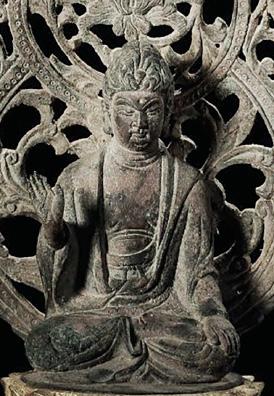
The bodhisattva in The Metropolitan Museum of Art is also illustrated by D. Leidy and D. Strahan in Wisdom Embodied: Chinese Buddhist and Daoist Sculpture in the Metropolitan Museum of Art, New York, 2010, p. 110-12, no. 22, where the authors ascribe the figure to Zhejiang province, which during the 10th century was the center of the Wuyue kingdom (AD 907978). They note that the ‘kingdom was ruled by members of the Qian family, noted for their devotion to Buddhism and their patronage of the arts’.
AUCTION RESULT COMPARISON
Type: Closely related
Auction: Christie’s New York, 14 September 2017, lot 838
Price: USD 468,500 or approx. EUR 534,000 converted and adjusted for inflation at the time of writing
Description: A rare bronze seated figure of Buddha, Five Dynasties-Northern Song dynasty (AD 907-1126), 10th century Expert remark: Note the closely related buddha figure, retaining its original aureole and lotus pedestal, which are both missing on the present lot. Note the total size (16.8 cm).
Estimate EUR 6,000
Starting price EUR 3,000
237
Michael Phillips at the 46th Academy Awards in 1974 after winning the Best Picture Oscar for The Sting
A PARCEL-GILT SILVER TRIPOD JAR AND COVER, TANG DYNASTY
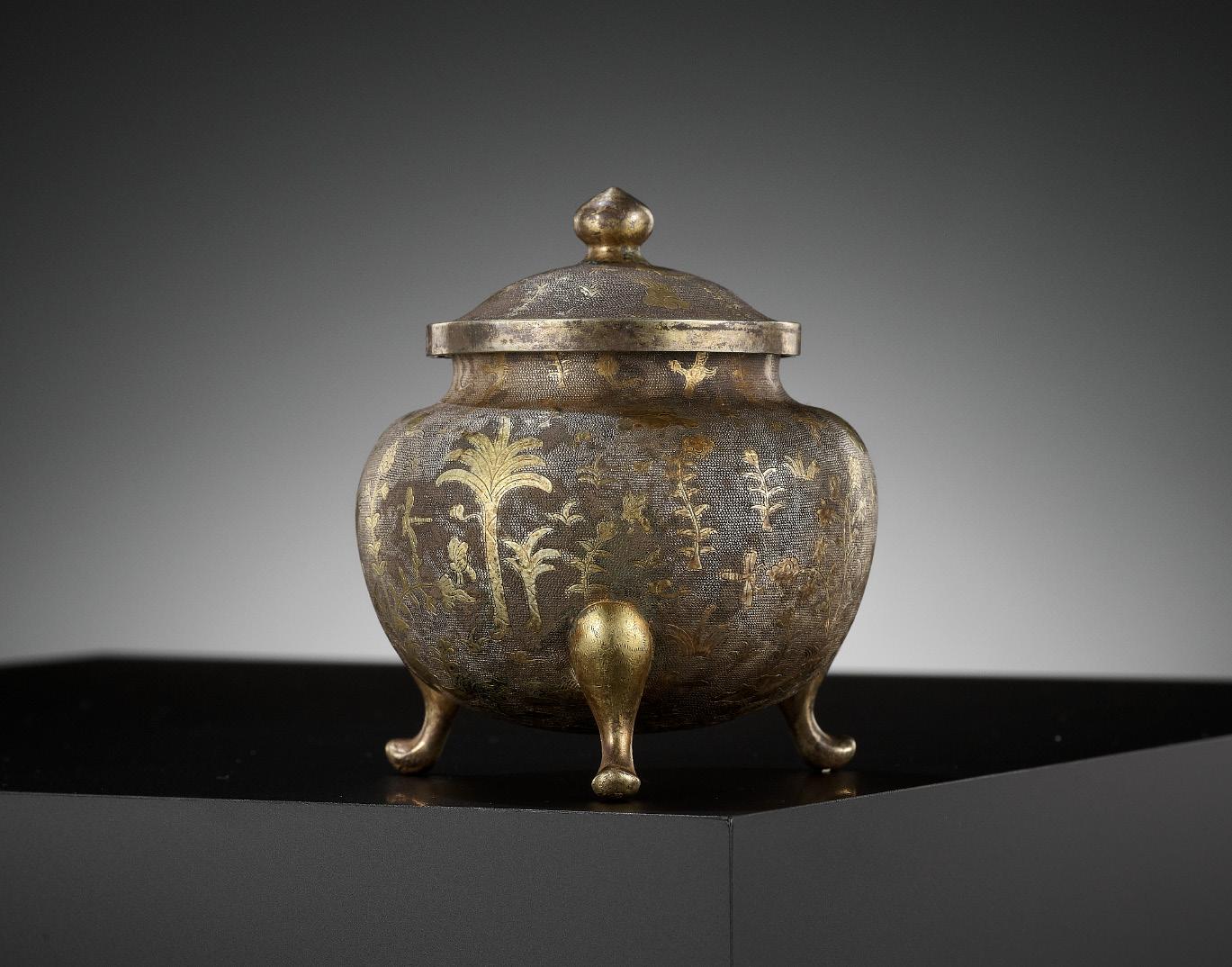
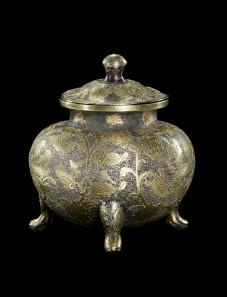
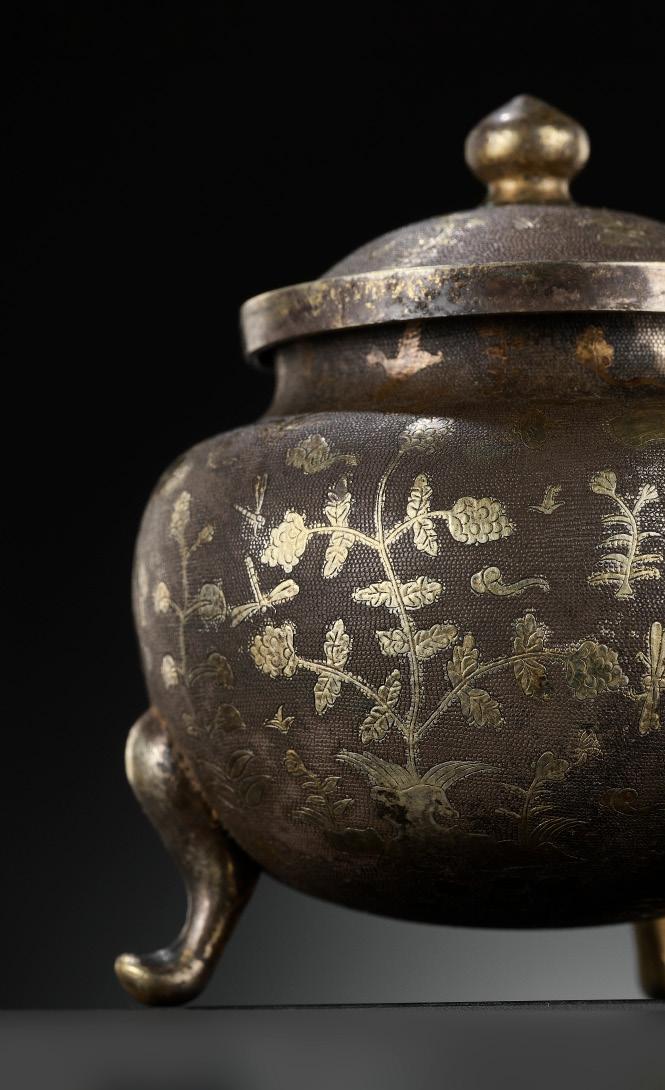
China, 618-907. The globular body raised on three cabriole legs engraved with feathers. Finely chased and incised on a minutely ring-punched ground with tall trees, sprouting and blooming plants, dragonflies, butterflies, birds, and a reclining feline. The gently domed cover surmounted by a lotus bud finial.
Provenance: A private collection in Scandinavia. Bukowskis Auktioner, Stockholm, 12-15 June 2012, lot 1838. A private collection in Finland, acquired from the above. A copy of the original invoice from Bukowskis Auktioner, dated 18 June 2012, accompanies this lot. Condition: Very good condition, commensurate with age. Wear, rubbing to gilt, minor tarnishing to silver, tiny nicks, light scratches, small dents.
Weight: 330.8 g
Dimensions: Height 8.6 cm, Diameter 7.4 cm
Literature comparison: Compare a related parcel-gilt silver tripod vessel, dated to the Tang dynasty, illustrated in Christian Deydier and Han Wei’s Understanding Ancient Chinese Gold and Silver, 2021, pp. 165. Compare a related tripod vessel in Xian, dated to the Tang dynasty, Xian, illustrated in Christian Deydier and Han Wei’s Ancient Chinese Gold, Paris, 2001, pp. 161, no. 390.
AUCTION RESULT COMPARISON
Type: Closely related
Auction: Sotheby’s Hong Kong, 13 October 2021, lot 3678
Estimate: HKD 400,000 or approx. EUR 48,500 converted and adjusted for inflation at the time of writing
Description: A rare parcel-gilt silver tripod vessel and cover, Tang dynasty
Expert remark: Compare the closely related form and decoration. Note the size (6.5 cm).
Estimate EUR 6,000
Starting price EUR 3,000
238 157
158
A LARGE AND FINE SILVER LADLE, TANG DYNASTY
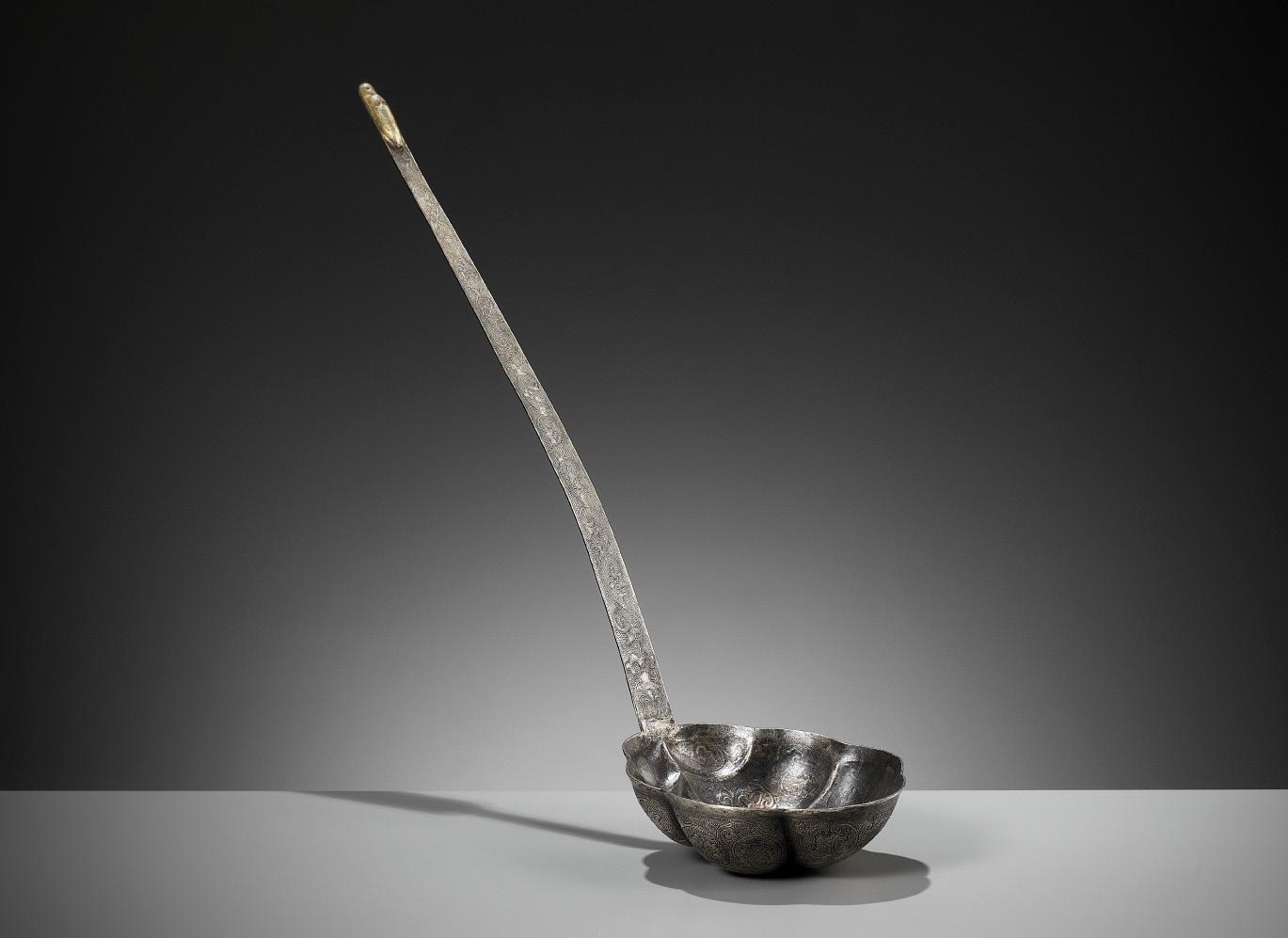

China, 8th-9th century. The deep, petal-lobed bowl is finely engraved on the exterior with foliate scroll on a minutely ring-punched ground. The long, elegantly curved, tapering handle is similarly decorated with further foliate scroll and terminates in a neatly gilt bird’s head.
Provenance: From an old private collection in New York, USA, assembled before 1980 and thence by descent.
Condition: Very good condition, commensurate with age. Expected tarnish to silver, ancient wear overall, traces of usage, few tiny nicks here and there. The handle with faint traces of solder where it connects to the bowl, probably inherent to manufacture.
Weight: 58.1 g
Dimensions: Length 28.6 cm
Literature comparison: Compare a related silver ladle, also with a petallobed bowl and bird-head terminal, 33 cm long, dated to the 8th century, in the Metropolitan Museum of Art, accession number 22.79.5. Compare a related silver ladle, also with engraved foliate decoration, petal-lobed bowl, and bird-head terminal, dated to the first half of the 8th century, in the Art Institute of Chicago, reference number 1945.169. Compare a related gilt silver ladle, also with a petal-lobed bowl and bird-head terminal, 30.8 cm long, dated to the 9th century, in the Seattle Art Museum, accession number 45.66. A related ladle was included in the exhibition Chinesisches Gold und Silber. Die Sammlung Pierre Uldry, Museum Rietberg, Zurich, 1994, cat. no. 157. A related ladle originally in the collections of Mrs. Christian R. Holmes and the Hon. Senator Hugh Scott, included in the China Institute in America exhibition Early Chinese Gold and Silver, China House Gallery, New York, 1971, cat. no. 72, and illustrated in Hugh Scott, The Golden Age of Chinese Art, Rutland, Vermont, 1967, pl. 13, was sold at Christie’s New York, 2 December 1982, lot 399.

AUCTION RESULT COMPARISON
Type: Closely related
Auction: Christie’s New York, 12 September 2019, lot 553
Price: USD 225,000 or approx. EUR 244,000 converted and adjusted for inflation at the time of writing
Description: A fine and rare large silver ladle, Tang dynasty
Expert remark: Compare the closely related form with similar petal-lobed bowl, elegantly curved handle, and bird-head terminal, which however is not gilt. Also compare the closely related decoration with similarly engraved foliate scroll against a ringpunched ground, albeit further with three birds. Note the similar size (26 cm) and weight (67.5 g).
Estimate EUR 6,000
Starting price EUR 3,000
239
A RARE GOLD REPOUSSÉ MELON-FORM JAR AND COVER, TANG DYNASTY
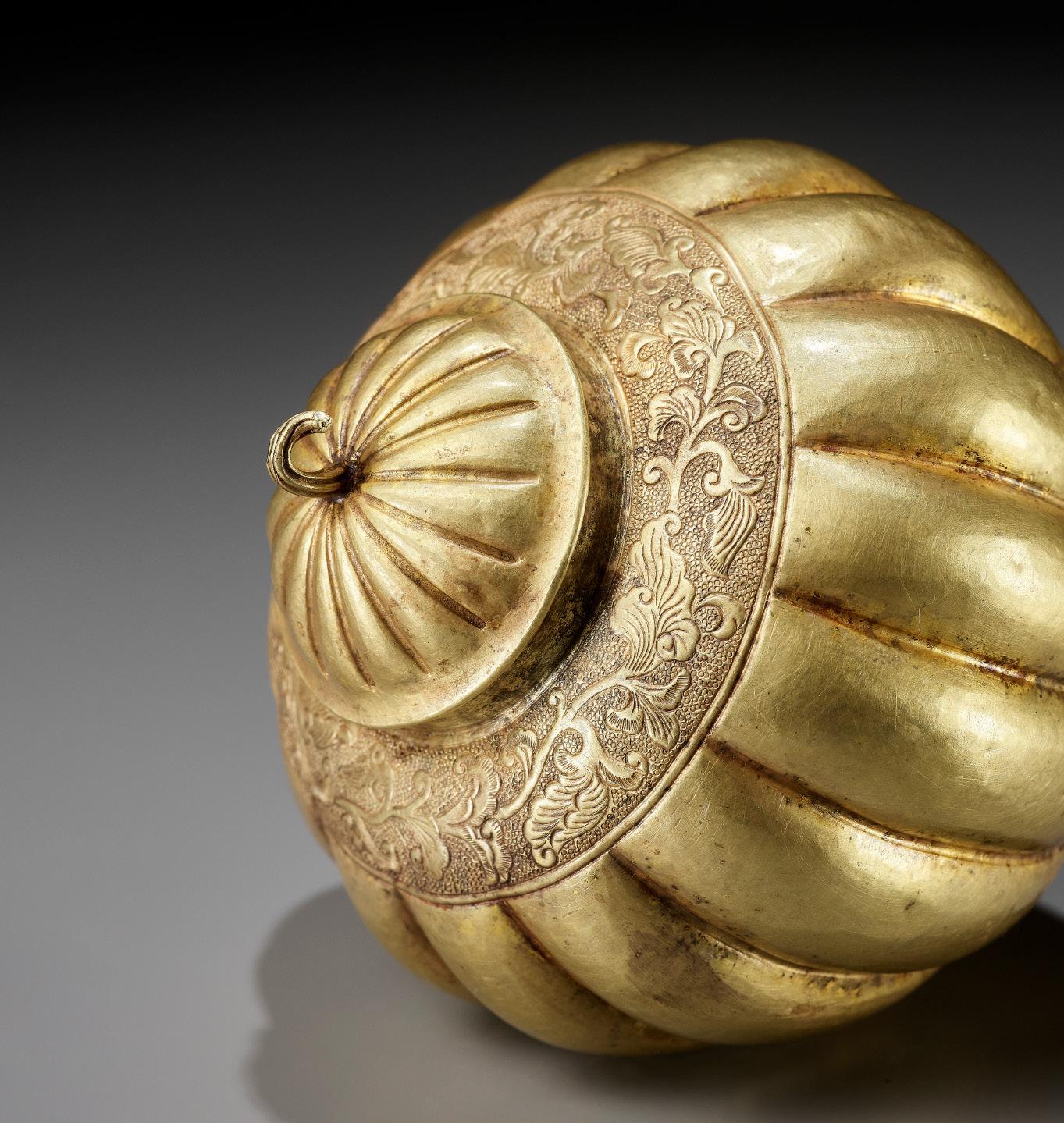
China, 618-907. The lobed sides of the vessel supported on a slightly concave base and surmounted by a short straight rim, the domed cover similarly lobed and centered by a finial in the form of the melon’s stem. The shoulder is finely decorated with a wide band of neatly incised scrolling foliage against a ring-punched ground, the foot encircled by a band of overlapping petals.
Provenance: From the collection of Dr. Jonathan Broido (1941-2008), who was a professor of mathematics and philosophy as well as a passionate collector of Chinese art and archaic Turkoman weavings, known for his expertise and scholarly approach. He traveled throughout Asia acquiring pieces for his collection, as well as making some spectacular finds in UK and US antique markets, auctions and trade.
Condition: Excellent condition, commensurate with age. Expected old wear, soil encrustations, minor dents and nicks, a few light scratches, all as expected for a gold object with over a thousand years of age. Tested purity c. 750/1000.
Weight: 129 g
Dimensions: Height 12.4 cm
LITERATURE COMPARISON

Compare a related parcel-gilt silver box and cover, also in the form of a melon, 6.4 cm high, dated late 7th to early 8th century, in the National Museum of Asian Art, accession number F1930.39a-b.

AUCTION RESULT COMPARISON
Type: Closely related
Auction: Poly Auction Hong Kong Limited, 14 July 2022, lot 3137
Estimate: HKD 700,000 or approx. EUR 83,500 converted and adjusted for inflation at the time of writing
Description: A fine repoussé gold floral box and cover, Tang dynasty

Expert remark: Compare the closely related lobed form, as well as the similar repoussé, incision and punching work. Note the slightly smaller size (9 cm). This lot was exhibited by the Musée Baur, Geneva, L’or des steppes, Arts somptuaires de la dynastie Liao, 2007, catalog no. 13.
Estimate EUR 10,000
Starting price EUR 5,000
240 159
Dr. Jonathan Broido (1941-2008)
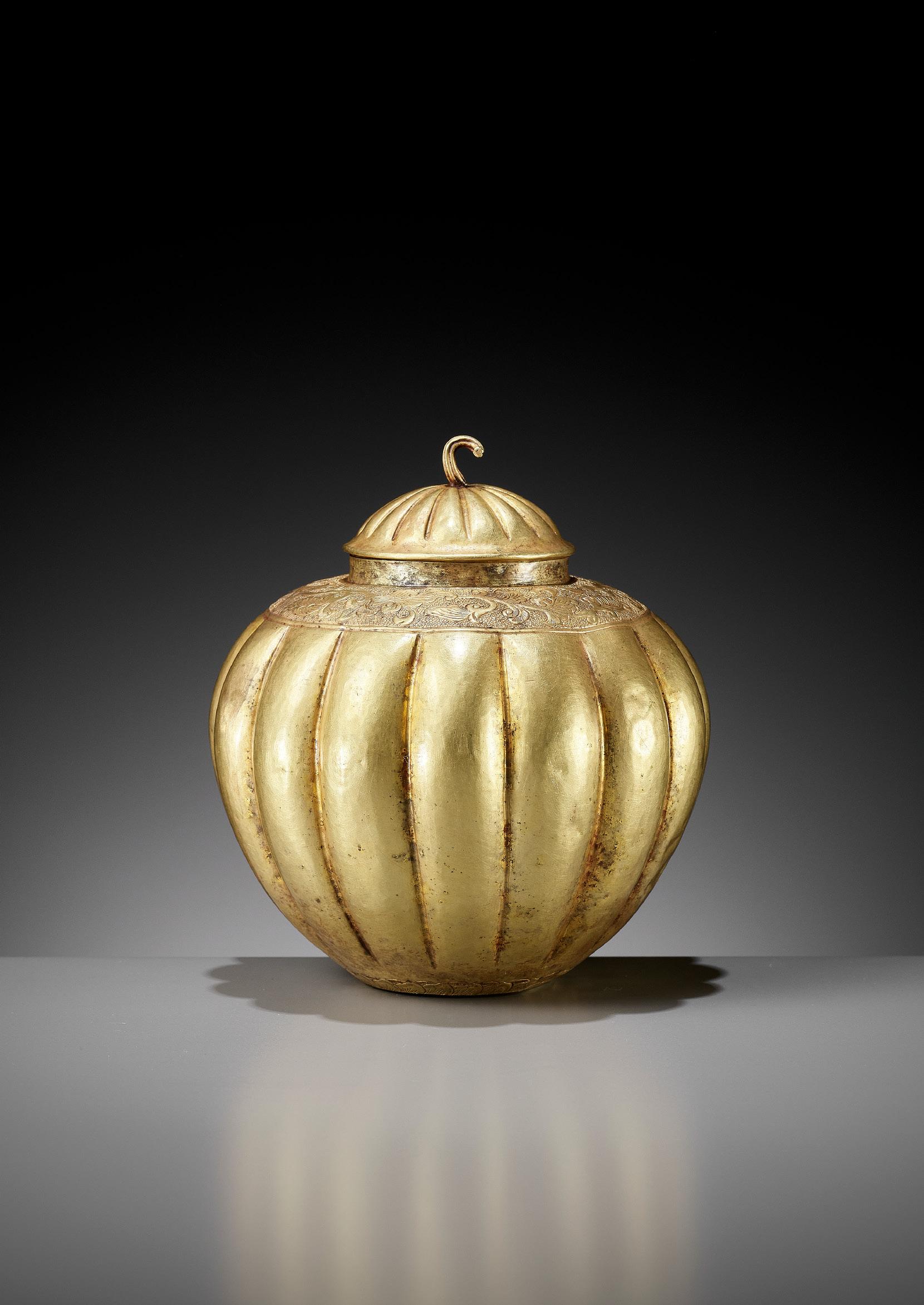
160
AN ARCHAISTIC MINATURE GOLD AND SILVER-INLAID BRONZE VESSEL, POU, SONG TO MING DYNASTY
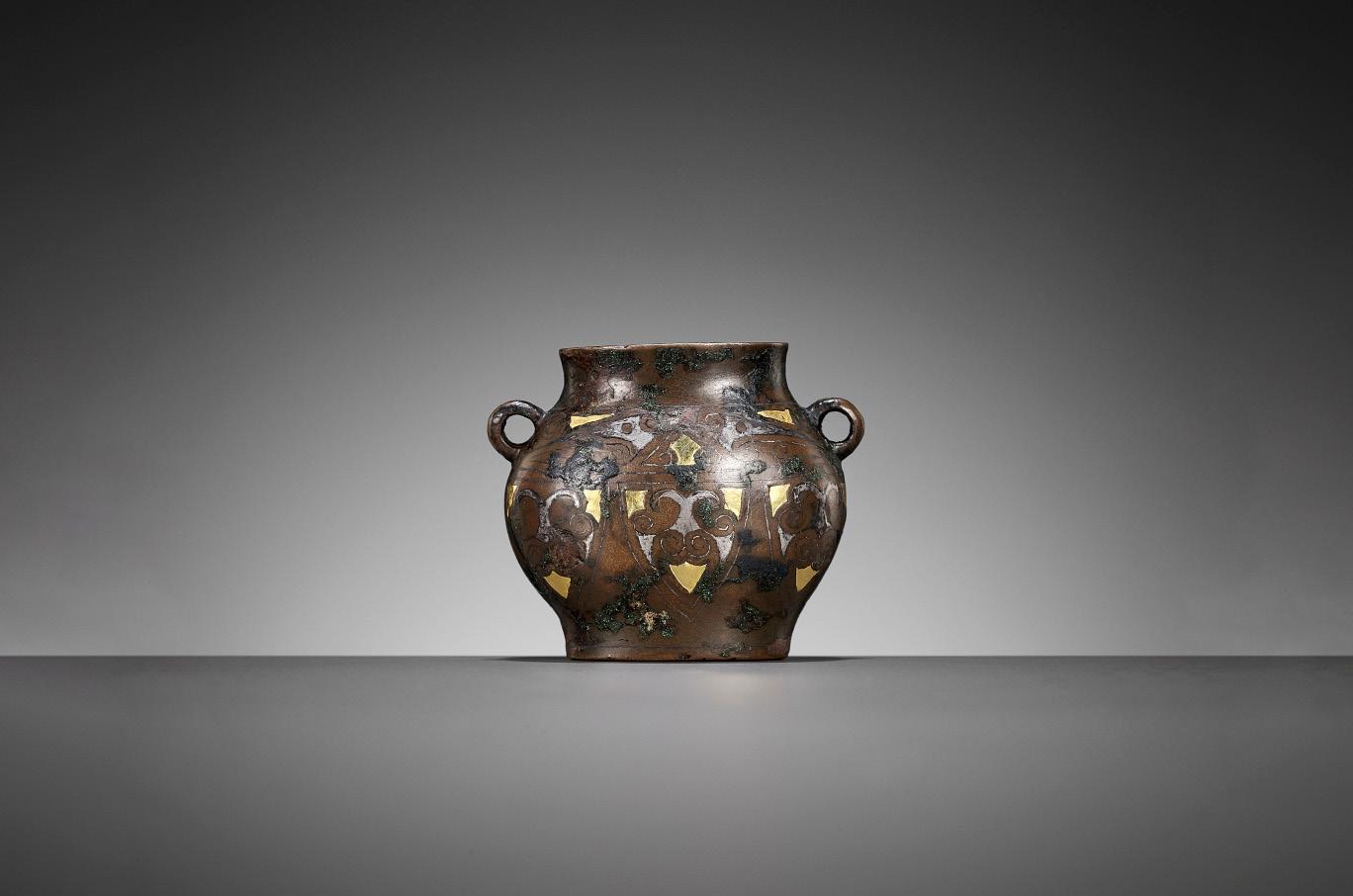
China, 960-1644. Of flattened ovoid shape, short waisted neck with a flat rim and a flat base decorated overall in gold and silver inlays in a geometric design with pendent leaves which enclose scroll designs within silver wire enclosures. The double handles inlaid with a gold design.
Provenance: Galerie Zacke, Vienna, c. 1990. Collection of Maria and Johannes Nickl, acquired from the above and thence by descent in the same family. An old exhibition label from Galerie Zacke, dating the present lot to the 13th-14th century, stating a purchase price of ATS 10,000 (or approx. EUR 1,300 converted and adjusted for inflation at the time of writing), accompanies this lot. Maria (1926-2022) and Johannes Nickl (d. 2020) lived in Vienna, Austria, and were ardent collectors of Asian, Buddhist, and Egyptian works of art. They were highly active in Vienna’s tight-knit Asian art trade and assembled most of their collection during the 1980s and 1990s, frequently buying from Galerie Zacke and later Galerie Asboth. The couple were also noted museum patrons and their names are still found on the Ehrentafel (‘Roll of Honor’) of the Egyptian and Near Eastern Collection at the Kunsthistorisches Museum Wien (Museum of Fine Arts Vienna) today.
Weight: 70 g
Dimensions: Height 4 cm
Literature comparison: Compare a related small archaistic gold and silver-inlaid bronze handled vessel, dated to the Song dynasty, 8.7 cm wide, at Sotheby’s London, 3 November 2021, lot 159. Compare a related miniature gold and silver-inlaid bronze gu, 5.6 cm tall, dated Song to Ming dynasty, at Sotheby’s Hong Kong, 22 April 2021, lot 3667. Compare two related miniature inlaid bronze archaistic censers, dated to the 18th century, at Christie’s New York, 19 March 2008, lot 326. Compare a related miniature inlaid bronze covered ding, dated to the Ming dynasty, at Sotheby’s Hong Kong, 3 April 2012, lot 173.
AUCTION RESULT COMPARISON
Type: Closely related
Auction: Sotheby’s Hong Kong, 1 April 2019, lot 3123

Price: HKD 137,500 or approx. EUR 17,500 converted and adjusted for inflation at the time of writing

Description: A Gold and Silver-Inlaid Bronze Miniature Wine Vessel, Zun, Ming Dynasty
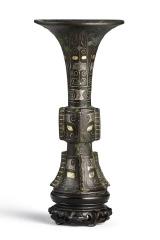
Expert remark: Compare the closely related decor and inlay work. Note the miniature size of 8 cm
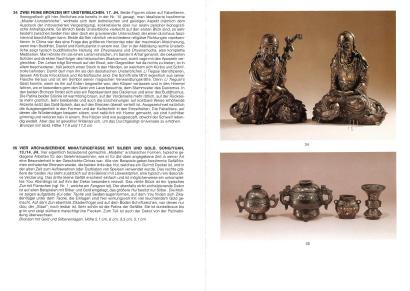
Condition: Good condition with ancient wear and a solid, natural patina with scattered malachite encrustations. Minor signs of weathering, encrustations, small nicks and chips, light scratches.
Estimate EUR 4,000
Starting price EUR 2,000
242
161
A BRONZE ‘TIGER’ TALLY WITH A SILVER-INLAID INSCRIPTION, MING DYNASTY
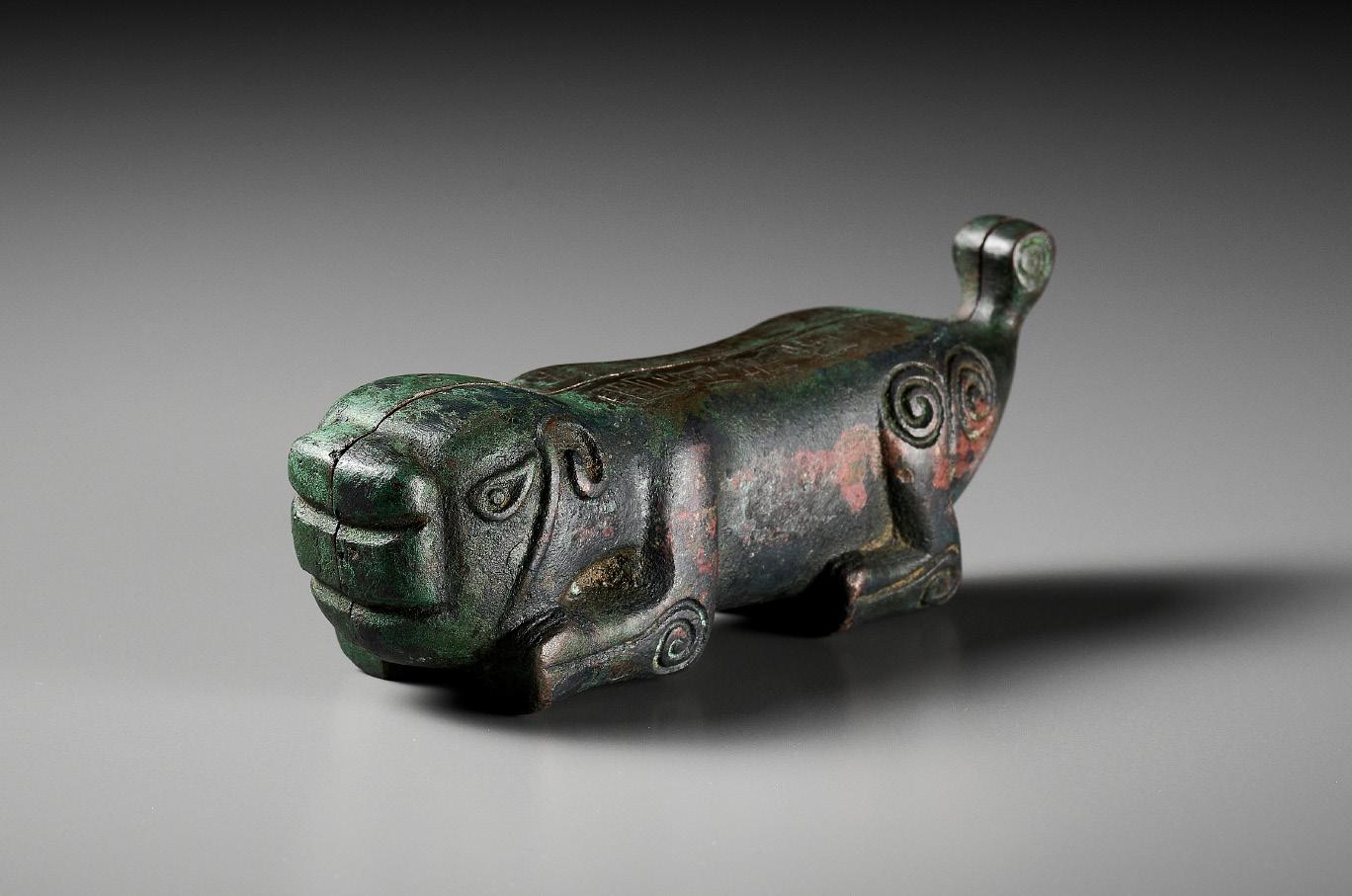

Inscriptions: To the tiger’s back, ‘yu Guiyang Taishou wei hufu zuo jia er’ (for Grand Warden in the Guiyang county as a tiger tally, left jia second).
China, 1368-1644. Well cast, the identification device splitting open in two matching halves, cast in the form of a crouching tiger with a broad rounded-square head and short upright tail, its face detailed with a flattened snout, slender eyes and curling ears. Its tucked limbs and haunches picked out with incised whorls, neatly inlaid in silver wire with an eleven-character inscription along the spine.
Provenance: New York trade.
Condition: Good condition with wear and casting irregularities, encrustations, signs of weathering and erosion, few minuscule nicks. The right half with ‘china’ faintly incised on the head. The bronze with a rich, naturally grown patina with malachite, cuprite, and azurite encrustations.
Weight: 533.5 g
Dimensions: Length 11.8 cm
Tiger tallies, originating from the late Warring States period, were important tokens for the rulers to confer military power upon their regional ministers. The two halves of the tallies were normally held separately by the emperor and the marshals. A valid military command issued by the court had to be accompanied by the emperor’s half of the tally. The reunion of the two halves allows the local marshal to ensure the legitimacy of the command and mobilize the armies in the name of the emperor.
AUCTION RESULT COMPARISON
Type: Near-identical
Auction: Sotheby’s Hong Kong, 8 October 2013, lot 3298
Estimate: HKD 100,000 or approx. EUR 15,000 converted and adjusted for inflation at the time of writing
Description: An inscribed bronze ‘tiger’ tally, Ming dynasty
Expert remark: Compare the closely related design, pose, and inlaid inscription.
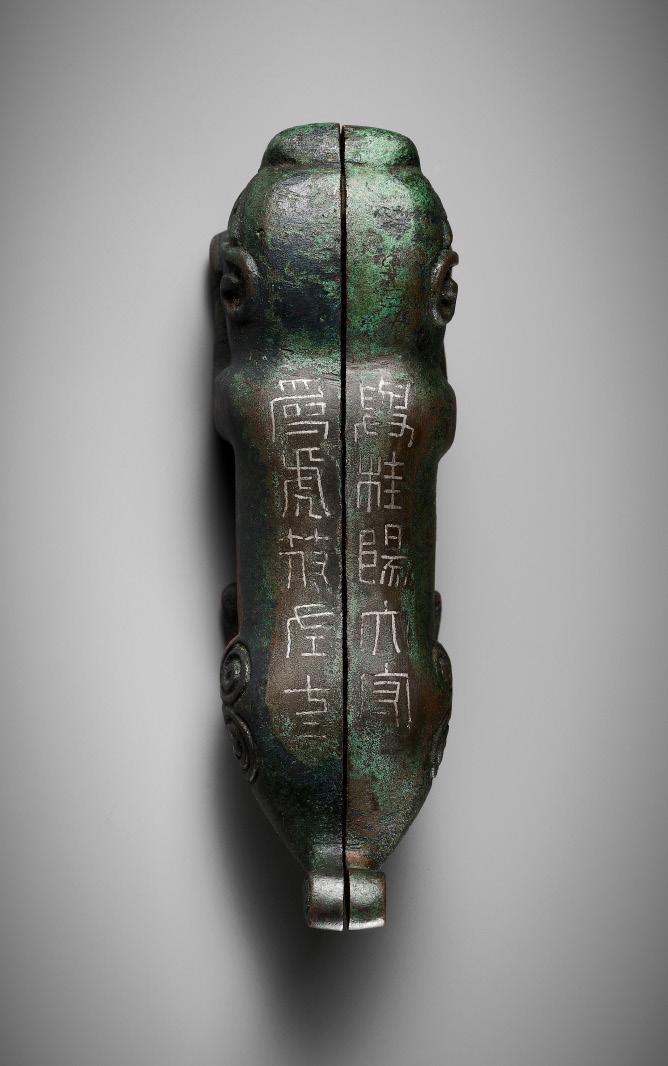
243
Estimate EUR 4,000 Starting price EUR 2,000
A GOLD-SPLASHED BRONZE BOMBÉ CENSER, YUTANG QINGWAN MARK, CHINA, 17TH-18TH CENTURY
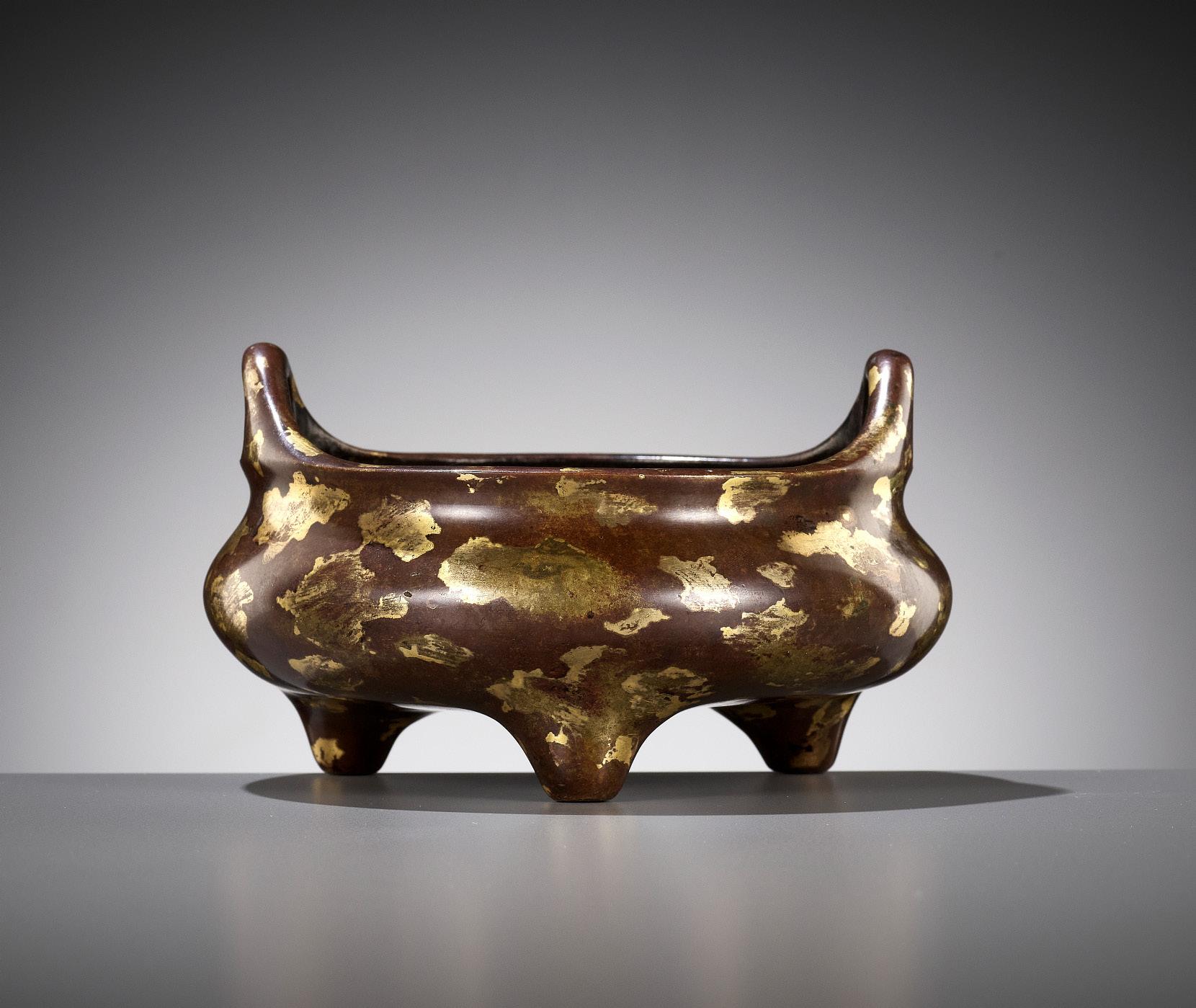
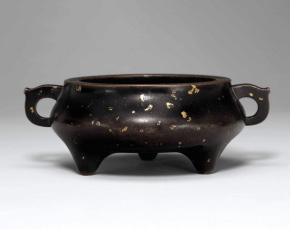
Expert’s note: The gold-splashed decoration on this censer is especially rich, suggesting that it was made with no cost spared and for the table of a high-ranking official or an important scholar-literati.
The compressed tripod vessel is raised on three tapering feet, the everted rim with two upright loop handles, richly decorated to the exterior with cloud-like gilt splashes. The base is neatly cast with the four-character hall mark in deep relief.
Inscriptions: To the base, ‘Yutang qingwan’ (pure please of the Jade Hall).

Provenance: English trade.
Condition: Good condition with old wear, expected traces of use, and minor casting flaws, slight rubbing to the gilt, and occasional minute nicks and light scratches. The interior with several pronounced fatigue cracks, signs of extensive usage over a prolonged period of time.
Weight: 1,221 g
Dimensions: Width 14.7 cm
AUCTION RESULT COMPARISON
Type: Closely related
Auction: Galerie Zacke, Vienna, 6 March 2021, lot 442
Price: EUR 20,224 or approx. EUR 24,000 adjusted for inflation at the time of writing
Description: A ‘Yutang qingwan’ goldsplashed bronze bombé censer, 17th century
Expert remark: Compare the similar gold splashes and identical hall mark. Note the different position of the loop handles and the larger size (18.7 cm).
AUCTION RESULT COMPARISON
Type: Closely related
Auction: Christie’s New York, 17 March 2017, lot 1040
Price: USD 30,000 or approx. EUR 34,500 converted and adjusted for inflation at the time of writing
Description: A gilt-splashed bronze tripod censer, 17th-18th century
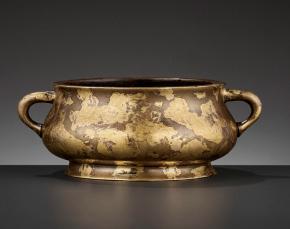
Expert remark: Compare the closely related gilt splashes and tripod form, albeit with different loop handles, and the identical hall mark. Note the slightly larger size (17.5 cm).
Estimate EUR 6,000
Starting price EUR 3,000
244 162
A GILT BRONZE LION-FORM WEIGHT, LATE MING DYNASTY
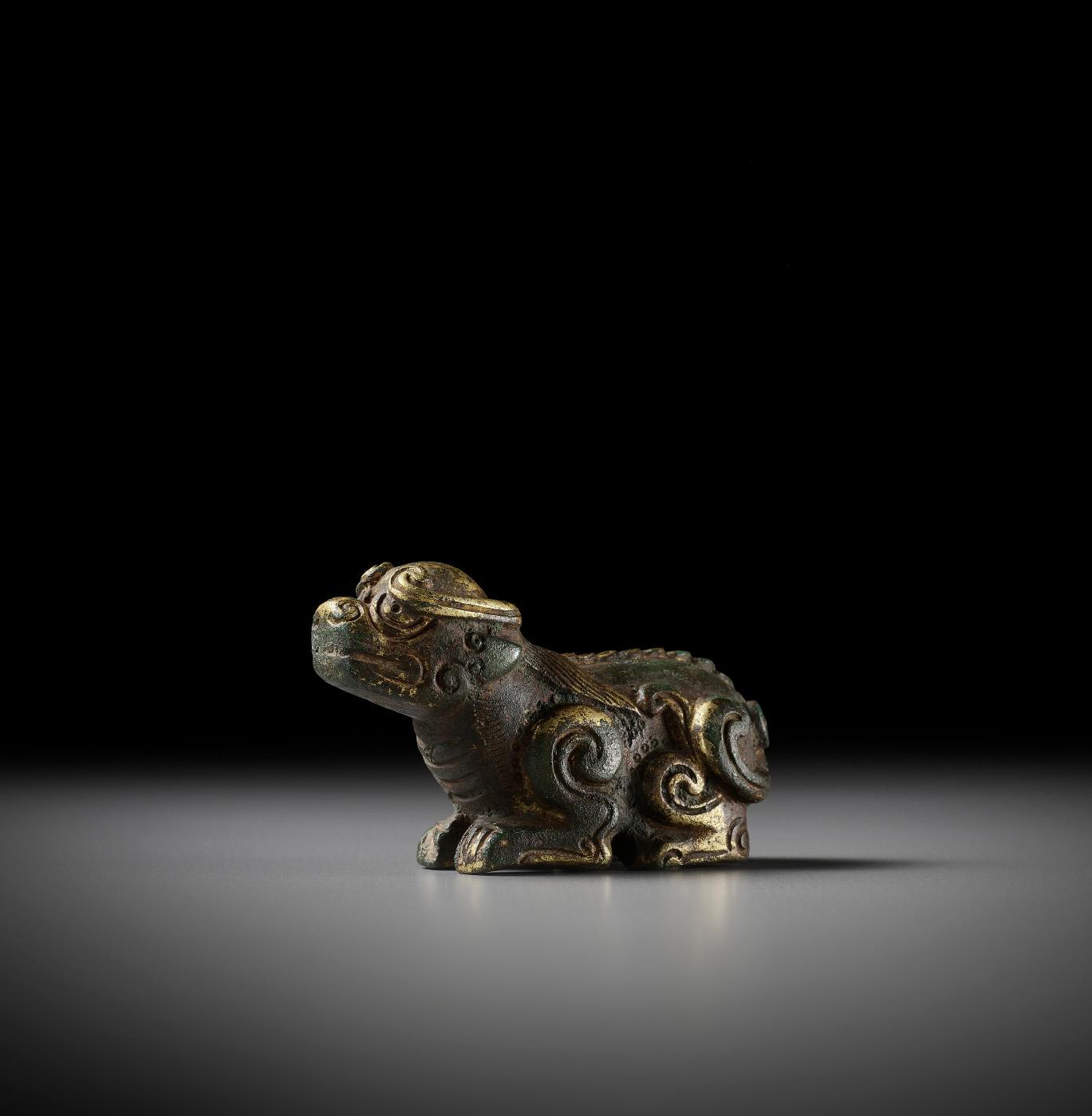

China, 16th-17th century. Heavily cast, seated in a recumbent pose, slightly raising its head and facing forward, its muscular body decorated with scroll designs around the leg joints, the mane with similar designs as well as ruyi elements, the spine finely detailed with petal-like curls terminating in a furcated tail. The rounded eyes below long sweeping brows reaching to the back of its head, above neatly incised strands of hair.
Provenance: Collection of Captain André Le Gac, acquired in China in the 1920s, during which time he was the captain of a Yangtze River gunboat, and thence by descent in the same family. André Jules Gabriel Le Gac (1895-1960) was born in Brest, France. He joined the French Navy in 1914 and was awarded the Chevalier de la Legion d’ Honneur (Knight of the Legion of Honor). He was present for the German surrender at Saint-Nazaire in 1945. Throughout his travels with the navy, which also included a station in Hong Kong, Le Gac assembled a large collection of fine Chinese art which he brought home to France, thence remaining in the family for almost 100 years.
Condition: Good condition with expected old wear and casting irregularities, light scratches, small nicks, minor dents, rubbing and minor losses to gilt. The wood base with a good patina, old wear, minor nicks and natural age cracks. The bronze with a rich, naturally grown patina with malachite and cuprite encrustations.
Weight: 410.1 g (excl. stand), 432.6 g (incl. stand)
Dimensions: Length 7.7 cm
With an associated, finely carved, open worked, and fitted wood stand dating from the Qing dynasty. (2)
AUCTION RESULT COMPARISON
Type: Related
Auction: Christie’s Hong Kong, 4 October 2016, lot 33
Price: HKD 68,750 or approx. EUR 9,100 converted and adjusted for inflation at the time of writing
Description: A silvered-bronze lion-form weight, Ming dynasty, 16th-17th century Expert remark: Note the similar size (7.5 cm).
Estimate EUR 4,000
Starting price EUR 2,000
245
163
164
A LARGE BRONZE ‘QILIN’ CENSER, YUAN TO MING DYNASTY
China, 1279-1644. Heavily cast and finely detailed with its head turned back sharply in a defensive pose, the mouth open in a warning roar exposing sharp fangs and tongue, the face further with bulging eyes, long whiskers, and a single horn set between funnel ears, the haunches with flames, the bushy striated tail cast separately. The upper back with an oval aperture for incense burning. (2)
Provenance: From a private estate in the northwest of France. According to the last owner, the bronze was in the same family for several generations. French trade, acquired from the above, by repute. Condition: Good condition with some old wear and expected casting irregularities. Traces of use, light scratches, minor losses, small dents, few tiny structural cracks. The bronze with a rich, naturally grown, dark green patina, and patches of malachite hue.
Weight: 12.9 kg
Dimensions: Length 49.5 cm, Width 41.5 cm
The present qilin is remarkable for its large size and lifelike posture
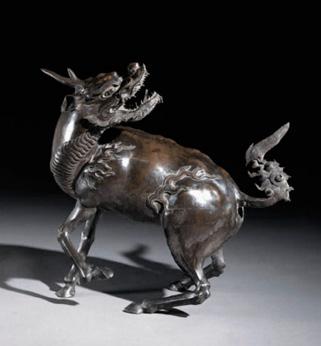
The qilin is one of the animals mentioned in the Zhou dynasty Book of Rites, together with the dragon, phoenix, and tortoise. It is a creature of good omen and a symbol of longevity, felicity, illustrious offspring, and wise administration.
Literature comparison: Compare with a related 17th-century bronze qilin censer with similar striated casting of the tail and scales on the chest, included by Robert D. Mowry in the Catalogue of the Exhibition, China’s Renaissance in Bronze, Phoenix Art Museum, 25 September-30 January 1994, pp. 222-223, no. 58.
AUCTION RESULT COMPARISON
Type: Closely related
Auction: Christie’s New York, 22 March 1999, lot 77
Price: USD 74,000 or approx. EUR 125,000 converted and adjusted for inflation at the time of writing
Description: Compare the closely related modeling, with similar lifelike posture, and manner of casting. Note the much larger size (99 cm) and that this figure does not appear to be a censer.
Estimate EUR 10,000
Starting price EUR 5,000
246
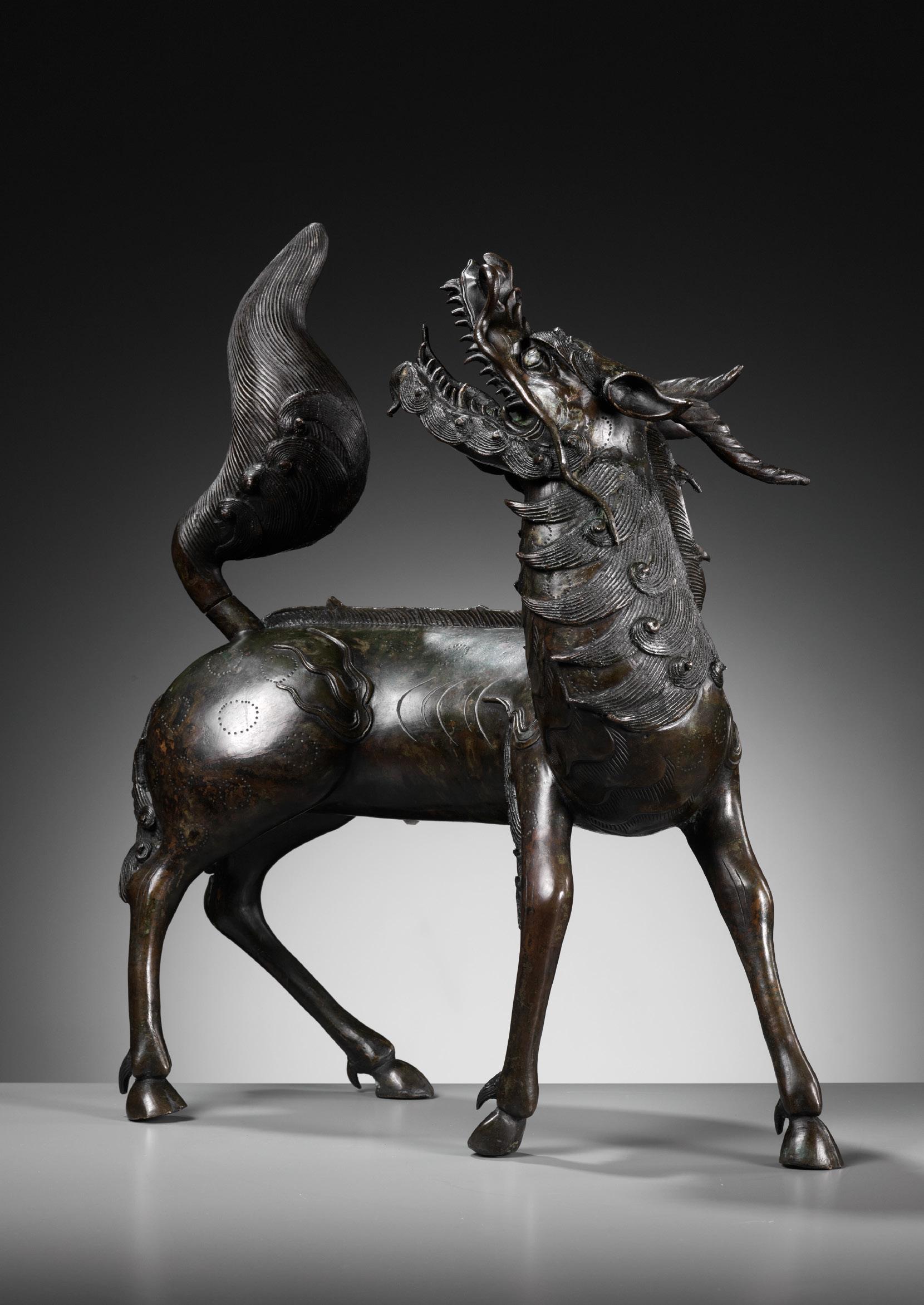

165
A MASSIVE BRONZE ‘MANDARIN DUCK’ CENSER AND COVER, MING DYNASTY
China, 1368-1644. Finely worked, the duck with the head turned to the right, lotus stems in its mouth bearing blossoms and leaves cast in high relief on its body, the legs with webbed feet tucked up under the body, incised with richly detailed plumage, wings, and tail. The open worked cover on the back of the duck in the form of lotus pods, leaves, and flowers borne on twisting stems. The back of the tail cut with a cash-patterned opening.
Provenance: From a private collection in the Cotswolds, United Kingdom.
Condition: Good condition with expected ancient wear and some casting flaws, a few tiny losses, small nicks and dents, light scratches. The bronze is covered overall in a rich, naturally grown, dark patina.
Weight: 3,256 g
Dimensions: Length 22.8 cm
AUCTION RESULT COMPARISON
Type: Closely related
Auction: Bonhams
London, 7 November

2013, lot 241
Estimate: GBP 10,000 or approx. EUR 18,000 converted and adjusted for inflation at the time of writing
Description: A pair of bronze ‘mandarin duck’ incense burners and covers, Ming dynasty
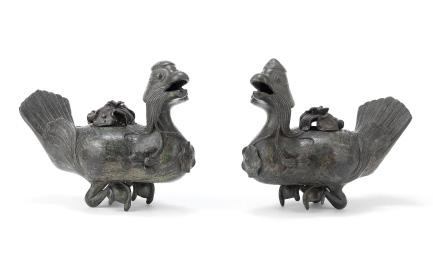
Expert remark: Compare the closely related form, posture, and patina. Note the size (28 cm) and that the lot comprises a pair.
Estimate EUR 6,000
Starting price EUR 3,000
249
166
AN ARCHAISTIC BRONZE FOOD VESSEL AND COVER, DOU, TWO QIANLONG MARKS AND OF THE PERIOD
Expert’s note: Not only are these bronze dou much rarer than their blue-glazed counterparts, it is extremely rare to find the vessel and matching cover still together.
China, 1736-1795. Heavily cast with a broad, cylindrical bowl raised on a spreading stem, decorated around the exterior with archaistic geometric motifs, C-scrolls, and undulating bands, the cover’s finial modeled as two entwined rope-twist loops. The rim of the foot and inside of the cover each cast with a six-character mark da Qing Qianlong nianzhi and of the period. The bronze with a fine, smooth, even patina.
Provenance: From an old Swiss private collection. A noted French private collection, acquired from the above.
Condition: Very good condition with minor old wear and casting irregularities, minuscule nicks to edges, occasional light scratches, all as expected and commensurate with age.
Weight: 3,499 g
Dimensions: Height 24.7 cm, Diameter 15.3 cm
The Qianlong Emperor issued an imperial decree regarding sacrificial vessels in 1748, just before the Winter Solstice sacrifice that was scheduled to be held in the Temple of Heaven that year: ‘The Altar to Heaven main offering table dou [vessel] is blue porcelain...The handle on the top is like a twisted rope.’ It is rare to find a bronze dou vessel from this period because the decree called for dou to be made of blue porcelain, which were used in sacrificial rituals for the rest of the Qing dynasty. Margaret Medley illustrates an example of a blue-glazed version together with illustrations of similar vessels in The Illustrated Regulations for Ceremonial Paraphernalia of the Ch’ing Dynasty in the Victoria and Albert Museum, Transactions of the Oriental Ceramic Society, volume 31, 1957-59, pl. 39 a, c, and d.
Literature comparison: Compare a related gilt-bronze dou vessel in the Palace Museum, Beijing, registration number 250113.
AUCTION RESULT COMPARISON
Type: Closely related
Auction: Christie’s New York, 16 September 2016, lot 1224
Price: USD 11,875 or approx. EUR 13,500 converted and adjusted for inflation at the time of writing
Description: A bronze cover for an archaistic vessel, dou, Qianlong six character cast seal mark and of the period, 1736-1795
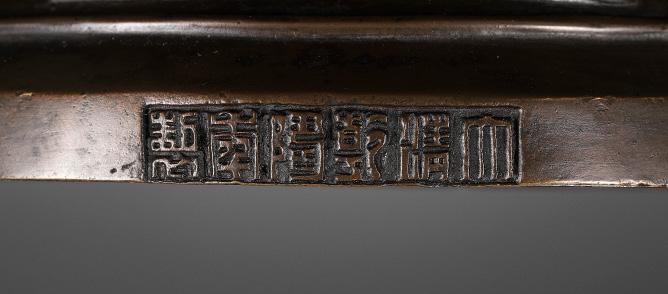

Expert remark: Compare the closely related form, manner of casting, and reign mark. Note the lacking vessel.
AUCTION RESULT COMPARISON
Type: Closely related
Auction: Christie’s New York, 13 September 2019, lot 867
Price: USD 12,500 or approx. EUR 13,500 converted and adjusted for inflation at the time of writing
Description: A bronze archaistic food vessel, dou, Qianlong six character cast seal mark and of the period, 1736-1795
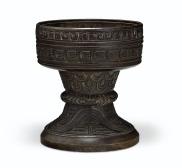

Expert remark: Compare the closely related form, manner of casting, and reign mark. Note the lacking cover.
Estimate EUR 15,000
Starting price EUR 7,500
250
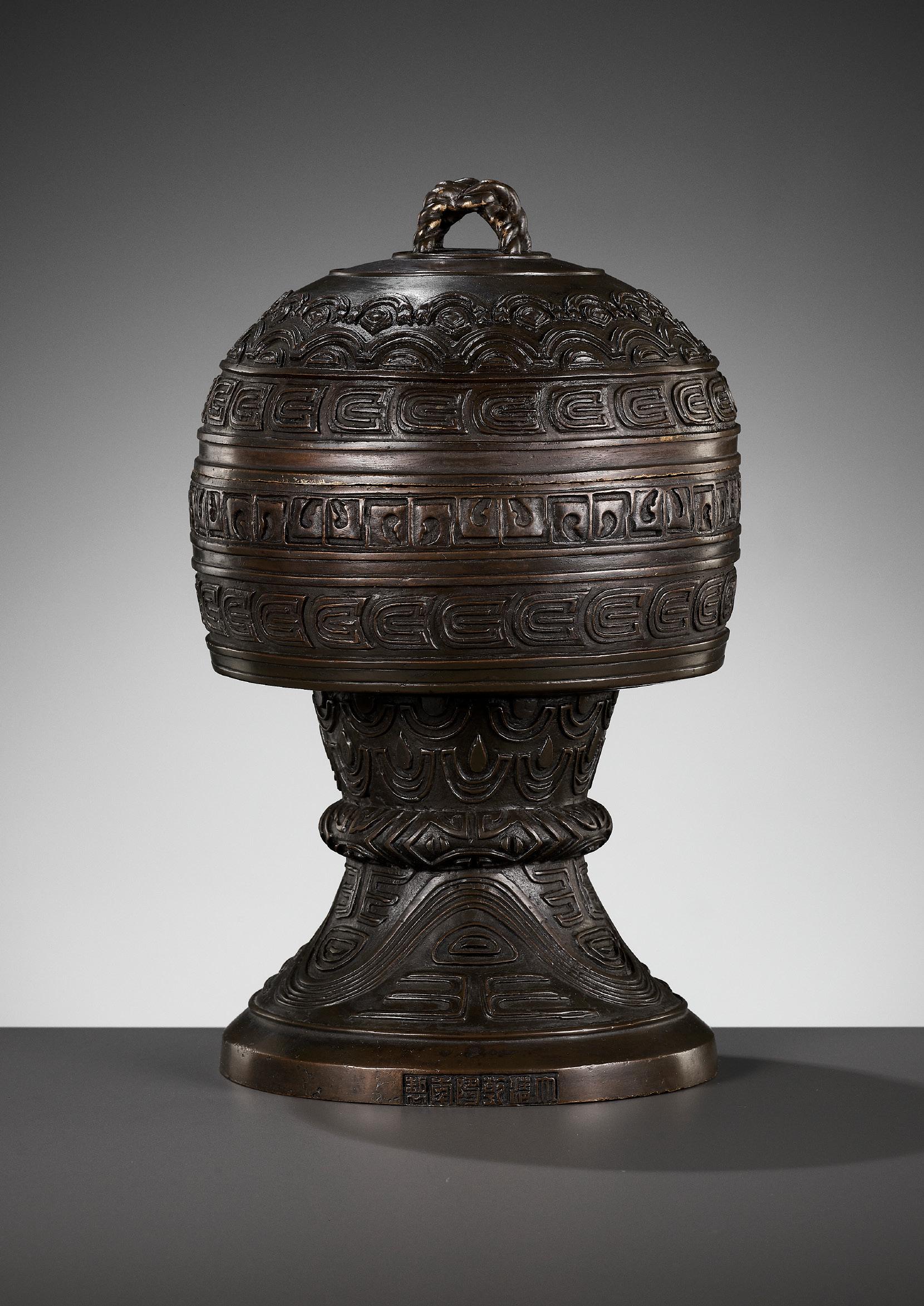
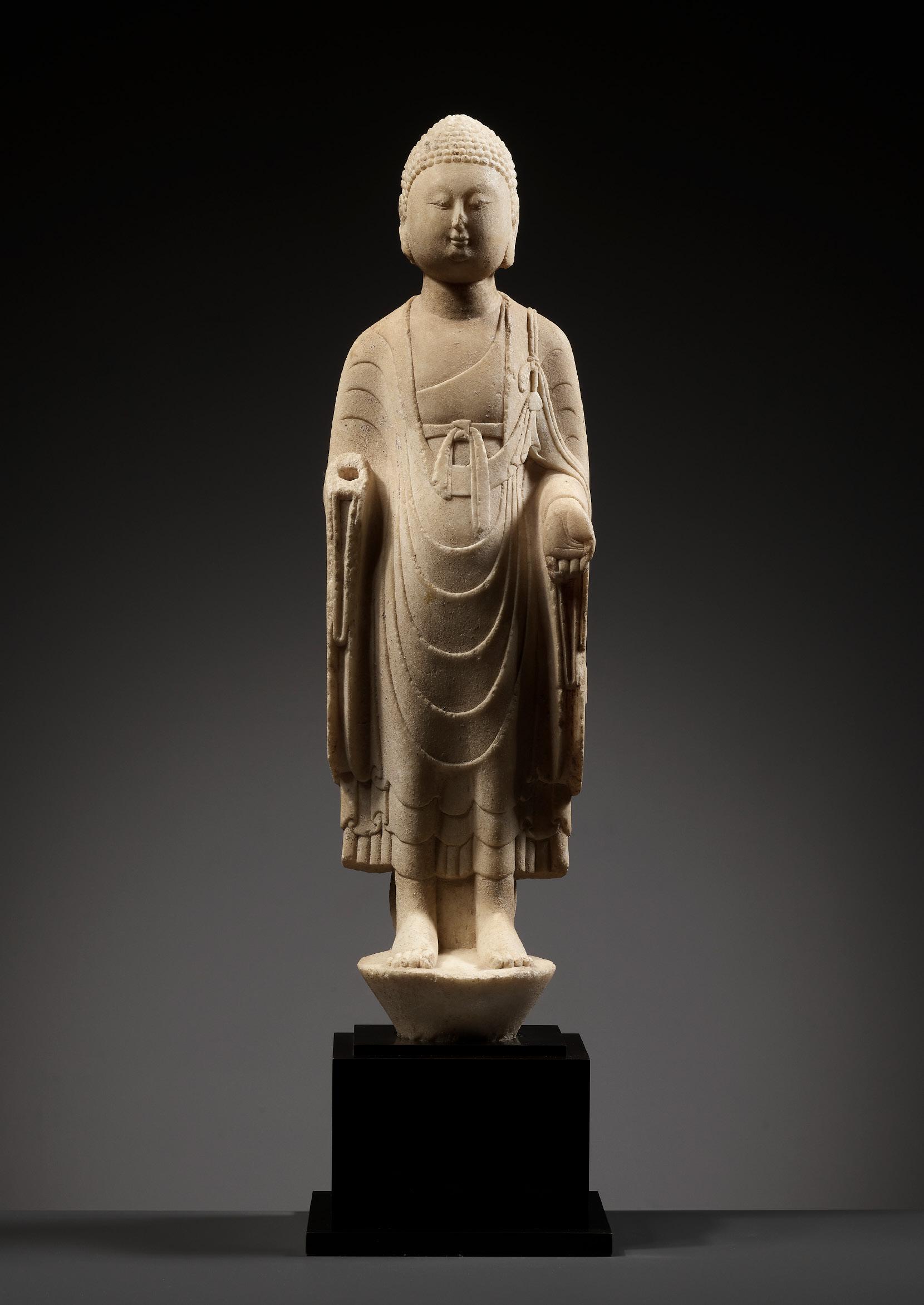
167
A WHITE MARBLE FIGURE OF BUDDHA, NORTHERN QI DYNASTY, CHINA, 550-577

Finely carved, standing with the left hand lowered in abhaya mudra, dressed in a long flowing monastic robe draped over both shoulders and rendered simply in descending rows of graceful U-shaped folds above the cascading hem. His serene face with heavy-lidded eyes and full lips forming a calm smile. The hair arranged in tight curls over the domed ushnisha.
Provenance: From a noted private collection in New York, USA, and thence by descent in the family. New York trade, by repute acquired from the above.
Condition: Good condition, commensurate with age. Extensive ancient wear, obvious losses, nicks, scratches, signs of natural weathering and erosion, encrustations, cracks, old repairs. Naturally grown patina overall, the originally white marble has acquired a fine ivory tone over the course of the centuries.
Weight: 14.3 kg (incl. stand)
Dimensions: Height 62.4 cm (excl. stand) and 68.5 cm (incl. stand) With a fitted metal stand. (2)
LITERATURE
COMPARISON
Compare a related marble figure of Buddha, dated to the late 6th century, 110 cm high, in the Minneapolis Institute of Arts, accession number 2000.207.
AUCTION RESULT COMPARISON
Type: Closely related
Auction: Bonhams San Francisco, 19 December 2016, lot 8198
Price: USD 47,500 or approx. EUR 55,500 converted and adjusted for inflation at the time of writing
Description: A rare carved stone figure of the Buddha, Northern Qi Period (550-577) CE


Expert remark: Compare the closely related subject, style, applied carving technique and form. Note the near-identical size (63.5 cm).
Estimate EUR 8,000
Starting price EUR 4,000
253
168
A MONUMENTAL HEAD OF VAIROCANA, THE PRIMORDIAL BUDDHA, CIRCA 500-800 AD
Expert’s note (part I): The present head is extraordinarily rare due to its exceptional size and history as part of a towering statue, likely standing around four meters tall, once gracing the exterior of a significant temple or cave shrine. It portrays a most important solely Buddhist subject, showcases a clear Gupta influence not seen in later Chinese sculpture, and was carved from red sandstone, a direct tribute to the art of Mathura. It therefore dates back to the Tang dynasty, if not considerably earlier, with a vanishingly small possibility of originating at the beginning of the Song dynasty. (part II of this expert’s note continues on p. 50)

Powerfully yet sensitively sculpted, the full rounded face is carved with soft bow-shaped lips, the elongated eyes elegantly delineated beneath gracefully arched brows, the hair in crisply carved curls. Surmounted by a tall crown with three figures in high relief representing the Buddhas of the past, present, and future, each seated in dhyanasana on a lotus throne.
Provenance: From the personal collection of J. J. Lally, New York, USA. With two labels from J. J. Lally, each inscribed with the number ‘4154’. James J. Lally was a renowned antique dealer and connoisseur, recognized as one of the greatest scholar-dealers of Chinese art, who has been a leader in the field for more than 40 years. After graduating from Harvard College and Columbia University, Lally joined Sotheby’s where he held many positions within the Chinese art department. In 1970, he served as the director of Chinese works of art at Sotheby’s in New York and Hong Kong, and by 1983 was named president of Sotheby’s in North America. In 1986 he founded his namesake gallery, J. J. Lally & Co., at 41 East 57th Street in New York – just a few blocks away from the MoMA, to provide advisory services for keen collectors. Lally fondly recalls the moment, not long after he opened his gallery, when a young man walked through the door with a Shang Dynasty gong—a bronze vessel shaped like a gravy boat—decorated with a dragon and tiger and in beautiful condition. It was, Lally described, “one of the most important objects I ever had in my hands.” The young man said he had inherited it from his father and was not really interested in Chinese art himself. He wanted to buy a sailboat and wondered if the gong was valuable enough to pay for that. “I was very happy to tell him that it was valuable enough to buy two sailboats,” Lally noted. The gallery helped to establish New York as a major center of commerce for Chinese art and allowed Lally to concentrate on his own specific interests, particularly early ceramics, ritual bronze vessels, archaic jade carvings and sculpture. Lally brought a learned approach to his work, publishing detailed, scholarly catalogues that have remained important reference guides within the field. This meticulous approach continued when he produced his own exhibitions and catalogues. Giuseppe Eskenazi, dubbed the “Godfather of Chinese Antiques,” and one of the world’s most esteemed Chinese art dealers, also spoke highly of Lally for his achievements in the industry, alongside William Chak from Hong Kong, and the Marchant family from London. In the spring of 2023, Christie’s and Bonhams conducted single owner sales of Lally’s collection which broke several auction records.
Condition: Excellent condition, commensurate with age. Old wear, encrustations, and erosion. Obvious losses, minor nicks and scratches. The originally rather porous sedimentary rock now almost completely smoothed out by more than a millennia of weathering and worship. Magnificent naturally grown patina overall, giving the stone a deep auburn color.
Weight: 120 kg (incl. stand)
Dimensions: Height 60.1 (excl. stand) and 95 cm (incl. stand)
With a fitted stand. (2)
254
James J. Lally, 1995

The Spring Temple Buddha, a colossal statue of Vairocana, in Lushan County, Henan, China. It has a total height of 153 meters, including the 25 meter lotus throne which the statue
Vairocana is a cosmic buddha from Mahayana and Vajrayana Buddhism. Vairocana is often interpreted, in texts like the Avatamsaka Sutra, as the dharmakaya, the unmanifested and inconceivable aspect, of the historical Gautama Buddha. In the conception of the Five Great Buddhas, Vairocana is at the center. He is the Primordial Buddha in the Chinese schools of Tiantai, Huayan, and Tangmi, which developed during the Sui and Tang dynasties. Vairocana is also seen as the embodiment of sunyata, the Buddhist concept of ‘emptiness’ or ‘nothingness’. In this regard, the massive size and brilliance of Vairocana statues serve as a reminder that all conditioned existence is empty and without a permanent identity, whereas the Dharmakaya is beyond concepts. The Spring Temple Buddha of Lushan County, Henan, China, depicts Vairocana and is the second tallest statue in the world with a total height of 153 meters
Expert’s note (part II):
Buddhist expansion in Asia: Mahayana Buddhism first entered Handynasty China through the Silk Road during the Kushan Era. The overland and maritime “Silk Roads” were interlinked and complementary, forming what scholars have called the “great circle of Buddhism”.

The present head draws its primary inspiration from the Gupta art of Northern India, which was centered in the city of Mathura. This influence is evident in Vairocana’s gracefully elongated eyes, soft full lips, and, notably, the use of red sandstone — a material rarely found in Chinese sculpture but widely used in the art of Mathura.
Mathura became India’s most important artistic production center from the second century BC (see fig. 1, the Mehrauli fragment of a Yakshi dated 150 BC in the National Museum of India, New Delhi), its highly recognizable red sandstone statues being admired and exported all over the region throughout the next 700 years (see fig. 2, a Kushan-period head of Buddha, 1st-2nd century, at Sotheby’s New York, 22 September 2005, lot 7), and its sculpture prospering and further evolving under the Gupta Empire (see fig. 3, a Gupta-period head of a Jina, mid-5th century, at Christie’s New York, 23 March 2010, lot 167).

A Tang-dynasty statue of Vairocana at the Fengxian Temple, Longmen Grottoes, Luoyang, Henan Province. The statue was completed in the year 676 and is 17.14 meters high.
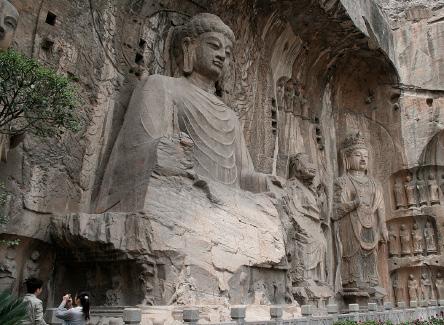
Buddhism made its way to China during the Han dynasty through the efforts of missionaries who utilized both the overland Central Asian Silk Road and maritime routes. An influential figure during this period was Lokaksema, a Kushan monk hailing from Gandhara, known for translating Buddhist texts into Chinese.
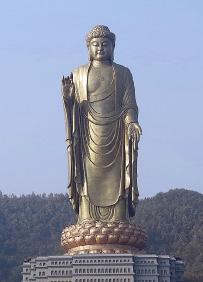
By the 460s, Buddhism was a mainstream institution in China, and its iconography and art were widely recognized. Particularly Northern Wei art came under influence of Indian and Central Asian traditions through the mean of trade routes. The rulers of the Northern Wei dynasty converted to Buddhism and became great patrons of Buddhist arts (see fig. 4, a limestone head of a bodhisattva, early 6th century, exhibited by J. J. Lally, Buddhist Sculpture from Ancient China, 10-31 March 2017, no. 5).
A limestone head of a bodhisattva, Northern Wei dynasty, early 6th century, exhibited by J. J. Lally, Buddhist Sculpture from Ancient China, 10-31 March 2017, cat. no. 5 (fig. 4)
A marble head of Buddha, Sui dynasty, at Christie’s New York, 24 September 2020, lot 809 (fig. 5)


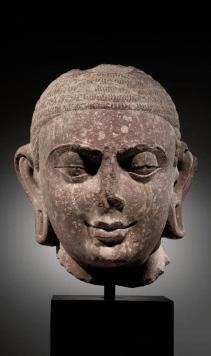
Buddhism then continued to flourish under the Sui dynasty, which unified the warring Northern and Southern dynasties during a period when central political control was limited and Buddhism created a unifying cultural force that uplifted the people out of war, leading to the rebirth of culture in China under the Sui dynasty (see fig. 5, a marble head of Buddha, at Christie’s New York, 24 September 2020, lot 809).
China’s sculptural tradition reached its most mature phase during the subsequent Tang dynasty, an era when monks and pilgrims frequently traveled to Northern India, the spiritual home of Buddhism, in a quest for knowledge and inspiration. The great artistic tradition of Gupta India increasingly provided a rich source of inspiration to Tang artisans (see fig. 6, a red sandstone head of a bodhisattva, 7th century, at Christie’s New York, 20 March 2015, lot 757).
A red sandstone head of a bodhisattva, Tang dynasty, 7th century, at Christie’s New York, 20 March 2015, lot 757 (fig. 6)
fig. 7
A limestone head of a bodhisattva, Northern Song dynasty, in the Los Angeles County Museum of Art, accession number M.71.73.114 (fig. 7
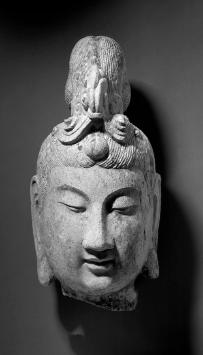
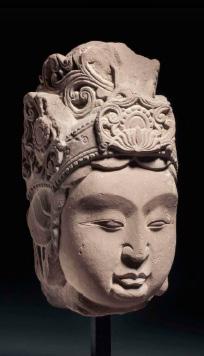
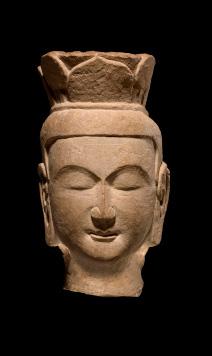
The important influence of this source began to wane quickly after the end of the Tang dynasty, when a decidedly Chinese style of sculpture emerged during the Song dynasty, influenced in part by the gradual embrace of the Neo-Confucian political ideology at court. Buddhism was combined with Taoism and Confucianism, making the religion more secularized and permeating the styles of both painting and sculpture of the time (see fig. 7, a limestone head of a bodhisattva, Northern Song dynasty, in the Los Angeles County Museum of Art, accession number M.71.73.114).
2010, lot 167 (fig. 3)
Estimate EUR 50,000
Starting price EUR 24,000
256
stands on.
The Mehrauli Yakshi dated 150 BC in the India National Museum, New Delhi (fig. 1)
A red sandstone head of Buddha, India, Kushan period, 1st-2nd century, at Sotheby’s New York, 22 September 2005, lot 7 (fig. 2)
A red sandstone head of a Jina, India, Mathura, Gupta period, mid-5th century, at Christie’s New York, 23 March
fig. 1 fig. 2 fig. 3
fig. 4 fig. 5
fig. 6
A POLYCHROME STUCCO FRESCO FRAGMENT DEPICTING A CELESTIAL MAIDEN, YUAN TO MING DYNASTY

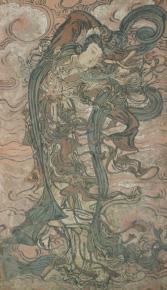
China, 13th-16th century. Finely painted in polychrome pigments with details picked out in gesso relief. Depicting a celestial maiden standing in front of a daybed decorated with floral and scroll designs, holding a sheng in front of her, dressed in flowing robes and billowing scarves of red, pale blue, ochre, and white, the head gently tilted downward, her face painted with delicate features, the hair tied into a high chignon with a fine ornament.
Provenance: From the collection of Dr. Wou Kiuan. Wou Lien-Pai Museum, coll. no. M.8.3. Dr. Wou Kiuan (1910-1997) was a Chinese diplomat and noted scholar of Chinese art. His father, Wou Lien-Pai (1873-1944), was one the leading political figures of early 20th century China, remembered for his role as speaker and leader of parliament during the turbulent years of the Republican era. Dr. Wou himself embarked on an illustrious career in diplomacy until his retirement in 1952, when he settled in London and devoted the rest of his life to the study of Chinese art. It was no doubt fortuitous that Dr. Wou’s years of collecting coincided with an abundant availability of exceptional Chinese art on the London market. From the mid-1950s to the late 1960s he was able to form a collection of well over 1,000 works that together represented virtually every category of Chinese art. At the heart of Dr. Wou’s drive to collect was a burning desire to preserve the relics of China’s rich historical past scattered across Europe, and to promote Chinese art and culture. It is unclear when Dr. Wou conceived the idea to create a place to house his collection, but in 196,8 he opened the doors to the Wou Lien-Pai Museum, named in honor of his father. Over the years the museum became a ‘must see’ destination for collectors, academics, and visiting dignitaries, and Dr. Wou would delight in leading his visitors through the galleries, recounting stories of China’s glorious history. Condition: Good condition, commensurate with age. Old wear and expected age cracks, minor losses and touch-ups. The frame with some wear, nicks, and scratches. Presenting very well overall.

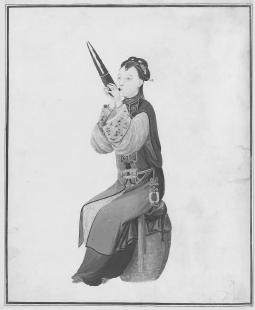
Dimensions: Image size 82.1 x 45.4 cm. Size incl. frame 90 x 53.8 cm
With a wood frame.
The style of the present fresco is inspired by the late Tang dynasty temple painting style. This is evident in the treatment of the roundness of the ‘melon-seed’-shaped faces and the swirling scarves, giving a dynamism to the work, which was popular amongst builders and decorators of Buddhist temples of the time and continued throughout the Song, Yuan and Ming dynasties.
The sheng is a Chinese mouth-blown polyphonic reed instrument consisting of vertical pipes. It is one of the oldest Chinese instruments, with images of the instrument dating back to 1100 BC. Some examples of the instrument are dated as far back as the Han dynasty. It is one of the main instruments in kunqu and some other forms of Chinese opera. Ancient instruments like the sheng with gourd wind chambers, varying numbers of pipes, or with bamboo or metal reeds have been discovered in archaeological finds at the tomb of the Marquis Yi of Zeng (c. 433 BC) in presentday Hubei province, and the Han tombs at Mawangdui (c. 2nd century BC) in Hunan province.
AUCTION RESULT COMPARISON
Type: Related
Auction: Sotheby’s New York, 11 September 2019, lot 816
Price: USD 37,500 or approx. EUR 40,500 converted and adjusted for inflation at the time of writing
Description: A polychrome stucco fresco fragment, Yuan / Ming dynasty
Expert remark: Compare the related figural motif and size (77.5 x 45.5 cm)
Estimate EUR 4,000
Starting price EUR 2,000
257
169
An 18th century painting of a maiden playing a Sheng. Metropolitan Museum of Art, accession number 1990.289.5
Dr. Wou Kiuan, Paris, November 1939
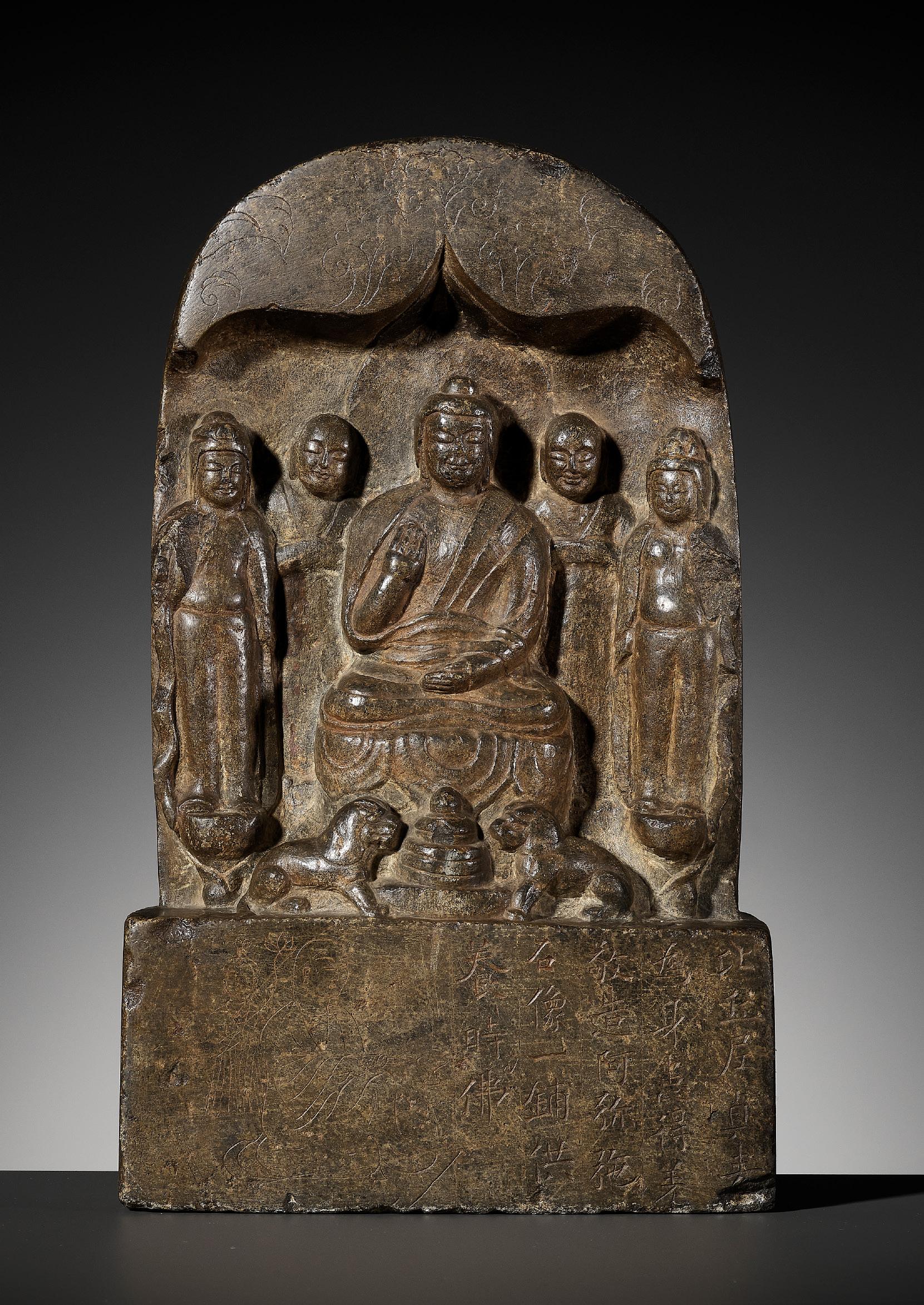
AN INSCRIBED BUDDHIST LIMESTONE STELE, TANG DYNASTY
China, 618-907. The arched stele deeply carved with a central Buddha seated in dhyanasana on a throne, with robes cascading in voluminous folds, flanked by two disciples as well as two bodhisattvas standing on lotus pedestals, all above a central stupa flanked by two Buddhist lions and below a canopy finely incised with foliate designs, all supported on a rectangular base neatly incised with an inscription as well as figures of monks.
Inscriptions: The bottom right corner of the base reads ‘Bhikkhuni Zhen […] commissioned the creation of the Buddhist triad for the sick.’
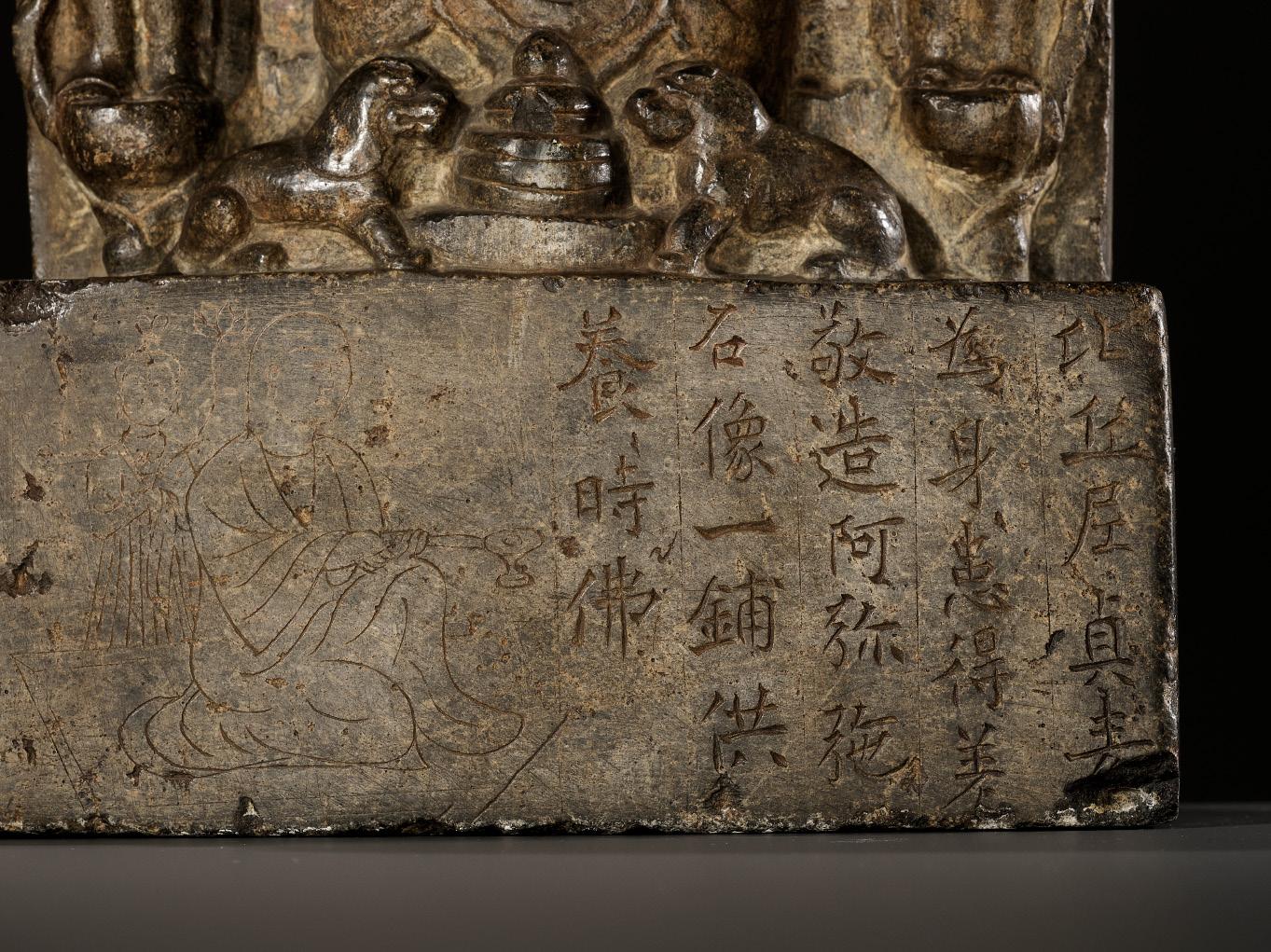
Provenance: From an old private estate near Copenhagen, Denmark, by repute acquired before the Second World War. Danish trade, acquired from the above.
Condition: Good condition, commensurate with age. Extensive wear, scratches, nicks, chips, minor losses, signs of weathering and erosion, the stone with natural fissures.
Weight: 17.8 kg
Dimensions: Height 37 cm
AUCTION RESULT COMPARISON
Type: Related
Auction: Sotheby’s Hong Kong, 1 April 2019, lot 3015
Estimate: 500,000 HKD or approx. EUR 63,000 converted and adjusted for inflation at the time of writing
Description: A rare limestone ‘Buddhist triad’ stele, Tang dynasty, 618-907
Expert remark: Note the smaller size (26.4 cm) and the arched form of the stele.
AUCTION RESULT COMPARISON
Type: Related
Auction: Christie’s New York, 15 September 2017, lot 918
Price: USD 11,250 or approx. EUR 13,000 converted and adjusted for inflation at the time of writing
Description: Grey limestone Buddhist stele, Tang Dynasty, 618-907
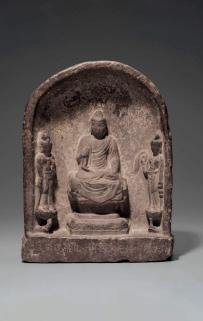
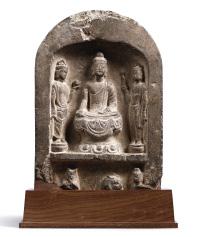
Expert remark: Note the related size (34.6 cm), compare the dedicatory inscription written along the rectangular base of the stele.
Estimate EUR 6,000
Starting price EUR 3,000
259 170
A LIMESTONE TORSO OF A BODHISATTVA, TANG DYNASTY
China, early 8th century. The slender, elegant figure well carved standing in a subtle tribhanga pose, wearing a clinging diaphanous skirt falling in graceful folds, with scarves tied diagonally around the torso and draped from the shoulders, richly adorned with elaborate jewelry including beaded and foliate necklaces as well as pendent ornaments of floral design. The gray limestone with hues of maroon and a superb, naturally grown patina overall.
Provenance: From the personal collection of Ed Hardy, who is an American artist known for his strong influence on the development of modern tattoo styles, and his eponymous apparel and accessories brand. He became recognized for being the main driver in incorporating ancient Asian tattoo aesthetics and techniques into Western styles of work, taking tattoos from a fringe culture into the mainstream.
Condition: Good condition, commensurate with age. Extensive wear, losses, nicks, scratches, a minor structural crack with an associated old fill (only visible under strong blue light), signs of weathering and erosion, encrustations. Overall displaying exceptionally well.
Weight: 39.9 kg (incl. stand)
Ed Hardy at a signing for his book Wear Your Dreams, West Hollywood, 2013

Dimensions: Height 58.5 cm (excl. stand) and 67.4 cm (incl. stand)
With a modern metal stand. (2)
Expert’s note: The 5th-century Gupta influence on Tang Buddhist sculpture is manifest in the sensuously rounded body of the present lot, together with the diaphanous robes and jewelry. Two related Tang Dynasty bodhisattvas, standing in contrapposto and currently residing in the Zhengzhou Museum, published in Annette Juliano’s Treasures of Ancient China in 1981 (see image section), were unearthed at the site of the Dahai Monastery in Xingyang County, Henan Province. The folds to the robes, the simplified jewelry over the outlined pectorals, and the slightly forward abdominal bulge are all similar to the current lot, which may originate from the same region.
LITERATURE COMPARISON
Stylistically, the present figure relates most closely to some of the Tianlongshan figures. Compare a related sandstone figure from Tianlongshan, Shanxi Province, 101.6 cm high, dated approx. 700-750, in the Asian Art Museum of San Francisco, object number B60S6+ (fig. 1). The present figure is also related to some of the larger figures from Longmen, such as the standing bodhisattva in a similar pose, with U-shaped drapery folds and roll of material at the waist, illustrated in Longmen Liusan Diaoxiang Ji (The Lost Statues of the Longmen Caves), Shanghai, 1993, p. 71, no. 78. Compare a similar stone figure of a bodhisattva illustrated by O. Siren, Kinas Kunst Under Tre Artusenden, vol. 2, Stockholm, 1943, fig. 73A. For a related figure in white marble with more elaborate realization of the drapery and with one foot placed slightly forward, see the figure from Longyenshan, Hebei, illustrated by W. Willetts, Foundations of Chinese Art, London, 1965, p. 222, fig. 139.
AUCTION RESULT COMPARISON
Type: Closely related
Auction: Christie’s New York, 22 March 1999, lot 162
Price: USD 134,500 or approx. EUR 218,000 converted and adjusted for inflation at the time of writing
Description: A rare well-carved gray stone torso of a bodhisattva, Tang dynasty, early 8th century
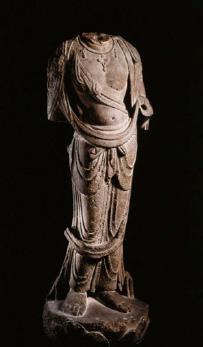
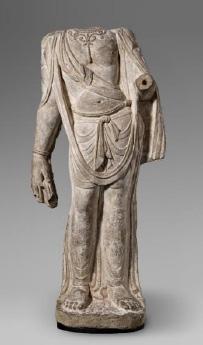
Expert remark: Compare the closely related pose, drapery, and folds. Note the related size (63.5 cm).
Estimate EUR 20,000
Starting price EUR 10,000
fig. 1
260 171

A GILT-BRONZE FIGURE OF AVALOKITESHVARA, LIAO DYNASTY, CHINA, 907-1125
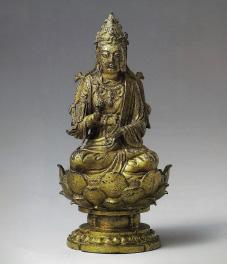
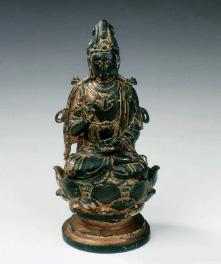
Two Scientific Analysis Reports: A technical examination was conducted by Podany Conservation Services, LLC, Los Angeles. The report concludes: ‘The bronze casting (Figure 1) exhibits no clear evidence of modern origin/manufacture.’ A copy of the signed examination report, dated 4 March 2021, accompanies this lot. A metal alloy analysis was conducted by Antiques Analytics, Institute for Scientific Authenticity Testing, Dr. Robert Neunteufel, Germany. The report concludes: ‘The results of the metal analysis are not in contradiction to a manufacture within the Liao Dynasty.’ A copy of the signed examination report, dated 19 May 2023, accompanies this lot.
Superbly cast, seated on a lotus pedestal atop a stepped lobed base, the right hand held in vitarka mudra and the left in avakasha mudra, the bodhisattva clad in cascading loose robes falling in voluminous folds. The serene face with heavy-lidded almond-shaped eyes and lips rendered in a gentle smile, flanked by a pair of pendulous earlobes, all below an elaborate headdress with an incised miniature Amitabha enclosing a high chignon with tresses falling on the shoulders.
LITERATURE COMPARISON
Compare a closely related smaller figure of Avalokiteshvara in the Museum of East Asian Art, Bath, dated to the Liao dynasty, accession no. BATEA: 277 (fig. 1). Also compare a closely related Liao dynasty Avalokiteshvara illustrated in ‘Imprints of Buddha: Buddhist Art in the National Palace Museum Collection’, in the National Palace Museum Taipei, pp. 148-149, no. 62 (fig. 2). Compare a related gilt-bronze figure of Liao dynasty Avalokiteshvara seated on a lotus pedestal, in the Palace Museum, Beijing, published in Classics of the Forbidden City: Guanyin in the Collection of The Palace Museum, Beijing, 2012, pl. 26. Also compare related Avalokiteshvara in the Rijksmuseum, Amsterdam, published in Hai-Wai Yi-Chen: Chinese Art in Overseas Collections, Buddhist Sculpture I, Taipei, 1998, pl. 146.
AUCTION RESULT COMPARISON
Type: Closely related
Auction: Sotheby’s Hong Kong, 1 April 2019, lot 3104
Estimate: HKD 300,000 or approx. EUR 37,500 converted and adjusted for inflation at the time of writing
Description: A rare gilt-bronze figure of Avalokiteshvara Liao Dynasty
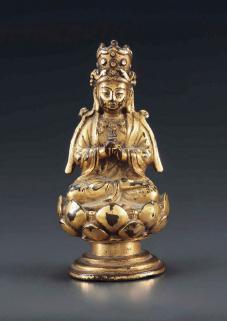
Expert remark: Compare the closely related form. Note the similar size (19 cm). Also note the almost complete loss of gilt.
AUCTION RESULT COMPARISON
Provenance: From the collection of Michael Phillips (*1943), the Academy Award-winning film producer. Born in Brooklyn, New York, his parents were Lawrence and Shirley Phillips, noted New York dealers in Asian fine art, selling to the Met, the LACMA, the Chicago Art Institute, and the British Museum among others. Michael Phillips is a collector of Asian art himself, particularly Indian, Southeast Asian, and Himalayan sculpture. His most important films include The Sting (winning the Academy Award for Best Picture in 1973), Taxi Driver (winning the Palme d’Or at the 1976 Cannes Film Festival), and Steven Spielberg’s Close Encounters of the Third Kind.
Condition: Good condition with expected wear to gilt and some casting irregularities as expected. Small dents and losses, shallow surface scratches, a very minor old repair to the back. Naturally grown patina overall, with some distinct and solid malachite encrustations. To the base, a small hole drilled for metal sampling.
Weight: 744.1 g
Dimensions: 18.4 cm
Avalokiteshvara is the successor of Buddha Amitabha and will continue to deliver living beings from sufferings when Amitabha attains nirvana. The crown with the miniature Amitabha, like the one shown here, is a key feature of Avalokiteshvara iconography.
This free-seated image is an example of classic Liao style, and the modeling of the body is voluminous. The figure has an oval face, refined features, and a solemn expression. The hair, crown, and jewelry are rich with minute detailing. Sumptuous attire and a lotus throne with thick petals are often seen in Liao dynasty statutes. The torso is elongated, and the meandering design of the drapery forms linear patterns.
Type: Closely related
Auction: Christie’s New York, 17 September 2008, lot 392
Estimate: USD 74,500 or approx. EUR 97,000 converted and adjusted for inflation at the time of writing
Description: A Rare Small Gilt-Bronze Figure of Buddha, Liao Dynasty (907-1125)
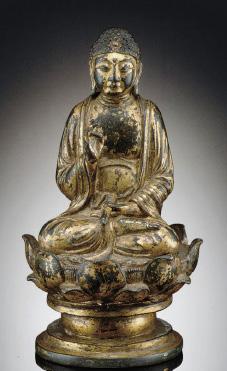
Expert remark: Compare the closely related form, casting, incision work, and the naturally grown patina overall. Note the smaller size (14 cm). Also note that the gilt is worn off, most similarly as on the present lot.
AUCTION RESULT COMPARISON
Type: Closely related
Auction: Christie’s New York, 18 March 2016, lot 1408
Estimate: USD 81,250 or approx. EUR 86,000 converted and adjusted for inflation at the time of writing
Description: A Small Gilt-Bronze Figure of Buddha Vairochana, Liao Dynasty (AD 9071125)

Expert remark: Compare the closely related form. Note the much smaller size (9 cm).
Estimate EUR 15,000
Starting price EUR 7,500

262 172
fig. 1
fig. 2
Michael Phillips and Queen Elizabeth II

173
A GILT-BRONZE FIGURE OF A LAMA ON A STEPPED THRONE, TIBET, 13TH - 14TH CENTURY
Finely cast, the lama sits atop a stepped pedestal with rosettes, floral decorations, and two Buddhist lions beneath an exquisite, beaded double-lotus throne. The patchwork robes of the lama are exceptionally fine, the hems decorated with minuscule and extremely fine beadwork all over. He is seated in vajraparyankasana, his right hand extended in bhumisparsha mudra and his left held in samadhi mudra, his face set with a meditative expression and a distinct widow’s peak. The base bears the double vajra symbol.
Provenance: From a German private collection.
Condition: Very good condition with expected old wear and casting irregularities, minor rubbing to the gilding, occasional light scratches, and small dents. The back of the base with a rectangular aperture for a mandorla, which is lost. The base is sealed.
Weight: 1,466 g
Dimensions: Height 15.8 cm
The present bronze likely depicts an important early lama from a period when Buddhism was flourishing and expanding in Tibet. The sculpture’s combination of a lotus pedestal and a waisted plinth underneath the lama was a popular device in Central Tibet between the 13th and 15th centuries. It was particularly used by the Kagyu order and was recreated in the sculptures of the Densatil Monastery.
LITERATURE COMPARISON
Compare U. von Schroeder, Buddhist Sculptures in Tibet, volume 2, page 1186, number 320A. Also compare a related bronze figure of a lama seated on a stepped pedestal, 14.3 cm high, dated to the 13th century, in Tsuglakang Temple, Lhasa, illustrated on Himalayan Art Resources, item no. 57364.
AUCTION RESULT COMPARISON
Type: Closely related
Auction: Christie’s, 11 September 2019, lot 344
Price: USD 18,750 or approx. EUR 20,000 converted and adjusted for inflation at the time of writing
Description: A gilt-bronze figure of Buddha Shakyamuni on a stepped throne, Tibet, 14th century Expert remark: Compare the closely related modeling with a similar lotus base and stepped throne, albeit depicting Buddha Shakyamuni. Note the slightly smaller size (13.7 cm).
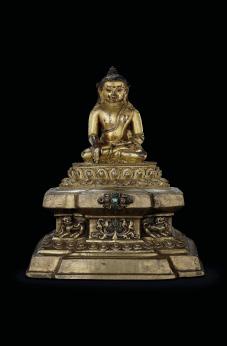
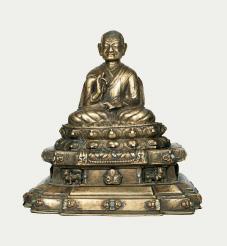
Estimate EUR 15,000
Starting price EUR 7,500
264
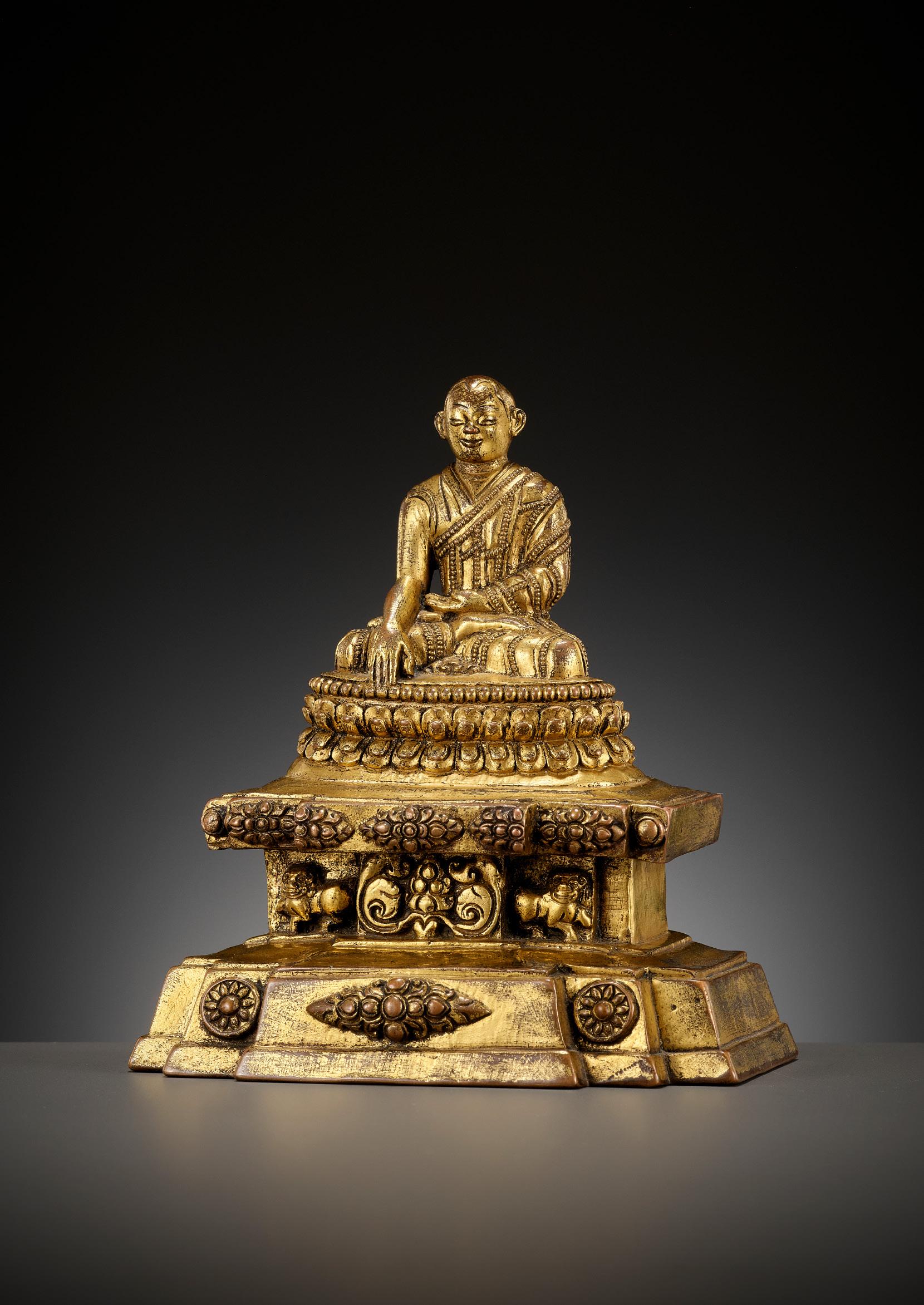

A LARGE BRONZE FIGURE OF RATNASAMBHAVA, CENTRAL TIBET, 13TH-14TH CENTURY
Finely cast, seated in dhyanasana atop a double lotus base with a beaded upper rim, his right hand held in varada mudra and the left lowered above his lap, wearing a sheer dhoti, billowing scarves and richly adorned with elaborately designed jewelry. His serene face with sinuously lidded eyes, neatly incised brows centered by a rhombic urna, the hair piled up into a high chignon behind the distinct five-leaf tiara.
Provenance: From a private collection in France, by repute acquired before 1983. The property of a nobleman, acquired from the above. Himalayan Art Resources, item no. 24860.
Condition: Good condition, commensurate with age. Expected old wear, predominantly from centuries of worship within the culture. Minor casting flaws, small dents, minuscule nicks, light scratches, some losses. The seal plate has been replaced with a wooden panel. The face with remnants of gilt. Ancient remnants of pigment. A good, naturally grown patina overall.
Weight: 2,517 g
Dimensions: Height 33.7 cm
Ratnasambhava is one of the Five Dhyani Buddhas (or Five Meditation Buddhas) of Mahayana and Vajrayana or Tantric Buddhism. Ratnasambhava’s mandalas and mantras focus on developing equanimity and equality and, in Vajrayana Buddhist thought is associated with the attempt to destroy greed and pride. Ratnasambhava is associated with the skandha of feeling or sensation and its relationship with consciousness. His activity in promoting Buddhism is enriching and is increasing the knowledge of Dharma. Ratnasambhava is associated with the jewel symbol, which corresponds to his family. His right hand grants wishes. He presides over the South, his element is earth, his sense is smell, and his color is yellow. It seems that he was the least popular of the group of five cosmic Buddhas, and for this reason large statues of him are exceedingly rare
Expert’s note: The present lot belongs to a group long considered to originate from western Tibet. However, more recent scholarship suggests this type of early Tibetan sculpture is more likely to be from the central regions, where the primary stylistic influence up to around the 13th century was the art of Kashmir and eastern India during the late Pala period.
Tibetan bronzes with Pala influence are mostly un-gilded, like the majority of their Indian antecedents. Tibetan sculpture after the 14th century, however, is increasingly modeled and gilded in the Nepalese manner.

LITERATURE COMPARISON
Compare two closely related hollow-cast brass figures of Ratnasambhava, one 42 cm high, the other 27 cm, with silver and copper inlays, both attributed to Western Tibet and dated to the 13th century, illustrated in Ulrich von Schroeder, Indo-Tibetan Bronzes, Hong Kong, page 180, figs. 34A and 34B. Compare a related silver and copper-inlaid brass figure of Ratnasambhava, 42.3 cm high, attributed to western Tibet and dated to the 14th century, in the Tibet Museum Fondation Alain Bordier, accession number ABS 032 (fig. 1). fig. 1
AUCTION RESULT COMPARISON
Type: Related
Auction: Christie’s New York, 22 March 2011, lot 375
Price: USD 194,500 or approx. EUR 247,000 converted and adjusted for inflation at the time of writing
Description: A bronze figure of Buddha Vairocana, Tibet, 14th century

Expert remark: Compare the closely related pose, dress, jewelry, expression, hairstyle, and crown. Compare also the related subject, depicting another of the Five Dhyani Buddhas, and lotus base. Note the related size (30.5 cm).
AUCTION RESULT COMPARISON
Type: Closely related
Auction: Christie’s New York, 23 March 2010, lot 222
Price: USD 56,250 or approx. EUR 73,500 converted and adjusted for inflation at the time of writing
Description: A bronze figure of Ratnasambhava, Western Tibet, 14th/15th century

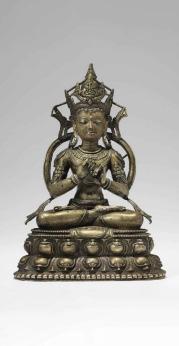
Expert remark: Compare the closely related subject, pose, hand gestures, dress, jewelry, lotus base with beaded upper rim, expression, hairstyle, and crown. Note the gemstone inlays, silver-inlaid eyes, and slightly larger size (38.1 cm).
AUCTION RESULT COMPARISON
Type: Related
Auction: Zacke, 9 March 2023, lot 169
Price: EUR 41,600
Description: A large bronze figure of Ratnasambhava, Central Tibet, 13th-14th century
Expert remark: Compare the closely related subject, pose, hand gestures, dress, jewelry, lotus base with beaded upper rim, expression, hairstyle, and crown. Note the related size (31 cm).
Estimate EUR 20,000
Starting price EUR 10,000
267 174
175
A GILT AND TURQUOISE-INLAID COPPER ALLOY
FIGURE OF GREEN TARA, DENSATIL STYLE, TIBET, 14TH CENTURY

Elegantly cast, seated in lalitasana on a double-lotus base with beaded edges, her pendent right leg supported by a separate lotus blossom stemming from the base. Her right hand held in in varadamudra extending down her leg and her raised left holding a lotus stem which curls around her hand and arm coming to full bloom at the shoulder.
Provenance: From an old German private collection. Condition: Remarkably well-preserved condition. Old wear, predominantly from centuries of worship within the culture, with some rubbing and minor losses to gilt. Minimal casting flaws, nicks and dents, occasional light scratches. Losses and possible replacements to inlays. Warping and dents to seal plate. The bronze with a fine, naturally grown, smooth patina overall.
Weight: 908.1 g
Dimensions: Height 16.2 cm
She is clad in a dhoti neatly incised with rows of floral designs and a finely beaded hem, and richly adorned with a foliate crown, beaded necklace, belt, armlets and bracelets, and pendent earrings, all with fine turquoise inlays.
Her serene face with sinuously-lidded, downcast eyes below elegantly arched brows, her full lips forming a calm smile, her hair pulled up into a high chignon and falling elegantly in a twisted strand over her right shoulder and back.
Heavily cast gilt copper alloy figures of this type are characteristic of the Densatil style, a Kagyu monastic complex in central Tibet, southeast of Lhasa, which has long been considered one of the great treasures of Tibet. Founded in the late 12th century, it enjoyed generous patronage and was lavishly decorated during a period of expansion from circa 1360 until the early 16th century. The monastery was known for eight extraordinary memorial stupas symbolizing Buddha’s first teaching in Benares. These stupas were called tashi gomang, meaning ‘many doors of auspiciousness,’ and were multi-tiered copper-alloy structures filled with deities such as the present example, standing more than ten feet tall and resplendent with inlays of semiprecious stones. Prior to the destruction of Densatil during China’s Cultural Revolution (1966-1978), eight of them dating between 1208 and 1432 stood in the monastery’s main hall.
EXPERT’S NOTE
Close stylistic parallels can be drawn between the present work and a number of gilt bronze sculptures produced by Newari craftsmen for the Densatil Monastery. Chief among the diagnostic traits that can identify a work from Densatil are the convexly stepped eyebrows and the precisely incised double-lined eyelids and lips. For example, compare a gilt bronze Padmapani figure, Densatil, 14th century, at Bonhams Paris, 14 June 2022, lot 44, from the Claude de Marteau collection.

The present lot
AUCTION RESULT COMPARISON
Type: Related
Auction: Bonhams Hong Kong, 21 April 2021, lot 12
Price: HKD 4,002,500 or approx. EUR 483,000 converted and adjusted for inflation at the time of writing
Description: A gilt copper alloy figure of Tara, Tibet, Densatil style, circa 14th century Expert remark: Compare the related style, subject, manner of casting, and modeling with similar pose and hand gestures, and adornments with similar turquoise inlays and fine beading. Note the similar size (17 cm).

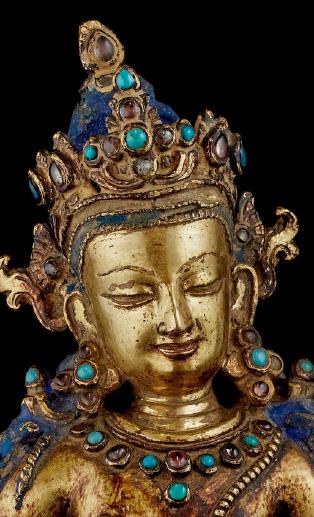
Estimate EUR 20,000
Starting price EUR 10,000
268
Tara, ex Claude de Marteau collection
The lower section of a Tashi Gomang stupa at Densatil, image taken in 1948 by Pietro Mele

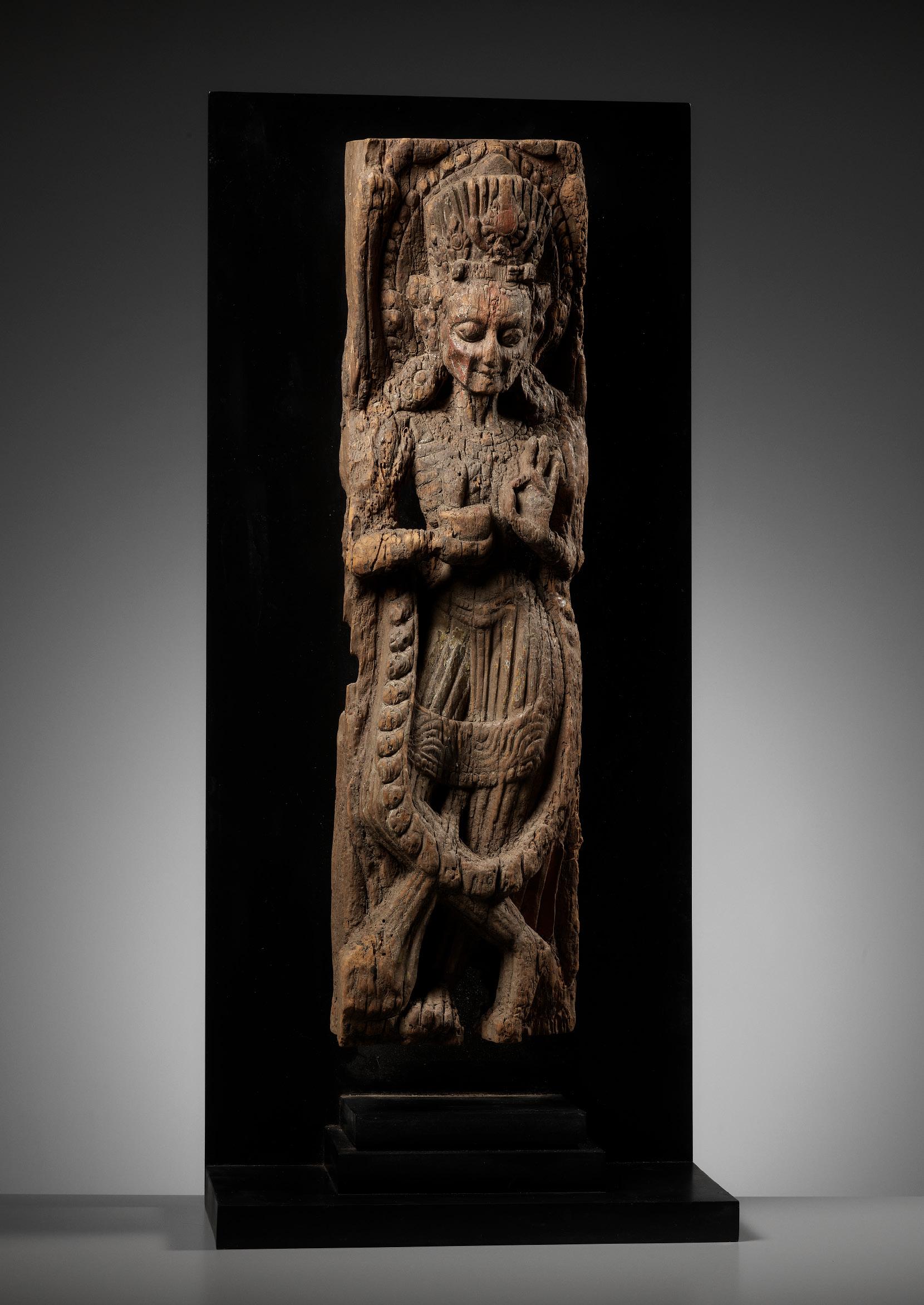
A RARE CARVED WOOD TEMPLE STRUT (VIGRAHA) DEPICTING A YOGINI
Nepal, 13th-14th century or earlier. Finely carved standing in tribhanga, the left hand raised in the healing gesture of prithvi mudra, the right holding a skull cup. The emaciated body adorned with a garland of severed heads, the gaunt face with large eyes protruding from cavernous sockets, the head surmounted by an elaborate tiara.
Provenance: From the estate of Richard S. Ravenal (1927-2022), Livingston Manor, New York, USA. The former owner of both the Asian Gallery in New York, Richard Ravenal was an avid collector and connoisseur of East Asian antiquities. Pieces formerly in his possession can be found today in several prominent institutions, including the Brooklyn Museum.
Condition: Good condition, commensurate with age. Ancient wear, expected age cracks and splits, losses, signs of weathering and erosion, minor worming, nicks, scratches. Overall presenting remarkably well. A magnificent, naturally grown patina overall.
Weight: 13.4 kg (incl. stand)
Dimensions: Height 73 cm (excl. stand) and 88.5 cm (incl. stand)
Mounted on a fitted stand. (2)
Nepalese temple struts, known as tunala or vigraha, are considered fine works of art and are often made by highly skilled craftsmen using traditional techniques. They are an important part of the cultural heritage of Nepal and can be found in many different styles and designs throughout the country. These struts are found in traditional Nepalese architecture, particularly in religious structures such as temples and shrines, ornately carved and often painted, serving both structural and symbolic purposes.
Structurally, the struts help support the roof of the temple or shrine, which is made of heavy timber or stone. The struts are typically placed at regular intervals along the eaves of the roof, and their weight helps to counterbalance the weight of the roof, making the structure more stable.
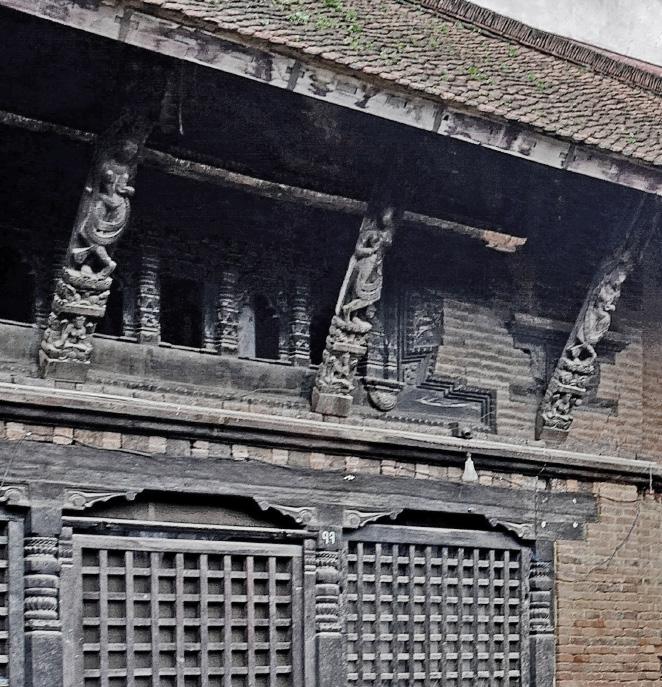
Symbolically, the struts are often carved with intricate designs and figures from Nepalese mythology, and are believed to have religious significance. They are thought to represent various deities or supernatural beings, and are intended to offer protection and blessings to the structure and its occupants.
Literature comparison: Compare a related wood temple strut depicting a yakshi, 128 cm high, dated to the 13th century, formerly in the Art Gallery New South Wales, accession number 33.2000.a-b, recently repatriated to Nepal in May 2003 and currently on display at the Patan Museum. Compare a related wood temple strut depicting Varaha, 74.5 cm high, dated to the 15th century, previously in the James W. and Marilynn Alsdorf Collection and now in the Art Institute of Chicago, reference number 1984.1495. See a comparable set of temple struts dated to the 15th century, still in place at Gunakar monastery in Jyatha Tol, Chhusyabaha, Kathmandu, Nepal.
AUCTION RESULT COMPARISON
Type: Related
Auction: Christie’s Amsterdam, 8 May 2001, lot 531
Price: NLG 25,850 or approx. EUR 18,500 converted and adjusted for inflation at the time of writing
Description: A Nepalese wood temple strut, circa 14th century
Expert remark: Compare the related manner of carving. While the present lot appears significantly older than the Christie’s example, both have comparable iconography. The Christie’s example also shows that the current lot may possibly be missing a lower portion. Note the size (101 cm).
AUCTION RESULT COMPARISON
Type: Related
Auction: Bonhams Paris, 15 December 2022, lot 154
Estimate: EUR 50,000 or approx. EUR 51,500 converted and adjusted for inflation at the time of writing
Description: A sandalwood figure of Lokeshvara, Nepal, 11th/13th century

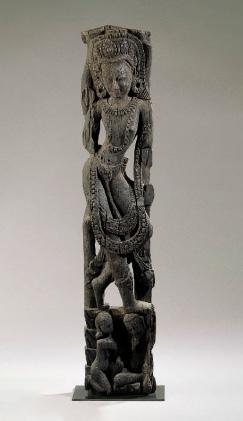
Expert remark: Compare the related manner of carving. Note the size (66 cm).
Estimate EUR 6,000
Starting price EUR 3,000
271
176
See a comparable set of temple struts dated to the 15th century, still in place at Gunakar monastery in Jyatha Tol, Chhusyabaha, Kathmandu, Nepal

A LARGE WOOD FIGURE OF SONGZI GUANYIN AND CHILD, CHINA, EARLY MING DYNASTY, 14TH-15TH CENTURY
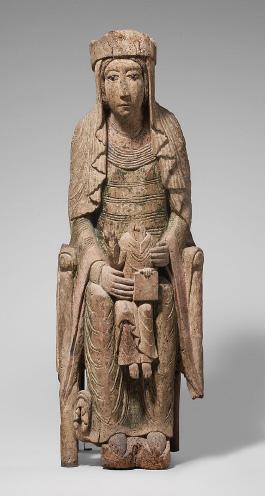
Boldly carved as Guanyin with hair piled up into a high topknot beneath her flowing cowl, holding a child seated in her lap, both wearing voluminous robes with deeply carved folds, their faces with wide heavy-lidded eyes, broad noses, and full lips. The soft wood of an attractive grain with a rich, naturally grown patina overall.
Provenance: From an old private collection on the Upper East Side of Manhattan, New York, and Bridgehampton, NY, acquired before 1979, and thence by descent in the family. A copy of a signed insurance declaration, on the letterhead of the Chubb Group, dated 25 August 1978, describing the present lot as an ‘Unusual Large Wooden Figure of Kuan Yin’, accompanies this lot.
Condition: Extensive wear, weathering and erosion, worming, losses, chips, and natural imperfections including age cracks. The condition of this statue is commensurate with age and contributes to its unique beauty. The aged wood has seen extensive weathering, which displays exceptionally well.
Weight: 13.8 kg (incl. stand)
Dimensions: Height 92.5 cm (excl. stand) and 95.2 cm (incl. stand)
With a fitted wood stand. (2)
EXPERT’S NOTE
This lot offers an astounding example of the symmetry between two separate worlds – Imperial China and medieval Europe, Western Christianity and Eastern Buddhism – with similar archetypes of imagery illustrating compassion and emotion. Compare the famous wood sculpture of the Enthroned Virgin and Child from the Cloisters Collection, 102.9 cm high, dated ca. 1130-1140, in the Metropolitan Museum of Art, accession number 47.101.15 (fig. 1). Compare also two wood sculptures from 13th century France depicting the Virgin Mary and infant Jesus, 68.6 cm and 79.5 cm high, in the Metropolitan Museum of Art, accession numbers 67.153 and 16.32.194a, b. fig. 1
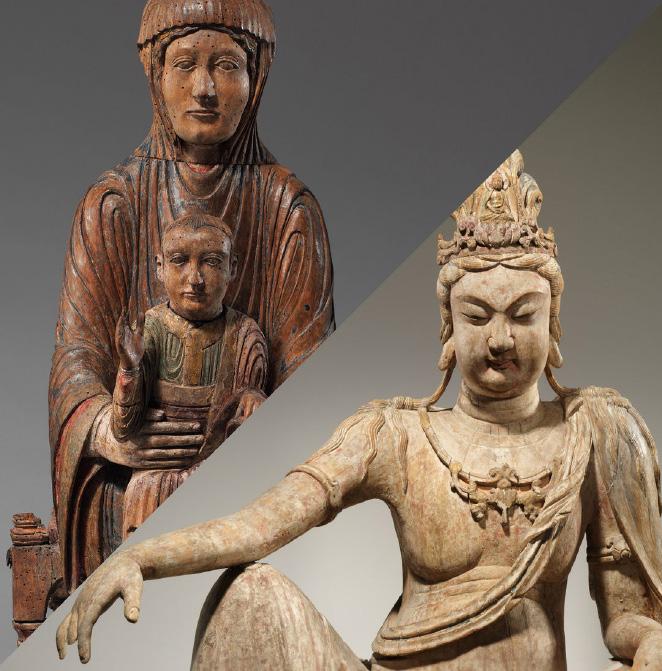
The Songzi representation of Guanyin, or the ‘Bringer of Sons,’ is identifiable by the boy seated on her knee. Male children were extremely important to Confucian family structure. They ensured not only the continuity of family and clan, but that there would be uninterrupted generations to carry on the rituals of ancestral worship. The Child-Giving Guanyin was prayed to by worshipers for healthy children and intelligent male heirs. Extant depictions of Songzi Guanyin from the later Ming dynasty are known in various materials, including bronze, wood, stone, and ivory, but such an early example must be considered extremely rare
Estimate EUR 8,000
Starting price EUR 4,000
Quoted from Compassion, Mercy, and Love: Guanyin and the Virgin Mary - How two independent cultures – feudal Europe and imperial China – depicted divine figures with incredible visual similarities.’ By Kevin D. Pham, Metropolitan Museum of Art, New York, May 7, 2021.
‘The Virgin Mary’, Jesus Christ’s mother, was a popular focus of personal devotion in western Christianity. She was often depicted with her infant child, emphasizing her role as a holy maternal figure and mediator between humanity and the divine. Through this easily understood archetype, she became a popular intercessor for devout Christians across Medieval Europe, where various types of ‘Virgin and Child’ works of art proliferated.
Guanyin is the Chinese translation of Avalokiteshvara, the bodhisattva of compassion. Bodhisattvas are enlightened beings who chose to stay on earth as accessible examples for Buddhist faithful to follow. Originally depicted as a male or gender-neutral entity able to take on thirty-three manifestations, Avalokiteshvara is a compassionate savior who hears the woes of humankind, regardless of age, gender, or social class. However, in imperial China, Guanyin became increasingly cemented as a female figure. Similar to the Virgin Mary, Guanyin became a popular intercessor for humanity to understand divine salvation.
Enthroned Virgin and Child (1150-1200), currently on display at The Met Cloisters, is a counterpart to a sculpture from about 1175 to 1200 included in the exhibition Crossroads: Power and Piety. In both sculptures, mother and child are rendered in a stiff and rigid form that typifies the theological concept Sedes Sapientiae or “Throne of Wisdom.” The infant Jesus, depicted as a diminutive mature figure rather than a child, represents divine wisdom and is seated upon the Virgin, who acts as his throne. Both the Virgin and Child’s emotionless expressions, coupled with the strongly linear symmetry, suggest the timeless permanence of divine authority in the Christian context.
‘During the Middle Ages – a period of over one thousand years –people of various cultures across the world practiced independent religious faiths, ranging from western feudal Europe to imperial China, while also maintaining cross-cultural exchange. Surprisingly, certain works of art in both western Christian and eastern Buddhist cultures seem to share visual similarities. Both contexts produced images of divine figures that represent concepts like compassion, mercy, and love: the Virgin Mary in medieval Europe, and Guanyin in imperial China.’
The eleventh-century Bodhisattva Avalokiteshvara in Water Moon Form (Shuiyue Guanyin), currently on display in the Met Gallery 208, depicts Avalokiteshvara in a relaxed, leisurely pose, with one knee raised and the other crossed in front. This posture represents the “Water Moon” manifestation of the bodhisattva in his personal paradise. Avalokiteshvara is adorned within an ornate crown and necklace. Relaxed but strong and formative, Avalokiteshvara beckons the audience forward, ready to hear the cries of the world.
Both of these sculptures would have been placed in public churches or temples. The Virgin and Child also might have been carried in religious processions outside the architectural setting of the church, while Avalokiteshvara would likely have been shown at a monastery altar. Despite their different poses, both figures convey a divinity distinctly removed from the real experiences of mortal humans.’
273 177
178
A STUCCO HEAD OF BUDDHA, YUAN TO MING DYNASTY
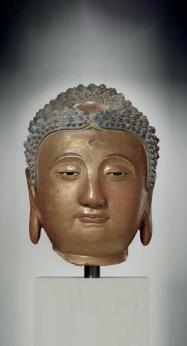
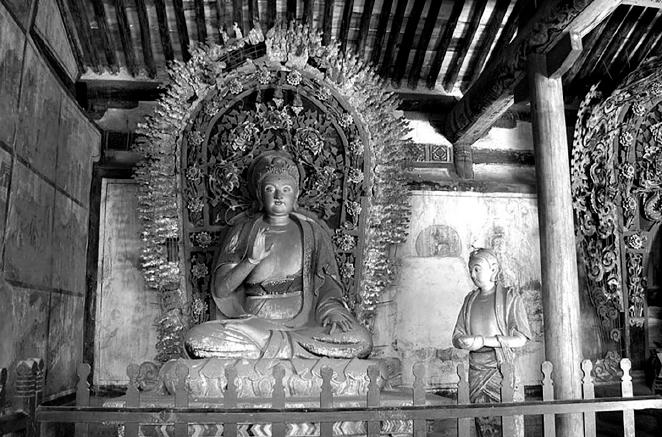
China, 14th-15th century. Well modeled with full cheeks and a serene expression, marked by heavy-lidded downcast eyes finely inlaid with black glass pupils, below arched brows centered by a recessed urna, above a broad nose and bow-shaped lips, flanked by long pendulous earlobes. The hair is arranged in tight snail-shell curls over the ushnisha.
Provenance: French trade. By repute, acquired from an old private estate.
Condition: Good condition, commensurate with age, displaying remarkably well. Extensive wear, obvious losses and flaking to the stucco, small chips and nicks, minor structural fissures, possibly small old repairs and/or touchups. Remnants of ancient pigments. Solid, naturally grown patina overall.
Weight: 19.2 kg (incl. stand)
Dimensions: Height 32.5 cm (excl. stand) and 44.5 cm (incl. stand)
With an associated stand. (2)
Several features link this head to similar sculptures from the Yuan and Ming Dynasties in Shanxi province. The whorls of hair on this lot are painted blue, parting in the middle of the forehead, leading to a domed ushnisha. The ushnisha is free of hair and was previously painted red. Similar features are illustrated in Zhongguo meishu quanji – diaosu 6 Yuan Ming Qing diaosu, Beijing, 1988, pp. 63, no. 67, and pp. 91, no. 99. Similar in situ buddhas are still present in the temples in the Pingyao Ancient City in Shanxi.
AUCTION RESULT COMPARISON
Type: Related
Auction: Christie’s New York, 22 March 2007, lot 228
Price: USD 57,600 or approx. EUR 78,000 converted and adjusted for inflation at the time of writing
Description: A massive painted and gilt-lacquered stucco head of Buddha, Yuan/Ming dynasty, 14th15th century
Expert remark: Compare the closely related modeling with similar expression, facial features, and hair. Note the lacquer gilding and larger size (82.6 cm).
Estimate EUR 6,000
Starting price EUR 3,000
274
A seated Buddha from the Ming dynasty in the Hall of the Three Buddhas, Zhenguo Temple, Pingyao, Shanxi

A GILT COPPER ALLOY FIGURE OF AMOGHASIDDHI, ONE OF THE FIVE WISDOM BUDDHAS, POSSIBLY DENSATIL, TIBET, 14TH-15TH CENTURY
Expert’s note:
The present sculpture dates from the fourteenth or early fifteenth century and is modelled in Nepalese style with the diaphanous robe clinging to the muscular body. The alloy with its rather high copper content and distinct copper-red color, the extra thick casting and the well-defined lotus petals are common traits of sculpture typically associated with the famed monastery of Densatil. Furthermore, close comparison can be drawn with the present lot’s squared face, convexly stepped eyebrows, double-lined eyelids and lips, and sinuous upper lid with those of several Densatil figures in public and private collections (see comparisons below).
The relatively simplistic form and lack of ornamentation is not common at Densatil, however, photographic evidence captured by Pietro Mele in 1948 shows closely related Buddha statues set against cast back panels in the fourth tier of the Tashi Gomang stupa. The base of the figure has been resealed with a simple metal plate, a fact that could indicate that it may once have been part of a larger supporting structure, such as Tashi Gomang stupa, from which it was forcibly removed. The many small traces of violence, see condition report below, could further support the theory that this figure may indeed have been one of the victims of the destruction of Densatil during China’s Cultural Revolution (1966-1978).
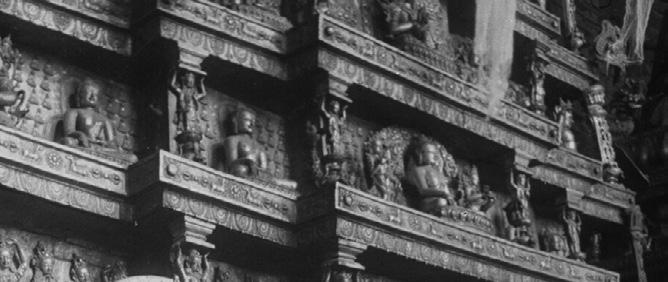
Densatil was a Kagyu monastic complex in central Tibet, southeast of Lhasa, that has long been considered one of the great treasures of Tibet. Founded in the late 12th century, it enjoyed generous patronage and was lavishly decorated during a period of expansion from circa 1360 until the early 16th century. The monastery was known for eight extraordinary memorial stupas symbolizing Buddha’s first teaching in Benares. These stupas were called tashi gomang, meaning “many doors of auspiciousness,” and were multi-tiered copper-alloy structures filled with deities such as the present example, standing more than ten feet tall and resplendent with inlays of semiprecious stones. Prior to the destruction of Densatil, eight of them dating between 1208 and 1432 stood in the Monastery’s main hall.
Followers of the charismatic Phagmo Drupa Dorje Gyalpo (1110–1170) constructed the Densatil Monastery. His school, which came to be known as Phagmo Drupa Kagyu, was one of the four primary schools of the Kagyu lineage of Tibetan Buddhism. Its noble house became so powerful that their dynasty ruled from the mid-fourteenth to the mid-fifteenth century. Eventually it had died out by the end of the seventeenth century, but the Densatil Monastery survived intact under the control of other Tibetan Buddhist schools until it was eventually destroyed. Today the monastery is undergoing reconstruction thanks to the efforts of the Tibetan Autonomous Region Ministry of Culture and the Drigung (Drikung) Kagyu school.
Literature comparison: Compare the seated unadorned Buddhas made by Newar craftsmen seen in photographs of Densatil monastery taken by Pietro Mele in 1948, see O. Czaja and A. Proser, Golden Visions of Densatil, New York, 2014, pp. 18-19. Compare a related bronze figure of Buddha Vajrasana, 34.1 cm high, dated to the 14th century, illustrated in Ulrich von Schroeder’s book Buddhist Sculptures in Tibet, Vol. 2, Hong Kong, 2001 pp. 1062-1063, no. 271D, and note that this figure has also been resealed with a metal plate. Compare two Densatil figures of Amoghasiddhi and Akshobhya in the The Berti Aschmann Foundation Collection, see Uhlig, On a Path to Enlightenment, Museum Rietberg, Zurich, 1995, pp. 74-75. Compare a related figure of Akshobhya Buddha from Densatil, 30.5 cm high, dated late 14th to early 15th century, in the National Museum of Art, Smithsonian Institution, accession number S2012.6.
Finely cast seated in dhyanasana on a double lotus pedestal atop a stepped plinth, his right hand raised in abhaya mudra above his left lowered in dhyana mudra, the tapering waist wrapped in a sheer monastic robe, gathering elegantly in remarkably well executed folds at his feet and over the left shoulder. His serene face with heavylidded downcast eyes below gently arched brows centered by a raised circular urna. His hair arranged in tight curls over the domed ushnisha topped by a jewel.
Provenance: West Berkshire, United Kingdom, local trade. By repute acquired from a private estate.
Condition: Good condition, commensurate with age, showing expected old wear and casting flaws, scattered dents, light rubbing to gilt, tiny nicks here and there. Minor losses, minimal cracks, the fingers of one hand bent back slightly, due to heavy impact. A distinct stress crack at the lower end in front of the figure. The base resealed with a metal plate.
Weight: 3,492 g
Dimensions: Height 26.2 cm
This fine sculpture depicts the Presiding Buddha Amoghasiddhi, whose name means, “He Whose Accomplishments Are Not in Vain”. Amoghasiddhi, identified by his hand gesture of reassurance (abhaya mudra), exemplifies a Buddha’s transcendence over jealousy. He is one of the Five Wisdom Buddhas (Tathagatas) of the Mahayana and Vajrayana tradition of Buddhism and as part of the five, this sculpture would have been joined by representation of the other four Tathagatas, exactly as seen in the fourth tier of the Tashi Gomang stupa in Densatil. His consort is Tara, meaning ‘liberator’, and he is often depicted mounted on Garuda. He belongs to the family of karma whose family symbol is the double vajra.
AUCTION RESULT COMPARISON
Type: Closely related
Auction: Bonhams New York, 17 March 2014, lot 16
Price: USD 461,000 or approx. EUR 543,000 converted and adjusted for inflation at the time of writing
Description: A gilt copper alloy figure of Buddha, Tibet, probably Densatil, early 15th century
Expert remark: Compare the closely related extra thick casting, modeling with near-identical facial features and diaphanous robe, and size (26.7 cm). Note the different hand posture and more compressed lotus petals to the base.
AUCTION RESULT COMPARISON
Type: Related
Auction: Bonhams New York, 23 September 2020, lot 618
Price: USD 250,075 or approx. EUR 267,000 converted and adjusted for inflation at the time of writing
Description: A gilt copper alloy figure of Buddha, Tibet or Nepal, circa 14th century
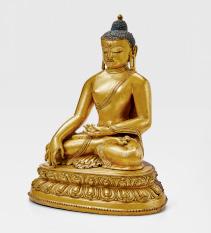
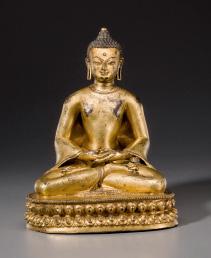
Expert remark: Compare the related thick casting, solid gilding, and modeling with a similar diaphanous robe gathering in double folds to the base. Note the different pose, incised hems, sinuous eyebrows, and slightly larger size (31.5 cm).
Estimate EUR 30,000
Starting price EUR 15,000
276 179
Detail of a photo by Pietro Mele of the Tashi Gomang stupa, taken in 1948 before the destruction of Densatil, showing related Buddhas set against cast back panels. Ethnographic Museum at the University of Zurich; VMZ402-00-0513


MAITREYA IN THE TUSHITA HEAVEN, AN EXTREMELY RARE GILT-BRONZE FIGURE, XUANDE INCISED SIX-CHARACTER MARK AND OF THE PERIOD, CHINA, 1425-1435

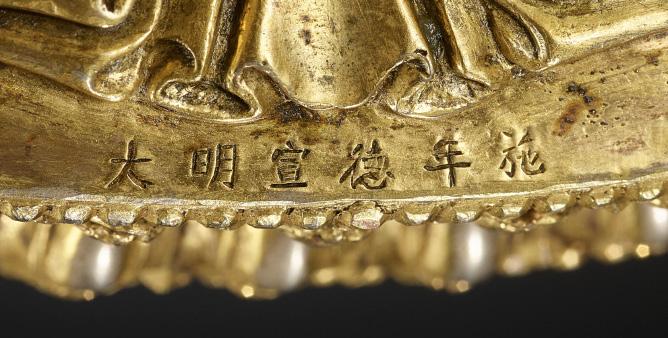
Expert’s note: Maitreya is visualized here in his manifestation as a princely bodhisattva, teaching in the Tushita heaven, thus with his hands held in dharmachakra mudra, the teaching pose (turning the wheel of the second law), after which Maitreya will leave the Tushita heaven and come upon earth to ‘establish the lost truths in all their purity.’ Maitreya’s face is imbued with compassion, the essential quality of the bodhisattva, with a downward gaze and gentle smile. Maitreya is the only Boddhisattva who is popular among all sects of Buddhism, such as the Mahayana, the Hinayana, and the Vajrayana, and he is often shown with his long hair hanging over his shoulders, such as in the present portrayal.

Superbly cast, the bodhisattva seated in vajraparyankasana on a double-lotus base with beaded edges, his hands held in dharmachakra mudra, wearing a dhoti with exquisitely carved folds gathered at the waist and fastened by a beaded girdle and a scarf around the bare shoulders flowing over the arms, revealing the chest adorned with beaded pendent jewelry. The upper surface of the base is engraved with a six-character mark da Ming Xuande nian shi and of the period.
Provenance: Spink & Son, London, United Kingdom, c. 1966. Adrian Maynard, London, United Kingdom, acquired from the above and thence by descent within the family. A noted Hungarian collector, acquired from the above after 2015. Adrian Maynard joined Spink & Sons in 1947, where he was appointed Director from 1962 and eventually Deputy Chairman until his retirement in 1984. He was a man of enormous drive and undoubtedly the most flamboyant character to take charge of the Asian art department, which he took to the height of its success. Maynard believed firmly that “a dealer, whose fortune and good name depends on knowing what to buy, has a much greater responsibility to be right about the objects that come into his hands than, say, an academic, who never handles large sums of money.”

Condition: Good condition with expected old wear. Minimal casting flaws, few minuscule nicks, and remnants of old pigment and varnish. The base retains the original sealing.
Weight: 1,520 g
Dimensions: Height 18.2 cm
Maitreya is richly adorned with further fine bodhisattva jewelry including a foliate crown framing the forehead and tied with billowing sashes at the ears, circular studded earrings, and beaded bracelets, armbands, anklets, and foot adornments. The serene face with a benevolent expression, the eyes with heavy sinuous lids below gently arched brows centered by a raised circular urna. The smiling mouth with full bow-shaped lips, the neatly incised hair drawn up in a knotted jatamakuta topped by a cintamani jewel and falling elegantly in tresses to the shoulders. The base is sealed with a plate, neatly incised with a visvavajra emblem.
279 180
Adrian Maynard
A Tibetan depiction of Maitreya, the hands held in teaching pose
During the Yuan Dynasty in the 13th and 14th centuries, the authority of Mongol rulers had become closely associated with Tibetan Buddhist or Lamaist rituals. At the beginning of the 15th century, the Buddhist fervor of the Ming court encouraged a cultural exchange between Tibet and China through Imperial patronage. Bronze sculptures in the Tibeto-Chinese style were first produced during the reign of Emperor Yongle (1403-1424) and are highly distinguished for their unsurpassed craftsmanship, overall refinement, and gracefulness.
Emperor Yongle (1403-1425), a devout Buddhist himself, bestowed generous patronage to Buddhist monasteries and artistic ateliers, fostering the production of artworks depicting Tibetan Buddhist deities and imagery in a highly refined style, executed with the highest level of technical mastery. Gilt bronzes were commissioned from the Imperial workshops in Beijing for personal religious practices and as gifts for the many Tibetan emissaries invited to the court.
Fewer examples bear the reign mark of Xuande (1425-1435) and the present lot is closely related to its Yongle predecessors, both stylistically and technically. The present figure was made at the Imperial ateliers in Beijing, probably during the early phase of the Xuande period, by the same craftsmen who continued their work from the Yongle period.
Literature comparison: Very few other figures of Maitreya from this group of reign-marked, early-15th-century gilt-bronzes have been published. Compare a related Yongle-marked gilt-bronze figure of Maitreya illustrated in Ulrich von Schroeder, Buddhist Sculptures in Tibet, Hong Kong, 2001, vol. II, pl. 343F. Compare a related Yongle-marked gilt-bronze figure of Maitreya illustrated in The Chang Foundation, Buddhist Images in Gilt Metal, Taipei, 1993, cat. 22. Compare a related Yongle-marked gilt-bronze figure of Maitreya illustrated in Ulrich von Schroeder, Indo-Tibetan Bronzes, Hong Kong 1981, 147E (later restored without a vase and now in the Aschmann collection). For a related Xuande-marked gilt-bronze figure of Vajrasattva, see The Complete Collection of Treasures of the Palace Museum, Buddhist Statues of Tibet, p. 230, no. 219.
AUCTION RESULT COMPARISON
Type: Related
Auction: Christie’s Hong Kong, 9 July 2020, lot 2702
Price: HKD 4,325,000 or approx. EUR 516,000 converted and adjusted for inflation at the time of writing
Description: A very rare and finely cast giltbronze figure of Maitreya, incised Yongle sixcharacter presentation mark and of the period
Expert remark: Compare the closely related subject, modeling, pose, expression, hair, robes, jewelry, and base, as well as the closely related manner of casting and gilding. Note the Yongle reign mark and the related size (20 cm).
AUCTION RESULT COMPARISON
Type: Closely related
Auction: Sotheby’s Hong Kong, 7 October 2010, lot 2144
Price: HKD 6,020,000 or approx. EUR 989,000 converted and adjusted for inflation at the time of writing
Description: A fine and rare gilt-bronze seated Maitreya, mark and period of Yongle
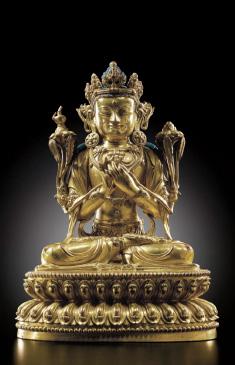
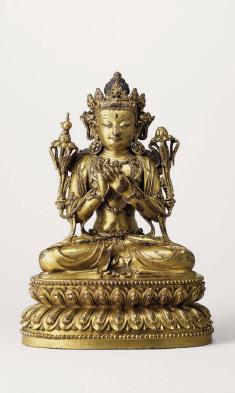
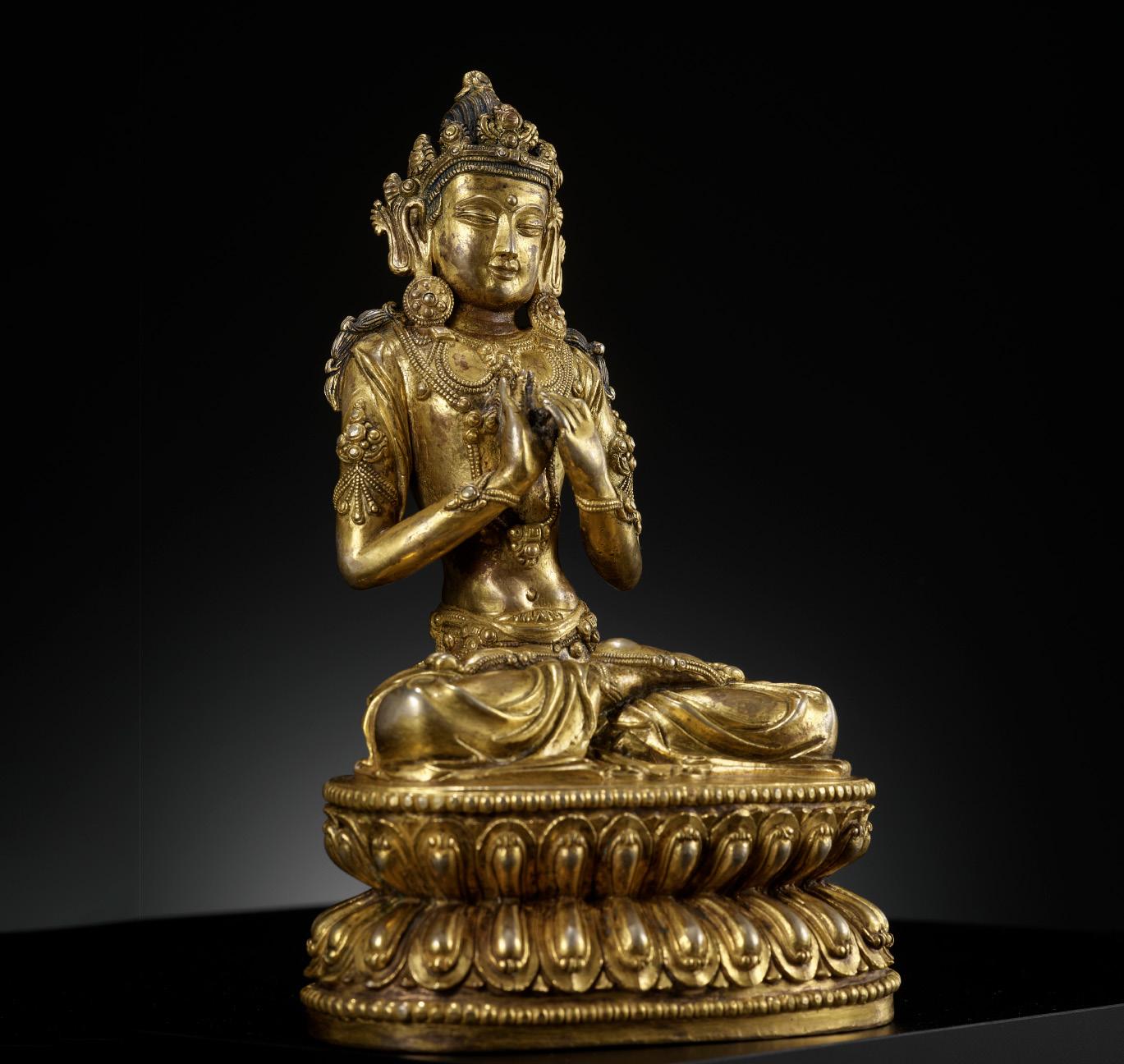
Expert remark: Compare the closely related subject, modeling, pose, expression, hair, robes, jewelry, and base, as well as the closely related manner of casting and gilding. Note the Yongle reign mark.
Estimate EUR 150,000
Starting price EUR 75,000
280
AN EXTREMELY RARE SILVER-INLAID ‘FUDING DING’ BRONZE TRIPOD CENSER,

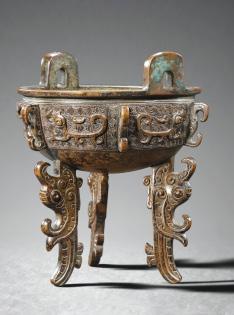
SONG TO MING DYNASTY
China, 960-1644. Of archaic ding form, the bowl cast with shallow rounded sides supported on three tall bird-shaped legs, the rim set with two upright loop handles. Finely inlaid in remarkably thin silver wire to the body with bands of scroll, raised bosses and geometric designs against leiwen grounds, stiff pendent leaves enclosing key-fret and S-scrolls, and to the legs with further scroll designs. The bronze with a fine, naturally grown patina with scattered malachite encrustations.
Provenance: From the collection of Dr. Wou Kiuan. Wou Lien-Pai Museum, coll. no. T.5.6. Dr. Wou Kiuan (1910-1997) was a Chinese diplomat and noted scholar of Chinese art. His father, Wou Lien-Pai (1873-1944), was one the leading political figures of early 20th century China, remembered for his role as speaker and leader of parliament during the turbulent years of the Republican era. Dr. Wou himself embarked on an illustrious career in diplomacy until his retirement in 1952, when he settled in London and devoted the rest of his life to the study of Chinese art. In 1968, he opened the doors to the Wou Lien-Pai Museum, named in honor of his father. Over the years the museum became a ‘must see’ destination for collectors, academics, and visiting dignitaries, and Dr. Wou would delight in leading his visitors through the galleries, recounting stories of China’s glorious history.

Condition: Good condition with expected old wear, some corrosion and casting irregularities, few minuscule nicks, light scratches, small dents, and few losses to inlays.
Weight: 298.4 g
Dimensions: Height 10.3 cm
LITERATURE COMPARISON
This finely cast bronze vessel is after late Shang and early Western Zhou period archaic ding. Compare a Western Zhou bronze censer of this form, dated 11th-10th century BC, preserved in the National Museum of Asian Art, Smithsonian Institution, accession number S1987.20 (fig. 1). The hemispherical body, handles and flattened legs of this censer relate to several bronze tripod censers of Shang dynasty date, illustrated by Robert W. Bagley in Shang Ritual Bronzes in the Arthur M. Sackler Collections, Arthur M. Sackler Foundation, 1987, pp. 448-51, figs. 80.2-80.4, no. 81 and fig. 81.1. For further examples, see one in the Palace Museum, Beijing, illustrated in Bronzes in the Palace Museum, Beijing, 1999, pl. 86, standing on related birdform feet; and the late Shang dynasty bronze fangding, its legs cast as birds standing on their long tails, illustrated in Ancient Chinese Bronzes from the Stoclet and Wessén Collections, Eskenazi London, 1975, cat. nos. 2.
fig. 1
AUCTION RESULT COMPARISON
Type: Related
Auction: Sotheby’s Hong Kong, 3 April 2012, lot 155
Price: HKD 275,000 or approx. EUR 42,500 converted and adjusted for inflation at the time of writing
Description: An archaistic bronze censer, Ming dynasty
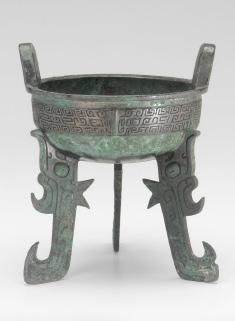
Expert remark: Compare the closely related form. Note the complete lack of inlay decoration.
Estimate EUR 4,000
Starting price EUR 2,000
281 181
Dr. Wou Kiuan, Paris, November 1939
A COPPER-INLAID COPPER ALLOY FIGURE OF DEVI, NEPAL, 10TH-11TH CENTURY
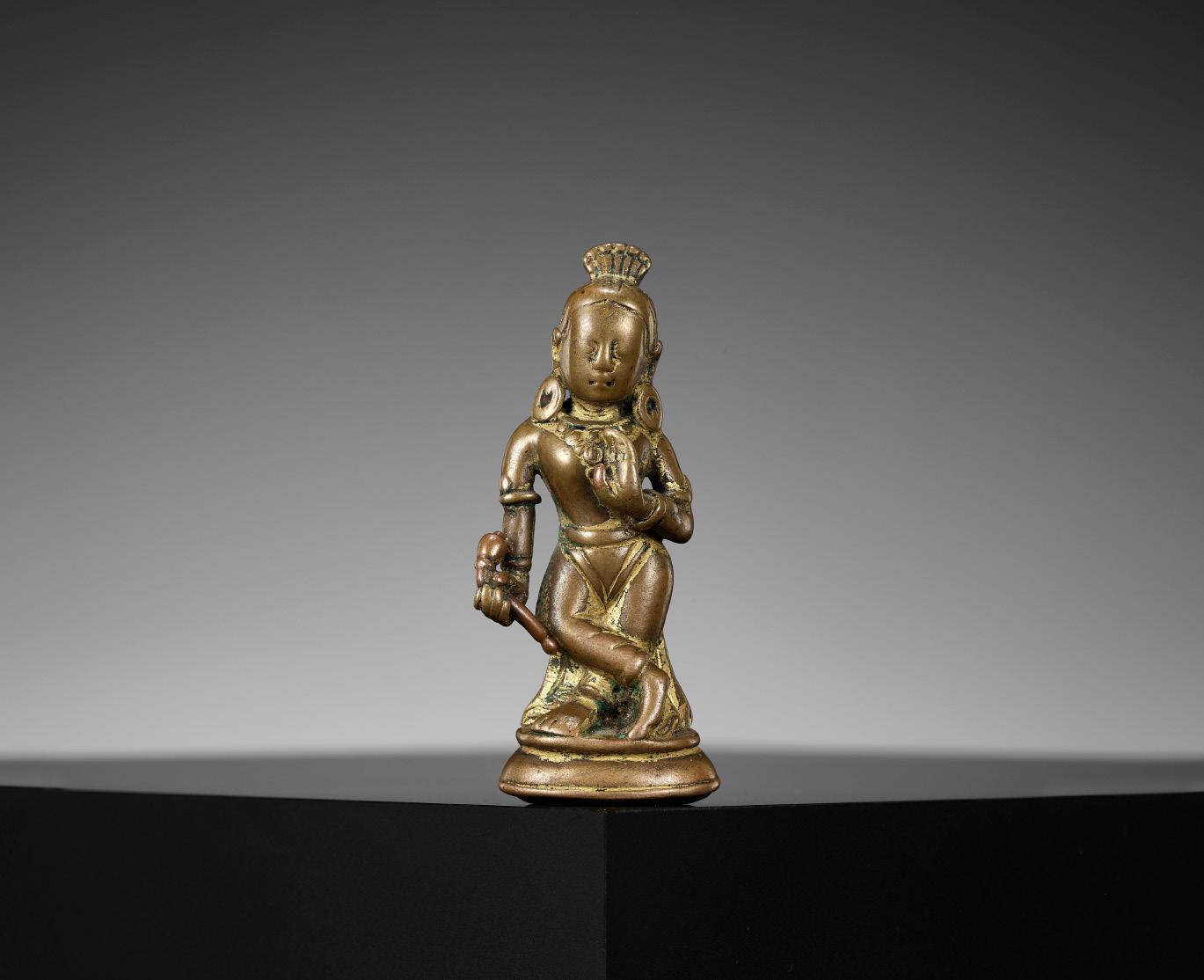


Expert’s note: The remarkable degree of wear originating from sustained ritual procedures is a common trait of the earliest Nepalese sculpture that is directly handled during worship. With the features almost worn smooth, the present figure’s divine face has taken on an additional ethereal trait, amplifying her divine qualities.
Elegantly cast standing on a pedestal with her legs crossed, shifting her weight to the right, holding a copper-inlaid lotus stem in her right hand, her dhoti drawn tightly over her thighs and neatly incised, her body richly adorned with beaded jewelry, the hair pulled back with a jeweled crown atop.
Provenance: Wiener Kunstauktionen, Vienna, Austria, 29 September 1994, lot 1124. Collection of Maria and Johannes Nickl, acquired from the above and thence by descent in the same family. A copy of the original invoice from Wiener Kunstauktionen, dated 29 September 1994, describing the present lot as a figure of Devi, confirming the dating above, and stating a purchase price of ATS 22,196 (or approx. EUR 3,000 adjusted for inflation at the time of writing), accompanies this lot. Maria (1926-2022) and Johannes Nickl (d. 2020) lived in Vienna, Austria, and were ardent collectors of Asian, Buddhist, and Egyptian works of art. They were highly active in Vienna’s tight-knit Asian art trade and assembled most of their collection during the 1980s and 1990s, frequently buying from Galerie Zacke and later Galerie Asboth. The couple were also noted museum patrons and their names are still found on the Ehrentafel (‘Roll of Honor’) of the Egyptian and Near Eastern Collection at the Kunsthistorisches Museum Wien (Museum of Fine Arts Vienna) today.

Condition: Good condition with extensive wear, predominantly from centuries of worship within the culture. Remnants of gilt. Tiny nicks, losses, and light scratches. The base with an old fill.
Weight: 102.9 g
Dimensions: Height 8 cm
As Lakshmi, Parvati, and Tara are all known to hold the lotus seed as an attribute, Devi (the Sanskrit word for goddess) is an encompassing term that refers to the goddess regardless of her many forms. Having had several names during her long published history, statues such as the present lot have most commonly been identified as Devi on the basis of the ambiguity of her lone attribute, the lotus seed or gem.
AUCTION RESULT COMPARISON
Type: Related
Auction: Bonhams Hong Kong, 7 October 2019, lot 924
Price: HKD 250,625 or approx. EUR 32,000 converted and adjusted for inflation at the time of writing
Description: A gilt copper figure of Surya, Nepal, circa 10th century
Expert remark: Compare the closely related manner of casting, copper alloy material, and extensive wear. Note the slightly larger size (11.6 cm).
AUCTION RESULT COMPARISON
Type: Related
Auction: Christie’s New York, 19 March 2014, lot 1037
Price: USD 12,500 or approx. EUR 15,000 converted and adjusted for inflation at the time of writing
Description: A bronze figure of Padmapani, Nepal, Licchavi period, circa 10th century
Expert remark: Compare the related style, material, casting technique and wear from worship within the culture. Note the slightly larger size (10.8 cm).
Estimate EUR 3,000
Starting price EUR 1,500
282 182
A LIMESTONE STELE OF VISHNU, LATE MALLA, THREE KINGDOMS PERIOD
Nepal, 1520-1768. Finely carved as Vishnu standing in samabhanga atop a lotus base, holding a conch shell, battle club, lotus bud and war discus in his four hands, wearing a richly incised dhoti pleated to the front. The body adorned with elaborate jewelry, including armlets, wristbands, and foliate earrings. His face with heavy-lidded eyes below gently arched brows and slender lips forming a calm smile, backed by a halo. Embellished with a vanamala (long floral garland) reaching his knees, the relief is set within a foliate arch.
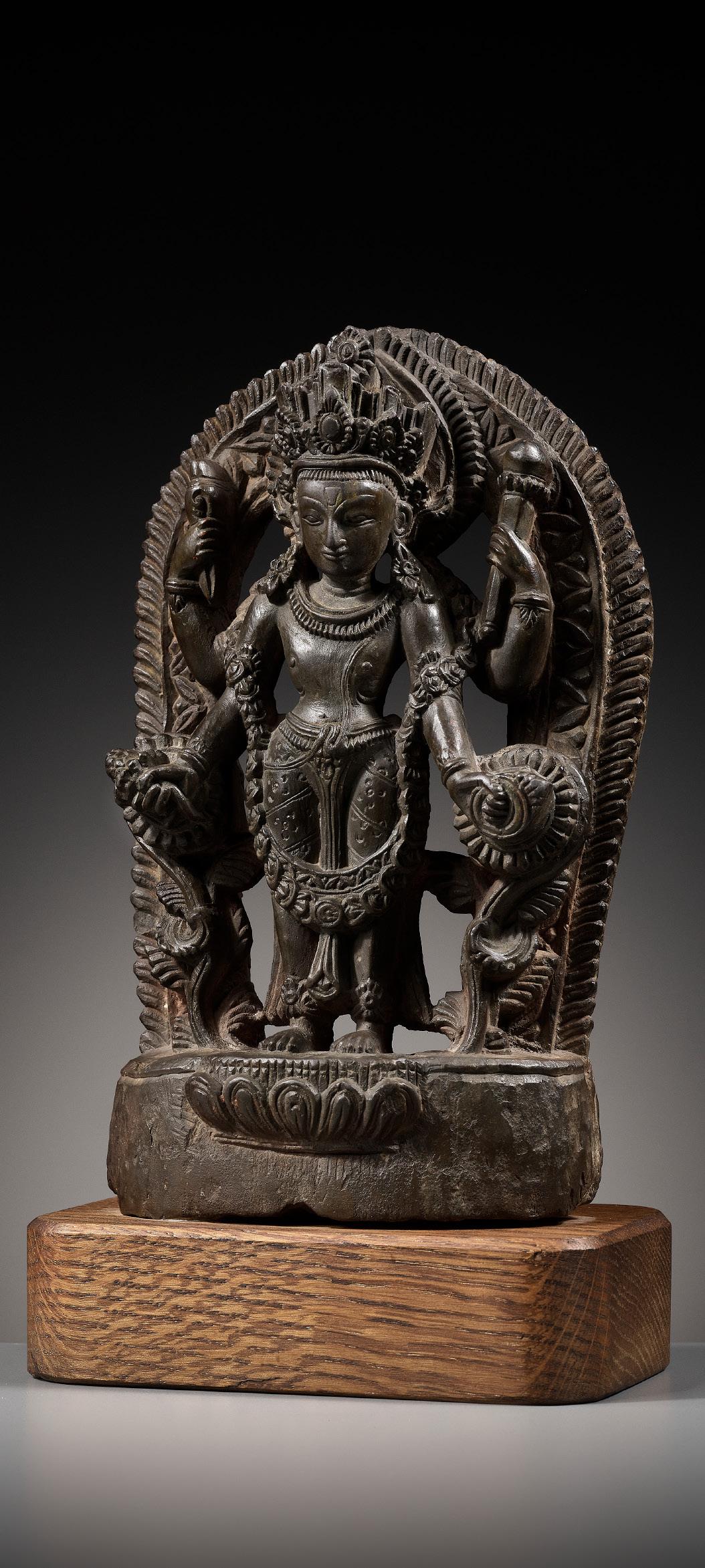
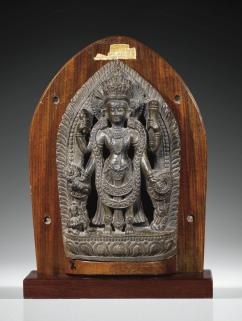
Provenance: Belgian trade, by repute acquired from a local collection in Ghent. Condition: Very good condition, commensurate with age. Extensive wear, shallow surface scratches, signs of weathering and erosion. Small losses, nicks and cracks, some encrustations. Remnants of red pigment.
Weight: 2,287 g
Dimensions: Height 22.8 cm (excl. stand), 26.5 cm (incl. stand)
Mounted to an associated oakwood stand. (2)
Vishnu’s four hands hold objects that are symbols of his divine qualities and martial kingly attributes: a chakra or war disk (representing the mind), a conch shell (the four elements), a lotus flower (the moving universe) and the club (primeval knowledge).
AUCTION RESULT
COMPARISON
Type: Closely related
Auction:
Sotheby’s Paris, 10 June 2014, lot 333
Estimate: EUR 8,000 or approx. EUR 9,500 adjusted for inflation at the time of writing
Description: Sandstone stele representing Vishnu Nepal, Malla period, 18th century
Estimate EUR 3,000
Starting price EUR 1,500
183
A GILT BRONZE FIGURE OF AMITAYUS, TIBET, 15TH-16TH CENTURY
Cast seated in dhyanasana on a sealed double lotus beaded base with the hands lowered in dhyana mudra, richly adorned in intricate jewelry, wearing a long flowing robe and billowing shawl pooling beautifully at the base. The deity is skillfully portrayed with a serene expression framed by an elaborate headdress and a pair of pendulous earlobes adorned with ornamental earrings. The hair is arranged in an elaborate double ushnisha surmounted by a lotus bud finial, several locks of hair gently falling over the shoulders.
Provenance: From a noted private collection in Belgium.
Condition: Very good condition with old wear and minor casting flaws, small nicks, tiny scratches.
Weight: 1572 g
Dimensions: 17.5 cm
Expert’s note: The heavy cast with a net weight of more than 1.5 kilos and the fine yet resilient gilding both confirm the dating of the present lot.
Amitayus, the Buddha of Infinite Life, is the deity associated with the rites that ensure long life. He is especially worshipped by Tibetans, who believe that life can be extended through long lineages, faith, and compassion. It is also believed that one can achieve self-enlightenment and cater to the welfare of others with the help of Amitayus.
Amitayus is also one of the most popular meditational deities in Vajravana Buddhism where he is highly revered for his longevity attributes, pure perception, and awareness of the emptiness of phenomena. According to the Larger Sutra of Immeasurable Life, compiled during the 1st or 2nd century AD, the infinite merits possessed by the deity resulted from the performance of good deeds in his past lives as a bodhisattva named Dharmakara. Having attained enlightenment, the deity resided in the wondrous realm of Sukhavati.
AUCTION RESULT COMPARISON
Type: Related
Auction: Sotheby’s New York, 15 March 2017, lot 211
Price: USD 13,750 or approx. EUR 16,000 converted and adjusted for inflation at the time of writing
Description: A gilt-bronze figure of Amitayus, Tibet, 16th century


Expert remark: Note the turquoise inlays.
Estimate EUR 10,000
Starting price EUR 5,000
284 184
A BRONZE FIGURE OF AKSHOBHYA, CHINA, 15TH CENTURY
Finely cast seated in dhyanasana on a double-lotus base with finely beaded edges, his right hand lowered in bhumisparsha mudra, his left held above his lap. Akshobhya is dressed in voluminous robes and richly adorned with elaborate jewelry. His serene face with heavylidded downcast eyes and bow-shaped lips forming a calm smile. His hair arranged in tight curls over the high ushnisha topped by a jewel behind the foliate tiara.
Provenance: From an old private estate in Vienna, Austria. The grandparents of the last owner are said to have acquired the piece in the Austrian trade, shortly after the second world war.
Condition: Excellent condition with expected old wear and minor casting irregularities, small dents and losses, minuscule nicks, light scratches. The seal plate lost. The face, crown, some folds and the backside with distinct remnants of gilt.
Weight: 2,060 g
Dimensions: Height 23.6 cm
Bhumisparsha mudra (the ‘earth witness’ gesture) is reserved for images of Buddha Shakyamuni and the Dhyani Buddha, Akshobhya. As Shakyamuni is traditionally depicted as an unadorned ascetic, the presence of the crown on this figure identifies him as Akshobhya. The latter is a concept of Tibetan-style Vajrayana Buddhism, which was introduced to China during the Yuan Dynasty (1279-1368).

AUCTION RESULT COMPARISON
Type: Closely related
Auction: Sotheby’s Paris, 11 December 2020, lot 29
Price: EUR 50,400 or approx. EUR 60,000 adjusted for inflation at the time of writing
Description: A finely cast large bronze figure of Bodhisattva, Ming Dynasty, 15th century Expert remark: Note the size of 29 cm and the closely related manner of casting, quality of the jewelry, crown, incision work around the lotus base, and the lack of any remnants of gilding.
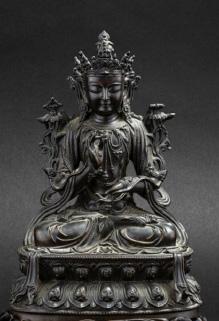
Estimate EUR 10,000
Starting price EUR 5,000
285 185
A GILT COPPER-ALLOY REPOUSSÉ

FIGURE OF BUDDHA AMITABHA, WITH AN INSCRIPTION REFERRING TO THE SECOND KIRTI LAMA, TENPA RINCHEN (1474-1558)
Tibet, 15th-16th century. Seated in vajraparyankasana on a doublelotus base with beaded edges, neatly incised at the top beneath each knee with consecrated and dedicatory inscriptions. His hands are lowered in dhyana mudra. He is wearing a long flowing robe finely incised with foliate designs at the hems and gathering in carved folds at the base. The serene face with heavy-lidded, painted eyes, gently arched brows centered by an urna, and full lips forming a calm smile. The hair arranged in tight curls over the domed ushnisha topped by a jewel.
Inscriptions: To the top of the base, beneath the Buddha’s left knee, ‘Jigten Hoe’, referring to a manner of worship, followed by a number or date; and beneath his right knee, ‘Choe Je Tenpa Rinchen Ne She So’
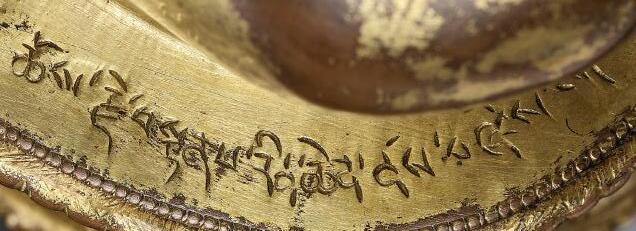
Weight: 929 g
Dimensions: Height 26.5 cm
The Second Kirti Lama, Tenpa Rinchen (1474-1558) was born in a place called Dungsha in the lower region of Ngawa, in Amdo. In 1489, at the age of sixteen, he traveled to U, where he studied medicine under a physician named Dondrub and the sutras of Maitreya under Lama Chopel Zangpo at a hermitage named Rakhadrak. He studied Abhidharma and Vinaya under Meru Jampa Rinchen, who, in 1493, gave him full ordination together with the name Tenpa Rinchen Chokyi Gyeltsen. After studying sutra and tantra for six years, he received empowerments for various dharma protectors from the Sakya lama Kunga Rinchen, after which he went into retreat for three years. In total, he spent fourteen years in U, returning home in 1504 at the age of thirty-one.
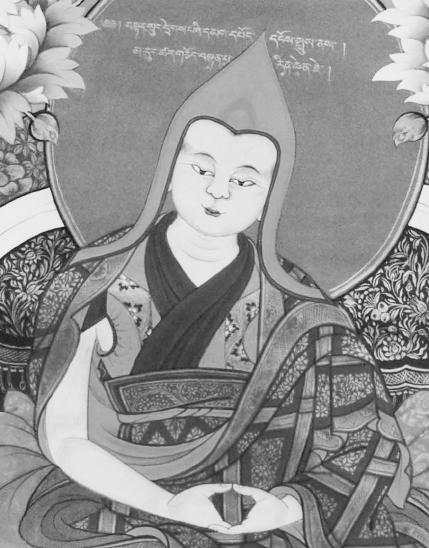
Provenance: Ute Asboth, Galerie Asboth, Vienna, May 2000. Collection of Maria and Johannes Nickl, acquired from the above and thence by descent in the same family. A copy of the original expertise letter written and signed by Ute Asboth, describing the illustrated present bronze as a gilt copper repoussé figure of Amitabha and dating it to the 17th century, accompanies this lot. A copy of the original handwritten receipt, written and signed by Ute Asboth, dated 31 May 2000, accompanies this lot. Ute Asboth (c. 1927-2018) began her career in the Asian art trade at Galerie Zacke in the early 1980s before eventually founding Galerie Asboth in Vienna, Austria. The gallery specialized in East Asian art and published extensively. Several noted exhibitions were curated in close cooperation with Luigi Bandini from Eskenazi gallery in London, United Kingdom. Maria (1926-2022) and Johannes Nickl (d. 2020) lived in Vienna, Austria, and were ardent collectors of Asian, Buddhist, and Egyptian works of art.
Condition: Very good condition with expected old wear, small dents, few tiny losses, light scratches. The base unsealed.
Upon his return, Tenpa Rinchen first went to Tala Hermitage in Taktsang Lhamo, which had been established by Rongchen Gendun Gyeltsen (13741450). There he gave empowerments and teachings on language, poetry, medicine, and astrology. He lived at Tala for seven years, expanding it and overseeing the community. Afterwards, he announced that he was the reincarnation of Rongchen Gendun Gyeltsen, and then went to Kalari Kirti monastery, which Gendun Gyeltsen had established in 1412 as his seat. He took for himself the title of Kirti Lama, and posthumously gave the title of the First Kirti to Gendun Gyeltsen.
As part of his activity in expanding the Gelug tradition in Amdo, he converted a Jonang monastery to Geluk, apparently by force. In retaliation, a Jonang Tulku sent the army of Tsangpa Lhundup Rabten to attack Kalari Kirti Monastery, forcing Tenpa Rinchen to flee. He was invited to Muge Monastery in Ngawa, where he gave teachings. At around the same time, the Chinese Ming Emperor Zhengde invited him to China. He declined the invitation but he did a divination for the Emperor and recommended what prayers he should read. Zhengde again sent an envoy with gold and silver gifts and an ivory stamp, which read ‘The Precious Accomplished and Enlightened Teacher’.
Estimate EUR 12,000
Starting price EUR 6,000
286
186
The Second Kirti Lama, Tenpa Rinchen (1474-1558)
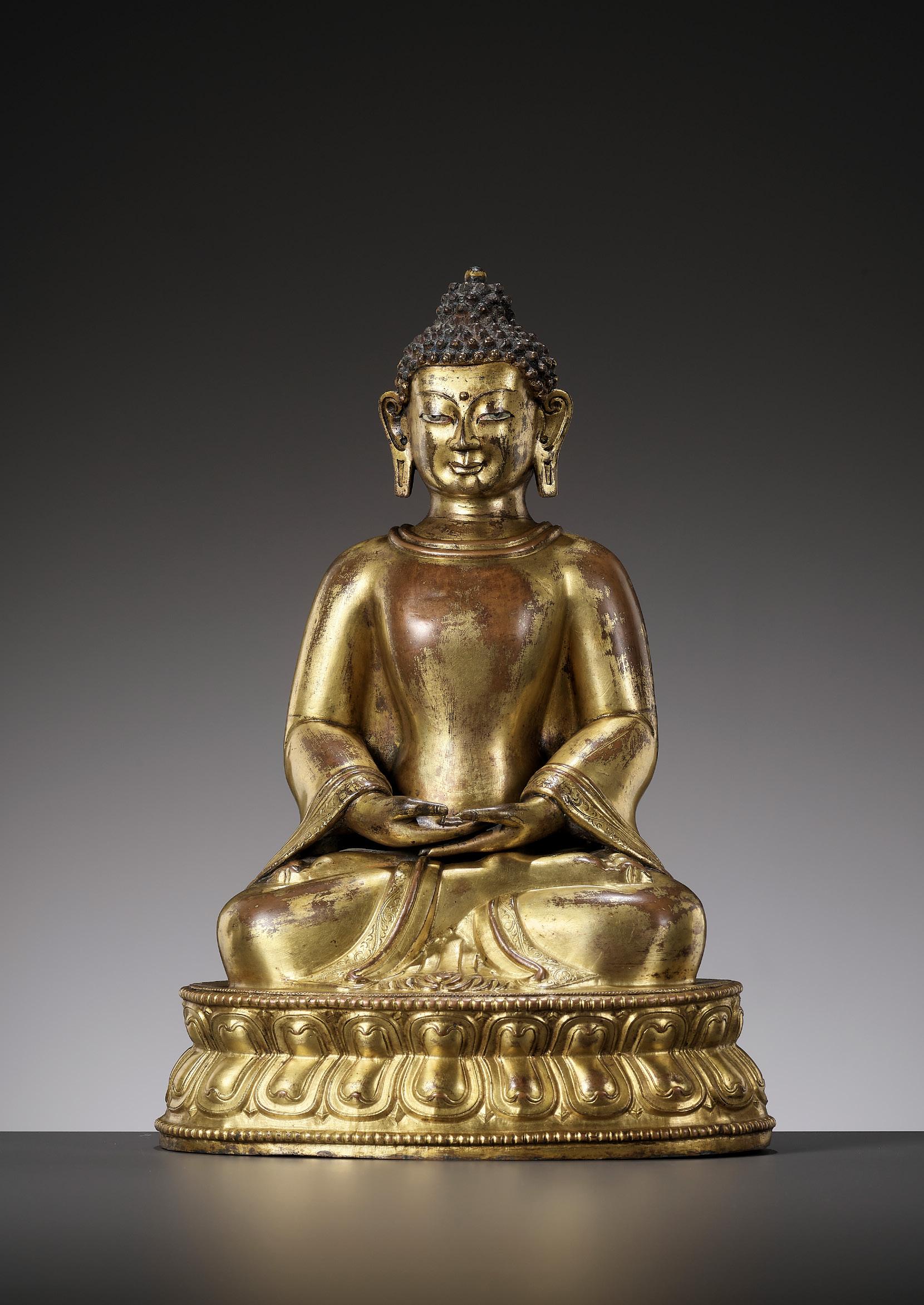

A LARGE AND HIGHLY IMPORTANT ZITAN AND GILT-LACQUERED STATUE OF SARIPUTRA, THE FIRST OF BUDDHA’S TWO CHIEF DISCIPLES, CHINA, 1520-1580
The Ming dynasty’s largest surviving Zitan sculpture.
X-Rays: Conventional X-ray scans conducted in 2023 confirm the existence of multiple vertical cavities within the statue. Some of these voids may still hold ancient scriptures, or sutras, on paper and/or textile. It’s important to note that an X-ray image captured in 1985 (published in Galerie Zacke, Skulpturen des Buddhismus und Hinduismus, Vienna, 1985, no. 48) using an X-ray image intensifier (XRII) discloses the possible presence of several objects, which remain beyond the purview of standard X-ray imaging methods. Given that the statue is hermetically sealed and must remain unopened, the actual confirmation of its contents is unattainable, thus precluding any assurance regarding their nature.
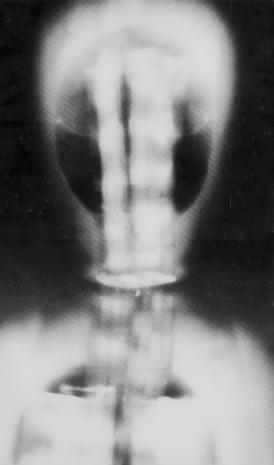
Condition: The statue is in superb condition, especially considering its high age of half a millennia and the rather sensitive Zitan wood. It is constructed of meticulously joined pieces of wood. Expected old wear, rubbing to gilt, and natural age cracks. Occasional light scratches, few minuscule chips. The original base is lost (see expert’s note) and was replaced between 1700 and 1750 with the present pedestal, which is in good condition with expected old wear, natural age cracks, minor flaking to lacquer and small losses.
Provenance:
- Collection of Anton Exner (1882-1952), Vienna, Austria, acquired in the Republic of China after the Xinhai Revolution of 1911
- Collection of Walter Exner (1911-2003), Bad Wildungen, Germany, acquired from the above after 1945
- Galerie Zacke, Vienna, Austria, acquired from the above and exhibited in 1985
- A noted private collection in Vienna, Austria
Anton Exner (1882-1952) was the most important dealer, collector, and assessor of East Asian art in Vienna during the interwar period. His collection included all branches of Asian art, from all epochs, and particularly Chinese and Japanese works. During a long sojourn through Canada and the USA from 1908 to 1910, he made first contacts with Chinese dealers and subsequently acquired numerous antiques at various Asian ports, which formed the basis for his future business activities. From then on, he went almost every year on buying trips to the Far East. The Austrian auction house Dorotheum appointed him as a sworn assessor of Asian art, a position he held for c. 25 years. From the early 1920s onwards, he lent objects to most major exhibitions of Asian art held in Austria, and eventually gifted a large part of his personal collection, numbering several thousand objects, to the Museum of Applied Arts in Vienna, where it is on permanent exhibition to this day.
Walter Exner (1911-2003), among other family members, inherited parts of the vast collection, which he had built together with his father from 1935 onwards, after their first joint trip to East Asia. He spent a year in Beijing from 1936 to 1937 and from 1956 to 1963, he directed the Asian Institute in Frankenau, Germany, which he founded, as well as its museum. The present lot was exhibited at the opening of this museum in June 1956. In 1965, Walter Exner moved the institute and the museum to Bad Wildungen, Germany. To fund the museum, he deaccessioned pieces from the collection until his passing in 2003.

Weight: 20.1 kg
Dimensions: Height 91 cm
SCIENTIFIC ANALYSIS REPORT
The result of a radiocarbon dating test (C14) conducted by Re. S. Artes, no. C 245112A, 2 August 2023, based on one sample taken from the wooden core of the figure, is consistent with the dating of this lot. The report states a probability of 95.4 % for a dating range of 1517-1656, of which a predominant probability of 63.5 % is for the range of 1517-1589. Copies of the analysis certificate and the detailed scientific report accompany this lot.
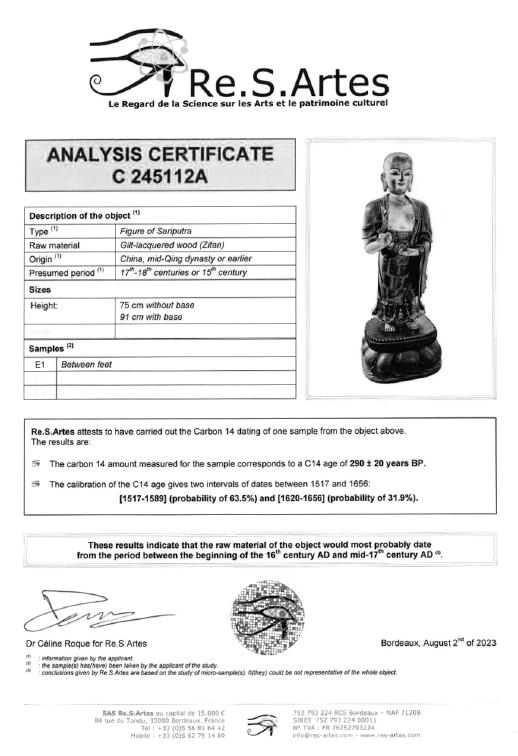
289
187
Walter Exner speaking at the opening of the Asien-Institut and -Museum in Frankenau, Germany, on 2 June 1956, with the present lot (Sariputra) and its counterpart (Maudgalyayana) in the center. Note that the lot on the far right, a monumental Japanese statue of a Bosatsu, was also exhibited at Zacke in Vienna, in 1985.
The face and the exposed body are gilded overall. He is powerfully carved standing in samabhanga, his right hand held in karana mudra, and his left in dhyana mudra. His voluminous monastic robe is precisely carved with undulating folds and outlined in gold with patchwork, the hems similarly decorated with scroll and lozenge diaper, the undergarment with floral designs. His serene face shows heavy-lidded eyes, picked out in ancient pigments, gently arched brows, and bow-shaped lips forming a calm smile, flanked by pendulous earlobes, his short hair lacquered entirely black.
His back shows a rectangular aperture for consecration, and another to the back of his head, both sealed (see X-Ray section for more details).
The wood shows an attractive grain and elegant deep-red color, as expected from Zitan with a naturally grown patina, that is 500 years old.
The disciple stands on a finely carved, lacquered, and fitted wood pedestal decorated with overlapping lotus petals below a thickly beaded edge, dating from the 1700-1750 (see condition report and expert’s note for more details).
Published:
Galerie Zacke, Skulpturen des Buddhismus und Hinduismus, Vienna, 1985, no. 48.

The tradition of Buddhist statues carved from sandalwood originates in India, the prototype being the famous image purportedly commissioned during Buddha’s lifetime by King Udayana. The Chinese monk Xuanzang returned from his pilgrimage to India in the 7th century with two highly prized Buddhist images carved from sandalwood. In the Tibetan context, the famous Nepalese sandalwood image of Arya-Avalokiteshvara at the Potala, tentatively dated 7th - 8th century, was copied numerous times in later periods, establishing a tradition of sandalwood carvings in Tibet, see Ulrich von Schroeder, Buddhist Sculptures in Tibet, 2001, volume II, cat. nos. 195 and 196.
Sariputra is considered the first of the Buddha’s two chief male disciples, together with Maudgalyayana. Buddhist texts relate that the two were childhood friends who became spiritual wanderers in their youth. After having searched for spiritual truth with other contemporary teachers, they came into contact with the teachings of The Buddha and ordained as monks under him, after which The Buddha declared the friends his two chief disciples. In Buddhist art, Sadiputra is almost always depicted alongside The Buddha, usually to his right.
Gilt bronze was the preferred medium for Buddhist sculpture during the Ming dynasty, and the use of zitan is extremely rare. However, this ‘purple sandalwood’ with a characteristic grain of needle-like ‘specks of gold’ is the most highly prized wood in China and hence most befitting for Imperial use and worship. The high density of the wood makes this material especially suitable for fine and intricate carving. Due to its slow-growing nature, zitan was only available in small quantities. Much of the zitan that came to China was used for Imperial furniture, as the hard structure of the wood made it resistant to splitting and swelling in changes of climate. Lesser quantities were carved into small boxes, figures, stands and other scholars’ and literati accoutrement.
Exceedingly few Buddhist sculptures made from Zitan during the mid-Ming dynasty are known, and none of even remotely as spectacular a size as the present lot.
Exhibited:

Asien-Institut Frankenau, 1956-1963
Asien Institut Bad Wildungen, 1965-1977
Galerie Zacke, Vienna, 1985
Expert’s note:
Imperial Buddhist Zitan figures were made as early as the Yongle period, see the auction result comparison below for a good example. These statues were still rather small, but are already quite similar to the present lot. The only major difference is the size, and so it seems plausible that after the success of the smaller figures, larger ones were ordered by the emperor. In this context it is important to note that the radiocarbon dating of the present lot could reach back a further 50 years, well into the 15th century, when taking into account the usual deviations inherent to C14 measurements. Figures of Sadiputra and Maudgalyayana were never made without a statue of The Buddha at the center, which according to Buddhist protocol should have had between three and five times the size of the attendant figures. No Zitan Buddha statue of 2,7 meters or more is extant in China today, a fact that nurtures the theory that The Buddha was destroyed in a fire, possibly during the turmoil surrounding the Manchu seizure of Beijing in 1644. In this case the two disciple figures were saved from the fire, their bases left behind. It is well possible that these bases carried Imperial marks such as the statue in the auction result comparison.
Literature comparison: While there is remarkable consistency within the group of gilt bronze figures from the Yongle ateliers, the material here likely dictates somewhat more angular features. Thus compare the face of a gilt-bronze Yongle figure of Shakyamuni in the British Museum, see W. Zwalf (ed.), Buddhism, Art and Faith, 1985, cat. no. 305 and frontispiece page 2. For a related zitan and gilt-lacquered figure at the summer palace Jehol, where Emperor Qianlong had numerous small shrines made to house Buddhist sculptures of various origin and date, see The Chang Foundation, Taipei, Buddhist Art from Rehol, Tibetan Buddhist Images and Ritual Objects from the Qing Dynasty Summer Palace at Chengde, 1999, pl. 88, illustrating an 18th century gold lacquer shrine housing a figure of Buddha, possibly of Yongle date.
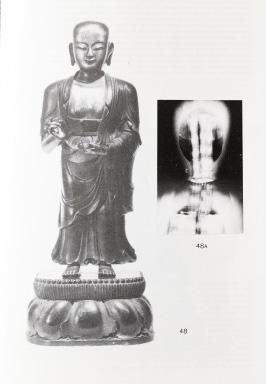
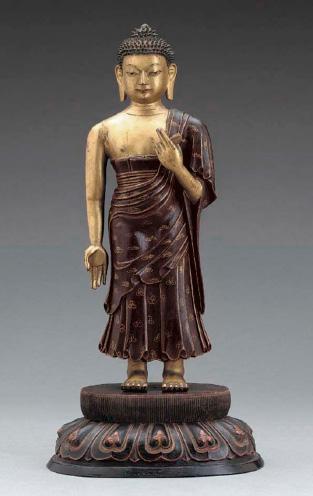
AUCTION RESULT COMPARISON
Type: Closely related
Auction: Christie’s New York, 20 March 2002, lot 69
Price: USD 116,000 or approx. EUR 182,000 converted and adjusted for inflation at the time of writing
Description: A very rare zitan and gilt-lacquered figure of Shakyamuni, Tibeto-Chinese, Yongle ninecharacter mark and period
Expert remark: Compare the closely related material, lacquer gilding, modeling with similar robe and face, and sealed aperture to the back. Note the Yongle reign mark to the base. Also note the much smaller size (33 cm)
Estimate EUR 200,000
Starting price EUR 100,000
290

A
LARGE GILT-LACQUERED BRONZE FIGURE OF THE MEDICINE BUDDHA (BHAISAJYAGURU), MING DYNASTY
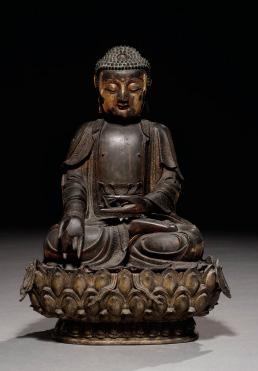
China, 1368-1644. Finely cast, the Buddha is seated in dhyanasana with his right hand extended in varadamudra while holding a small myrobalan fruit and his left raised above his lap. He wears monastic, loosely draped, and layered robes, belted at the waist and opening at the chest. His serene face with heavy-lidded eyes below elegantly arched brows centered by a circular urna, his full bow-shaped lips forming a calm smile, flanked by long pendulous earlobes. His hair is dressed in tight curls that continue up over the domed ushnisha.
Provenance: From the collection of Captain Peter Dircks and thence by descent in the same family. Peter Leonardus Dircks (1883-1954) was a naval officer in the Siam Steam Navigation Company. He was posted between the ports of Beijing, Shanghai, Singapore, Bangkok, and Jakarta, and during his time with the Company he developed a profound interest and knowledge of Asian antiques and works of art. After years of travel, Dircks arrived in Copenhagen in the late 1920s, eventually settling in the Danish capital. From this time until his death in 1954, he kept collecting permanently.
Condition: Good condition, commensurate with age. The lacquer coating is ancient and original, with absolutely no restoration whatsoever – something that is exceedingly rare to find. Old wear, signs of weathering and erosion, encrustations, flaking to lacquer, nicks, scratches, minor dents. Figure and stand do not fit 100% perfectly, possibly due to heat influence at some point in time, but definitely belong together originally. The bronze is covered overall in a rich, naturally grown, dark patina and displays exceptionally well.
Weight: 15.1 kg
Dimensions: Height 49.6 cm
The figure is raised on a separately cast lotus base comprised of three tiers of naturalistic petals above an openworked foot of scrolling foliage. (2)
AUCTION RESULT COMPARISON
Type: Related
Auction: Christie’s London, 3 November 2020, lot 75
Price: GBP 43,750 or approx. EUR 65,500 converted and adjusted for inflation at the time of writing
Description: A lacquered gilt-bronze figure of Buddha Shakyamuni, 16th century Expert remark: Compare the closely related modeling as well as the related lacquer gilding, also flaking off in some minor areas. Note the lacking base and the much smaller size (38 cm).
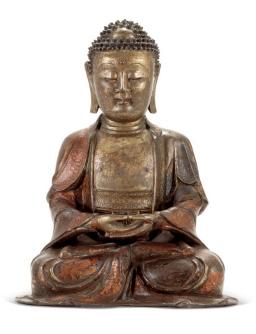
AUCTION RESULT COMPARISON
Type: Closely related
Auction: Christie’s New York, 24 September 2021, lot 777
Price: USD 250,000 or approx. EUR 254,000 converted and adjusted for inflation at the time of writing
Description: A gilt-lacquered bronze figure of the Medicine Buddha, Ming dynasty Expert remark: Compare the closely related subject, modeling with similar pose, robes, expression, hair, and separately cast base, manner of casting, and lacquergilding. Note the larger size (71.1 cm).
Estimate EUR 30,000
Starting price EUR 15,000
292
188
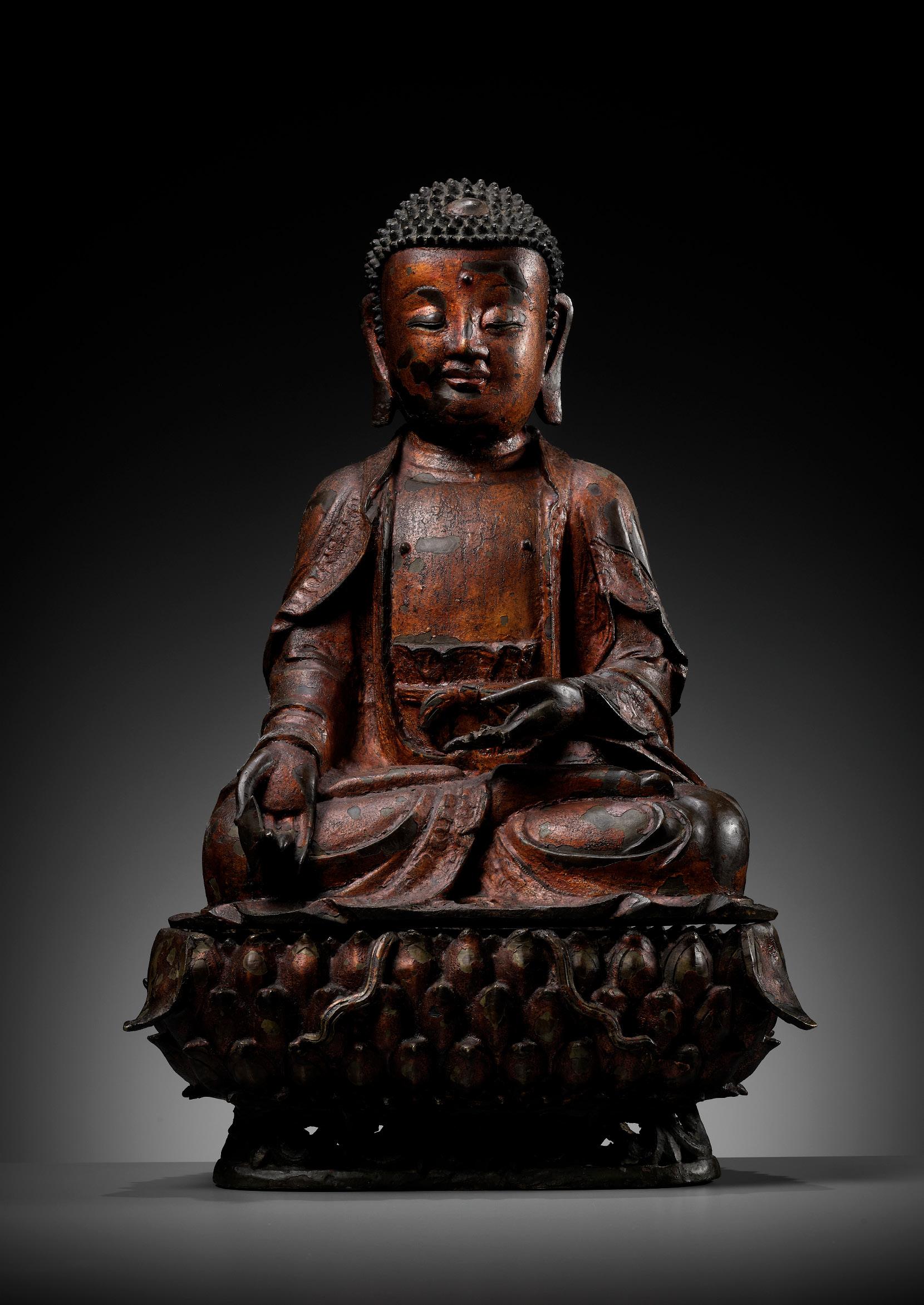
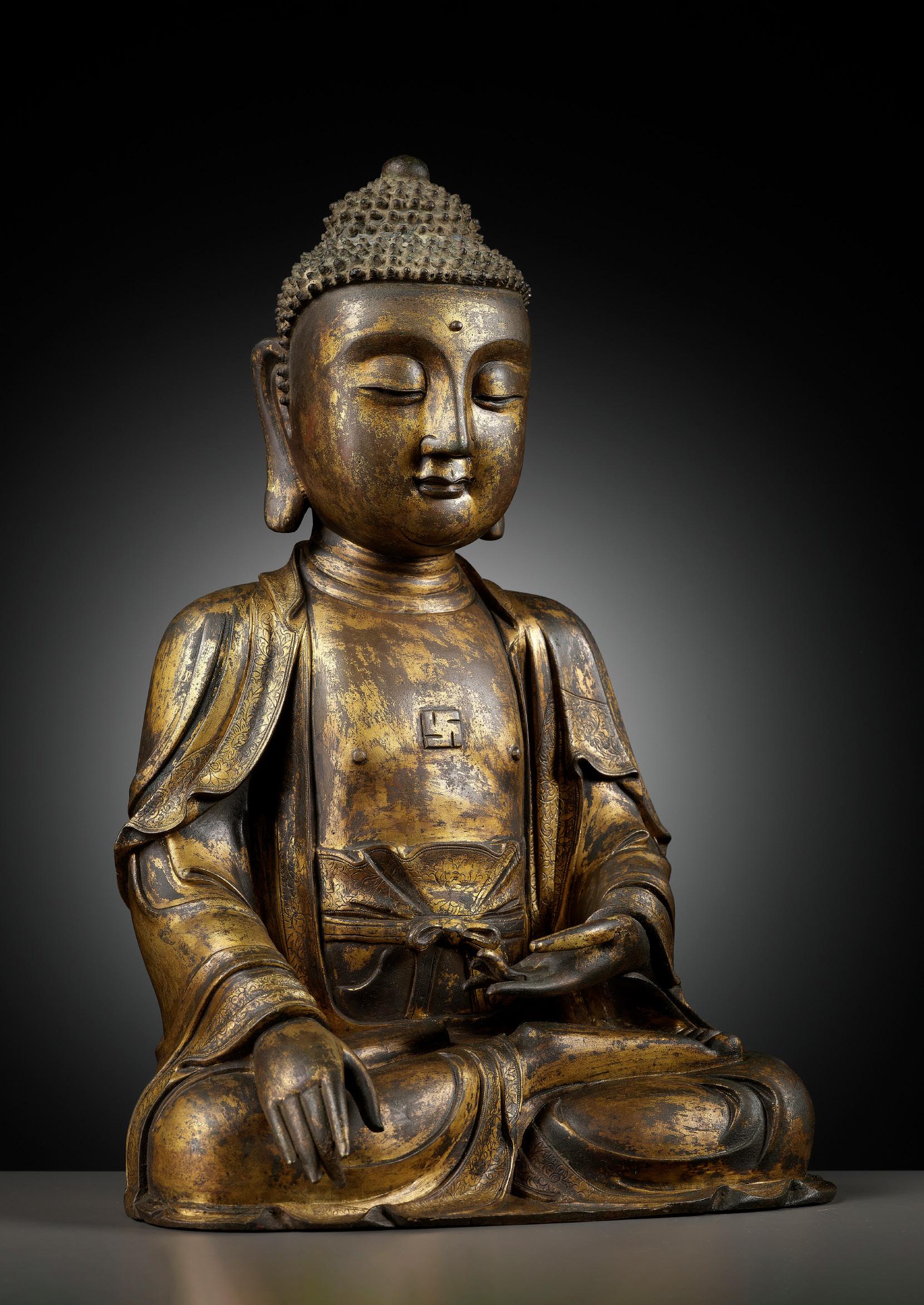
A LARGE GILT BRONZE FIGURE OF BUDDHA, MING DYNASTY
China, 16th-17th century. Heavily cast, seated in dhyanasana with his right hand lowered in bhumisparsha mudra and the left held above his lap. He is wearing loosely draped robes, opening at the chest cast with a wan symbol, the hems finely incised with floral decorations, the garment secured with a belt neatly tied around the waist in a bow. The face modeled with a serene expression marked by downcast eyes below gently arched eyebrows centered by an urna, and full lips forming a subtle smile, flanked by pendulous earlobes. The hair cast in tight curls over the ushnisha.
Provenance: Property from an important Washington state collection. Condition: Very good condition with some wear, particularly to the gilding, and casting irregularities. Minor nicks and light scratches. The interior with remnants of pigment. The bronze with a rich, naturally grown, dark patina.
Weight: 8,451 g
Dimensions: Height 39.2 cm
Literature comparison: A related gilt-bronze figure of Buddha Shakyamuni, dated 16th-17th century, in the Chang Foundation, is illustrated in Buddhist Images in Gilt Metal, Taipei, 1993, pp. 32-33, no. 9.
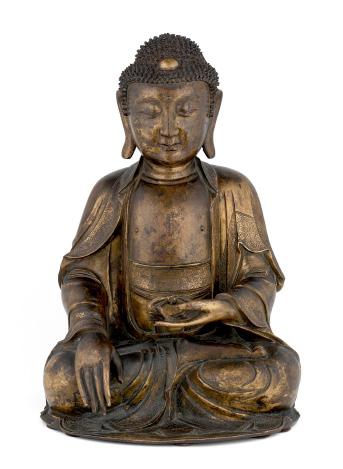
AUCTION RESULT COMPARISON
Type: Closely related
Auction: Bonhams London, 9 November 2017, lot 204
Price: GBP 68,750 or approx. EUR 110,000 converted and adjusted for inflation at the time of writing
Description: A large gilt-bronze figure of Buddha Shakyamuni, 17th century
Expert remark: Compare the closely related meditative pose and serene expression, wear to gilt, manner of casting, and decoration with similar incised floral hems. Note the closely related size (39.3 cm).

Estimate EUR 30,000
Starting price EUR 15,000
295 189
Expert’s note: The statue shows several meticulously inlaid miniature bronze plaques of rectangular shape to the back. These plaques have a ritual purpose and are frequently found in Buddhist sculpture.
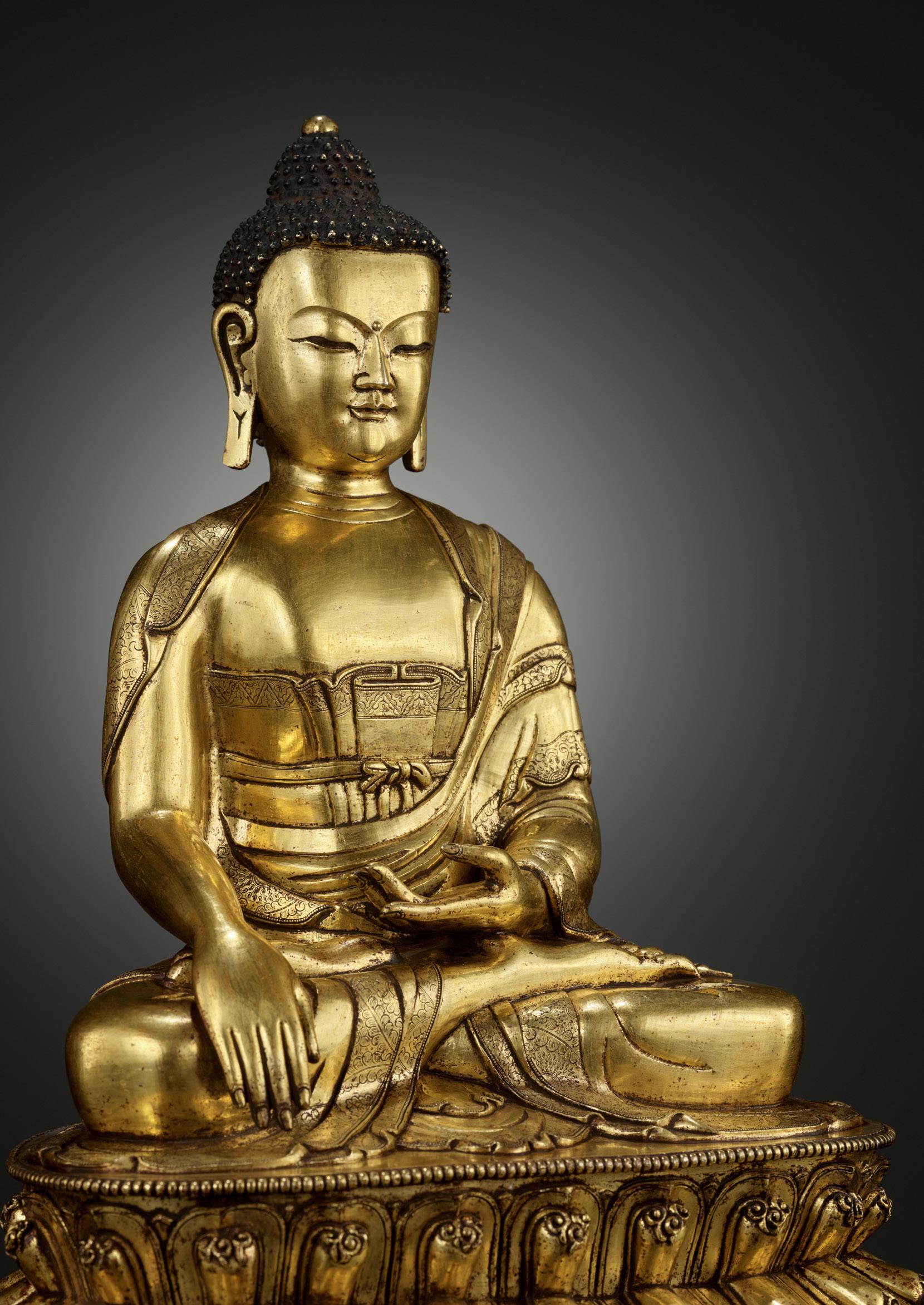
190
A LARGE GILT-BRONZE FIGURE OF BUDDHA SHAKYAMUNI, KANGXI TO YONGZHENG PERIOD
China, 1662-1735. Superbly cast, seated in dhyanasana atop a doublelotus base finely detailed with scrolls to the petals and beaded edges. His right hand is lowered in bhumisparsha mudra and his left held above his lap in dhyana mudra. He is wearing a monastic robe neatly incised with foliate hems over an undergarment secured above the waist. His serene face with heavy-lidded eyes above gently arched brows centered by a raised circular urna, above bow-shaped lips forming a calm smile, flanked by pendulous slitted earlobes. His hair is arranged in tight curls over the high ushnisha topped by a jewel. Note the extremely fine beading to the edges, typical for Imperial Buddhist bronzes from the period.
Provenance: Dutch trade. By repute from a private estate in Amsterdam.
Condition: Good condition with expected old wear and minor casting irregularities, light surface scratches, and tiny nicks. The hollow interior with distinct red pigment. The hair with remnants of blue pigment. The seal plate and contents lost. The cavities with remnants of ancient varnish overall. Fine, naturally grown patina.
Weight: 8,390 g
Dimensions: Height 34.3 cm
Displaying tremendous power and presence, this impressive figure of Buddha Shakyamuni is notable for the crisp casting and the meticulous attention to detail which is echoed in the gentle folds of the elegant monastic robes, finely embellished with foliate scroll.
The figure of Shakyamuni is one of the most widely represented subjects in Buddhist art. Modeled in the earth-touching gesture or bhumisparsha mudra, the Buddha recalls the moment of his Enlightenment, in which he
called upon the earth as his witness of his battle against the temptations and attacks of Mara and his demons. The serene countenance conveyed by the gentle facial features, with the eyes depicted half closed in meditation and the elongated earlobes symbolizing long life, follows the standard rules for the depiction of Buddha to ensure the deity was shown embodying maximum power.
Literature comparison: Compare a related gilt-bronze figure of Bhaisajyaguru Buddha dated by inscription to the 21st year of Kangxi (1682), but with more elaborately decorated robes, illustrated in Gems of Beijing Cultural Relics Series, Buddhist Statues I, Beijing, 2001, pp. 212-13, no. 180 and 181. A related gilt-bronze figure of Buddha Shakyamuni, wearing similar robes, of smaller size (20.2 cm), dated to the 18th century, is illustrated in Buddhist Images in Gilt Metal, Chang Foundation, Taipei, 1993, p. 45, no. 15.
AUCTION RESULT COMPARISON
Type: Closely related
Auction: Christie’s New York, 17 March 2017, lot 1030
Price: USD 211,500 or approx. EUR 243,000 converted and adjusted for inflation at the time of writing
Description: A gilt-bronze figure of Buddha, Kangxi-Yongzheng period
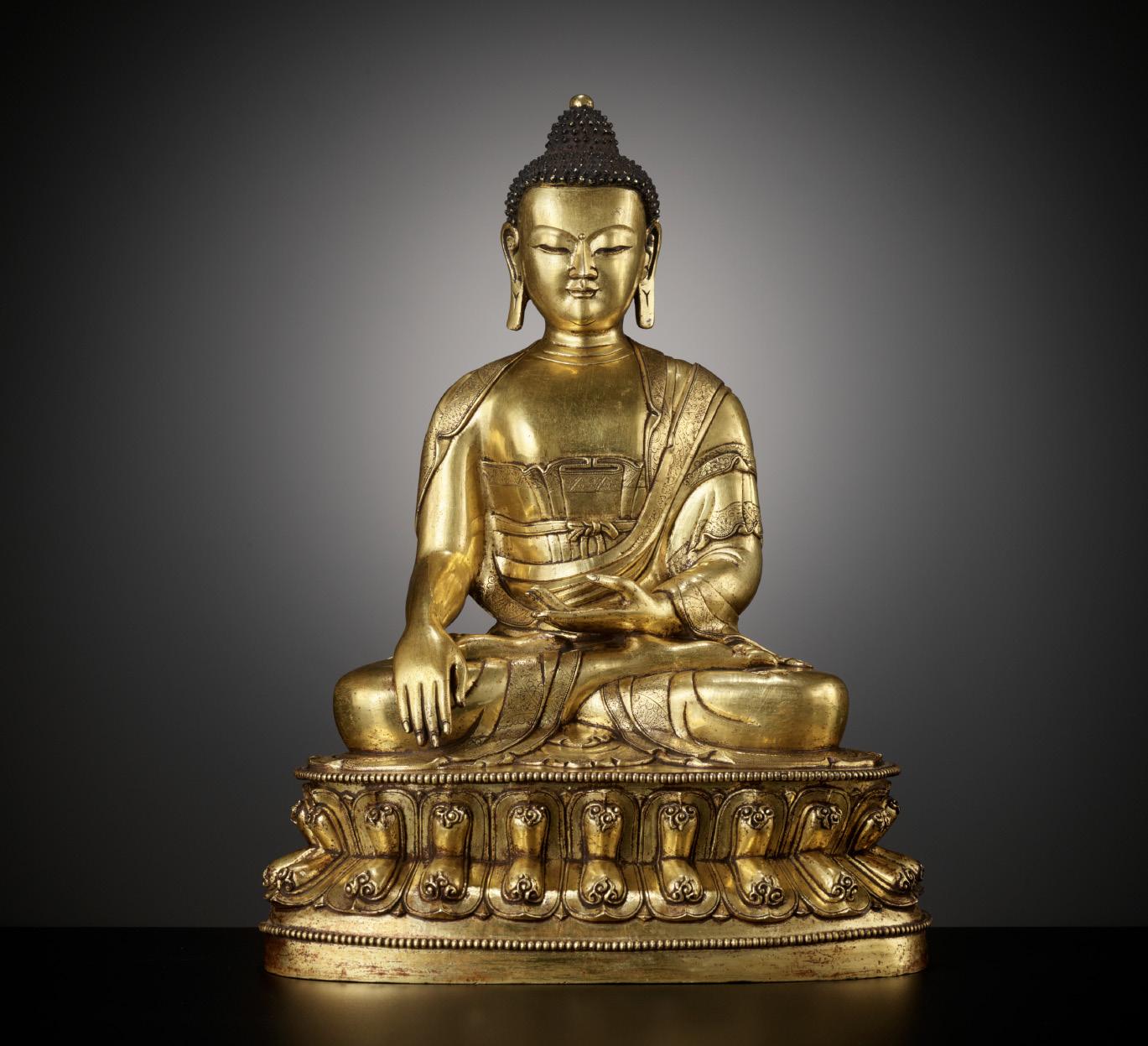

Expert remark: Compare the closely related manner of casting, modeling with remarkably similar base, and near-identical gilding. Also note the identical size (34.3 cm). Note the somewhat different face, with slightly wider features and a gentle widow’s peak, and that the robe is draped over only one shoulder.
Estimate EUR 60,000
Starting price EUR 30,000
297
A SILVER FIGURE OF AVALOKITESHVARA IN ROYAL EASE, FIRST HALF OF THE QING DYNASTY
China, late 17th - 18th century. Seated in royal ease, the Bodhisattva of Infinite Compassion, is raising his right hand in kamajayi mudra and supporting himself on the separately cast rockwork base above crashing waves with his left. Robed in a finely cast voluminous dhoti with a beaded hem and a cloth belt tied at the waist. His serene face with sinuously lidded downcast eyes below gently arched brows, the mouth with bow-shaped lips, flanked by long pendulous earlobes. The hair piled up into a jatamakuta adorned with floral blossoms and elegantly falling in twisted strands down his shoulders. (2)
Provenance: UK trade.
Condition: Excellent condition with expected old wear and minor casting flaws, a few small nicks, and minimal tarnishing to the silver. Possibly once with inlays that are now lost.
Weight: 762.3 g
Dimensions: Height 13.1 cm
The present figure is hollow-cast in two parts, statue and base, and is made entirely from silver of a high purity, showing fine and detailed incision work. It shares the physical proportions, sensuous plasticity, and exquisite modeling that normally characterizes sculptures from ancient India, which certainly served as an inspiration. The excellent polish of the surface shows the hand of a highly experienced silversmith, indicating a possible connection to the Imperial workshops in Beijing.
The Kamajayi Mudra involves pressing the thumb against the index finger of the same hand while allowing the other fingers to remain in a relaxed and slightly curled position. This mudra serves to control desires and cravings and it promotes the awakening of spiritual energy. It is seldomly found on Buddhist statues of the period, and may have been depicted here for a specific reason, possibly in connection with the original recipient of this figure.
Literature comparison: Compare a Tibetan silver figure of Vajradhara, 16.5 cm high, dated to the 15th century, in the Art Institute of Chicago, reference number 2014.1031. Compare a Nepalese silver figure of Tara, dated c. 1900, in the Powerhouse Collection of the Museum of Applied Arts & Sciences, Sydney, object number 2014/132/25.


AUCTION RESULT COMPARISON
Type: Related
Auction: Bonhams Hong Kong, 2 October 2018, lot 78
Estimate: HKD 700,000 or approx. EUR 89,500 converted and adjusted for inflation at the time of writing
Description: A silver figure of Marici, Qianlong period
Expert remark: Compare the related Buddhist subject, silver casting, incision work and modeling. Note the size (18.5 cm).
AUCTION RESULT COMPARISON
Type: Related
Auction: Sotheby’s Hong Kong, 1 December 2016, lot 559
Estimate: HKD 90,000 or approx. EUR 12,000 converted and adjusted for inflation at the time of writing
Description: A silver figure of a female attendant

Expert remark: Compare the related silver hollowcasting and detailed modeling. Note that this statue is from the Carl Kempe collection and also dates from the earlier part of the Qing dynasty.
Estimate EUR 6,000
Starting price EUR 3,000
298 191
A SILVER-INLAID AND GILT-BRONZE FIGURE OF MAHASIDDHA, THE MYSTICAL TEACHER VIRUPA

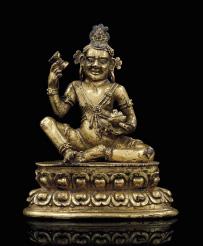
Tibet, 17th – 18th century. The figure dressed in a short dhoti seated in lalitasana on an antelope skin atop a remarkably well-incised foliate base. Looped across his waist over to his raised leg, a notched yogic band decorated finely with a scrolling vine, his one hand cradling a kapala, the other raised with fingers pointing upwards.
Provenance: From an old German private collection. To the base, a collector’s label, ‘Vahasida’ (sic!).
Condition: Very good condition with old wear, expected casting flaws and traces of usage, small nicks here and there, few minuscule losses, light scratches. Good, naturally grown patina overall.
Weight: 1471.2 g
Dimensions: Height 16 cm
The body ornamented with beaded jewelry, the hair knotted in a high chignon and pulled back with a headdress decorated with floral jewelry. The face in a tranquil expression with eyes inlaid in silver under raised eyebrows, the ears elongated with heavy spiral earrings, his curling moustache and long beard, all under a broad smile. To the copper base, an incised crossed vajra symbol.
Mahasiddha may be translated as “Great Attainer” and implies a mystical teacher who is free-thinking and often eccentric, who has mastered the various yogic techniques and attained unusual magical and spiritual powers. Virupa, the Lord of Yoga, is venerated foremost in magical attainments among the 84 Mahasiddhas of India. He is pivotal within all traditions of Tibetan Buddhism. In the Sakya, Virupa is typically depicted in one or all of the six prescribed forms that follow the major events in his life story. The Sakya iconographic convention for depicting Virupa is to have the right hand raised for depicting the narrative of stopping the sun in the sky.
The Indian mystic, Virupa is credited with performing many extraordinary deeds, including parting the waters of the Ganges and drinking enormous amounts of alcoholic beverages. Once he was refused further liquor at a tavern unless he could pay, upon which he prevented the sun from setting for two days with his magical powers. The local king, highly concerned, settled his bill in order to free the sun. Here, he is here depicted with his right arm raised in the threatening gesture of tarjani mudra, ordering the sun not to move. Virupa lived in the ninth century in southern India and studied at the University of Nalanda. He was known for his comments on the Hevajra Tantra.
Literature comparison: Two related examples of Virupa in the Museum Rietberg are published in Uhlig, On the Path to Enlightenment, Zurich, 1995, pp.179, nos.122-3. Compare a closely related figure of Virupa, but with his right hand lowered instead of holding the skull cup, in U. von Schroeder, Indo-Tibetan Bronzes, 1981, cat. no. 128C; and two examples in the Berti Aschmann Collection, cf. H. Uhlig, On the Path to Enlightenment, 1995, cat. nos. 122 and 123.
AUCTION RESULT COMPARISON
Type: Closely related
Auction: Christie’s Paris, 10 December 2014, lot 34
Price: EUR 55,500 or approx. EUR 69,500 adjusted for inflation at the time of writing
Description: Statuette de Mahasiddha en Bronze Doré, Chine, Dynastie Qing, XVIIIème Expert remark: Note the smaller size (10 cm).
AUCTION RESULT COMPARISON
Type: Related
Auction: Christie’s Paris, 22 June 2016, lot 66
Price: EUR 39,900 or approx. EUR 48,000 adjusted for inflation at the time of writing
Description: Statue d’un Mahasiddha en Bronze Doré Tibet, XVIIIème Siecle Expert remark: Note the size (14.5 cm).

Estimate EUR 6,000
Starting price EUR 3,000
299 192
A FINE AND RARE PAINTING ON CLOTH DEPICTING THE SARVAVID VAIROCHANA MANDALA, TIBET, 15TH CENTURY
The central palace houses a crowned Sarvavid Vairochana, whiteskinned with four faces, seated in dhyanasana, surrounded by Buddhas, bodhisattvas, lamas, and wrathful deities, with four stupas for each cardinal direction decorated with auspicious objects, encircled by bands of lotus petals and multi-colored flames framing tantric and wrathful deities. Distemper on cloth.
Provenance: From a noted private collection on the West Coast of the United States.
Condition: Good condition with expected old wear, minor creasing, some soiling and dark discoloration, fraying and small tears to edges, minor losses, minute touchups. Displaying remarkably well, especially given its age of more than half a millennia.
Dimensions: 50.8 cm x 40 cm
Four triangular registers are surrounding the circular bands to depict religious scenes, including hell and an escaping Palden Lhamo. The uppermost register centers around Buddha seated in dhyanasana with the right hand lowered in bhumisparsha mudra, flanked by two bodhisattvas followed by two rows of monks. Dharmapala stands fiercely posed in the lowest register, while two monks likely depicting the paintings commissioner sit in dialogue with each other in the bottom right corner.
A mandala is an aid for meditation, with the main object of veneration in the center. In an initiation ritual, the meditator slowly approaches the center and transforms his or her body and mind into that of the deity. Along the way, the meditator encounters various scenes of religious and historic significance, which aid in his or her meditational journey.
All painted mandalas are a blueprint of a three-dimensional reality
They are not only meant to show the outer cosmic and inner psychic universe but also reveal the path to an exalted state, to the inherent Buddhahood that slumbers within every being, waiting to be discovered and awakened. The ultimate essence or unifying principle represented in the form of the central deity symbolizes this perfect world.
This complex mandala illustrates the structure of our world, outer and inner, including the five directions, five elements (space, water, earth, fire, air), five aggregates (matter, sensation, perception, volition, consciousness), five inner negativities (ignorance, anger, pride, desire, and jealousy) and their opposites, the five wisdoms of an enlightened mind. The central palace is divided subtly into four colors, visible within the spiral decorations in the background. These colors follow the symbolism outlined in the yoga tantras, with blue in the east, yellow (faded to orange) in the south, red in the west, and green in the north.
Along the outskirts of the palace are depictions of hell, the escaping Palden Lhamo, and two scenes that are more ambiguous. The depiction of hell can be clearly identified in one scene as several demons boil while others are impaled or strung up. The escaping Palden Lhamo, a dark figure whose face is obscured by wear, is crowned and rides between three soldiers with shields. The last two scenes depict a monastery, a peculiar set of heads at its doorstep, and a procession. Each of these four registers is painted with a central medallion between the scenes enclosing figures of Buddhas and bodhisattvas.
LITERATURE COMPARISON
Compare a related Sarvavid Vairochana mandala, dated to the 17th century, approximately 120 cm x 100 cm, in the Thangka and Mandala collection of the Rubin Museum of Art, object number C2006.66.346.
AUCTION RESULT COMPARISON
Type: Closely related
Auction: Bonhams New York, 19 March 2018, lot 3014
Price: USD 75,000 or approx. EUR 83,500 converted and adjusted for inflation at the time of writing
Description: A Raktayamari mandala, Tibet, 15th century
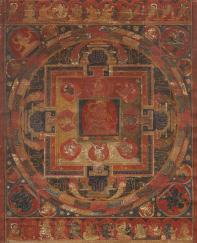
Expert remark: Compare the closely related palatial structure, style of painting with similar predominant use of red, and the similar placement of the registers. Note the similar size (53 x 43.5 cm).
AUCTION RESULT COMPARISON
Type: Closely related
Auction: Sotheby’s New York, 21 September 2007, lot
Price: USD 241,000 or approx. EUR 321,000 converted and adjusted for inflation at the time of writing
Description: A fine and rare painting on cloth depicting the mandala of Manjuvajra, Tibet, 15th century


Expert remark: Compare the closely related palatial structure, style of painting with similar predominant use of red, and the similar placement of the registers.
Estimate EUR 15,000
Starting price EUR 7,500
300 193
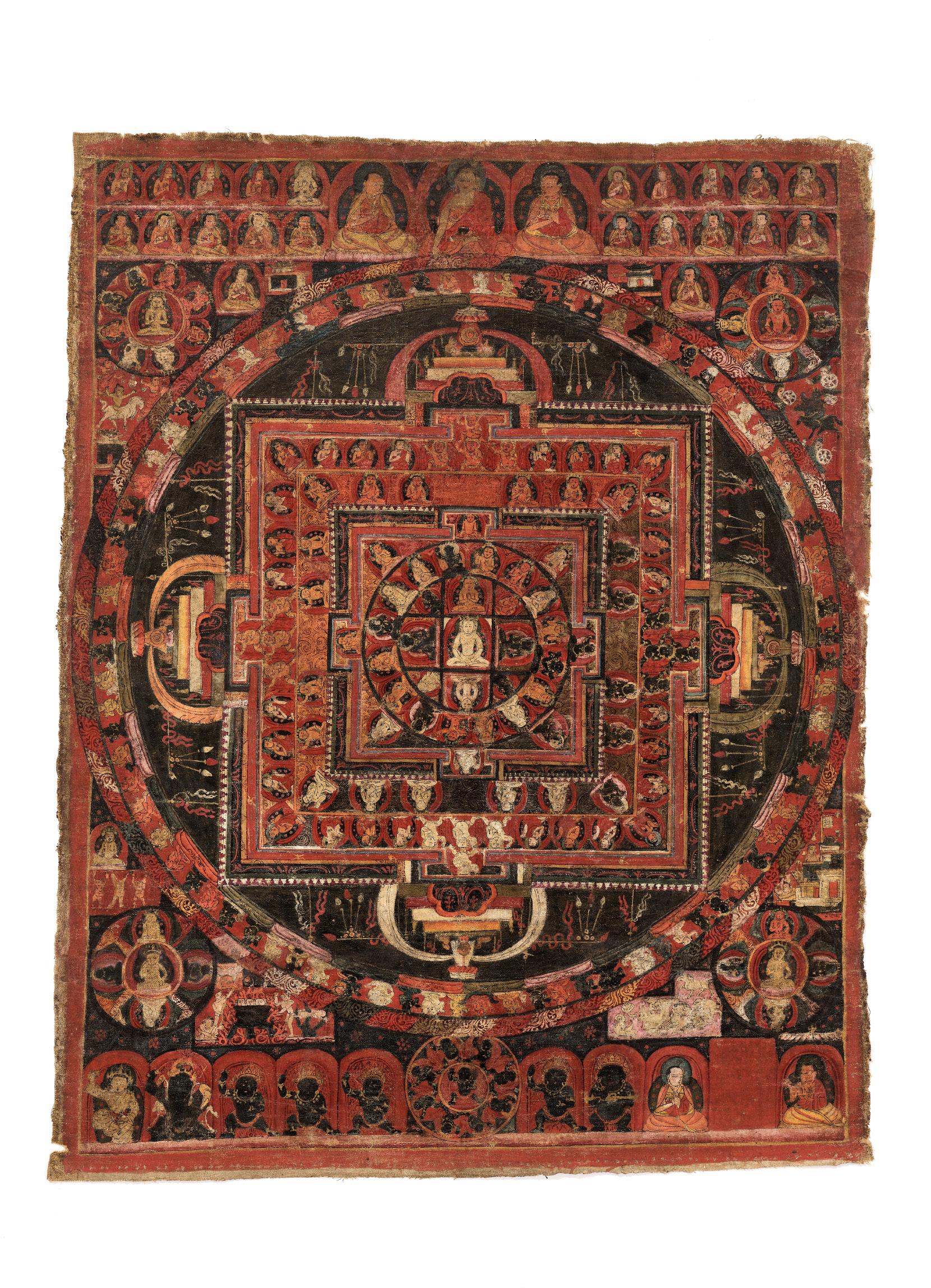
A REMARKABLY FINE THANGKA DEPICTING SIX ARHATS, TIBET, 18TH CENTURY
The upper section with Kanaka Bharadvaja seated on a throne with a kundika, alms bowl, and lotus leaves beside him, his hands held in dhyana mudra, flanked below by Pindola Bharadvaja seated on a cushion holding a manuscript and alms bowl as well as Cudapanthaka seated with his hands folded in front, all above the central Rahula holding a foliate crown. The lower section depicts Panthaka seated on an elaborate throne with his right hand in vitarkamudra while the left holds a manuscript, beside Nagasena placed on a bench resting against a cushion holding a khakkhara in his right hand and a vase in his left.
Provenance: From a private collection in southern Corsica, France, acquired 1992 or earlier, and thence by descent in the family. The back of the frame with a signed label from the Corsican framer, dated 10 September 1992.
Condition: Good condition with old wear, some soiling and abrasions, light creasing, minor losses. Not inspected outside the frame.
Dimensions: Image size 63.4 x 46 cm, Size incl. frame 72 x 51 cm
Each arhat with an identifying inscription, the border with further inscriptions. All are clad in monk’s garments, surrounded by worshipers or attendants, and placed in a verdant mountain landscape with deer, a tiger, and long-tailed birds perched on a fruiting tree, with exquisite rockwork and trickling streams that roll elegantly down the hillside. The lower section with a Nagini emerging from the water holding a sacred jewel. Ushnishavijaya is seated on a lotus cushion, backed by a mandorla and halo, in the upper right corner amid swirling clouds.
Distemper and gold on cloth. Framed behind glass. (2)
The present painting belongs to a noted group of thangkas, always depicting several of the Sixteen Arhats. The grouping of sixteen Arhats was brought to Tibet from India and they are well represented in Tibetan art. They are also known as the sixteen sthaviras (elders) and are the subject of a liturgical practice associated with the festival of the Buddha’s birth, composed by the Kashmiri teacher Shakyahribhadra (1127-1225).
Literature comparison: Compare a six-part set of related arhat thangkas dated to the 19th century, from the Alice S. Kandell Collection and now in the National Museum of Asian Art, Smithsonian Institution, accession numbers S2013.28.1-6.
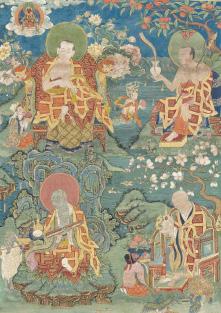
AUCTION RESULT COMPARISON
Type: Related
Auction: Christie’s London, 7 November 2014, lot 490
Price: GBP 30,000 or approx. EUR 52,000 converted and adjusted for inflation at the time of writing
Description: A thangka depicting four arhats, Tibet, ca. 17th century

Expert remark: Compare the related subject and manner of painting. Note the size (59.1 x 41.9 cm).
AUCTION RESULT COMPARISON
Type: Related
Auction: Sotheby’s New York, 21 March 2012, lot 354
Price: USD 15,000 or approx. EUR 18,500 converted and adjusted for inflation at the time of writing
Description: A pair of arhat thangkas distemper on cloth laid on boar, Tibet
Expert remark: Compare the related subject and manner of painting. Note this lot comprises a pair. Note the size (56.5 x 36.2 cm).
Estimate EUR 10,000
Starting price EUR 5,000
302 194
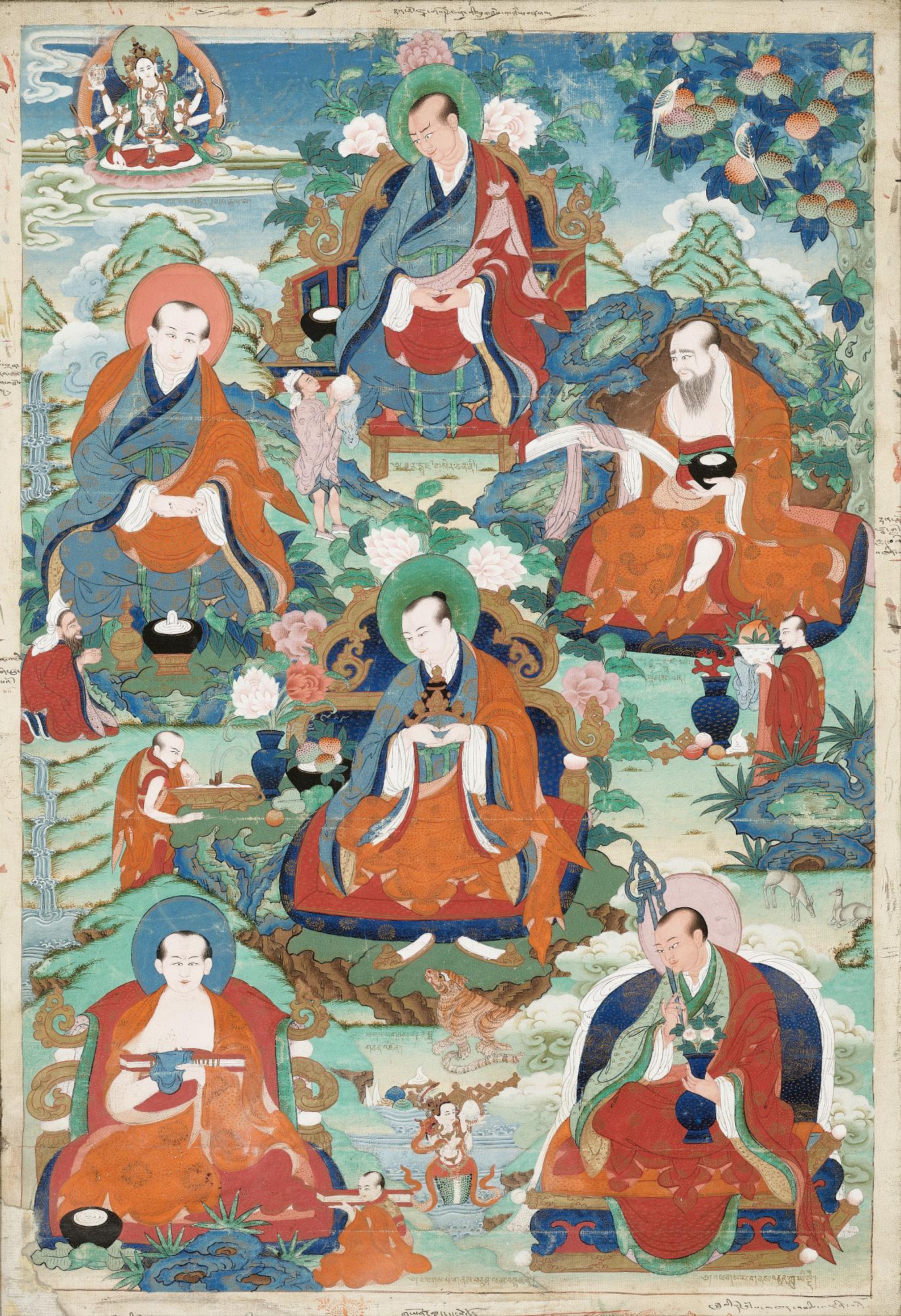
303
AN EXCEPTIONALLY FINE THANGKA OF BUDDHA SHAKYAMUNI AND CLASSIC BUDDHIST TEACHING STORIES, NEW MENRI STYLE, TIBET, 18TH CENTURY
Expert’s note: This painting belongs to a set of thirty-nine paintings depicting all one-hundred-and-eight classic teaching stories (known as rtogs brjod in Tibetan or avadana in Sanskrit). An inscription translating to ‘fourteen, right’ on the verso of the top dowel indicates this painting’s orientation within the set of thirty-nine.
Finely painted with Buddha seated in dhyanasana atop a lotus cushion, his hands held in the teaching gesture known as dharmachakra mudra, backed by a shimmering mandorla and circular halo, surrounded by three scenes illustrating classic Buddhist stories from the Avadana compendium. Smaller figures of Buddha are surrounded by monks and teachers within temple compounds, along with further scenes depicting Buddhist deities, lamas and monks, animals, and mythical beasts, all within a verdant landscape. Three red trilobed vignettes are inscribed in Tibetan with gold letters, with a further inscription on one of the temple walls.

Inscriptions: To the top dowel on the reverse, ‘fourteen, right’.
Provenance: From the collection of Ethelbert Tryba, acquired in Kathmandu, Nepal in 1966, and thence by descent. A copy of a personal letter from Tryba, written from Peshawar to his wife during his travels, in which he describes a recent purchase of a Gandharan statue in Peshawar as well as his impending trip to Kathmandu, accompanies this lot. Ethelbert Tryba (1928-1995) was born in Chicago, Illinois. During his life, he traveled throughout Central and Southeast Asia establishing trade ties for his company. During one particularly trying trip described in a personal letter, Tryba began collecting objects from antique shops in Pakistan, Northern India, and Nepal.

Condition: Good original condition with some wear, slight creasing, soiling, light abrasions, few tiny losses. The brocade mounting with minor tears and losses.
Dimensions: Image size 85.8 x 53.2 cm, Size incl. brocade mounting 164 x 94 cm
Distemper and gold on cloth, with a silk brocade frame and mounted as a hanging scroll.
Striking in its clarity and vibrancy, this thangka is an outstanding example of the New Menri style of Tsang which originated at Tashi Lhunpo Monastery (founded in 1447 by the first Dalai Lama and the traditional monastic seat of the Panchen Lama) in the 17th century by the hand of Choying Gyatso. The naturalistic clouds, rendered in blue and green, are hallmarks of this tradition, as is the placement of these clouds along the architectural elements that cover the landscape. Despite this painting’s age, the gold inscriptions identifying each scene are only lightly abraded.
LITERATURE COMPARISON
Compare a Tibetan-Chinese thangka depicting Buddha Shakyamuni with scenes from his life, dated to the 18th century, in the NelsonAtkins Museum, object number 35-230/1.

AUCTION RESULT COMPARISON
Type: Closely related
Auction: Christie’s New York, 21 March 2018, lot 310
Price: USD 47,500 or approx. EUR 53,500 converted and adjusted for inflation at the time of writing
Description: A large and very fine Thangka depicting Shakyamuni Buddha and two classic Buddhist teaching stories, Avadana, Tibet, 18th century
Expert remark: This lot is a part of the same thirty-nine-painting set and is number 19 in the set. Compare the similar central Buddha in the same pose surrounded by life narratives. Note the size (101.9 x 59.6 cm).
Estimate EUR 10,000
Starting price EUR 5,000
304 195
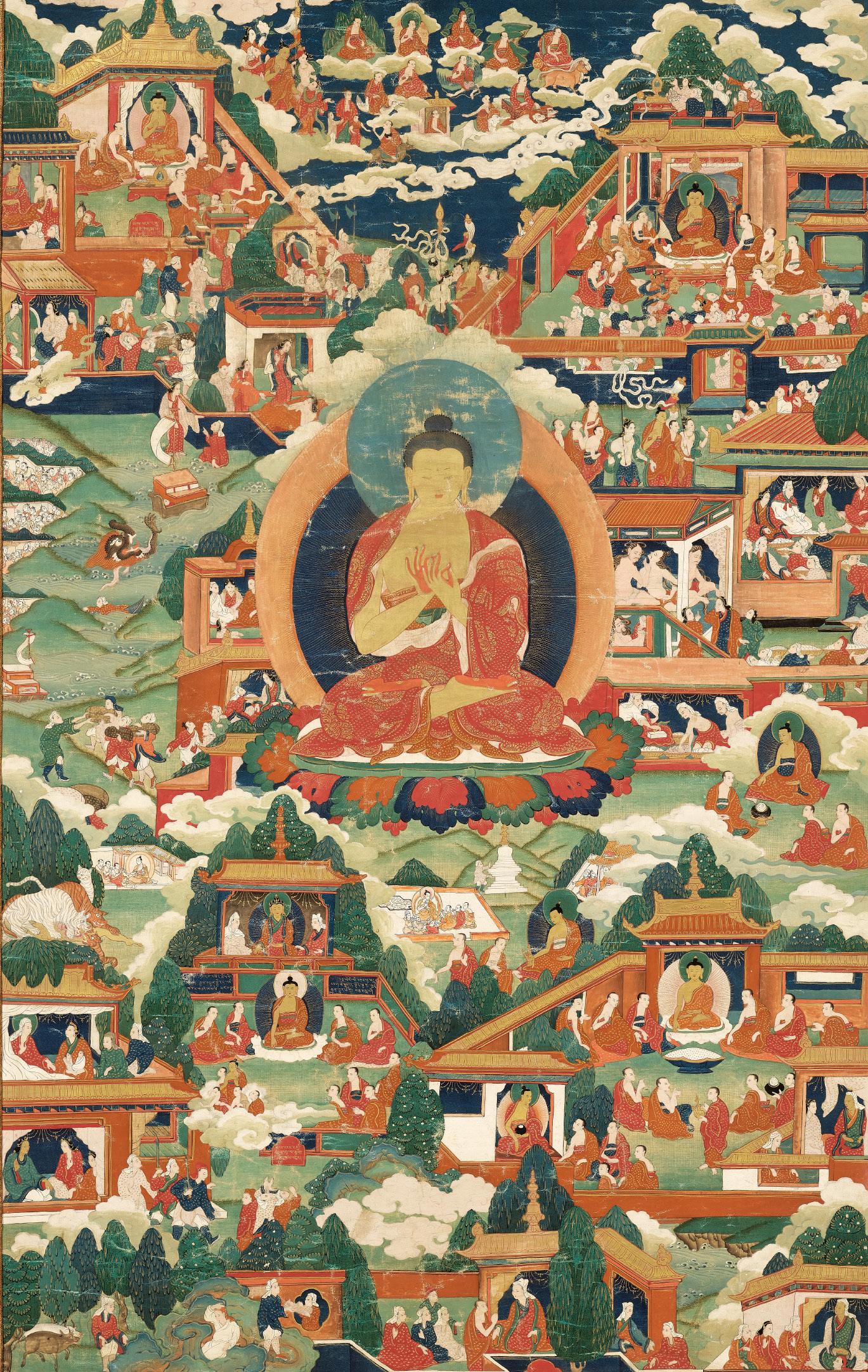
305
A RARE THANGKA DEPICTING THE BUDDHA’S PARINIRVANA, TIBET, 18TH - 19TH CENTURY

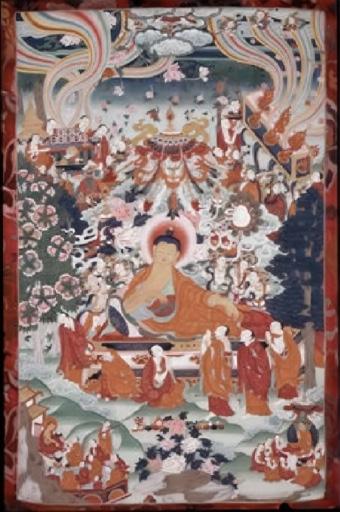
At the center, Buddha reclines on a bed surrounded by a crowd of mourners lamenting his death. The Buddha’s expression is peaceful and serene, lying on his right side with his hand propping up his head, exposing the wheel of dharma engraved on his palm. Below the Buddha are two scenes depicting the arrival of the aged Buddha in Kushinagara, where he died. The upper right corner depicts the cremation of the deceased Buddha, and the upper left scene depicts the veneration of his ashes.
Provenance: From an old private collection in Germany, where it was displayed as the centerpiece of the collection.
Condition: Very good condition with little wear, light creasing, and minor soiling. The brocade mounting with minor discoloration and small tears.
Dimensions: Image size 70 x 44 cm, Size incl. brocade mounting 134.5 x 73.5 cm
Distemper and gold on cloth, with a silk brocade frame and mounted as a hanging scroll with metal openwork fittings.
The death of the Buddha, also known as the Buddha’s Parinirvana referring to the Buddha’s enlightenment after death, has been depicted widely in Buddhist iconography and is accounted in the Mahaparinirvana sutra. According to Buddhist tradition, the Buddha died in Kushinagara, Northern India, with the traditional dates of Buddha’s life from 566-486 BC. After his death, the Buddha’s body was cremated and distributed among his followers. The stupas that guarded his remains became important pilgrimage sites for Buddhists.
The Mahaparinirvana sutra is one of the most important Buddhist scriptures in China and Tibet, and it relates the events surrounding the Buddha’s death. The precise date of origin of this text is uncertain, but its early form may have developed in or by the second century CE. The original Sanskrit text is not extant except for a small number of fragments, but it survives in Chinese and Tibetan translation.
LITERATURE COMPARISON
Compare a related Tibetan thangka depicting the death of Buddha, 67 x 49 cm, dated to the late 18th century, in the Museum of Fine Arts, Boston, accession number 48.274. Compare a related thangka depicting the death of Buddha, in the Santa Barbara Museum of Art, illustrated on Himalayan Art Resources, item no. 88902 (fig. 1). Compare a related Tibetan thangka depicting the death of the Buddha, dated 19th-20th century, in the Oriental Museum, Durham University (fig. 2).
306
196
Estimate EUR 10,000 Starting price EUR 5,000
fig. 2 fig. 1
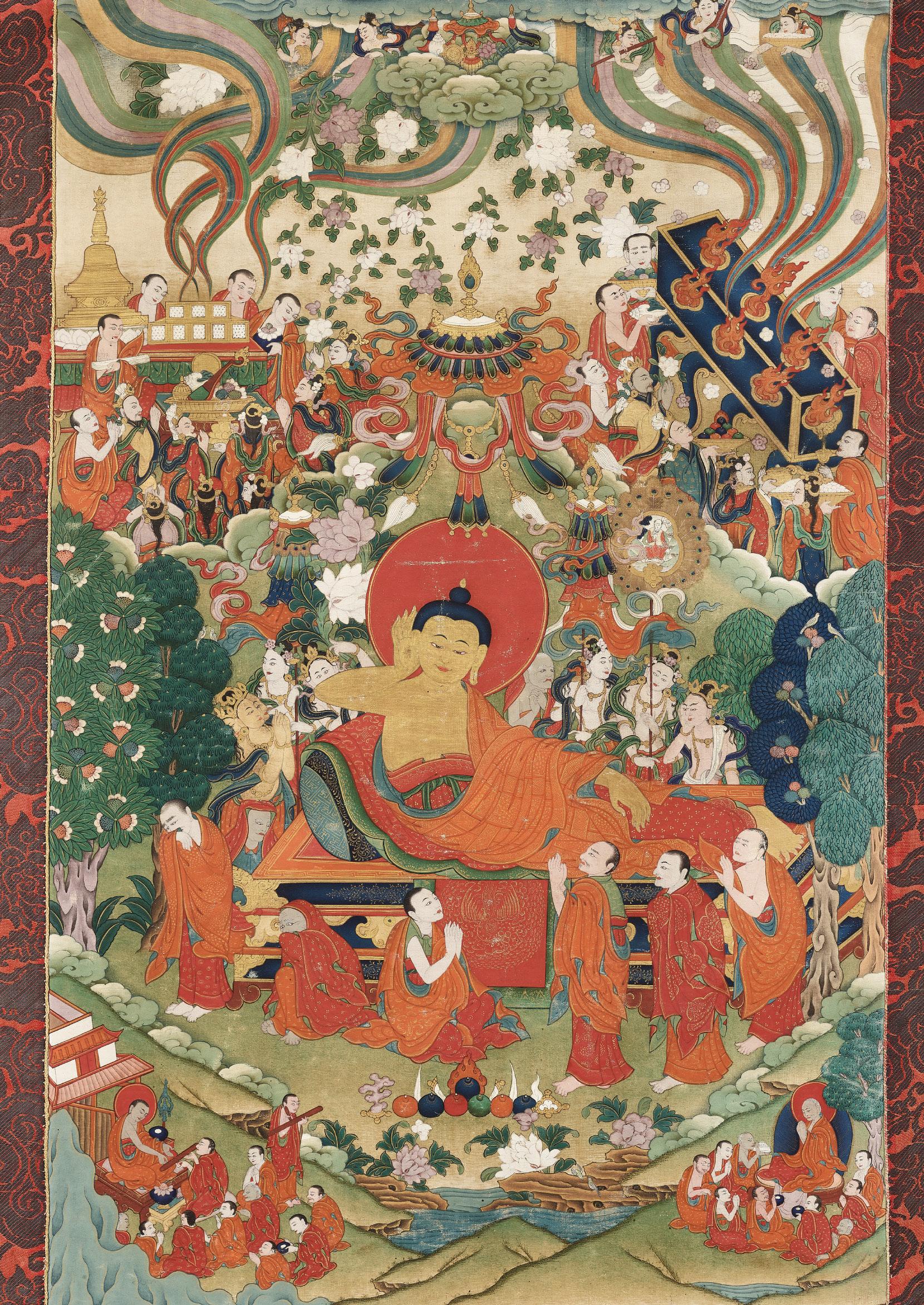
A THANGKA DEPICTING VAJRAPANI AND CONSORT, 17TH-18TH CENTURY OR EARLIER
Tibetan-Chinese. Distemper and gold on cloth. Finely painted as a blue-skinned Vajrapani trampling on two figures over a lotus base, wielding a vajra in his raised right hand and a ghanta in his lowered left, wearing a tiger-skin belt, a serpent garland of severed heads, and billowing scarves. His body adorned with gold and snake jewelry, his consort wielding a skull cup, similarly adorned and wearing a beaded apron, all backed by a colorful mandorla below the dark-blue foliate background.

Provenance: From a French private collection. Condition: A small tear to the top left corner, otherwise in good condition commensurate with age. Some old wear, a few small losses, minor creasing, rubbing, stains and soiling. Some chips and stains to the frame.
Dimensions: Image size 46 x 41 cm, Size incl. frame 86 x 64 cm
LITERATURE COMPARISON
Compare a related Tibetan thangka depicting Vajrapani with consort, dated to the 15th century, in the Rubin Museum of Art, accession number P.1994.7.1, illustrated on Himalayan Art Resources, item no. 11.
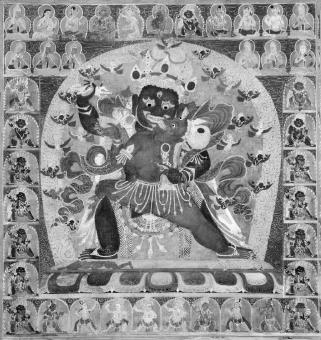
Estimate EUR 15,000
Starting price EUR 7,500
308
197
Matted and framed behind glass.
A THANGKA DEPICTING RUDRA CHAKRIN, THE LAST KULIKA KING OF SHAMBHALA, TIBET, 18TH-19TH CENTURY
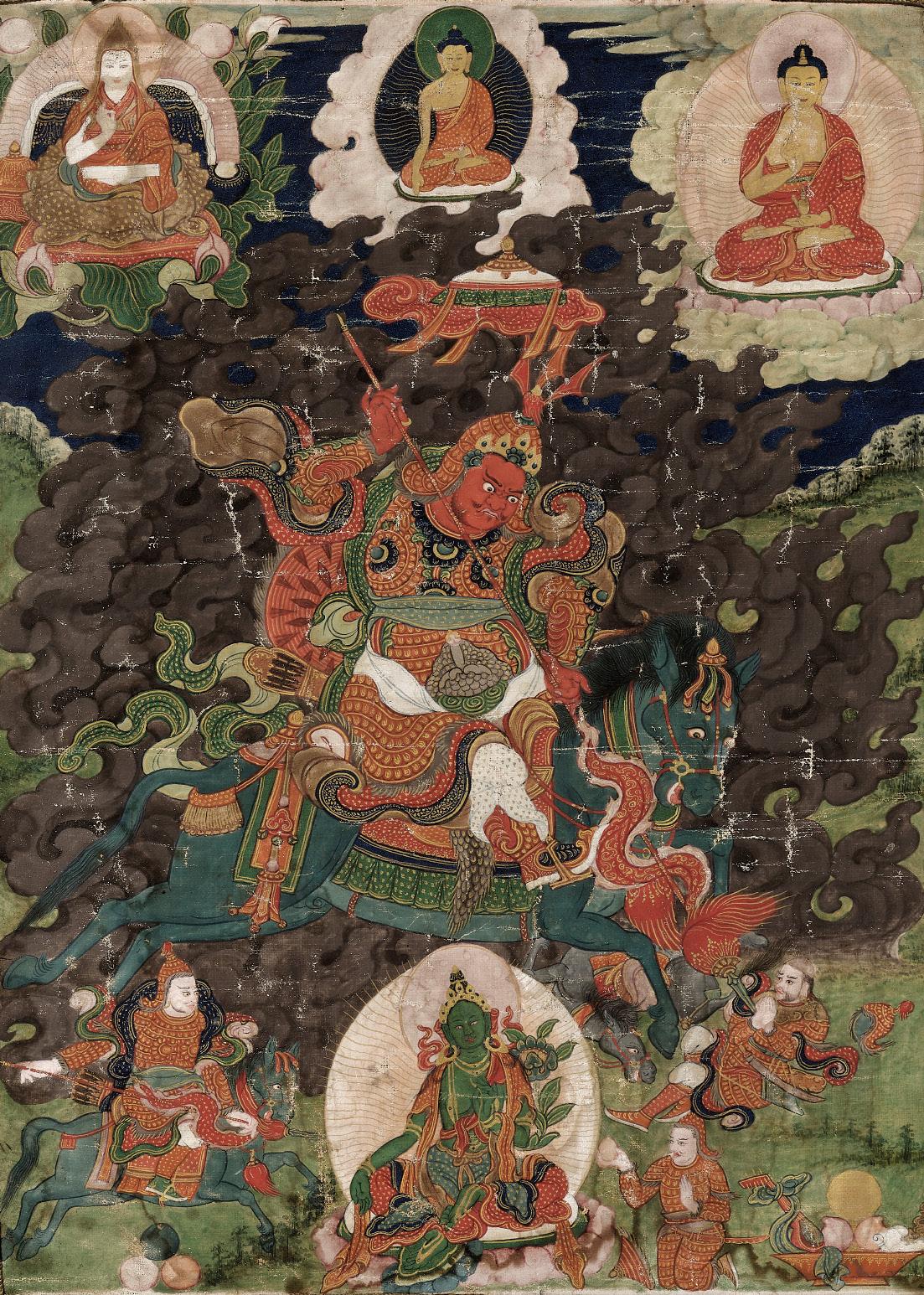
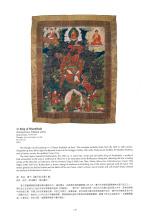
The heavily armored red-skinned king with wrathful expression, protected by a parasol above and engulfed in dark flames, riding a dark blue horse and driving his lance through the chest of an enemy general who has fallen from his slain horse lying beside him. The upper register with a central image of Buddha Shakyamuni flanked by a lama of the Gelugpa order and the Future Buddha Maitreya, the lower register Green Tara surrounded by two further warriors as well as offerings, all within a verdant landscape.
Provenance: From the collection of Dr. Wou Kiuan. Wou Lien-Pai Museum, coll. no. P.43. Dr. Wou Kiuan (1910-1997) was a Chinese diplomat and noted scholar of Chinese art.
Condition: Good condition with some old wear, light soiling, and minor creasing.
Dr. Wou Kiuan, Paris, November 1939

Dimensions: Image size 38 x 27.2 cm, Size incl. frame 65.8 x 51.7 cm
PUBLISHED Roderick Whitfield (editor), Classic Chinese Art: Selected Catalogue of the Paintings and Calligraphy from the Wou Lien-Pai Museum, Surrey, 2011, page 148, no. 46.
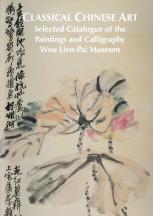
Distemper and gold on cloth, with a silk brocade frame.
According to Roderick Whitfield, “The main figure represents Rudracakrin, the 25th (or, in some lists, 32nd) and last Kulika King of Shambhala. He is an emanation of the Bodhisattva Manjushri, defeating the four invading armies of the Mlecchas or barbarians, led by Krinmati, King of Delhi.” (See Classic Chinese Art: Selected Catalogue of the Paintings and Calligraphy from the Wou Lien-Pai Museum, Surrey, 2011, page 148.)
Article continues online at www.zacke.at
Estimate EUR 6,000
Starting price EUR 3,000

309 198
A PAIR OF ALBUMS, EACH WITH TWELVE ‘BUDDHIST SYMBOLS’ PAINTINGS,
BY MEI LANFANG (1894-1961)
China. Comprising two accordion albums, each with twelve leaves, painted with ink and color on paper. Each leaf depicts the hand of a Buddhist deity or celestial maiden, emerging from swirling clouds and adorned with a gold bracelet suspending a red, a blue, and a green bead, and holding various attributes, accompanied by identifying inscriptions and excerpts from sutra texts, all within a band of alternating scroll designs and dharmachakra enclosed by an S-scroll border.
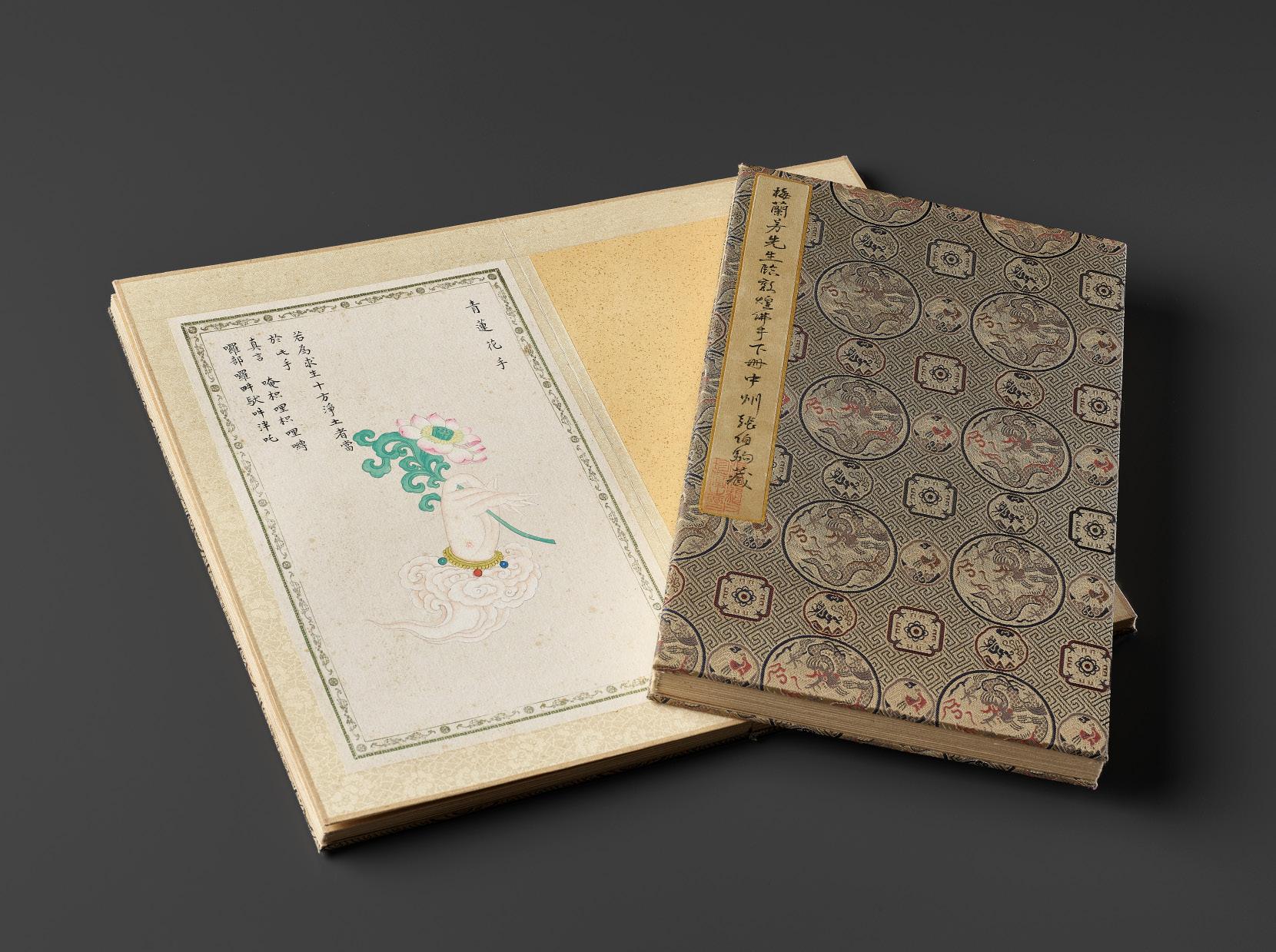
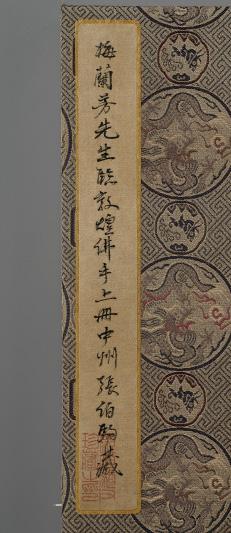
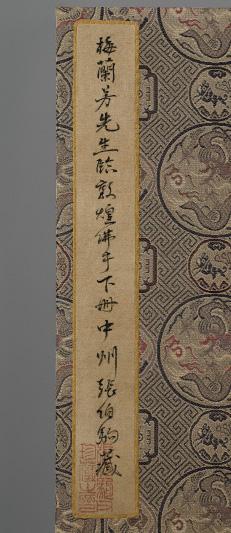
Inscriptions: The titleslip of the first album: ‘Mei Lanfang
xiansheng lin Dunhuang
foshou
shangce
Zhongzhou
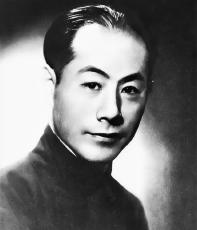
Zhang
Boju cang’ (Buddhist hand poses from the Dunhuang Caves by Mei Lanfang, Volume 1, Collection of Zhang Boju from Zhongzhou).
The titleslip of the second album: ‘Mei Lanfang xiansheng lin Dunhuang foshou xiace Zhongzhou Zhang Boju cang’ (Buddhist hand poses from the Dunhuang Caves by Mei Lanfang, Volume 2, Collection of Zhang Boju from Zhongzhou).
Provenance: Formerly in the collection of Zhang Boju (1898-1982), who was known as one of the ‘Four Young Princes’ of the Republican era, who became one of the country’s most discerning, as well as generous, connoisseurs and collectors of antiquities. He was China’s most celebrated private art collector. His father Zhang Zhenfang was related by marriage to the first president of the Chinese Republic, Yuan Shikai, and himself was Chairman of the Board of the Salt Industry Commercial Bank. Zhang used his family’s large fortune to indulge his love of antiques and art. He became an expert in this field, exchanging silver dollars, gold bars, jewelry, property, and even risking his own life (he was once kidnapped) to amass a collection of inestimable treasures that could rival those of the Palace Museum. He is quoted as once saying, “I do not wish to possess the things I collect. They should be handed down from one generation to the next. I sit at my desk and bury my head in my old books. This is the scholar’s true task. May the weapons of war give way to eternal peace and may the people live in tranquility. What greater happiness can there be than this?”
Condition: Very good condition with only very minor wear, little soiling and foxing, few tiny losses, and few minuscule tears.
310 199
Dimensions: Image size ca. 30 x 19.5 cm (each), Album size 36 x 22.5 cm (each)
Each album with a silk brocade front and back cover finely decorated with dragon roundels on a key-fret ground. (2)
(Vol. 1) (Vol. 2)
Zhang Boju in his youth
The paintings on the present albums are based on statues or murals in the Dunhuang Caves, a term used to describe the famous Mogao Caves in Dunhuang, but also a collective term to include other Buddhist cave sites in and around the Dunhuang area, such as the Western Thousand Buddha Caves, Eastern Thousand Buddha Caves, Yulin Caves, and Five Temple Caves. Situated at a strategic point along the Silk Route, the Mogao Caves are situated at the crossroads of trade as well as religious, cultural, and intellectual influences. The 492 cells and cave sanctuaries in Mogao are famous for their statues and wall paintings, spanning 1,000 years of Buddhist art. Carved into the cliffs above the Dachuan River, the 492 caves are presently preserved, housing about 45,000 square meters of murals and more than 2,000 painted sculptures. These works provide an abundance of vivid materials depicting various aspects of medieval politics, economics, culture, arts, religion, ethnic relations, and daily dress in western China. The unique artistic style of Dunhuang art is not only the amalgamation of Han Chinese artistic tradition and styles assimilated from ancient Indian and Gandharan customs, but also an integration of the arts of the Turks, ancient Tibetans, and other Chinese ethnic minorities. Many of these masterpieces are creations of an unparalleled aesthetic talent.
Mei Lanfang (1894-1961), born Mei Lan, was an important Beijing opera (Jingju) artist in modern Chinese theater, and an accomplished painter. Mei was known as the ‘Queen of Peking Opera’ and was exclusively known for his female lead roles (dan), particularly his ‘verdant-robed girls’ (qingyi), young or middle-aged women of grace and refinement. He was considered one of the Four Great Dan, along with Shang Xiaoyun, Cheng Yanqiu, and Xun Huisheng. Born into a family of famous actors, he learned from his family members and also from many teachers and went on to become a pioneer of the newly emerging dan (a female role) actor genre in the early 20th century. His performance style was rigorous and refined yet elegant and beautiful, appearing reserved but actually full of complexity: his singing was exquisite, pure and full; his spoken lines were delivered in a sweet but rich voice, strong but not rough. Mei’s famous portrayal of Beauty Yu was so historically moving that Wenting Song said he was one of the greatest vocal artists in modern China.

Mei was the first artist to spread Beijing opera to foreign countries, participating in cultural exchanges with Japan, the United States, and other regions. He toured the world, forming friendships with the western contemporaries of his day, including Charlie Chaplin. In 1930, he toured North America, visiting Hollywood, where he was welcomed by Douglas Fairbanks and Mary Pickford. In 1935, Mei toured Europe, playing to appreciative audiences in Berlin and Moscow. Seeing Mei perform especially impressed the German playwright Bertolt Brecht and influenced his concept of the alienation effect.
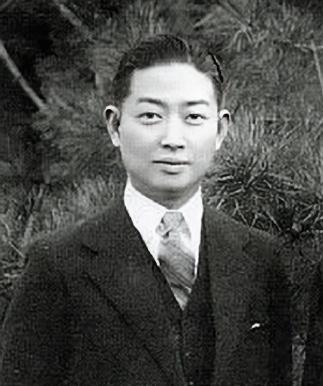
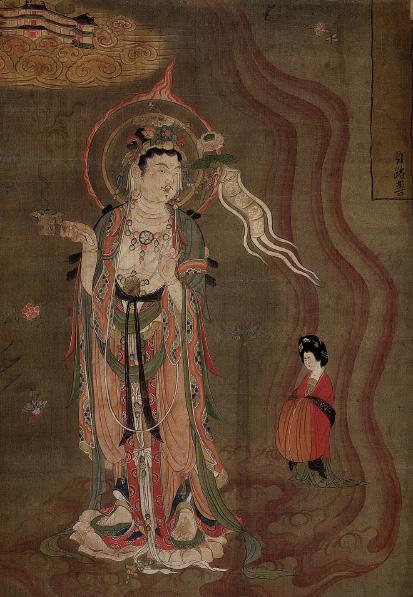
In July 1937, the Marco Polo Bridge Incident occurred, and the Imperial Japanese Army soon occupied Beijing. The commander of the Japanese Army ordered Mei to perform for them and appointed Mei to a high rank official position, but Mei refused to sing throughout the duration of the war and endured an impoverished lifestyle until the war ended in 1945. During this period, he relied solely on selling his paintings. After 1949, he served as director of the China Beijing Opera Theater, director of the Chinese Opera Research Institute, and vice chairman of the China Federation of Literary and Art Circles.
AUCTION
RESULT COMPARISON
Type: Related
Auction: China Guardian, Beijing, 21 March 2010, lot 1379
Price: CNY 156,800 or approx. EUR 28,000 converted and adjusted for inflation at the time of writing
Description: Mei Lanfang, landscape and flowers
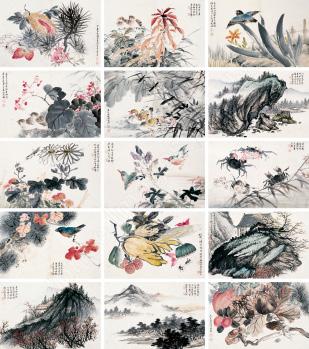
Expert remark: Compare the album of twenty-four small paintings (24 x 36 cm) by the same artist, albeit depicting a different subject.
Estimate EUR 10,000
Starting price EUR 5,000
311
A silk painting from the Mogao Caves, depicting a bodhisattva leading a lady donor towards the Pure Lands. Painting on silk (Library Cave), Late Tang; note the similar lotus held in the bodhisattva’s left hand
Mei Lanfang (1894-1961)
Mei Lanfang (1894-1961) in costume
The attributes and identifying inscriptions to each leaf are as follows:
VOL. 1
LEAF 1 (left) with a bronze seal with red ribbon (‘Kuanyin shou’).
LEAF 2 (middle) with a flaming pearl (‘Ruyiqiu shou’).
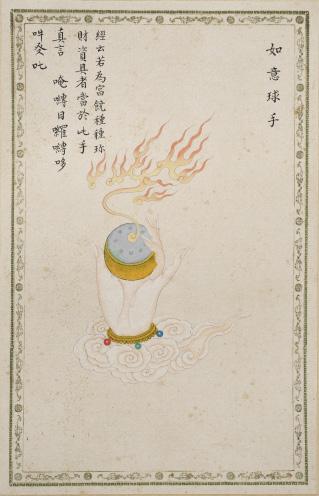
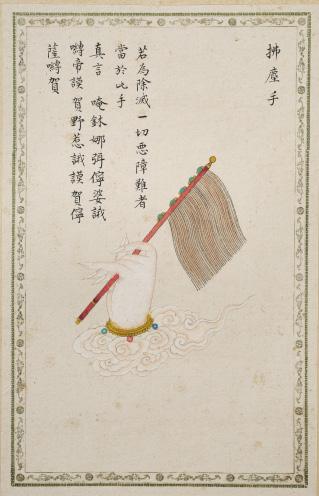
LEAF 3 (right) with a vajra (‘Jingangchu shou’).
LEAF 4 (left) with a lotus blossom (‘Honglianhua shou’).
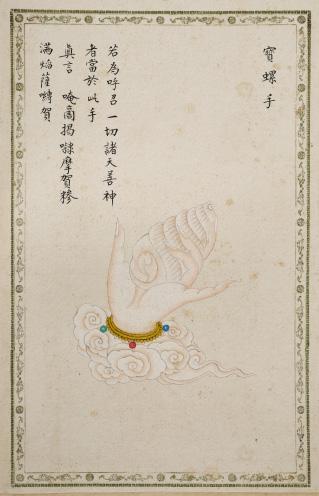


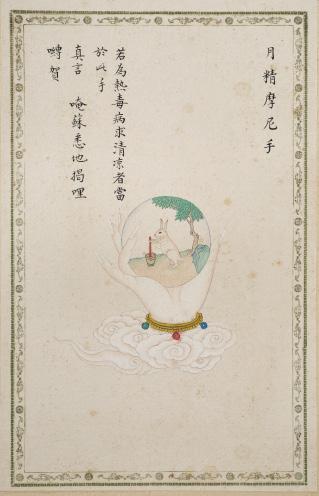


LEAF 5 (middle) with a vase decorated with cloud designs (‘Baoping shou’).

LEAF 6 (right) with a lotus blossom (‘Qinglianhua shou’).
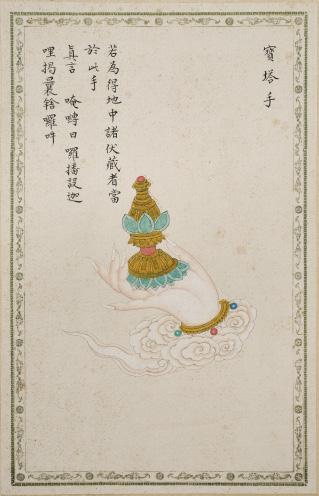

LEAF 7 (left) with a fly-whisk (‘Fuchen shou’).
LEAF 8 (middle) with a bronze model of a pagoda decorated with lotus petals (‘Baota shou’).
LEAF 9 (right) with a khakkhara or Buddhist monk’s staff (‘Xizhang shou’).
LEAF 10 (left) with a ceremonial axe (‘Fuyue shou’).
LEAF 11 (middle) with a crystal ball showing the Lunar Hare making the elixir of immortality (‘Yuejingmoni shou’).
LEAF 12 (right) with a conch (‘Baoluo shou’).
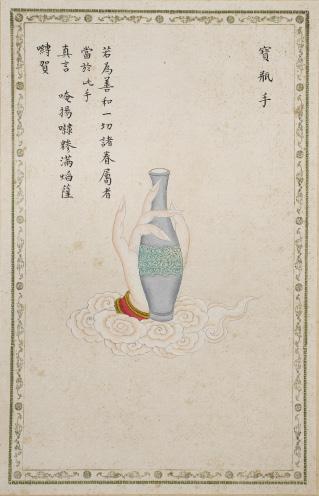
312
VOL. 2
LEAF 1 (left) with a blue-glazed and golddecorated kendi (‘Junchi shou’).
LEAF 2 (middle) with a sword, the pommel and cross-guard decorated with ruyi emblems (‘Baojian shou’).
LEAF 3 (right) with a book (‘Baojing shou’).
LEAF 4 (left) with a magic mirror with red ribbons (‘Baojing shou’).
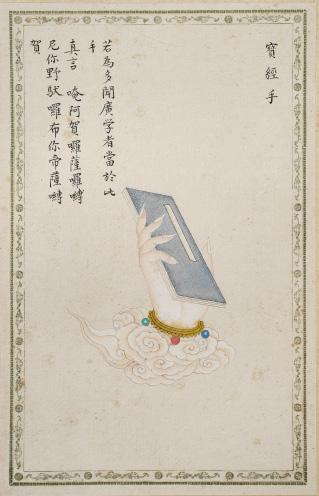
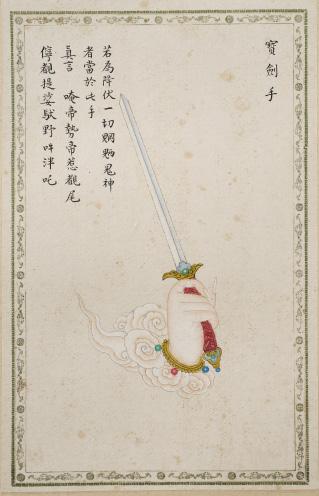
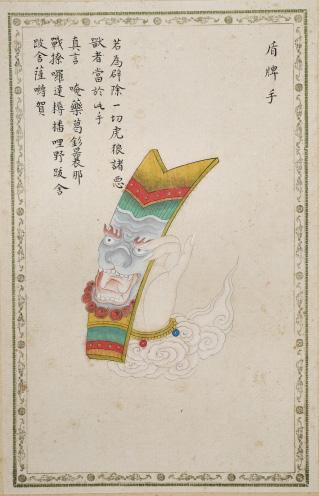
LEAF 5 (middle) with a temple building (‘Huagongdian shou’).
LEAF 6 (right) with a ceremonial dagger with blue ribbons (‘Baoji shou’).
LEAF 7 (left) with a vajra (‘Bazheluo shou’).
LEAF 8 (middle) with a gold alms bowl decorated with scrolling foliage and lotus petals (‘Baobo shou’).
LEAF 9 (right) with a lotus blossom (‘Baolianhua shou’).



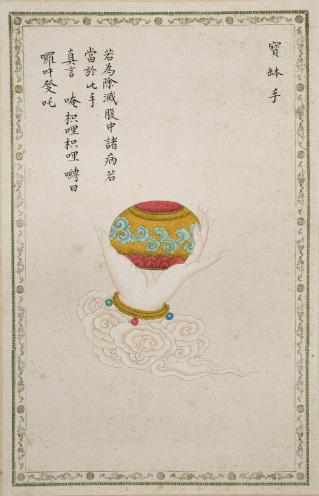
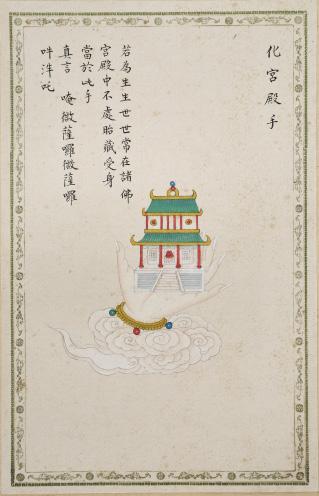
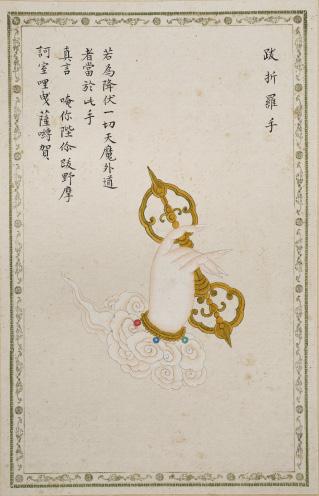

LEAF 10 (left) with a tablet with a fierce lion mask (‘Dunpai shou’).
LEAF 11 (middle) with a gold ghanta (‘Baoling shou’).
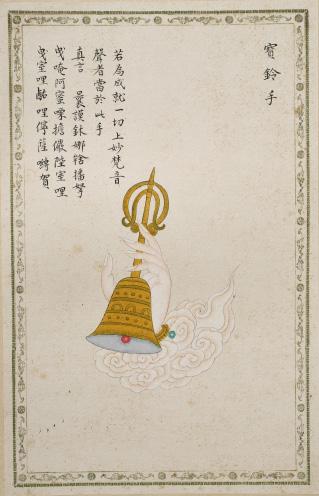
LEAF 12 (right) with a ceremonial dagger (‘Kulouzhang shou’).
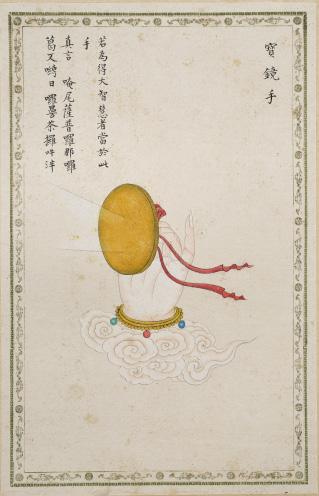
313
200
A RARE AND IMPORTANT ALBUM LEAF FROM THE HUANGCHAO LIQI TUSHI WITH AN IMPERIALLY INSCRIBED SILK PAINTING OF THE EMPRESS DOWAGER AND EMPRESS CONSORT’S DRAGON VEST (CHAOGUA), QIANLONG PERIOD
Expert’s note: The present pair of leaves may belong to the same manuscript as those in the British Library, the National Museums of Scotland, the National Museum of Ireland, the Victoria & Albert Museum, and those sold at Woolley & Wallis, 12 November 2019. Altogether, these may once have been part of the version kept in the Wenyuan Pavilion library in the Yuanming yuan Summer Palace, Beijing, as indicated by the main seal on two pages from the manuscript in the Victoria & Albert Museum.
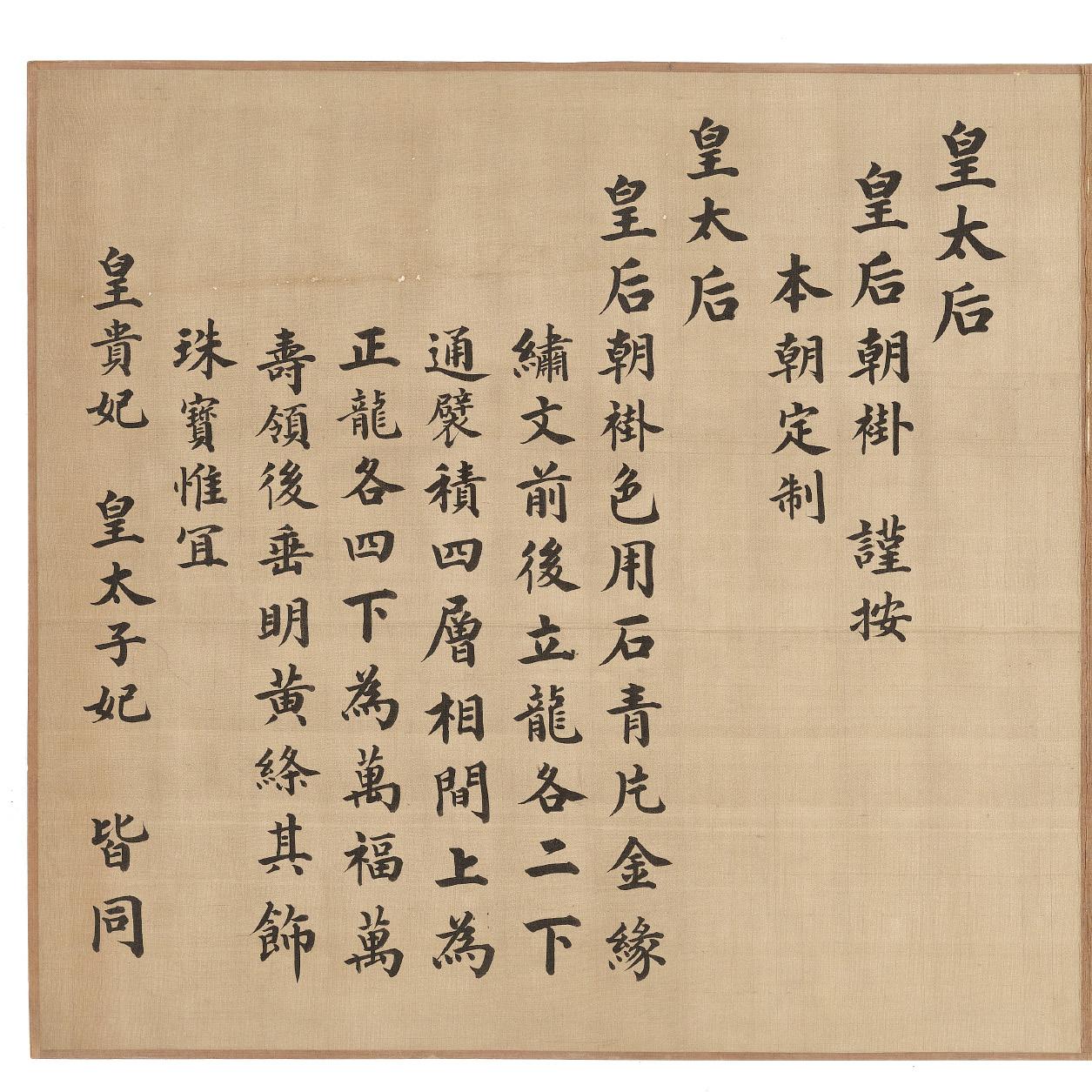
China, 1750-1759. Ink and watercolors on silk, laid down on paper. One side illustrating an Imperial dragon vest (chaogua) of the Empress Dowager and Empress consort, and the other side with eleven lines of inscription regarding the regulations for such vests. Exquisitely painted, the dragon vest is designed with six golden fiveclawed dragons pursuing flaming pearls on a midnight-blue ground surrounded by polychrome lingzhi-form clouds above crashing waves. The black-ground hem and borders are shown in gold thread with scroll designs, and the interior is lined with red silk.
Inscriptions: Right hand leaf, ‘The painting of the official vest of the Empress Dowager and Empress consort.’ Left hand leaf, ‘The empress dowager and the empress consort’s official vest shall be made in accordance with the regulations of our era: the empress dowager and the empress consort’s vest should be an azurite blue and have gold hems and seams. The front and back shall have two standing dragons above four further levels with four dragons. Below are to be ten thousand bats and ten thousand shou and behind the color a yellow sash with jewelry. The imperial concubine and crown princess shall follow similar regulations.’
Provenance: French trade.
Condition: Very good condition with minor wear, little soiling, minor creasing, few tiny losses.
Dimensions: 41.8 x 39 cm
The present album leaf is part of the Huangchao Liqi Tushi (The Illustrated Regulations for Ceremonial Paraphernalia of the Present Dynasty), an illustrated manuscript commissioned by the Qianlong Emperor. The main body of the work began to be compiled in 1750 and was completed in 1759. After editing and further expansion of the manuscript during the ensuing years, it was duplicated by the Palace Publications Office in the Wuying Palace in 1766 and was eventually added to the Siku Quanshu (Complete Library of the Four Treasuries) in 1773. Only seven copies of the manuscript were produced, stored in libraries across the empire, including the Wenyuan Pavilion library in the Summer Palace (Yuanming yuan), Beijing.
The Huangchai Liqi Tushi was part of the Qianlong Emperor’s effort from the beginning of his reign to regulate the ritual codes and procedures, and it serves as a record of his passion for a rigid ritualized life. The book consists of six parts – ceremonial vessels, scientific equipment, dress, musical instruments, insignia, and weaponry, containing more than 1,300 leaves of illustrations and explanatory texts. As one of the major imperial commissions, the book is of monumental scale and collaborative in nature. As many as twenty-seven court painters and calligraphers were working on the commission under five editors-in-chief, Yilu (1695-1767), Jiang Pu (17081761), Wang Youdun (1692-1758), Guanbao (d. 1776), and He Guozong (d. 1766).
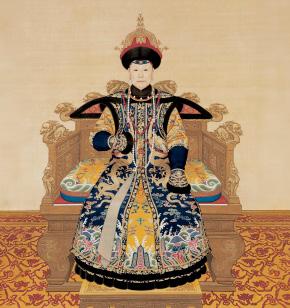
314
Empress dowager Xiaoshengxian (1735-1777), the mother of the Qianlong Emperor, on her sixtieth birthday, wearing a dragon vest in this court painting in the Palace Museum, Beijing
The seal inscription on the manuscript kept in the Victoria & Albert Museum, which reads ‘The Treasure of the Garden of Perfect Brightness,’ establishes that it once belonged in the Wenyuan Pavilion library in the Yuanming yuan Summer Palace, Beijing. The present lot may have once been a part of this manuscript.
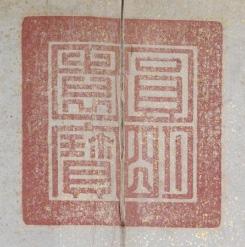
The Qing dynasty Chaogua was adapted from the dragon-patterned sleeveless coats worn unofficially at the Ming dynasty court. The mideighteenth century court dress edicts assigned three styles of this garment to the upper ranking court women. All were made of dark navy blue silk and featured a center front opening held with five toggle and loop fastenings, angled shoulder seams and deeply cut armholes. The first and second styles were tailored as multi-sectioned constructions with horizontal bands of dragons, clouds, and waves. The third style was full length without sections. A fourth style, which could be worn by all ranks of women including the wives of nobles not related to the imperial clan and the wives of other high officials featured mang, or four-clawed dragons. The chaogua painted on the present lot is of the first style, a full-length vest made of three sections – an upper part, a section from waist to knee, and a section from knee to hem with five horizontal bands embroidered with five-clawed dragons and auspicious symbols.
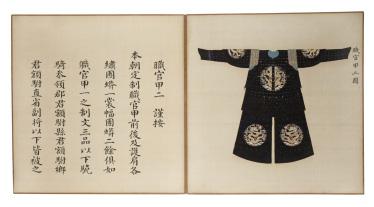

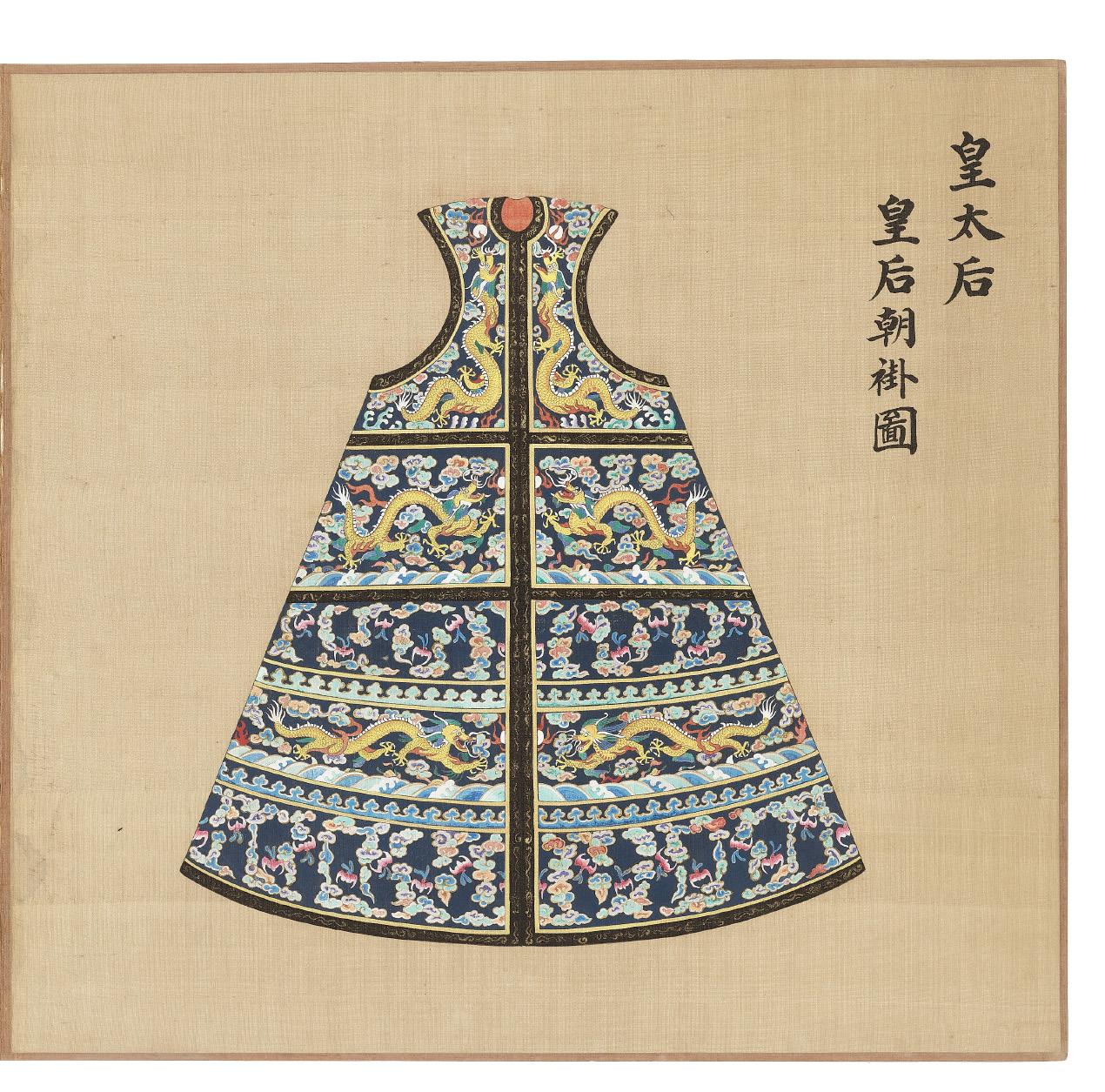
LITERATURE COMPARISON
Compare an illustrated manuscript with 38 folios preserved, two leaves showing the front and back of a similar dragon vest, the leaves of closely related size (42 x 40 cm), dated to the Qianlong period, once in the Summer Palace and now in the British Library, number OR 9430. Compare a closely related page from the Huangchao Liqi Tushi illustrating the front and back of a dragon vest worn by imperial concubines of the first rank, 42.3 x 41.3 cm, dated to the Qianlong period, in the Victoria & Albert Museum, accession number 856-1896 (fig. 1). fig.
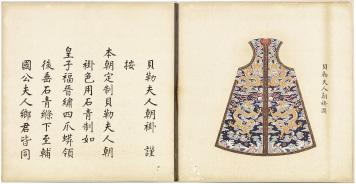
AUCTION RESULT COMPARISON
Type: Closely related
Auction: Christie’s Paris, 13 December 2017, lot 108
Price: EUR 47,500 or approx. EUR 55,500 adjusted for inflation at the time of writing
Description: Six rare and important album leaves, Huangchao liqi Tushi, Qianlong period
Expert remark: Compare the closely related manner of painting, calligraphy, and size (42 x 41 cm), as well as the related dragon vest illustrated on the final page. Note this lot comprises six album leaves.
AUCTION RESULT COMPARISON
Type: Related
Auction: Woolley & Walis, 12 November 2019, lot 16
Price: GBP 225,000 or approx. EUR 345,000 converted and adjusted for inflation at the time of writing
Description: Album leaves from the imperial household regulations (Huang Chao Li Qi Tu Shi)
Expert remark: Compare the closely related manner of painting and calligraphy. Note this lot comprises twelve paintings. Note the closely related size (41 x 42.5 cm).
Estimate EUR 8,000
Starting price EUR 4,000
315
1
AN IMPERIAL YELLOW-GROUND GAUZE TWELVE-SYMBOL ‘DRAGON’ ROBE, JIFU, MOST LIKELY MADE FOR THE EMPRESS DOWAGER CIXI, CHINA, C. 1861-1875
Superbly worked in gauze with couched gold thread and satin stitch on the front and back with nine five-clawed dragons and shou medallions, amidst dense stylized clouds interspersed with bats confronting double peaches, auspicious characters and the twelve imperial symbols above the terrestrial diagram with lishui stripe at the hem, all picked out in shades of blue, green, purple, red, and ochre, and reserved on an Imperial yellow ground. With a black-ground dragon border at the collar, cuffs and mid-sleeves, and a second narrow band of stylized wan diapered design on black ground. The lack of a front and back vent and the inclusion of sleeve extensions identify this as a woman’s robe
Provenance: The Property of a Gentleman. Christie’s New York, 21-22 September 1995, lot 517. An important American collection of Chinese robes, acquired from the above. To the side, a Christie’s label, ’22 Sep 95 Sale 8220 Lot 517.’ Note that according to Christie’s ‘it appears that the Empress Dowager used all Twelve Symbols’ (on her robes) ‘when she ruled during the minority of her son’ (see the corresponding auction catalog entry from 1995).
Condition: The present robe is likely the finest example of an Imperial twelve-symbol robe that exists. It is exceptionally well-preserved and remains in superb condition overall. There are only minimal signs of wear, with very few loose threads present. There are no stains, spots, or soiling, and the robe has not suffered any material loss whatsoever. The colors of the robe are remarkably vibrant and sharp. It is important to note that this particular robe has never been exposed to sunlight or displayed. It may have been worn on one or two occasions, but certainly not more frequently. In general, the discovery of a robe in such pristine condition is an exceptionally rare occurrence
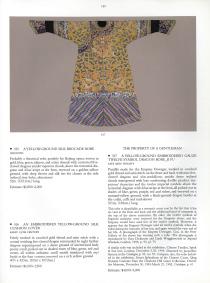
Dimensions: Length 129 cm, Width 183 cm (across sleeves)


Expert’s note:
Very few robes have been attributed to Empress Dowager Cixi, and notably, none of them have been found in gauze fabric, let alone in mint condition. The remarkable absence of any signs of wear on this robe is a testament to its impeccable storage and care over the past 150 years. Unlike most Qing Dynasty robes discovered today, which have not been preserved across multiple generations in such a meticulous manner, this robe’s pristine state suggests that the person who originally brought it from China to the West was fully aware of its historical significance.
Moreover, it is likely that this individual acquired knowledge of the robe’s importance from a trusted and credible source. Considering the tumultuous period of the Boxer Rebellion in 1906 when the robe probably left the Forbidden City in Beijing, reliable sources were rare. Therefore, it seems probable that the robe was initially obtained either from someone in close proximity to the Empress Dowager or directly from Cixi herself. In either case, this person would have imparted the robe’s exceptional significance to the subsequent owner, ensuring the passage of this valuable information from one generation to the next.
As a result, the present robe has consistently been safeguarded under a stringent and comprehensive regime throughout its whole journey, which elucidates its enduring pristine condition until the present day. The continued responsibility and preservation of a robe of this importance, thus, becomes an important duty for its future keepers.
LOT ESSAY I
Imperial clothes were designed to indicate rank and status, becoming so distinct that the wearer’s position in court could be ascertained at a glance. Yellow was considered to be the most auspicious shade, and was reserved for the royal family. Minor princes or noblemen were permitted to wear blue (the Qing dynasty’s official color) or brown, while blue-black fabric indicated the wearer was a court official. Emperor’s robes were decorated with the ‘Twelve Symbols of Imperial Authority’: the sun, moon, seven-star constellation, mountain, fu pattern, axe head, dragon, flowery creature, seaweed, sacrificial cup, flames and the grain. Civil and military officials were divided into nine ranks, from first (highest) to ninth (lowest). Each was indicated by a corresponding animal, stitched on to a rank badge, or bufu, displayed on an outer coat. Civil ranks were represented by birds, while real and mythical animals indicated military status.
The Twelve Symbols of Imperial Authority first appeared on the Manchu emperor’s clothing after 1759. These symbols were superimposed on the general decorative schema of Qing court garments, losing the visual prominence they had enjoyed during the Ming dynasty. Nonetheless, they emphatically demonstrated the Qing intention of embracing the traditional role as rulers of the Chinese empire. Under the Qing, the first four symbols, notably the sun, moon, stars, and mountain, were placed at the shoulders, chest and mid-back. The symbol of distinction, notably the axe, rule, paired dragons, and golden pheasant appeared at waist level. The temple-cups, aquatic grass, grains of millet, and flames were placed at knee level on the skirts of the coat.
By edict, the twelve symbols of Imperial authority were reserved for the Emperor in the Huangchao Liqi Tushi (Illustrated Regulations for Ceremonial Paraphenalia of the Qing dynasty) published in 1766. This can be further ascertained from the absence of the symbols from the design of the court robes of the empress and even the crown prince. No other rank of noble was permitted to use all or any of the Twelve Symbols. Nevertheless, the emperor could, if he so wished, confer the right to use even this highest distinction as a mark of favor. In European and American collections, both public and private, there are a number of Qing court robes, in various colors and tailored for both men and women which bear 12, 8, 4, or even 2 of the Twelve Symbols. Most of these robes date from the second half of the nineteenth century. Those that have all Twelve Symbols and were made for women usually have a yellow ground. It seems most likely that these were worn by an empress or Empress Dowager and there is significant evidence to support this view. We know, for example, that the Empress Dowager Xiaoho, a widow of the Jiaqing Emperor, wore dragon robes with at least three of the four highest symbols.
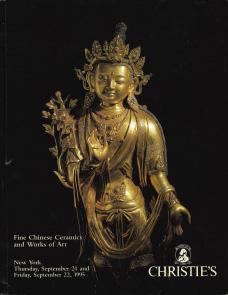
316 201

317
A photograph of the Empress Dowager Cixi wearing what is probably a Twelve Symbol dragon robe. The Constellation, Sun and Moon are clearly visible and the Sacrificial Vessels and Water Plant can be glimpsed above the water motifs at the bottom of the robe. Freer Gallery of Art, Smithsonian Institution, Washington DC.
The Empress Dowager Cixi (1835-1908) used all Twelve Symbols on her Imperial yellow robes when she ruled during the minority of her son, and possibly again toward the very end of her life, in the early 1900s. The reign of her son, the Tongzhi Emperor (1856-1875), effectively lasted through his adolescence, from 1861-1875, and was largely overshadowed by the rule of his mother. Tongzhi himself had rather little influence over state affairs, a fact that today may be regarded as a possible reason for why his mother chose to wear robes that originally were meant to be worn exclusively by the Emperor. Photographs of Empress Dowager Cixi, wearing what is probably a Twelve Symbol dragon robe, have survived to support this theory and now reside in the Freer Gallery of Art, Smithsonian Institution, Washington. The Constellation, Sun and Moon are clearly visible on this robe, and the Sacrificial Vessels and Water Plant can be glimpsed above the water motifs at the bottom.
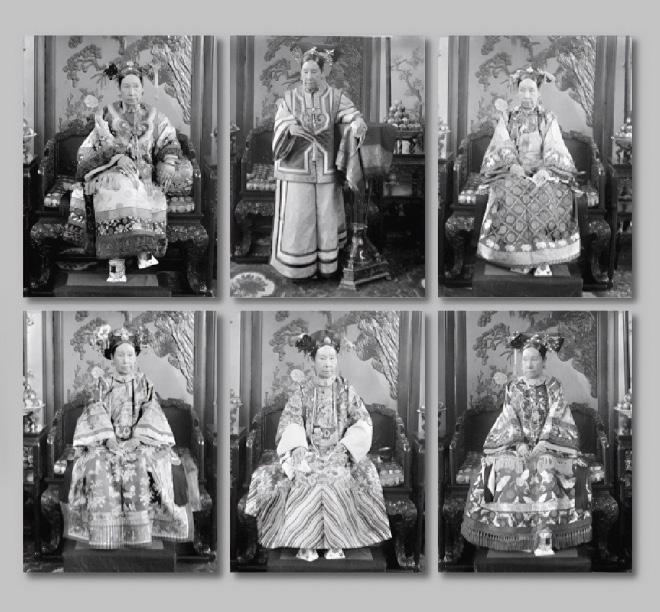
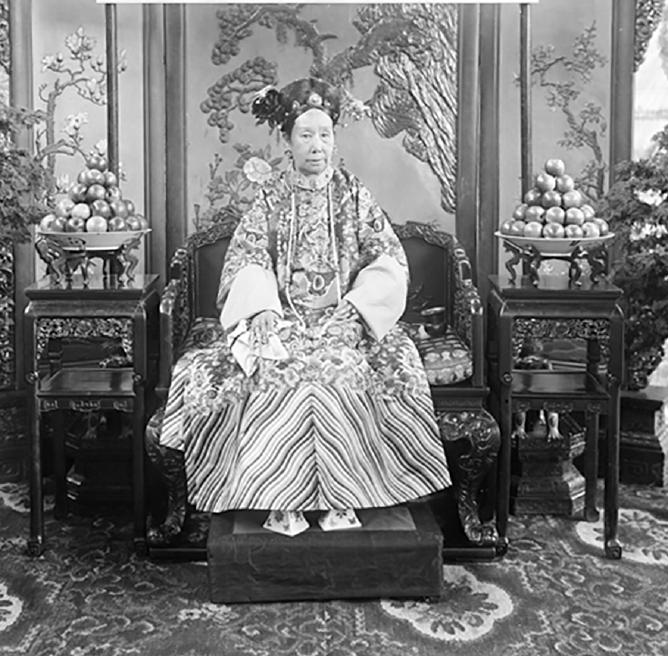
The discovery of ‘Lauth’s Purple’ by Charles Lauth in 1861 led to the use of purple dye worldwide and was introduced in China during Empress Cixi’s rule around 1862. This quite characteristic and vibrant hue was especially favored by the Empress Dowager and employed in many parts of her attire at the time of her reign during the minority of her son, as can be seen in the present robe’s flawlessly woven seven shaded lishui band, which includes this specific and distinct purple tone. The dragons on the present robe are worked in gold-wrapped threads, with clouds primarily in shades of blue against a yellow ground. Yellow was considered to be the most auspicious shade and was reserved for the Imperial family.
In Chinese numerology, 12 is an important number. During the Qing period, the Chinese recognized the 12 signs of the zodiac although they were named differently from those of the West. The Twelve Symbols were associated with the principal annual sacrifices offered by the emperor on behalf of the people at the great Imperial altars. These ritual events were linked with the four major astronomical events in the year, the solstices and equinoxes. Scholars have long believed that the Twelve Symbols may originally have had an astronomical significance.
attention to appearance, ingrained from her days as a young imperial concubine and heightened by her great love of theater, offers a contrast to the thoroughly predictable paintings of Qing court luminaries. This personal sense of fashion went hand in hand with her new appreciation of the power of photography in presenting a positive regal image to the outside world.
Literature comparison: Compare to a closely related embroidered satin robe in a London collection with a predominant blue and yellow schema for an emperor’s twelve-symbol ‘dragon’ robe, dated to the late 18th century, in G. Dickinson and L. Wrigglesworth, Imperial Wardrobe, London, 1990, p. 32-33, pl. 23. Also compare a photograph of Empress Dowager Cixi reproduced in the same monograph, pp. 93, pl. 75. Also compare to a closely related robe, dated to the nineteenth century, in J. E. Vollmer, Decoding Dragons: Status Garments in Ch’ing dynasty China, Eugene, Oregon, Museum of Art, 1983. pp. 143 and 209. Compare a closely related yellow-ground Manchu Empress’s semiformal twelve symbol court robe (chi-fu) in the Minneapolis Institute of Art, dated 1821-1850, length 146.5 cm, accession number 42.8.61, illustrated in Imperial Silks, Ch’ing Dynasty Textiles in The Minneapolis Institute of Arts, Volume I, Robert D. Jacobsen, 2000, pp. 107. Also compare a closely related woman’s dragon robe with twelve Imperial symbols, dated to the mid-19th century, in the Santa Barbara Museum of Arts, object number 1984.53.31.
AUCTION RESULT COMPARISON
Type: Closely related
Auction: Bonhams London, 5 November 2020, lot 115
Price: GBP 112,562 or approx. EUR 167,000 converted and adjusted for inflation at the time of writing
Description: A rare Imperial embroidered yellow-ground Twelve-Symbol dragon robe, jifu, 19th century
Expert remark: Note that according to Bonhams this robe measures only 149 cm, compared to the present robe which measures 183 cm across sleeves.
AUCTION
RESULT COMPARISON
Type: Closely related
Auction: Christie’s London, 18 May 2012, lot 1255
Price: GBP 139,250 or approx. EUR 257,750 converted and adjusted for inflation at the time of writing
Description: An Emperor’s Twelve Symbol Formal Court Robe (Chifu), Qing Dynasty (16441911), End of 19th, Beginning of 20th Century Expert remark: Note that according to Christie’s the body of this robe has been later relined in yellow silk, and the buttons and loops have been replaced in the 20th century.


Estimate EUR 100,000
Starting price EUR 50,000
318
Cixi changed gowns and accessories frequently in this photo series posed with a throne in Xunling’s outdoor studio. Each costume is described in photographic inventories, such as ‘Imperial Portraits in Dragon Robe and with Crown.’ Cixi’s
LOT ESSAY II
The Twelve Symbols of the Imperial Robe, each shown in full detail and with their individual location on the present
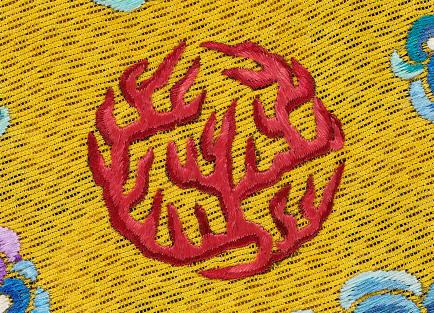

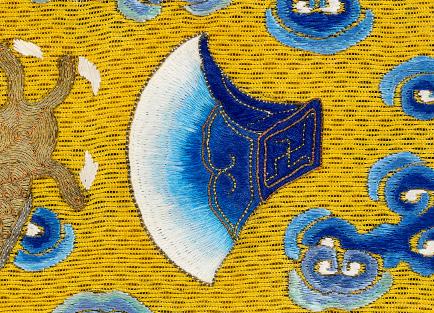



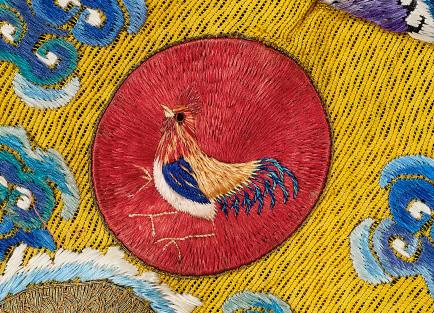

ON THE LEFT SHOULDER:
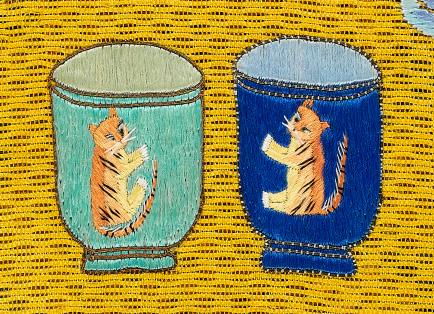
ON THE RIGHT SHOULDER:
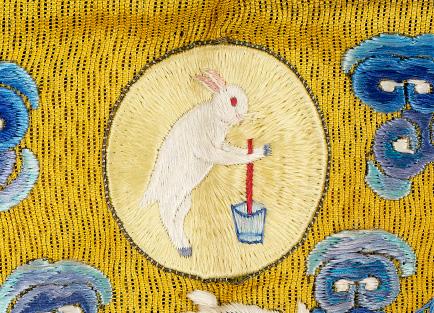
ON THE NAPE OF THE


TO THE BREAST, CENTER:
 1. The Sun, depicted as a three-legged cockerel against a red disc.
2. The Moon, depicted as the white hare pounding the elixir of life.
NECK:
3. The Rock, depicted at the nape of the neck probably represents the element earth.
4. The Constellation, represented by three dots joined by blue lines.
FRONT VIEW OF THE ROBE:
5. The Rule/Law, fu, depicted as two opposing blue lines.
6. The Axe-head was traditionally an emblem of sovereignty and the emperor’s power over the life and death of his subjects.
7. The Water Plant traditionally represented purity.
8. The Sacrificial Vessels depicting two strange tiger-like animals. The tiger was associated with the metal element and the west.
robe determined.
BACK VIEW OF THE ROBE:
9. The Dragon, represented as a pair of tiny dragons, once ascending and one descending.
10. The Flowery Creature, depicted as a mythical golden pheasant.
11. The Fire, the flames representing the fire element.
12. The Grain, depicted as a dish containing 30 grains of millet, traditionally the first cereal crop raised in China.
1. The Sun, depicted as a three-legged cockerel against a red disc.
2. The Moon, depicted as the white hare pounding the elixir of life.
NECK:
3. The Rock, depicted at the nape of the neck probably represents the element earth.
4. The Constellation, represented by three dots joined by blue lines.
FRONT VIEW OF THE ROBE:
5. The Rule/Law, fu, depicted as two opposing blue lines.
6. The Axe-head was traditionally an emblem of sovereignty and the emperor’s power over the life and death of his subjects.
7. The Water Plant traditionally represented purity.
8. The Sacrificial Vessels depicting two strange tiger-like animals. The tiger was associated with the metal element and the west.
robe determined.
BACK VIEW OF THE ROBE:
9. The Dragon, represented as a pair of tiny dragons, once ascending and one descending.
10. The Flowery Creature, depicted as a mythical golden pheasant.
11. The Fire, the flames representing the fire element.
12. The Grain, depicted as a dish containing 30 grains of millet, traditionally the first cereal crop raised in China.
AN IMPERIAL RUBY-RED GROUND ‘BLOSSOMING PRUNUS’ KESI ROBE, CHINA, 18TH CENTURY
Expert’s note: Plum blossoms on a ruby-red ground is an Imperial decor type that is extremely rare, highly coveted, and already found on important objects dating from the late Kangxi reign, and of course the Yongzheng period (see literature comparison below). There are no notable comparisons found for the present robe, a fact that leads us to the conclusion that this is likely a rather early example, dating from the 18th century.
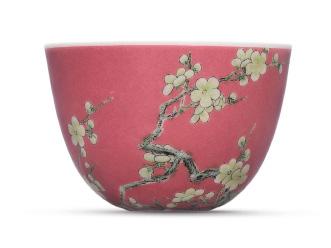
Finely worked with innumerable floral heads and buds picked out in shades of salmon, green, and white against a red ground, interspersed with butterflies in various hues, the sleeves, collar, and hem in light blue piping. To the side and sleeves, ten fabric loops to secure the robe. Further to the sides, several molded beads in imitation of jade with green lacquer coating and stylized shou characters in high relief.
Provenance: An important American collection of Chinese robes, and thence by descent within the family.
Condition: Excellent condition with only little wear, very minor stains, and a few loose threads.
Dimensions: Length 136 cm, Width 160 cm (across sleeves)

LITERATURE COMPARISON
Compare the closely related composition and theme of the robe to an imperial famille-rose enameled copper and gold ‘blossoming prunus’ snuff bottle, from the celebrated collection of Mary and George Bloch, sold at Bonhams Hong Kong, 28 November 2011, lot 166 (fig. 1)
Described as one of the most spectacular and intriguing of all Kangxi palace snuff bottles, the bottle is not only striking for its continuous design as opposed to panels of decoration surrounded by formalized floral designs, but also its ruby-red ground, similar to our robe. Also compare the precise renderings of bold branches of plum blossoms in various stages of blooming to an imperial Qing court snuff bottle in the Palace Museum collection. Finally compare a Yongzheng bowl decorated with plum blossom on a ruby ground at Christie’s Hong Kong, 30 November 2016, Important Chinese Ceramics and Works of Art, lot 3218 (fig. 2)
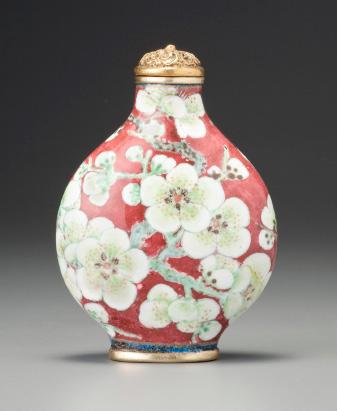
320 202
fig. 2
1
EUR 12,000
price EUR 6,000
fig.
Estimate
Starting
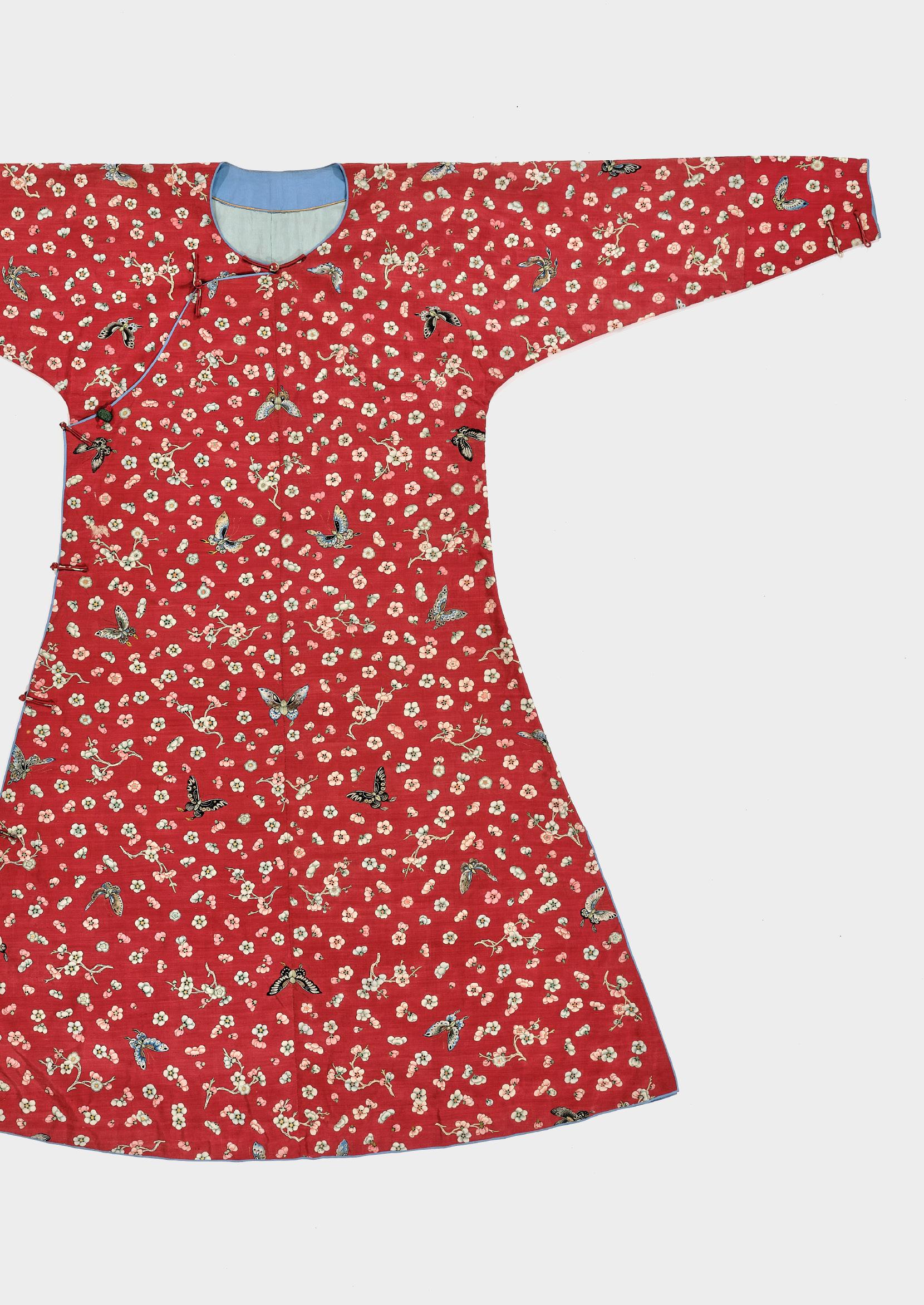
A WOMAN’S MIDNIGHT-BLUE-GROUND KESI SILK INFORMAL SURCOAT, CHANGPAO, CHINA, MID-19TH CENTURY
Expert’s note: The surcoats made for the highest-ranking female members of the Qing society were decorated by eight roundels above elaborate lishui borders at the hem, such as displayed on the present lot. See V. Garrett, Dragon Robes, Oxford, 1998, page 35, and J. Vollmer, Imperial Silks: Ch’ing Dynasty Textiles from the Minneapolis Institute of Arts, 2000, page 54.

The front-opening surcoat finely woven on the front and back panels with eight symmetrically-placed roundels with birds in flight amid blossoming peony, lotus, prunus, and magnolia, borne on leafy vines above a vase, picked out in vibrant shades of salmon, blue, yellow, red, green, and gold against a midnight-blue ground. All above lishui stripe interspersed with Buddhist symbols, the cuffs similarly decorated with lishui, each sleeve further with three smaller, similarly decorated roundels. The collar with an original gilt-metal button.
Provenance: An important private collection of an American connoisseur and collector of Chinese robes.
Condition: Good condition with only minor wear, minuscule splits and losses, few minor old repairs, little soiling.
Dimensions: Length 147 cm, Width 178 cm (across sleeves)

Garments decorated with roundels originally signaled formality. This decorative scheme can be traced to the Tang dynasty and may have been influenced by Western Asian traditions; see Huang Nengfu and Chen Juanjuan, Origins of the Art of the Chinese National Costume, Beijing, 1994, p. 209; see also J. Watt and A. Wardwell, When Silk Was Gold: Central Asian and Chinese Textiles, New York, 1998, pp. 21-29.
Medallions decorated with seasonal flowers, butterflies, cranes, and other auspicious imagery underscoring the wishes for good fortunes, wealth, happiness, typically indicated the informal nature of the occasions for which the surcoats were worn. Roundel schemes were particularly popular during the Ming dynasty for both Court and unofficial wear and the Manchu rulers of the Qing dynasty appear to have continued this tradition. By the eighteenth century, the formal design of a distinct wave border at the hem appears to have become the favored style.
The kesi technique is a particularly intricate way of introducing pattern within the weave of the fabric: the various colors are woven on separate bobbins creating the ‘cut’ effect at the boundaries between the colors, hence the name kesi or ‘cut silk’. The technique is extremely timeconsuming and skilled, achieving a reverse that is often as well-presented as the front of the fabric.
LITERATURE COMPARISON
Compare a closely related kesi silk midnightblue-ground robe, 186.5 cm wide, dated to the mid-19th century, in the Minneapolis Institute of Art, accession number 42.8.88, illustrated in Robert D. Jacobsen, Imperial Silks: Ch’ing Dynasty Textiles in The Minneapolis Institute of Arts, 2000, vol. 1, p. 269. Compare also a related kesi silk medallion robe, 141 cm long, dated to the 19th century, Minneapolis Institute of Art, accession number 42.8.91.
AUCTION RESULT COMPARISON
Type: Closely related
Auction: Bonhams London, 2 November 2021, lot 278
Price: GBP 10,837.50 or approx. converted and adjusted for inflation at the time of writing
Description: A rare midnight-blue-ground silk embroidered ‘butterfly and double-gourd’ informal surcoat, changpao, early 19th century
Expert remark: Compare the closely related roundel decoration and midnight-blue ground. Note the embroidery technique, while the present lot is woven in kesi, and the smaller size (141 cm).
Estimate EUR 10,000
Starting price EUR 5,000
322 203
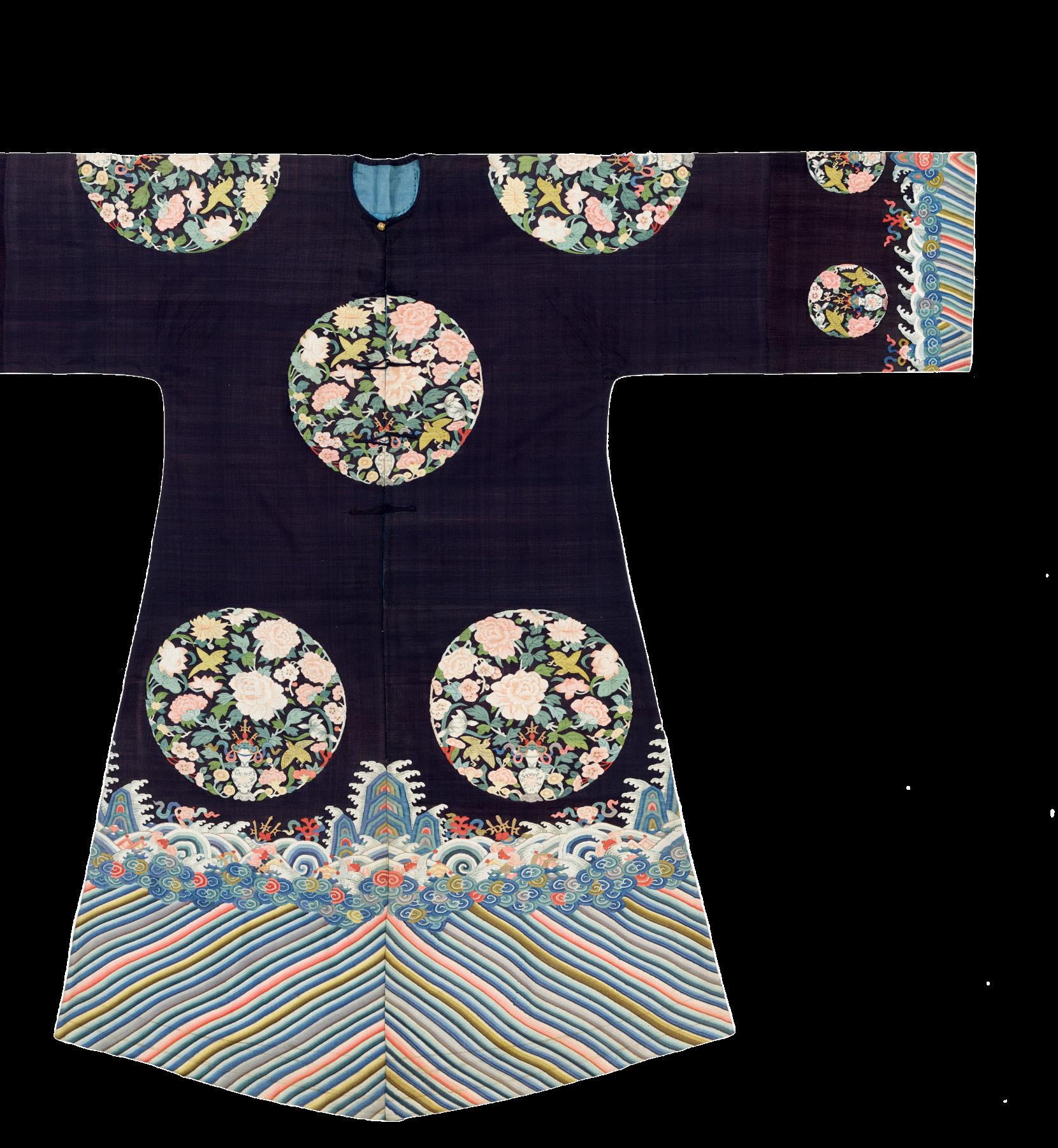
323
204
AN IMPERIAL YELLOW-GROUND SILK ‘FIVE DRAGON’ CARPET, JINGREN RONG BEI YONG MARK (FOR USE IN THE PALACE OF GREAT BENEVOLENCE), QING DYNASTY
China, 19th century. Finely woven in shades of blue, Imperial yellow, orange, and red with a central lobed roundel enclosing a frontfacing five-clawed dragon, writhing around a flaming pearl. Encircled by four sinuous dragons amid leafy lotus scroll, surrounded by a narrow key-fret border within a band of the Eight Buddhist Emblems (bajixiang), alternating with blossoming peony. The top edge with the five-character mark.
Inscriptions: To the top edge, ‘Jingren Gong bei yong’ (for the use in the Palace of Great Benevolence).
Provenance: From a European private collection. Condition: Superb condition with only minor wear. The pile is high, the threads with a good shine and only few minor pulls. Some losses to fringes.
Dimensions: Size ca. 250 x 158 cm
The five-character inscription woven at the top of the carpet reads Jingren Gong beiyong and can be translated as ‘For the use of the Hall of Great Benevolence’. Jingren Gong was one of the Six Eastern Halls located on the north-eastern side of the Forbidden City in Beijing. During the Qing dynasty, the Six Eastern Halls served as the living quarters of the Imperial wives and concubines. Jingren Gong is known to have housed the Shunzhi Emperor’s wife, and it was where the Kangxi Emperor was born. The Hall was reconstructed in 1655 and during the reigns of the Qianlong Emperor and the Daoguang Emperor it served as the living quarter of the EmpressDowagers.
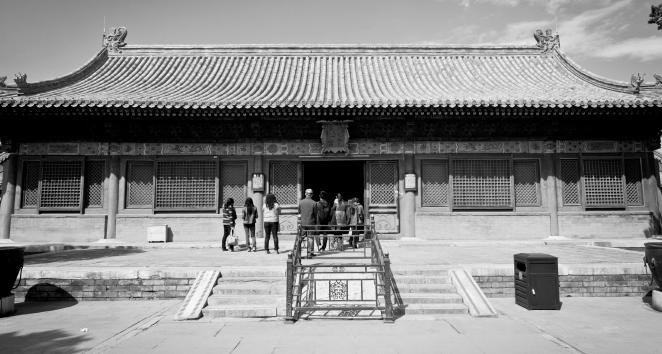
While the dragon itself is the symbol of the Emperor, the number five is most auspicious and represents the Five Blessings (wufu) of old age, wealth, health, virtue and peaceful death. The design of Five Dragons also alludes to the Five Dragons of Yanshan (Yanshan wulong), named after the five sons of Dou Yujun, who lived in Yanshan during the Five dynasties period (907-960), each of whom achieved exceptional success with their father epitomizing the ideal parent.
The Eight Buddhist Emblems (bajixiang) are a set of traditional symbols that represent the offerings made by the gods to Buddha upon his enlightenment. The symbols include the parasol, the golden fish, the conch shell, the endless knot, the lotus flower, the victory banner, the Dharma wheel, and the treasure vase. Each symbol has its own significance and is used in various contexts, such as in religious rituals, on prayer flags, and in artwork. Together, these symbols are believed to bring good fortune, prosperity, and happiness to those who use or encounter them.
AUCTION RESULT COMPARISON
Type: Closely related
Auction: Bonhams London, 16 May 2013, lot 409
Estimate: GBP 25,000 or approx. EUR 44,000 converted and adjusted for inflation at the time of writing
Description: A rectangular ‘dragon’ carpet, late Qing dynasty, Jingren Gong bei yong inscription Expert remark: Compare the closely related manner of weaving and decoration with similar arrangement of five dragons, the identical inscription, and the near-identical size (153 x 245 cm).
AUCTION RESULT COMPARISON
Type: Closely related
Auction: Sotheby’s Paris, 18 June 2020, lot 28
Price: EUR 40,000 or approx. EUR 45,000 adjusted for inflation at the time of writing
Description: An Imperial silk ‘Five Dragon’ carpet, Taihe dian bei yong Mark, Qing dynasty, 19th century
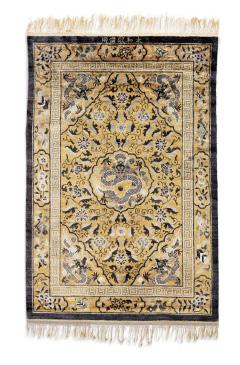

Expert remark: Compare the closely related manner of weaving and decoration with similar arrangement of five dragons as well as the related inscription albeit referring to a different hall. Note the slightly larger size (277 x 186 cm).
Estimate EUR 8,000
Starting price EUR 4,000
324
Jingren Gong Hall in the Forbidden City in Beijing, where the present lot was originally located

A COMPLETE SET OF FOUR EMBROIDERED SILK PANELS, DEPICTING THE FOUR SEASONS, MID-QING DYNASTY
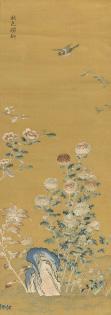
Expert’s note: Finding complete and well-preserved sets of silk panels that depict all four seasons, sometimes inserted into four-fold screens, is exceptionally rare. These artistic compositions typically include images of birds, rocks, and flowers, following the conventions of flora and fauna studies that were popular during the Song dynasty. Paintings made by court artists were often sent to the Imperial workshops in Suzhou, where they would be meticulously recreated using the finest embroidery techniques.
China, 18th to early 19th century. The four large silk panels are finely embroidered primarily in satin stitch with colorful scenes of spring, summer, autumn, and winter, depicting bird and flower motifs according to each season with auspicious imagery, including the deer with lingzhi and the cat and butterfly, against a golden-brown ground.

Each panel is framed behind glass. (4)
Provenance: From the collection of Paul V. Taylor, and thence by descent in the same family. The back of each panel is inscribed, naming the season and dating these panels to the 13th century. Each panel also has an old label, naming the season and the provenance.
Rev. Dr. Paul Vivian Taylor, Ph.D., D.D. (1892-1974) was a protestant missionary active in China from 1924 to 1950. During his time in China, Taylor taught English at Huping College and later Philosophy and Psychology at Huachung University in Wuchang (known today as the Central China College), where he eventually became Dean of Faculty. When the Japanese forces invaded China in 1937, Taylor stayed and led the effort in moving the complete college to Kweilin, out of the reach of the Japanese invaders. Taylor wrote a book titled Our China Missionary (1924-1941): Chiang Kai-shek, Pearl S. Buck, Charles Lindbergh, and more.

Condition: Overall very good condition. The Spring panel with some soiling and minor nicks to the frame. The Summer panel with few small tears, soiling, loose threads. The Autumn panel with few loose threads and few tiny losses. The Winter panel with minor soiling and few tiny tears. The frames with minor nicks and light scratches. Displaying spectacularly!
Dimensions: Image size 169 x 46 cm, Size including frame 177.5 x 55 cm
Spring is embroidered with two long-tailed birds of paradise perched on a prunus branch, one cawing, above plum blossoms growing from leafy twigs, as well as flowering orange lilies growing from the ground.
Summer is decorated with flowering peony blossoms, asters, and a central magpie perched high up on a branch and looking down upon a spotted deer carrying a lingzhi fungus in its mouth. The highly auspicious imagery of the spotted deer with lingzhi is associated with the god of longevity Shoulao and the immortal fungus.
Autumn shows a golden pheasant perched on a craggy pierced rock, below a magnolia tree ready to bloom and above chrysanthemum blossoms, the lower section with a playful cat that has caught a butterfly in its mouth, a second butterfly fluttering above. The word for cat in Chinese (mao) is a homophone for the word for octogenarian, and the word for butterfly (die) sounds the same as that for a septuagenarian. Thus, the combination of the cat and butterflies here conveys the wish that the recipient might live a long life of seventy or eighty years.
Winter is marked by two cranes perched on a pine tree, above large camellia blossoms. The presence of the cranes amidst pines and the single lingzhi mushroom on the ground represent auspicious imagery associated with longevity and vitality.
AUCTION RESULT COMPARISON
Type: Closely related
Auction: Christie’s London, 14 May 2019, lot 180
Price: GBP 32,500 or approx. EUR 49,000 converted and adjusted for inflation at the time of writing
Description: A beige-ground silk embroidered panel, late 18thearly 19th century
Expert remark: Compare the closely related satin stitch embroidering with similar chrysanthemums and rockwork. Note the slightly larger size (184 x 58.5 cm) and that the lot comprises only a single panel, which according to Christie’s “may have been one of a set of four designs representing the seasons.”
Estimate EUR 15,000
Starting price EUR 7,500
326 205
Spring
Paul V. Taylor, ca. 1940



327 Summer Autumn Winter
A GILT-BRONZE STANDING FIGURE OF BUDDHA, UNIFIED SILLA DYNASTY, KOREA, 8TH - 9TH CENTURY
Finely cast standing with his right hand raised in abhaya mudra and his left lowered in varada mudra, wearing thickly cast voluminous robes which drape from his chest to his ankles in neatly carved U-shaped folds. His serene face with heavy-lidded eyes below gently arched brows, his full lips forming a calm smile, flanked by long pendulous earlobes. The hair arranged in tight curls over the domed ushnisha.
Provenance: From the collection of Mr. and Mrs. John Marsing, and thence by descent in the same family. John Marsing (1918-1998) was a Danish businessman who, at the age of 20, had established a pharmaceutical company, Marsing & Co. The firm expanded during the mid20th century and had branches all over Europe, Canada, and Korea. Marsing was very interested in Asian culture and a passionate collector of Asian works of art, particularly from the Himalayas, China, and Korea. He built a substantial collection over decades, buying in Asia and from antique dealers in Denmark as well as auction houses all around Europe.

Condition: Good condition, commensurate with age. Extensive wear, particularly to gilt, signs of weathering and erosion, minor fatigue cracks to the neck, nicks, scratches, losses, casting flaws, encrustations. The bronze with a fine, naturally grown, dark patina.
Weight: 1,511 g (incl. stand)
Dimensions: Height 25.6 cm (incl. stand) and 20.6 cm (excl. stand)
Mounted on a wood stand. (2)
The backside of the figure is hollowed with an oval opening at the back of the head above a second, oblong opening at the body, the latter with remnants of a peg inside.
The present figure exemplifies the refined style of Buddhist sculpture from the Unified Silla dynasty, which lasted from the late seventh through the ninth centuries and was a period of political stability when an international style held sway throughout East Asia.
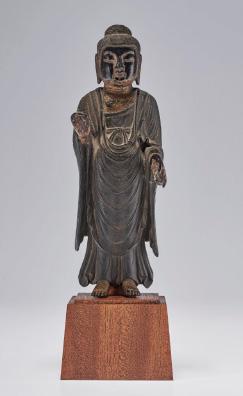
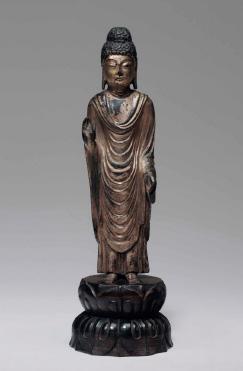
Literature comparison: For a related figure in the collection of the Nezu Museum, see Matsubara Saburo, ed., Kankoku kondobutsu Kenkyu (Study of Korean gilt bronze Buddhist figures), 1985, page 167 b.
AUCTION RESULT COMPARISON
Type: Closely related
Auction: Christie’s New York, 25 April 2017, lot 82
Price: USD 106,250 or approx. EUR 122,000 converted and adjusted for inflation at the time of writing
Description: A gilt-bronze standing figure of Buddha, Unified Silla dynasty, 8th-9th century
Expert remark: Compare the closely related manner of casting and modeling with similar robes and pose, as well as the similarly hollowed reserve at the backside, with three openings. Note the similar size (18.4 cm).
AUCTION RESULT COMPARISON
Type: Closely related
Auction: Christie’s New York, 16 March 2021, lot 252
Price: USD 162,500 or approx. EUR 173,000 converted and adjusted for inflation at the time of writing
Description: A gilt-bronze standing figure of Buddha, Unified Silla to Early Goryeo dynasty, 9th-10th century
Expert remark: Compare the closely related manner of casting and modeling with similar robes and pose, as well as the similarly hollowed reserve and extensive wear to gilt. Note the larger size (25.4 cm).
Estimate EUR 15,000
Starting price EUR 7,500
328
206
John Marsing (1918-1998)
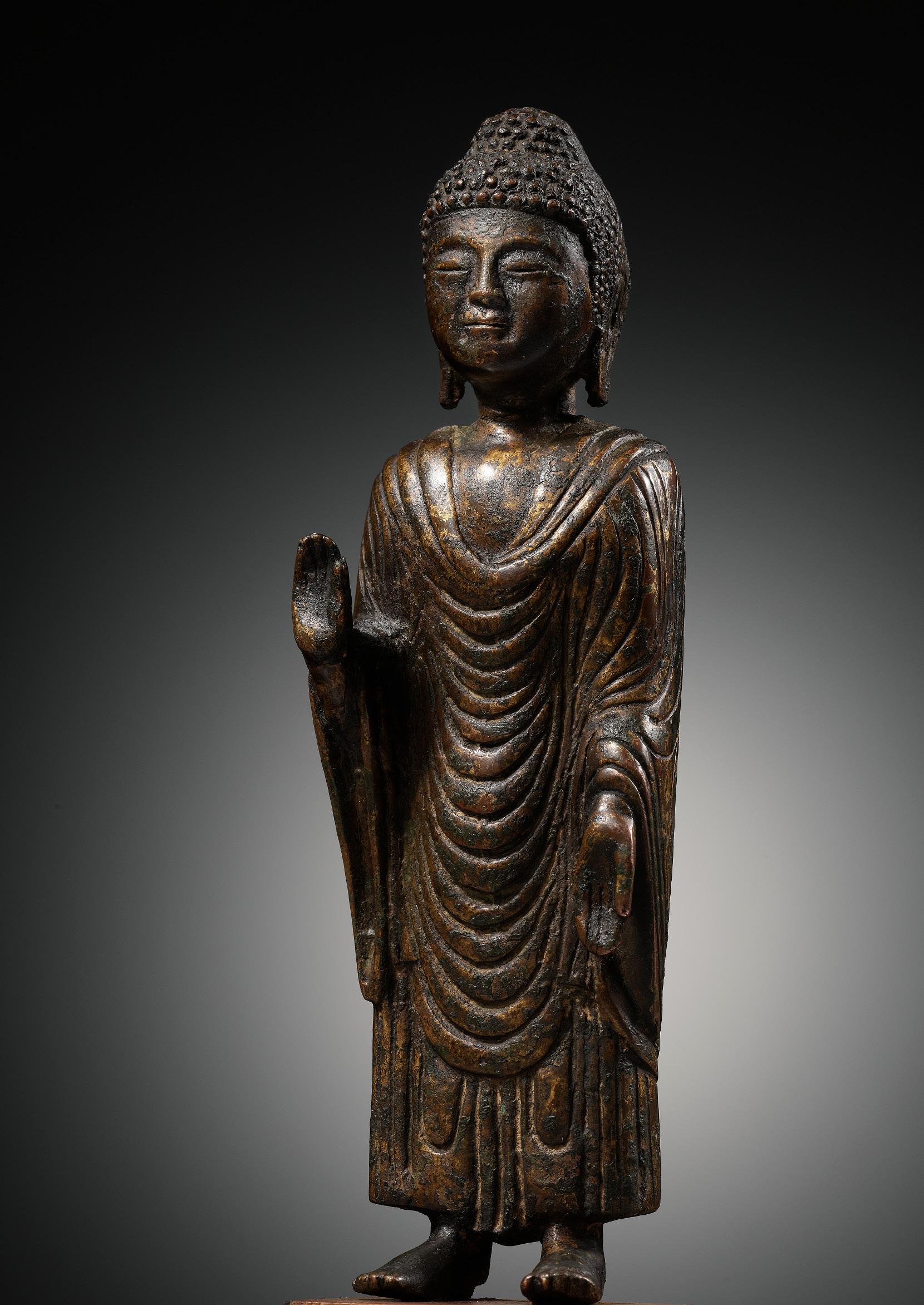
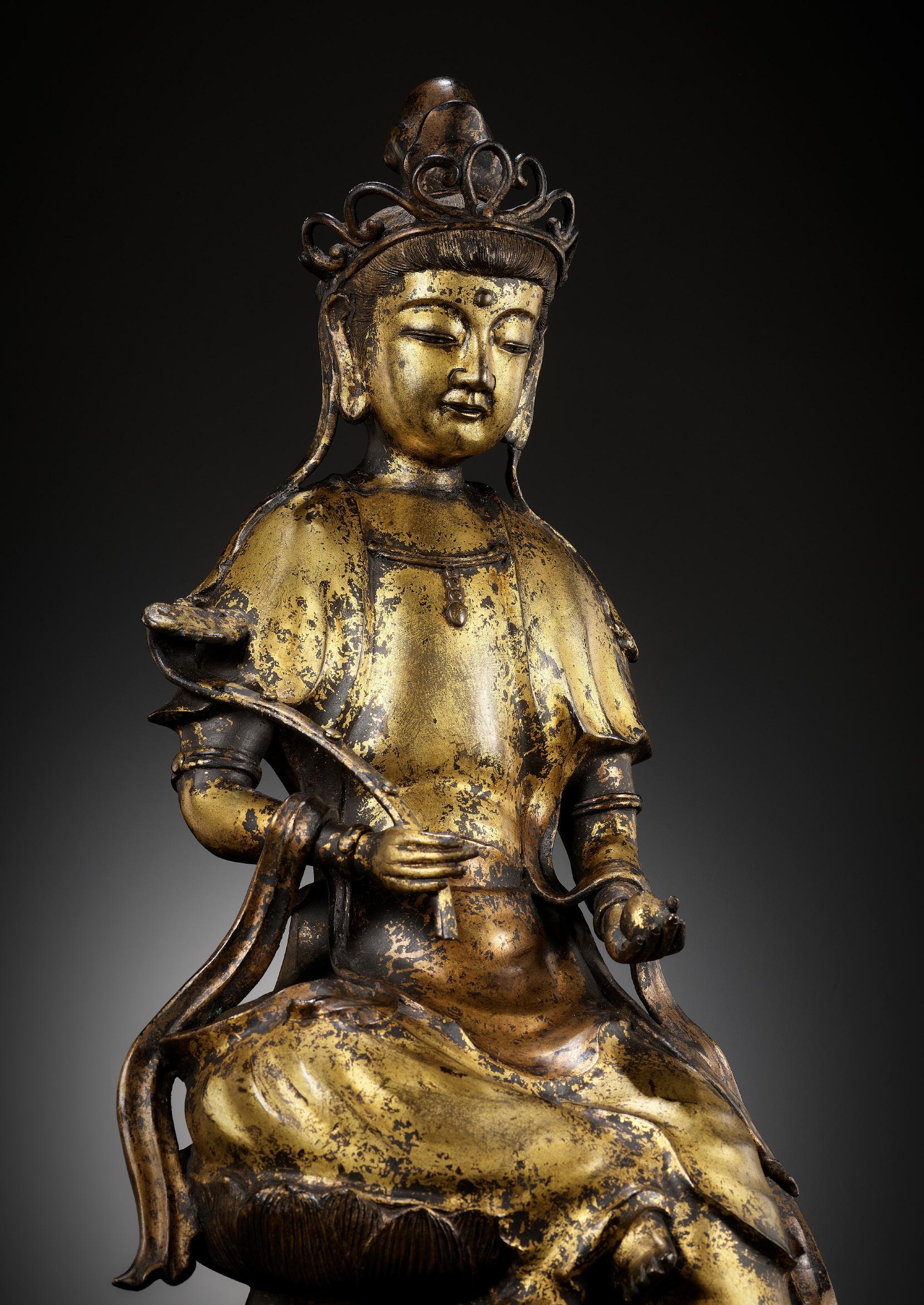
A MAGNIFICENT GILT-COPPER ALLOY FIGURE OF MUNSU (MANJUSRI), JOSEON DYNASTY
Scientific Analysis Report: A thermoluminescence analysis report issued by Oxford Authentication on 17 April 2023, based on sample number N123c91, sets the firing date of one sample taken between 180 and 300 years ago. A copy of the report accompanies this lot.

Korea, 1720-1840. Heavily cast, the bodhisattva of wisdom seated in lalitasana atop a lotus pillow, holding a jewel in his left and a scepter in his right, wearing thickly cast voluminous robes with finely detailed folds. His serene face with heavy-lidded downcast eyes below elegantly arched brows centered by a raised circular urna, the mouth with slender bow-shaped lips slightly agape. The hair neatly incised and piled up into a high topknot behind the open worked foliate tiara.
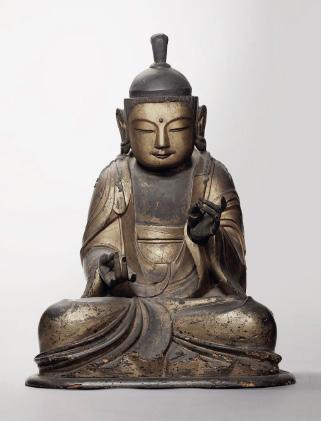
Provenance: From a German private collection. Condition: Old wear, casting flaws, signs of weathering, rubbing and losses to gilt, small nicks and dents, shallow surface scratches, minor losses, and fatigue cracks with traces of soldering. Possibly minute old fills and/or repair work. Displaying remarkably well, and extremely rare in this overall excellent state of preservation, commensurate with size and age.
Weight: 9.1 kg
Dimensions: Height 60.5 cm
Expert’s note: This gilt-copper alloy figure was originally part of a triad, with the two bodhisattvas Munsu (Manjusri) and Bohyeon (Samantabhadra) flanking Seokga (Buddha Shakyamuni). In this triad, the bodhisattvas are often depicted riding their respective vehicles, the tiger and elephant, and consistently appear in the same position with Munsu to the left of Seokga and Bohyeon to the right. It is clear from the position of the present figure’s hanging leg and the scepter held in his right hand, that the present lot depicts Munsu. Furthermore, the hollow lotus pillow the figure is seated on shows obvious signs that it was once attached to a base or figure, which would have been a tiger. Note that large gilt bronzes from Korea, such as the present lot, are generally considered to be exceedingly rare.
AUCTION RESULT COMPARISON
Type: Related
Auction: Christie’s New York, 19 March 2019, lot 363
Price: USD 75,000 or approx. EUR 81,000 converted and adjusted for inflation at the time of writing
Description: A gilt wood sculpture of a seated Bodhisattva, Joseon dynasty, probably second half 17th century

Expert remark: Compare the related modeling with similar face and robes. Note the different material and size (80 cm).
Estimate EUR 20,000
Starting price EUR 10,000
331 207
208
A SILVER
AND COPPER-INLAID IRON ‘MYTHICAL ANIMALS’ TOBACCO BOX AND COVER, JOSEON DYNASTY
Korea, 18th-19th century. Of rectangular form, superbly decorated with inlays of silver as well as minute and subtle inlays of copper, the cover with a pair of confronted dragons pursuing the flaming pearl among stylized clouds with snake-like copper tongues, the long sides each with a doe and stag beneath a gnarled pine tree, one short side with two cranes with copper crowns beside a bamboo stalk, and the other with a turtle swimming over waves below thick clouds with a mountain range in the background, all enclosed by key-fret borders.
Provenance: English trade.
Condition: Good condition with expected old wear and minor manufacturing irregularities, small nicks, light scratches.
Weight: 1,247 g
Dimensions: Length 13.2 cm
The interior of the box with a sandalwood lining and secondary cover with a silver handle, chased with foliate designs. In Korean Shamanism, sandalwood is considered the Tree of Life.
During the Joseon period, boxes such as the present lot were used by wealthy gentlemen as storage containers for tobacco, which has been grown and smoked in Korea since the early seventeenth century, when it was introduced from Japan. Such boxes are typically decorated with auspicious motifs, while the present lot is considerably rarer in that it depicts four mythical (or at least distinctively mythologized) animals, each depicted in East Asian art since antiquity: the dragon, deer, turtle, and crane.
LITERATURE COMPARISON
Compare a related silver-inlaid iron tobacco box, 10.2 cm wide, dated to the Joseon dynasty, in the Victoria & Albert Museum, accession number 1842-1888.

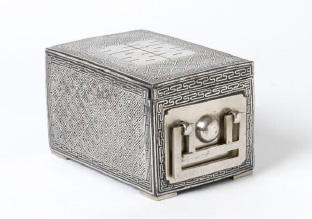
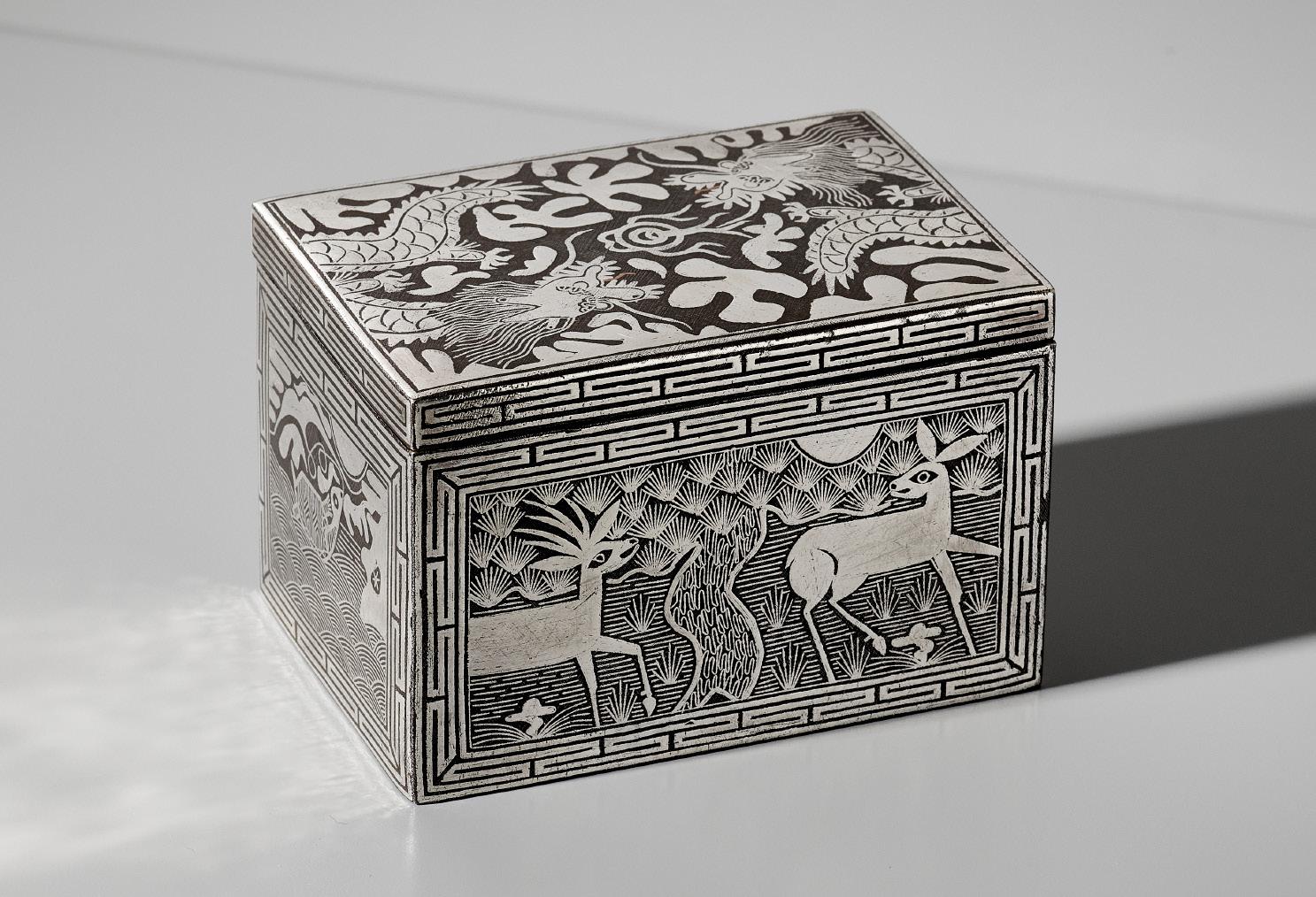
Estimate EUR 4,000
Starting price EUR 2,000
A GOLD REPOUSSÉ PECTORAL PENDANT DEPICTING TWO GARUDA, VIETNAM, FORMER KINGDOMS OF CHAMPA, CIRCA 10TH CENTURY
Published: The Zelnik Istvan Southeast Asian Gold Museum, Budapest, 2013, page 49.

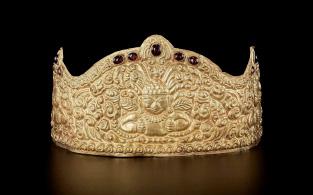
The crescent-shaped pectoral is finely chased, embossed, and incised, with a band of lotus petals along the upper rim above two mirroring Garuda flanking a neatly inlaid, central chalcedony intaglio depicting a four-armed deity, all surrounded by repeating stylized sword designs.

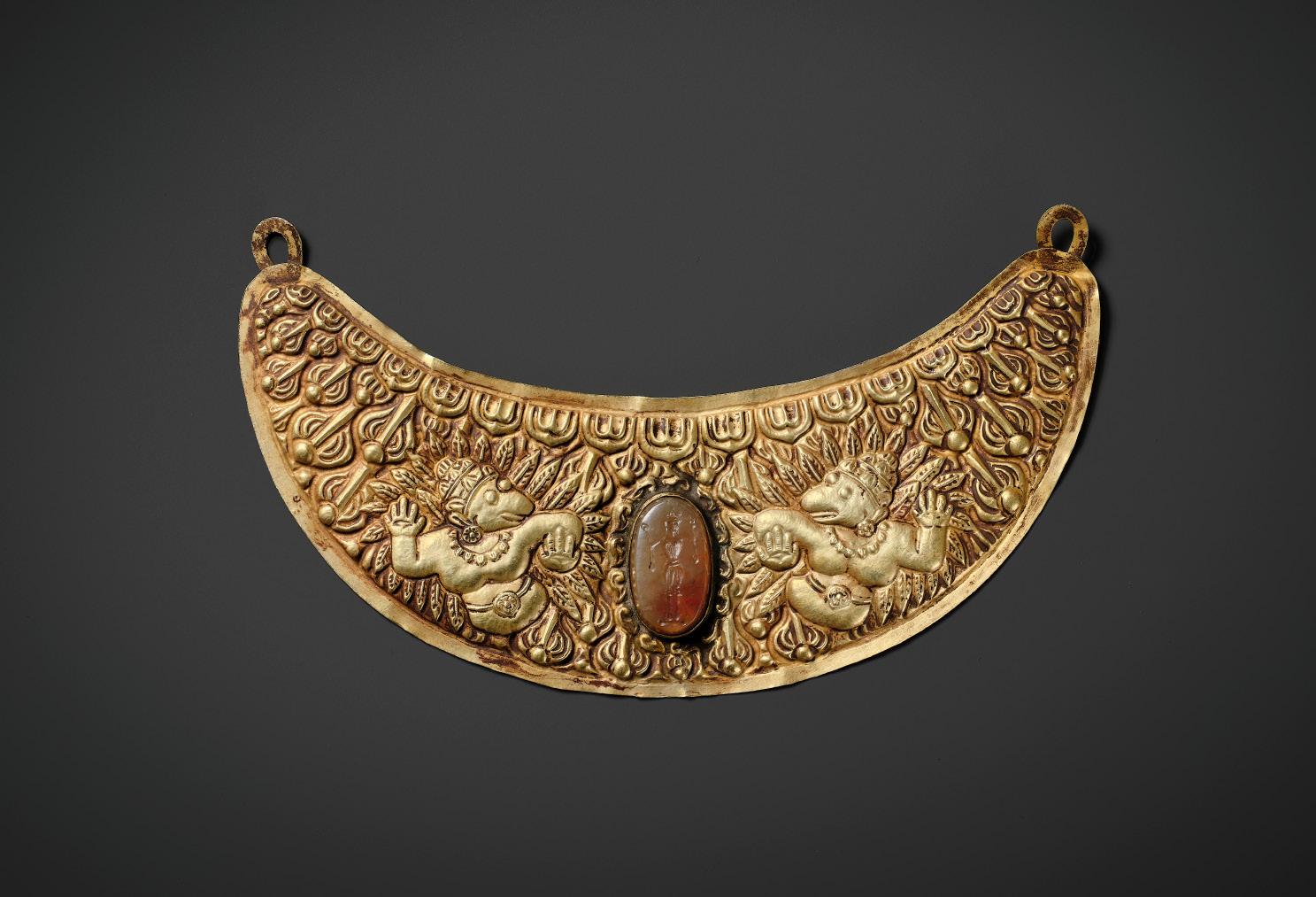
Provenance: Ex-Collection of The Zelnik István Southeast Asian Gold Museum. Institutional art collection in Belgium, acquired from the above. Dr. István Zelnik, President of the Hungarian South and Southeast Asian Research Institute, is a former high-ranking Hungarian diplomat who spent several decades in Southeast Asia, building the largest known private collection of Asian art in Europe.
Condition: Very good condition, commensurate with age. Some old wear, small manufacturing irregularities, very minor old repairs, and light tarnishing, all as to be expected for a gold object more than a thousand years old.
Weight: 24.6 g
Dimensions: Length 14.9 cm
Garuda is a half-bird, half-human creature that appears in both Hinduism and Buddhism. The mythological account of Garuda’s birth in the Mahabharata identifies him as the younger brother of Aruna, the charioteer of the sun god, Surya. Garuda’s mother, Vinata, mother of the birds, was tricked into becoming the slave of her sister and co-wife, Kadru, mother of the nagas (serpents). The lasting enmity between the birds, particularly Garuda, and the serpents, is attributed to this. The nagas agreed to release Vinata if Garuda could obtain for them a drink of the elixir of immortality, the amrita, or soma. Garuda performed that feat, thus giving the snakes the ability to slough off their old skins, and, on his way back from the heavens, Garuda met Vishnu and agreed to serve him as his vehicle and also as his emblem. Garuda is described in one text as emerald in color, with the beak of a hawk, roundish eyes, golden wings, and four arms and with a breast, knees, and legs like those of a hawk. He is also depicted anthropomorphically, with wings and hawk-like features. Sometimes Images of Garuda are used by devotees of Vishnu to designate their affiliations; such images appear on coins throughout various periods and on ritual vessels and jewelry, like this lot. Garuda, also referred to as Garula, are golden-winged birds in Buddhist texts. Under the Buddhist concept of samsara, they are one of the As t agatyah , the eight classes of inhuman beings.
AUCTION RESULT COMPARISON
Type: Related
Auction: Galerie Zacke, Vienna, 4 December 2020, lot 22

Price: EUR 13,904 or approx. EUR 16,500 converted and adjusted for inflation at the time of writing
Description: An extremely rare and fine Cham gemstone-set gold repoussé crown with Garudas Expert remark: Compare the closely related material, repoussé decoration, and Garuda motif. Note the different form and the size (14.5 cm). Note this crown was also previously in The Zelnik István Southeast Asian Gold Museum.
Estimate EUR 8,000
Starting price EUR 4,000
333
209
210
AN IMPORTANT SILVER-INLAID GOLD REPOUSSÉ BOWL DEPICTING GARUDA, VIETNAM, FORMER KINGDOMS OF CHAMPA, CIRCA 10TH CENTURY
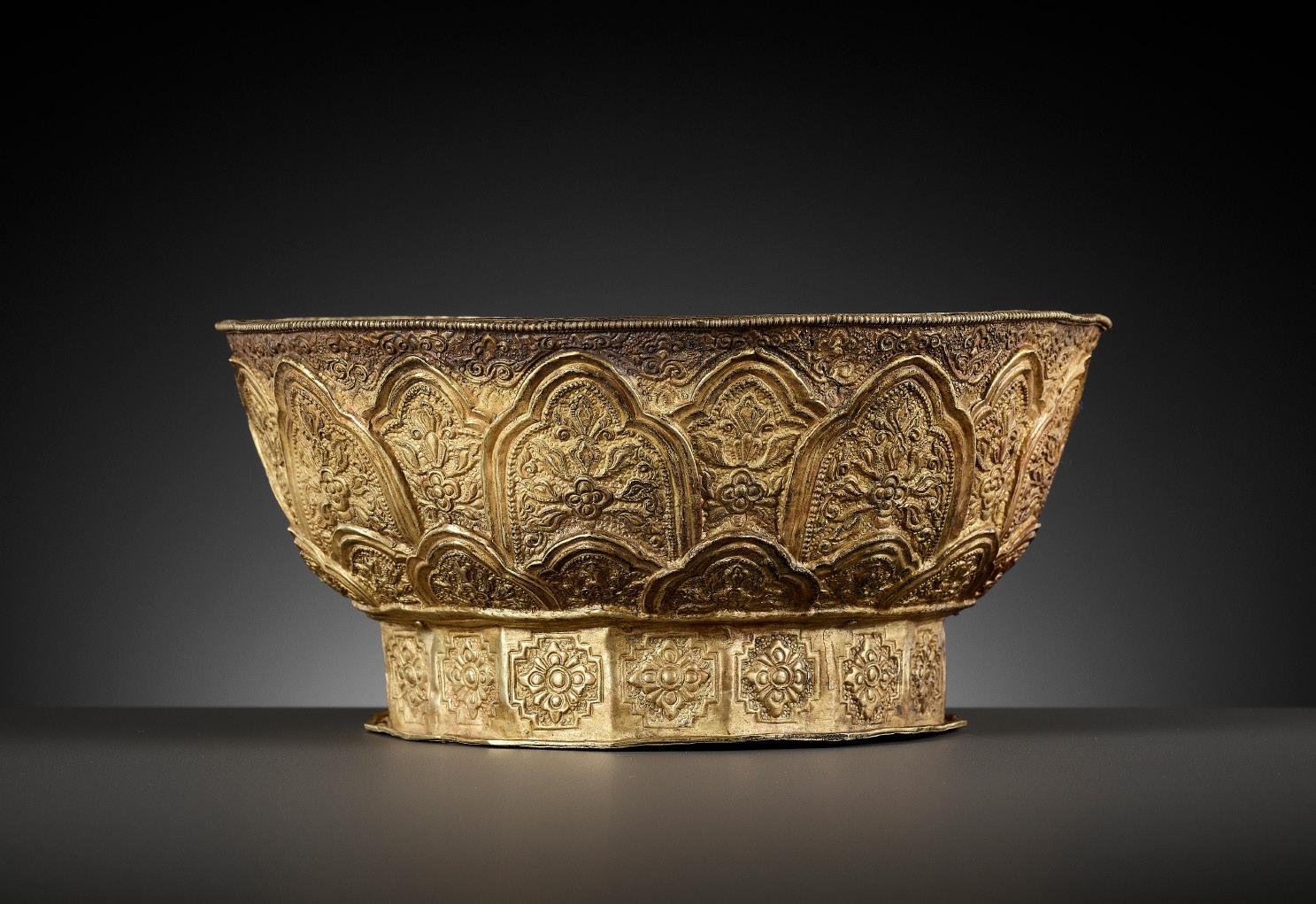
Superbly worked, the deep rounded sides supported on a tall faceted foot and flaring to a beaded rim, finely decorated to the exterior with overlapping trefoil-arched panels enclosing rosettes and scrolling foliage, below interlocking scrolling vines. The foot with square panels and indented corners enclosing rosettes, all against ring-punched grounds. The interior with a circular silver-inlaid base depicting a winged Garuda with human face, wearing a richly incised dhoti, foliate crown, and fine jewelry, his arms raised as if about to take flight, surrounded by leafy lotus blossoms, enclosed by a beaded border.
Provenance: Ex-Collection of The Zelnik István Southeast Asian Gold Museum. Institutional art collection in Belgium, acquired from the above.
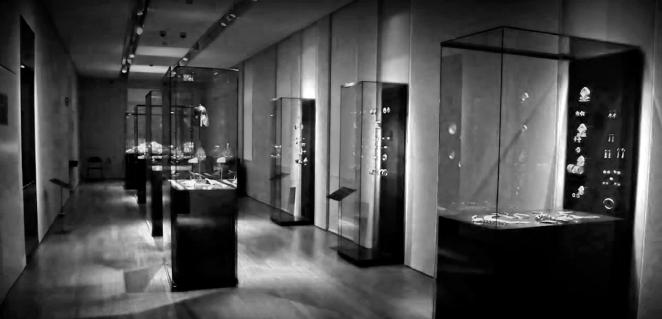
Dr. István Zelnik, President of the Hungarian South and Southeast Asian Research Institute, is a former high-ranking Hungarian diplomat who spent several decades in Southeast Asia, building the largest known private collection of Asian art in Europe.

Condition: Good condition, commensurate with age, with old wear and casting flaws, small losses, some tarnishing, and dents, all exactly as expected of a gold object more than a thousand years old.
Weight: 243.9 g
Dimensions: Diameter 18.8 cm
Garuda is a half-bird, half-human creature that appears in both Hinduism and Buddhism. The mythological account of Garuda’s birth in the Mahabharata identifies him as the younger brother of Aruna, the charioteer of the sun god, Surya. Garuda’s mother, Vinata, mother of the birds, was tricked into becoming the slave of her sister and co-wife, Kadru, mother of the nagas (serpents). The lasting enmity between the birds, particularly Garuda, and the serpents, is attributed to this. The nagas agreed to release Vinata if Garuda could obtain for them a drink of the elixir of immortality, the amrita or soma. Garuda performed the feat, thus giving the snakes the ability to slough off their old skins, and on his return Garuda met Vishnu, agreeing to serve him as his vehicle. Garuda is described in one text as emerald in color, with the beak of a hawk, roundish eyes, golden wings, and four arms and with a breast, knees, and legs like those of a hawk. He is also depicted anthropomorphically, with wings and hawk-like features. Sometimes images of Garuda are used by devotees of Vishnu to designate their affiliations; such images appear on coins throughout various periods and on jewelry and ritual vessels, like this lot. Garuda, also known as Garula, are golden-winged birds in Buddhist religious texts. Under the Buddhist concept of samsara, they are one of the As t agatyah , the eight classes of inhuman beings.
Expert’s note: Depictions of Garuda with a human face like on the present lot are considerably rarer than their bird-faced counterparts, but are found across different cultures and materials. Compare an ivory relief depicting Garuda from Nepal, 10 cm high, dated to the 14th century, in the Victoria & Albert Museum, accession number IS.124-1999. Compare a bronze plaque depicting Garuda from East Java, 12.7 cm high, dated c. 1300, in the Norton Simon Museum, accession number P.2003.01.10. Compare a terracotta sculpture of Garuda from Western Thailand, 48 cm high, dated to the first half of the 7th century, excavated from site 40, Khu Bua, Ratchaburi Province, by the Fine Arts Department, Thailand, in 1962, and now in the National Museum, Bangkok, exhibited by the Metropolitan Museum of Art, Lost Kingdoms: Hindu-Buddhist Sculpture of Early Southeast Asia, 5th to 8th Century, 14 April-27 July 2014. Compare a granite figure of Garuda from India, Tamil Nadu, 137.8 cm high, dated second half of the 8th to early 9th century, in the Metropolitan Museum of Art, accession number 1983.518. Compare a gray schist turban ornament with Garuda from Gandhara, 11.4 cm high, dated 2nd-3rd century, at Christie’s New York, 18 March 2015, lot 4009.
Estimate EUR 10,000
Starting price EUR 5,000
334
Dr. István Zelnik
The Zelnik István Southeast Asian Gold Museum
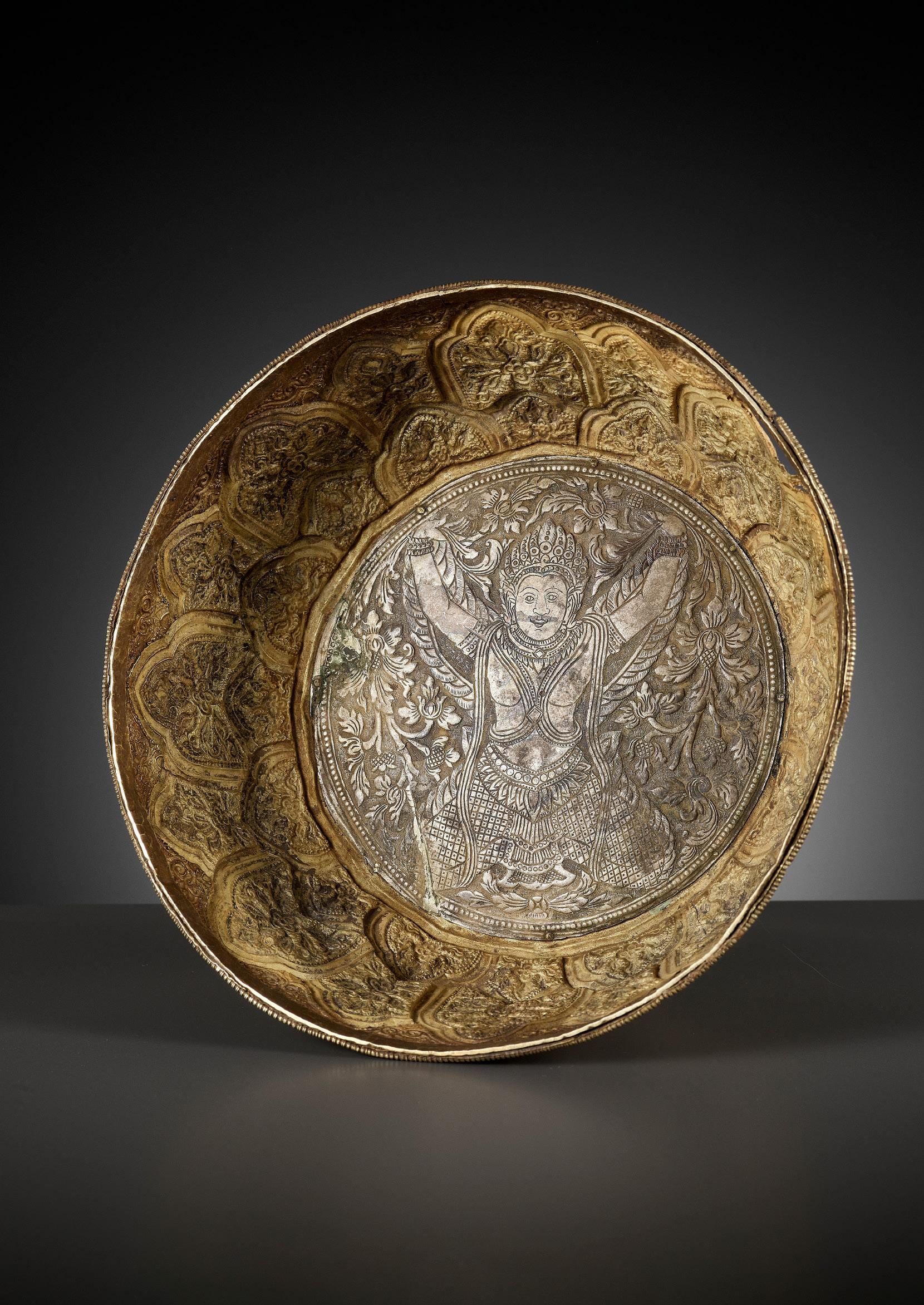
AN IMPORTANT BRONZE STATUE OF BUDDHA WITHIN A FLAMING AUREOLE, INDONESIA, CENTRAL JAVA, 8TH-9TH CENTURY

Gracefully cast, the standing Buddha holds both hands out in chin mudra, the gesture of consciousness, evoking peace and concentration. He is clad in a long diaphanous sanghati, his face with sinuously lidded downcast eyes and full lips, the hair arranged in snail-shell curls around the ushnisha. The head is backed by a circular aureole, from which twelve lambent flames emerge, the twelfth flame hidden behind Buddha’s back.
Provenance: Collection of Paul J. Jewell, acquired 1984 in Singapore. A copy of a provenance statement written and signed by Paul J. Jewell, dated 15 April 2023, confirming the provenance stated above, accompanies this lot. Paul J. Jewell lived and worked in South East Asia for over 20 years, serving as the executive director of the European Chamber of Commerce in Vietnam. To this day, he continues to collect Asian art and antiquities. Condition: Excellent condition, commensurate with age, with ancient wear, minor signs of weathering and erosion, expected casting irregularities, small losses and nicks. The bronze encrusted with a rich, naturally grown patina of vibrant malachite-green color overall. Displaying exceptionally well.
Weight: 3,050 g (incl. stand)
Dimensions: Height 33.1 cm (incl. stand), 28.2 cm, (excl. stand)
Mounted to a wood and metal stand. (2)
Expert’s note: Buddhist art produced in Indonesia during the 8th and 9th centuries under the patronage of the Shailendra dynasty displays a unique amalgam of regional artistic styles borrowed from the Indian subcontinent. The flowing contours of the body subtly delineated beneath the diaphanous garment are reminiscent of the Gupta style of northern India while the sloping shoulders and oval face with full cheeks recall the Sri Lankan Buddha images produced in Anuradhapura during the 7th and 8th centuries.
In Buddhist art, the nimbus is often imagined as consisting not just of light, but also of real flames. While this type seems to first appear in Chinese bronzes of which the earliest surviving examples date from before 450, it became something of a hallmark for the most important Chola bronzes, such as Shiva Nataraja, an image which emerged around 800 AD in Southern India, at the height of the Chola Empire. In the present statue, the depiction of the twelve flames is rather formal, as they are neatly arranged in identical intervals around a ring aureole, almost like on an ancient sundial.
LITERATURE COMPARISON

Compare a related Javanese bronze standing figure of Buddha, 19 cm high, dated 9th-10th century, in the British Museum, registration number 1859,1228.98. Compare a related Javanese bronze figure of a seated Buddha Vairocana, 19.4 cm high, dated late 9th century, in the Metropolitan Museum of Art, accession number 1987.142.23. Compare a related Indonesian bronze figure of Buddha, 26.7 cm high, dated 7th-8th century, in the Metropolitan Museum of Art, accession number 1993.64 (fig. 1) fig. 1


Estimate EUR 20,000
Starting price EUR 10,000
336
211
Paul J. Jewell
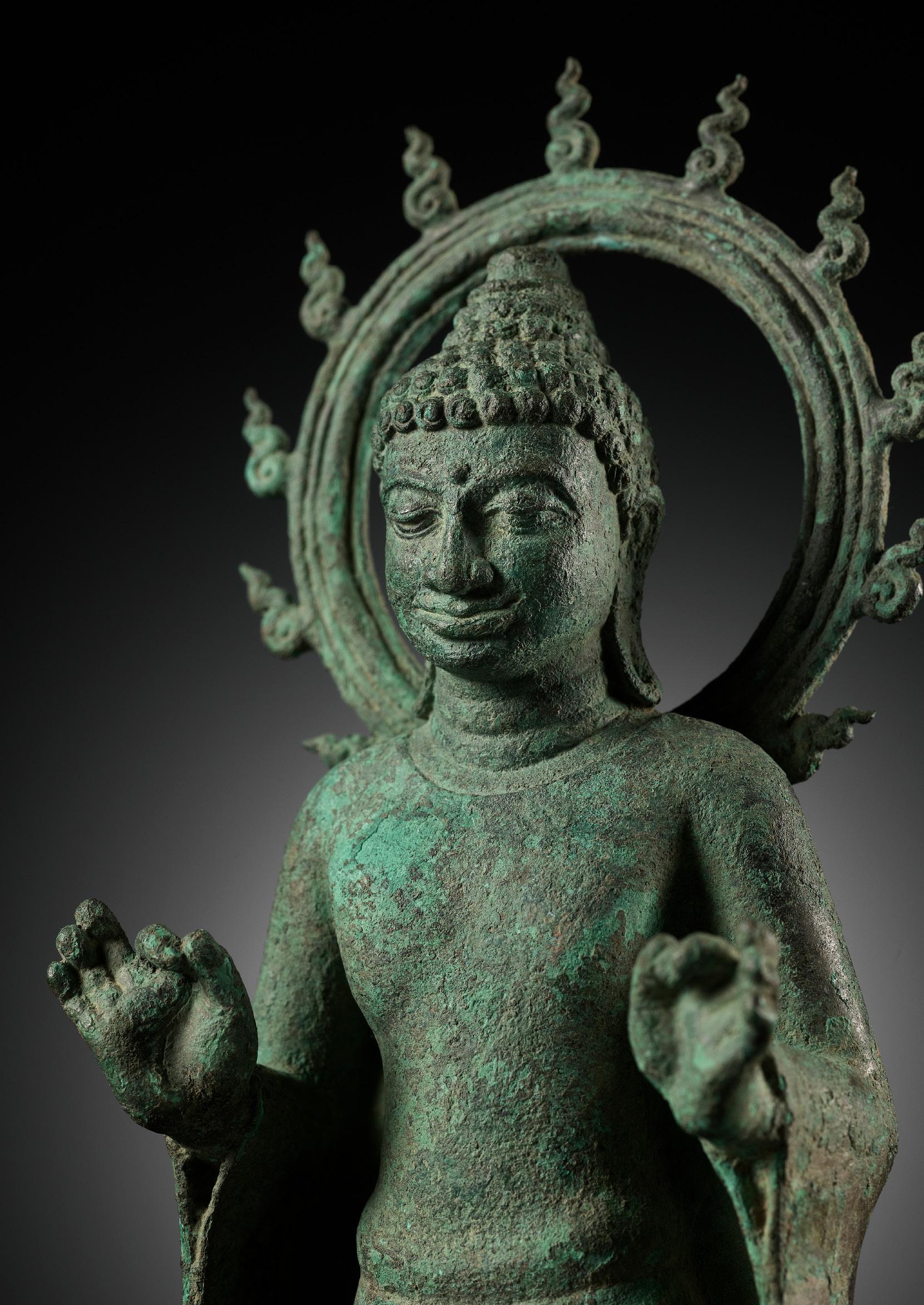
212
A VOLCANIC STONE FIGURE OF BUDDHA, CENTRAL JAVA, INDONESIA, FIRST HALF OF THE 9TH CENTURY

The boldly carved andesite statue depicts Buddha seated in vajrasana on a double lotus throne. His face is serene with a broad nose, heavylidded eyes, and full lips forming a gentle smile. His hair is carved with snail-shell curls and is surmounted by a pointed ushnisha. Overall, this is a quite spectacular example of the most ancient Buddhist art found in Indonesia.
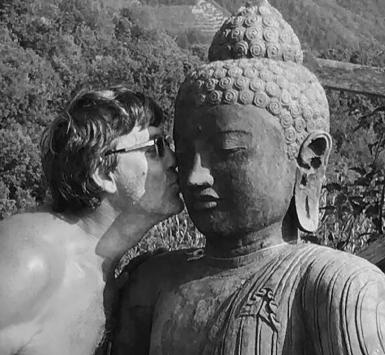
Provenance: Collection of Moreno Maria Majandi, by the late 1980s. Collection of Paolo Bertuzzi, acquired from the above, circa 2000. Paolo Bertuzzi (1943-2022) was a fashion stylist from Bologna, Italy. He was the son of Enrichetta Bertuzzi, founder of Hettabretz, a noted Italian fashion company with customers such as the Rothschild family, Audrey Hepburn, and Elizabeth Taylor. Paolo Bertuzzi later took over his mother’s business and designed exclusive pieces, some of which were exhibited in the Costume Institute of the Metropolitan Museum in New York, USA. He was also an avid collector of antiques for more than 60 years. His collection includes both archaic and contemporary art, and he edited two important books about Asian art, Goa Made - An Archaeological Discovery, about a large-scale archaeological project carried out with the Italian and Indonesian governments, and Majapahit, Masterpieces from a Forgotten Kingdom.
Condition: Condition commensurate with age. Extensive ancient wear, weathering, erosion, losses, the stone split in half at the base, remnants of moss and soil encrustations. It has become exceedingly rare to find ancient Buddhist statues in a 100% original and ‘as excavated’ condition, such as the present lot.
Dimensions: Height 86 cm
Literature comparison: Compare a related andesite seated figure of the Buddha, 71.4 cm high, dated to the 9th century, in the Metropolitan Museum of Art, accession number 1982.220.4. Compare a related seated Buddha Amitabha, 80 cm high, dated to the 9th century, in the Metropolitan Museum of Art, accession number 1995.256.
AUCTION RESULT COMPARISON
Type: Closely related
Auction: Christie’s Paris, 11 December 2013, lot 357
Price: EUR 85,500 or approx. EUR 102,000 adjusted for inflation at the time of writing
Description: A rare and important volcanic stone figure of Amoghasiddhi
Buddha, Indonesia, Central Java, circa 9th century
Expert remark: Compare the closely related pose, manner of carving, and losses. Note the larger size (107 cm).
Estimate EUR 15,000
Starting price EUR 7,500
338
Moreno Majandi

AN IMPORTANT OVER-LIFESIZE ANDESITE HEAD OF BUDDHA, CENTRAL JAVANESE PERIOD, INDONESIA, 9TH CENTURY

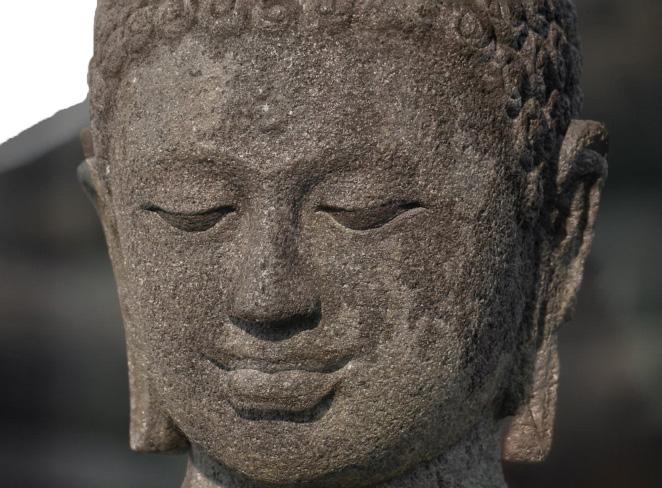
Expert’s note: The current lot exhibits compelling similarities to the renowned group of Buddha statues from Borobudur and can in particular be compared to several examples found at the Rupadhatu level. While appearing similar, each Buddha statue within this group actually possesses subtle variations, encompassing varying hand positions (mudras) and distinct facial features. These nuances symbolize distinct facets of enlightenment, from compassion and wisdom to spiritual power. For a closely related statue from the same period, see an andesite statue of Buddha which remains in situ at Borobudur (fig. 1). This particular statue exhibits several shared facial characteristics with the current lot, including outlined lips and crescent-shaped eyes, which become particularly apparent when viewed side by side (fig. 2) or superimposed over each other (fig. 3).
Superbly carved, the serene face with sinuously lidded downcast eyes below gently arched brows centered by a raised circular urna, above a broad nose and full bow-shaped lips with a raised lower edge forming a benevolent smile, flanked by long pendulous earlobes with pointed helices. The hair arranged in neatly incised snail-shell curls over the high ushnisha.
Provenance: From a European private collection, acquired before 2007, and thence by descent.
Condition: Superb condition, commensurate with age. Extensive wear, expected losses, signs of weathering and erosion, minor nicks. The stone with a superb, naturally grown, dark patina overall.
Weight: 25.2 kg (incl. stand)
Dimensions: Height 42 cm (excl. stand) and 58.5 cm (incl. stand)
With an associated stand. (2)
The present andesite head epitomizes the ingenuity of the Central Javanese stone carvers of the time, with distinct characteristics such as the incised pupils, large and elongated ears, and masterful snail-shell curls, arguably the best-designed facial features across all Buddhist art. Furthermore, the present sculpture bears the telltale signs of smoothened areas where beholders were gripped with the overt temptation to caress the head, which combined with the porous nature of the stone give it a unique yet unmistakable and, without a doubt, inimitable appearance.
A Buddha image of ineffable quiet and stillness has been carved from rough volcanic rock. The profile and dome of the head are broad, allowing for a round tapering of the forehead, cheeks, and chin that, once finished with a polish, produce an overall impression of smoothness, belying the porous nature of the stone, which has resisted over a millennium of weather exposure with stunning ease. The sculptors working on the great stone monuments of 9th century Central Java produced some of the most beautifully proportioned Buddhist sculptures of any period or medium.
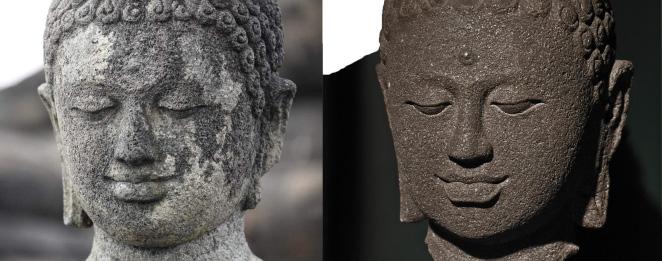
The present statue is almost certainly from Borobudur or a related temple site, such as Sewu or Ngawen in Central Java. Built by the Shailendra dynasty around 825 CE, Borobudur is one of the greatest Buddhist monuments of all time, having one of the largest and most complete ensembles of Buddhist narrative relief panels in the world. Structured as a mandala of stacked platforms representing the three planes of existence in Mahayana cosmology (the world of desire, the world of forms, and the world of formlessness), Borobodur invites pilgrims circumambulating its didactic panels and sculpture to shuck the trappings of their perceived reality and realize their true inherent formlessness.
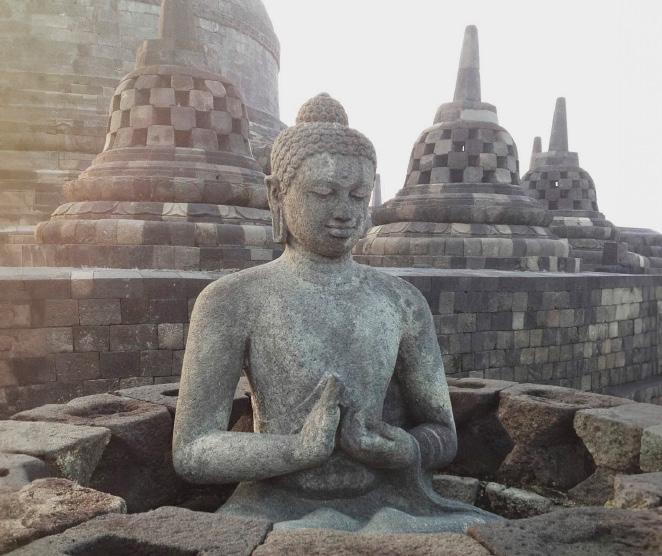
AUCTION RESULT COMPARISON
Type: Closely related
Auction: Christie’s New York, 17 March 2016, lot 23
Price: USD 509,000 or approx. EUR 596,000 converted and adjusted for inflation at the time of writing
Description: An important stone head of Buddha, Indonesia, Central Java, 9th century Expert remark: Compare the closely related stone, manner of carving, and expression. While the Christie’s example hails from a well-known collection, the current lot bears greater resemblance to pieces found in prominent museum collections. Both examples share similar features and size, but the current lot stands out as aesthetically superior. Note the related size (39.9 cm)
Estimate EUR 10,000
Starting price EUR 5,000
340 213
A closely related Buddha statue in a perforated stupa at Borobodur, Indonesia
A side-by-side comparison of the present lot and a closely related Buddha statue in a perforated stupa at Borobodur, Indonesia
A composition image showing the above heads superimposed over each other
fig. 1
fig. 2
fig. 3
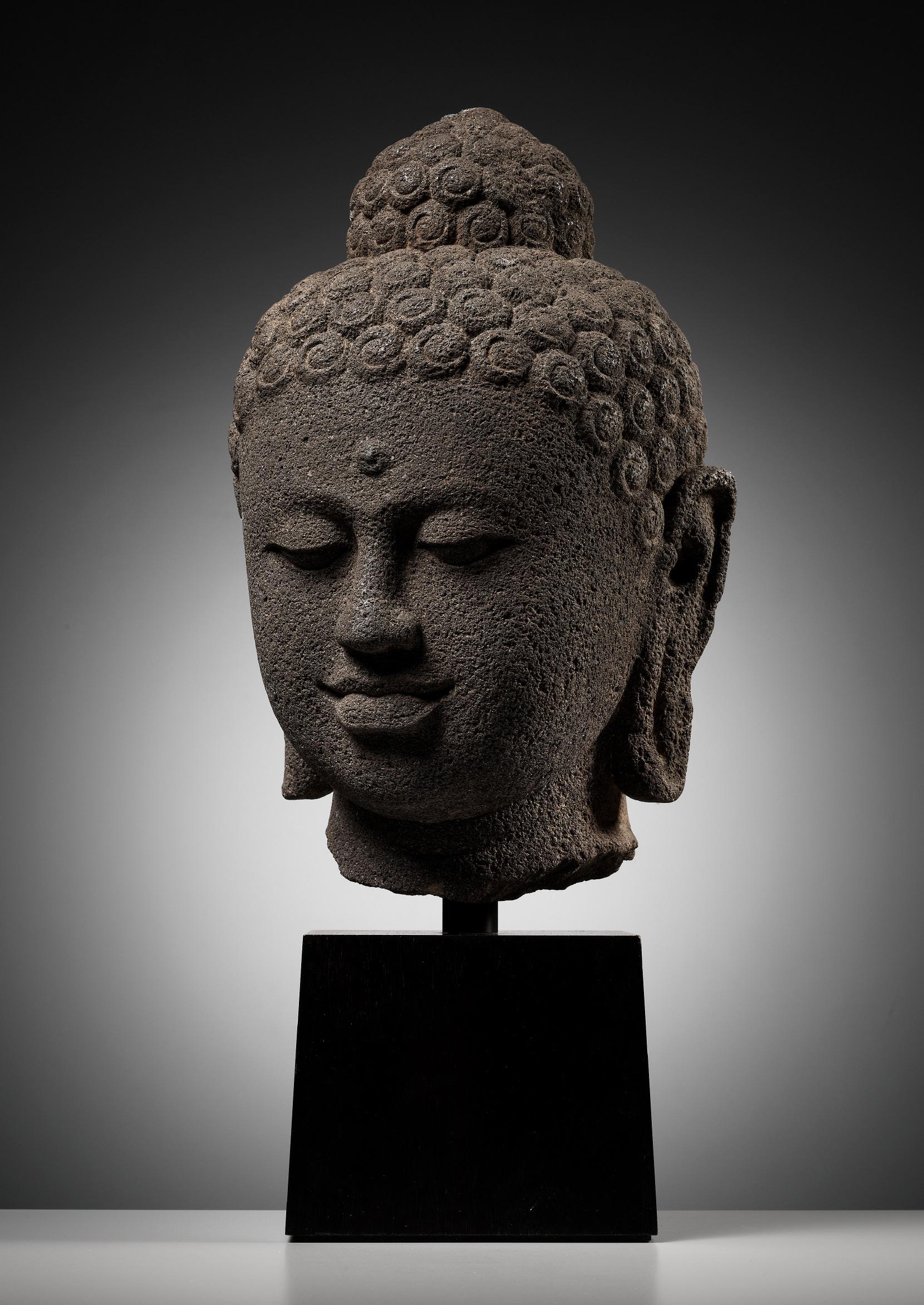
A MONUMENTAL BRONZE HEAD OF BUDDHA, LAN NA, NORTHERN THAILAND, 14TH-15TH CENTURY
Expert’s note: Thai bronzes of this size and preservation are exceptionally rare, particularly those that are over 500 years old. It’s challenging to imagine the immense scale of the complete sculpture to which this head belonged, standing at well over 2 meters tall. Only a few works of similar magnitude have endured the test of time, and this magnificent head is among the largest privately owned examples. Despite centuries passing, it has retained all its spirit, a near-magical presence, a sense of tranquility, and, above all, its ability to inspire.
Buddha’s slightly elongated oval face with outlined smiling lips, aquiline nose, neatly incised heavy-lid downcast eyes below finely arched eyebrows in relief, his ears with extended pierced earlobes, the hair arranged in rows of snail shell curls, surmounted by an ushnisha.

The bronze heavily cast and with a rich naturally grown patina, showing distinct malachite encrustations. The surface with natural wear overall, resulting from centuries of worshipping.
Provenance: From an old private collection in Palm Beach, Florida, USA. Sotheby’s New York, 23 March 1995, lot 101. A private collection in New Jersey, USA, acquired from the above, and thence by descent within the family.
During the late 13th century, Sukhothai reached its peak under King Ram Khamhaeng’s reign. However, after his death, the kingdom declined, and various tributary states began to break away rapidly. Lan Na annexed Tak, an ancient town in Sukhothai, and other regions to the north and west asserted their independence. By the 14th century, Sukhothai had diminished to a local power and eventually became a tributary state of the Ayutthaya Kingdom, a neighboring Thai polity. In 1438, after the death of Borommapan, Ayutthaya annexed Sukhothai, bringing an end to its independent existence.
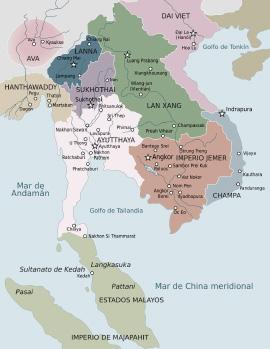
Literature comparison: Compare a closely related Buddha bronze head, dated to the 14th-15th century, from Wat Mai, Sukhothai, now in the Sawanvoranayok National Museum, illustrated in Ancient Sukhothai: Thailand’s Cultural Heritage, Dawn F. Rooney, 2008, pp. 198-99. Compare closely related Buddhas, held in Thai temples, illustrated in Stratton, Buddhist Sculpture of Northern Thailand, Chiang Mai, 2004, pp. 163-179, & figs. 7.50-7.58. Compare the fragmentary example held in the National Museum, Lamphun, published in Bowie (ed.), The Sculpture of Thailand, New York, 1972, p. 94-5, no. 55. Compare a closely related Buddha head at the National Museum of Bangkok and published in J. Boisselier, La sculpture en Thailande, Fribourg, 1987, pl. 111.

AUCTION RESULT COMPARISON
Type: Closely related
Condition: Superb condition, commensurate with age, showing extensive wear, weathering, and expected casting flaws. Some losses, nicks, and scratches. The interior of the head with a filling used to mount the head to the stand. The wood base with age cracks and flaking to lacquer.
Weight: 24.7 kg (excl. stand)
Dimensions: Height 40.5 cm (the head) and 60 cm (incl. stand)

Mounted on a wood base, dating from the 20th century. (2)
The present bronze bears distinctive features of the Sukhothai style, evident in its oval shape, hairline, and aquiline nose. A closely related example from the Sukhothai tradition is a bronze head now housed in the Sawanvoranayok National Museum (see literature comparison). However, there are slight variations in the facial treatment, such as less upswept eyes and fuller lips. The face also shows arched eyebrows, an upward turn at the sides of the mouth, and an oval marking on the chin. The flowing curves of these features come together harmoniously, making this sculpture an excellent representation of the neighboring Lan Na Kingdom’s artistic style. Lan Na was a powerful state in Northern Thailand and actively promoted Buddhism, shaping their Buddhist sculptures with influences from the Sukhothai kingdom.
Auction: Bonhams, Paris, 25-26 October 2022, lot 83
Price: EUR 176,775 or approx. EUR 182,000 adjusted for inflation at the time of writing
Description: A copper alloy head of Buddha, Thailand, Sukhothai School, Kampheng Phet, 14th century

Expert remark: Compare the closely related manner of casting and modeling with similar features. Note the similar size (43 cm).
AUCTION RESULT COMPARISON
Type: Closely related
Auction: Christie’s, London, 11 May 2016, lot 82
Price: GBP 60,000 or approx. EUR 101,000 adjusted for inflation at the time of writing
Description: A monumental bronze head of Buddha, Thailand, Lan Na period, 15th century
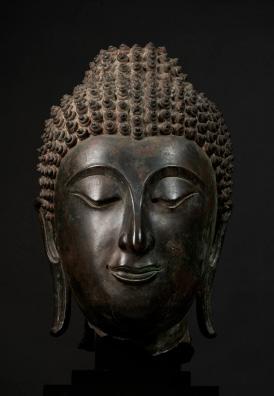
Expert remark: Compare the closely related manner of casting and modeling with similar features. Note the slightly larger size (45 cm).
Estimate EUR 24,000
Starting price EUR 12,000
342 214
The Lan Na and Sukhothai Kingdoms in 1400 AD

A LIFESIZE BRONZE HAND OF BUDDHA, AYUTTHAYA KINGDOM
Thailand, 14th-15th century. Cast with thin and elongated fingers neatly detailed with nails and creases, finely modeled in the vitarka mudra, the gesture of discussion, the palm with two naturalistic creases that extend to the base of the wrist which is covered by the lightly draped sleeve. The bronze with a rich, naturally grown, smooth patina with malachite and cuprite encrustations.
Provenance: Collection de M. L., Paris, France.
Condition: The fragment in good condition, commensurate with age, with wear and casting irregularities, soil encrustation, wear and weathering, losses. Presenting spectacularly well.
Weight: 1,399 g
Dimensions: Height 29.4 cm
Mounted on an associated metal stand. (2)
Literature comparison: Compare two related Thai bronze hands, dated to the 14th century, in the collection of the Philadelphia Museum of Art, accession numbers 1994-148-770 and 1994-148-771.
AUCTION RESULT COMPARISON
Type: Closely related
Auction: Christie’s New York, 24 April 2013, lot 52
Price: USD 5,250 or approx. EUR 6,300 converted and adjusted for inflation at the time of writing
Description: A Thai bronze hand
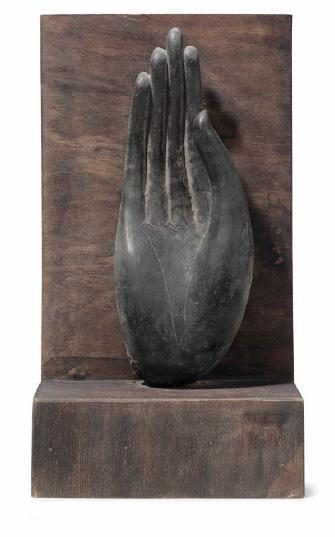

Expert remark: Compare the closely related modeling with similar creases articulated in the palm and similarly elongated fingers. Note the slightly smaller size (22.4 cm).
Estimate EUR 4,000
Starting price EUR 2,000
344 215
A LARGE BRONZE HEAD OF BUDDHA, SUKHOTHAI KINGDOM, THAILAND, 15TH CENTURY
Cast with a serene expression, incised heavy-lid downcast eyes below arched eyebrows, a sharp nose, full lips forming a calm smile, flanked by pendulous earlobes with tips turned outward, the hair arranged in tight curls over the ushnisha.
Provenance: From an old German private estate.
Condition: Good condition, commensurate with age. Wear, losses, casting flaws, cracks, dents, nicks, and scratches. The bronze with a rich, smooth, naturally grown patina with malachite encrustations.
Weight: 10.7 kg (excl. stand)
Dimensions: Height 33.5 cm (the head) and 36.5 cm (incl. stand)
With an associated wood stand. (2)
AUCTION RESULT COMPARISON
Type: Closely related
Auction: Christie’s London, 11 May 2016, lot 94
Price: GBP 20,000 or approx. EUR 33,000 adjusted for inflation at the time of writing
Description: A fine bronze head of Buddha, Thailand, Sukhothai period, 15th century

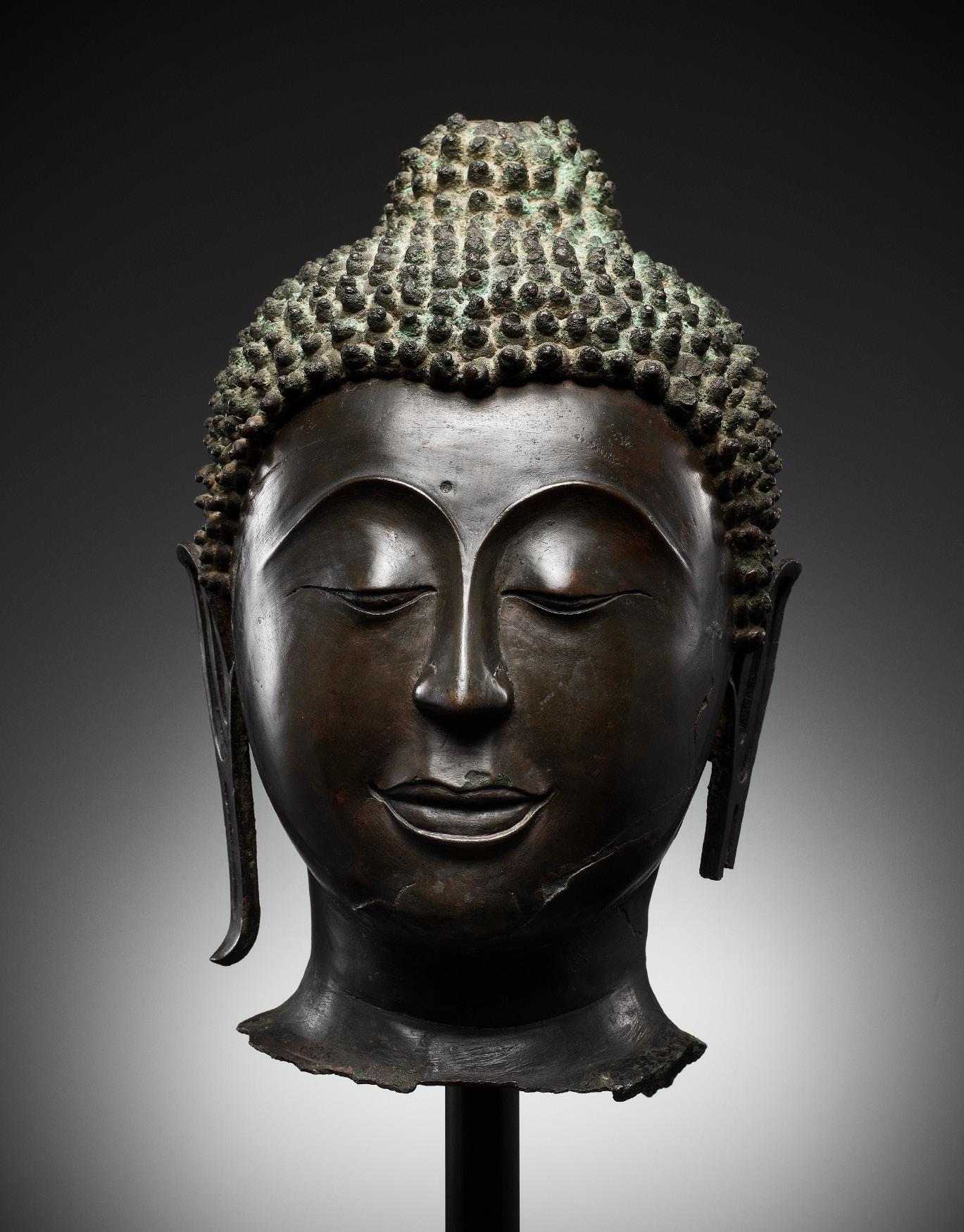
Expert remark: Note the size (33 cm).
Estimate EUR 6,000
Starting price EUR 3,000
345
216
A BRONZE FIGURE OF GANESHA, ANGKOR PERIOD, KHMER EMPIRE, 11TH-12TH CENTURY OR EARLIER
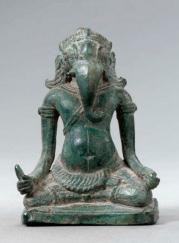
Seated in dhyanasana on a double lotus base, clad in a short sampot elegantly tied with a butterfly tang to the back. The deity is richly adorned in floral jewelry, a headdress and conical crown, holding modaks in his two hands, Ganesha’s favorite dish, his face with a long trunk flanked by large ears. Superb naturally grown patina with smooth malachite and cuprite encrustations.
Provenance: A noted private collection in Bavaria, Germany. A copy of a certificate dating the present lot as early as the 7th-8th century, signed by Dr. Hoang Anh Tuan, Director of the Ho Chi Minh City Museum of History, dated 11 May 2018, accompanies this lot. A collector’s label to the base, ‘Tp Ho Chi Minh, Bao Tang Lich Su 1979’.
Condition: Good condition with minor ancient wear, casting irregularities, small losses, tiny nicks, and minor dents. Weathering and traces of erosion.
Weight: 190.1 g
Dimensions: Height 9.2 cm
The matching double lotus throne is cast separately and neatly incised with numerous lotus petals in high relief. (2)
God of wisdom and remover of obstacles both visible and invisible, the elephant-headed Ganesha is invoked at the commencement of any new undertaking or journey. As the deity’s spirit was thought to reside within its likeness, this small bronze statue would thus constitute a perfect traveling companion, guiding its owner towards wise decisions and safe paths.
Literature comparison: Compare a closely related figure of Ganesha from Cambodia, dated to the 12th-13th century, in the collection of the Minneapolis Institute of Art, accession number 99.216.11.
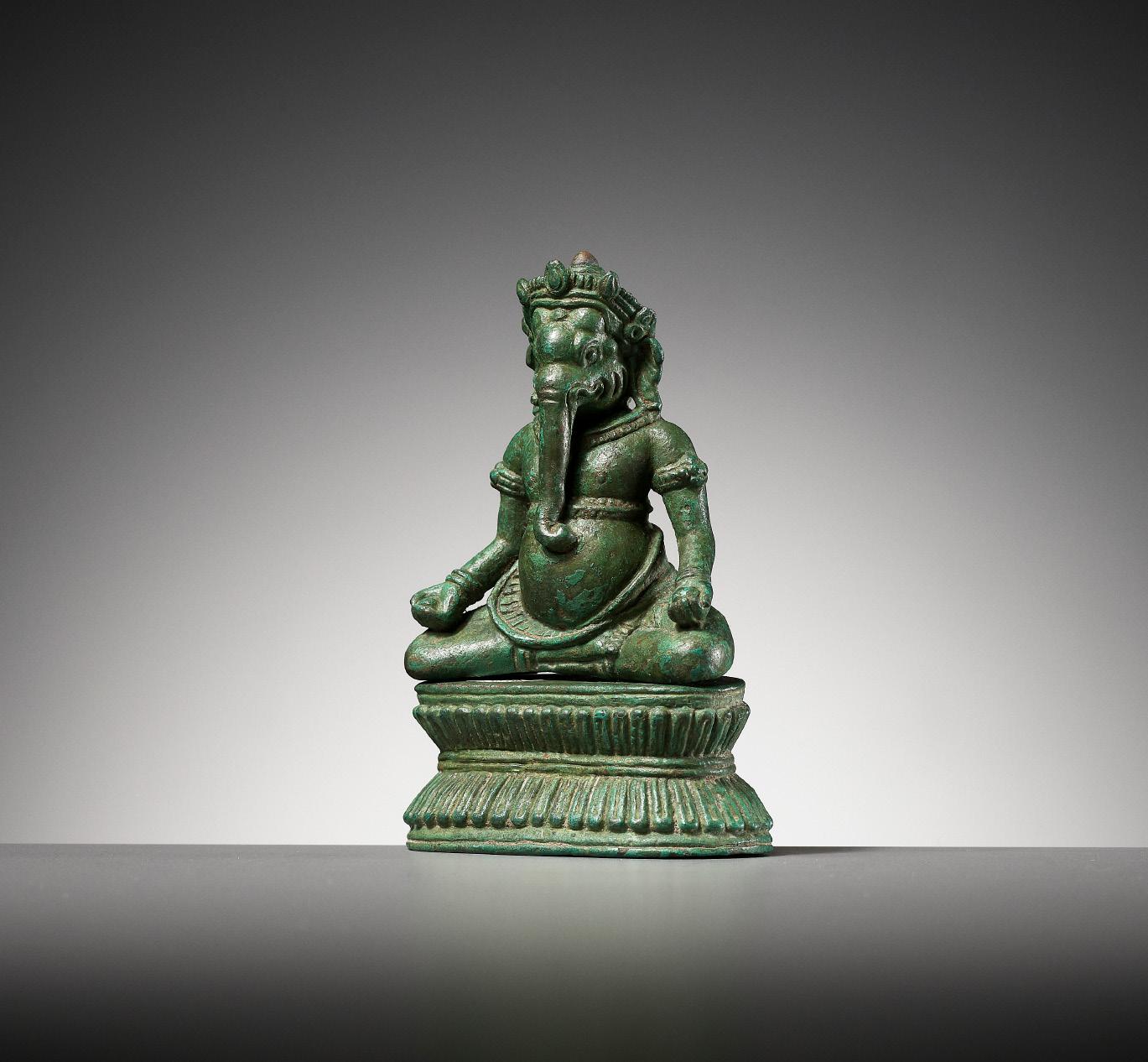
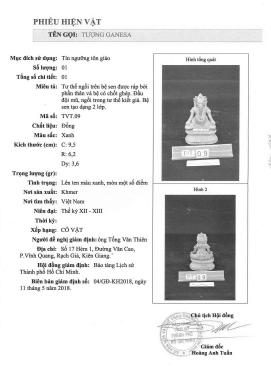
AUCTION RESULT COMPARISON
Type: Closely related
Auction: Christie’s New York, 25 March 2004, lot 167
Price: USD 8,963 or approx. EUR 13,500 converted and adjusted for inflation at the time of writing
Description: A rare bronze figure of Ganesha, Khmer, Angkor period, Baphuon style, late 11th century
Expert remark: Note the identical size (9.2 cm).
Estimate EUR 6,000
Starting price EUR 3,000
346 217
A BRONZE FIGURE OF BUDDHA MUCHALINDA, KHMER EMPIRE, ANGKOR PERIOD


Cambodia, 12th-13th century. Cast seated in meditation on a coiled snake, his hands held in his lap in dhyanamudra, wearing a dhoti secured at the waist, a thick torque around his neck, the face with a benign expression flanked by pendulous earlobes, the hair pulled into a conical chignon surmounted by an ushnisha and secured with a wide tiara.
The seven-headed serpent rising above his head to form a hood sheltering the figure. The faces of the nagas remarkably well-defined and with neatly incised scales.
Provenance: From a noted private collection in Belgium.
Condition: Very good condition with old wear and some minor casting flaws, small nicks and losses, and tiny scratches. A naturally grown, fine deep brown and dark green patina overall. Ancient soil encrustations and remnants of pigment.
Weight: 1,851 g (incl. stand)
Dimensions: Height 23.6 cm (excl. stand) and 25.5 cm (incl. stand)
Mounted on an associated wood base.
This iconic image of Siddartha Gautama’s pursuit of enlightenment shows the scene when torrential rain threatened to drown him. The king of the nagas, Muchalinda, rose from the earth, coiling his body to form a seat swelling his great hood to shelter Buddha beneath his seven-headed canopy. Only few early examples of this type have been recorded. The well-modeled naga hood in later stylistic development dissolves into greater ornamentation; compare to an in situ example of a stone sculpture of Buddha Muchalinda, illustrated in M. Freeman and R. Warner, Angkor, The Hidden Glories, 1990, page 128.
Literature comparison: Compare a related bronze figure of Buddha Muchalinda, 16 cm high, dated to the Angkor period, 12th century, in the National Museum of Cambodia, inventory number NMC.419. Compare a related bronze figure of Buddha Muchalinda, 14.2 cm high, dated to the Angkor period, 12th century, in the National Museum of Cambodia, inventory number NMC.414. Compare a related bronze figure of Buddha Muchalinda, 11.4 cm high, dated to the Angkor period, 12th-13th century, in the Brooklyn Museum, accession number 83.237.4.
AUCTION RESULT
COMPARISON
Type: Closely related
Auction: Christie’s New York, 20 March 2002, lot 11
Price: USD 94,000 or approx. EUR 149,000 converted and adjusted for inflation at the time of writing
Description: A bronze figure of Buddha Muchalinda, Khmer, Bayon style, late 12th/13th century
Expert remark: Note the larger size (29.1 cm).
Estimate EUR 6,000
Starting price EUR 3,000
218
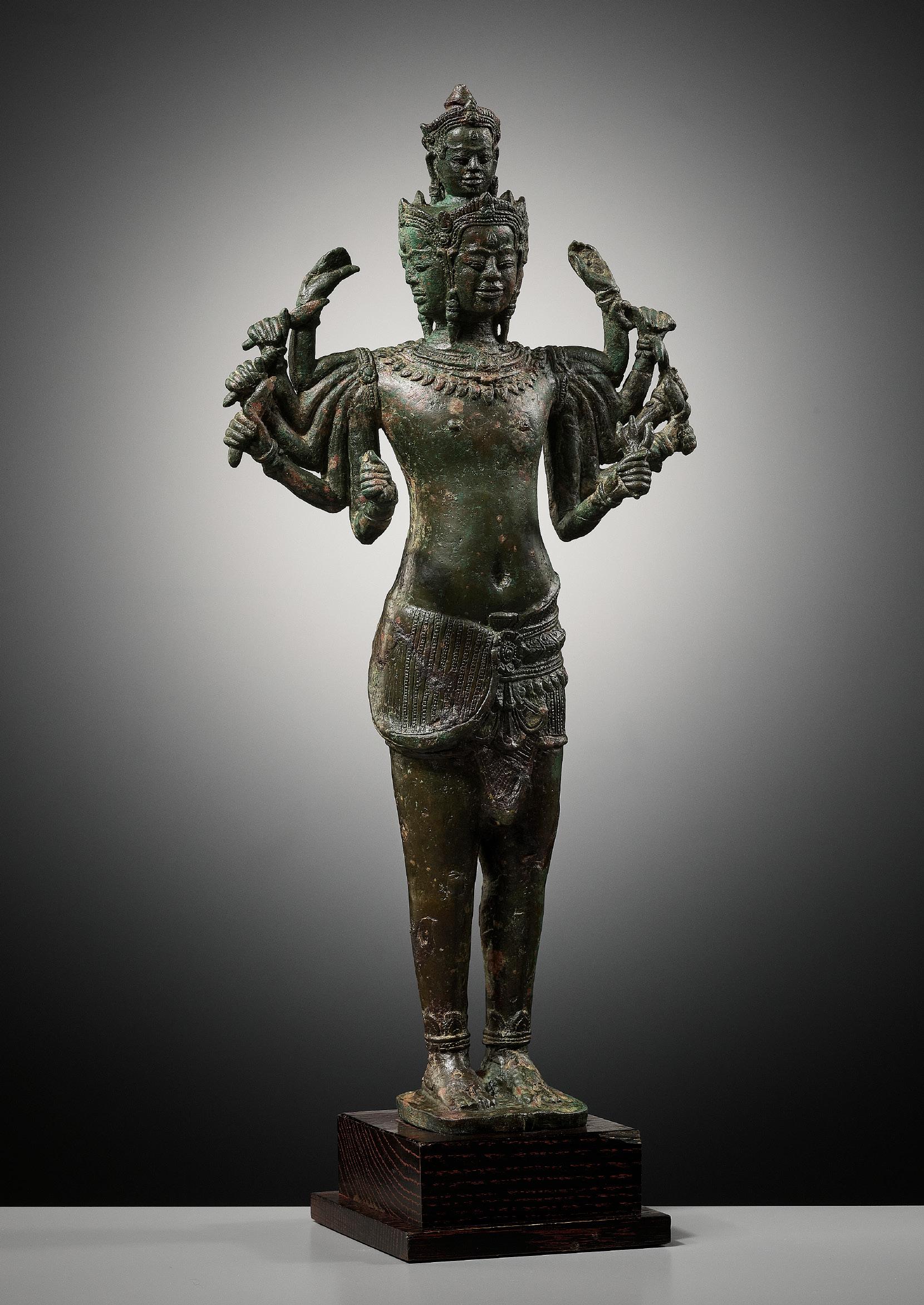
A LARGE AND IMPORTANT BRONZE FIGURE OF SADASHIVA, ANGKOR PERIOD, BAYON STYLE
Khmer Empire, 12th-13th century. Standing on a small square plinth in sampada with his arms radiating around him, the five-headed deity clad in a short sampot with fishtail pleat and jeweled sash, incised finely with foliate decorations. His hands depicted holding his attributes. The body finely ornamented in jewelry, including a collar necklace, bracelets, armbands, earrings, and an ornate diadem. The five faces finely cast with almond-shaped eyes, aquiline nose, an urna, full lips and ears with pendulous earrings.
Provenance: Old Spanish private collection, acquired in the 1960s. Old French private collection, acquired from the above in 1998.
Jacques Barrère, Paris, France, acquired from the above. A copy of a signed expertise from Jacques Barrère Art D’Extrême Orient, dated 30 September 2005, confirming the dating and provenance above, accompanies this lot.
The Jacques Barrère Gallery is located in the heart of Paris, in the Saint-Germain-des-Prés district. Since 1969, it has held exhibitions to promote and preserve Far-Eastern art. The gallery specializes in Chinese sculpture, archaeology, ceramics and decorative arts, as well as Japanese works of art and porcelain. Statuary art from Gandhara, India or South-East Asia is also regularly displayed. Objects once owned by Barrère are now in major museums around the world, including the Guimet, the Cernuschi, and the Shanghai Museum. The Barrère gallery is a regular exhibitor at TEFAF in Maastricht.
Condition: Good condition commensurate with age. As expected, there is extensive wear, some casting flaws, losses, signs of weathering and erosion, few nicks and shallow surface scratches, fatigue cracks with associate losses and old fills, all as expected from a Khmer bronze of nearly 1,000 years of age. Superb, naturally grown, rich patina with extensive malachite encrustation and faint hues of cuprite.
Weight: 3,077 g cm (excl. stand), 3,372 g (including base)
Dimensions: Height 40.6 cm (excl. stand), 46 cm (including base)
With a modern wood base. (2)
Five-headed images of Shiva appear in Khmer Art from the tenth century onwards. This Bayon period bronze of the late twelfth to early thirteenth centuries represents the god in his form as either Sadashiva or Mahesha. Indian texts state that the highest principle of Shiva is transcendent and without form. Sadashiva is considered to represent the god as he begins to assume form in the material world. When fully manifested in the physical world, Shiva is considered as Mahesha. These two forms are characterized by five heads arranged in two tiers, four facing the cardinal directions and the fifth on top, and ten arms each holding an attribute. The primary face is marked with Shiva’s characteristic third eye.
The five faces are believed to represent earth, water, fire, wind, and sky, or - alternatively - violence (south face), maternity (north face), joy (west face), union (east face), and benevolence (face on top of the head). Sadashiva, a name particularly given to the five-faced and ten-armed Shiva, also directly refers to the benevolence on top of the head. It was introduced from India to the Khmer kingdom in the ninth century during the reign of Jayavarman II.
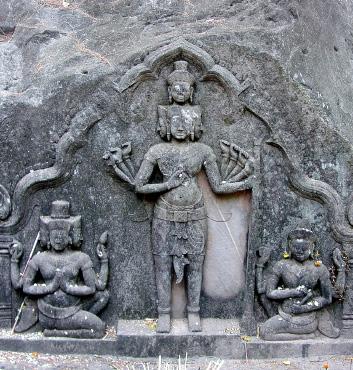
Sadashiva standing between Brahma and Vishnu, sandstone relief at Vat Phou, Laos, circa 10th century. Situated at the juncture of the historical Champa and Khmer Kingdoms, the temple complex in Vat Phou stands as a testament to the cultural convergence that took place in this region. The intermingling of these kingdoms had a significant impact on the artistry of the era, and the statue on this image, as well as the present lot, serves as a remarkable illustration of the Champa’s influence on ancient Khmer sculpture.
Shaivism was the most prevalent sect of Hinduism followed in Cambodia and was sponsored by numerous Angkorian kings over the centuries. A well-developed sculptural tradition based around this sect consequently arose and Shiva was depicted in many forms, varying from the aniconic linga to large scale images in the round. Five-headed images of Shiva such as this example were executed in both stone and bronze and represent one of the more unique depictions of the deity.
LITERATURE COMPARISON
Compare a bronze figure of Sadashiva in Angkor et dix siècles d’art Khmer, Exhibition Catalogue, Paris: Reunion des Musées Nationaux, 1997, pl.111. Compare a closely related Khmer Bayonstyle bronze of Shiva as Sadashiva or Mahesha, 28 cm high, dated to the late 12th-early 13th century, in the Asian Civilisations Museum, Singapore, accession number 2015-00374 (fig. 1). Also compare a closely related Khmer period bronze of Standing Shiva, dated to the 12th century, in the collection of Miho Museum, Japan. Also compare a closely related Khmer bronze of Sadashiva, dated to circa 12th-13th century, in the Champasak Provincial Museum, Pakse, Laos. Also compare with another Sadashiva idol on display at Bangkok National Museum. And also compare with another figure bronze figure of Shiva with five arms and heads, 35 cm high, in the Musee National de Phnom Penh, Cambodia.
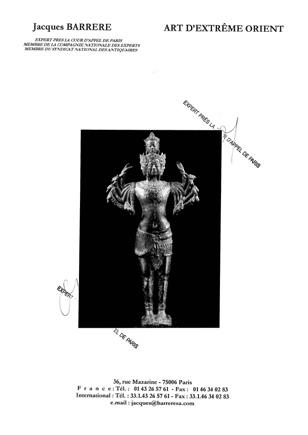
AUCTION RESULT COMPARISON
Type: Closely related
Auction: Christie’s New York, 20 September 2000, lot 157
Price: USD 138,000 or approx. EUR 225,000 converted and adjusted for inflation at the time of writing
Description: An Important Bronze Figure of Avalokiteshvara, Khmer, Koh Ker Style, 10th Century
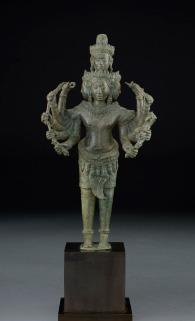
Expert remark: Note the similar size (44 cm). Bronze figures from the Khmer empire with a size exceeding 40 cm are extremely rare, which is why this comparison was chosen, although this statue is from Koh Ker and dates to the 10th century.
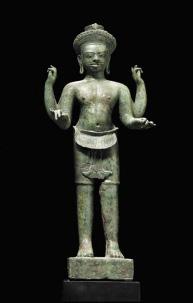
Estimate EUR 15,000
Starting price EUR 7,500
349 219
fig. 1
A LARGE BRONZE FIGURE OF SADASHIVA, ANGKOR PERIOD, BAYON STYLE
Exhibited: Los Angeles County Museum of Art, USA, according to the expertise from Jacques Barrère Art D’Extrême Orient, dated 9 July 2001.
The Los Angeles County Museum of Art (LACMA)
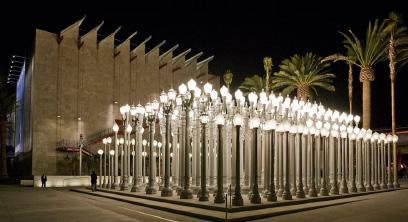
Khmer Empire, late 12th to early 13th century. Standing on a small square plinth in sampada with his arms radiating around him, the five-headed deity is clad in a short sampot with fishtail pleat and jeweled sash, to the back a flared tang. The body finely ornamented in jewelry, including a collar necklace, bracelets, armbands, earrings, and an ornate diadem. The five faces finely cast with almond-shaped eyes, aquiline nose, an urna, and full lips.
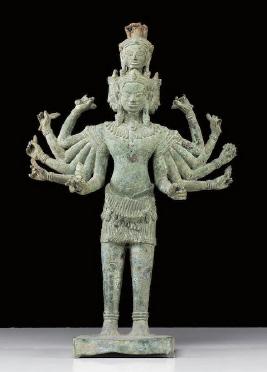
Provenance: Former Pan Asian Collection. Jacques Barrère, Paris, France, acquired from the above. A copy of a signed expertise from Jacques Barrère Art D’Extrême Orient, dated 9 July 2001, confirming the dating and provenance above, accompanies this lot. The expertise also states a ‘replacement value’ of 170,000 FF or EUR 37,500, converted and adjusted for inflation. The Jacques Barrère Gallery is located in the heart of Paris, in the Saint-Germain-des-Prés district. Since 1969, it has held exhibitions to promote and preserve Far-Eastern art. The gallery specializes in Chinese sculpture, archaeology, ceramics and decorative arts, as well as Japanese works of art and porcelain. Statuary art from Gandhara, India or South-East Asia is also regularly displayed. Objects once owned by Barrère are now in major museums around the world, including the Guimet, the Cernuschi, and the Shanghai Museum. The Barrère gallery is a regular exhibitor at TEFAF in Maastricht.
Condition: Excellent condition, commensurate with age. There is extensive wear, some casting flaws, minor losses, signs of weathering and erosion, small nicks and shallow surface scratches, all as expected from a Khmer bronze of nearly 1,000 years of age. Faint remnants of gilt.
Weight: 3,557 g
Dimensions: Height 38.8 cm
Five-headed images of Shiva appear in Khmer Art from the tenth century onwards. This Bayon period bronze of the late twelfth to early thirteenth centuries represents the god in his form as either Sadashiva or Mahesha. Indian texts state that the highest principle of Shiva is transcendent and without form. Sadashiva is considered to represent the god as he begins to assume form in the material world. When fully manifested in the physical world, Shiva is considered as Mahesha. These two forms are characterized by five heads arranged in two tiers, four facing the cardinal directions and the fifth on top, and ten arms each holding an attribute. The primary face is marked with Shiva’s characteristic third eye.
The five faces are believed to represent earth, water, fire, wind, and sky, or - alternatively - violence (south face), maternity (north face), joy (west face), union (east face), and benevolence (face on top of the head). Sadashiva, a name particularly given to the five-faced and ten-armed Shiva, also directly refers to the benevolence on top of the head. It was introduced from India to the Khmer kingdom in the ninth century during the reign of Jayavarman II.
A signed expertise from Jacques Barrère Art D’Extrême Orient, dated 9 July 2001

Shaivism was the most prevalent sect of Hinduism followed in Cambodia and was sponsored by numerous Angkorian kings over the centuries. A well-developed sculptural tradition based around this sect consequently arose and Shiva was depicted in many forms varying from the aniconic linga to large scale images in the round. Five-headed images of Shiva such as this example were executed in both stone and bronze and represent one of the more unique depictions of the deity.
Literature comparison: Compare a bronze figure of Sadashiva in Angkor et dix siècles d’art Khmer, Exhibition Catalogue, Paris: Reunion des Musées Nationaux, 1997, pl.111. Compare a closely related Khmer Bayon-style bronze of Shiva as Sadashiva or Mahesha, 28 cm high, dated to the late 12th-early 13th century, in the Asian Civilisations Museum, Singapore, accession number 2015-00374. Also compare a closely related Khmer period bronze of Standing Shiva, dated to the 12th century, in the collection of Miho Museum, Japan. Also compare a closely related Khmer bronze of Sadashiva, dated to circa 12th-13th century, in the Champasak Provincial Museum, Pakse, Laos. Also compare with another Sadashiva idol on display at Bangkok National Museum. Also compare with another figure bronze figure of Shiva with five arms and heads, 35 cm high, in the Musee National de Phnom Penh, Cambodia.
AUCTION RESULT COMPARISON
Type: Closely related
Auction: Bonhams London, 8 June 2004, lot 437
Estimate: GBP 18,000 or approx. EUR 42,500 adjusted for inflation at the time of writing
Description: A large and important bronze figure of a five headed tenarmed deity, probably Sadasiva, Khmer, Angkor Period, Angkor Wat style, 12th Century
Expert remark: Note the smaller size (32 cm).
Estimate EUR 15,000
Starting price EUR 7,500
350 220
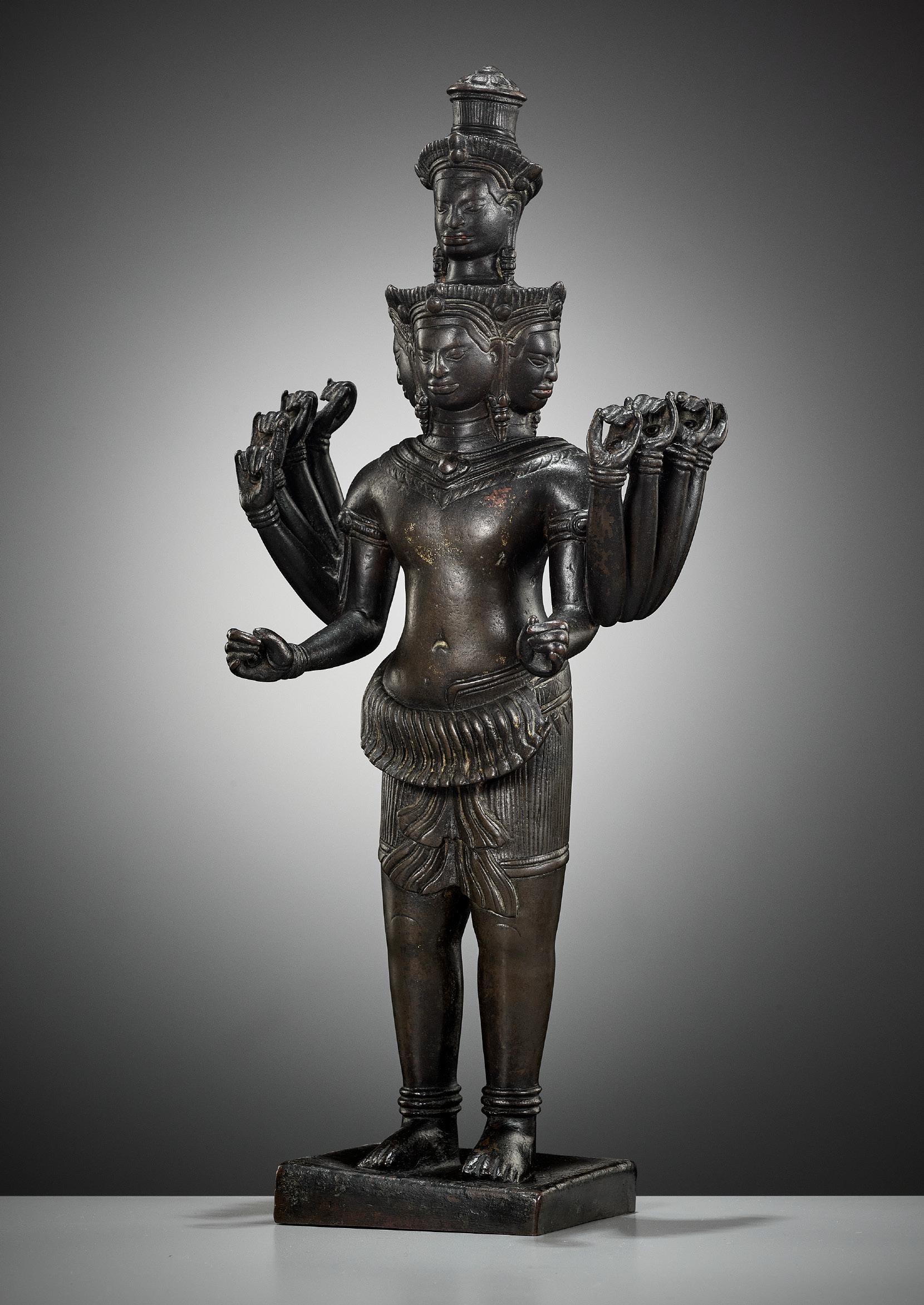
A BRONZE FIGURE OF VISHNU STANDING ON GARUDA, ANGKOR PERIOD

Khmer Empire, 11th-12th century. The four-armed deity standing on Garuda’s shoulders and holding a disk and conch in his uppermost hands, and a club and seed in his lower hands, wearing a sampot and richly adorned in jewelry. The mythical bird standing on a square base with arms and wings outstretched as if flying through the air. Both with benign expressions.
Provenance: From the private collection of Darwin Freeman, collected between the 1968-1971, and thence by descent within the same family. Born 1946 in Idaho, USA, Darwin Freeman was a member of the armed forces and later became an avid collector. He met his wife in the mid-1960s, and the pair later relocated to her hometown of Innsbruck, Austria. In 1967, Freeman was drafted into the U.S. Army and served in Germany and Thailand. While he was stationed at the Embassy in Bangkok, between 1969 and 1971, he actively began engaging in the exploration and collection of ancient bronzes and other works of art. Upon completing his duty, Freeman arranged for his collection to be shipped to Austria, where it remained in storage until this day.
Condition: Very good condition commensurate with age, showing old wear, weathering and corrosion, minuscule nicks here and there, minor losses, and a fine natural patina with malachite-green encrustations.
Weight: 896.2 g
Dimensions: Height 25.5 cm
This bronze may have served as an official insignia when the cult of Vishnu was raised to higher prominence under Suryavarman II, upon ascending to the throne in 1113.
In Hinduism, Vishnu is the preserver and maintainer of the established order. Whereas Shiva is Lord of the Beginning and of the End, Vishnu is the deity who oversees the middle ground, avoids extremes, and maintains orthodoxy. The standard depiction of Vishnu is four-armed, standing upright and wearing a crown. He carries a conch shell, a lotus, a club, and a discus. His vehicle is the bird Garuda depicted here in the usual form as part human, part bird.
LITERATURE COMPARISON
Compare a Khmer bronze figure of Vishnu standing on Garuda, dated to the Khmer period, late 11-early 12th century, in the Brooklyn Museum, accession number 85.220.4 (fig. 1). Also compare a Khmer bronze figure of Vishnu standing on Garuda, dated to 1213th century, in the Minneapolis Institute of Art, accession number 99.216.7.

Estimate EUR 10,000
Starting price EUR 5,000
fig. 1
221
A SANDSTONE LINGAM, ANGKOR PERIOD
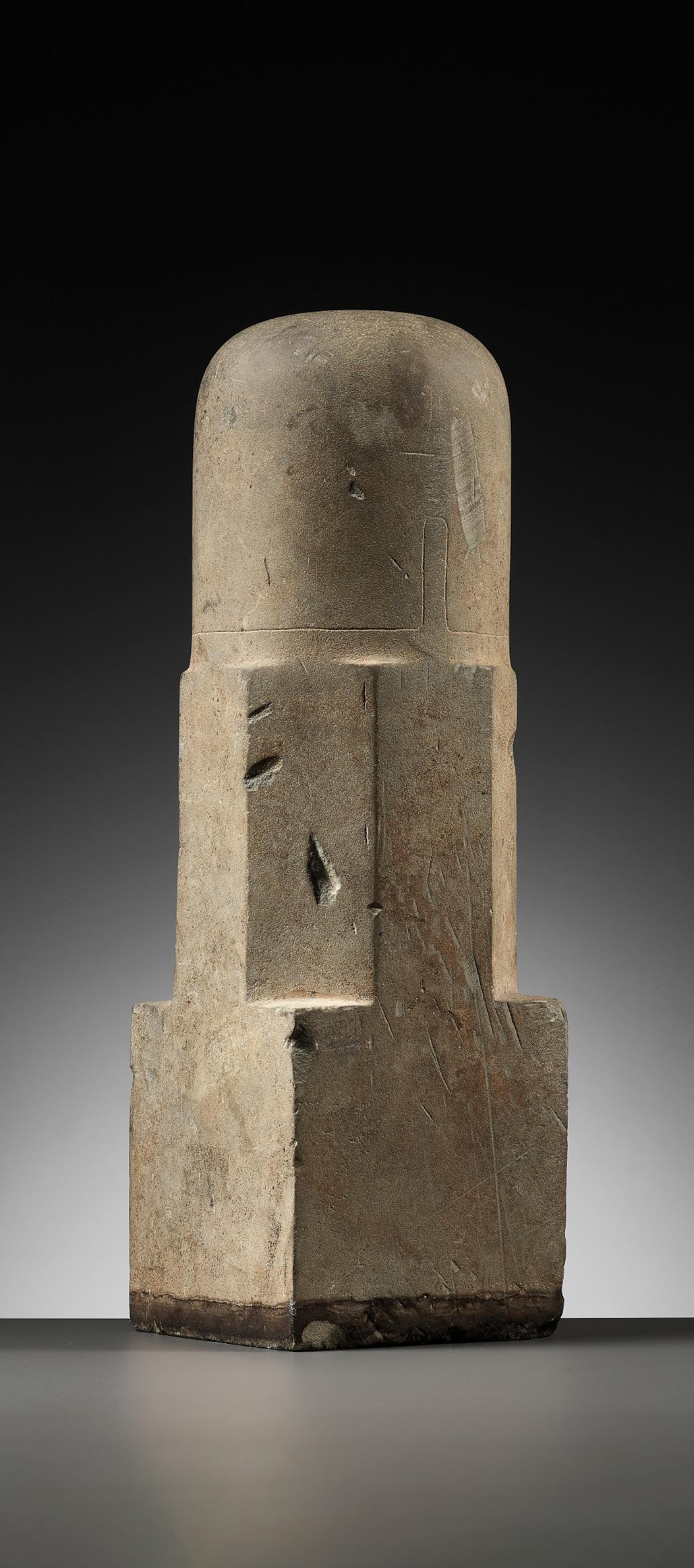
Khmer Empire, 13th century. The surface smoothly polished with square base and octagonal mid-section rising to the finely incised cylindrical top. The sandstone with a fine, smooth, naturally grown patina.

Provenance: Italian trade, by repute acquired from an old private estate in northern Italy. Condition: Excellent condition, commensurate with age. Old wear, signs of weathering and erosion, chips, nicks, scratches.
Weight: 22.7 kg
Dimensions: Height 46.5 cm
Expert’s note: It has become exceedingly rare to find original Khmer lingams made from sandstone, especially ones like the present lot with a top so nicely polished by rainfall over many centuries. Highly recommended.
AUCTION RESULT COMPARISON
Type: Near-identical
Auction: Christie’s New York, 26
September-27
September 2017, lot 216
Price: USD 40,000 or approx. EUR 46,000 converted and adjusted for inflation at the time of writing
Description A sandstone lingam, Khmer, Angkor period, 13th century
Expert remark: Note the near-identical size (45.8 cm).
Estimate EUR 6,000
Starting price EUR 3,000
222
A ROCK CRYSTAL LINGA AND BRONZE YONI, ANGKOR PERIOD


Khmer empire, 12th-13th century. The linga is supported by the square stepped yoni terminating in a tapered spout and covered entirely in a rich, naturally grown patina with distinct malachite encrustation. The finely cut linga is completely transparent with a flat base and a rounded top, the stone of good clarity with few minute natural inclusions. (2)
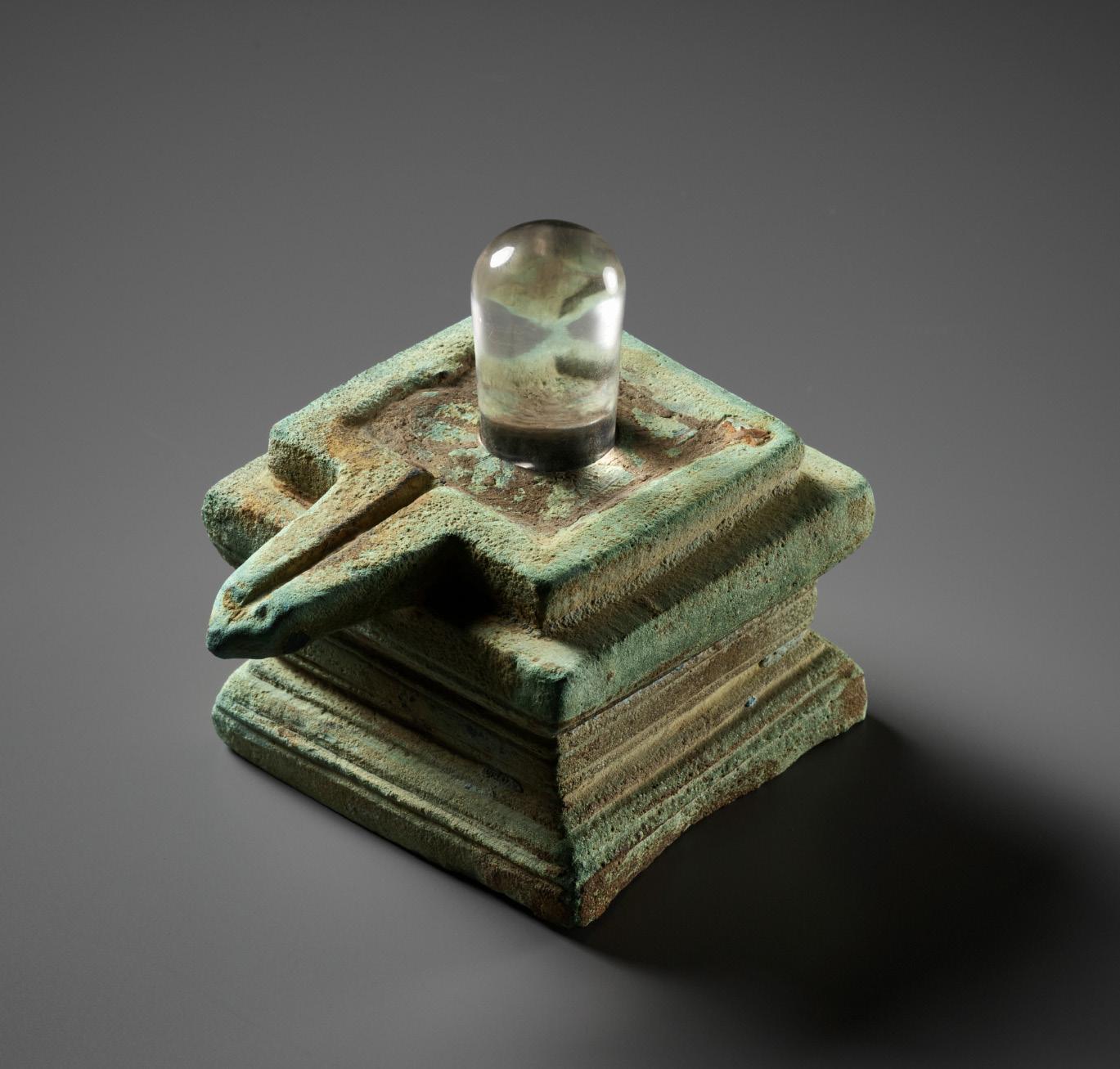
Provenance: French trade.
Condition: Very good condition, commensurate with age. Extensive wear, signs of weathering and erosion, encrustations overall, small losses, casting flaws, minor dents. It cannot be said with certainty that the Linga is original to the Yoni, but the crystal is ancient and fits perfectly well, and so it has a good chance to be.
Weight: 1.001.2
Dimensions: Length 14.6 cm
The lingam and yoni (or snanadroni) are aniconic representations of Shiva and Uma. They are symbolic of the female and male reproductive organs, which within Hinduism bring a balance to the cosmos when joined together. Within Hindu countries, adoration of the lingam was understood to be worship of the great generative principle of the universe, conceptualized as an aspect of Shiva. Some of the Khmer kings identified themselves with Shiva, placing a lingam at the summit of their most important temples as part of their royal paraphernalia.
LITERATURE COMPARISON
Compare a closely related quartz linga and bronze-silver alloy snanadroni, dated to the Angkor period, in the National Museum of Cambodia, accession number Ga.3557 (fig. 1). Compare a related Khmer stone linga with architectural base, 37.5 cm high, dated to the Angkor period, ca. 975, in the Metropolitan Museum of Art, accession number 1988.393.
AUCTION RESULT COMPARISON
Type: Related
Auction: Christie’s New York, 23 March 1999, lot 222
Price: USD 9,200 or approx. EUR 15,500 converted and adjusted for inflation at the time of writing
Description: A quartz linga and gilt bronze yoni, Thailand, 15th century or earlier
Expert remark: Compare the closely related form. Note the gilding, separate cylindrical cover, and size (19.8 cm). Note the Thai attribution.
Estimate EUR 4,000
Starting price EUR 2,000
354 223
fig. 1
224
A LARGE AND HEAVY ‘SNAKE AND LION’ CHLORITE STEMCUP, JIROFT CULTURE, 3RD MILLENNIUM BC
Southeastern Iran, c. 2800-2300 BC. Well and boldly carved, the cup raised on a tall stem with a spreading foot, decorated to the exterior with two wide bands, the upper depicting intertwined snakes fighting lions standing on their hind legs, and the lower with intertwined confronted snakes.

Provenance: French trade, by repute formerly in a French private collection built between ca. 1980 and 2012 and thence by descent.
Condition: Good condition, commensurate with age, with ancient wear overall. Signs of weathering and erosions, encrustations, and small chips, all as expected for a vessel over five thousand years old.
Weight: 1,675 g
Dimensions: Height 20.8 cm
This large and finely carved ceremonial vessel belongs to a class of chlorite artefacts from southeastern Iran described as Jiroft from the name of the area where they were produced in antiquity. The motif of the lion fighting a snake is a recurrent one on these types of vessels and appears several times amongst the famous corpus of unexcavated artifacts published by Madjidzadeh (see Jiroft, The Earliest Civilization, Teheran, 2003, pp. 76-94).
In the region of Jiroft, a large number of chlorite vessels and objects, carrying human and animal motifs, have been discovered. This discovery is of particular importance since little is known about the region’s history, and its proximity to the Cradle of Civilization makes it of vital importance to understanding the environment in which the first written historical records emerged. In the first half of the 3rd millennium BC, the Iranian plateau was at the crossroads of trade with its neighboring regions. It is located 1000 km from the valley of the Euphrates in the west and from the Indus River in the east. The exceptional development of the Jiroft culture can be accounted for by the distinctive environment of the region, which is in a deep depression, very different from the broad basins created on the plateau by the disappearance of large salt lakes.
LITERATURE COMPARISON
Compare closely related chlorite vessels in the Archaeology Museum of Jiroft, Iran, some of which were included in the exhibition “Iran, Frühe Kulturen zwischen Wasser und Wüste, Kunst- und Ausstellungshalle der Bundesrepublik Deutschland, Bonn, 13 April-20 August 2017”.

AUCTION RESULT COMPARISON
Type: Related
Auction: Galerie Zacke, Vienna, 6 March 2021, lot 692
Price: EUR 16,432 or approx. EUR 19,415 adjusted for inflation at the time of writing
Description: A large Western Asiatic chlorite bowl, 3rd millennium BC
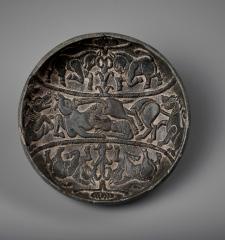
Expert remark: Compare the related material, manner of carving, lack of recesses for inlays, and subject of fighting animals. Note the different form and the size (29.5 cm).
Estimate EUR 4,000
Starting price EUR 2,000
355
225
A MONUMENTAL SCHIST FIGURE OF THE GODDESS HARITI, ANCIENT REGION OF GANDHARA

Kushan empire, 2nd-3rd century AD. Wearing a long kaftan, trousers, and a heavily pleated shawl, Hariti’s jewelry is comprised of anklets, rows of bracelets, earrings hanging from her elongated lobes, and necklaces with a large central torque decorated with rosettes. She wears a circular crown topped with a square structure carved with lotus-petal panels in relief above a foliate fillet on top of her finely incised waving hair, and in her two arms she holds four plump nude children, two beneath each breast with one breast covered and the other exposed.
Provenance: Sotheby’s London, 17 October, 1996, sale LN6645, lot 111. Kenneth P. Jackson, United Kingdom, acquired from at the above sale for a hammer price of GBP 50,000, equivalent to a purchase price of GBP 56,500 or EUR 163,000 (converted and adjusted for inflation at the time of writing).
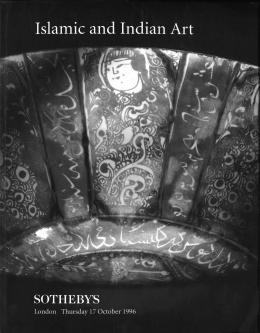
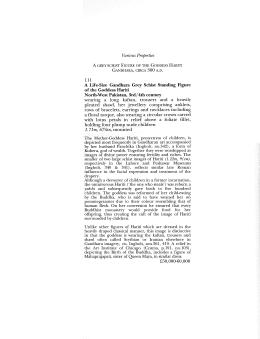
Condition: Condition commensurate with age and presenting remarkably well overall. Expected old wear, weathering and erosion as a result of extensive exposure to the elements across a time period of almost two millennia. Obvious losses, structural cracks, some of which show old fills, remnants of soil encrustations from burial.

Weight: >250 kg
Dimensions: Height 171 cm (excl. base) and 186 cm (incl. base)
With a modern metal base. (2)
356
Sotheby’s London, 17 October, 1996, sale LN6645, lot 111. Kenneth P. Jackson, United Kingdom, acquired from at the above sale for a hammer price of GBP 50,000, equivalent to a purchase price of GBP 56,500 or EUR 163,000 (converted and adjusted for inflation at the time of writing).

This figure of Hariti, the Buddhist mother goddess, illustrates the unique amalgamation of cross-cultural influences present in ancient Gandhara. It also bears a distinct and early Hellenistic element almost never found in other sculptures from this period and region.

Other figures of Hariti from the High Gandhara period are dressed in heavy robes in the classical manner, like the statue of the seated Hariti in the British Museum, registration number 1886,0611.1 (fig. 1). However, the present lot depicts Hariti in a kaftan, trousers, and a shawl, a concise style of clothing that exemplifies the Scythian influence on the Gandhara people during their rule of the neighboring region of eastern Iran in the 2nd and 3rd centuries AD. The Scythian style of clothing is known in detail from depictions along the palace walls of Apadana (fig. 2) from the Achaemenid period as well as from terracotta figures from the 2nd century AD.

Tyche’s mural crown (fig. 4) identifies her as the protectorate of cities and links the founding of Sparta to the goddess’s headdress according to S.B. Matheson (see The Goddess Tyche, Yale University Art Gallery Bulletin, 1994). Her iconography changed very little over the centuries during early Roman rule and even later depictions of the goddess in Constantinople’s Hippodrome (fig. 5). The crown of the present Hariti with its two rows resembling lotus petals, is carved upright and straight, much like the walls of Tyche’s fortress headdress. While much of it is worn away, Hariti’s crown is topped by square carvings that closely resemble the crenelated battlement of Tyche’s headdress.
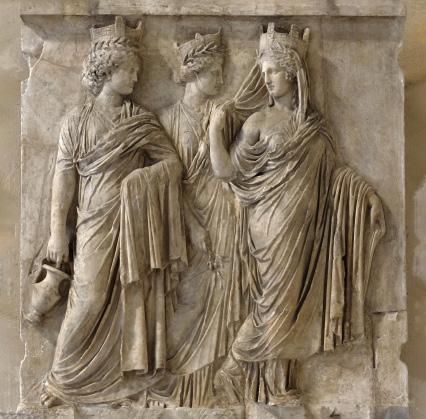
Historians have documented various examples of syncretism between Hellenistic cultures in the Far-East and Buddhism from the 5th century BC to the 4th century AD. This sculpture of Hariti, however, offers an even more unique example of not only cultural syncretism, but also religious syncretism as well. The story of Hariti itself involves the conversion of the goddess to Buddhism. One version of Hariti’s story follows that Hariti had no children. Desperate to have children of her own, the goddess stole children from the locals and raised them as her own. The Buddha, aware of the suffering mothers of the lost children, took back one of the children from Hariti in secret. Amid her grief over the lost child, the Buddha came to her and taught the goddess empathy, showing her the sorrow of mothers from whom she took the children. Hariti subsequently converts to Buddhism, but her foreign origin and nature remains documented by the syncretism seen in the present sculpture.
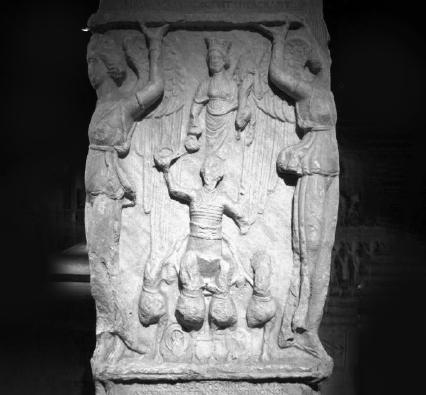
LITERATURE COMPARISON
Even more remarkable is the flagrant early Hellenistic influence clearly visible in Hariti’s headdress. The unusual yet characteristic iconography of it links Hariti directly to the Greek goddess Tyche, daughter of Zeus, and suggests she was a rare example of religious syncretism as a direct result of the Hellenistic period in the far east. The headdress of the present Hariti exemplifies this fact unlike most other depictions of the goddess.
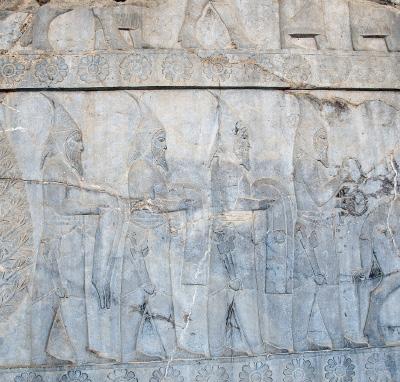
Tyche, the goddess of fate, became a prominent figure in the Greek pantheon under Alexander the Great. It was during Alexander’s rule that Tyche came to embody the whims of fate. Her importance within the Greek pantheon is clear and can be seen in sculptures like the colossal head of Tyche next to Zeus and Apollo in Nemrut Dagi (fig. 3).
Compare a related Gandharan relief of the goddess Hariti seated and holding a child, 61 cm high, dated 101-300 AD, in the Art Institute of Chicago, reference number 2016.58. Compare a related figure of Hariti with children, 132 cm high, dated to the 2nd century AD, in the Government Museum and Art Gallery, Chandigarh, accession number 1625. Compare a related large schist figure of Hariti with children from the Swat Valley in Gandhara, 125 cm high, dated 2nd-4th century, published by M Akira in Gandharan Art and Bamiyan Site, Tokyo, 2006, pp.114, nr. 86 (fig. 1). fig. 1

AUCTION RESULT COMPARISON
Type: Related
Auction: Bonhams London, 22 October 2019, lot 144
Price: GBP 187,562 or approx. EUR 282,000 converted and adjusted for inflation at the time of writing
Description: A schist figure of Hariti, circa 2nd century Expert remark: Note the similar rosettes which appear on the face and headdress of this figure of Hariti and appear on the torque of the present lot. Note the size (95 cm).
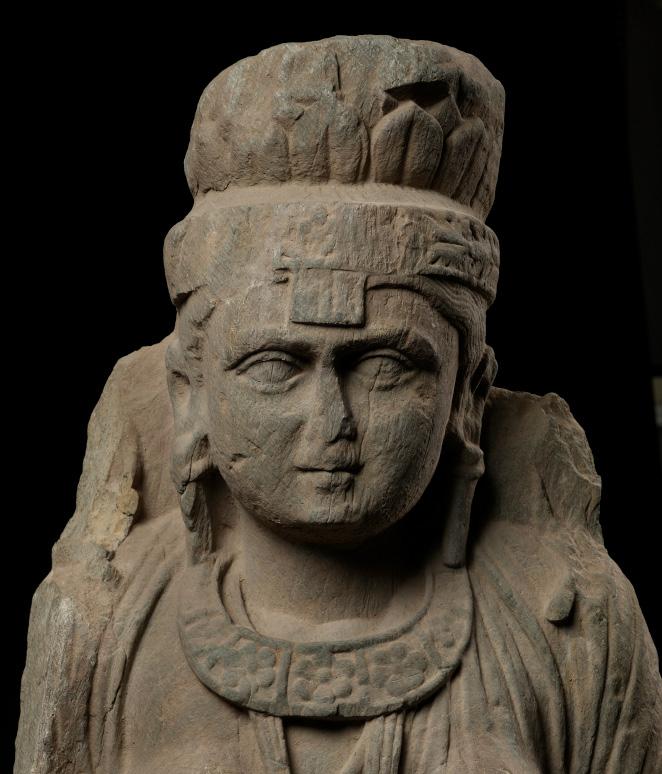

Estimate EUR 60,000
Starting price EUR 30,000
358
fig. 1
fig. 2
fig. 3
fig. 4
fig. 5
226
A LARGE SCHIST FRIEZE DEPICTING A BANQUET, ANCIENT REGION OF GANDHARA, KUSHAN PERIOD
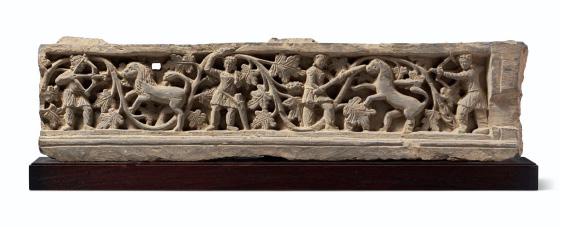
2nd-4th century. Finely carved, the frieze depicts a banquet scene above a decorative lotus band along the base. Robed men and women stand side by side, some with their arms thrown over the other in a bacchanalian manner, holding drinking vessels and large branches.
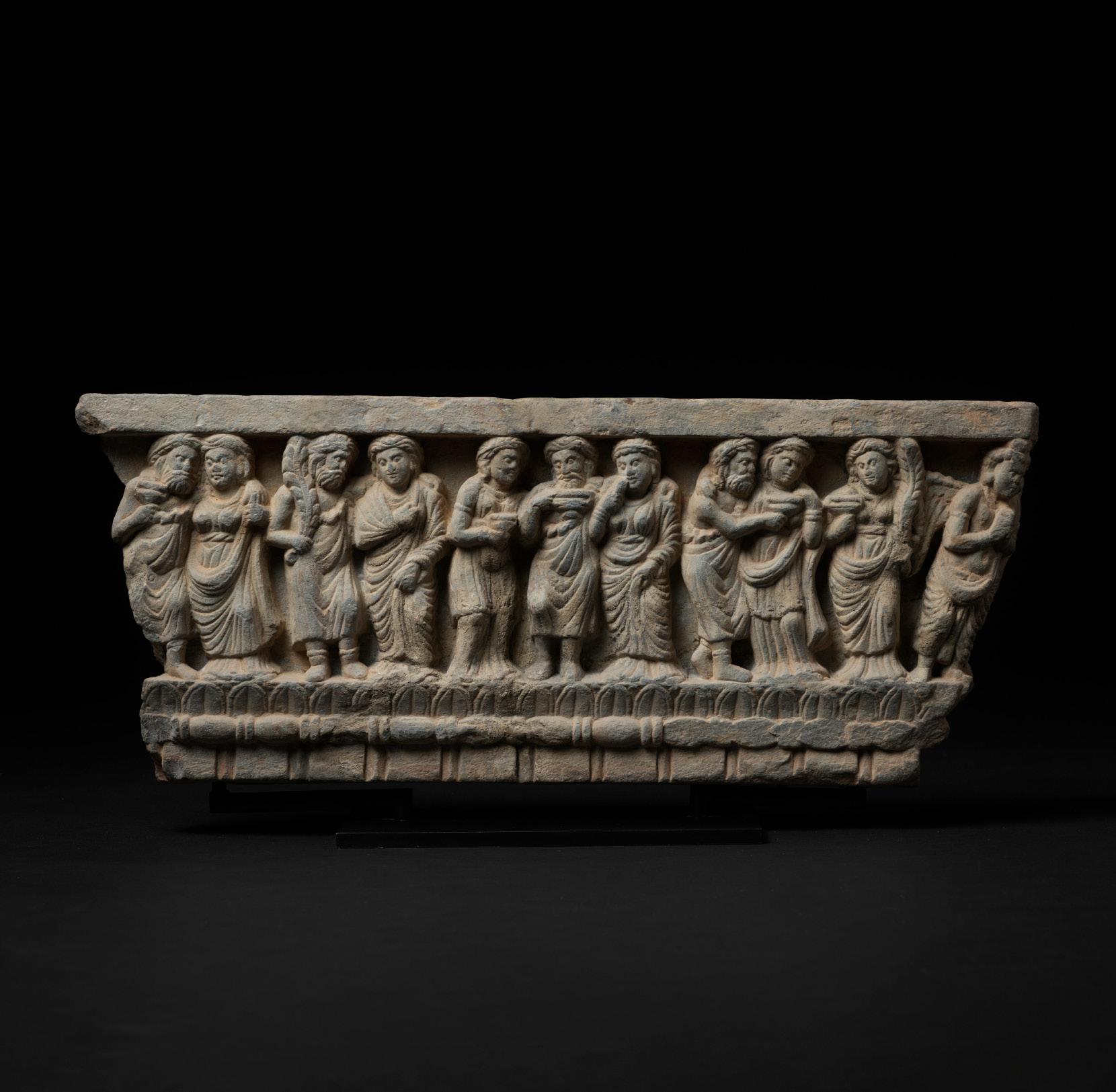
Provenance: Collection of David Lindahl, Kyoto, Japan, 1996. A private collection in Monaco, acquired from the above in London. A copy of a signed statement, dated 28 September 2018 and confirming the provenance above, accompanies this lot.
Condition: Very good condition, commensurate with age. Extensive wear, losses, signs of weathering and erosion, minor structural cracks, some with old fills. Chips, nicks, scratches, encrustations.
Weight: 23 kg
Dimensions: Width 66.5 cm
Mounted on a metal stand. (2)
AUCTION RESULT COMPARISON
Type: Related
Auction: Christie’s New York, 23 September 2020, lot 601
Price: USD 30,000 or approx. EUR 32,000 converted and adjusted for inflation at the time of writing
Description: A gray schist relief with scenes of the hung, ancient region of Gandhara, 3rd-4th century
Expert remark: Compare the related manner of carving. Note the size (74 cm).
Estimate EUR 8,000
Starting price EUR 4,000
359
A GRAY SCHIST FRIEZE DEPICTING BUDDHA’S FIRST SERMON AND DEATH (PARINIRVANA), ANCIENT REGION OF GANDHARA, KUSHAN PERIOD
2nd-4th century. Finely carved, the lower register depicts two scenes from the Buddha’s life separated by tall framed pillars. On the right, Buddha is depicted giving his first sermon beneath a canopy, seated in dhyanasana on a pedestal engraved with the dharmachakra, surrounded by disciples. The second frame on the left depicts the death of Buddha, who lies on a raised bed, surrounded by mourners, with the lone figure of Subhadra sitting on the floor in front of the bed with his back turned to the viewer.
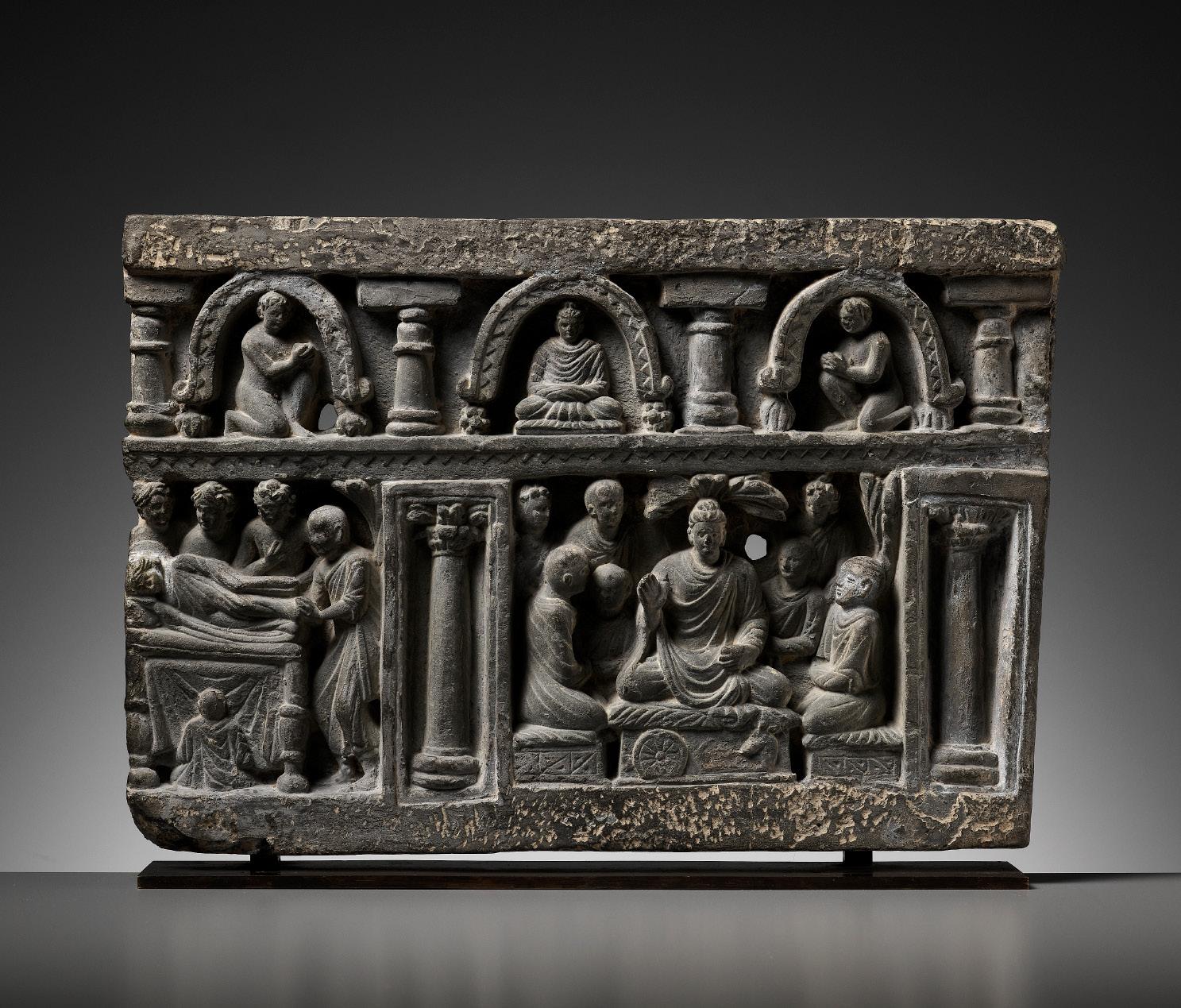

Provenance: From a French private collection.
Condition: Very good condition, commensurate with age. Extensive wear, losses, signs of weathering and erosion, chips, scratches, encrustations. The frieze is pierced with two holes for mounting.
Weight: 11.2 kg (incl. stand)
Dimensions: Width 39.7 cm
Mounted on a metal stand. (2)
The upper register depicts Buddha seated in dhyanasana with his hands lowered in dhyana mudra, within an arched niche flanked by two kneeling disciples within similar niches, a pillar between each figure.
Narrative panels were often affixed to the drums of large and small stupas and could thus be read like a storyboard sequentially in the ritual process of circumambulation. Reliefs were also placed in false gables on the front and the mid-section of a stupa. For a structural illustration, see Behrendt, The Art of Gandhara in the Metropolitan Museum of Art, New York, 2007, fig. 15, page 33.
According to the Buddhist chronicles, when Buddha died near the city of Kushinagara, in northern India, he broke free from the cycle of rebirths and attained nirvana, absolute release from karmic rebirth. This panel shows the Buddha surrounded by lay and monastic mourners expressing their grief. These reactions are contrasted with the calm of the monk Subhadra, seated facing Buddha’s corpse, who alone comprehends the true meaning of the Buddha’s death. Images of Buddha’s parinirvana based on this Gandharan prototype became important icons for veneration across the Buddhist world in the following centuries.
Literature comparison: Compare a related schist frieze depicting the death of the Buddha, 41.1 cm wide, dated ca. 3rd century, in the Metropolitan Museum of Art, accession number 2015.500.4.1. Compare a related frieze of the Buddha giving his first sermon with a similarly styled dharma wheel, 31.1 cm wide, dated ca. 2nd century, in the Metropolitan Museum of Art, accession number 1980.527.4.
AUCTION RESULT COMPARISON
Type: Related
Auction: Christie’s New York, 21 March 2008, lot 533
Price: USD 46,600 or approx. EUR 60,500 converted and adjusted for inflation at the time of writing
Description: A large gray schist relief of the Renunciation, Gandhara, 2nd/3rd century
Expert remark: Compare the related manner of carving with similar pillars and archways. Note the size (46.3 cm).
Estimate EUR 8,000
Starting price EUR 4,000
360 227
A GRAY SCHIST FRIEZE DEPICTING BUDDHA’S PARINIRVANA, ANCIENT REGION OF GANDHARA, KUSHAN PERIOD
2nd-4th century. Finely carved with the dying Buddha lying on his right side on a raised bed, resting his head on a round cushion, surrounded by his mourning disciples. Behind him, three mourners raise their hands above their heads in lament with distraught facial expressions. Haloed mourners standing on each side rest their hands on the bed, flanked by tall columns. Below the bed sit three mourners, two facing out while the third, the monk Subhadra, is reassured in his knowledge of Buddha’s achievement of nirvana.

Provenance: From a private collection in Germany.
Condition: Good condition, commensurate with age. Old wear, signs of weathering and erosion, losses, nicks, scratches, soil encrustations.
Weight: 15.1 kg
Dimensions: Length 48.2 cm
Mounted on a metal stand. (2)
According to the Buddhist chronicles, when Buddha died near the city of Kushinagara, in northern India, he broke free from the cycle of rebirths and attained nirvana, absolute release from karmic rebirth. This panel shows the Buddha surrounded by lay and monastic mourners expressing their grief. These reactions are contrasted with the calm of the monk Subhadra, seated facing Buddha’s corpse raising his hands, who alone comprehends the true meaning of the Buddha’s death. Images of Buddha’s Parinirvana from Gandhara became important icons for veneration across the Buddhist world in the following centuries.
Literature comparison: Compare a related schist frieze depicting the death of the Buddha (Parinirvana), 41.1 cm wide, dated 2nd-3rd century BC, in the Metropolitan Museum of Art, accession number 67.43.13.

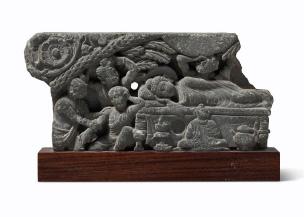
AUCTION RESULT COMPARISON
Type: Related
Auction: Christie’s New York, 23 September 2020, lot 627
Price: USD 35,000 or approx. EUR
37,500 converted and adjusted for inflation at the time of writing
Description: A green schist relief depicting the Parinirvana, ancient region of Gandhara, probably Swat Valley, 2nd-4th century. Expert remark: Compare the related stone, subject, and manner of carving. Note the smaller size (34 cm).
AUCTION RESULT COMPARISON
Type: Closely related
Auction: Christie’s New York, 22 March 2011, lot 239
Price: USD 40,000 or approx. EUR
50,500 converted and adjusted for inflation at the time of writing
Description: A gray schist stupa base with scenes from Buddha’s life, Gandhara, 2nd/3rd century Expert remark: Compare the related stone, subject, and manner of carving. Note the size (34.3 cm) and that this is a stupa base carved with further scenes from Buddha’s life.
Estimate EUR 10,000
Starting price EUR 5,000
228
A MONUMENTAL GRAY SCHIST FIGURE OF MAITREYA, KUSHAN PERIOD, ANCIENT REGION OF GANDHARA, 2ND - 4TH CENTURY
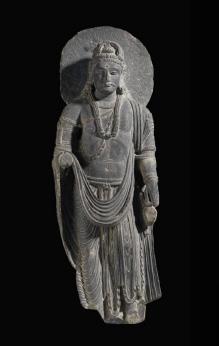
Standing on a rectangular pedestal with two large floral medallions separated by three Hellenistic columns to the front and a sheaf of wheat to one side. He is wearing a diaphanous dhoti with finely carved folds, tied at the waist with a rope belt, billowing scarves and a pair of sandals. He holds the iconic kamandalu, here in the form of a water flask, mostly hidden in his remaining hand and suspended on a thick rope. His serene face shows heavy-lidded almond-shaped eyes below gently arched brows, centered by a raised circular urna, all above a broad nose and full bow-shaped lips. His hair is neatly arranged in wavy locks and secured by a beaded headband. The head is backed by the remnants of a once circular nimbus.
Provenance: From a noted private collection in the United Kingdom and thence by descent.
Condition: Good condition, commensurate with age, showing ancient wear, soil encrustation, extensive signs of weathering and erosion with corresponding losses. There are a few minor structural cracks, some of which may have old fills. There is also a single perforation below the left shoulder. The left hand and most of the halo are lost. Generally, this is all as expected for a schist sculpture nearly two thousand years old.
Weight: 167.3 kg (incl. stand)
Dimensions: Height 165.5 cm (incl. stand) and 140 cm (excl. stand)
Mounted on a fitted stand. (2)
Maitreya is considered the Buddha of the future. When the dharma is forgotten on Earth, he will descend from the Tushita Heaven, where he resides, to be born in our realm as the next Buddha. His iconic water vessel, the kamandalu, is found in many different contexts within Indian sculpture, but is almost always a symbol of fertility and life. It is an apt visual icon, therefore, for Maitreya’s role as a progenitor of future peace and order. When he is born on Earth, Maitreya is depicted in rich robes similar to that of the historical Gautama Buddha, prior to his renunciation of worldly goods.
His vestments in the present portrayal include a foliate collar, the main medallion closely resembling the two found on the pedestal, a rope-work necklace with (remnants of) makara-head pendant, and a cord with an amulet box (mostly lost) of a type still in use in South Asia.
In the Gandharan period, Maitreya was considered as the most important Bodhisattva.

LITERATURE COMPARISON
Compare a closely related figure of Maitreya with similar robes and floral medallions along the base, 80.7 cm high, dated c. 3rd century, in the Metropolitan Museum of Art, accession number 13.96.17 (fig. 1). Compare also a closely related schist figure of a standing Maitreya, with similar robes and floral medallions along the base, dated 2nd-4th century, in the Victoria and Albert Museum, registration number IM.11-1910.
AUCTION RESULT COMPARISON
Type: Related
Auction: Christie’s New York, 21 March 2008, lot 518
Price: USD 217,000 or approx. EUR 285,000 converted and adjusted for inflation at the time of writing
Description: An important gray schist figure of Maitreya, Gandhara, 2nd/3rd century

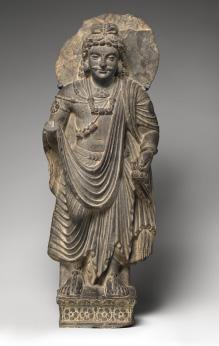
Expert remark: Compare the related subject and carving with similar dhoti, scarves across the figure’s bare chest, and necklaces. Note the size (137 cm).
AUCTION RESULT COMPARISON
Type: Related
Auction: Bonhams Hong Kong, 7 October 2019, lot 913
Price: HKD 1,100,625 or approx. EUR 138,000 converted and adjusted for inflation at the time of writing
Description: A schist torso of a Bodhisattva, ancient region of Gandhara, 3rd/4th century Expert remark: Compare the related manner of carving and modeling with similar dhoti, scarves across the figure’s bare chest, and necklaces. Note the size (80 cm).
Estimate EUR 50,000
Starting price EUR 24,000
362 229
See a closely related Maitreya sculpture, which was part of a group of excavated Gandhara figures shipped to the United Kingdom at the beginning of the last century.
fig. 1

A LARGE GRAY SCHIST FIGURE OF MAITREYA, KUSHAN PERIOD, ANCIENT REGION OF GANDHARA, CIRCA 3RD CENTURY
Superbly carved, seated in dhyanasana with his hands held in dharmachakra mudra, dressed in a voluminous sanghati with exquisitely carved folds, elegantly pooling in concentric rings at his ankles and spilling over the edge of the base, bedecked with various necklaces including a large choker with inset design and talismanic armlets. His serene face with heavy-lidded almond-shaped eyes below gently arched brows centered by a raised urna, secured by an elaborate headdress comprising a network of beads interlinked between horizontal bands that rest above the forehead and wrap around the ushnisha.
Provenance: From an old Belgian private collection. Acquired before 1970 and thence by descent in the family. Condition: Good condition, commensurate with age. Extensive wear, obvious losses, nicks, scratches, signs of weathering and erosion. A few structural cracks with associated losses, some of which show old restoration.
Weight: 148 kg
Dimensions: Height 109.5 cm (incl. stand) and 105.5 cm (excl. stand)
Maitreya is backed by a halo and his throne is carved with a frieze depicting two devotees on either side of a fire altar flanked by zoomorphic columns.
With consummate skill, the sculptor has achieved a majestic enthroned Maitreya. The marvelous naturalism conveyed throughout the torso and robe, as the latter slackens and contorts around the powerful figure, is a testament to the virtuoso who carved it. With a broad muscular torso, strong hands, and ornate stylized folds, this large sculpture exhibits the power and authority of Maitreya, believed to reside in Tushita heaven until the time comes when Shakyamuni is no longer remembered and the future Buddha will need to be reborn.
As Mahayana Buddhism spread from Gandhara to China, images of Maitreya became the focal point of a widespread cult, the idea of a messianic savior appealing to many living under the chaotic political climate and civil unrest of the Six Dynasties period that followed the collapse of the Western Han Dynasty in the beginning of the 3rd century - the time around which this sculpture was made. The link between the art of Gandhara and early Buddha images in China is demonstrated through a direct comparison of the facial features and robes between the present lot and a gilt bronze Buddha held in the Harvard Art Museums, object number 1943.53.80.A, which is among the earliest devotional Buddhist images made in China.

Literature comparison: Compare a related gray schist figure of Maitreya, dated to the 2nd century, in the Victoria & Albert Museum, accession number IM.303-1920. Compare a related schist figure of Maitreya, 32 cm high, dated 2nd-4th century, in the Victoria & Albert Museum, accession number IM.4-1911. Compare two sculptures of youthful bodhisattvas also displaying the teaching mudra, see I. Kurita, Gandharan Art, vol. II, Tokyo & New York, Tokyo, 2003, pp. 53 & 57, nos. 128 and 141.
AUCTION RESULT COMPARISON
Type: Related
Auction: Christie’s New York, 21 March 2012, lot 724
Price: USD 146,500 or approx. EUR 177,000 converted and adjusted for inflation at the time of writing
Description: A gray schist figure of Maitreya, Gandhara, 2nd/3rd century
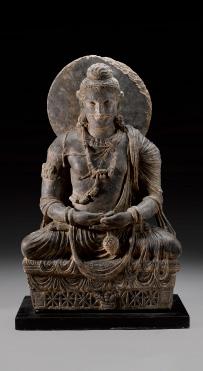
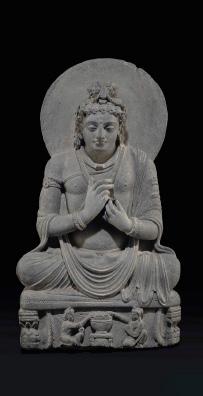
Expert remark: Compare the closely related subject, manner of carving, and modeling with similar pose and hand gesture, robes and jewelry, expression and hairstyle, nimbus, and throne with a similarly carved frieze also depicting devotees around a fire altar. Note the size (74.3 cm).
AUCTION RESULT COMPARISON
Type: Related
Auction: Bonhams New York, 18 September 2013, lot 60
Price: USD 80,500 or approx. EUR 96,000 converted and adjusted for inflation at the time of writing
Description: A schist figure of Maitreya, ancient region of Gandhara, circa 3rd century
Expert remark: Compare the closely related subject, manner of carving, and modeling with similar pose, hairstyle, robes, jewelry, and nimbus. Note the different hand gesture and the mustache, as well as the related size (106.6 cm).
Estimate EUR 60,000
Starting price EUR 30,000
364
230
A Chinese gilt bronze Buddha exemplifying the Gandharan influence on early Chinese Buddhist art, 32 cm high, dated 3rd-4th century, in the Harvard Art Museums, object number 1943.53.80.A

231
A LARGE GRAY SCHIST RELIEF DEPICTING BUDDHA, A ROYAL DONOR AND SEVERAL ATTENDANTS, ANCIENT REGION OF GANDHARA, 2ND-3RD CENTURY
Superbly carved, standing in slight contrapposto and surrounded by royal donors and attendants, each with hands clasped in front of their chest with their gaze directed at his outstretched right arm holding an alms bowl. The Buddha is dressed in voluminous robes which fall gracefully in well detailed folds. The hems of his alluring robes are gathered in a soft roll clutched by his left hand to keep the garment taut and in place. The serene face with heavy-lidded downcast eyes below gently arched brows centered by a circular raised urna, above full bow-shaped lips forming a subtle smile, flanked by long pendulous earlobes. His hair is arranged in wavy locks over the domed ushnisha.
Provenance: From an old Belgian private collection. Acquired before 1970 and thence by descent in the family.
Condition: Good condition, commensurate with age. Extensive wear, obvious losses, nicks, scratches, small old repairs, signs of weathering and erosion, few structural cracks.
Weight: 103.3 kg (incl. stand)
Dimensions: Height 94.3 cm (incl. stand), 88.8 cm (excl. stand), Width 57.1 cm
Note the hierarchical proportions used by the sculpture, with Buddha double the size of the donor and the attendant figures.
The ancient region of Gandhara was once an important center for trade and religious activities. Carved stone monuments and iconic statuary were created for Buddhist patrons while drawing on Greco-Roman sculptural traditions. The present work is one such example, incorporating the emphasis on naturalism, seen in the treatment of the Buddha’s heavy, monastic robe wrapping around his neck in thick layers and forming U-shaped folds on his legs with a convincing sense of gravity.
This panel alludes to a delightful moment in the life of Buddha, which is retold by Harald Ingholt: “It was routine for the Buddha at a certain time of the day to wander around in quest of food. Once when he was doing this in Rajagriha, with his begging bowl held out before him, he met two small boys playing in the road. One of these moved as if to make an offering, but having nothing else at hand, he took a good fistful of dust and dropped it into the bowl saying that it was barely flour. The Buddha was much impressed by this childish act of piety and prophesied that the boy would become a mighty Buddhist monarch in some future life.” (Gandharan Art in Pakistan, New York, 1959, pp. 80-81). This story was later interpreted to identify the child as the great Buddhist emperor Ashoka (304-232 BC) in a previous life. While the figure of the child, the object of the Buddha and his entourage’s gaze, is now lost, the alms bowl remains partially preserved. Other depictions of this scene are found in ibid., nos. 110-111, and Kurita, Gandharan Art, Volume 1, Tokyo, 1988, pp. 178-181, nos. 351-358, and Sun and He, A History of Gandhara Civilization, Beijing, 2009, pp. 389, nos. 7, 128, 30.
AUCTION RESULT COMPARISON
Type: Closely related
Auction: Christie’s New York, 13 March 2013, lot 209
Price: USD 183,750 or approx. EUR 224,000 converted and adjusted for inflation at the time of writing
Description: A rare green schist relief of Buddha and a royal donor, 2nd/3rd century

Expert remark: Compare the closely related manner of carving, with Buddha standing in similar pose and holding the hem of his garment beside a smaller donor figure. Note the size (106.8 cm).
Estimate EUR 40,000
Starting price EUR 20,000
366

Scientific Analysis Report: A thermoluminescence sample analysis has been conducted by Arcadia, Tecnologie Per I Beni Culturali, Milan, dated 2 October 2015, reference no. 347E. The test confirms the sculpture is “in good agreement with the presumed age, and therefore confirms the authenticity of the samples.” A copy of the thermoluminescence analysis report accompanies this lot.

Gracefully modeled, seated with arms slightly outstretched, the head gently lowered and turned to the side with a downcast gaze, the eyes with delicately carved pupils and lids, below elegantly arched brows, above bow-shaped lips. His slender yet muscular body is adorned with beaded jewelry, his head with an elaborate foliate crown, finely beaded.
Provenance: Leonardo Vigorelli, Bergamo, Italy.
Mr. Vigorelli is a retired Italian art dealer and noted collector, specializing in African and ancient HinduBuddhist art. After studying anthropology and decades of travel as well as extensive field research in India, the Himalayan region, Southeast Asia, and Africa, he founded the Dalton Somaré art gallery in Milan, Italy, which today is run by his two sons. Condition: Good condition, commensurate with age. Ancient wear from within the culture, weathering and erosion, expected firing flaws, remnants of old pigment, obvious losses, cracks, and chips, overall fully consistent with the age of the sculpture. A copy of a conservational report, edited by Nicola Restauri SRL, Torino, Italy, titled “Report of Interventions Performed” (title translated from Italian) is accompanying the present lot. This report is an integrated component of this condition report.

Italian Export License: Attestato di libera circolazione, N. 16820, dated 16 February 2016 has been granted by the Ufficio Esportazione di Milano and a copy accompanies this lot.
Dimensions: Height 98.5 cm
Hund, known in antiquity as Udabhandapura, was a small village in the Swabi district, situated on the right bank of the Indus River in the Khyber Pakhtunkhwa province of Pakistan. It was the Turk Shahi dynasty’s capital of Gandhara, and possibly functioned as a winter capital alternating with the summer capital of Kabul within the kingdom of Kapisa-Gandhara in the 7th-9th century. Old relics and remains of ancient civilizations have been found in the village after excavation work was undertaken by the government in the recent past. The history and past glory of the Hund has been preserved by the local government which constructed a museum and a replica of the tower of Olympia. The tower watches over the mighty Indus river, commemorating Alexander the Great’s crossing of the Indus while staying in Hund during his final military campaign for the Indian subcontinent.
LITERATURE COMPARISON
Compare a related statue of a female Devata from Hund, dated 6th-7th century, in the Museum of Oriental Art in Turin. Compare a related male statue from Hund, dated 6th-7th century, in the Museum of Oriental Art in Turin (fig. 1). For another related example, see Michael Henss, “The Mystery of the Hund Statues: An Unknown Chapter of Central Asia Statuary”, Arts of Asia, vol. 46, issue 1, (January-February 2016), p. 28.
AUCTION RESULT COMPARISON
Type: Related
Auction: Christie’s Paris, 12 June 2012, lot 304
Price: EUR 23,750 or approx. EUR 28,500 adjusted for inflation at the time of writing
Description: A terracotta bust of a celestial female attendant, Pakistan, Hund Region, circa 8th century
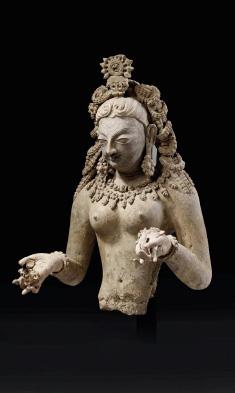
Expert remark: Compare the closely related modeling with similar slender figure, elaborate beaded jewelry, and fine facial features. Note the much smaller size (63 cm) and the lacking legs, which have been preserved on the present lot.

Estimate EUR 30,000
Starting price EUR 15,000
fig. 1
368 232
A LARGE AND HIGHLY IMPORTANT POTTERY FIGURE OF A MALE DEITY, ANCIENT REGION OF HUND, PAKISTAN, 7TH-8TH CENTURY
Leonardo Vigorelli
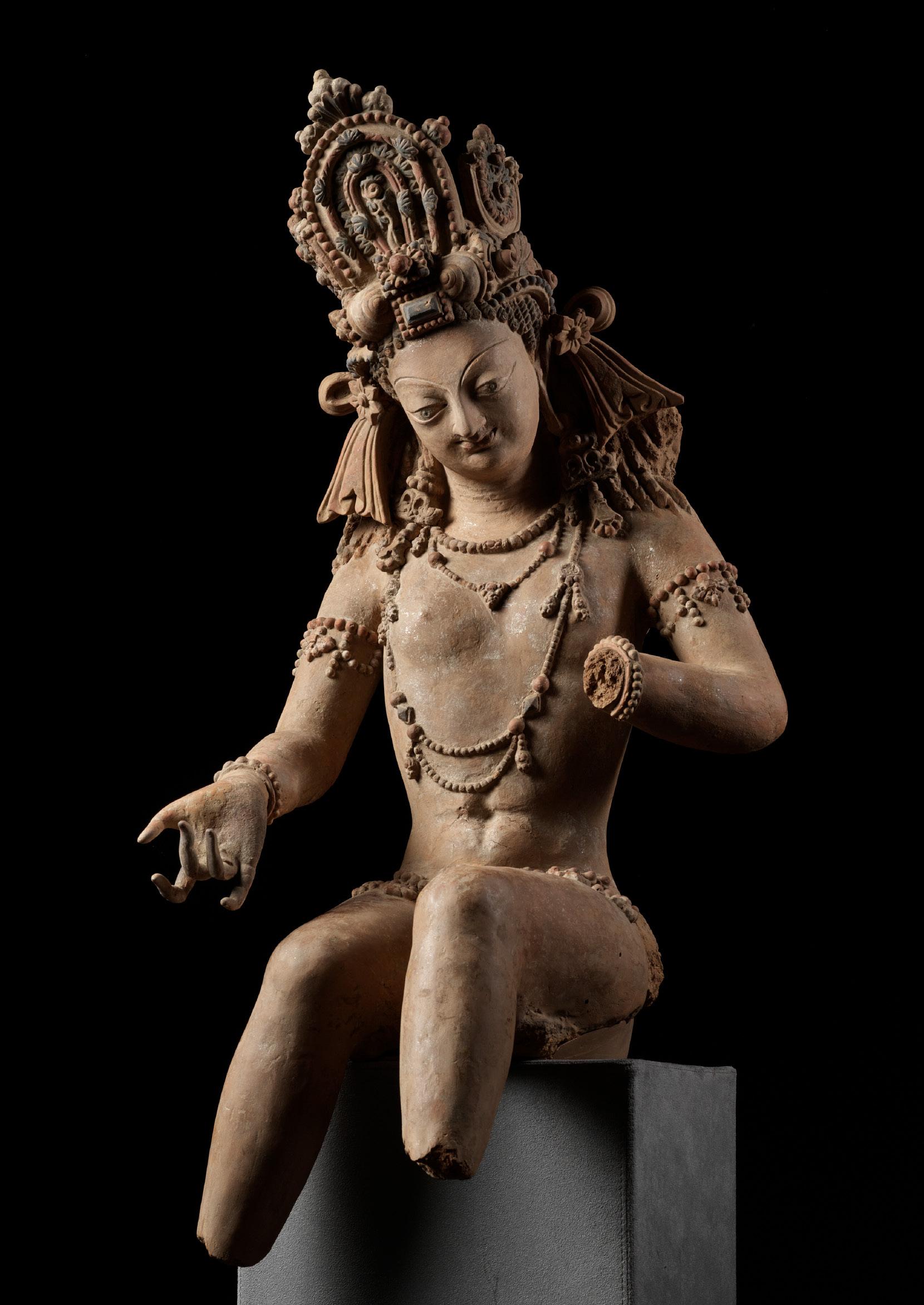

233
Scientific Analysis Report: A thermoluminescence analysis report issued by Oxford Authentication on 1 September 2020, based on sample number N120d91, confirms the object is “consistent with the suggested period of manufacture.” A copy of the report, issued by Oxford Authentication, accompanies this lot.
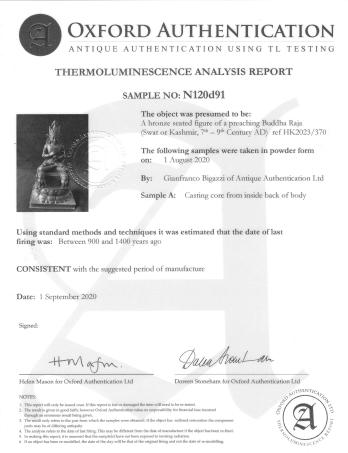
Depicted in the sambhogakaya form, Vairocana holds his hands in the bodhyagrimudra while sitting atop a pedestal supported by two anthropomorphic Buddhist lions. The lions have humanized faces, silver-inlaid eyes, snail-curled hair, and are standing atop a lotus base. The Vairocana wears an ornate crown, tied on both sides with ribbons which drape down around his arms and hang from the pedestal. His face is serene, set with almond-shaped eyes with silver inlays to the pupils and central urna. The back with a tang for attachment to a temple structure.
Provenance: From the private collection of Michael Phillips. Michael Phillips (born 1943) is an Academy Award-winning film producer. Born in Brooklyn, New York, his parents were Lawrence and Shirley Phillips, noted New York dealers in Asian fine art, selling to the Met, the LACMA, the Chicago Art Institute, and the British Museum among others.
Michael Phillips is a collector of Asian art himself, particularly Indian, Southeast Asian, and Himalayan sculpture. His most important films include The Sting (winning the Academy Award for Best Picture in 1973), Taxi Driver (winning the Palme d’Or at the 1976 Cannes Film Festival), and Steven Spielberg’s Close Encounters of the Third Kind.
The Swat Valley is located along the upper stream of the Indus in the heartland of the Gandhara region. It was a melting pot of various people and arts and served as a link between India and Central Asia and further eastwards for a constant flow of Buddhist pilgrims. The earlier Gandhara style is still echoed in the art of many icons of the Swat Valley, as visible in the present example. The Buddha’s parallel folds as well as the protuberance on top of his head can be traced back to Gandhara Buddha figures. However, the V-shaped pleats around his neck are associated with Kashmiri prototypes, as is the use of silver inlay. His face reflects a Gupta idiom, with its small mouth and incised eyebrows. The lotus base on which he sits is typical for Swat Valley images. Thus, this fine bronze Buddha figure perfectly embodies the aforementioned melting pot of various styles.
The iconography of the crowned Buddha Vairocana has been a subject of dispute amongst scholars due to the lack of clear lines of interpretation within the imagery. Many conclude the crown is intended to denote Sakyamuni as a cakravartin or universal Buddha while some suggest it represents a sambhogakaya Buddha in Mahayana Buddhism. In her 2018 article Images of the Crowned Buddha along the Silk Road, Rebecca Twist examines the iconography of Silk Road crowned Buddhas and concludes the recurring evidence points to the crowned Buddha as sambhogakaya as an early esoteric meditational construct. Many of the Buddha Vairocana that Twist examines are closely related to the present lot. According to Twist, these similar figures which appear from various locations along the Silk Road “demonstrate a systematic form of transmission and religious syncretism in both iconography and ideology.” The present lot is a part of the clear pattern of deliberate core iconographic elements which recur in crowned Buddha Vairocana figures along the Silk Road. These elements included the sambhogakaya form, the embodiment of dharmakaya, the bodhyagrimudra, and the similarly styled crown.
AUCTION RESULT COMPARISON
Type: Closely related
Auction: Bonhams New York, 19 March 2018, lot 3009
Estimate: USD 450,000 or approx. EUR 495,000 converted and adjusted for inflation at the time of writing
Description: A silver inlaid copper alloy figure of Vairocana, Swat Valley, 8th/9th century

Condition: Very good condition, commensurate with age. Expected signs of wear, corrosion and weathering with only small remnants of gilt remaining. The naturally grown patina has distinct malachite and cuprite encrustations and was at some point coated with a layer of varnish or wax for conservation purposes. Some losses, dents and scattered nicks.
Weight: 3,090 g
Dimensions: Height 26.3 cm
Expert remark: Note the closely related pose, the similar crown and garments, the Buddhist lions which support the Vairocana atop the lotus pedestal, and the single ring molded to the back of the figure for mounting. Note the size (17.8 cm).
Estimate EUR 15,000
Starting price EUR 7,500

371
A SILVER-INLAID BRONZE FIGURE OF BUDDHA VAIROCANA, SWAT-VALLEY, 7TH-8TH CENTURY
Michael Phillips and Queen Elizabeth II
A LIMESTONE FIGURE OF THE THREE-HEADED VAIKUNTHA VISHNU, HINDU SHAHI

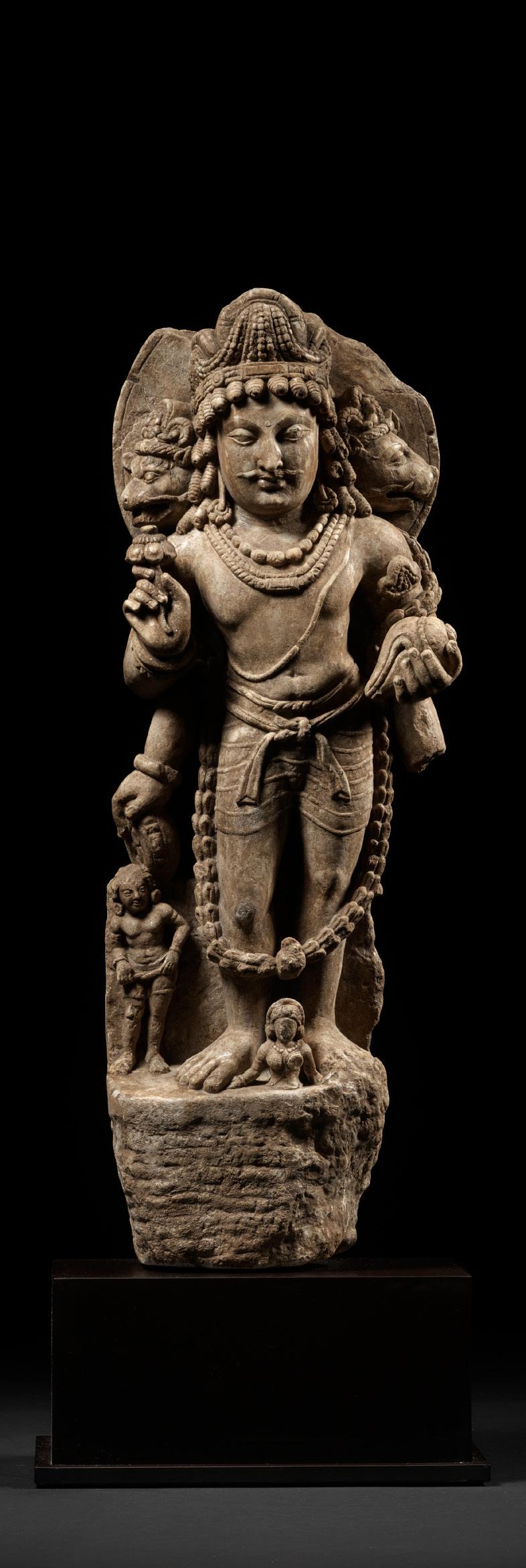
Northwestern India, 8th century. Gracefully modeled, the deity standing in slight tribhanga, holding a conch in his left hand and a lotus blossom in his right. Three-headed, his main head flanked by that of a lion to his right and that of a boar to his left. He is wearing a short pleated dhoti tied at the waist and adorned with a lotus garland and fine jewelry. His serene face with almond-shaped eyes below gently arched brows centered by a raised circular urna, above a wavy mustache, bow-shaped lips, and prominent chin. His hair arranged in curly locks beneath the elaborate tiara.
Provenance: Italian private collection. Leonardo Vigorelli, Bergamo, Italy, acquired from the above.
Leonardo Vigorelli is a retired Italian art dealer and noted collector, specializing in African and ancient Hindu-Buddhist art. After studying anthropology and decades of travel as well as extensive field research in India, the Himalayan region, Southeast Asia, and Africa, he founded the Dalton Somaré art gallery in Milan, Italy, which today is run by his two sons.

Condition: Good condition, commensurate with age. Wear, signs of weathering and erosion, minor structural cracks, losses, few minor old fills, nicks, scratches, encrustations. The stone with a fine, naturally grown patina overall.
Weight: 63 kg (incl. stand)
Dimensions: Height 103.4 cm (incl. stand) and 85.4 cm (excl. stand)
With an associated stand. (2)
This complex form of Vishnu is identifiable by the epithet Para-Vasudeva, “the highest god.” The lion and boar represent Vishnu’s Varaha and Narasimha avatars. Similar carvings include a fourth face on the back, a demonic, grimacing representation with fangs and a vertical third eye on the forehead. The small attendant on Vishnu’s right is Chakra purusha, the personification of his war disk, on which the gods left hand rests. The earth goddess Prithvi stands between Vishnu’s legs.
Under the Hindu Shahi rulers in the 8th-13th century, a unique style of sculpture and architecture developed that departed from the Kushan and Gupta style of the central plains. It is evident that the distinctive facial features and hair styles reflect the earlier Gandharan style to a certain degree.
Literature comparison: For related Shahi sculptures, see Donald M. Stadtner, ‘Shahi Sculpture Revisited,’ Orientations, October 1999, p. 68–73.
AUCTION RESULT COMPARISON
Type: Related
Auction: Christie’s Amsterdam, 18 October 2005, lot 14
Price: EUR 11,950 or approx. EUR 17,500 adjusted for inflation at the time of writing
Description: A Hindu Shahi marble bust of Vaikuntavishnu, circa 8th century Expert remark: Compare the related modeling and iconography. Note the much smaller size (28 cm)
Estimate EUR 24,000
Starting price EUR 12,000
234
Leonardo Vigorelli

A FINE PAINTING OF A BODHISATTVA OF THE DIAMOND REALM, TABO STYLE, 10TH CENTURY
Expert’s note: The present lot was once a part of an illuminated manuscript, likely from a Prajnaparamita sutra. This has been confirmed by Tibetologist Dr. Amy Heller, who points towards several comparable works, all dating from the 10th century, and all originating from related manuscripts from this region.
Northern India, Himachal Pradesh. Watercolors and ink on paper. Depicting a Mahabodhisattva seated in dhyanasana upon a cushioned lotus-petaled throne with the hands held in dharmachakra mudra, the palms and soles stained red, wearing a five-pointed crown, and adorned with elaborate jewelry. The figure with an hour-glass shaped torso, surrounded by flowing celestial scarves, and backed by a flaming halo.
Provenance: From the collection of Michael Phillips. Michael Phillips (born 1943) is an Academy Awardwinning film producer. Born in Brooklyn, New York, his parents were Lawrence and Shirley Phillips, noted New York dealers in Asian fine art, selling to the Met, the LACMA, the Chicago Art Institute, and the British Museum among others. Michael Phillips is a collector of Asian art himself, particularly Indian, Southeast Asian, and Himalayan sculpture. His most important films include The Sting (winning the Academy Award for Best Picture in 1973), Taxi Driver (winning the Palme D’Or at the 1976 Cannes Film Festival), and Steven Spielberg’s Close Encounters of the Third Kind.
Condition: Good condition, commensurate with age. Extensive wear, loss to margins, soiling, minimal fading to colors, small tears to edges.
Scientific Analysis Report: An ‘Initial Condition Survey’ with a microscopic and UV-light examination was conducted by Podany Conservation Services, USA. The examination report concludes: ‘Given the lack of modern materials there appears to be no clear evidence that this object is an intentional modern forgery or copy.’ A copy of the signed examination report, dated 18 May 2021, accompanies this lot.
Dimensions: Image size 17.3 x 16.4 cm, Size incl. frame 34 x 33.8 cm Framed behind glass. (2)
Constructed in 996, the Tabo Monastery was built by the Buddhist king Yeshe-Ö (c. 959-1040), who was a descendant of ancient Tibetan nobility that expanded into the Spiti Valley when connecting trade routes between Ladakh and Mustang. The monastery was part of the dynasty’s successful political effort to reintroduce Mahayana Buddhism throughout the region, and thus was once richly decorated with paintings and sculptures. While some of the monastery’s paintings date to around 1040, we know that there have been restoration campaigns over the centuries.
Prajnaparamita refers to an enlightened means of seeing the nature of reality and it is part of the Mahayana scriptures or sutras which discusses this form of transcendental knowledge. It consists of several sutra, the earliest of which is the As t asahasrika Prajnaparamita Sutra or ‘Perfection of Wisdom in 8,000 Lines.’ The Prajnaparamita sutras were first brought to Tibet during the reign of Trisong Detsen (742-796) by scholars Jinamitra and Silendrabodhi and the translator Ye shes De. A key theme of the Prajnaparamita sutras is the Bodhisattva, the ‘awakening-being,’ which is defined in the 8,000-line Prajnaparamita sutra as, ‘One who trains in all dharmas without obstruction, and knows all dharmas as they really are.’ The paintings which illuminate these manuscripts had a meditative purpose, delivering illumination through the images.
LITERATURE COMPARISON
Compare a related 11th century wall painting in the assembly hall of the Tabo Monastery in the Spiti Valley of Himachal Pradesh (fig. 1). The two paintings are so similar that the present lot possibly served as an inspiration for the Tabo Monastery painting. Compare several paintings of bodhisattvas inside Tabo Monastery, depicted within identical roundels and with similar iconography. The painting also bears a close resemblance to a painting at the White Temple of Tsaparang, which belongs to the Guge style of Western Tibet.

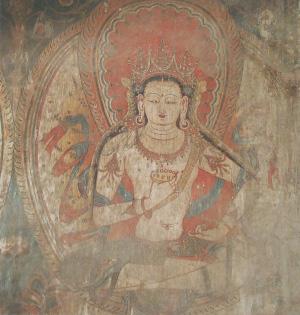
AUCTION RESULT COMPARISON
Type: Related
Auction: Bonhams, New York, 27 September 2020, lot 505
Price: USD 16,325 or approx. EUR 17,000 converted and adjusted for inflation at the time of writing
Description: An illuminated sutra page with Buddha underneath the bodhi tree, Kashmir or West Tibet, 12th/13th century
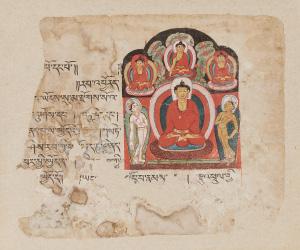
Expert remark: From Kashmir or neighboring Western Tibet, this comparable is one of a small number of paintings on the market that have a large undecorated section around the central scene, possibly suggesting a similar use for the current lot. The comparable also shares the same vibrant use of color.
Estimate EUR 12,000
Starting price EUR 6,000
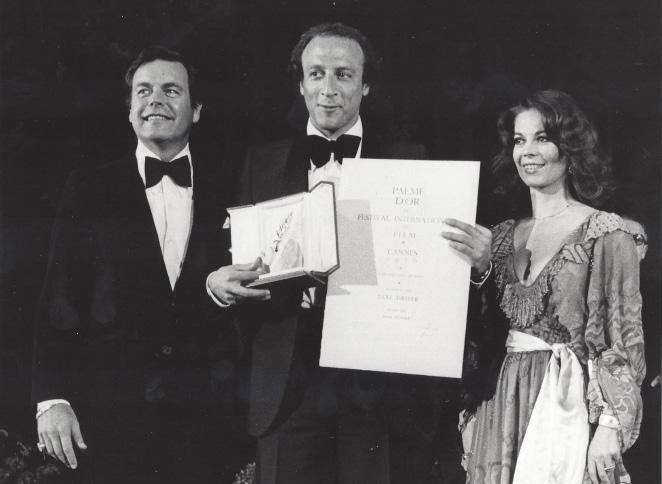
374 235
fig. 1
Michael Phillips receiving the Palme d’Or for Taxi Driver at the 1976 Cannes Film Festival
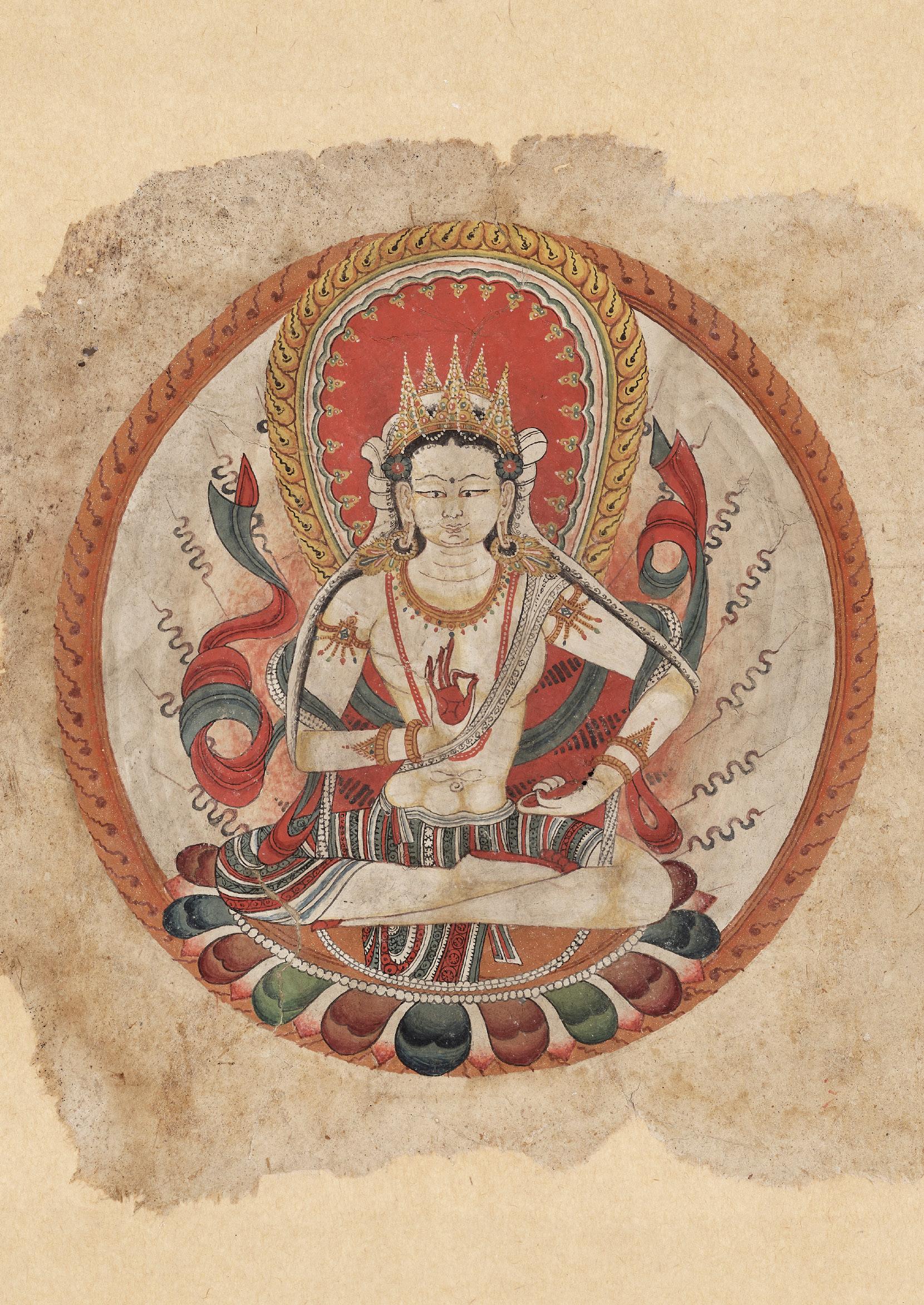
A MONUMENTAL SANDSTONE STELE OF SURYA, NORTHERN INDIA, UTTAR PRADESH, 11TH-12TH CENTURY
Identified by his characteristic boots, breast plate, and tall cylindrical crown, while wielding a beaming lotus in each hand, the stele is devoted to the Sun God Surya, whose cult at one time rivaled that of Shiva and Vishnu, and who became prominently incorporated into the iconographic program of the latter’s temples.
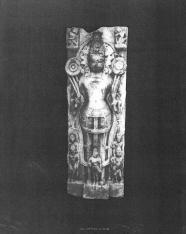
Provenance: From an old French private collection. Hôtel Drouot, S.C.P. Maurice Rheims et René Laurin, expert Michel Beurdeley, Art de la Chine et d’ Orient, 2nd-3rd March 1972, lot 76, illustrated on the back cover of the auction catalog. A noted French collector, acquired from the above and thence by descent in the family. A copy of a letter written and signed by Amina Okada, Conservateur au Musée National des Arts Asiatiques - Guimet, dated 22 January 1995, confirming the dating above, accompanies this lot. Copies of the front and back cover of the auction catalog Art de la Chine et d’ Orient, 2nd-3rd March 1972, the latter with an image of the present lot, also accompany this lot.
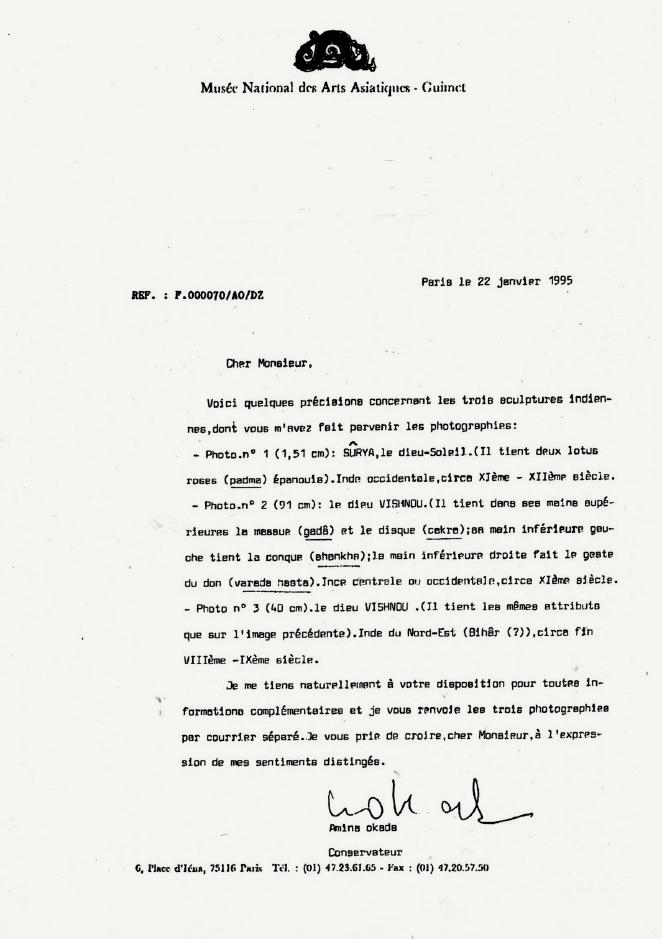
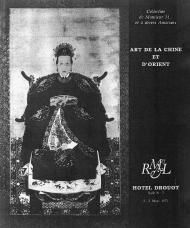
Condition: Good condition, commensurate with age. Extensive weathering, some wear, losses and structural cracks, signs of erosion, minor old repairs and fills. The proper left upper corner section broken off and reattached.
Weight: ca. 225 kg
Dimensions: Height 150 cm, Width 51 cm, Depth 22 cm
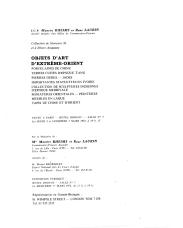

The Brahmanic god Surya is dressed according to traditional conventions that depict him as a king. His ‘northern’ garb is thought to resemble that of Indo-Scythian tribesmen, like the Kushans, who ruled Northern India in the first centuries of the common era. It is also thought to reflect the influence of Iranian religious ideas on Indian sun worship. (Rosenfield, The Arts of India and Nepal, Boston, 1966, page 43)
The monolithic stele depicts a full entourage accompanying the solar deity, with his wife, Ushas (the Dawn) standing immediately before him as the herald of each new day. On either side of his feet are Surya’s clerk and measurer, Pingala and Danda, standing with complementary tribhangha poses. Immediately flanking them are a pair of anthropomorphized horses, offering gestures of reassurance: possibly ayudha-purushas of his chariot’s steeds. Above Surya are Usha and Pratyusha, two archers defending dawn and dusk from the darkness.
Surya’s bold lotus blossoms and crisp halo, as Dye once deftly noted, “suggest both the sun itself and the boundless life it nurtures” (Dye III, The Arts of India, Richmond, 2001, p. 136). The softly modeled facial features of Surya with lightly arching brows and narrow prominent lips, harkening back to Gupta prototypes, point to the regional style of Uttar Pradesh in Northern India. So too does the buff-to-reddish colored sandstone, the less extravagant array of necklaces and regalia (in comparison with neighboring Rajasthan and Madhya Pradesh), and the treatment of the halo with its distinct triangular sunbeams, bordered by a plain circular rim.
Literature comparison: Compare the aforementioned various idioms with examples attributed to Uttar Pradesh in Desai & Mason (editors), Gods, Guardians, and Lovers, New York, 1993, p. 187-188, 244-247, and 262-263, nos. 28, 62, and 70.
AUCTION RESULT COMPARISON
Type: Related
Auction: Bonhams New York, 19 March 2018, lot 3081
Price: USD 492,500 or approx. EUR 549,000 converted and adjusted for inflation at the time of writing
Description: A large sandstone stele of Surya, Northern India, circa 11th century Expert remark: Compare the closely related subject, material, manner of carving, and height (152 cm), although the stele is considerably wider and more complete than the present lot.

Estimate EUR 60,000
Starting price EUR 30,000
376 236
A letter written and signed by Amina Okada, Conservateur au Musée National des Arts Asiatiques - Guimet, dated 22 January 1995, confirming the dating of this lot

A GRANITE STELE OF SHIVA ARDHANARISHVARA AND NANDI, CHOLA PERIOD, SOUTH INDIA, TAMIL NADU, 11TH-12TH CENTURY
Expert’s note: This inspiring statue was originally carved to depict Ardhanarishvara, Shiva’s half-male and half-female form, as indicated by the earring on the left ear, and especially the left half of the chest with an area of loss where a female breast once was, a crucial detail not mentioned by Christie’s Amsterdam when they sold this figure in 2007. Ardhanarishvara (lit. ‘The half-female Lord’), is a form of the Hindu deity Shiva combined with his consort Parvati, depicted as half-male and half-female, equally split down the middle. The right half is usually the male Shiva, illustrating his traditional attributes, including his abode Nandi, such as in the present lot.
Superbly and deeply carved standing in tribhanga and leaning against Nandi, his four arms holding attributes including a trishula, and wearing a dhoti. The deity adorned with beaded jewelry, the face with a serene expression, the hair crowned with a high chignon.
Provenance: Werner Coninx, Zurich, Switzerland, and thence by descent within the same family. Christie’s Amsterdam, 21 November, 2007, lot 569, sold for EUR 7,450 or approx. EUR 11,000 (adjusted for inflation at the time of writing), by repute acquired from the above. A noted European private collection, acquired from the above. Werner Coninx (1911-1980) was one of the world’s most voracious art collectors. The son of a prominent Swiss publisher, and a friend of the important Swiss novelist Max Frisch, who mentioned Coninx in his novel Montauk, he amassed some 14,000 paintings, drawings, and sculptures during his lifetime. In terms of sheer size, his art collection was probably the largest in Switzerland. Broadly based, ranging from Swiss art to German Expressionism and French Impressionism to East Asian art, ancient Greece, and Africa, it remains unforgotten to this day. Condition: Condition commensurate with age. Extensive wear, losses, cracks, nicks, and signs of weathering and erosion, natural encrustations, all as expected from a granite figure with almost an entire millennium of age. The stone with a beautiful and smooth surface, nicely worn down from centuries of rain and devoted worship within the culture, resulting in a remarkably unctuous feel overall.
Weight: 151.4 kg (excl. stand)
Dimensions: Height 100 cm (excl. stand) and 101 cm (incl. stand)
With an associated metal stand. (2)
The earliest Ardhanarishvara images are dated to the Kushan period, starting from the first century CE. Its iconography evolved and was perfected in the Gupta era. The Puranas and various iconographic treatises write about the mythology and iconography of Ardhanarishvara, which remains a popular iconographic form found in most Shiva temples throughout India today, though very few temples are dedicated to this deity.
Ardhanarishvara represents the synthesis of masculine and feminine energies of the universe (Purusha and Prakriti) and illustrates how Shakti, the female principle of God, is inseparable from (or the same as, according to some interpretations) Shiva, the male principle of God, and vice versa. The union of these principles is exalted as the root and womb of all creation. Another view is that Ardhanarishvara is a symbol of Shiva’s all-pervasive nature.
AUCTION RESULT COMPARISON
Type: Closely related
Auction: Christie’s New York, 21 March 2008, lot 758
Price: USD 51,400 or approx. EUR 68,500 converted and adjusted for inflation at the time of writing

Description: A granite figure of Vishnu, South India, Chola period, 12th/13th century
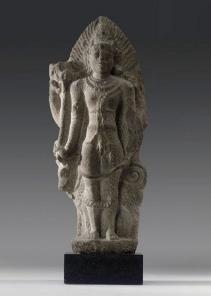
Expert remark: Note the slightly larger size (113.7 cm).
Estimate EUR 8,000
Starting price EUR 4,000
378
237
Werner Coninx (center) with his childhood friends, Max Frisch (left) and Freddo Behrmann (right)
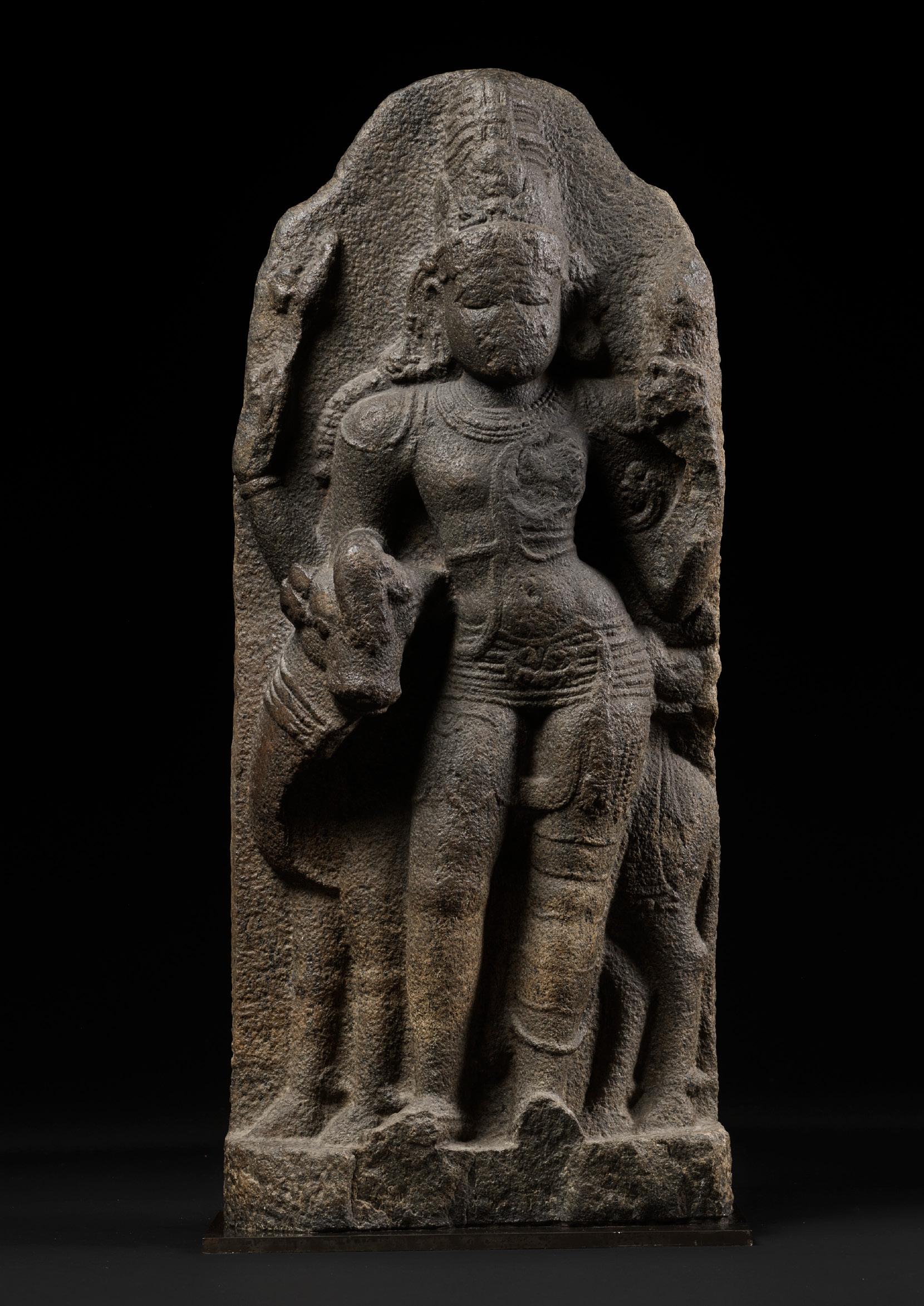
A BRONZE FIGURE OF DURGA SLAYING THE BUFFALO-DEMON MAHISHA, ORISSA, EASTERN INDIA, 13TH-14TH CENTURY
Finely cast with the four-armed goddess slaying the demon just as the he emerges from the decapitated body of the buffalo. The goddess’s right foot rests on the back of her lion vehicle, who roars in victory as Durga delivers the death blow with her trident, the decapitated buffalo head lying at the lower end of the pedestal. Resplendent with her arms fanning out and holding her attributes: trident, chakra, and conch. The face dominated by bulging eyes, the deity adorned with jewelry, all raised on a beaded lotus pedestal.
Provenance: From a noted Hungarian private collection. Condition: Very good condition with old wear and some minor casting flaws, small nicks, and tiny scratches.
Weight: 304.9 g
Dimensions: Height 10.6 cm
The warrior manifestation of Adi Parashakti/ Mahadevi (the Supreme Being in Shaktism) is represented in her most popular form as Mahishasuramardini (Slayer of the Buffalo Demon). Whilst representations of Durga can have between two and twenty arms, in medieval Indian art she is most often shown with eight or ten arms. However, the few extant Orissan metal Durga images in fully developed indigenous style (i.e., sculptures created after ca. 1200) almost invariably show her with only four arms. The four-armed form is most closely associated with Puri.
The weapons that Durga holds were bestowed upon her by male Hindu deities. Here, she holds Vishnu’s conch (shankha) and disk-like weapon (Sudarshana Chakra) in her upper pair of hands, whereas her two principal, lower hands push Shiva’s massive trident into Mahishasura’s chest.
The artist brilliantly captures the ultimate culmination of this fierce battle, when the powerful demon humbly realizes Durga’s blatant superiority in the very moment of his death. The demon in human form emerges from the neck of his buffalo guise. The buffalo’s body supports the foot of Durga’s bent right leg, whilst the foot of her outstretched left leg rests on the back of her mount (vahana), a lion.
Goddess Durga fought Mahishasura for ten whole days. The shapeshifting demon was no match for the radiant and strong goddess. On the tenth day, she slayed him. The nine days of battle became what is celebrated today as the Hindu festival of Navaratri, and the tenth day—the day of victory—is Vijaya Dashami.
Durga’s serene, calm and graceful face starkly contrasts with the lion’s unleashed force and the demon’s last rearing up. The crescent moon in her crown, almost entirely worn off, alludes to her association with Shiva, whose Shakti (female creative energy) is known in various manifestations, such as Sati, Parvati, Durga or Kall.
Article continues online at www.zacke.at
LITERATURE COMPARISON
Compare to a closely related iconography of Durga previously in the collection of the late Wolfgang Messmer, Konstanz, Germany, illustrated in Rossi and Rossi, A Selection of Rare Orissan Bronzes, TEFAF 2023, catalog no. 5, page 18-21.

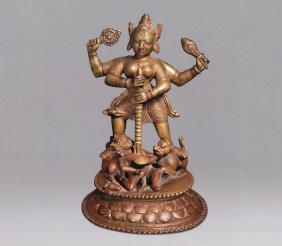
Estimate EUR 10,000
Starting price EUR 5,000
380 238
239
A LARGE PINK SANDSTONE HEAD OF VISHNU, NORTHERN OR CENTRAL INDIA, 10TH-11TH CENTURY
Exquisitely carved with a serene expression, marked by almondshaped eyes below elegantly arched eyebrows, an aquiline nose, and full lips forming a subtle smile. Flanked by elongated ears with circular earrings, the head surmounted by a tall and elaborately carved tall miter crown, the kiritamakuta.

Provenance: From a noted private collection in Germany, by repute acquired before the 1950s.
Condition: Good condition, commensurate with age. Signs of weathering and erosion, nicks, small losses, natural cracks.
Weight: 8,338 g
Dimensions: Height 35 cm
Literature comparison: Compare a closely related figure of Vishnu carved in sandstone with similar facial features, adornment, and similar beaded and floral decorations along the kiritamakuta, 127 cm high, dated to the 10th century, in the British Museum, registration number 1872,0701.41.
AUCTION RESULT COMPARISON
Type: Related
Auction: Sotheby’s New York, 19 March 2014, lot 37
Price: USD 12,500 or approx. EUR 14,500 converted and adjusted for inflation at the time of writing
Description: A mottled red sandstone head of Vishnu
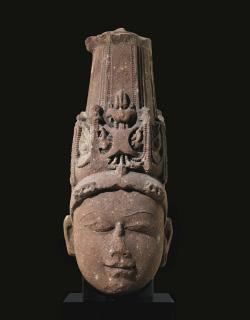
Expert remark: Note the related kiritamakuta.
Estimate EUR 4,000
Starting price EUR 2,000
381
240
A BLACK STONE STELE OF PADMAPANI, PALA PERIOD, NORTHEASTERN INDIA, 10TH-12TH CENTURY
Seated in lalitasana on a double lotus throne with a pendent leg resting on a separate padma, his primary right hand lowered in varada mudra and his primary left resting on the base holding a lotus coming to full bloom at his shoulder. His secondary hands holding a mala (rosary) and an amrita vase. He is wearing a sheer dhoti tied at the waist and his body is richly adorned with beaded jewelry and upavita (sacred thread). His serene face with almond-shaped eyes below gently arched eyebrows centered by a drop-shaped urna, above his full lips forming a calm smile, flanked by long pendulous earlobes.
Provenance: Collection of Giovanni Paltenghi, Italy, by the early 1990s. Leonardo Vigorelli, Bergamo, Italy, acquired from the above. Leonardo Vigorelli is a retired Italian art dealer and noted collector, specializing in African and ancient Hindu-Buddhist art. After studying anthropology and decades of travel as well as extensive field research in India, the Himalayan region, Southeast Asia, and Africa, he founded the Dalton Somaré art gallery in Milan, Italy, which today is run by his two sons.
Condition: Excellent condition, commensurate with age. Ancient wear from within the culture, signs of weathering and erosion, minor losses, small nicks, light scratches, and minute encrustations. The stone with a fine, naturally grown, smooth patina overall.
Weight: 50.8 kg
Dimensions: Height 56 cm
His tall jatamukata is secured by a studded diadem centered with a diminutive image of the Buddha Amitabha, backed by a flaming mandorla and flanked by two flying apsaras carrying lotus garlands. The base is carved with a worshiper kneeling at an altar.
Avalokiteshvara (The Allseeing Lord), known variously as Lokeshvara (Lord of the World), Lokanatha (Savior of the World), and Padmapani (The Lotusbearer), is the pre-eminent bodhisattva of Mahayana Buddhism, which developed in India during the early centuries of the Common Era, and has remained an inspiration to its followers to this day. As a result, he has a wide variety of iconographic forms in both India and all other countries of Asia where his cult spread, as is clear from the surviving archaeological and literary evidence. He was especially venerated in the region of present-day Bihar, West Bengal, and Bangladesh in the Indian subcontinent between the 8th and 12th centuries.
The present sculpture is carved from the familiar black stone that occurs in the region of both Bihar and old Bengal (now West Bengal in India and Bangladesh). The material is identified in literature generically as schist but is also known as phylite. The hardness of the stone allows it to be carved confidently into rich surfaces with both exuberant designs and fine details, as becomes abundantly evident in the present work.
Literature comparison: Compare a related stele with a seated Avalokiteshvara, 50.2 cm high, dated 11th-12th century, in the Brooklyn Museum, accession number 1994.199.4.
AUCTION RESULT COMPARISON
Type: Closely related
Auction: Christie’s New York, 18 September 2013, lot 233
Price: USD 111,750 or approx. EUR 123,000 converted and adjusted for inflation at the time of writing
Description: A black stone stele of Padmapani, Northeastern India, Pala period, 10th century
Expert remark: Compare the closely related modeling with the primary hands in the same poses, his secondary right also holding a mala, also seated in lalitasana with a pendent foot resting on a lotus, and further with similar expression, beaded jewelry, and jatamukata fronted by an image of Amitabha. Note the arched back carved with the Buddhist creed. Note the slightly smaller size (46.3 cm).
AUCTION RESULT COMPARISON
Type: Related
Auction: Bonhams New York, 16 March 2015, lot 58
Price: USD 68,750 or approx. EUR 81,000 converted and adjusted for inflation at the time of writing
Description: A black stone stele of Avalokiteshvara Shadakshari, Bihar, Pala period, 11th/12th century


Expert remark: Compare the related stone and manner of carving. Note the smaller size (30.5 cm).
Estimate EUR 24,000
Starting price EUR 12,000

382
Leonardo Vigorelli

AN INSCRIBED NAGA FRAGMENT FROM A JAIN TEMPLE, WESTERN INDIA, 15TH-17TH CENTURY
Deeply and skillfully carved from pure white marble as intertwined serpents rising below the spreading naga hood with finely incised eyes, surmounted by a shikhara above several dedicatory inscriptions.
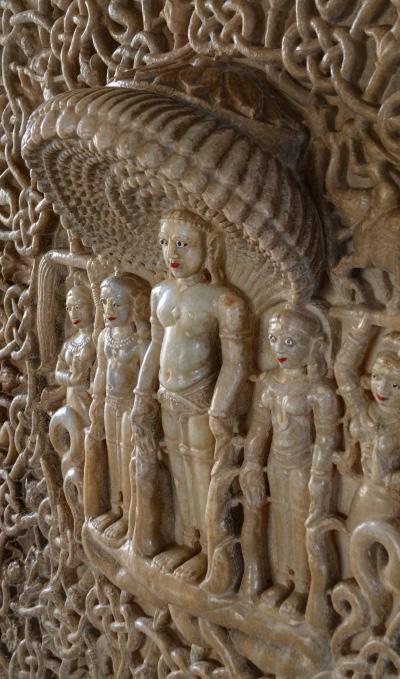
Inscriptions: To the top, ‘Parampita Parmatma’, and a dedication to Shri Nagad, above donor dedications to ‘Rajanti Raghwala’ and ‘Prithviyay’.
Provenance: From the private estate of Monica Ghizzardi, Belgium.
Condition: Good condition with old wear, weathering, minor erosion, and calcification inside the naga hood indicating a later usage as a basin, minor losses, small nicks, light scratches.
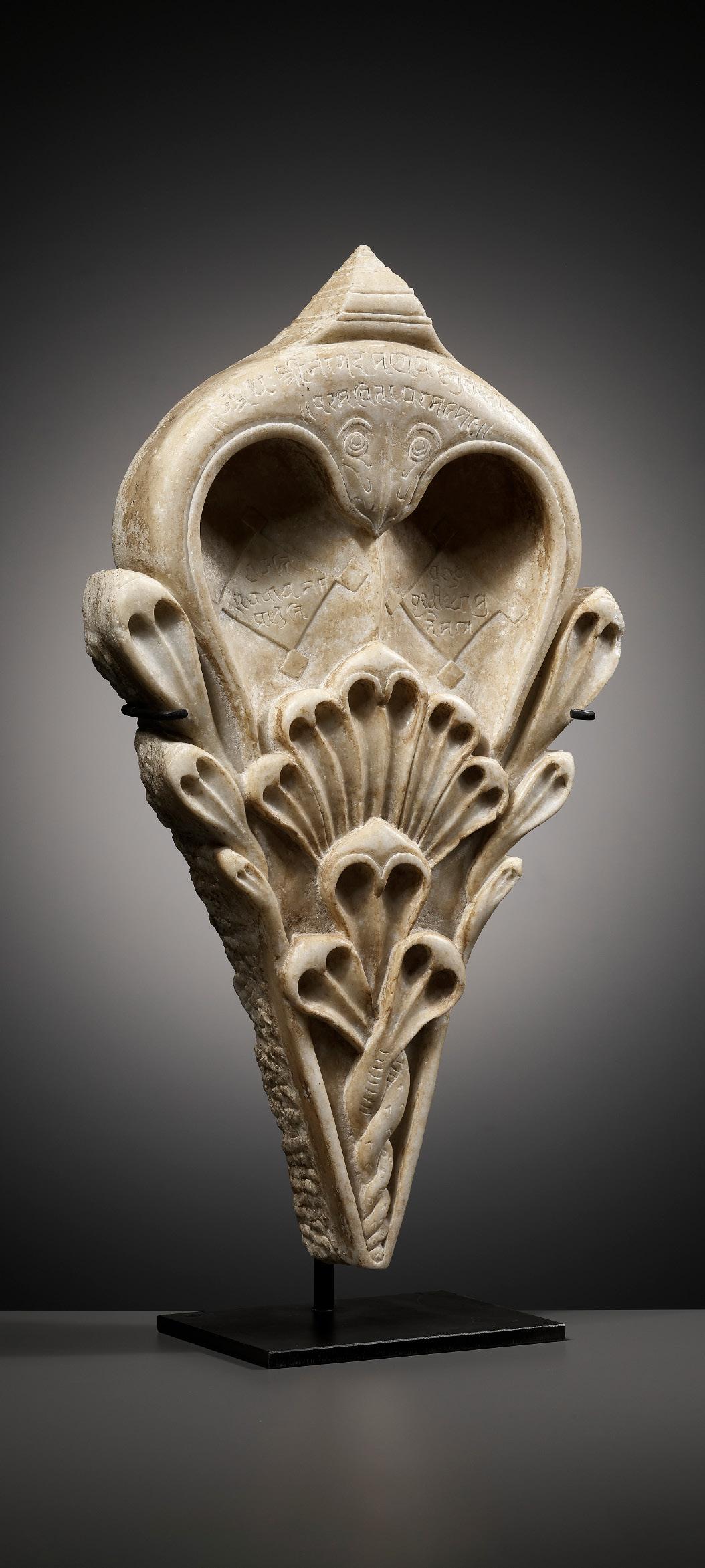
Weight: 17.9 kg (excl. stand)
Dimensions: Height 62 cm (excl. stand).
With a fitted metal stand. (2)
Expert’s note: The present lot is related to Parshvanatha, the 23rd Tirthankara, whose symbol is the snake. Jain temples in Western India, such as the Ranakpur Temple in Rajasthan, feature marble carvings of the deity with similar iconography. His mother is said to have seen a black serpent crawling by her side before his birth, and in sculpture and painting he is always identified by a canopy of snake hoods over his head. According to accounts in the Kalpa Sutra, Parshvanatha once saved a serpent that had been trapped in a log in an ascetic’s fire. The snake, later reborn as Dharana, the lord of the underworld kingdom of nagas, sheltered Parshvanatha from a storm sent by a demon.
241
Estimate EUR 3,000 Starting price EUR 1,500
Marble carving of Parshvanatha surrounded by snakes at the Ranakpur Jain temple in Ranakpur, Rajasthan
A JAIN WHITE MARBLE FIGURE OF A TIRTHANKARA, WESTERN INDIA, 17TH-18TH CENTURY
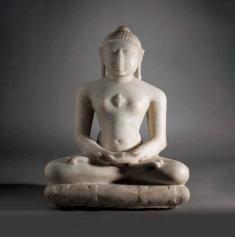
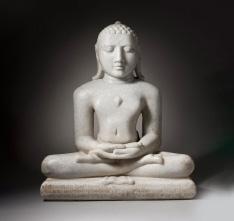
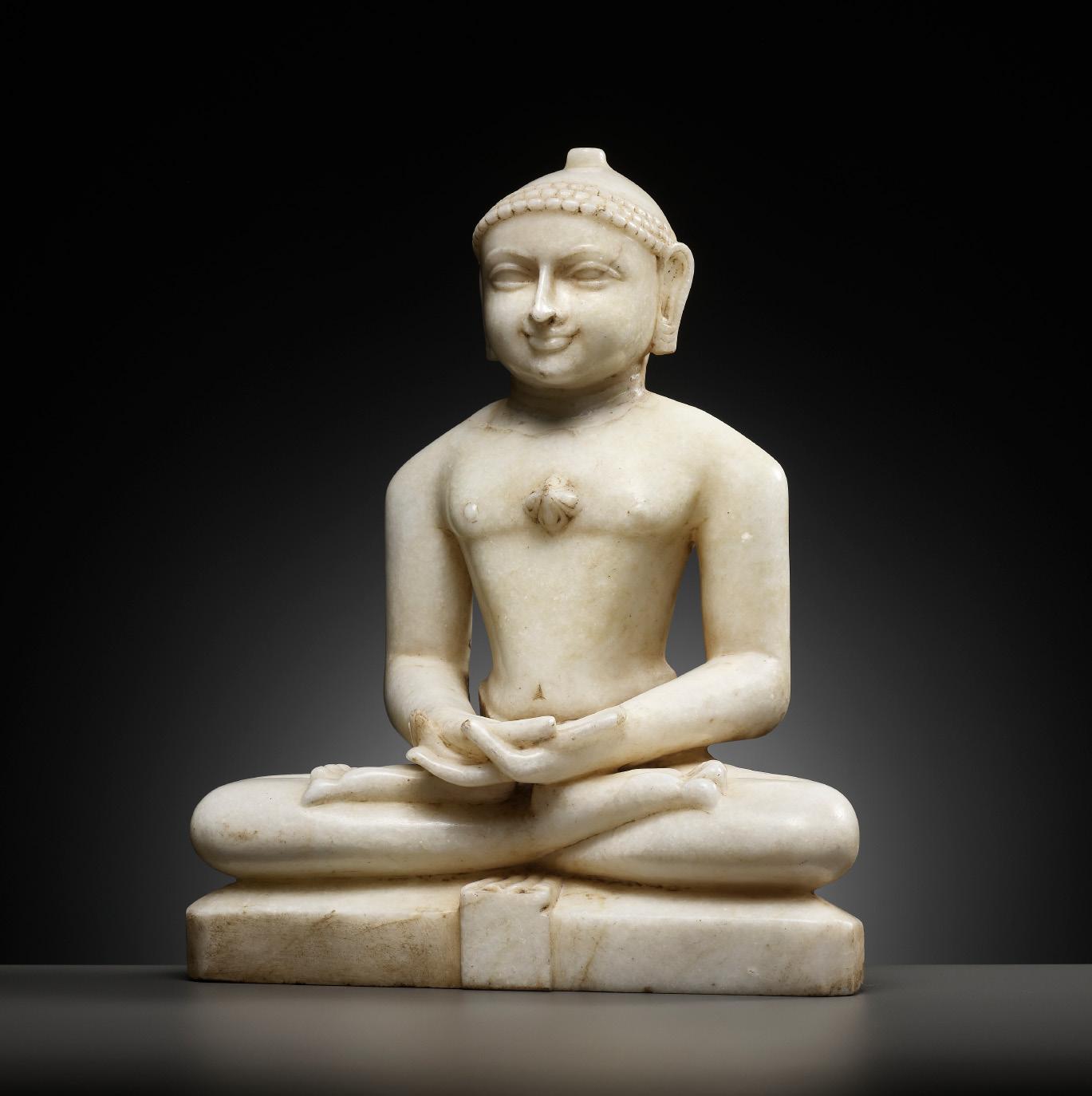
Seated in padmasana on a cushioned throne, the figure wearing a diaphanous lower garment, the sash projecting in relief in front of the legs, his hands folded in dhyana mudra, his chest with a srivatsa mark. His face with downcast eyes and serene expression, flanked by elongated earlobes, the hair arranged in tight curls and surmounted by a cranial protrusion. The stone with a good polish, resulting in a smooth, unctuous feel overall.
Provenance: From a private estate in the United Kingdom. Condition: Small chips and minor losses, the stone with natural inclusions, irregularities and fissures. Some cracks and breaks with old repairs and associated fills. Magnificent naturally grown patina overall, with a fine pale ivory tone.
Weight: 13.8 kg
Dimensions: Height 38.5 cm
The nudity of Jain saints was a practice of both asceticism and their belief in non-possession, dating back to the days of Mahavira. However, a schism arose in around 79 AD, extensively recorded in literature, about what constitutes total renunciation. At the time, Jain monks separated into rival factions, the Digambaras (‘clothed with the sky’), who were nude, and the Svetambaras (‘clothed with white’), who wore white cloths. According to inscriptions, the Svetambaras worshipped the nude image without objection and for both sects the Jinas and the saint Bahubali are represented naked while all other deities are clothed and even ornamented.
LITERATURE COMPARISON
Compare a closely related marble tirthankara from Gujrat, Western India, dated c. 1612, in the Los Angeles County Museum of Art, accession number AC1998.256.2.
AUCTION RESULT COMPARISON
Type: Closely related
Auction: Christie’s London, 18 October 2002, lot 122
Price: GBP 4,465 or approx. EUR 11,000 converted and adjusted for inflation at the time of writing
Description: An Indian marble deity Jain, probably 12th/13th century Expert remark: Compare the closely related material, manner of carving, pose, and expression. Note the size (56 cm) and the somewhat spurious dating of ‘probably 12th/13th century’.
Estimate EUR 4,000
Starting price EUR 2,000
385 242
A LARGE JAIN PATA OF PARSHVANATHA, GUJARAT, WESTERN INDIA, 18TH - 19TH CENTURY OR EARLIER
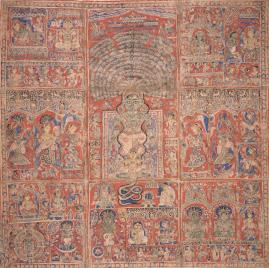
Published: Asian Art Society, Online Catalogue IV, 1 January 2021, p. 90-91, no. 21 (presented by Joost van den Bergh, London, United Kingdom; text by Dr. Gautam Vajracharia, University of Wisconsin), and illustrated on the cover of the catalog
Tempera and gold on cloth. Parshvanatha is depicted in the center standing in koyotsarga protected by a hood of nagas issuing from his golden crown, draped in a white dhoti with foliate designs, his body adorned in gold and silver jewelry, all above a smaller figure of the tirthankara above a lotus. The central deity surrounded by several lobed and star-shaped panels (satkonas) representing the cosmos and its phenomena, with identifying inscriptions. The satkonas depict Sarvavinivritta, Sumangalanatha, and Krishnaranga to the left, and Kunthunatha, Parshvabhrata, and Nyamibhrata to the right.
Inscriptions: According to Dr. Piotr Balcerowsczy (Chair of South Asian Studies, Faculty of Oriental Studies, University of Warsaw): “These are mostly (90%) in Sanskrit, with some stray portions of Prakrit. In general, these are “recycled” verses coming from some literature – these were not composed by the author of the pata. My first guess would be that the origin of some of these verses could be Hemacandra’s Trịsạst iśalākāpurus acarita (but that should be checked). Another most possible option is Jinasena’s Parsvabhyudaya. The other source (that of the Prakrit passages) could be the respective chapter of Kalpa-sutra.”
Provenance: Collection of José Ramón Pons Oliveras, Barcelona, Spain, 1998. Collection of Carlos Cruañas Dalmau, Barcelona, Spain, acquired from the above. A copy of the original invoice signed by José Ramón Pons Oliveras, dated 15 April 1998, addressed to Carlos Cruañas Dalmau, dating the present lot to the 17th-18th century, and stating a purchase for the present lot together with three other Indian paintings; also dated 17th-18th century, of which the present lot is the largest, of EUR 35,000 or approx. EUR 63,000 converted and adjusted for inflation at the time of writing, accompanies this lot.
José Ramón Pons Oliveras (1928-2013) was a traveler, photographer, and cinematographer of nature, and a noted collector of Indian works of art. He travelled extensively to Asia, Oceania, Africa, and South America, filming in many isolated and inaccessible areas of the world. He acquired rare and important works of art during his travels to India in the 1970s, some of which have been sold by Christie’s, including a mottled red sandstone figure of a lion, Mathura, 2nd century, at Christie’s New York, 19 March 2013, lot 259.

Condition: Good condition with minor wear, soiling, few loose threads, and tiny losses.
Dimensions: Size 190 x 167 cm
Parshvanatha, the Jaina saint, is believed to be the 23rd Tirthankara. His life story is closely related to the cult of serpents. Although serpents are considered malevolent creatures by some, people in India believe that they are auspicious divine beings. High religions of India such as Hinduism, Buddhism and Jainism, show sympathy to the cult of serpent, which has remained popular since prehistoric time. The present pata shows the episode of the life of Parshvanatha when Yaksha Dharnendra and his wife Yakshini Padmavati endeavored to cover Parshvanatha by creating a canopy of snake-hoods over his head and lifting him up from the ground to save him from submergence.
When Parshvanatha was born, his mother saw a serpent crawling near her side, and therefore she named her child Parshva. The auspicious appearance of the snake at his birth is also related to an important event that took place in the earlier life of Parshva, in which he was born as a prince. While wandering in the forest, the prince saw an ascetic, who was about to sacrifice a snake. Such a ritual act was mandatory for the Vedic ritual of fire worship that he was performing. The prince thought that killing a creature for a religious purpose is a cruel act. Therefore, he forcefully interrupted the ongoing ritual of fire worship and saved the life of the snake. The ascetic was so angry with the prince that his anger remained intact even after his death.
In the next cycle of birth, the ascetic incarnated himself as the cloud demon, Meghmalin, and the prince as the Jain saint Parshvanatha. Likewise, the serpent was born as a divine serpent, Dharana, with multiple snakehoods. The cloud demon created a devastating flood when Parshvanatha was practicing yoga in a standing posture called kayotsarga, a technical Sanskrit term, which can be translated as “out of physical body.” The flood almost submerged him. But the serpent Dharana, remembering that Parshvanatha protected him in his earlier life, came there to help him. He brought a giant lotus and placed it under Parshvanatha’s feet and spread his multiple hoods to shelter him from heavy rain. Thus, the Jain saint was able to continue his yogic practice without being disturbed by the flood.
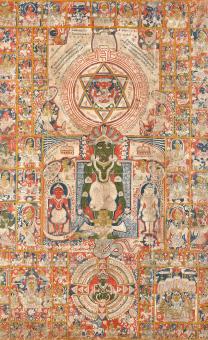
LITERATURE COMPARISON
Compare a related large and rare early example in the Philadelphia Museum of Art, accession number 2003-143-1, illustrated in Pratapaditya Pal, The Peaceful Liberators: Jain Art from India, Los Angeles, 1994, no. 100, p. 227.
AUCTION RESULT COMPARISON
Type: Related
Auction: Bonhams New York, 13 September 2011, lot 1124
Price: USD 11,250 or approx. EUR 13,500 converted and adjusted for inflation at the time of writing
Description: A Jain pata of Sahasraphana Parshvanatha, Gujarat, 15th century Expert remark: Compare the related subject, also depicting Parshvanatha, and manner of painting. Note the earlier dating and the smaller size (83.8 x 54.6 cm).
Estimate EUR 15,000
Starting price EUR 7,500
386 243
José Ramón Pons Oliveras (center)

387
A QAJAR SILVER- AND GOLD-DAMASCENED IRON FIGURE OF AN IBEX, PERSIA, 19TH CENTURY
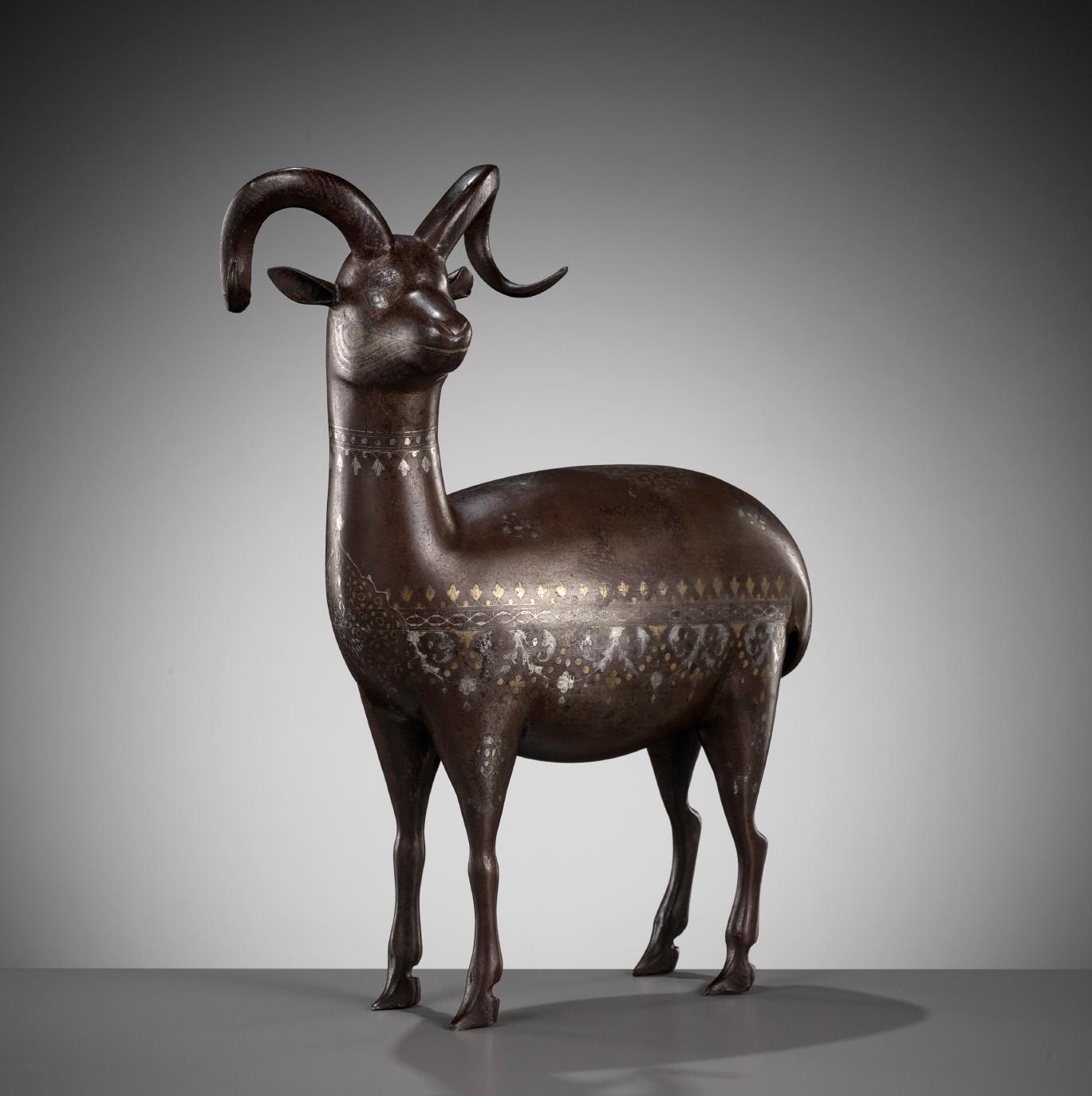
Naturalistically modeled standing foursquare with the head turned to the left, the horns curling over the head, the animal further detailed with funnel-shaped ears, almond-shaped eyes, and a long muzzle. The body finely decorated with silver- and gold-damascened foliate and geometric decorations, the chest and back with floral arabesques, and the head with facial features and hair neatly outlined.
Provenance: London trade. By repute from a noted private collection. Condition: Very good condition with expected old wear and minor casting irregularities, light scratches, tiny nicks, small dents, wear to inlays, encrustations. A good, naturally grown patina overall.
Weight: 1,364 g
Dimensions: Height 30.5 cm, Length 26.3 cm
Steel (pulad) was widely available in Iran and had been in use in these lands since the Pre-Islamic period, though before the 18th century this material was used primarily for the production of arms. The boom in artistic expression that occurred during the Qajar era was a side effect of the period of relative peace that accompanied the rule of Agha Muhammad Khan (1742-1797), the founder of the Qajar dynasty, and his descendants. With his ascension, the bloody turmoil that had been the first half of the 18th century came to a close and made it possible for peacetime arts to flourish again in Persia.
Damascened steel figures of animals are one of the Qajar period’s most beloved creations, depicting a vast range of creatures including ibexes, deer, cats, elephants, camels, peacocks, doves, and many more. These sculptures served to decorate the ‘alams’ (devotional standards) used during important ceremonies and processions, the most important taking place during the month of Muharram and commemorating Hussain’s martyrdom in Kerbela (see Annabelle Collinet, L’empire des Roses: Chefsd’œuvre de l’art persan du XIXe siècle, Louvre-Lens, 2018, p. 92-93).
Literature comparison: Compare a closely related silver and golddamascened steel deer, dated to the second half of the 19th century, 43 cm high, in the Musée des Beaux-Arts, Rennes, accession number 1932.8.120, and included in the exhibition L’empire des Roses: Chefs-d’œuvre de l’art persan du XIXe siècle, Louvre-Lens, 23 March-23 July 2018, p. 93, no. 78.
AUCTION RESULT COMPARISON
Type: Closely related
Auction: Christie’s London, 13 October 1998, lot 339
Price: GBP 9,200 or approx. EUR 24,500 converted and adjusted for inflation at the time of writing
Description: A pair of Qajar silver and gold damascened steel ibex, Persia, 19th century
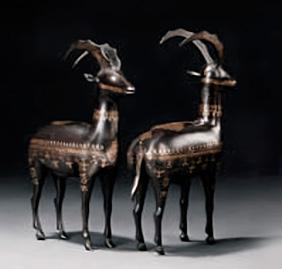
Expert remark: Compare the closely related subject, modeling, silver- and gold-damascening, and decoration. Note the related size (29.4 cm) and that the lot comprises a pair.
Estimate EUR 6,000
Starting price EUR 3,000
388 244
A BRONZE BHUTA CULT MASK OF NANDI, SOUTH INDIA, LATE 18TH TO EARLY 19TH CENTURY
Heavily cast, the ritual mask in the form of a bull’s head with two long curved horns, each decorated with raised rings and incised with lotus petals at their bases. The face of the bull with a beaded halter, two large almond-shaped eyes with round pupils and neatly incised lashes, pierced nostrils, and two separately cast funnel-shaped ears, the mouth open revealing large incised teeth. The back with a circular attachment loop.
Provenance: English trade.
Condition: Very good condition with expected old wear and casting flaws. Light scratches, minor nicks, and small dents.
Weight: 4,742 g
Dimensions: Length 45.4 cm
This cult mask has a totemistic connection to a culture of farming where plows are pulled by bulls and where cow milk is one of the main sources of proteins. The link with Hinduism is also easily established through Nandi, the mount of Shiva. Nandi, “the one who brings happiness” in Sanskrit, incarnates the interior strength brought by the control of violence. Its four legs represent truth, purity, compassion, and generosity. The act of touching its tail is meant to relieve people from any kind of impurity.

The bhuta (spirit) is invoked in a highly stylized version of the ritual dance (bhuta kola) of the spirit impersonator during a theatrical production in which a world of supernatural beings is created by dancers adorned in colorful costumes including masks, such as the present lot, depicting various divine beings.
AUCTION RESULT COMPARISON
Type: Related
Auction: Galerie Zacke, Vienna, 25 April 2020, lot 448
Price: EUR 7,584 or approx. EUR 9,200 converted and adjusted for inflation at the time of writing
Description: A Bhuta cult mask of a bull, late 18th – early 19th century Expert remark: Compare the related form. Note the size (51 cm).
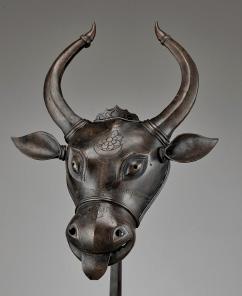
Estimate EUR 6,000
Starting price EUR 3,000
389 245
A BRONZE PECTORAL PLAQUE DEPICTING HANUMAN, BAJRANG BALI, 18TH CENTURY

Western India, Maharashtra or Karnataka. Finely cast, the circular plaque depicts a striding Hanuman, who carries in his left hand the healing plant (sanjivani buti), walking above an armed figure lying prone. The leafy plant hangs down to his knees, twisting back behind his body. The outer frame serves as a circular mandala with a band of stylized flames (prabhavala) and rosettes, enclosed by a rope-like border formed by the tails of two peacocks at the top, centered by a seven-headed hooded cobra hovering over a figure of Krishna dancing atop Hanuman’s head. The mandorla further with sun and moon symbols. The back is cast with a vertical loop for mounting.
Provenance: From a private collection in London, United Kingdom. The stand with an old label, ‘India. Hanuman. In wheel of rosettes and seeds with peacock terminals. Nagas and Krishna.’
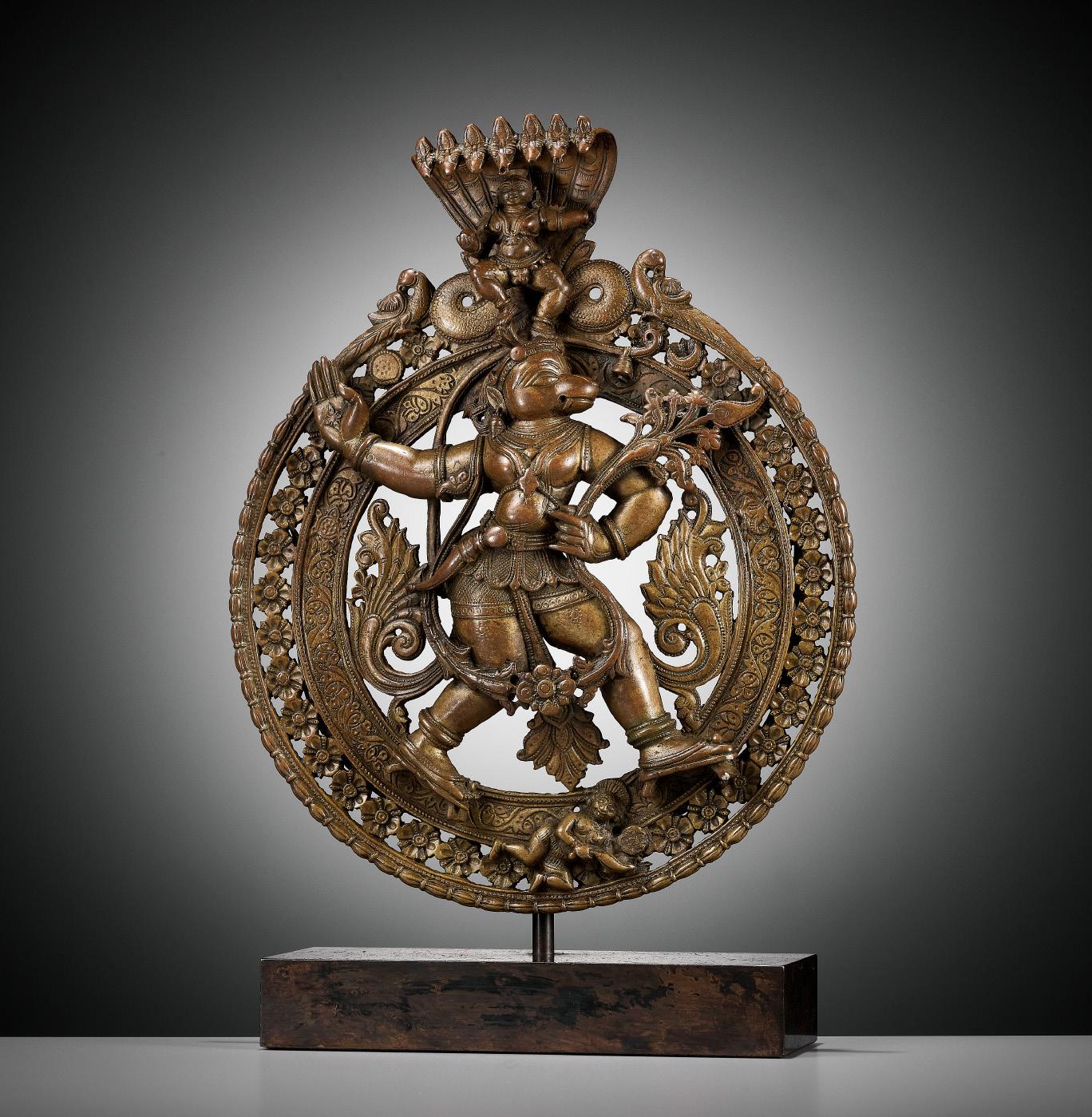
Condition: Very good condition with minor old wear and expected casting flaws, small nicks, light scratches, minor dents.
Weight: 751 g (excl. stand) and 1,084 g (incl. stand)
Dimensions: Height 22.9 cm (excl. stand) and 26.3 cm (incl. stand)
With a fitted modern stand. (2)
The scene depicted on this plaque recalls an episode in the Indian Ramayana epic when Hanuman flew through the air to bring a healing, medicinal herb (sanjivani buti) to the wounded Rama and his army. The small figure below Hanuman’s feet could be Lakshmana, the brother of Rama, who was wounded during the battle. As a divine being, Hanuman has the power to augment or diminish his size at will, and so he grows to such a stature that he can span the ocean with a single stride. This unique ability, according to myth, enabled the god to rescue Rama.
Expert’s note: Known as a bajrang bali (strong monkey), this distinctive type of pectoral plaque depicts Hanuman, The Divine Monkey. It is worn suspended around the neck by Vaishnava ascetics devoted to Hanuman, in the regions of Karnataka and Maharashtra.
LITERATURE COMPARISON
Compare a closely related bronze circular plaque depicting Hanuman mid stride, 21 cm high, dated 18th-19th century, in the British Museum, registration number 1853,0108.8 (fig. 1). Compare a closely related plaque depicting Hanuman mid stride, 23 cm high, dated to the 16th century, in the Los Angeles County Museum of Art, accession number M.87.160.1. Compare a related bronze circular plaque depicting Hanuman, 6.75 cm high, dated 17th-18th century, in the British Museum, registration number 1940,0716.323.
Estimate EUR 3,000
Starting price EUR 1,500
fig. 1
390 246
A PARCEL-GILT BRONZE FIGURE OF BUDDHA, KANDYAN PERIOD, SRI LANKA, 18TH CENTURY
The broad shouldered figure standing in sampada on a stepped circular plinth with his right hand incised with auspicious emblems and raised in vitarka mudra, wearing an elaborately pleated sanghati with deeply incised undulating folds and a sash draped over his left shoulder. His rounded face expressively cast with crisply delineated features, the eyes lidded and downcast, the aquiline nose and pursed lips flanked by long pendulous pierced lobes, surmounted by a five-fold siraspata.
Provenance: From an Austrian private collection. Condition: Very good condition with expected old wear and casting irregularities, small nicks and scratches, minor losses, and some abrasions to the gilt. The figure with smooth patina overall and remnants of ancient pigment.
Weight: 1,750 g
Dimensions: Height 31.8 cm
After a period of decline lasting a few centuries, Buddhism was revived throughout the Kandyan kingdom in the second half of the eighteenth century under the King Kirti Sri Rajasinha (r. 1747-1782), who encouraged Buddhist monks from Burma and Thailand to emigrate to Sri Lanka, and heavily patronized the Buddhist institutions within his kingdoms.
This sculpture is solid cast, as is characteristic in Sri Lanka beginning with the late Anuradhapura period, and as dictated by the Sariputra, is canon of proportions to be followed for making Buddha images. The consistency of style is further guaranteed by the employment of matrices of body parts for the wax models in preparing the casts. However, while Kandyan sculpture is consistent in its broad shouldered outline, there is considerable variation in the rendering of the robe, with various degrees of undulation in the wave patterns of the folds, as well as the hemline of the sanghati draped across the left shoulder. Instead of an ushnisha, the more familiar cranial flaming protuberance is characteristic of Sri Lankan images of the Buddha.
The folds of the robe are draped asymmetrically across his body, emulating the Anuradhapura style and indicating the soft, delicate cotton garment worn in a tropical climate. The gentle drapes of cloth suggest the sheer texture of the fabric beneath the right chest. In the 18th century Kandy, the continuous pleats of the earlier visual culture evolved into a symphony of rippling intensity that enlivens the otherwise static Buddha figure. His right hand raised in the gesture of teaching bears an etched lotus, which is an element unique to the Kandyan period.
Literature comparison: Compare to a closely related gilt example, in J. Baker, Guardian of the Flame, 2003, p. 146, ill. on left. Also compare related image of Buddha in U. Von Schroeder, Buddhist Sculptures of Sri Lanka, 1990, pl. 165-67.
AUCTION RESULT COMPARISON
Type: Closely related
Auction: Bonhams Hong Kong, 30 November 2022, lot 1046
Price: HKD 153,000 or approx. EUR 18,000 converted and adjusted for inflation at the time of writing
Description: A gilt copper alloy figure of standing Buddha, Sri Lanka, Kandyan period, 18th century
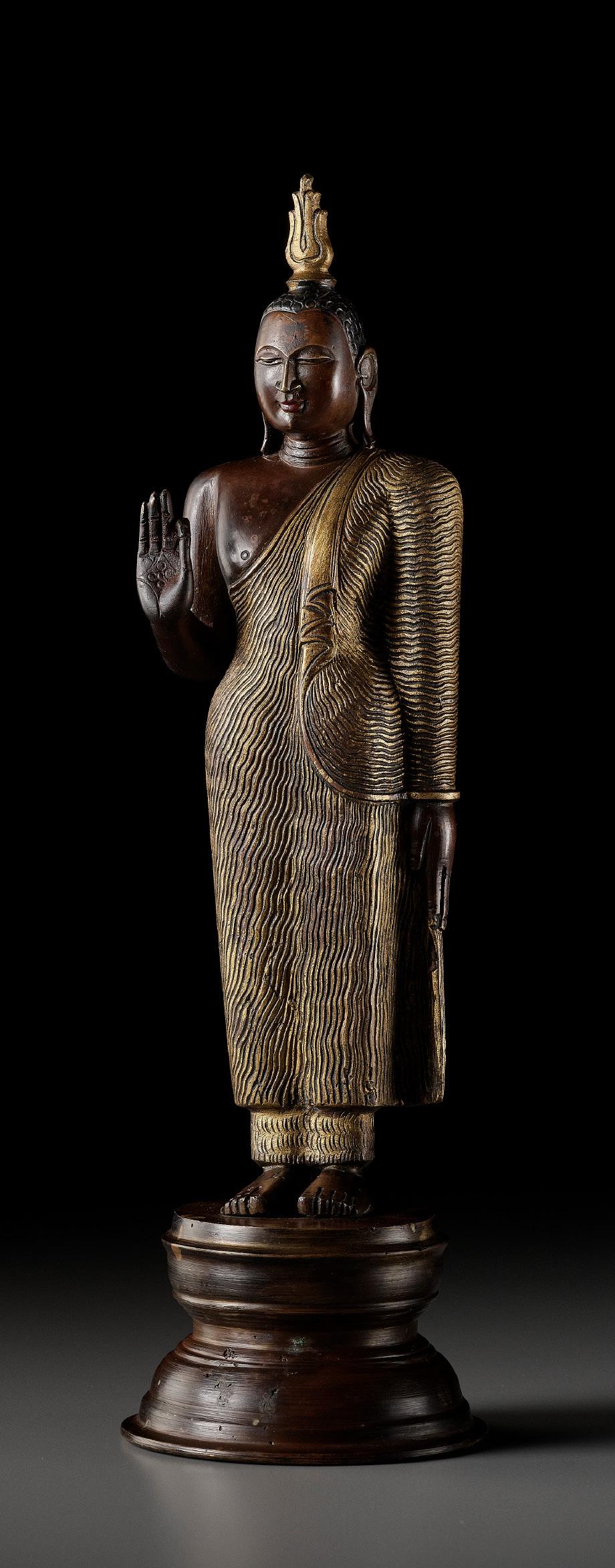
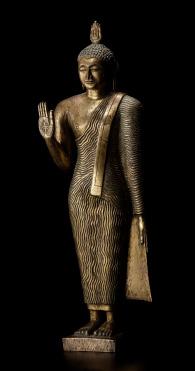
Expert remark: Compare the closely related form. Note the similar size (29.2 cm).
Estimate EUR 4,000
Starting price EUR 2,000
247
§ 1) The auction shall be carried out in accordance with the provisions of the rules of procedure of GALERIE ZACKE©, SZA VERSTEIGERUNGEN UND VERTRIEBS GMBH, Sterngasse 13, 1010 WIEN (hereinafter referred to as the company) as well as in accordance with sections 244-246 of the GEWERBEORDNUNG [Industrial Code] of 1994. The auction shall be carried out on commission. The auctioneer shall be entitled to withdraw lots exceptionally, to conduct the auction deviating from the order of the catalog numbers and to offer lots jointly. In the event of any dispute concerning a double bid or if the auctioneer has missed a bid, the auctioneer shall be entitled to revoke acceptance of a bid and to continue auctioning the item. The figures stated in the catalog shall be the highest bid in Euro (€) expected by the respective expert. As a rule, the bid shall be increased by 10% of the last bid. (See table of the bidding increments).
§ 2) The acceptance of a bid shall be granted to the highest bidder unless a hidden reserve has been agreed upon with the consignor of the item in question. Such a hidden reserve (also called limit or just reserve) shall be the minimum price under which the item will not be sold during the auction. This reserve will be disclosed upon request and after the auction only and may exceed the estimate. The auctioneer will in this case bid on behalf of the seller against all other bidders until the reserve has been reached. If a reserve is not reached during the auction, the auctioneer will knock down the item to the highest bidder at the final bid, but the sale will be conditional of the acceptance of this final bid by the seller. In this case the highest bidder shall be bound to his/her last bid for a term of 8 days starting with the day of the knockdown. If the winning bidder does not receive a written cancellation notice within this term of 8 days, the knockdown becomes unconditional and the sale is final. Typically, only a minority of all items in an auction have a hidden reserve.
§ 3) Most items shall be subject to differential taxation. A uniform surcharge of 25% plus the value added tax applicable to the surcharge to the amount of 20% shall be added to the achieved highest bid (final and highest bid). Thus, the surcharge shall be 30% of the final and highest bid in total. Items with added VAT are marked † in the online catalog.
§ 4) In the event of sales abroad, the value added tax will be repaid if the item is sold to a country which is not a member country of the European Union (third country), the legal requirements are met, and the proof of exportation is provided. The value added tax shall not be shown separately on the invoice.
§ 5) The auction buyer must pay the purchase price immediately upon acceptance of the bid (final and highest bid plus 25% surcharge, plus the value added tax applicable to the surcharge to the amount of 20%, or the added VAT on top of the final price, when a lot is highlighted accordingly in the auction catalog). The company may grant an auction buyer a term of payment for the purchase price in whole or in part when this has been formally applied for in writing before the auction.
§ 6) In the event of a term of payment, or any payment delay, in whole or in part, the company shall be entitled to charge default interest (12% p.a.) as well as storage charges (2.4% pf the final and highest bid per month commenced) after 14 days upon acceptance of the bid. The item purchased at auction shall be handed over exclusively upon full payment of the purchase price including all costs and charges accrued since the acceptance of the bid.
§ 7) The buyer should take acquired items into possession, as far as possible, immediately or after the end of the auction. Items which have been fully paid for shall be handed over in our show rooms in GALERIE ZACKE, Sterngasse 13, 1010 VIENNA. If a deferred purchase price is not paid within the set period, the company shall be entitled to auction the item again in order to recoup its claim from the defaulting auction buyer. In this case, the defaulting auction buyer shall be liable to the company for the total loss of commission incurred by the company due to the re-auctioning as well as for any default interest and storage charges.
§ 8) The company shall be entitled to a lien on all items of the buyer irrespective of whether the buyer bought them within the scope of an auction or in free sale or the company secured ownership of these items otherwise. This lien shall serve to secure all current and future, qualified, limited and unmatured claims to which the company is entitled and which result from all legal transactions concluded with the buyer.
§ 9) The items received for auction will be exhibited and may be viewed prior to the auction. In doing so, the company shall give everyone the opportunity to check the nature and the condition of the exhibited items to the extent deemed possible within the scope of the exhibition. Every bidder shall be deemed to act on its own behalf unless it provides a written confirmation saying that it acts as a representative or agent of a well-known principal. The company may refuse bids; this shall particularly apply if a bidder who is unknown to the company or with whom the company has no business connections yet does not provide a security deposit before the auction. However, in principle there shall be no claim to accept a bid. If a bid has been refused, the previous bid shall remain effective.
§ 10) The company’s experts evaluate and describe the items received for auction and determine the starting prices unless otherwise stated in the catalog or expert opinion. The information concerning production technique or material, state of preservation, origin, design and age of an item is based on published or otherwise generally accessible (scientific) findings concluded by the company’s expert with the necessary care and accuracy. The company shall warrant to the buyer according to §34-38 of the AGB (Terms and Conditions) that properties are correct provided that any complaints referring to this are made within 45 days after the auction day. Subsequent complaints shall be excluded in principle. The company shall not be liable for any further information in the catalog and expert opinion as well. This shall also apply to illustrations in the catalog. The purpose of these illustrations is to guide the potential buyer during the preview. They shall not be authoritative for the condition or the characteristics of the pictured item. The published condition reports shall only mention defects and damage affecting the artistic or commercial value significantly. Complaints concerning the price shall be excluded upon acceptance of the bid. The company reserves the right to amend the catalog online prior to the auction. These amendments shall also be made public orally by the auctioneer during the auction. In this case, the company shall be liable for the amendment only. All items offered may be checked prior to the auction. These items are used. Any claims for damages exceeding the liability named above and resulting from other material defects or other defects of the item shall be excluded. When making the bid, the bidder confirms that he/she has inspected the item prior to the auction and has made sure that the item corresponds to the description.
§ 11) If a customer is not able to participate in an auction personally, the company shall accept purchase orders. These orders may be placed in writing via mail, e-mail, fax, www.zacke.at or a third party bidding platform. In the case of a purchase order placed by phone or orally, the company shall reserve the right to make the performance dependent on a confirmation from the principal communicated in writing. Furthermore, the company shall not be liable for the performance of purchase orders. Equal purchase orders or live bids will be considered in the order of their receipt. Bids which below the estimate shall be exhausted completely. Bids which do not correspond to the increments determined by the company (see bidding increment table) will be rounded up to the next higher increment. The table of these increments can be sent upon request. The written bid (purchase order) must include the item, the catalog number and the offered top bid limit which is quoted as the amount of the acceptance of the bid without buyer’s commission and without taxes.
Ambiguities shall be carried by the bidder. A purchase order which has already been placed may only be cancelled if the written withdrawal is received by the company at least 72 hours prior to the beginning of the auction.
§ 12) The company may refuse a purchase order without explanation or make its execution dependent on payment of a security deposit. In the event of an unsuccessful order, such a deposit will be reimbursed by the company within 5 working days. Processing of purchase orders is free of charge.
§ 13) Every seller shall in principle be entitled to withdraw the items offered for auction until the start of the auction. Therefore, it is impossible to assume liability or to give warranty for the actual offering.
§ 14) Paid items must be collected within 30 days after payment. Items which have not been collected may be re-offered without further communication at the starting price from the recent auction reduced by 50%. Items which have not been collected within 30 days after the auction or for which the company does not receive any proper shipping instructions stating the type of shipping and the address of dispatch (independent of a possibly placed purchase order) shall be stored at the owner’s risk. Furthermore, the company shall be entitled to store items which have been purchased at auction and paid but not collected at the buyer ś risk and expense, including the costs for an insurance, with a forwarding agency. It shall be understood that the provision concerning the re-auctioning of unpaid and paid but not collected items must also apply to items not exhibited or stored on the premises of the company. The ownership shall be transferred to the buyer at the time of handing over the issuing note.
§ 15) In the case of mixed lots with a starting price of less than EUR 350.00, the company shall not warrant for the completeness or correctness of the individual items within a mixed lot.
§ 16) A registration for a bid by telephone for one or several items shall automatically represent a bid at the estimate price of these items. If the company cannot reach a bidder by telephone, it will bid on behalf of this bidder up to the estimate price when the respective lot is up for auction.
§ 17) Payments made to the company by mistake (through the payer ś fault) (e. g. due to miscalculation of the exchange rate by the payer) or payments made to the company for the same invoice several times shall be compensated in form of a credit note for goods for an indefinite period of time. The repayment of such payments in cash shall be excluded.
§ 18) Certain auction lots may exist several times (multiples). In such a case, the auctioneer may accept a second, third or even more bids from the underbidder(s). In this case, the text in the catalog and not the illustration shall be exclusively binding with regard to the warranty.
§ 19) The company reserves the right to assign to the buyer all rights and obligations resulting from the contractual relationship between the company and the seller by way of a respective declaration, as well as to assign to the seller all rights and obligations resulting from the contractual relationship between the company and the buyer by way of a respective declaration, in each case in terms of a complete assignment of contract with the result that the contractual relationship - following the submission of the aforementioned declarations by the company – shall exclusively be between the seller and the buyer, all of which is in accordance with the basic model of the commission agreement. Buyers and sellers shall already now give their explicit consent to this contract assignment.
§ 20) The place of performance of the contract brought about between the company on the one hand and the seller as well as the buyer on the other hand shall be the place of business of the company. The legal relationships and contracts existing between the company, the sellers and the buyers shall be subject to Austrian law. The company, the sellers and the buyers shall agree to settle all disputes resulting from, concerning and in connection with this contract before the territorially competent court of Vienna.
§ 21) The export of certain art objects from Austria shall require a permit from the Bundesdenkmalamt [Federal Monuments Office]. The company will orally provide information about art objects for which such export permit will probably not be granted at the beginning of the auction.
§ 22) Whenever making a bid, whether personally or via an agent, in writing, online, telephone, or in any other way, the bidder fully and unconditionally accepts the Terms of Auction, the ‘Important Information’ section in the auction catalog, the Terms and Conditions (AGB) of Galerie Zacke, §1-50, the Fee Tariff, and the Bidding Increments table, all as published on www.zacke.at on the day of the auction.
TERMS OF AUCTION
Maria (1926-2022) and Johannes Nickl (d. 2020), Austria
Anthony Powell (1935-2021), UK
Edgar Eugène Humann (1838-1914), France
David C. Lindeman (1944-2022), USA
Jean Beurdeley (1771-1853)
Alfred-Emmanuel-Louis Beurdeley (1847-1919)
Miklos Grunberg (1918-1988), Hungary
Joseph Athanase Doumer (1857-1932), France
Walter Knoke (1885-1952)
Jean-Marie-Charles Langlois (1896-1949)
Jim Milledge, USA
Dr. Rainer Josef Kreissl (1924-2005), Czech Republic
Naval Captain Schüz, Germany
Lu Xiaguang (1906-1994), China
Ethelbert Tryba (1928-1995), Chicago, USA
Moreno Maria Majandi, Italy
Paolo Bertuzzi (1943-2022), Bologna, Italy
Adrian Maynard, London, UK
Giovanni Paltenghi, Italy
Michael B. Weisbrod, Hong Kong
José Ramón Pons Oliveras (1928-2013), Barcelona, Spain
Carlos Cruañas Dalmau, Barcelona, Spain
William Rogers, Australia
Darwin Freeman (b.1976), Idaho, USA
David Lindahl, Kyoto, Japan
Reverend Dr. Paul Vivian Taylor (1892-1974)
Joan and Ted Dorf (1926-2020), USA
Provenance list starts on the inside front cover
Kim Green, USA
Lawrence (1926-2021) and Florence (1929-2013) Bier
Milton Drexel Rutherford (1894-1976), USA
Edward Winslow Ames Jr. (1907-1990), USA
Charles H. Royston, Chicago, USA
Yip Hon (1904-1997)
Dr. Edward Chou, Hong Kong
Kenneth P. Jackson, UK
Richard S. Ravenal (1927-2022), Livingston Manor, New York, USA
Thomas Eugene Worrell (1919-2006), Charlottesville, USA
Anton Exner (1882 – 1952), Vienna, Austria
Walter Exner (1911 - 2003), Vienna, Austria
Monsieur B., MD of Le Bon Marché, Paris, France
Bo Ive (1922-1981), Denmark
Cynthia Graser Locke (1923-2019), USA
Dr. Elsa R. Graser, Baltimore, USA
Sear Hang Hwie Pao (1937-2009), Canada
Madeleine and Erich Dammann, Switzeland
Robert (1903-1968) and Isabelle (1915-2010) de Strycker, France
Steven J. Harvis, Manhattan, USA
Isidore Cohn (1921-2015), New Orleans, USA
Tove and Karl Emil Strømstad, Norway
Dominique Sirvain, Saint-Ouen, France
Roland de la Moussaye (1932-2022), Paris, France
Werner Coninx (1911-1980), Zurich, Switzerland,
Paul Baerwald (1871-1961), USA
Monica Ghizzardi, Belgium
Paul J. Jewell, London, UK
Safia Sassi, Paris, France
Joseph (1938-2005) and Bella Shapiro (1941-2011)
Robin (1923-1975) and Fay Marx, Weybridge, Surrey, UK
André Jules Gabriel Le Gac (1895-1960), Brest, France
Grahame Clarke (1940-2014)
Roger Meffreys (1899-1976)
Captain Charles Oswald Liddell (1854-1941), Edinburgh, Scotland
George Hathaway Taber, Jr. (1859-1940)
Major Edward Copleston Radcliffe (1898-1967)
Brian John St. Martin Morgan (1930-2018)
Major William Guy Horne
Zhang Boju (1898-1982), China
Dr. Jonathan Broido (1941-2008)
Adolphe Stoclet (1871-1949), Belgium
Frances Louisa Dickson (1876-1967)
Mei Lin, Hong Kong
Bernard Wald, New York, USA
Margaret Polak, USA
John Gilmore Ford, Baltimore, USA
The Albemarle Collection
John Ault (d. 2014), UK
Gerry P. Mack, USA
David Stopher, Kent, UK
Amanda Torri and Alex Torri, Bologna, Italy
René Ronveaux (d. 1991), Belgium
Michael Phillips (born 1943), Beverly Hills, California, USA
The Phillips Family Collection, Lawrence and Shirley Phillips, New York, USA

Ed Hardy, California, USA
Alfred William Cowperthwaite (1890-1964), USA
Harry Geoffrey Beasley (1881-1939), UK
Idemitsu Sazo (1885-1981), Japan
Sir Percival David (1892-1964), UK
Robert Rousset (1901-1982), France
Jean-Pierre Rousset (1936-2021), France


1010 VIENNA AUSTRIA STERNGASSE 13 www.zacke.at Tel +43 1 532 04 52 . Fax +20 E-mail office@zacke.at





































































































































































































































































































































































































































































































































































 X-ray image of the present lot, revealing the superb overall condition
X-ray image of the present lot, revealing the superb overall condition





































































































































































































































































































 1. The Sun, depicted as a three-legged cockerel against a red disc.
2. The Moon, depicted as the white hare pounding the elixir of life.
NECK:
3. The Rock, depicted at the nape of the neck probably represents the element earth.
4. The Constellation, represented by three dots joined by blue lines.
FRONT VIEW OF THE ROBE:
5. The Rule/Law, fu, depicted as two opposing blue lines.
6. The Axe-head was traditionally an emblem of sovereignty and the emperor’s power over the life and death of his subjects.
7. The Water Plant traditionally represented purity.
8. The Sacrificial Vessels depicting two strange tiger-like animals. The tiger was associated with the metal element and the west.
robe determined.
BACK VIEW OF THE ROBE:
9. The Dragon, represented as a pair of tiny dragons, once ascending and one descending.
10. The Flowery Creature, depicted as a mythical golden pheasant.
11. The Fire, the flames representing the fire element.
12. The Grain, depicted as a dish containing 30 grains of millet, traditionally the first cereal crop raised in China.
1. The Sun, depicted as a three-legged cockerel against a red disc.
2. The Moon, depicted as the white hare pounding the elixir of life.
NECK:
3. The Rock, depicted at the nape of the neck probably represents the element earth.
4. The Constellation, represented by three dots joined by blue lines.
FRONT VIEW OF THE ROBE:
5. The Rule/Law, fu, depicted as two opposing blue lines.
6. The Axe-head was traditionally an emblem of sovereignty and the emperor’s power over the life and death of his subjects.
7. The Water Plant traditionally represented purity.
8. The Sacrificial Vessels depicting two strange tiger-like animals. The tiger was associated with the metal element and the west.
robe determined.
BACK VIEW OF THE ROBE:
9. The Dragon, represented as a pair of tiny dragons, once ascending and one descending.
10. The Flowery Creature, depicted as a mythical golden pheasant.
11. The Fire, the flames representing the fire element.
12. The Grain, depicted as a dish containing 30 grains of millet, traditionally the first cereal crop raised in China.








































































































































































